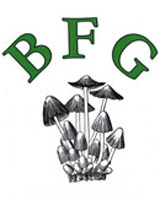L
|
|



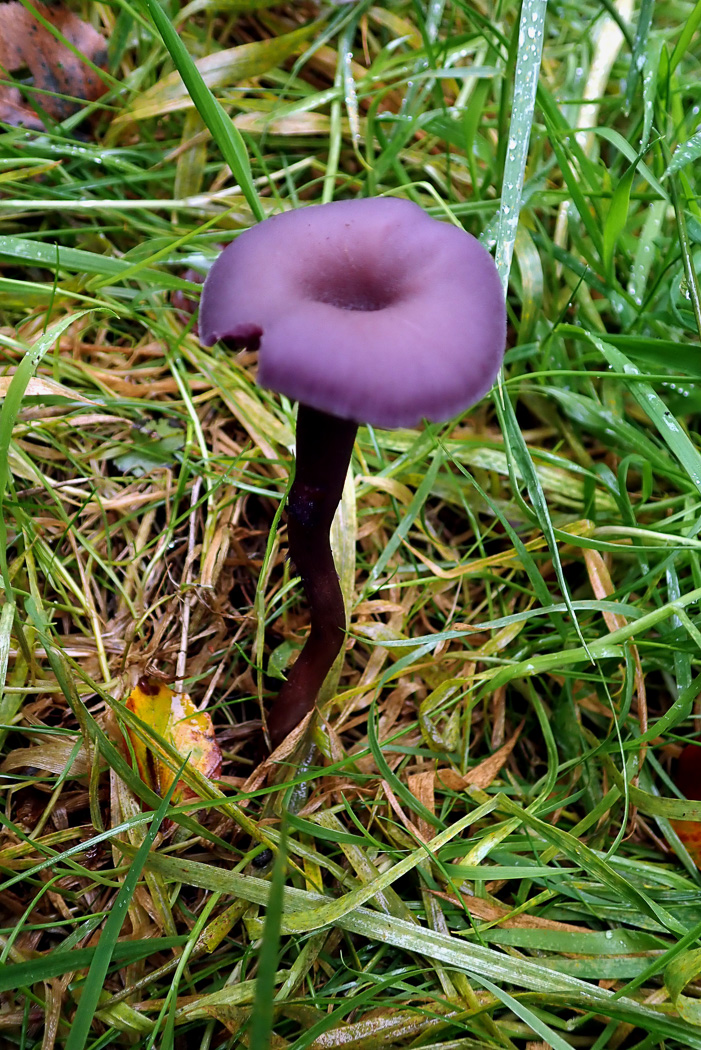
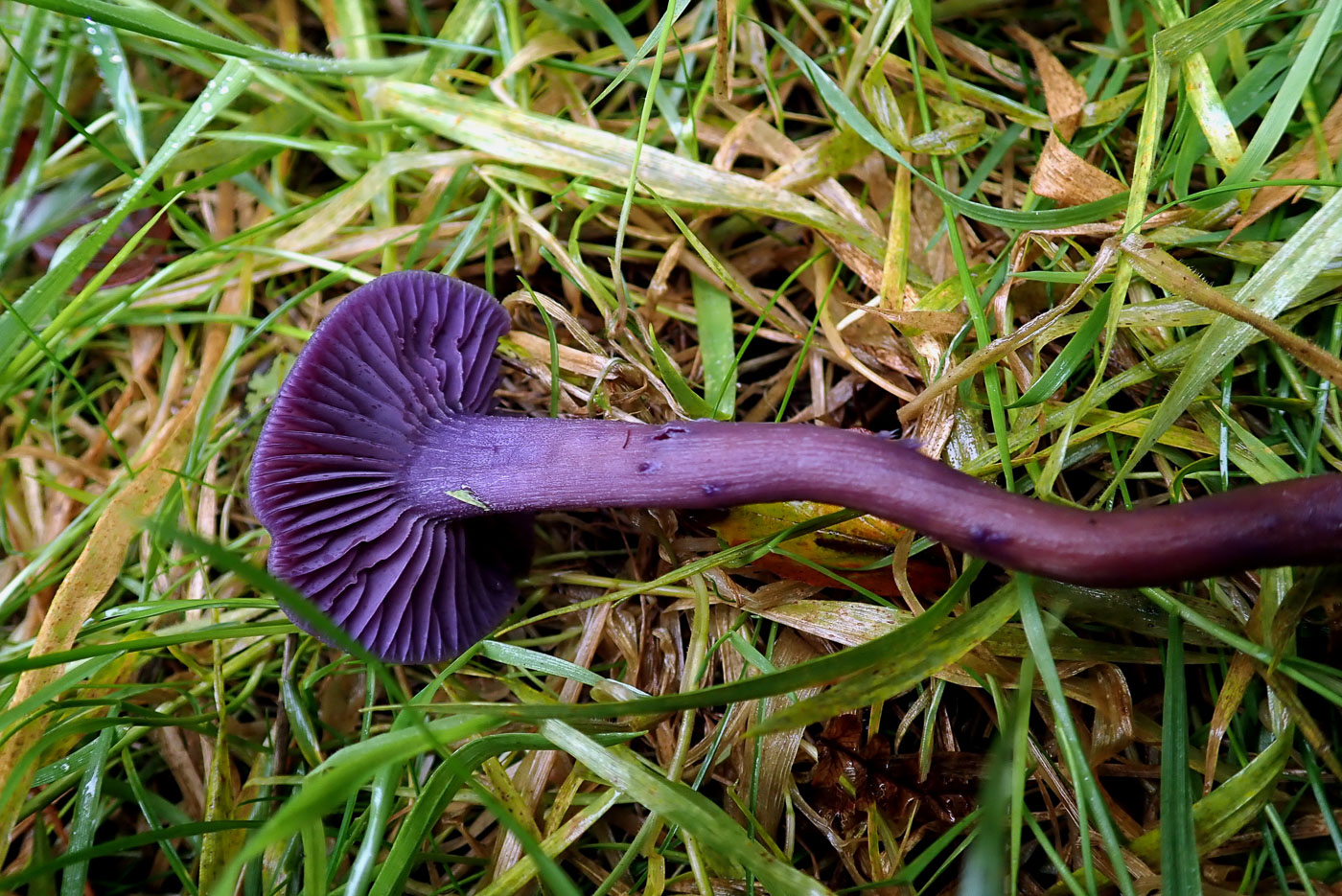
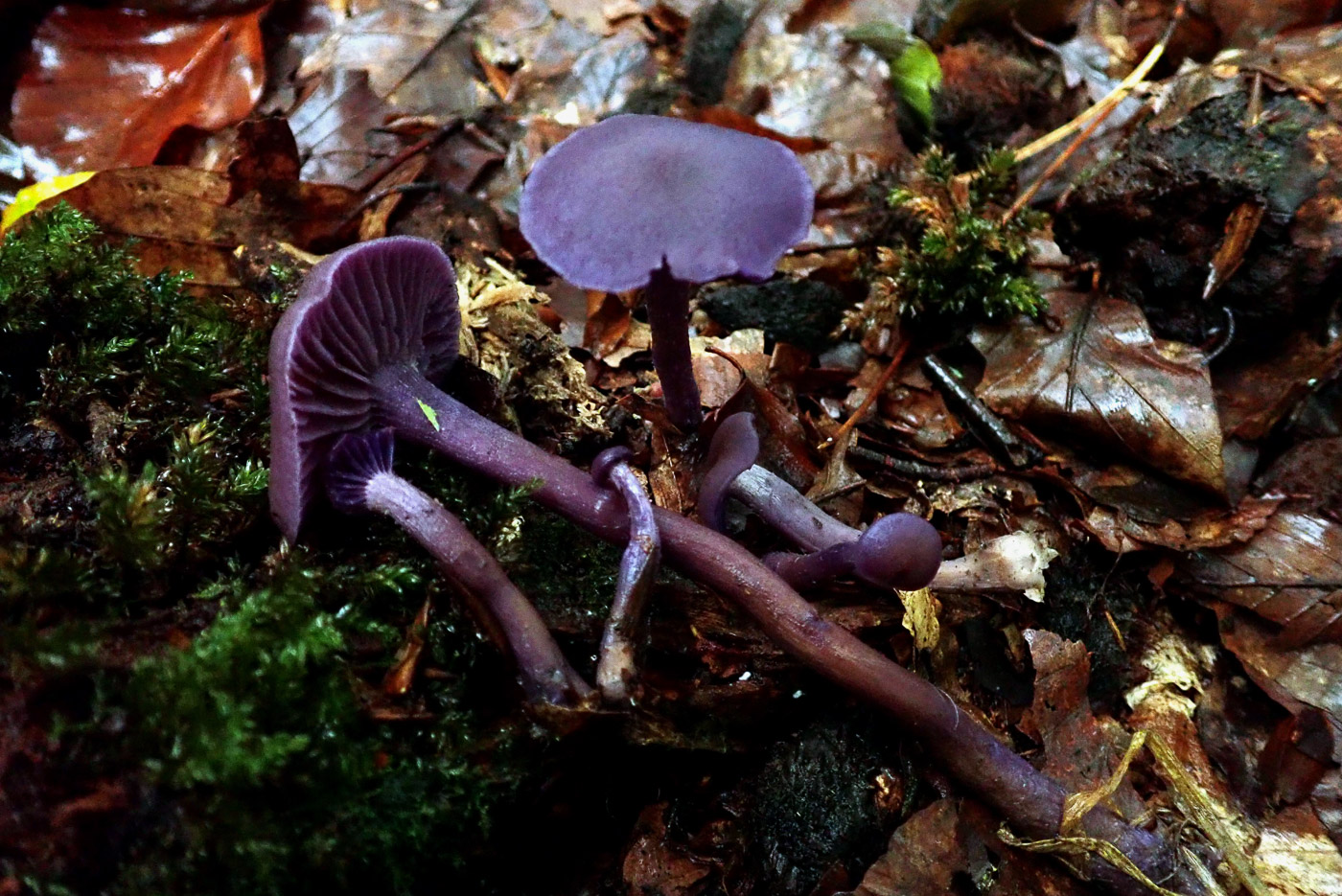
|
Laccaria amethystina (Amethyst Deceiver)
Aug 4, 2023. In deciduous litter in Hodgemoor Woods Penny found this common species coming up in lots of places though surprisingly well camouflaged considering its colour. Checking underneath for the widely spaced and concolorous gills is always a good plan because other entirely unrelated species can look similar from above (hence its common name). When the caps fade - which happens rapidly - the beautiful rich amethyst colour remains in the gills. Photo 3 was taken a week later at Turville Heath and shows well faded fruitbodies.
Oct 3, 2020. This beautiful and often common species was found by Penny Cullington in litter in Penn Wood. Never as common as the closely related Deceiver (see photo and notes dated Oct 1st) and in some years quite scarce, the colour when fresh and moist as today is stunning though somewhat similar to Inocybe lilacina (see photo dated Sept 22) which, however, has differently coloured gills. The first large singleton (cap about 4 cm across) was then moved to join some smaller more typical specimens. Note how easy it is to be deceived, however, when this same collection was dried out and fades. It is the widely spaced gills which remain amethyst in colour which are the safest clue to identity.
|

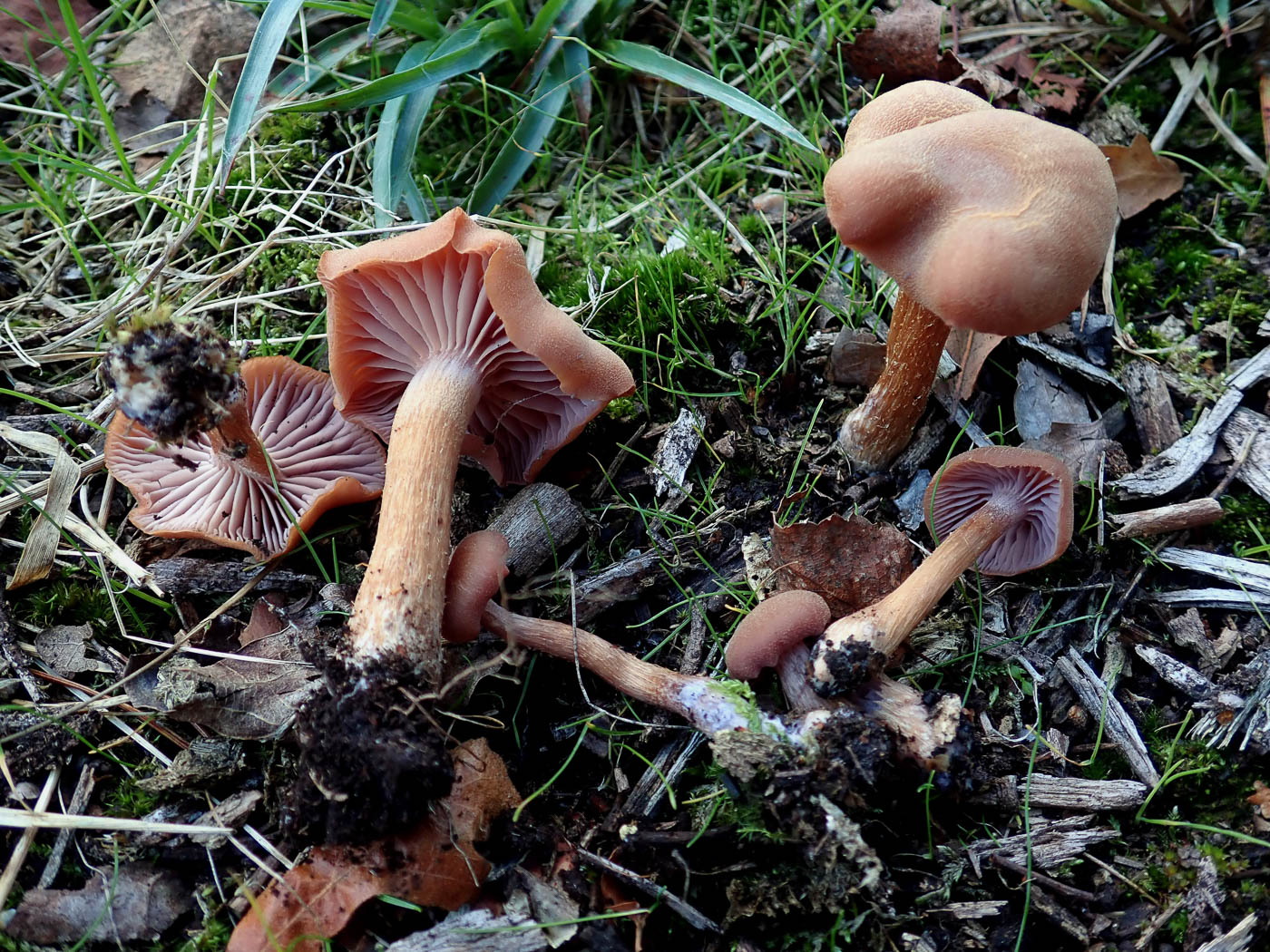
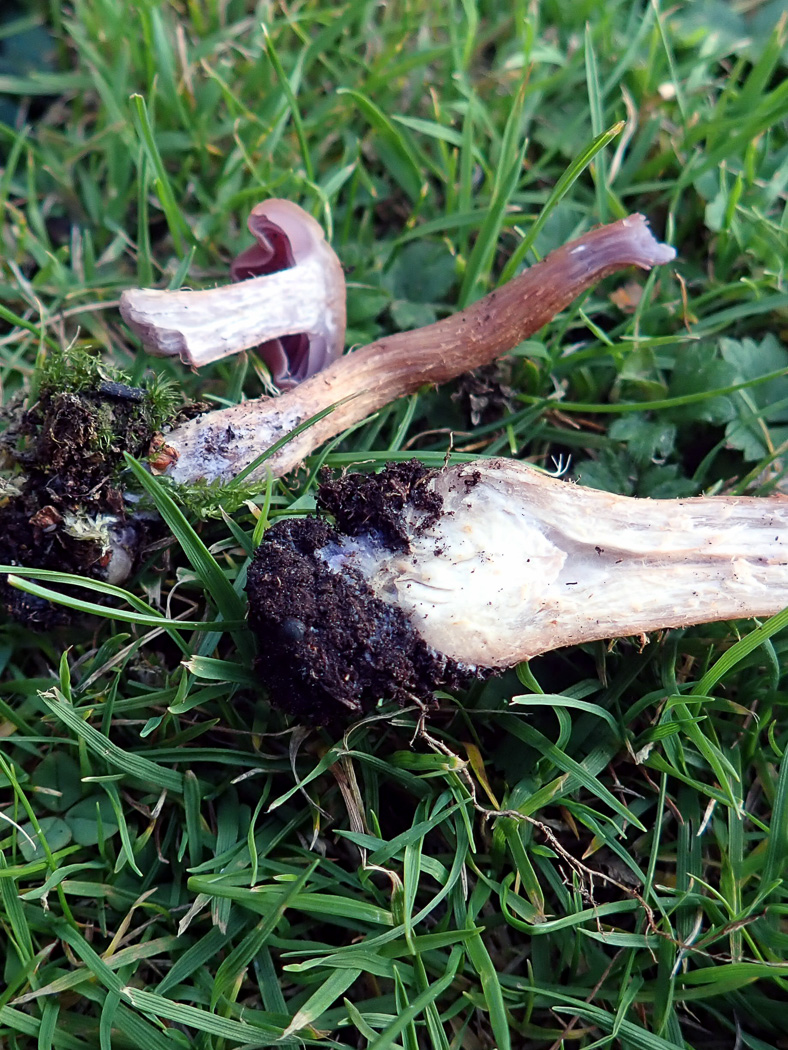
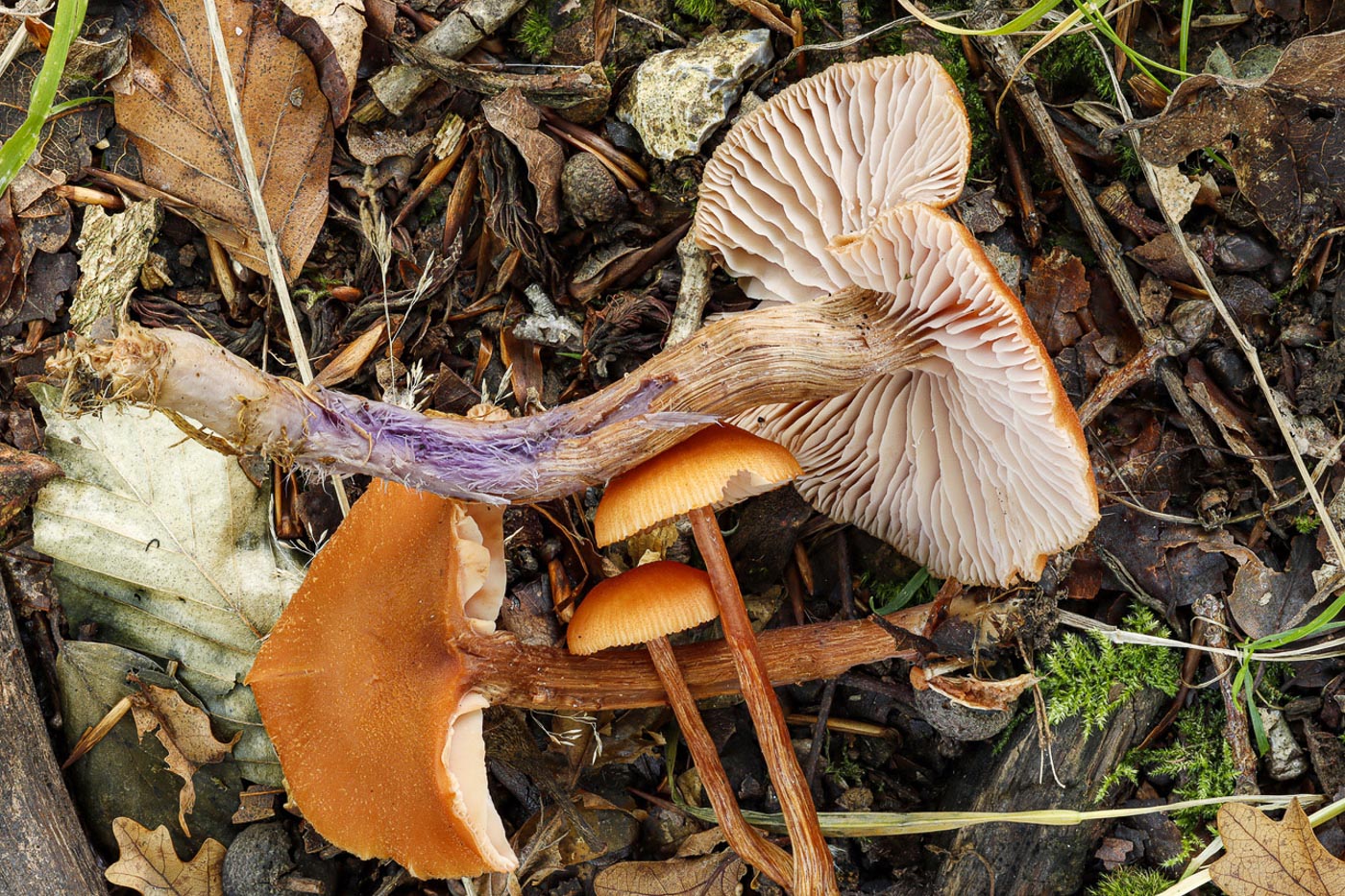
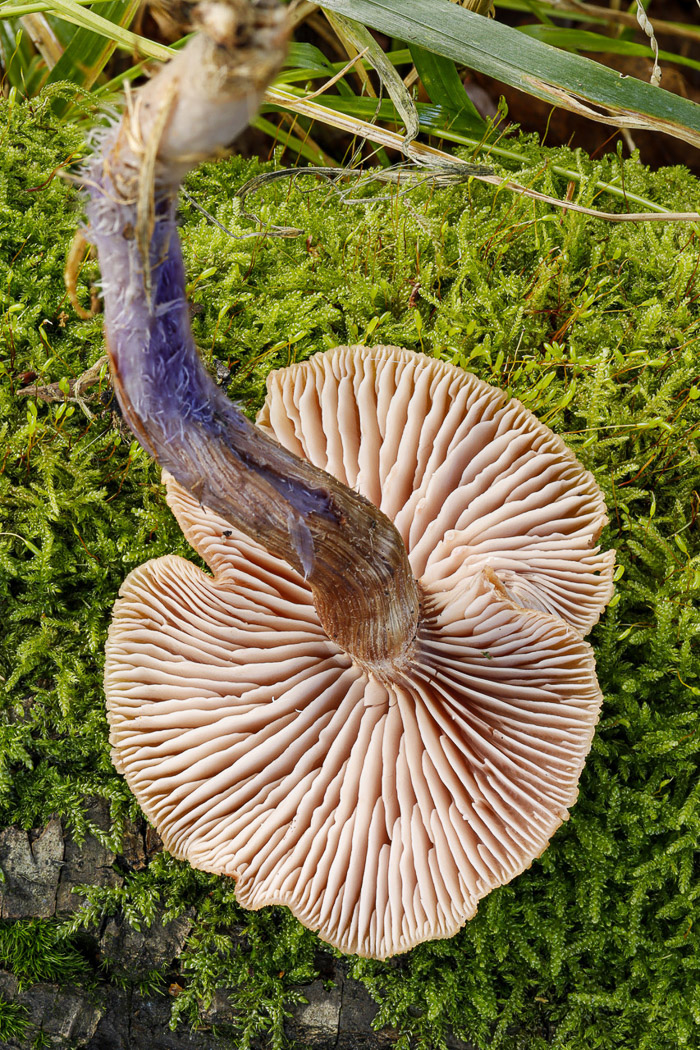
|
Laccaria bicolor (Bicoloured Deceiver) 
Oct 22, 2023. At Burnham Beeches Russell Ness noticed that this Deceiver was clearly different from the very common L. laccata (Deceiver) in that it had a distinctly violaceous stem base - the significant feature of this rare species which favours acidic soils and usually occurs near conifers (note the Pine needles in the photo). The gill colour also has a tinge of violet about it but otherwise only the stem base separates it from its much commoner relative. We have just three previous county records - from this site in 2002, from Naphill Common - Finds 2020 Oct 16th - and from nearby Stoke Common (also having acidic soil and conifers) - Finds 2022 September 29th.
Sep 29, 2022. At Stoke Common and only a foot or so from the collection of Deceivers in the entry immediately below this one, Penny spotted some larger Deceivers which looked very different: the caps were duller and also more matt in appearance and the gills had a decidedly lilac-pink tinge. Penny immediately checked for the telltale lilac staining at the stem base of this much rarer species and at first was disappointed as several stems appeared to show no outward sign of it. She was rewarded with one that did, however, then investigated further by cutting a few stems open which revealed this colour in their flesh, especially at the base. At home the oval spores were correct for the species: just a bit smaller than in L. proxima, it being fortunate to have the two species handy to compare. We have just two previous county records of L. bicolor, from Burnham Beeches and rather surprisingly Naphill Common: it favours acidic soil under Pines, provided by both Stoke Common and Burnham Beeches, but Naphill Common?!
Oct 16, 2020. Paul Goby found this quite rare species growing in litter in disturbed soil in Naphill Common. Very similar to the common Deceiver, this species sports the amethyst to mauve colours found in the Amethyst Deceiver but only at the stem base and apparently in the stem flesh (seen very clearly here). We have just one previous county record from Burnham Beeches, so this is new to the site and a nice find.
|

 |
Laccaria fraterna (Gumtree Deceiver) 
Mar 21, 2024. This find was another unseasonal surprise for Jesper Launder in Gerrards Cross. The two common members of genus Laccaria (Deceiver), l. laccata and L. amethystina, are so common that we tend to forget that this is one of our mycorrhizal genera (living in symbiosis with trees – in their case apparently any deciduous trees). L. fraterna grows only in association with Eucalyptus, arriving in this country with the import of that tree and as such is only to be found in its presence. The 50 odd UK records date from 1995, so it's still a rarity and new to the county though likely to be found if looked for under Eucalyptus. As can be seen, it's very similar in appearance to L. laccata (incidentally which also occurs in Eucalyptus!) but differs in having 2-spored basidia making a scope imperative for positive ID. The real surprise, however, is not finding it in the county but finding it in March! Jesper reported about 200 fruitbodies here, then found it the following day under another Eucalyptus the other side of town!
|


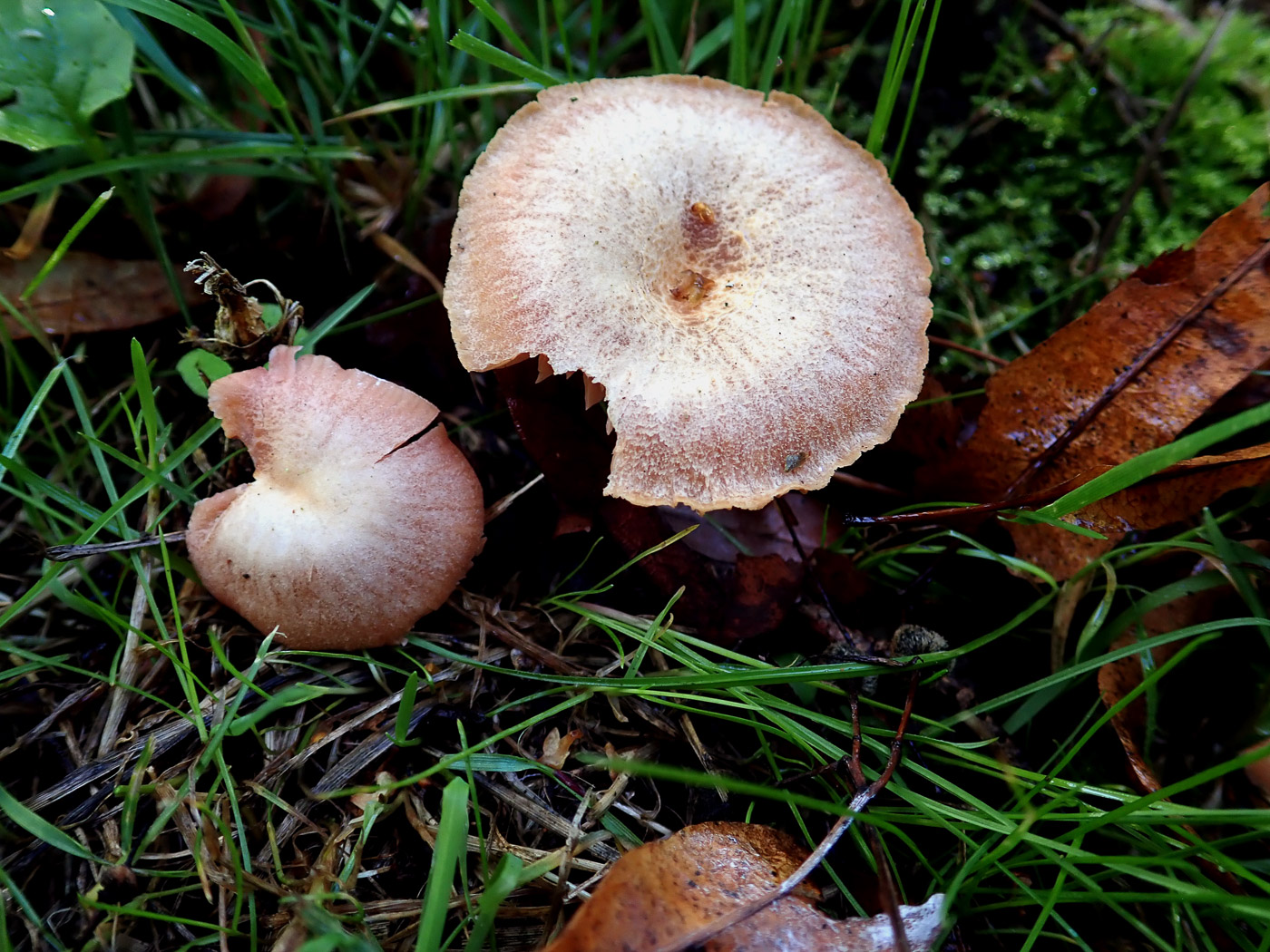

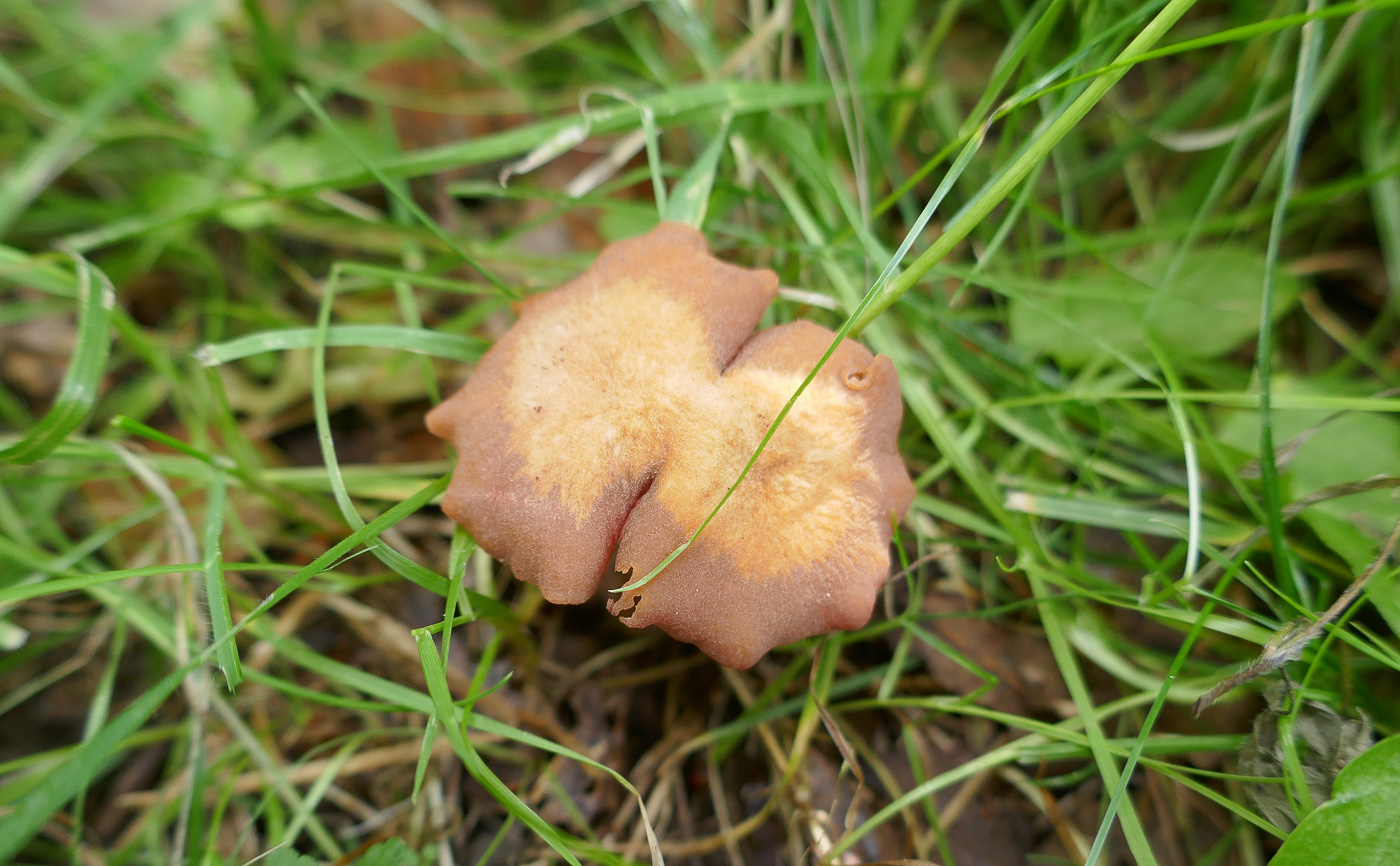
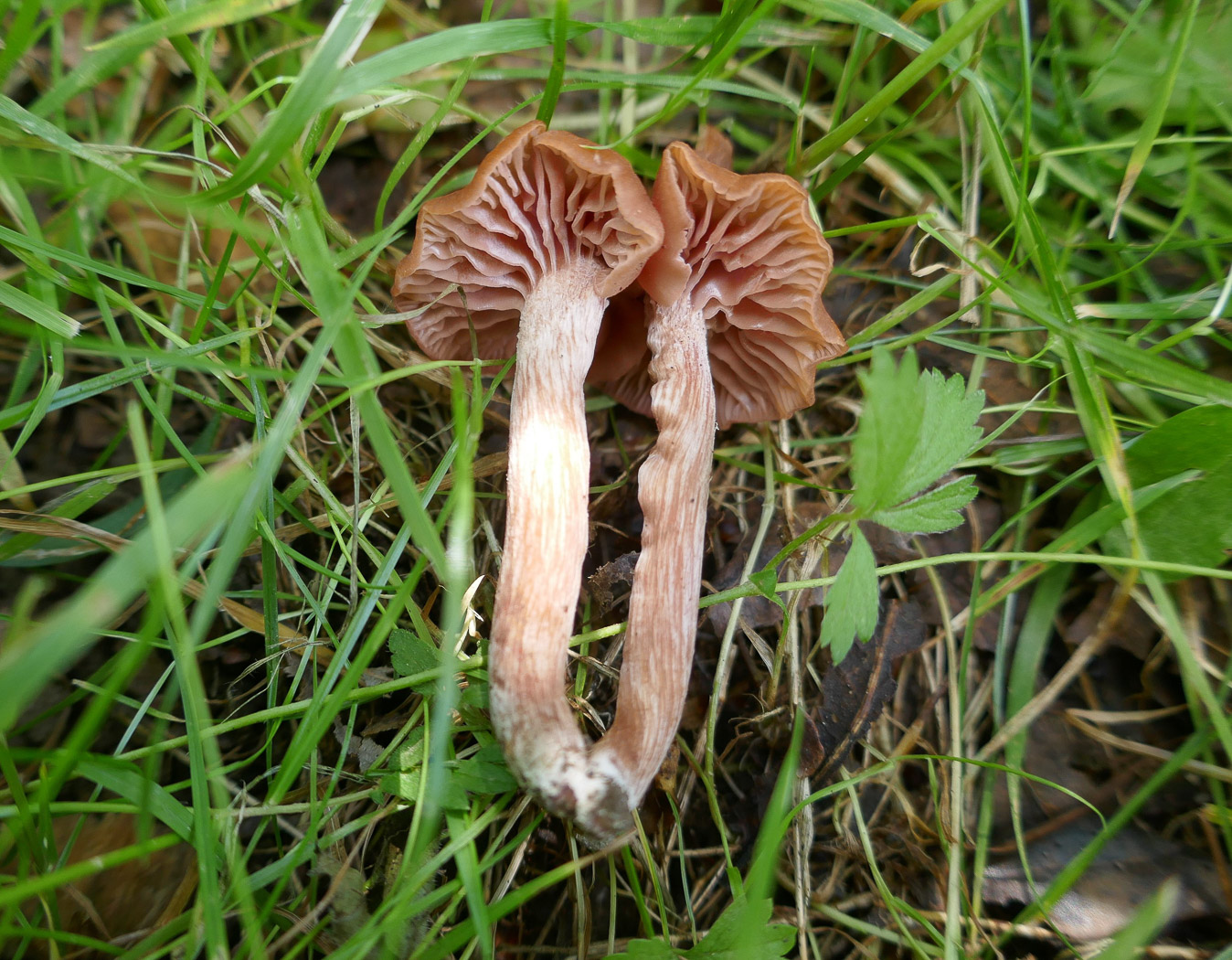
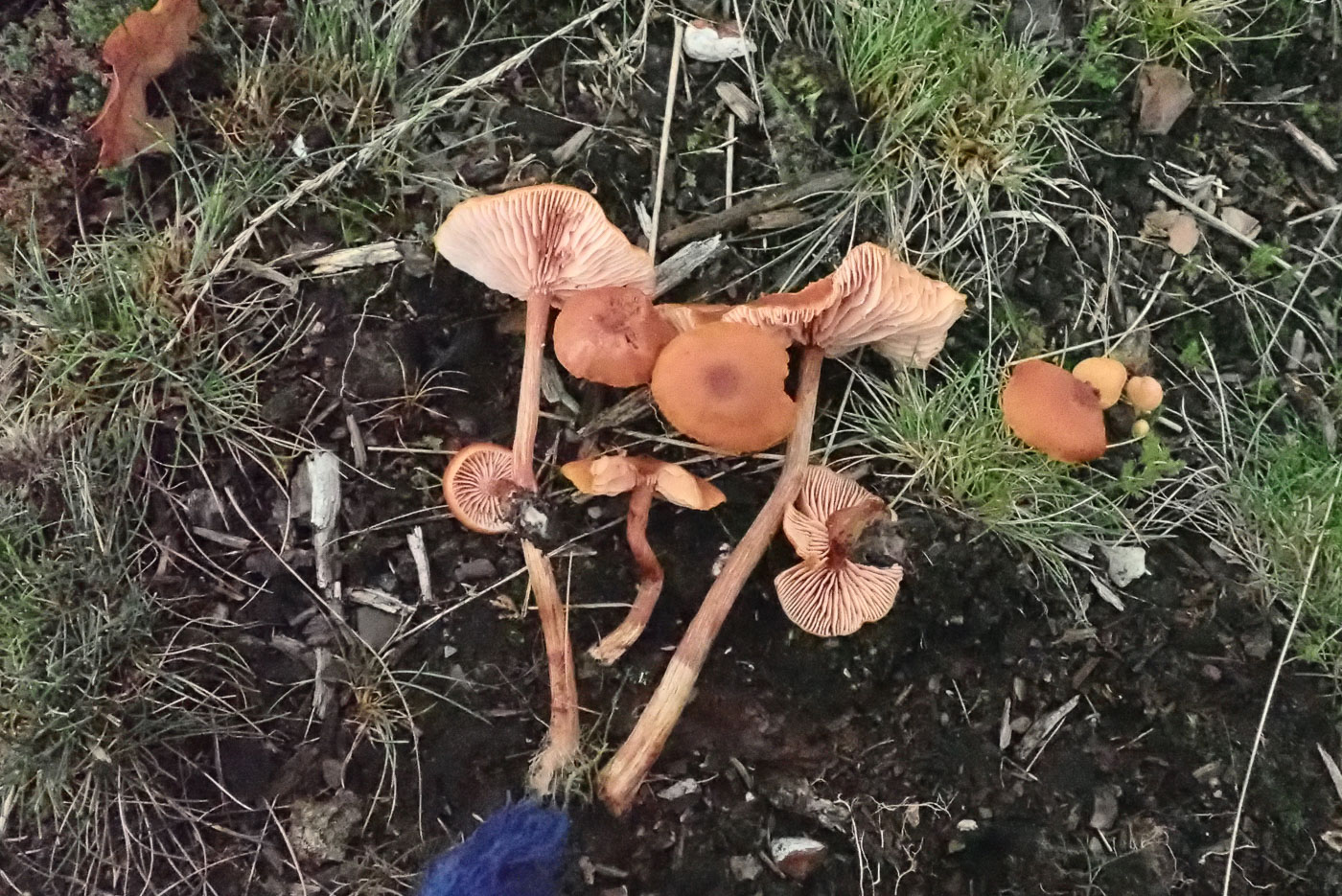
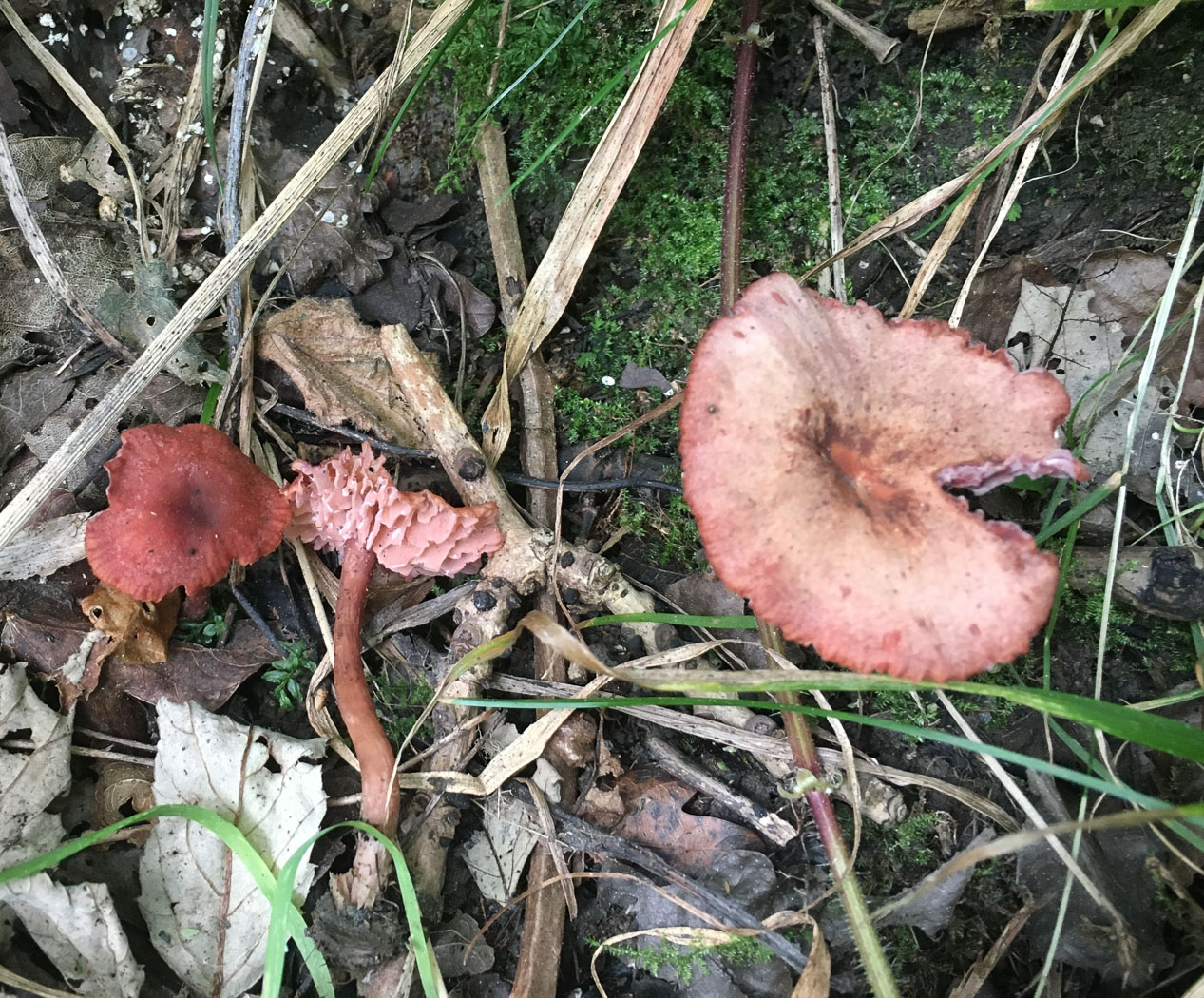
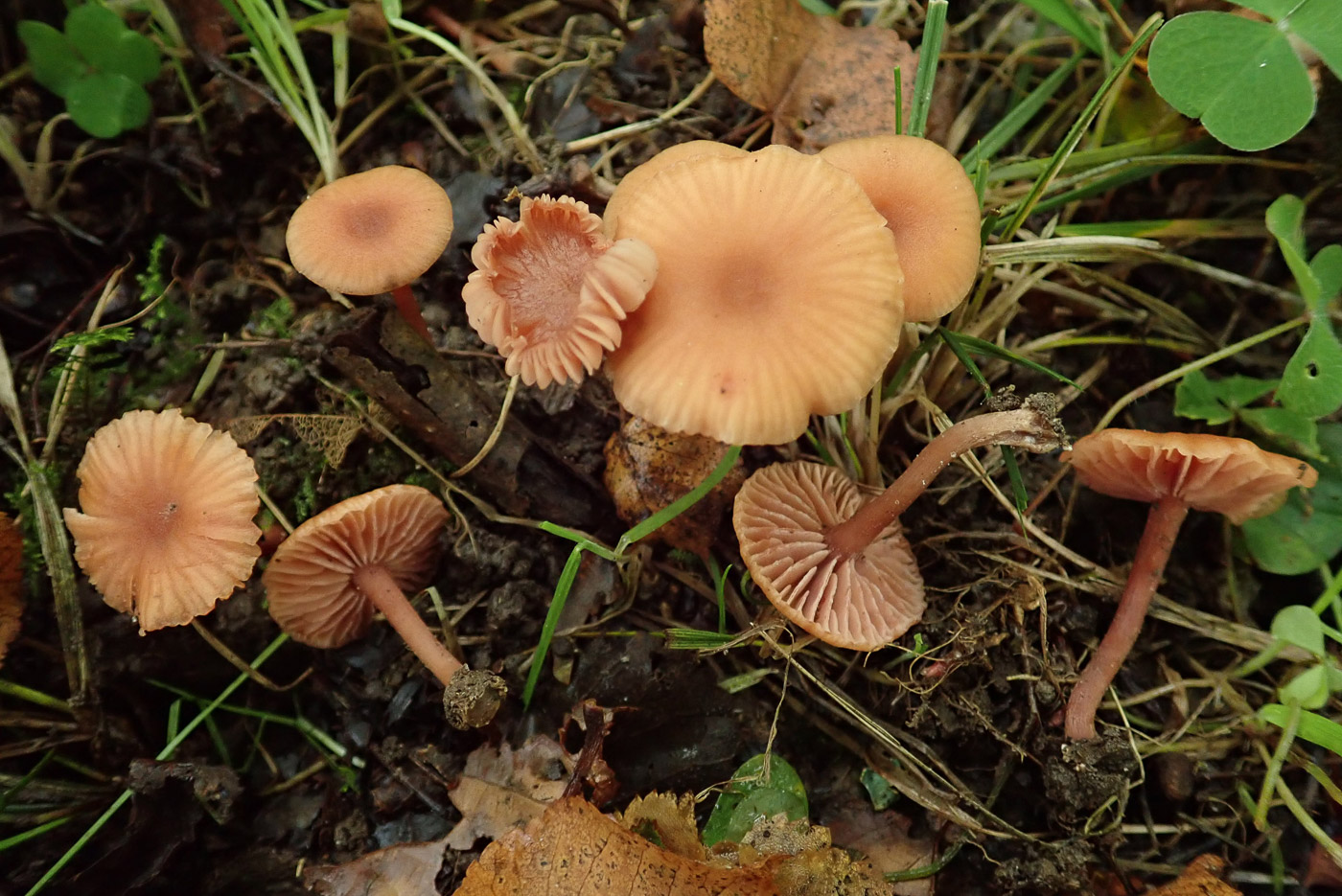
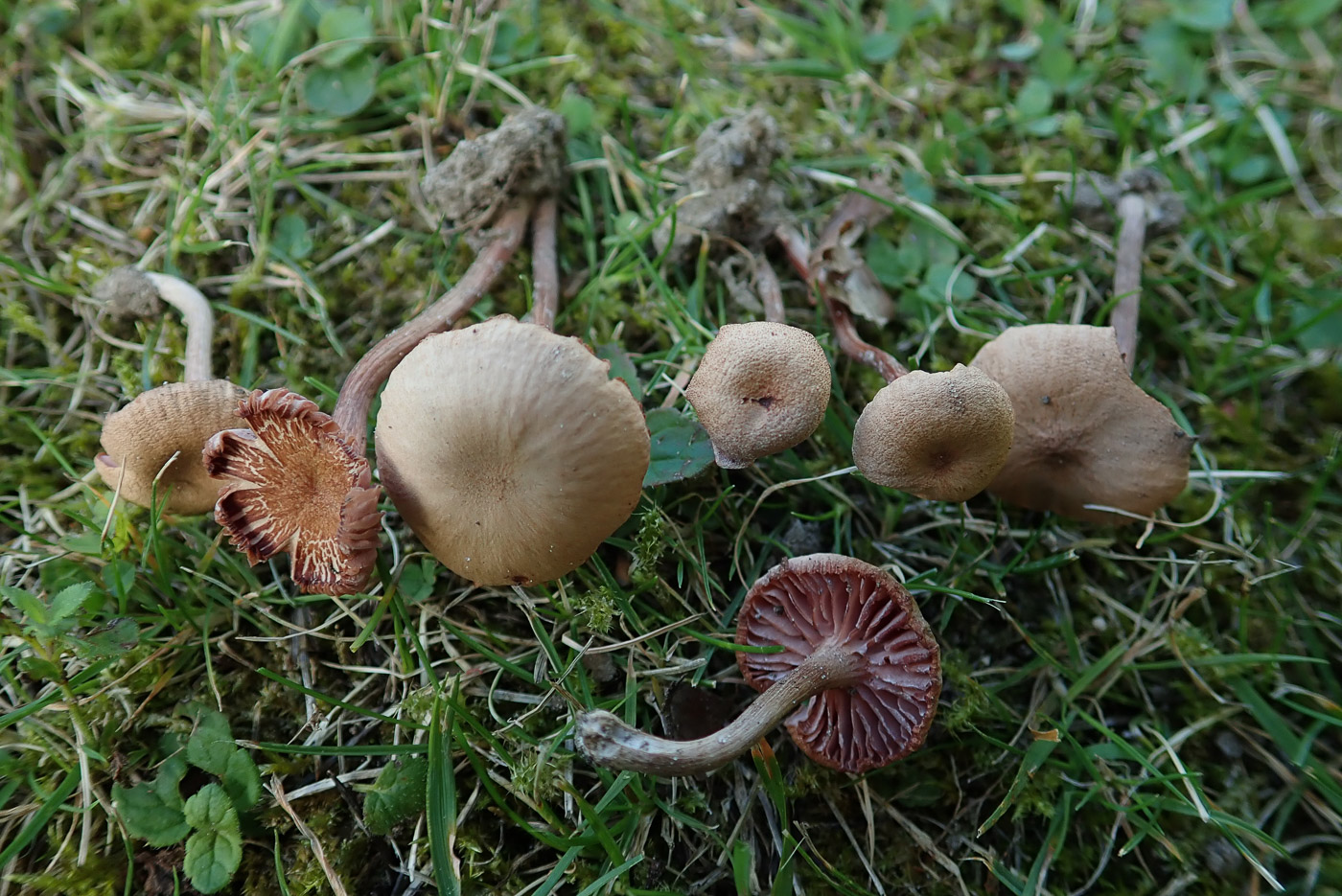
|
Laccaria laccata (Deceiver)
Aug 4, 2023. In Oak litter in Hodgemoor Woods Penny was not surprised to see this very common species appearing and displaying its rusty cap colour well in contrast to the pink and widely spaced gills. This cap colour is only apparent when fresh and in damp conditions but readily begins to fade.
May 17, 2023. At Turville Heath Penny was quite surprised to come across this little collection of a very common late Summer / Autumn species. The area was open cleared woodland so both fresh rusty and faded almost white caps can be seen here - typical of the species. Note the widely spaced pink gills despite it having a white sporeprint. We also found the species recently at Burnham Beeches, April 29th - our earliest record.
Oct 6, 2022. At Turville Heath in a grassy area Penny saw this normally very common species but one which often lives up to its common name. Here the caps were already losing their rusty tan colour and fading to pinkish off-white, but if the ID is in doubt the widely spaced pink gills always help.
July 1, 2022. Jackie Ewan found this common species at Stampwell Farm fruiting early after recent rain, in grassy soil under Oak. Typically for this species the slightly strangely formed cap is already well on the way to fading. Amongst our approx. 750 records we have 4 for May, 1 for June, then today's find. So bearing in mind we've already found Boletes and an Amanita during May and June maybe with sufficient rain we're now about to see an early start to the autumn season.
Oct 27, 2021. At Stoke Common in one of the open scrubby heath areas Penny spotted these somewhat large Deceivers, and suspecting this was not the very common L. laccata (Deceiver) took a photo then kept a specimen to check later at home. This species occurs typically on acid soils in open mixed woodland or heaths and is like a larger version of L. laccata but with a roughened textured cap and stem. Unlike the commoner species which has globose spiny spores, L. proxima has ellipsoid spores, but as large specimens of L. laccata can also occur it is necessary to check the spores to determine which species you have.
Sep 3, 2021. On a muddy bank near ponds in Brill Common Joanna found this common species which is now just starting to make an appearance (we also found it on our walk at Ivinghoe Common the following day). The left hand orange brown cap shows the colour this species starts off when fresh and damp, but note how faded the larger right hand cap has quickly become - hence its common name! There are two constant features which help avoid the regular confusion in the field the species causes: the slightly sunken cap centre but much more importantly the widely spaced pink gills seen in the central specimen here. Caps can get to about 3 cms across but it is often considerably smaller than this.
Oct 1, 2020. This very common species of woodland litter has been surprisingly scarce so far this season, only just starting to appear now. Penny Cullington found this collection under Lime at Turville Heath. Why Deceiver? Well, when fresh and moist as in today's collection, the caps are a bright rusty orange brown with matching stems and pinkish widely spaced gills. But this is a strongly hygrophanous species (i.e. the caps fade remarkably as it dries out), consequently, when faded and pale beige to almost white, they deceive because from above they look so different. Penny kept this collection and placed them in the sun for a couple of hours, then took the second photo to demonstrate just this. However, note how the gills become even more clearly pink when drying. So if confused in the field, by turning over a fruit body and seeing those widely spaced pink gills, hopefully you will not be deceived for long!
|


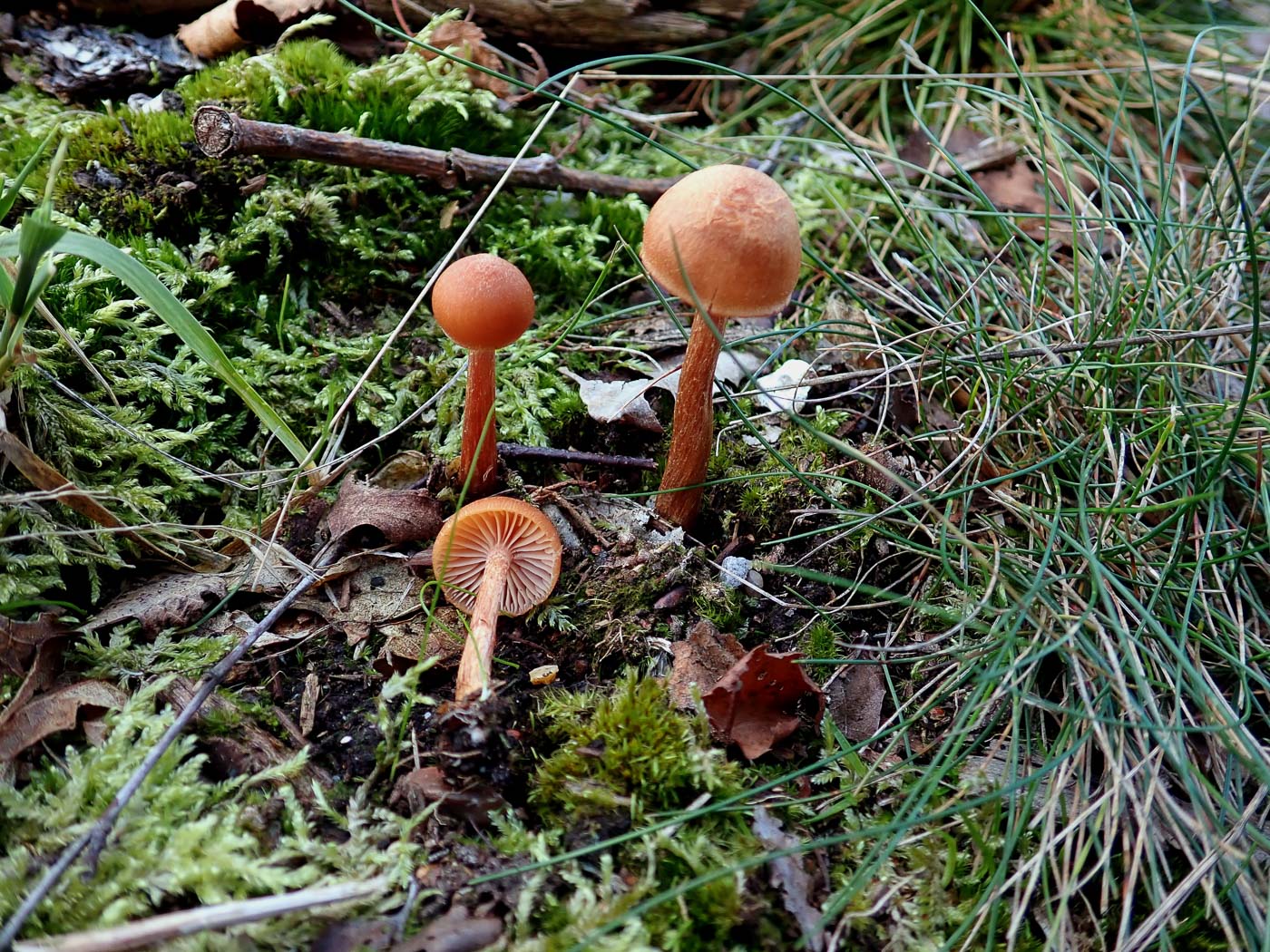

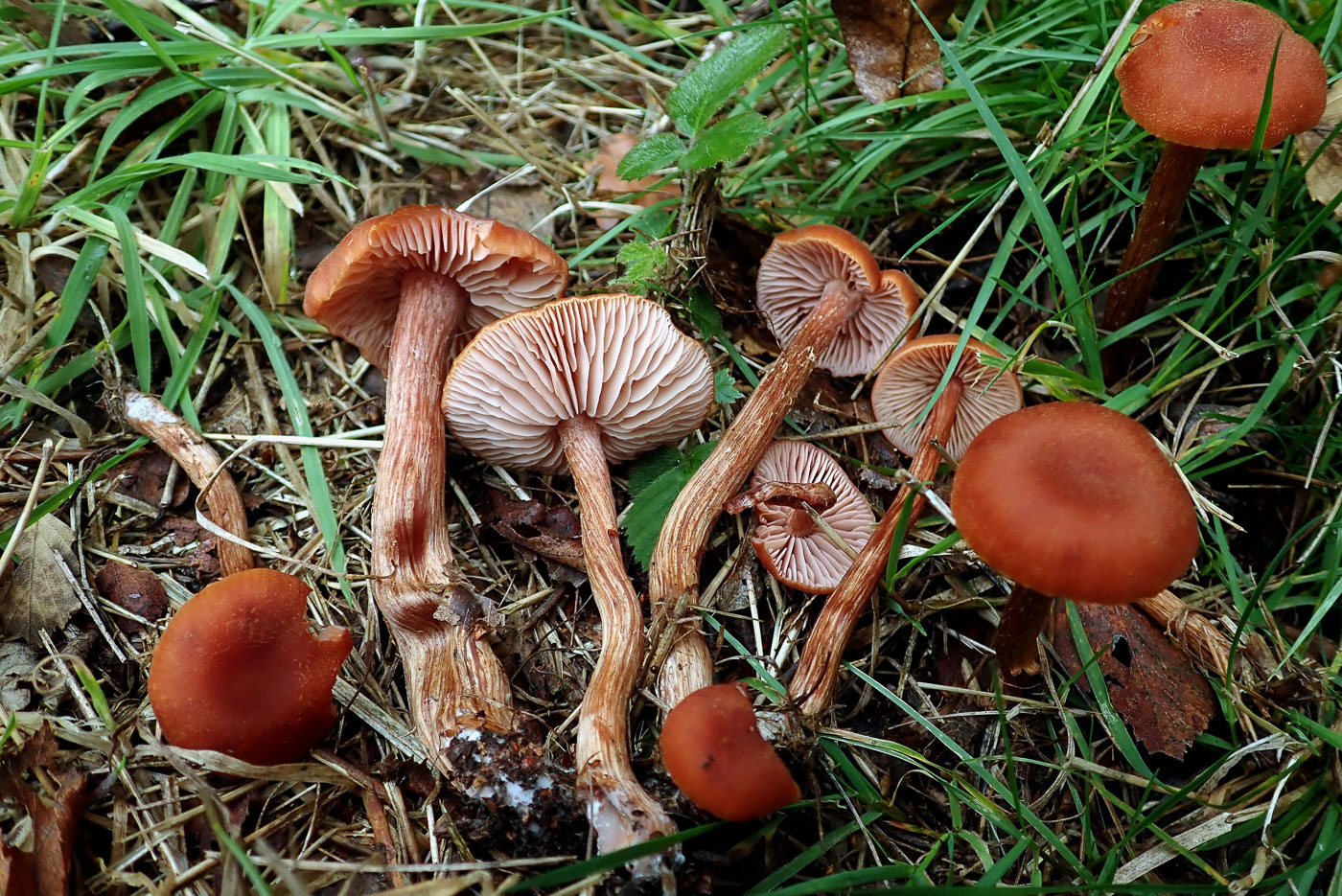
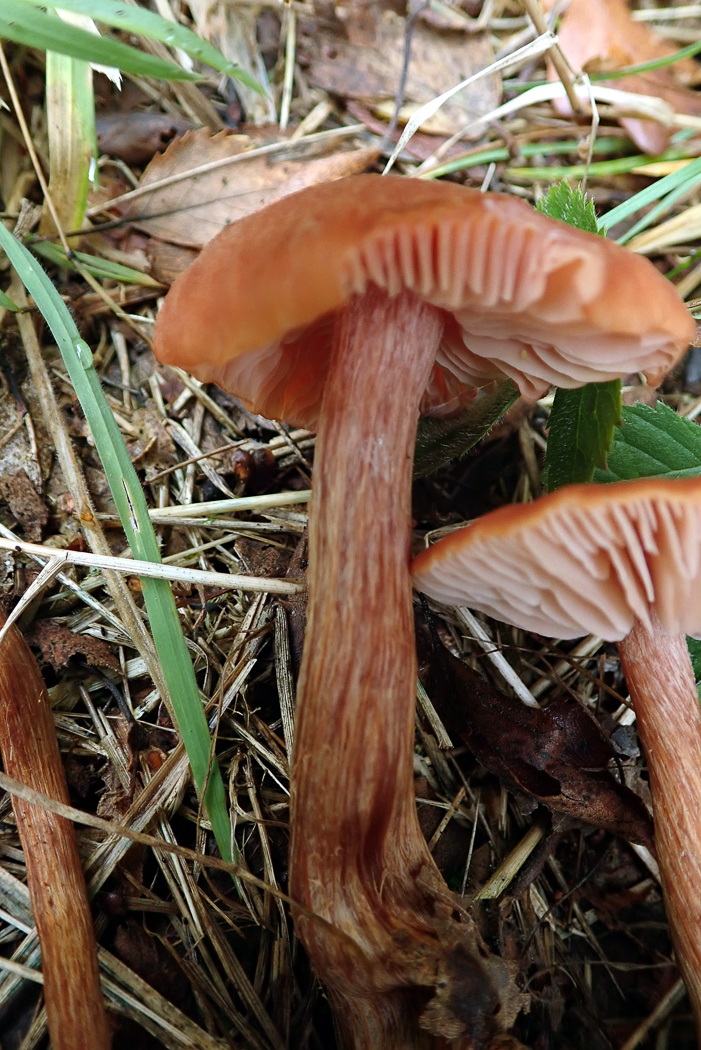 |
Laccaria proxima (Scurfy Deceiver) 
Apr 4, 2024. Here's yet another surprise early fruiting! At Stampwell Farm Jackie Ewan found this pair just emerging in a grassy area and luckily checked the spores, only to find they were oval and not round, making this L. proxima rather than the much more common L. laccata, though for either species to be fruiting now is unusual. Young fresh examples of this species are virtually impossible to separate from L. laccata in the field though the stem here does appear pretty streaky and fibrous which would indicate the possibility of it being the rarer of the two. The only sure way is comparing their spore shape.
Sep 29, 2022. At Stoke Common in a mossy clearing Penny noticed this small clump of Deceivers just emerging and made the assumption from their small size and smoothish caps that these were the normally very common Laccaria laccata (Deceiver) - though we've hardly seen it yet this autumn. However, this heathland site is just the type of habitat where L. proxima might occur, so the collection went in a pot and later the distinctly oval spores showed it to be that species. Though still young, the fibrous stem seen on the largest specimen here points to this species rather than the commoner one. .
Oct 27, 2021. At Stoke Common in one of the open scrubby heath areas Penny spotted these somewhat large Deceivers, and suspecting this was not the very common L. laccata (Deceiver) took a photo then kept a specimen to check later at home. This species occurs typically on acid soils in open mixed woodland or heaths and is like a larger version of L. laccata but with a roughened textured cap and stem. Unlike the commoner species which has globose spiny spores, L. proxima has ellipsoid spores, but as large specimens of L. laccata can also occur it is necessary to check the spores to determine which species you have.
Oct 18, 2020. Paul and Penny C. found a good number of this species looking really pristine in a grassy glade in Marlow Common. This is the largest species of the Deceivers and is like an outsize L. laccata (Deceiver) though confusingly that species can sometimes grow as large on occasion! The stem is much more fibrous and the gills a bit paler than those of L. laccata, also it favours more heathland than woodland litter, but there is really only one way to be certain which species you have and that is to check the spore shape: round in L. laccata but oval in L. proxima.
|
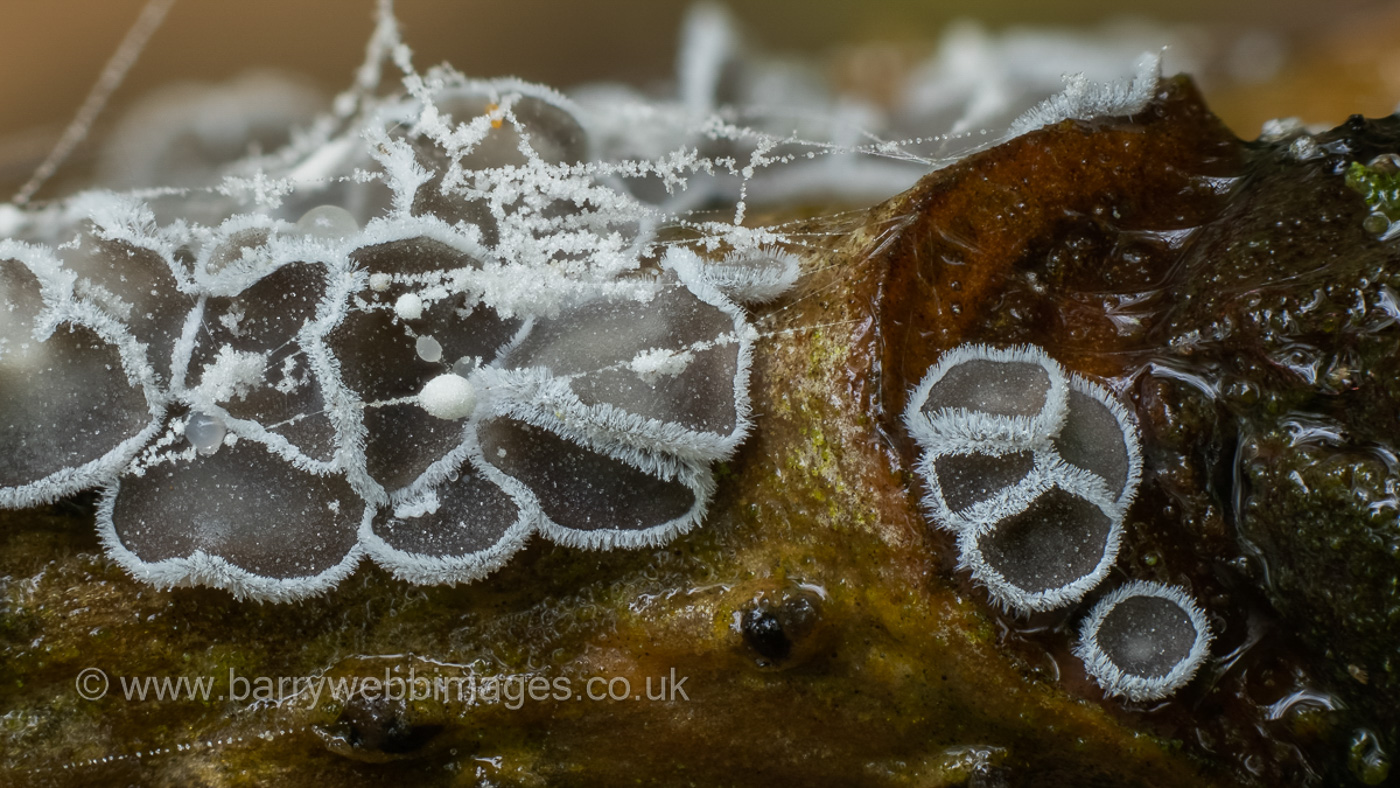 |
Lachnella alboviolascens (a cyphelloid Basidiomycete)
May 16, 2022. At Dancersend, where a few of us were doing some survey work, several interesting things turned up including this tiny cluster of grey 'discs' found on the end of an Ash twig. Thought at the time to be maybe a species of Lachnum or Mollisia (i.e. a typical small Ascomycete) it was not until Derek together with Asco expert Kerry Robinson examined it later under the scope that its true identity was revealed! Described as occasional in England but probably quite common but either misidentified or overlooked, this is a first for the county. (The photo is Barry Webb's)
|
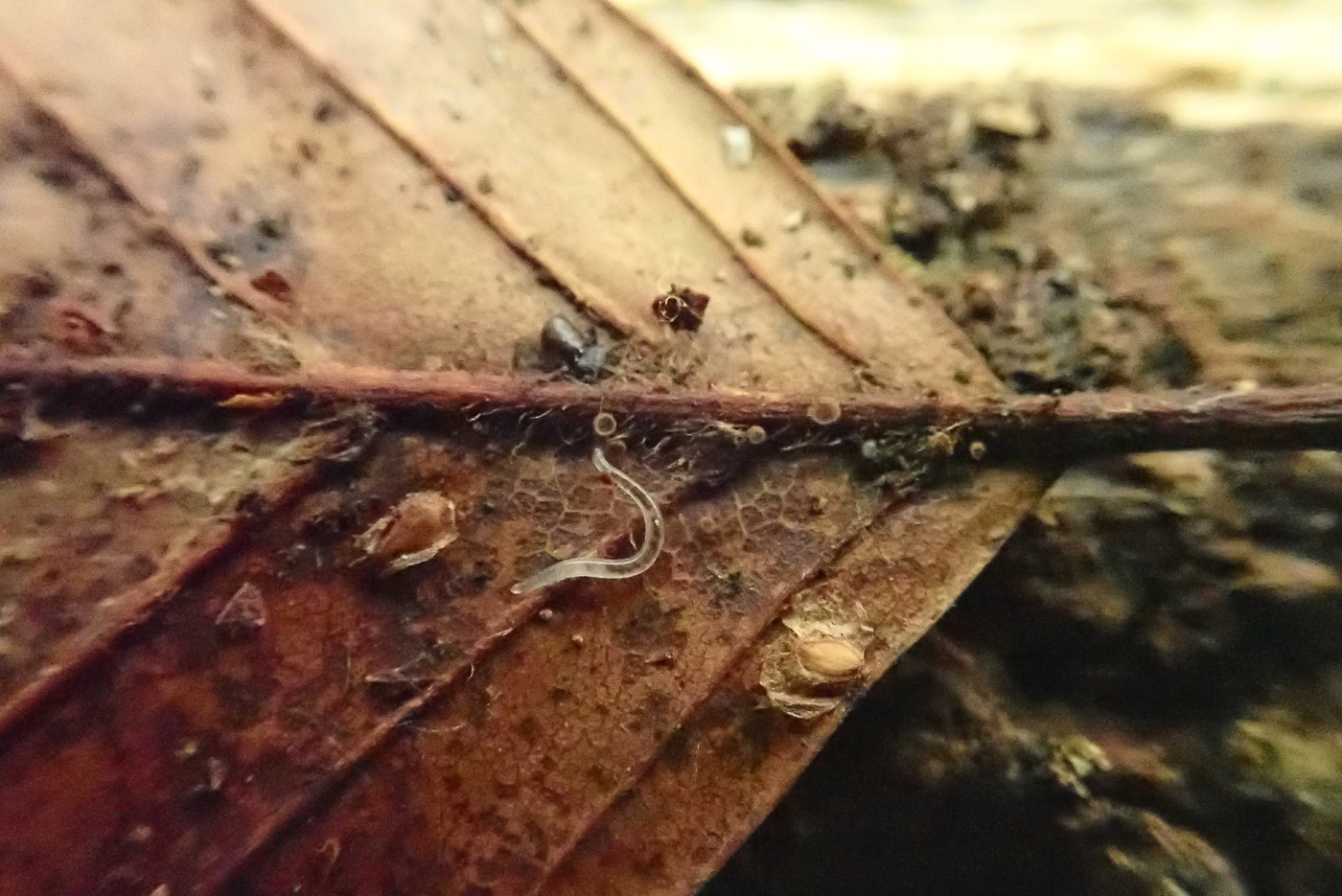
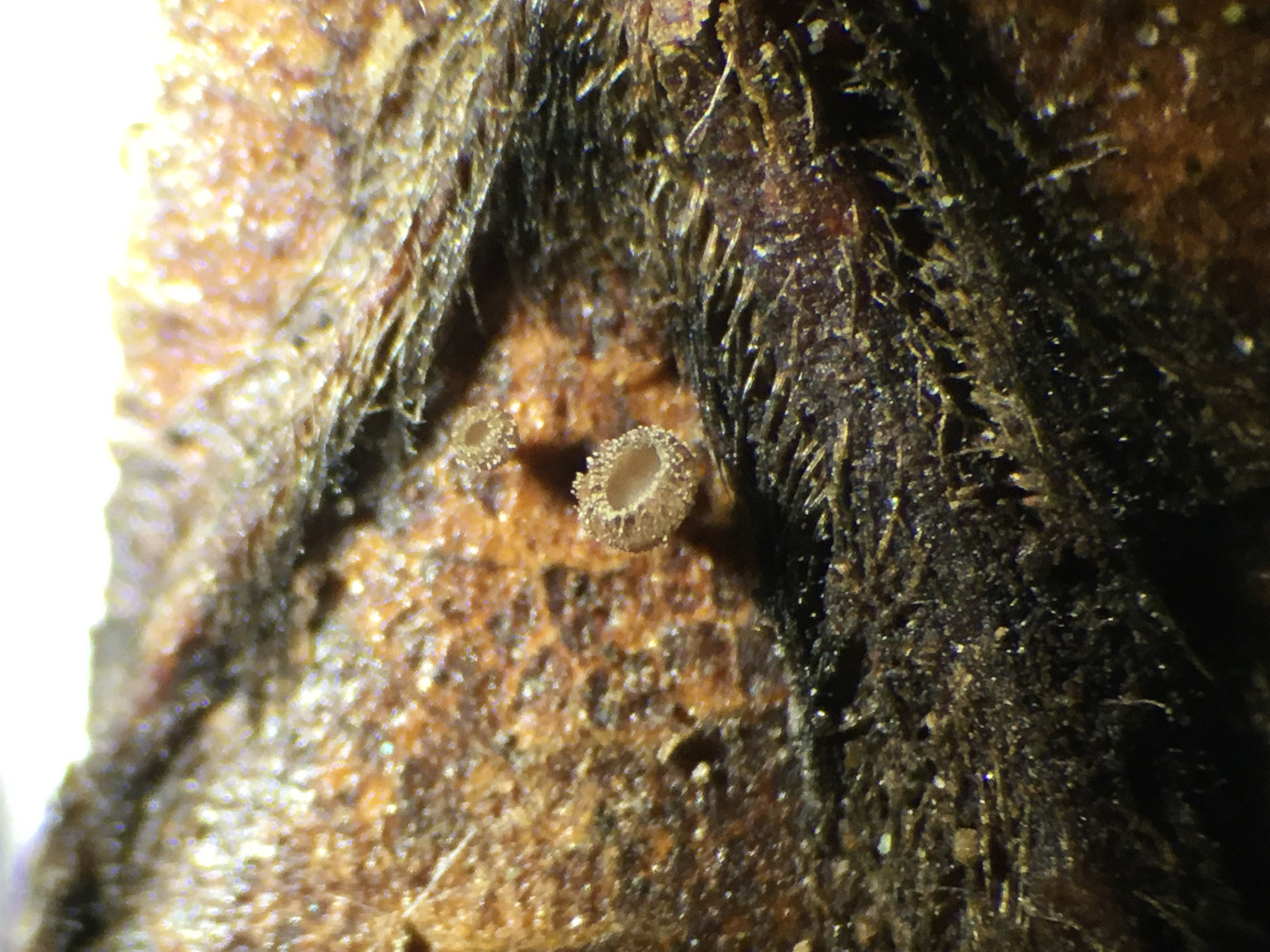 |
Lachnum fuscescens (an Ascomycete with no common name) 
May 10, 2021. On our visit to Burnham Beeches last week Asco expert Kerry Robinson found and named this tiny springtime discomycete on the veins on the underside of damp dead Beech leaves, but no photo was taken. Today Russell Ness and Penny returned independently and managed to find it again, though Russell's close-up photo was taken in the adjacent Egypt Woods. (Photo 1 is Pennys.) These miniscule cups are less than 1 mm across (and even with a handlens are quite hard to spot) and covered in fine brown hairs (which under a scope are tipped with crystals).
|
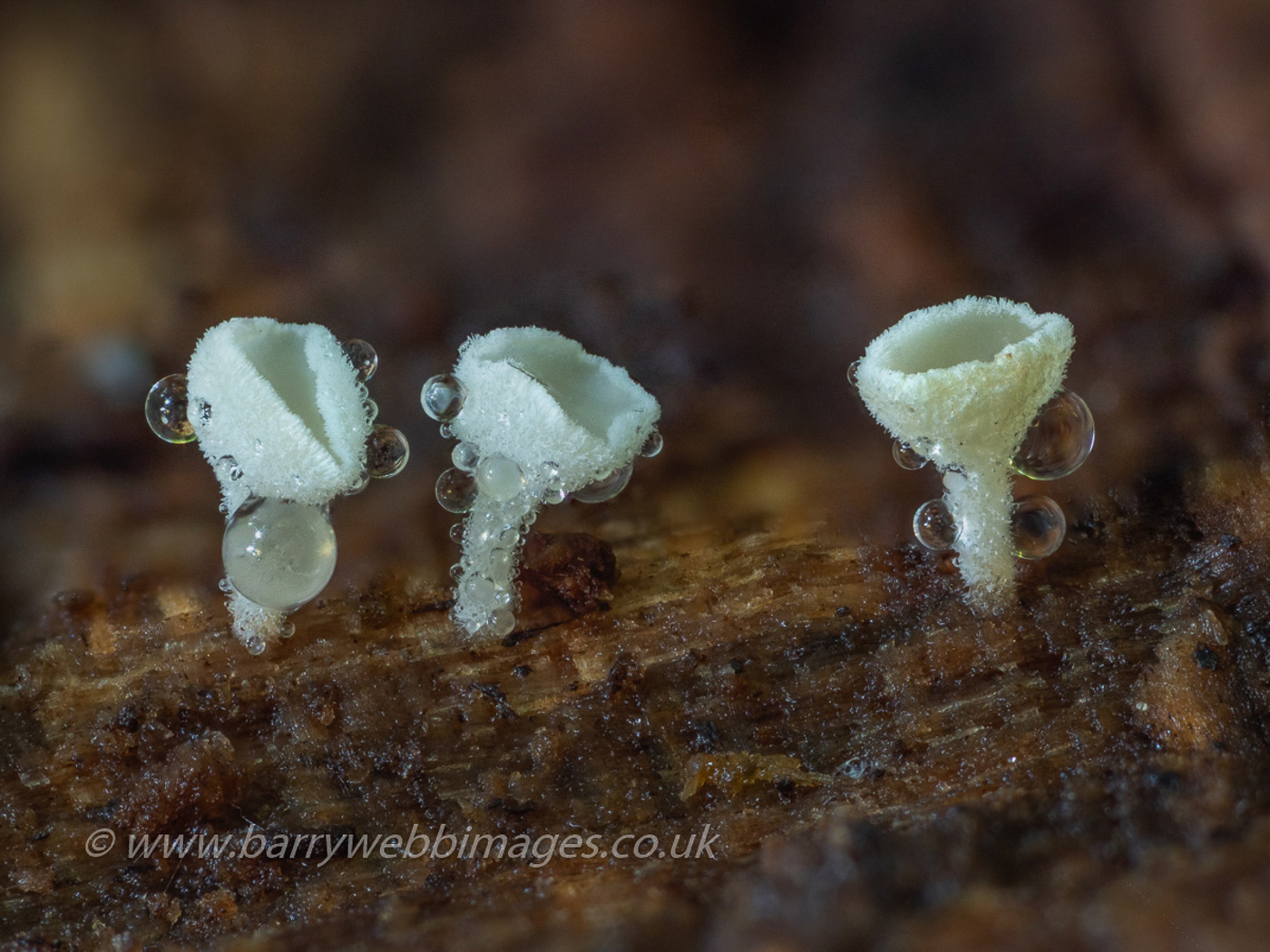 |
Lachnum niveum (a Sep 20, 2020. Disco very similar to Snowy Disco)
Sep 20, 2020. Barry Webb found these tiny stemmed white discs on rotting fallen Beech in Burnham Beeches. Lachnum is a large Ascomycete genus of tiny fruit bodies, this one less than 1.5 mm tall. There are several common very similar tiny white species which often form large colonies on rotting wood, and to be certain which you have they should be checked with a scope. However, typical of this particular species are the droplets which adhere between the fine hairs on the stem and outer surface of the disc, clearly visible here. So an identification not 100% but likely!
|
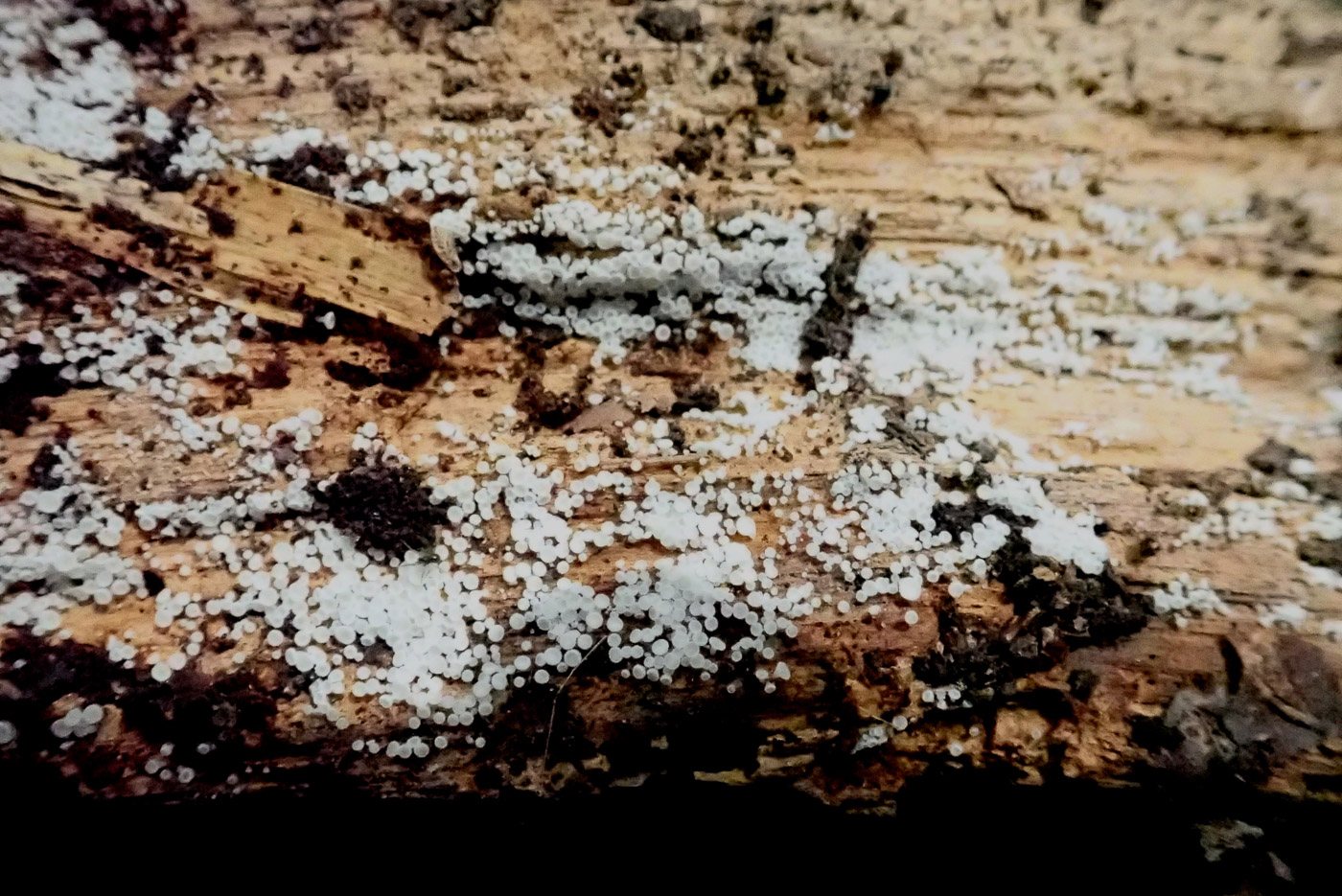
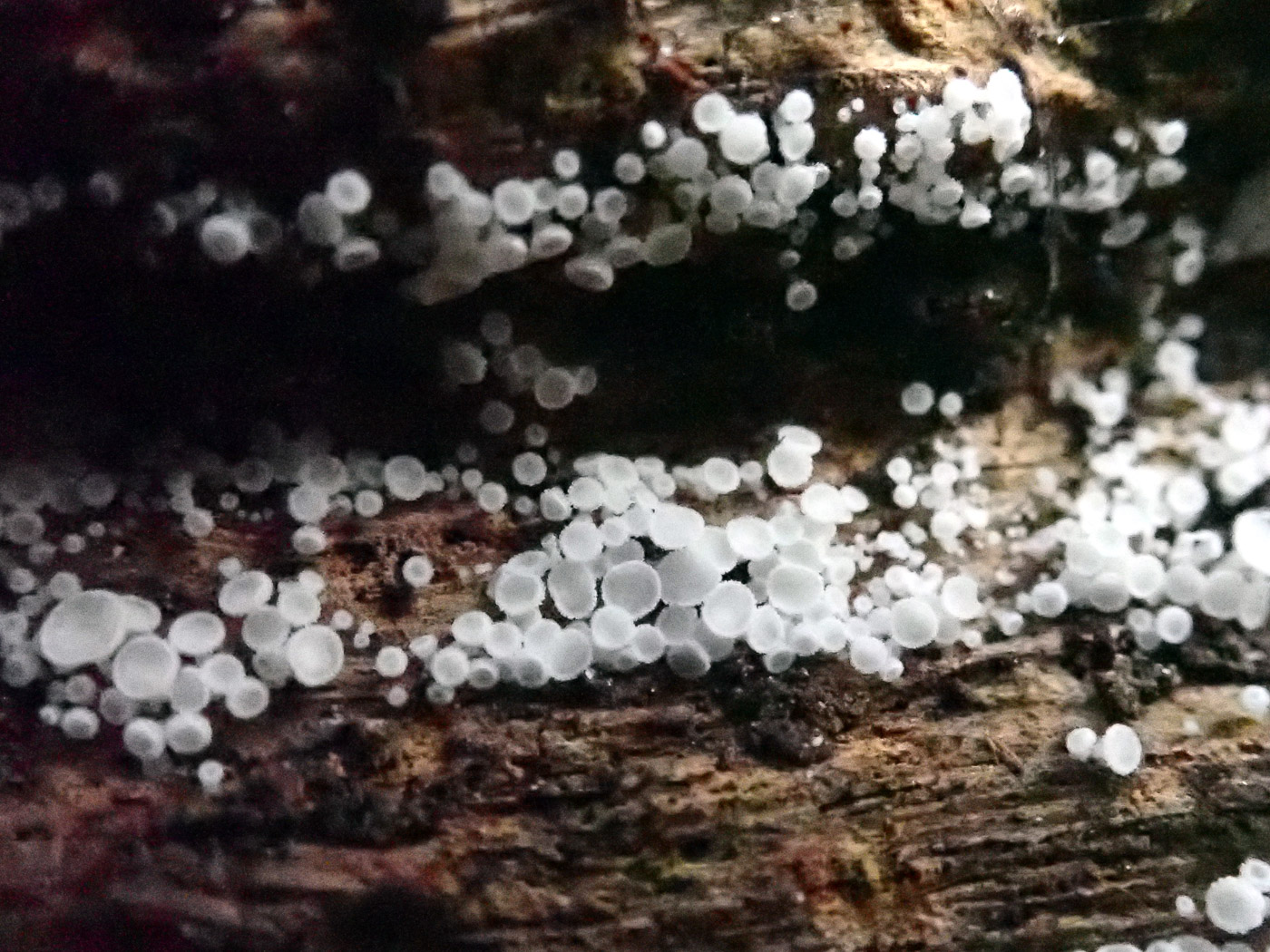

|
Lachnum virgineum (Snowy Disco) 
Mar 27, 2021. Turning over a damp Oak log at Turville Heath, Penny noticed a large swarm of tiny white cups which were less than 10mm across and (with a hand lens) had hairy white stems. This could have been one of four possible white species of Lachnum, all relatively common on deciduous wood and extremely similar in the field. A careful look at the hairs under high magnification is needed to determine which species you have, L. virgineum probably being the commonest of the four.(Apologies: these are not the greatest photos.)
Nov 9, 2020. Penny C. noticed this colony of tiny white cups on the end of a dead but attached Hazel twig in Rushbeds Wood. Caps were up to about 3 mm across, and they had a small hairy white stem underneath. There are many species of Lachnum, all tiny, some have a stem - some don't, some are hairy - some are smooth, some are white - some are coloured. See also another white hairy stemmed species, L. niveum (dated Sept 20) which has droplets in its stem hairs and missing from today's species. This is the commonest white hairy stemmed species and can often be found in large swarms on many different woody substrates. It is always necessary to confirm the determination at home with a scope, however.
|
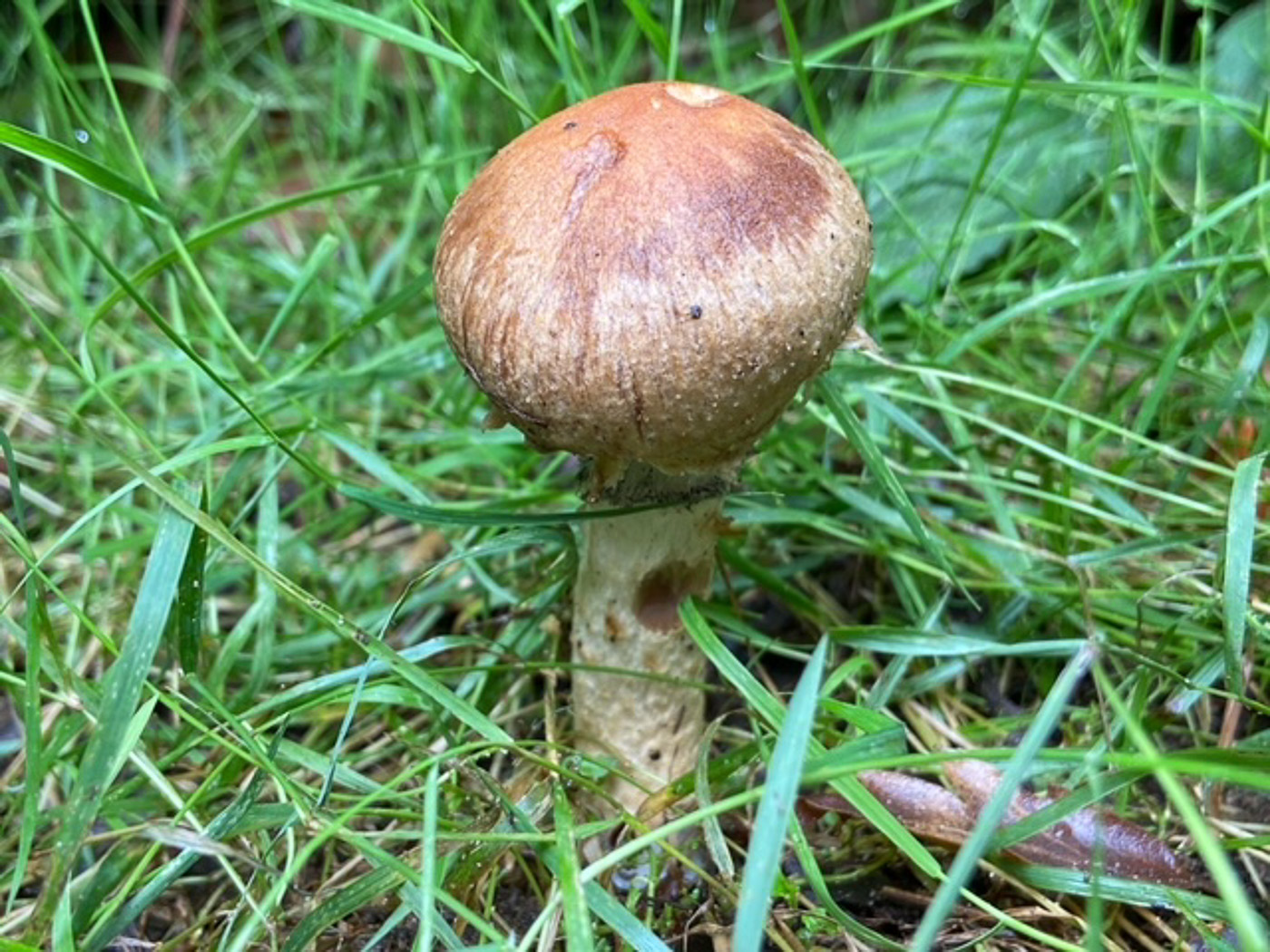
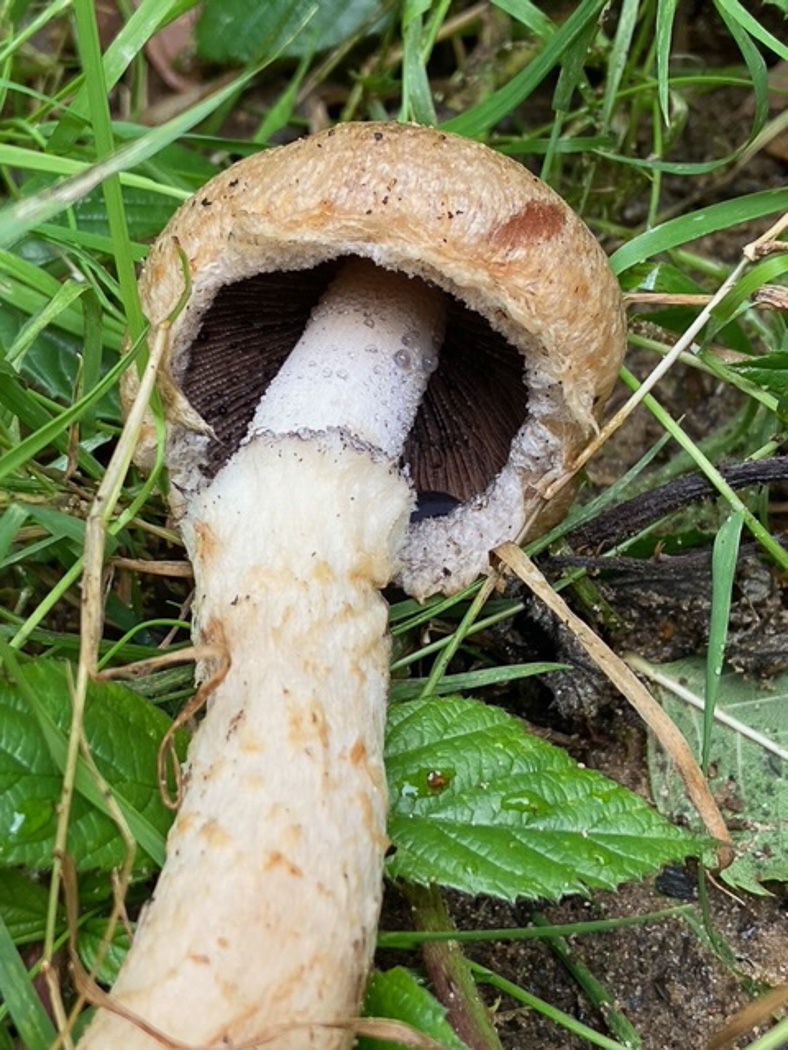









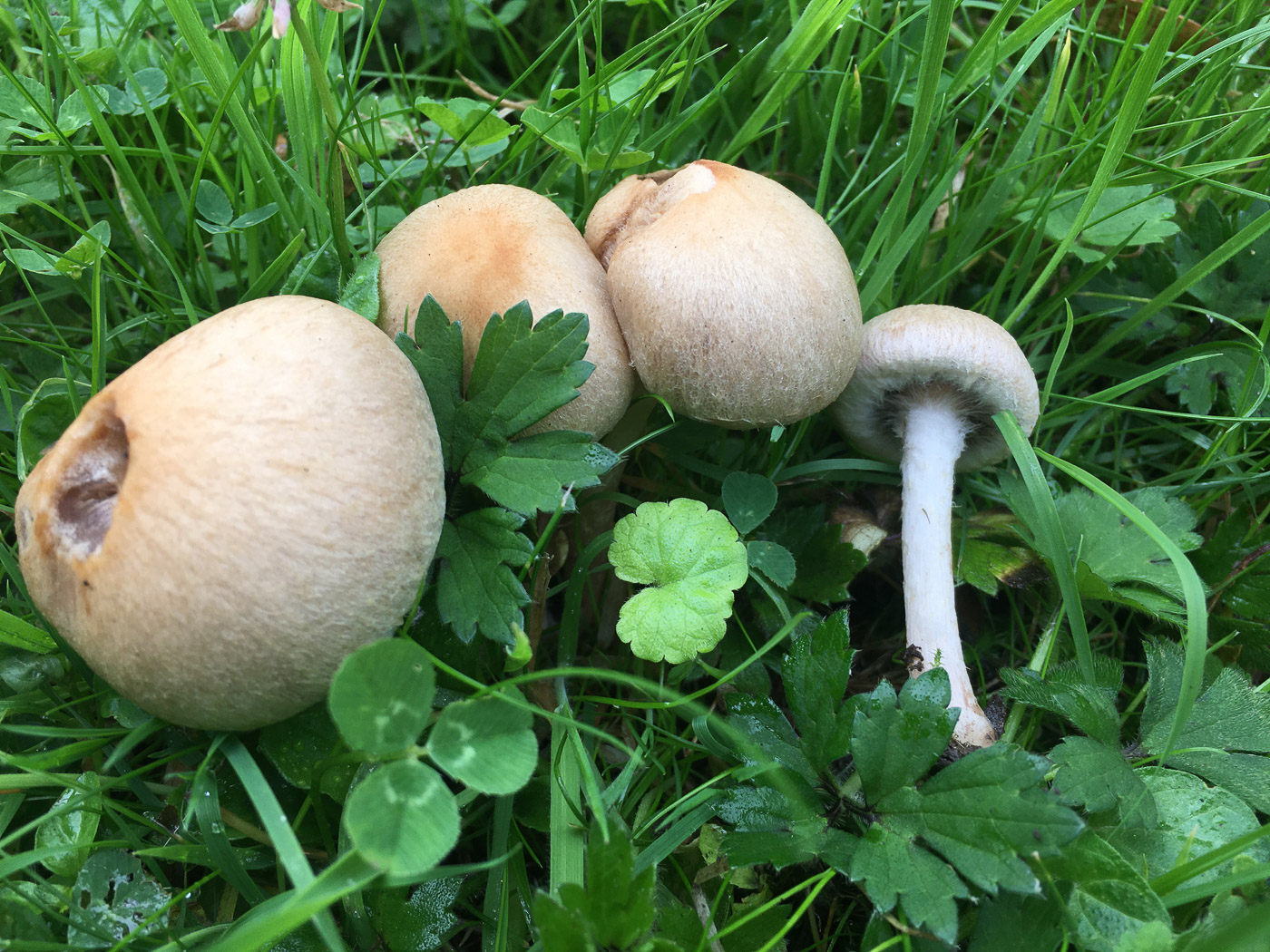
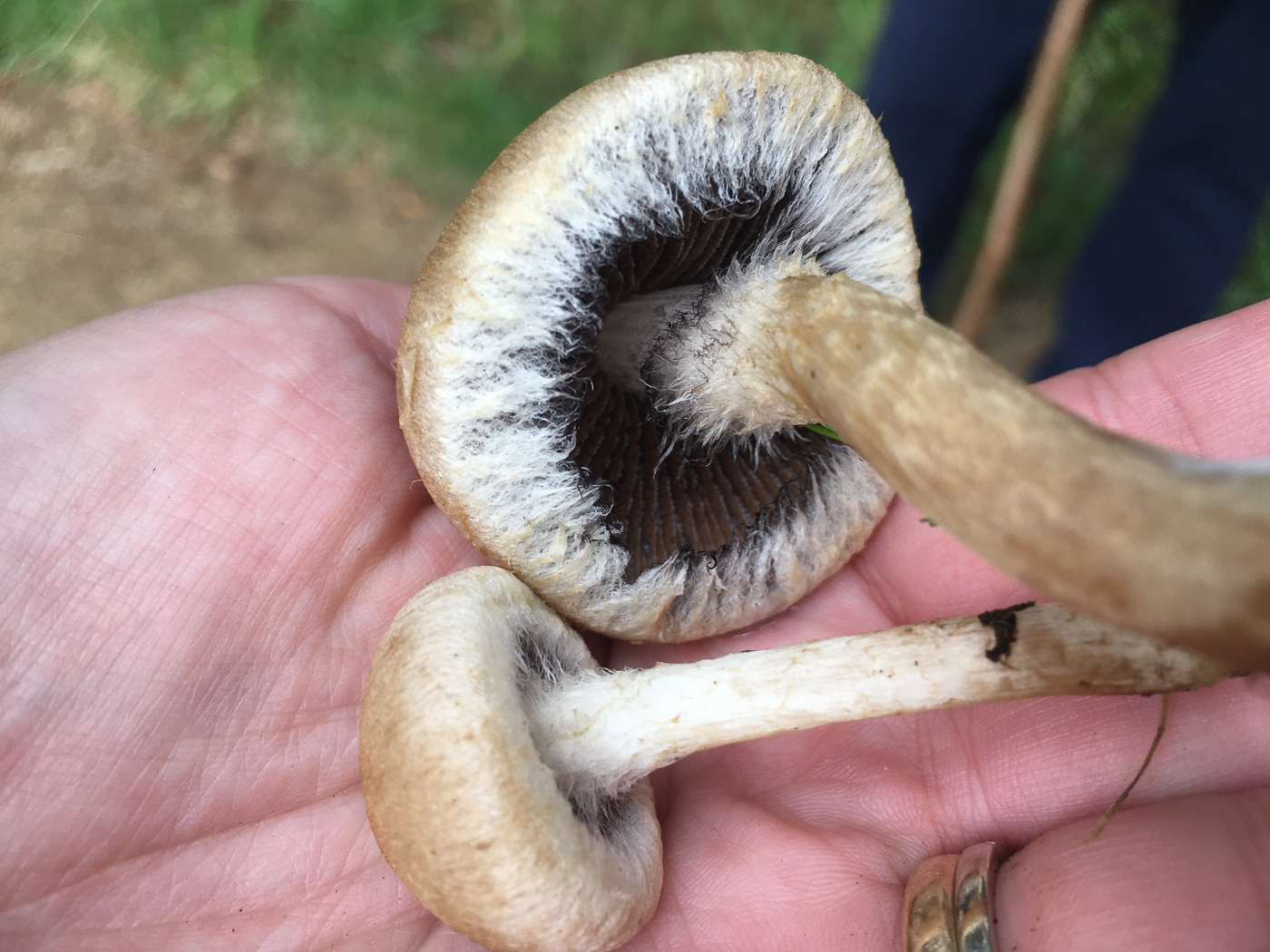
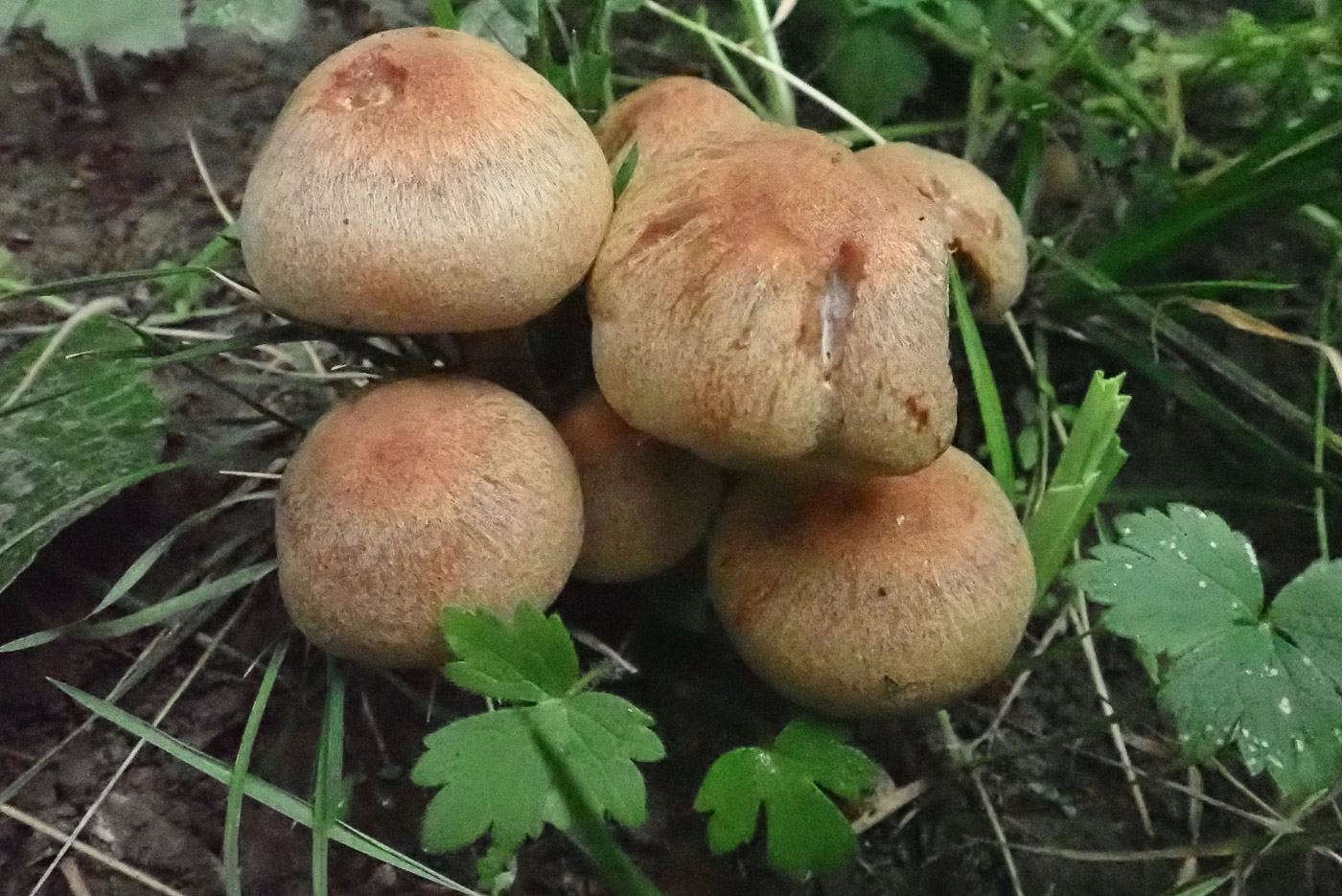
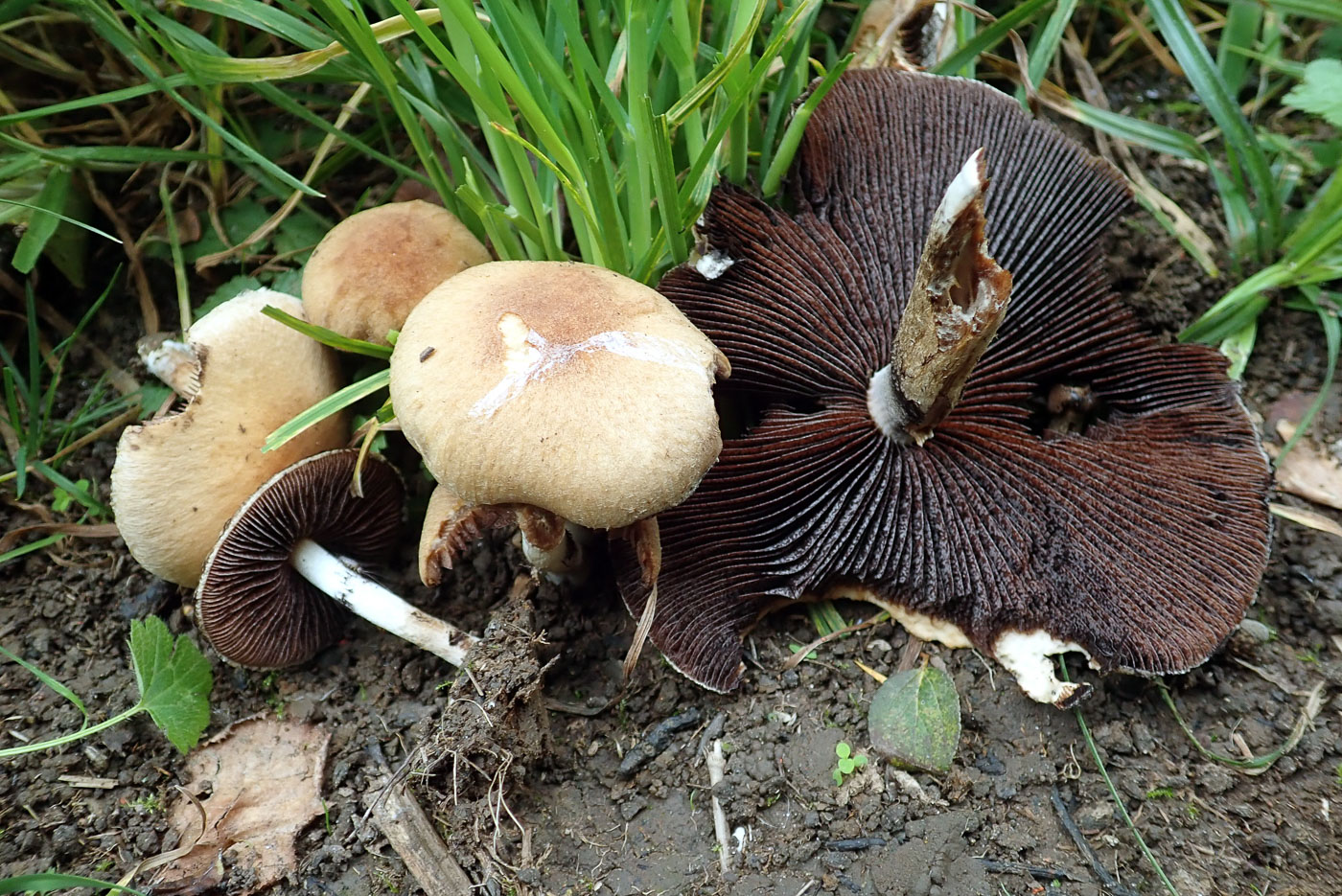 |
Lacrymaria lacrymabunda (Weeping Widow)
Sep 24, 2024. At Rushmere Estate a few days earlier Stephen Plummer noticed a small cluster of brown-capped mushrooms just emerging in a grassy path edge though with no gills showing as yet (photo 1). He was stumped and showed a specimen to Penny the next day who suspected it might be a species of Cortinarius (Webcap) but suggested he return to the spot in the hope of some further developed examples. This he did today when all was revealed! The gills, now just visible, made it obvious this was no Cortinarius as they were far too dark, and their telltale purplish black colour with tears of moisture droplets on the edge left no doubt as to its identity (photo 2). This is a fairly nondescript common brown mushroom which can confuse (as we found!). Another feature to note, besides the distinctive gills and its preference for grassy soil, is the fluffy ring on the stem which can sometimes leave ragged remnants on the cap margin as well.The species is often to be found in churchyards around the gravestones though there is nothing sinister to be read into this association!
Sep 26, 2023. At Prestwood Churchyard Penny first found two specimens pushing through the short grass which she guessed were this species (photo 1) though no gills were yet showing. Later she came across another collection which was developed enough to confirm her ID (photo 2). She then encouraged the ring under the largest cap to disperse (photo 3), revealing the telltale dark gills with droplets already forming - hence the common name. Not only do the gills 'weep' in this species but it is often to be found near gravestones in churchyards though certainly not exclusively - there is no macabre connection to what lies beneath here! See the Masterlist for further examples.
Aug 12, 2023. At Stampwell Farm Jackie Ewan found this common species in a grassy verge. Though not immediately obvious from above what this mushroom is, once you turn one over and notice the dark gills, often with droplets attached, and the whitish veil strands on the cap edge and stem which originally were adjoined to form a ring, you have your ID. The common name refers to the gill droplets.
Aug 8, 2021. In soil in longish grass at Wotton Park Estate Joanna Dodsworth found typical material of this common species just emerging, one which frequents parkland, grassy paths, churchyards and the like, often in disturbed soil and early in the season. Caps can get to a good size, up to 10 cm across or more, and are shaggy to fibrous, pale to start with then gradually browner with age. The species name (meaning with abundant tears) comes from the black gills which have a white edge covered in fine droplets in moist conditions, and the underside view - photo 2 - shows the typical flocculose cap edge as the veil detaches from the stem leaving a ring zone. Photos 3 and 4 were of a collection of Penny's made a few days later at nearby Rushbeds Wood showing the more typical brown caps and a close-up of the gill droplets (with apologies for the blurred image).
Sep 10, 2020. Penny Cullington found this collection growing in a grassy path at Rushbeds Wood. A common grassland species, in damp weather the dark gills often have droplets, leaving a rather blotchy gill edge as can be seen here - a good field character.
|


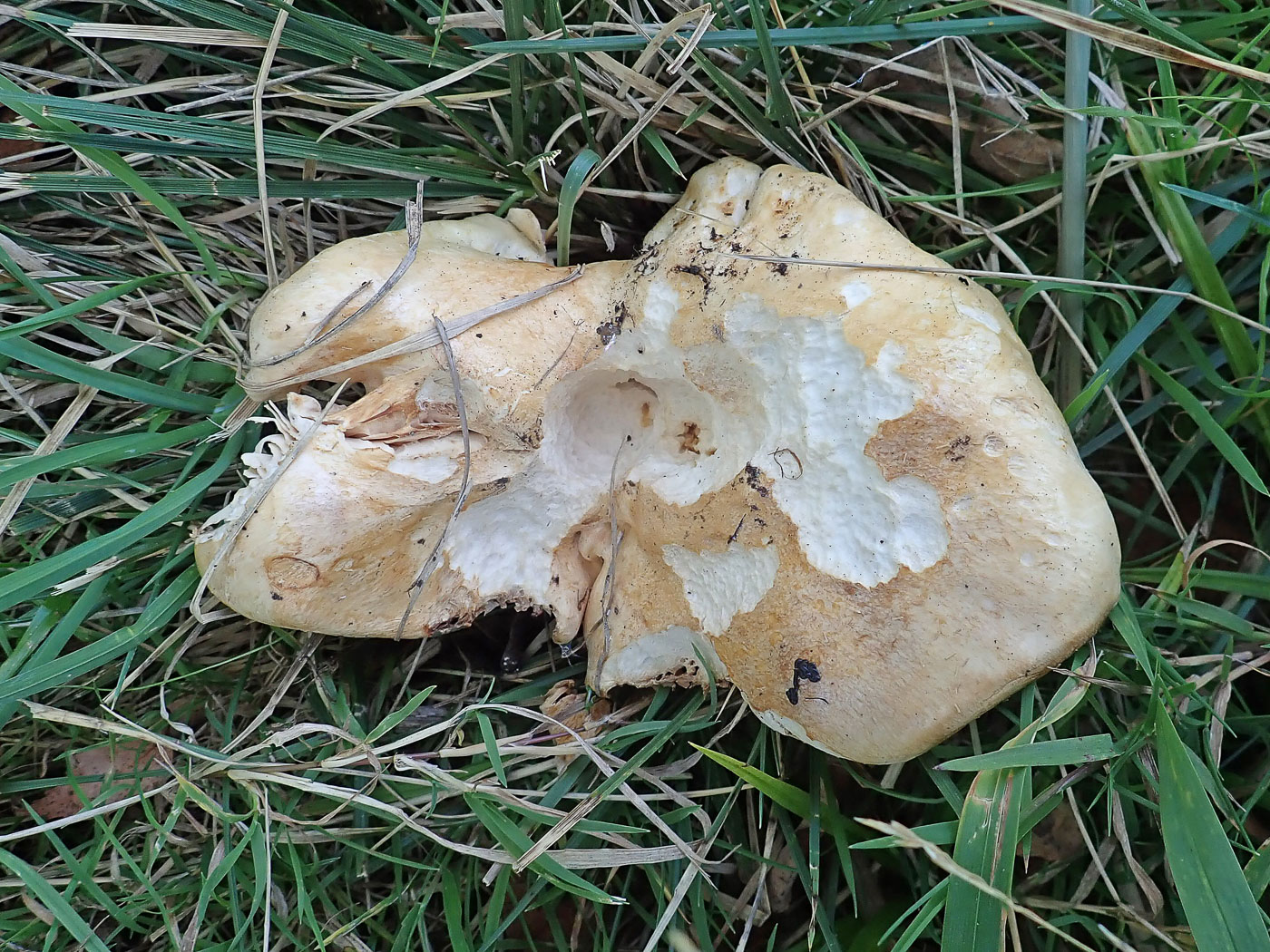
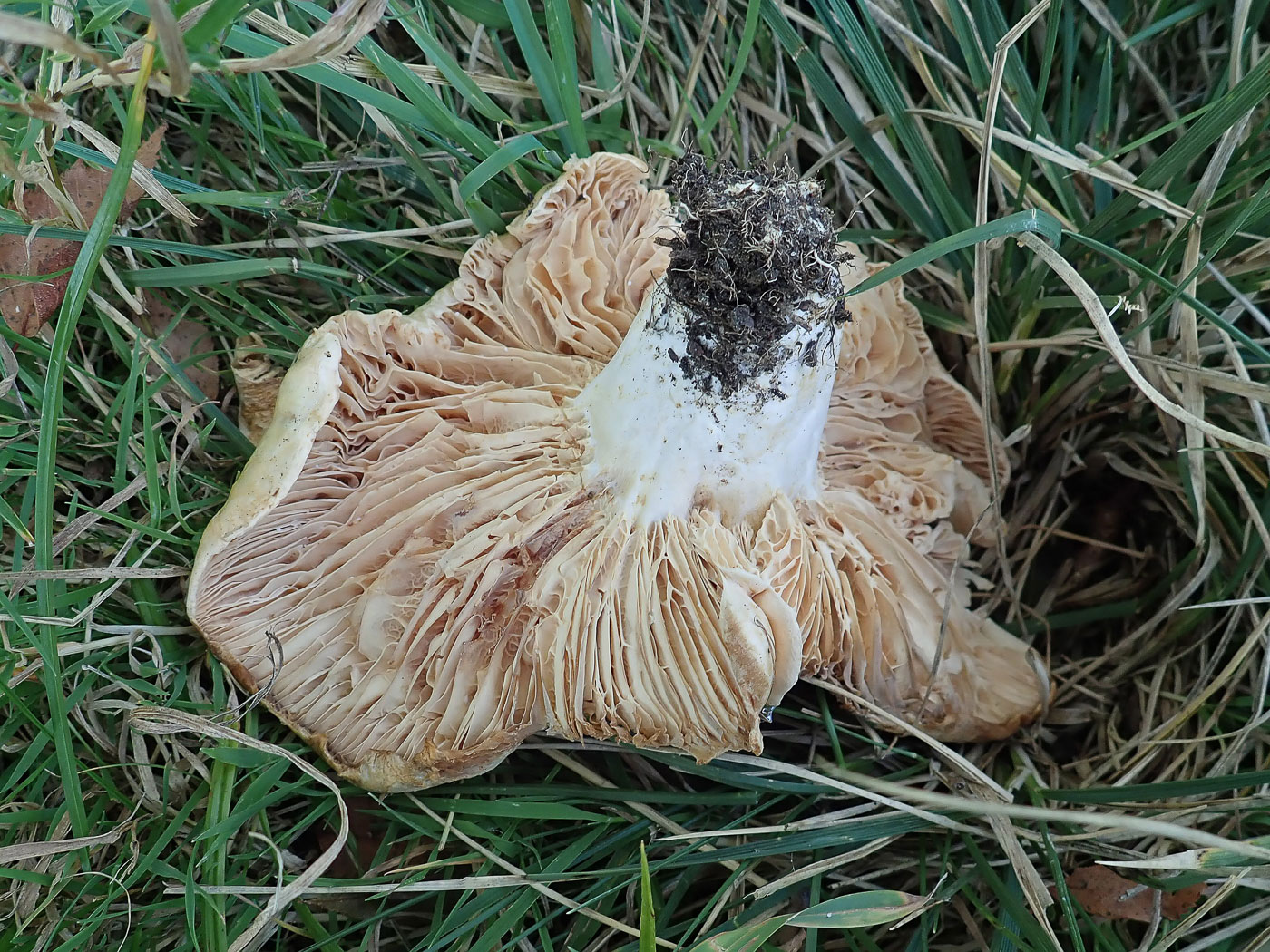
|
Lactarius acerrimus (Two spored Milkcap) 
Jul 25, 2023. In Bernwood Forest at a pathside in long grass under Oak Penny found first one cluster, then several more of this large misshapen mushroom which puzzled her. It surely had to be either Russula or Lactarius (the two are in fact very closely related), and as no milk was forthcoming when the gills were damaged she plumped for Russula (though it didn't fit with any she knew). Testing with Guaiac on the stem produced a positive strong blue reaction (seen here) which pointed also to this genus, but an FE crystal did nothing much and why were the gills this pinkish shade, also strongly anatomosing (with cross ridges)? At home various microcharacters also didn't fit with Russula and the light dawned: this was indeed a Lactarius and eventually one immature specimen she'd collected showed signs of milk when sliced with a sharp blade. Lactarius acerrimus is a very unusual Milkcap, often reluctant to produce milk and with basidia on the gills which bear only two spores each - a unique feature within the genus. This feature checked out as well, confirming the ID. Photo 2 was of a further collection made here by Jesper Launder a day later.
Sep 23, 2020. This quite rare Milkcap was found by Joanna Dodsworth under Oak at Wotton Park Estate (photo and microscopy Derek Schafer). Nothing much to write home about to look at, the significant features of the species lie below and within! Turn it over to reveal the distinctive distorted and anastomosing (conjoining) gills, rather short stem and a smell of stewed apples! With a scope one notices larger spores than normal for the genus, this brought about by each basidium (spore producing cell) developing just two spores rather than the normal four, a unique feature within the genus. (NB do not infer from the common name that each fruit body only produces two spores! There are thousands of basidia on each gill!)
|



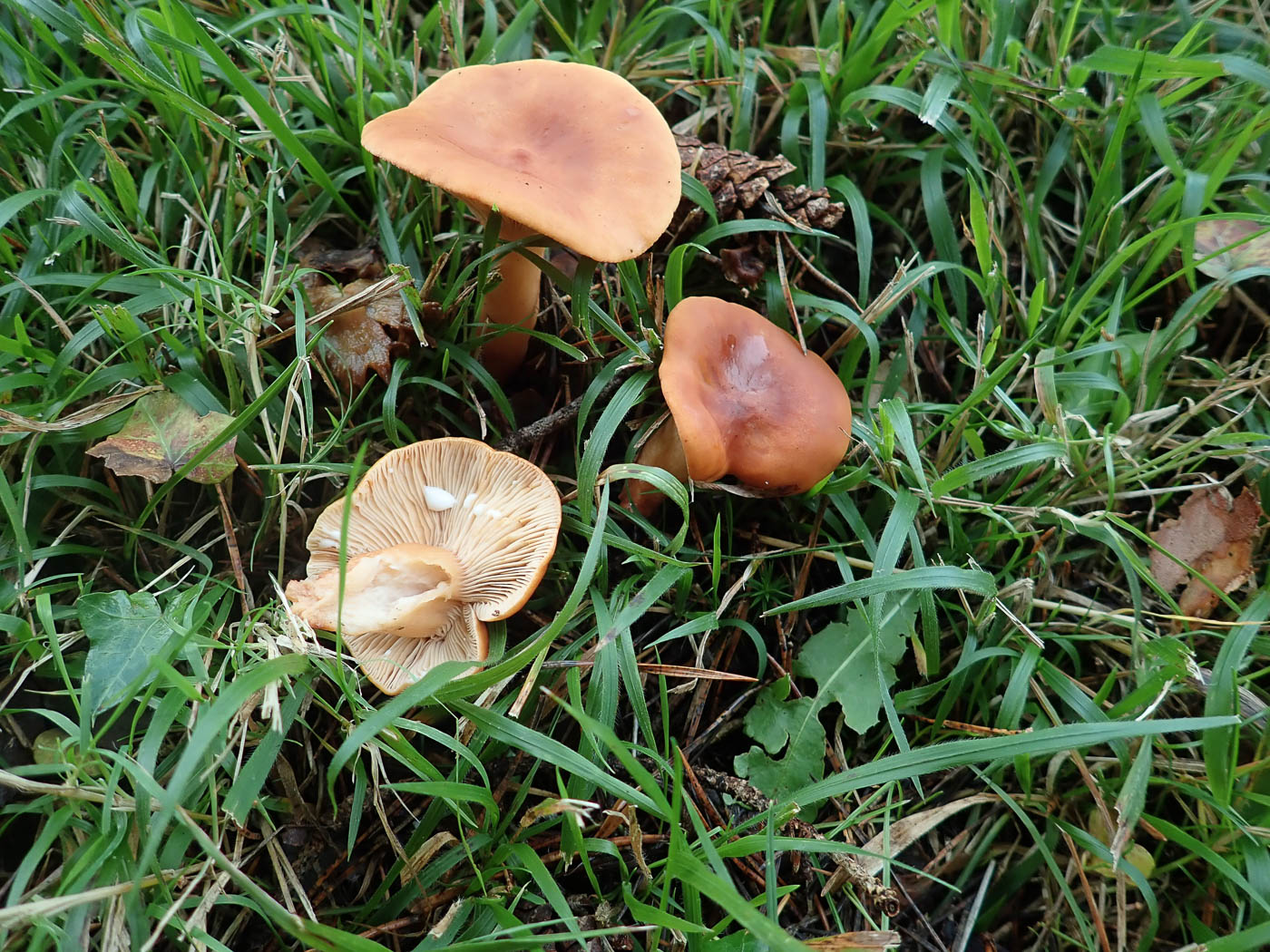

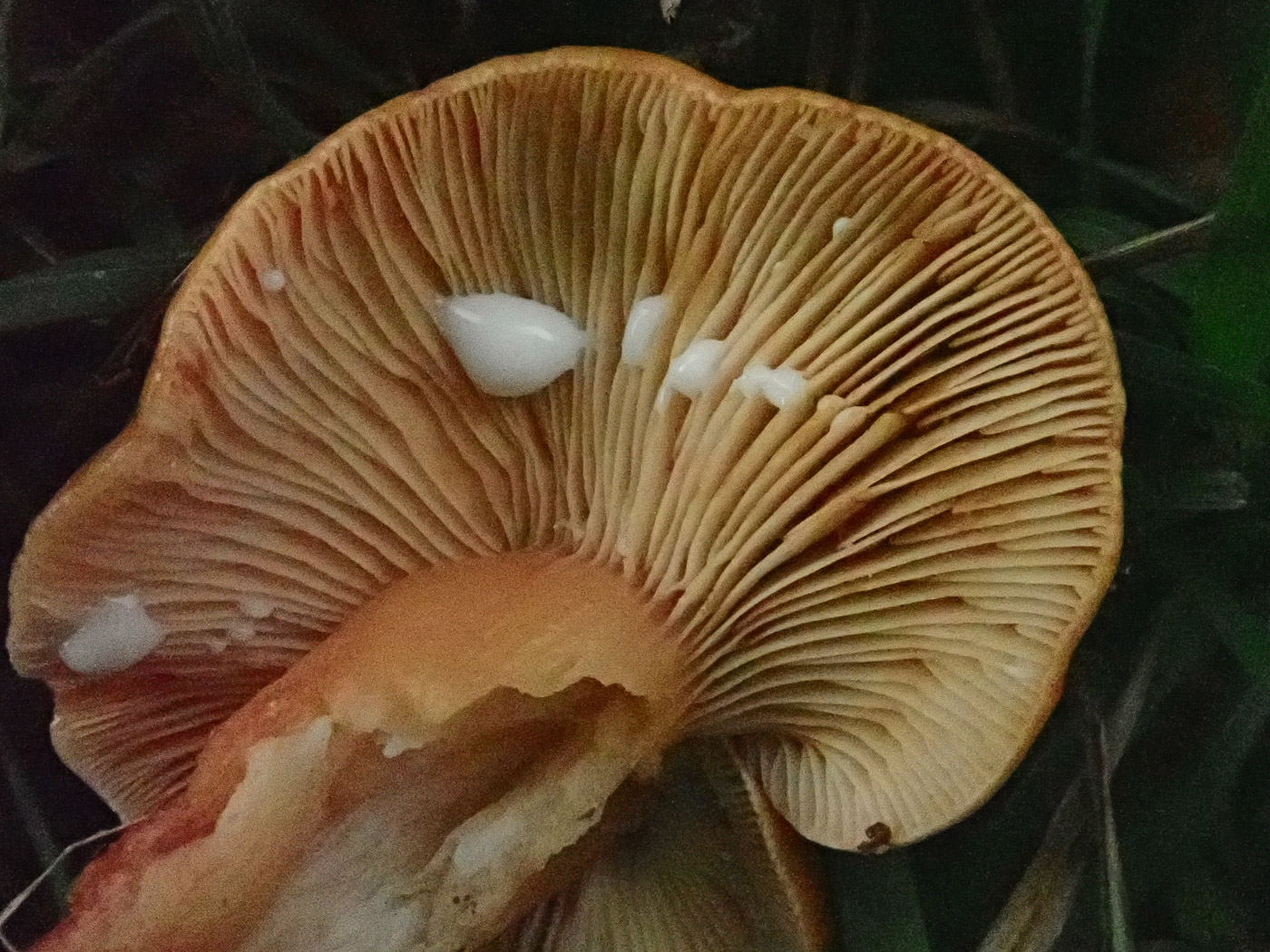 |
Lactarius aurantiacus (Orange Milkcap) 
Oct 17, 2023. At Prestwood Churchyard in longish grass near Oak and Pine Penny found several of these brightly colour Milkcaps. The species has perhaps the most intensely colour orange brown caps and the watery milk remains white on the gills when damaged. It is an occasional fruiter in mixed woodland and here was associating with one of the nearby trees. See the Masterlist for our two other entries.
Jul 26, 2023. In Bernwood Forest Jesper Launder found this bright orange Milkcap, a member of this genus having a cap with possibly the most intensely orange colour. It is not that common and occurs in mixed woodland, having a strong smell similar to that of L. quietus - the bedbug smell! See also in Finds 2022 November 17th.
Nov 17, 2022. Under Pine just outside Prestwood Churchyard Penny found several really brightly coloured Milkcaps and checked out which they might be at home. L. fulvissimus is a similar colour, also L. brittanicus and possibly L. lacunarum but she found that the only one likely under Pine was this species, backed up by the fact that the milk did not turn yellow on the gills after time as happens with both L. lacunarum and L. brittanicus. Furthermore L. fulvissimus is associated solely with deciduous trees. This is a new entry for Finds.
|



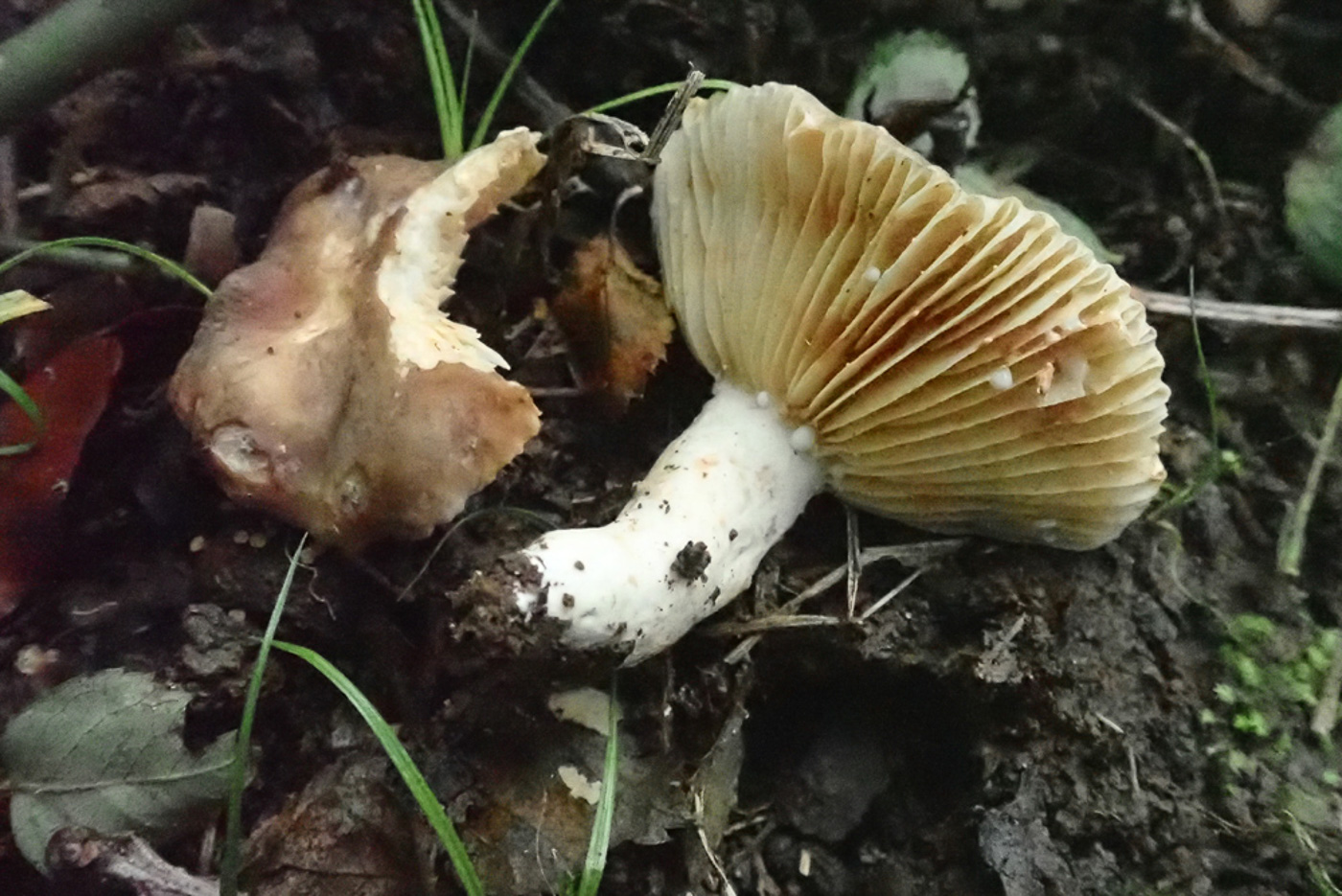

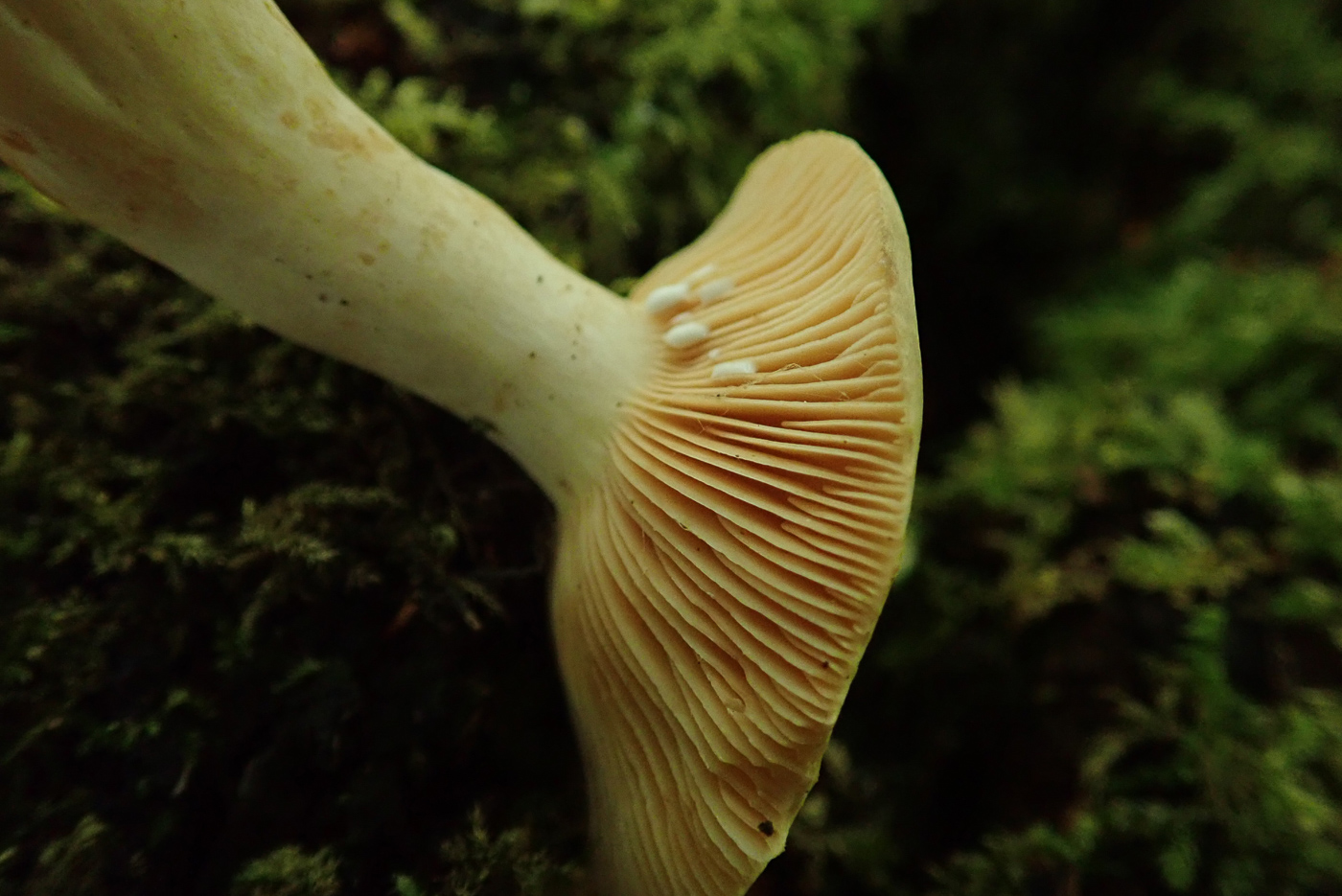
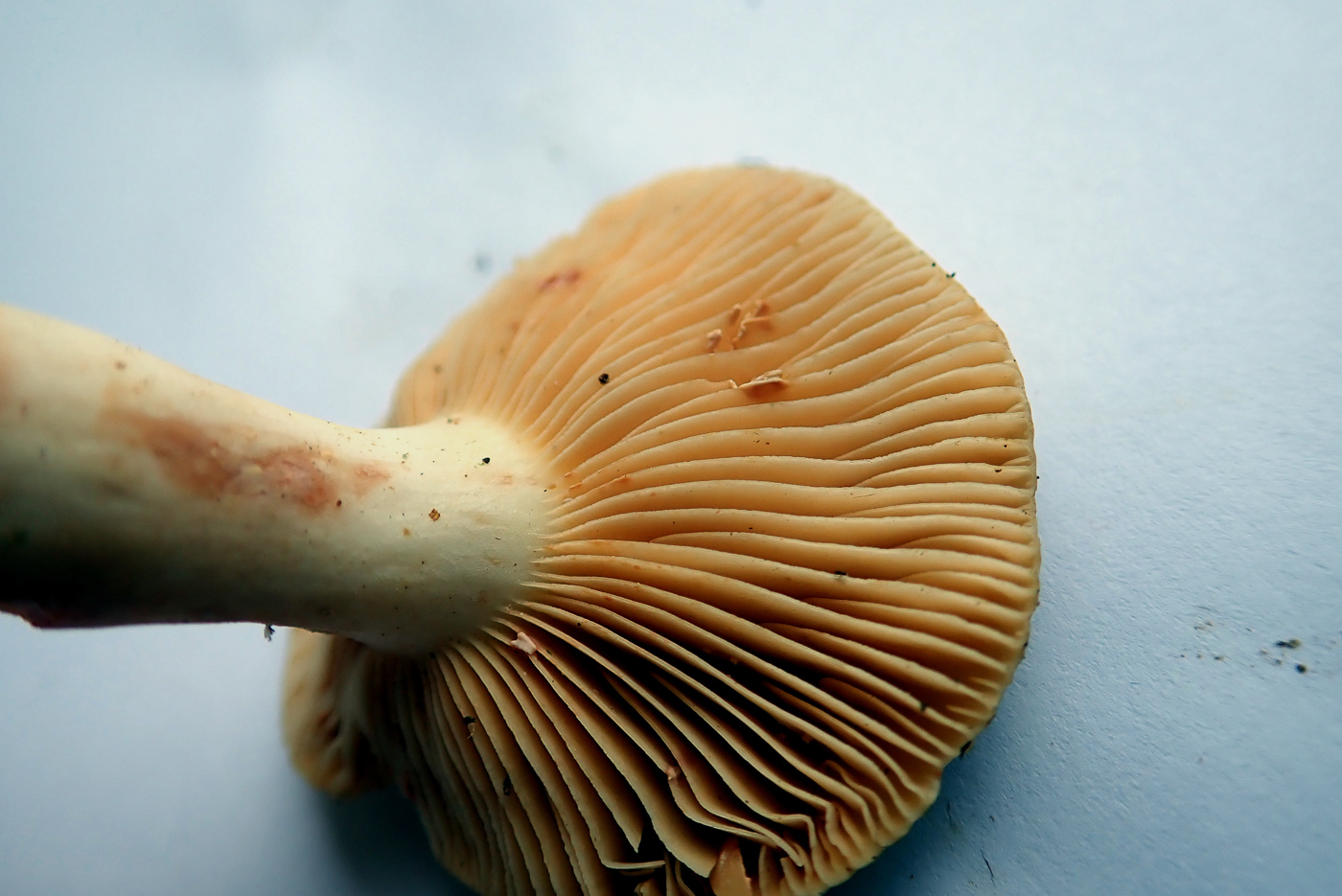
|
Lactarius azonites (a Milkcap with no common name) 
Jul 16, 2023. Under Oak at Bernwood Forest Jesper Launder found a collection of these quite unusual Milkcaps, one of a small group of this genus which has latex (milk) which turns pink on the gills when damaged. It has a dry velvety slightly mottled palish brown cap, a white stem and abundant milk which takes 5-10 minutes to turn pink. Photos 2 and 3 are of a collection from Rushbeds Wood made by Penny a month or so later, photo 3 taken about 10 minutes after collection to show the milk drying pink.
Under Oak in Rushbeds Wood Penny found this pair of Milkcaps which clearly had milk turning pink on the gills where damaged. In this genus of about 70 UK species there are 6 which have this character thus quickly eliminating the vast majority. L. azonites is probably the commonest of the 6 though not that common in itself (and new to the site today). Other features to distinguish it are the dry 'milky coffee' brown cap, quite widely spaced anastomosing gills (ie with cross ridges as in Mycena galericulata), and whitish stem.
Oct 12, 2020. Penny and Paul Cullington came across several fruit bodies of this unusual Milkcap under Oak and Beech in Gussetts Wood. Notable for its rather peachy orange gills, the milk as it dries turns pink, as does the stem flesh where damaged, though this takes 15 minutes or more so a fruit body needs to be contained and and an eye kept on it. (Photo 3 shows the dried pink milk on the gills and stem.) There are several Milkcaps which have milk which turns pink in this way and care is needed to tell them apart; it's best to check the spores ornamentation to confirm the determination  . This particular species favour Oak which was present nearby today. . This particular species favour Oak which was present nearby today.
|
 |
Lactarius azonites forma virgineus (an unusual Milkcap with no common name) 
Aug 7, 2023. In Tinkers Wood under Beech John Catterson found this trio of whitish Milkcaps which he was very unsure about and sent the photo to Penny for help. He wondered if it was L. pallidus but noticed that the milk turned pinkish on the gills where damaged (though still showing white in his photo - this colour can take half an hour or more to develop). There are a handful of Milkcaps with 'pink milk' and they can be difficult to separate, but this one has an unusual white form (seen here), also the spore markings differ from others which also helps. See a previous collection with more typical coloured caps on July 16th, with two other earlier collections in Finds also.
|
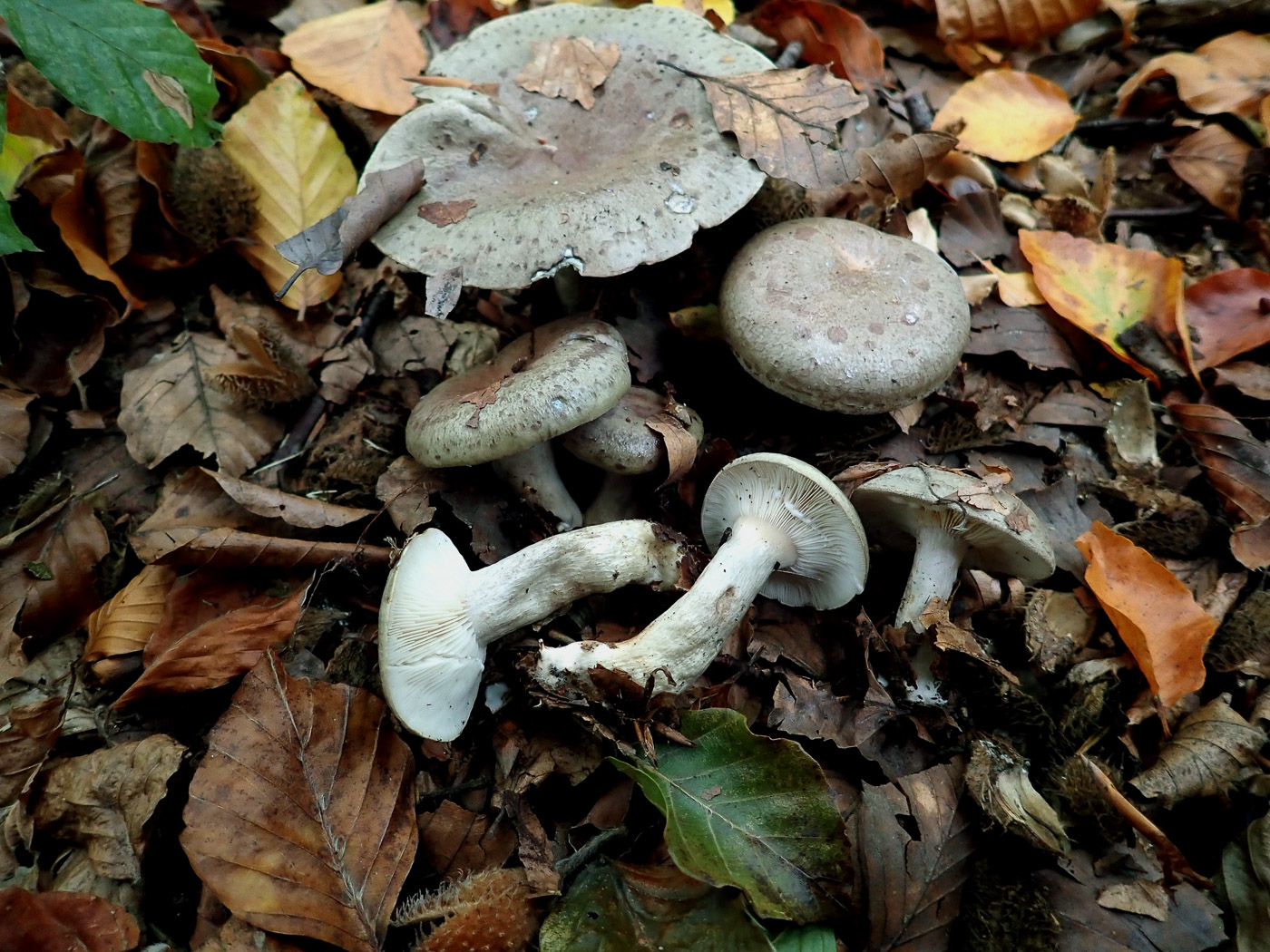
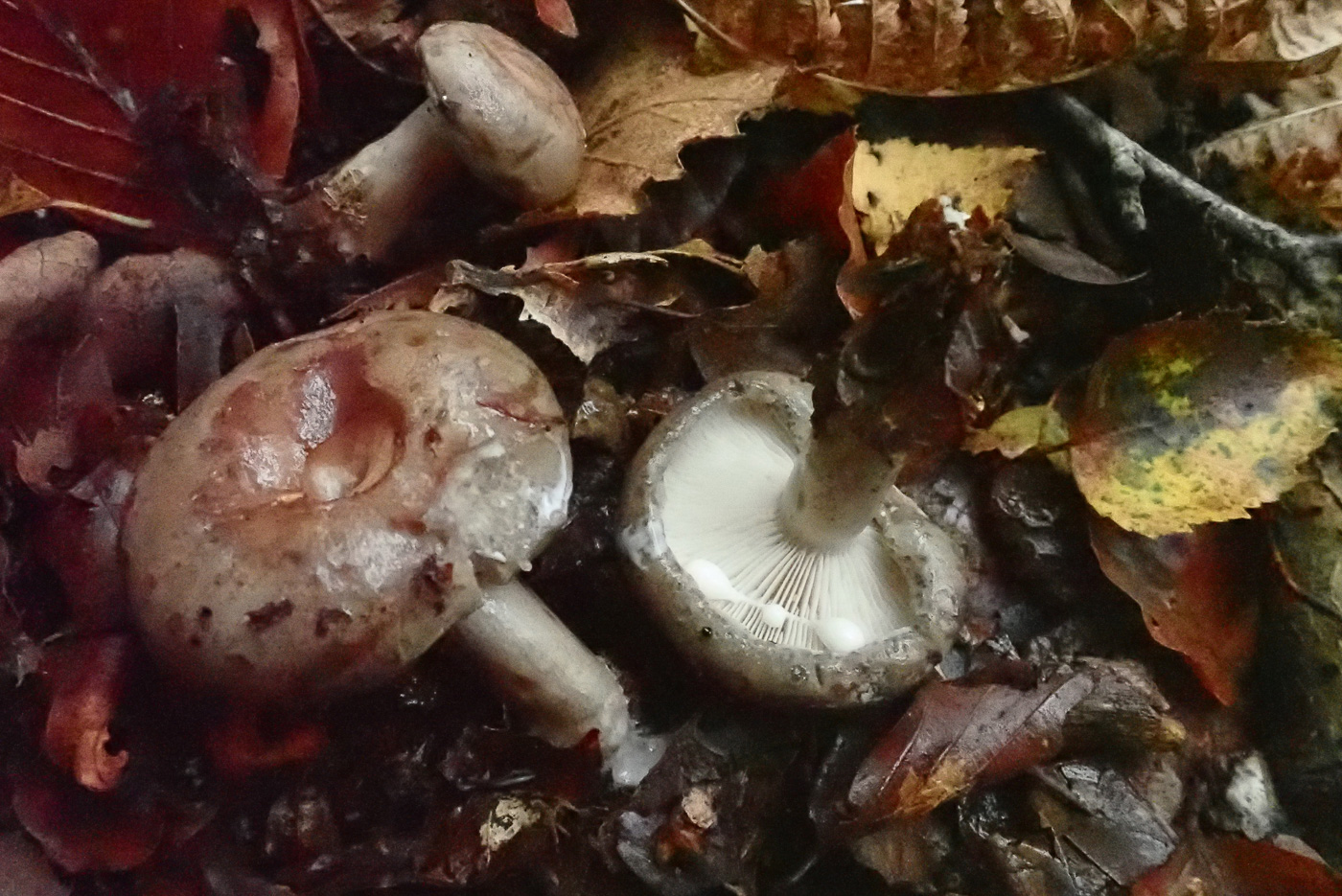
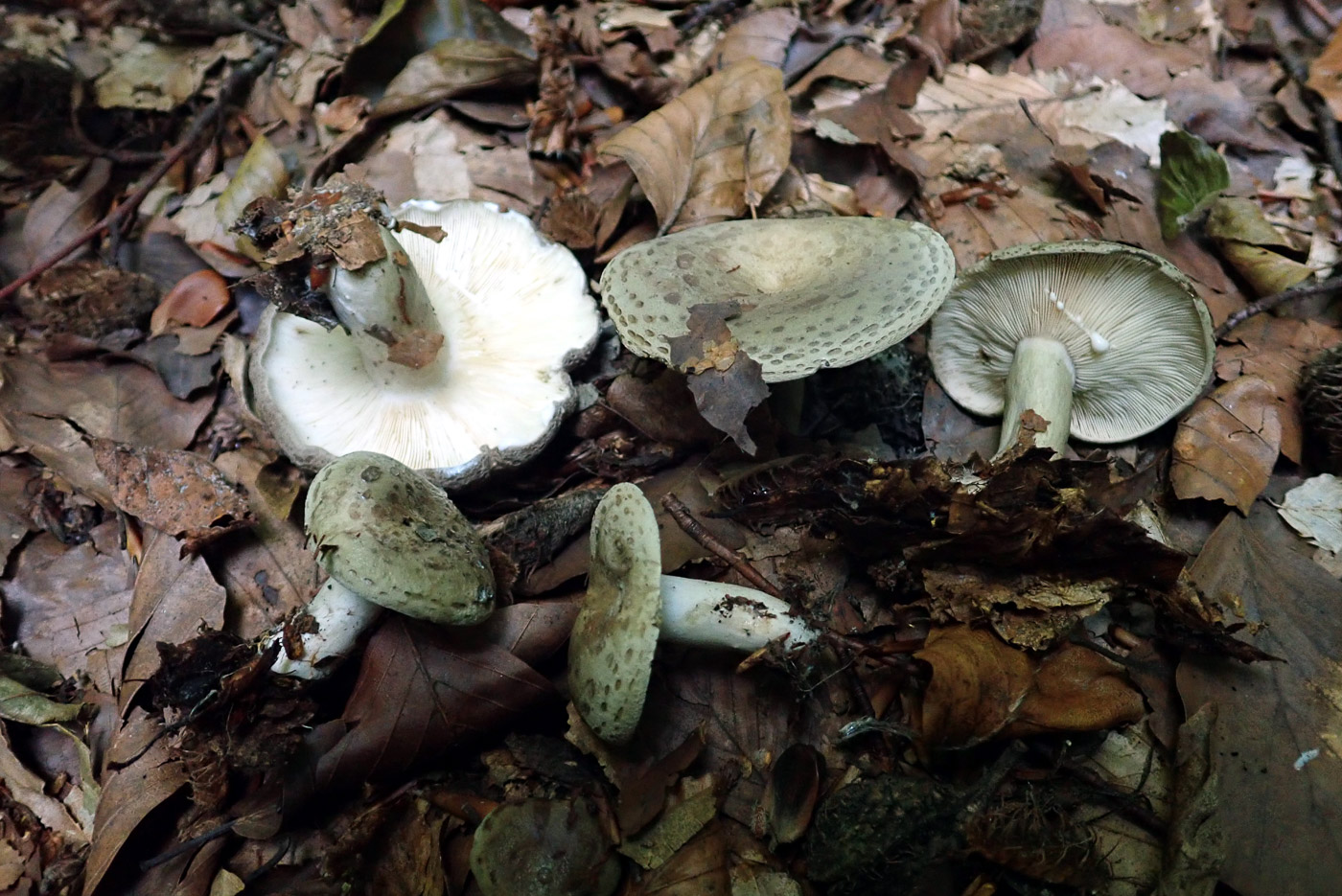
|
Lactarius blennius (Beech Milkcap)
Oct 7, 2022. At Pullingshill Wood Penny found good numbers of this distinctive Milkcap - common wherever there's Beech. It has a sticky quite shiny cap (often having debris attached as here) and its greenish olive tinge with darker droplet-like markings mark it out as different from others in the genus. The milk is usually copious and turns grey as it dries on the gills.
Nov 3, 2021. In Hodgemoor Woods Penny found several specimens of this common Milkcap though, like the Brittlegill above, it has not been that common recently. Only found under Beech, it has quite a pale olive grey to buff cap which typically has mottled darker dropletlike markings around the edge and in wet weather, as here, is very slimy. The gills are cream and 'milk' is copious but turns olive grey on the gills as it dries. It is easily confused with L. fluens, another Beech associate which has a very similar set of characters but lacks the droplet markings and typically has a pale margin.
Sep 13, 2020. This collection was found by Penny Cullington under Beech in Pullingshill Wood. One of our commonest milkcaps and host specific to Beech, it is easy to recognise if one notes the darker droplet-like blotches on the pale olive grey background - however, they are not always as obvious as in these specimens. Note also the cream gills with (usually) copious milk which turns greenish olive as it dries - this can take anything from a few minutes to half an hour.
|
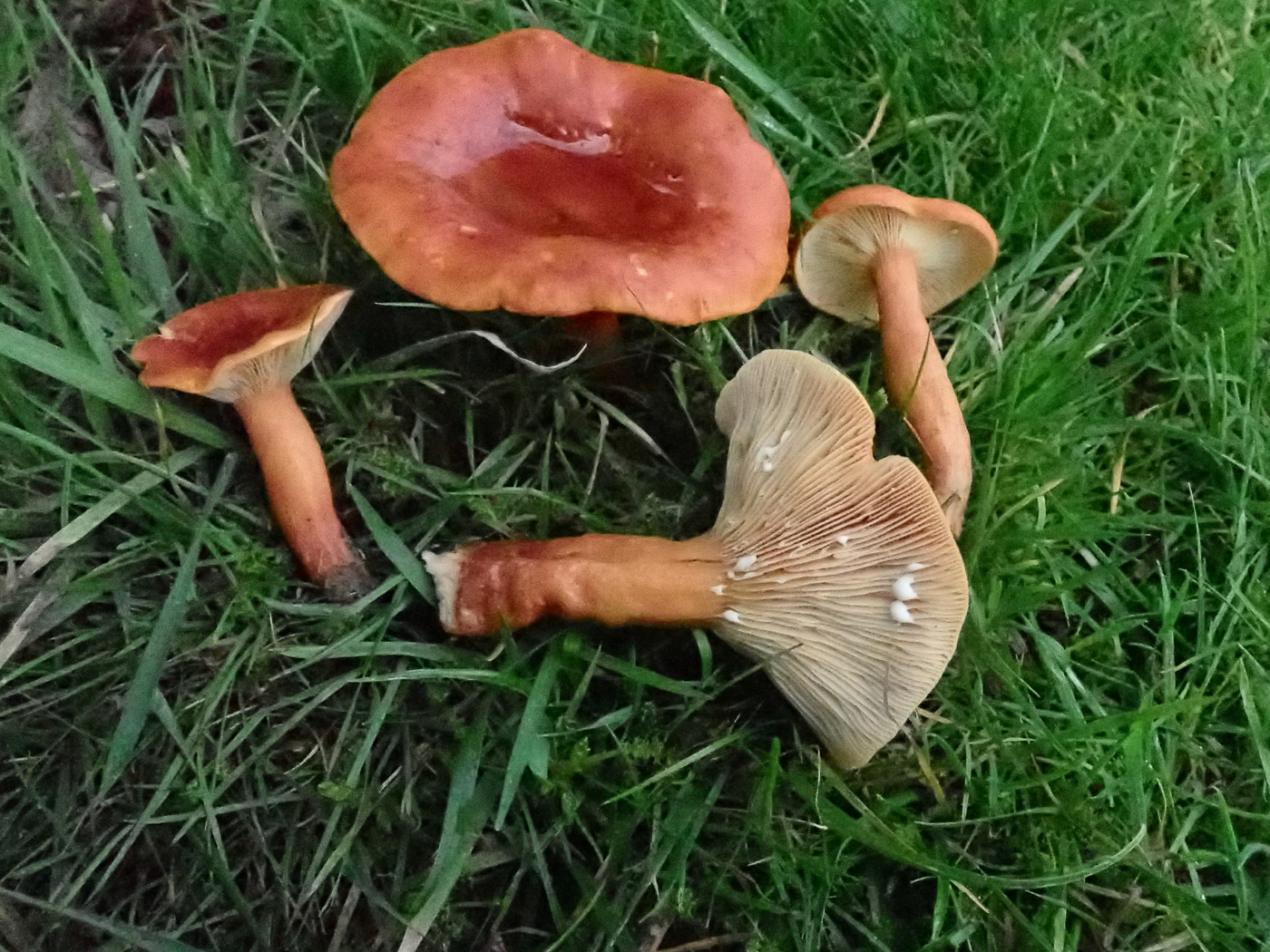 |
Lactarius britannicus (Tawny Milkcap)
Oct 30, 2021. This species was a surprise to Penny in Prestwood Churchyard where grassland rather than woodland fungi are expected. However, this brightly coloured Milkcap was under an Oak and the impressive largest cap was about 7 cms across. Its bright rust to apricot cap separates it from other more duller brown Milkcaps though it has a simlar rubbery 'quietus' smell found in many Milkcaps.
|
 |
Lactarius camphoratus (Curry Milkcap)
Aug 19, 2023. In a grassy ride in Rushbeds Wood Penny noticed this sizeable patch of Milkcaps under Oak and Hazel. Though none of the specimens would produce enough milk for a photo there were characters here which helped with the ID: Firstly the brown stem with reddish tints, secondly the tendency for the caps to form a funnel shape with gills sloping upwards (even in the two immature fruitbodies at the front), thirdly the 'fluting' developing around the margin in the older fruitbodies, but most significantly the smell of curry (which was not as strong as sometimes here but still noticeable). This is an occasional species, possibly decreasing in our area - we don't often come across it now, and is a first for Finds and for the site.
|
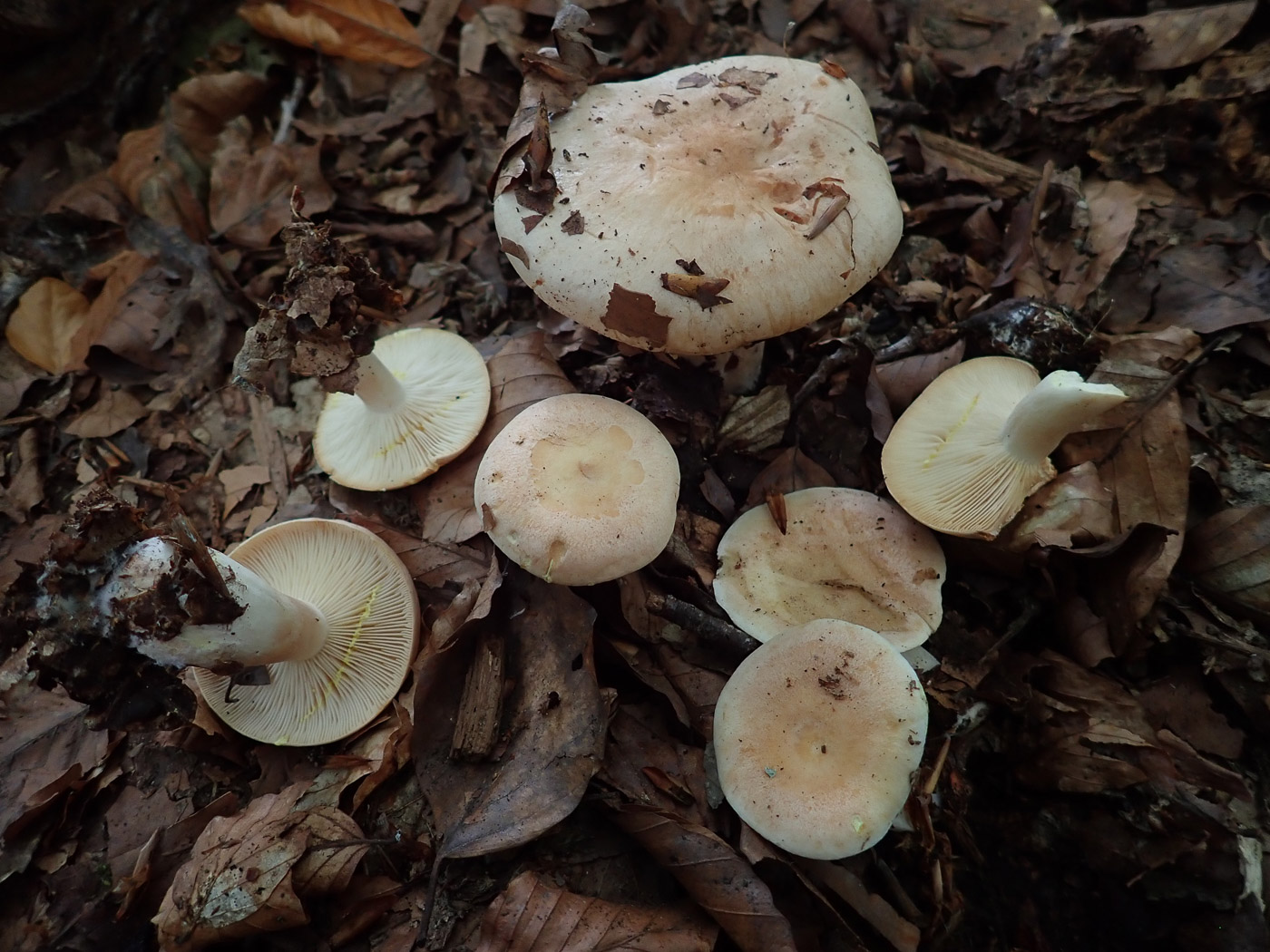
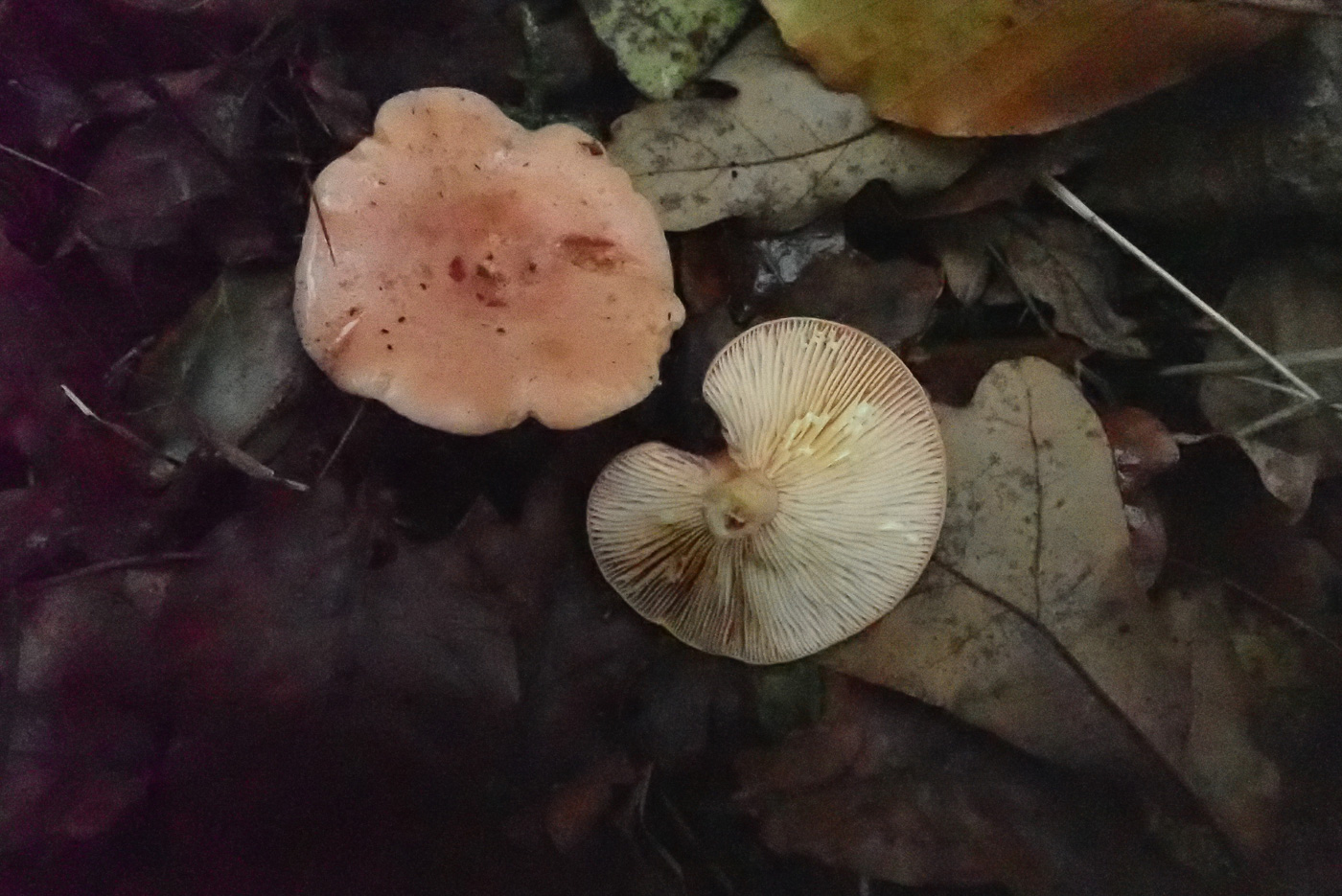
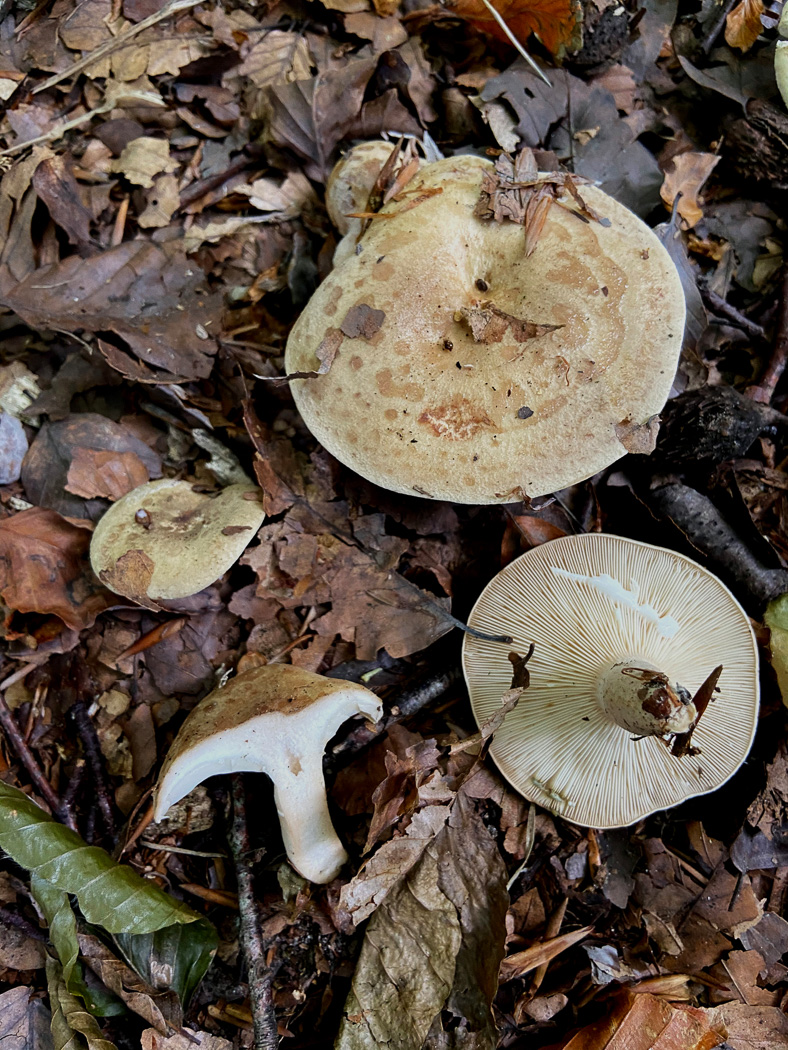
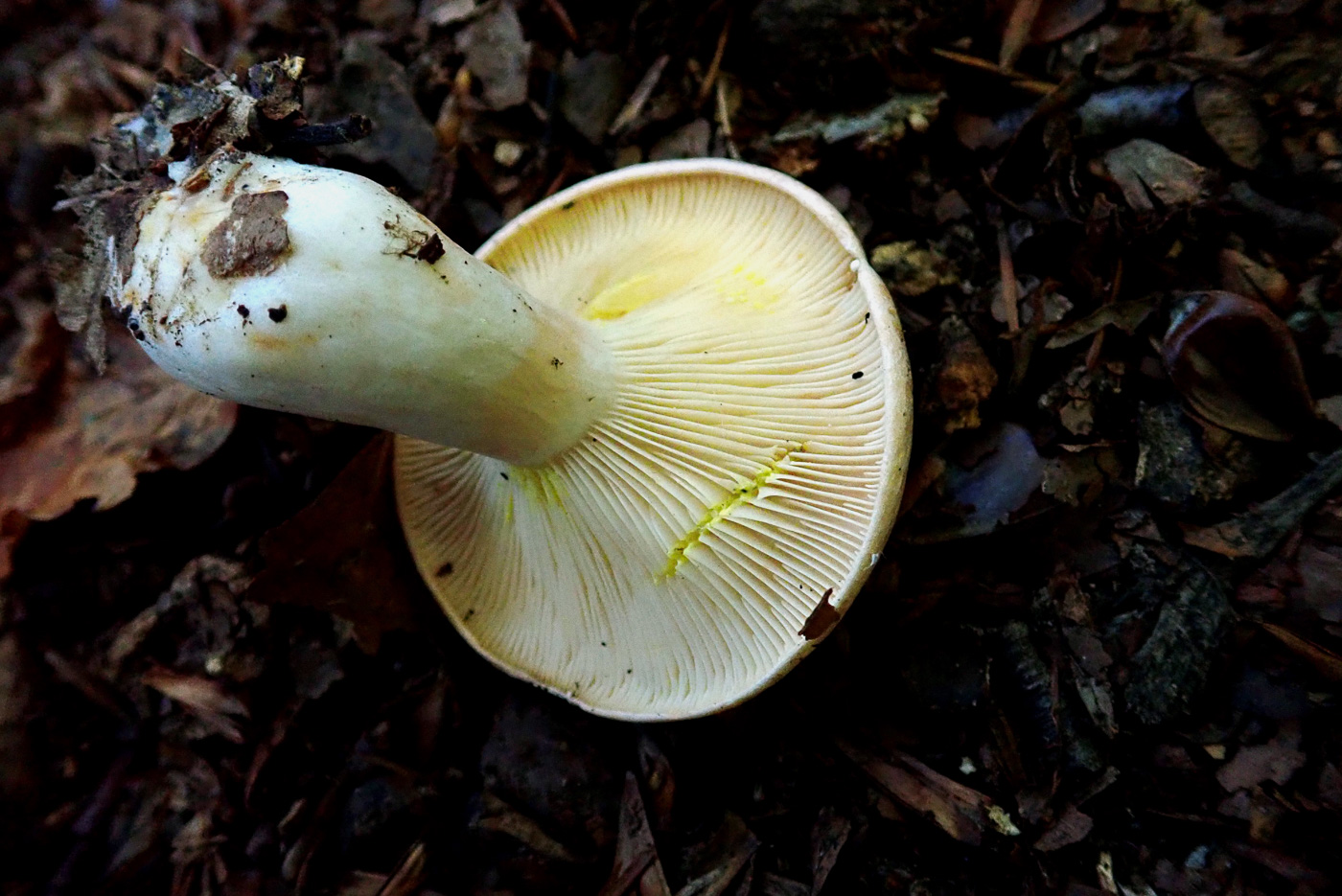
|
Lactarius chrysorrheus (Yellowdrop Milkcap)
Oct 7, 2022. Under Oak at Pullingshill Wood Penny found this attractive Milkcap - not one of our commoner species but with a lovely peachy pink cap, often with zoned darker areas but these were not present today. This made her wonder if it might be the similarly coloured L. pallidus (Pale Milkcap) - a Beech associate rather than Oak but also nearby today. She watched for the telltale change of milk colour to bright yellow where she'd damaged it - no need for a hankie here, it changes on the gill in this species usually within half a minute or so, but there was no sign of it. A while later, having picked up a much larger specimen elsewhere, she then returned to the original collection to find that there was now a yellow line across the gills where she'd sliced it, confirming her ID.
Nov 3, 2021. In Hodgemoor Woods Penny and Paul made sure they checked a certain Oak where this Milkcap often seems to fruit. Paul found two specimens - perfect! Much more common under Oak is L. quietus (Oak Bug Milkcap), having a mid brown zoned cap and a rubbery smell (known as the 'quietus smell' amongst mycologists). Today's species has a decidedly paler more pinkish cap though still zoned, but its key feature is its milk which turns bright yellow on the gills after a few seconds - no need for a hankie with this one!
Sep 21, 2020. This collection was found by Sarah Ebdon under Oak in Bradenham Wood. An occasional Milkcap, it is only found under Oak as also is the much more common and darker capped L. quietus (Oak Bug Milkcap). Key features are the pale pinkish buff cap with droplet markings, the lack of distinctive smell (unlike L. quietus), but the give-away feature is the milk which, though white at first, if left for a few minutes once exposed on the gills turns bright yellow. See additional photo (taken Sept 27th) for gills where the milk has turned yellow.
|

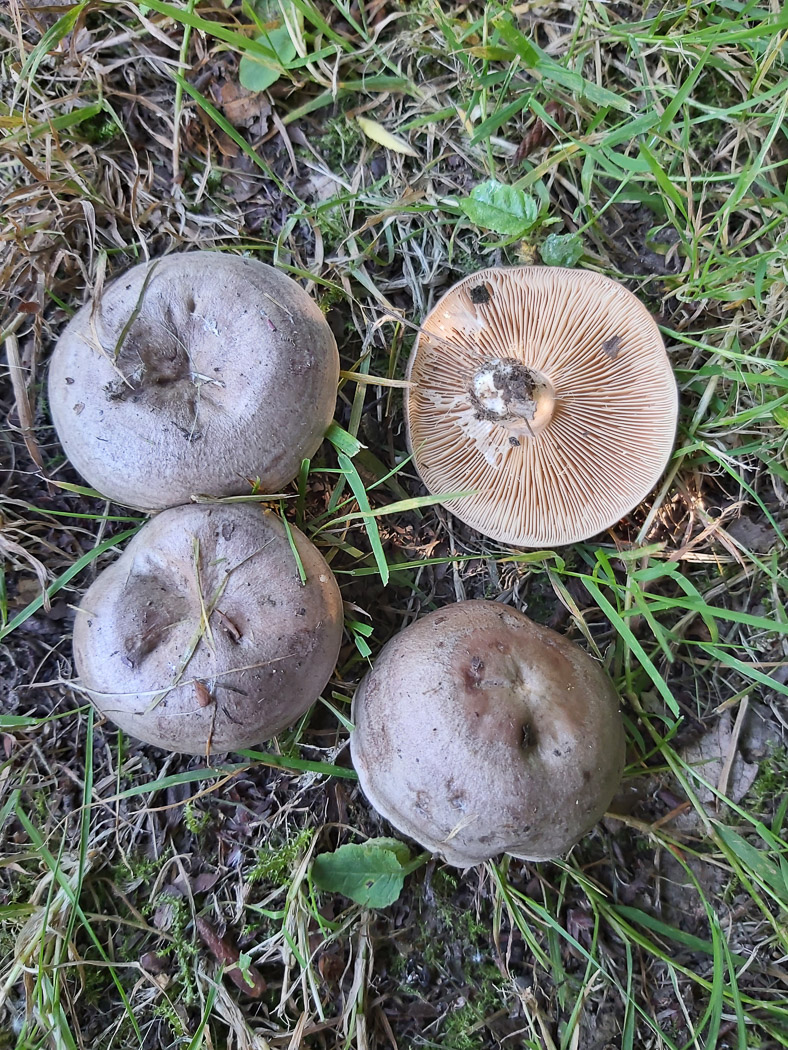
|
Lactarius circellatus (a Milkcap with no common name)
Jul 23, 2023. In Jordans Village Jesper Launder found this group of unusual Milkcaps, the species being host specific to Hornbeam. The species is not unalike the very common L. blennius (Beech Milkcap) having a similarly zoned cap with droplet markings, though tends to have pinker tones and a fruity smell also. The best clue to its identity, however, is its occurrence under Hornbeam.
Jul 18, 2021. The genus Lactarius is not usually one that fruits early in the season but Jesper Launder noticed this nice group growing under Hornbeam, its host tree in Jordans village. This is not a common species and characterised by the palish greenish grey zoned cap, pink buff gills oozing copious milk when damaged, a fruity smell and of course only found under Hornbeam. We have records from just six county sites, the earliest date being the end of September, so this is an interesting find.
|
 |
Lactarius controversus (Blushing Milkcap)
Oct 10, 2023. In Jordans Village under Willow Jesper Launder found this large species of Lactarius - one which is host specific to Willow or Poplar and can get to a spectacular size. The common name refers to its gills which are very crowded and soon turn pink, the cap also developing pink tinges. It is not that common - we have just a handful of county sites, one of these being Stampwell Farm where we visit on October 21st. This is a new entry for Finds.
|

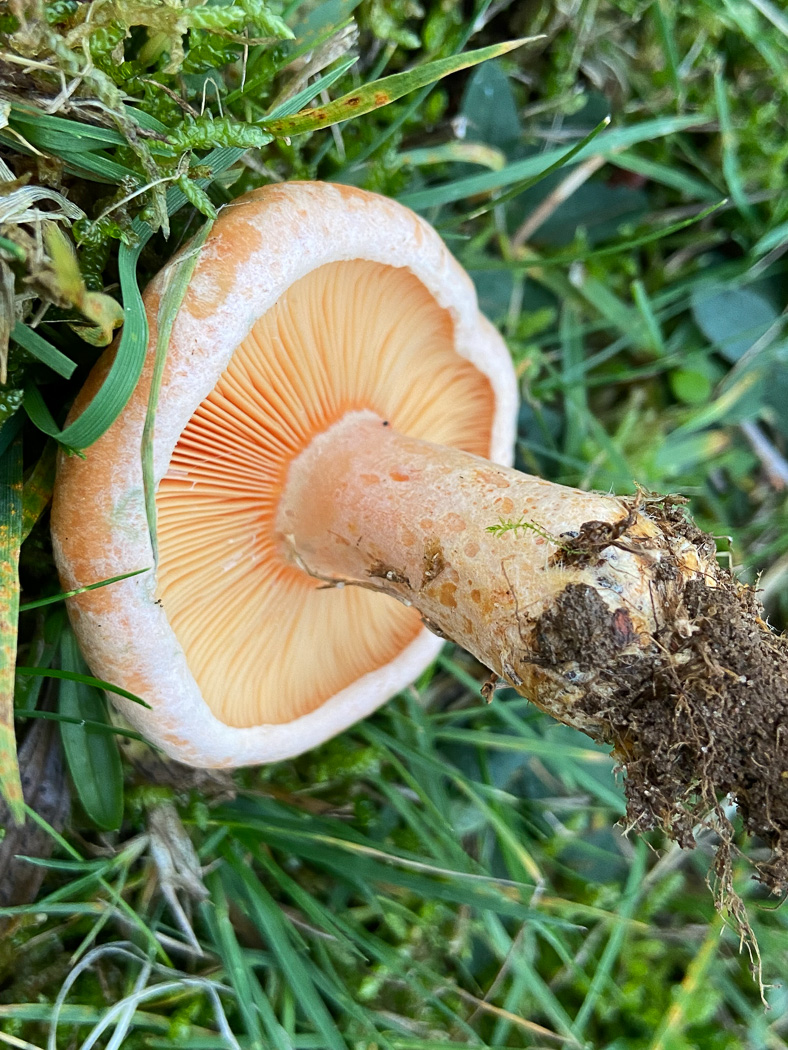
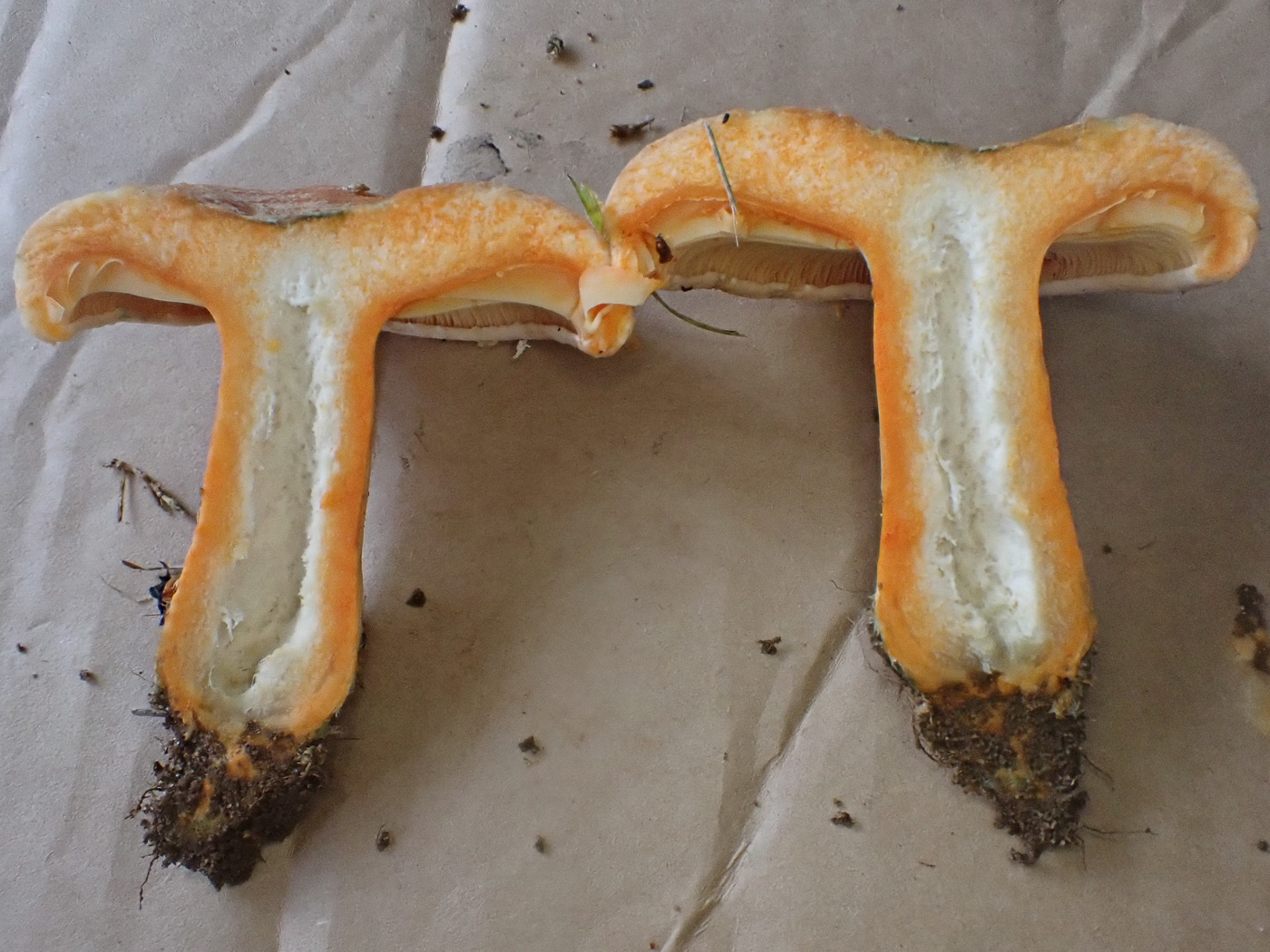
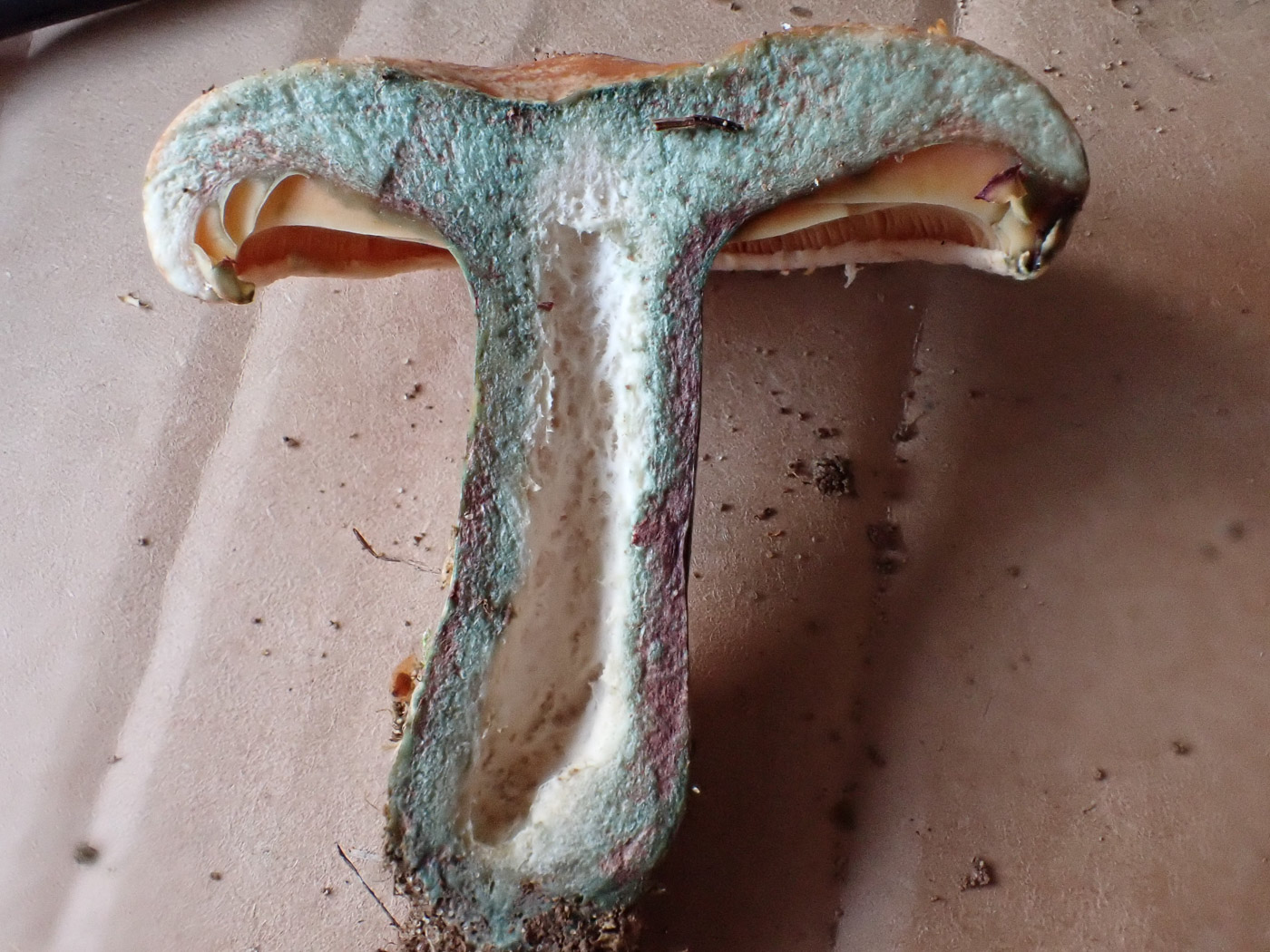
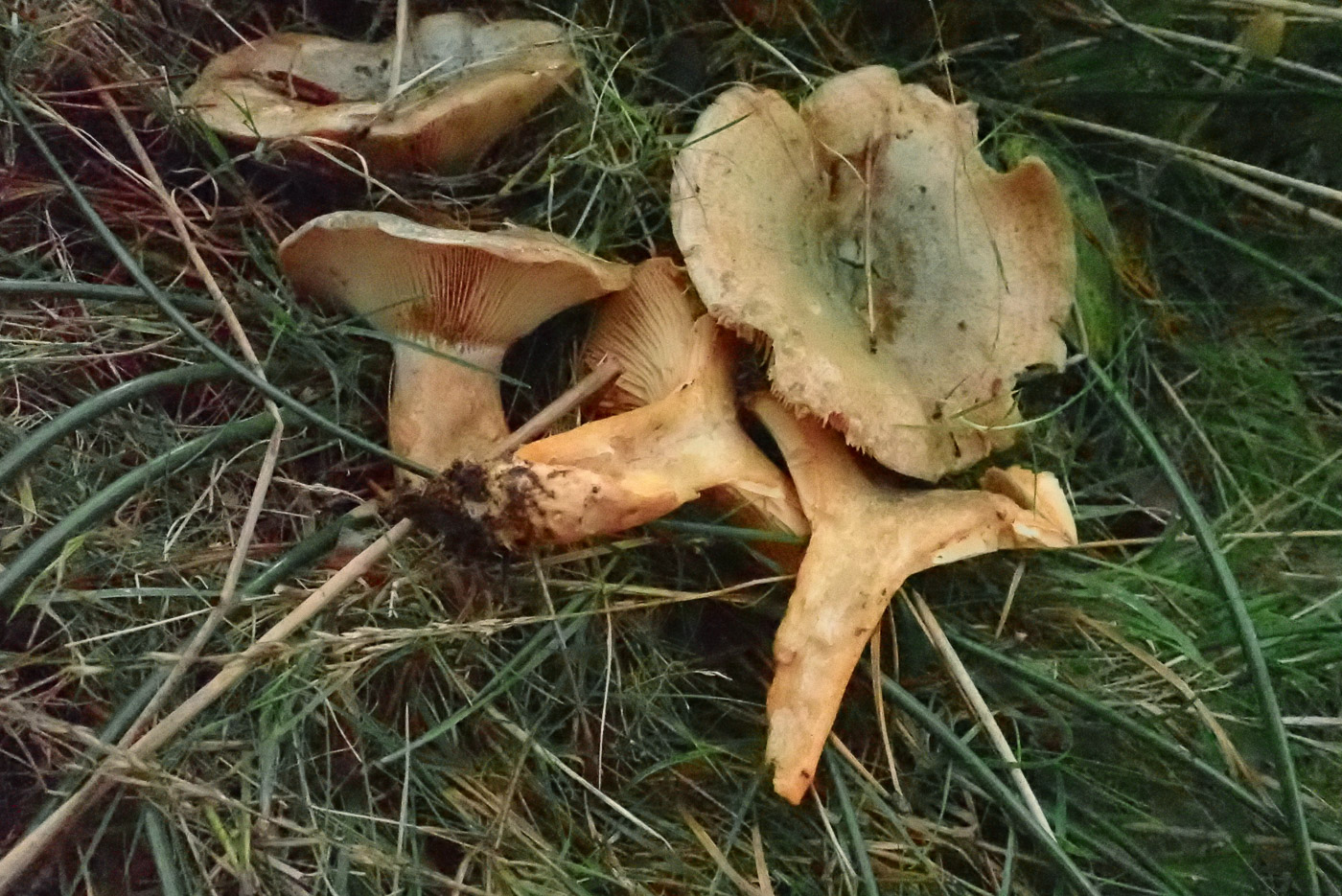
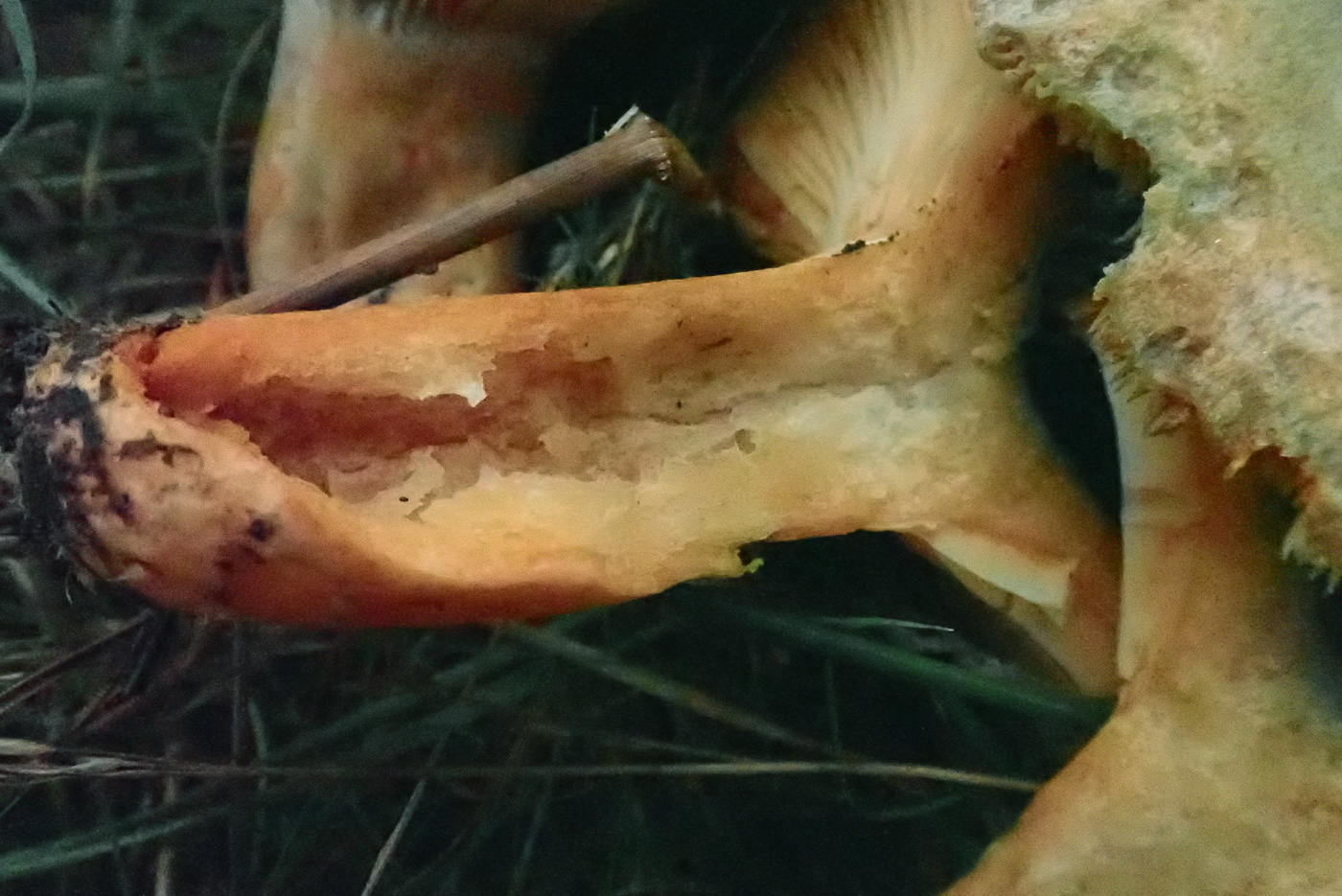
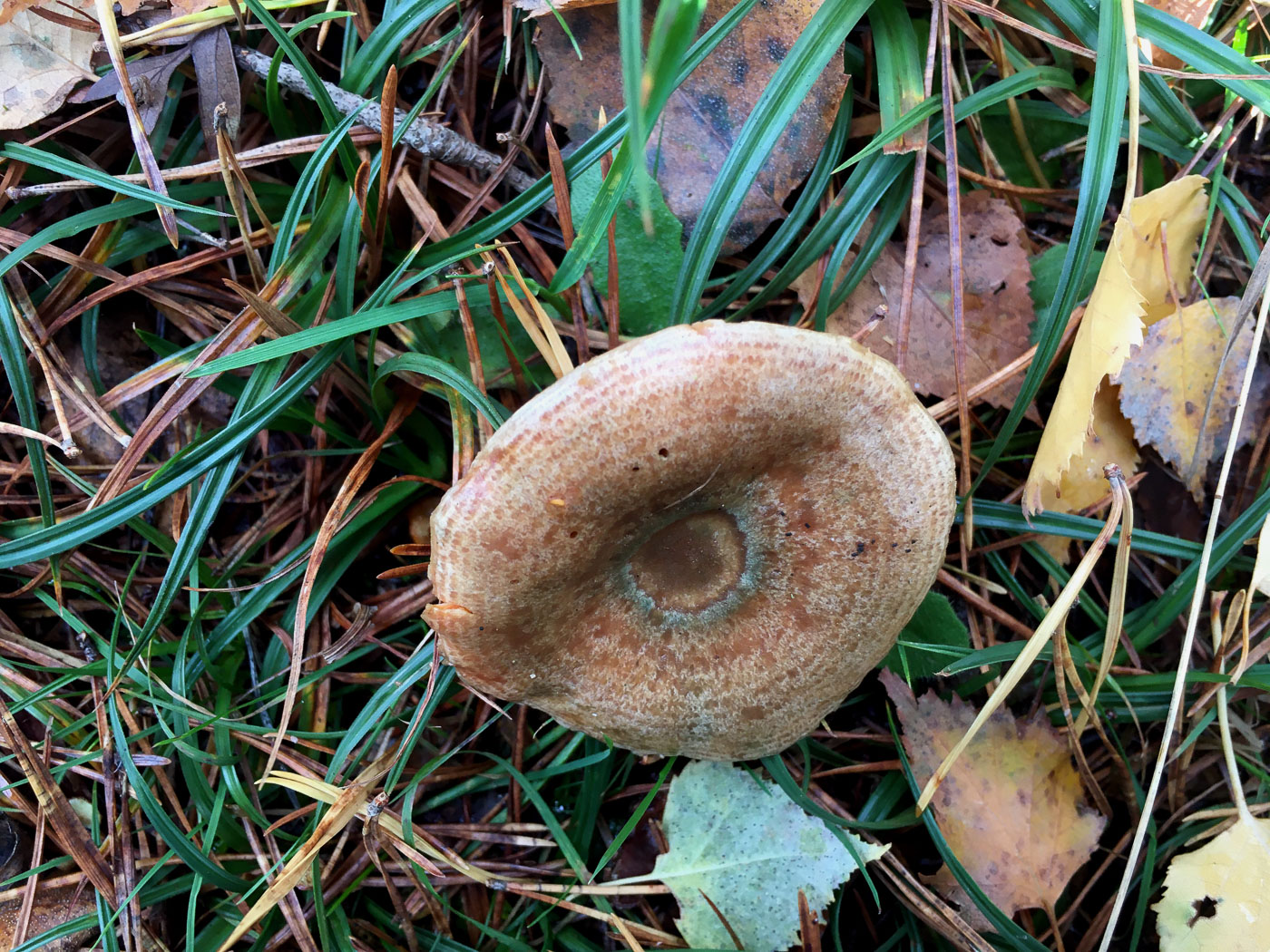
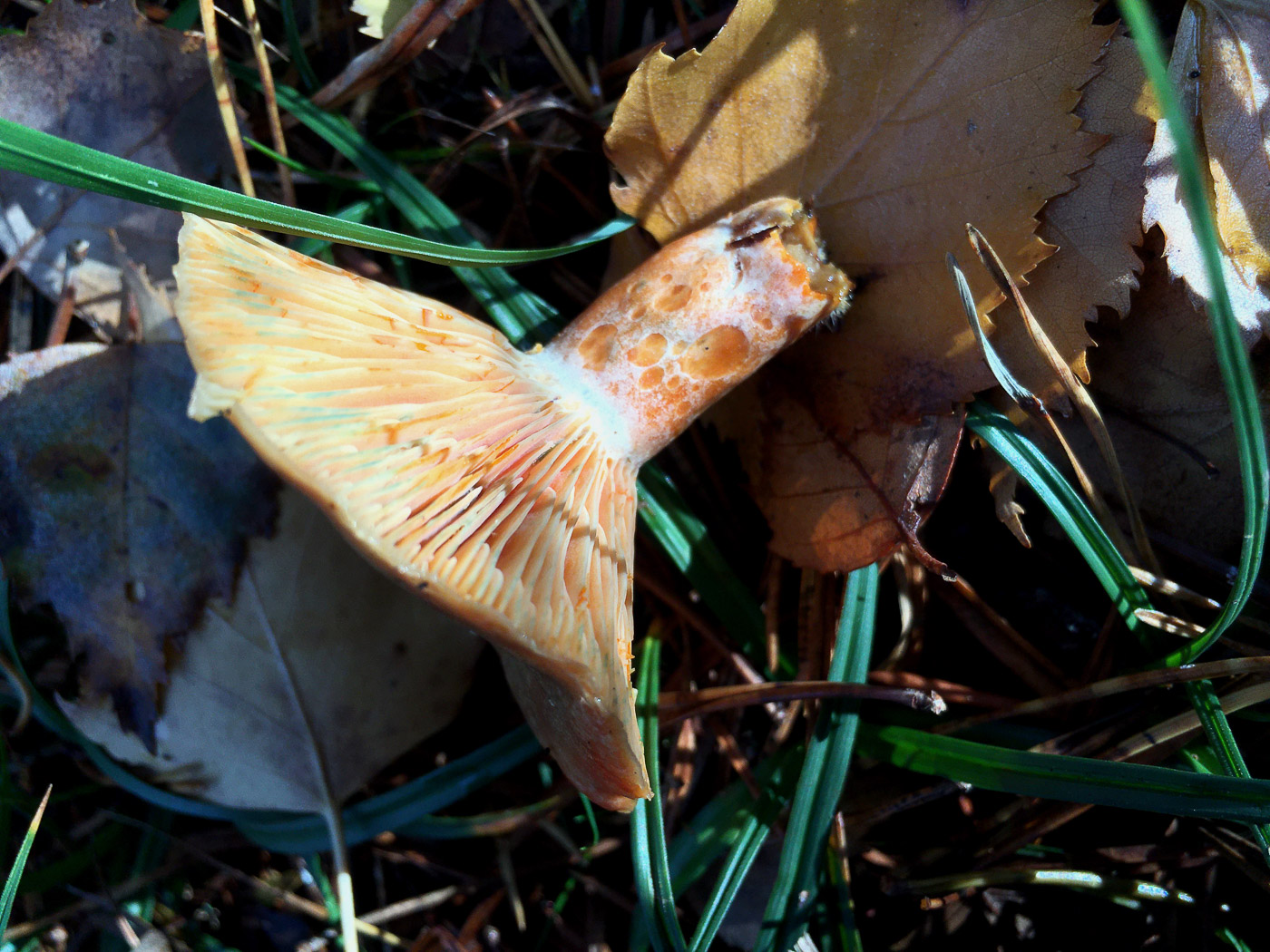
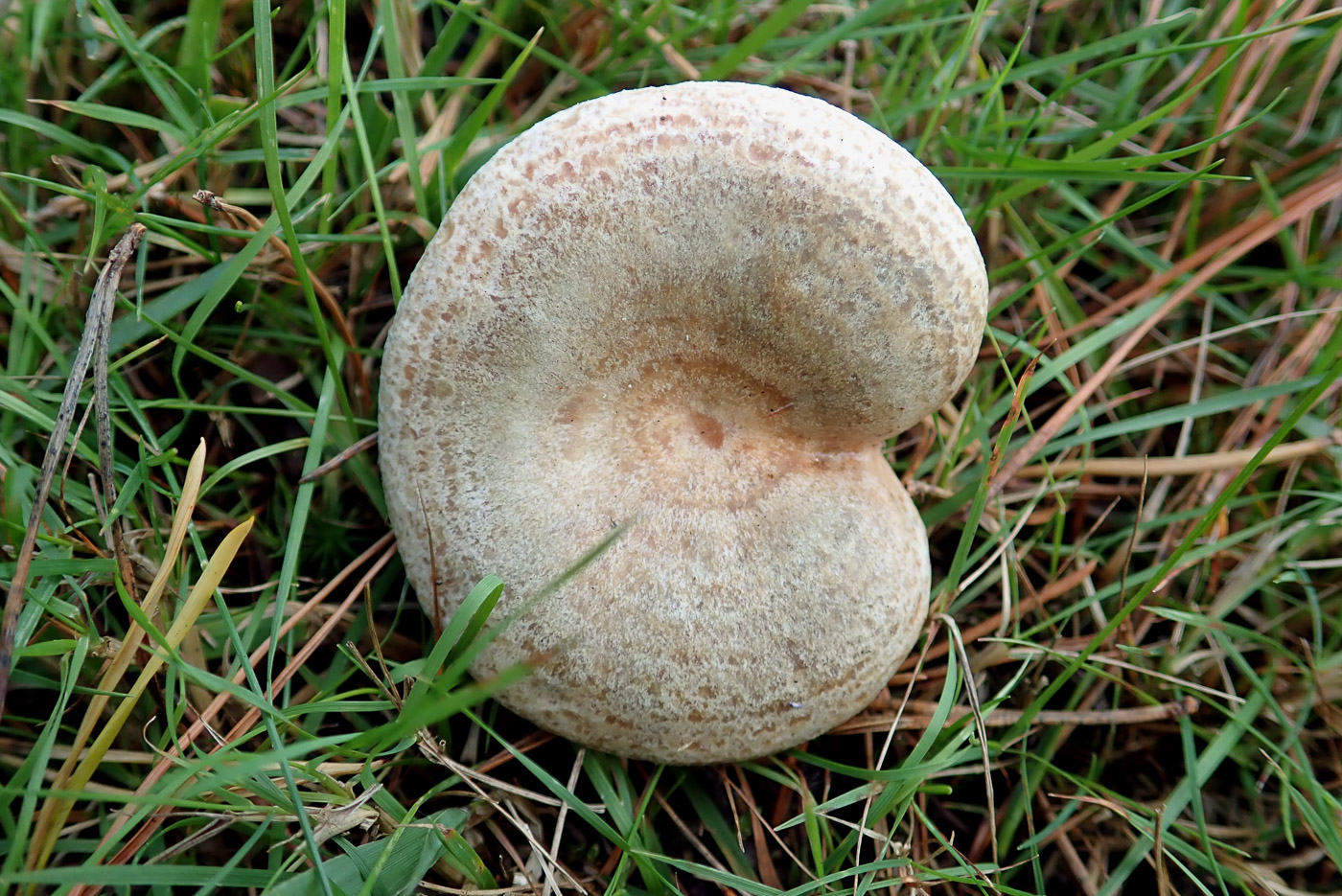
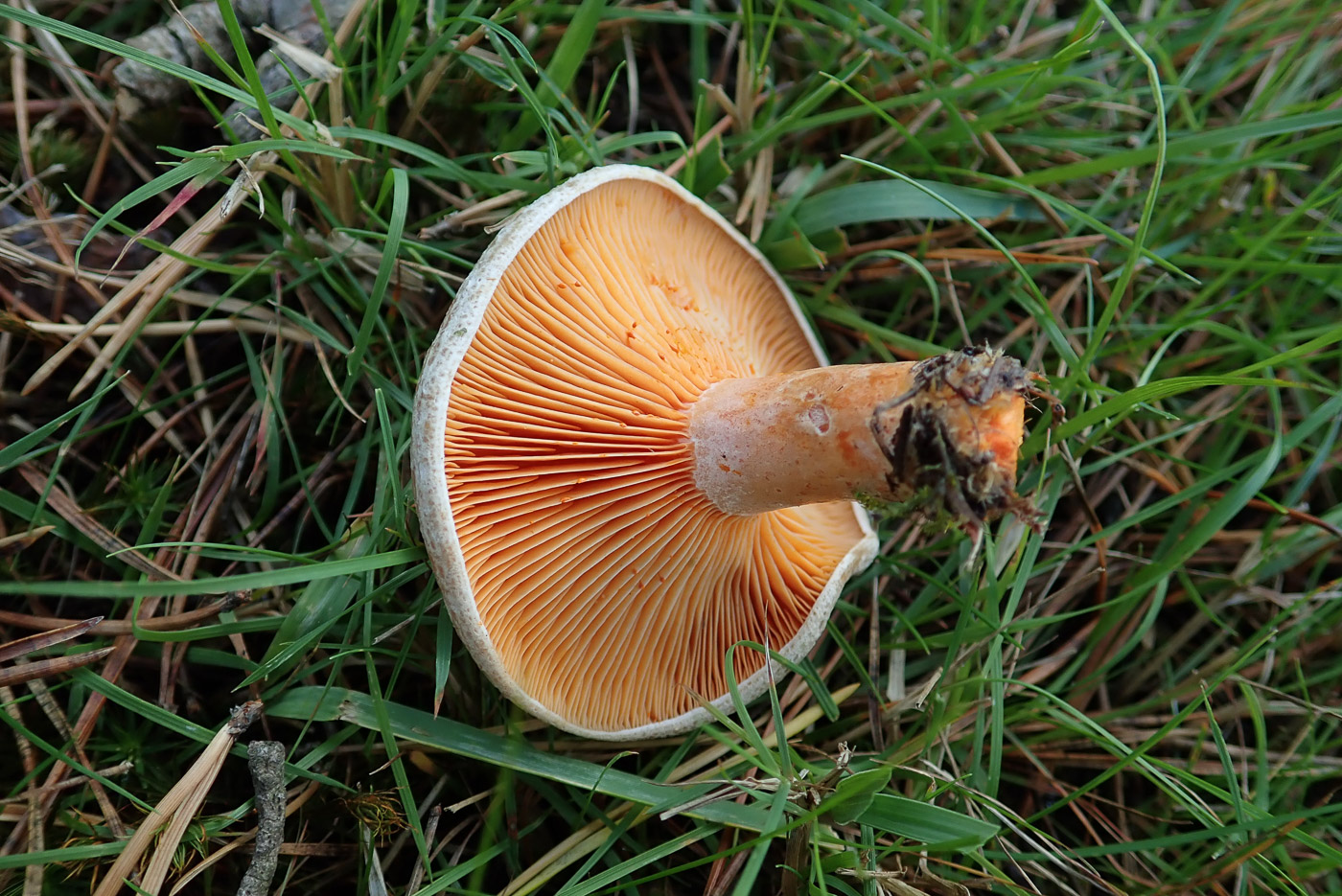
|
Lactarius deliciosus (not semisanguifluus) (Saffron Milkcap)
Nov 2, 2022. At Little Brickhill Churchyard Stephen Plummer found this fresh specimen under Pine, assumed it was L. deliciosus (correctly as it happens), took his photos and only thought to test for the wine-red colour change in the stem flesh a couple of days later - the test which separates these two Pine associating members of this group of Milkcaps, ie those having orange latex. More photos were taken, and he noted no immediate change (photo 3) but overnight the wine-red reaction was clearly present (photo 4). However, further research has uncovered that all of this group will react in this way given enough time, but to prove you have L. semisanguifluus rather than L. deliciosus the colour change once the flesh is exposed to air needs to be apparent within 10 minutes - a fact which is not always mentioned in texts. Hence Stephen's experience here has proved a very useful exercise and also brings into doubt our Finds entries for L. semisanguifluus.
Oct 27, 2021. Under Pine at Stoke Common Penny found this species, one of several very similar Milkcaps with pale zoned caps, inrolled when young, distinctive bright orange gills and milk, also a pitted stem. It only occurs under Pine but can easily be confused with L. semisanguifluus, the only obvious visible difference being that when exposed to air the flesh of that species turns wine red in about five minutes (sometimes in seconds) whereas in L. deliciosus the flesh will eventually turn that colour but in maybe half an hour or more. Photo 2 was taken on collection but the specimen was retained then checked again after an hour or so and was only just beginning to turn. Compare with L. semisanguifluus dated Oct 19th.
Nov 6, 2020. We have a previous singleton of this species (dated Sept 25) but it's worth including again here to show that it is still fruiting. Also today's fruit body, found by Russell Ness under Pine in Burnham Beeches, shows the characteristic 'scobiculae' (darker spots) on the stem rather well. Russell was careful to check that no wine red discoloration had occurred half an hour after collection which would have indicated that this was L. semisanguifluus. See that species dated Oct 05 for comparison.
Sep 25, 2020. This distinctive and attractive Milkcap was found by Penny Cullington under Pine at Stoke Common - sadly only a singleton. There are just a few Milkcaps having these unusual coloured gills and milk, all of which grow under conifers of some sort. The two relatively common species are L. deterrimus (False Saffron Milkcap), found only under Spruce, and today's species found only under Pine. If you find one under Pine with gills and milk which turn wine red after a few minutes, then you probably have the much rarer L. semisanguifluus!
|

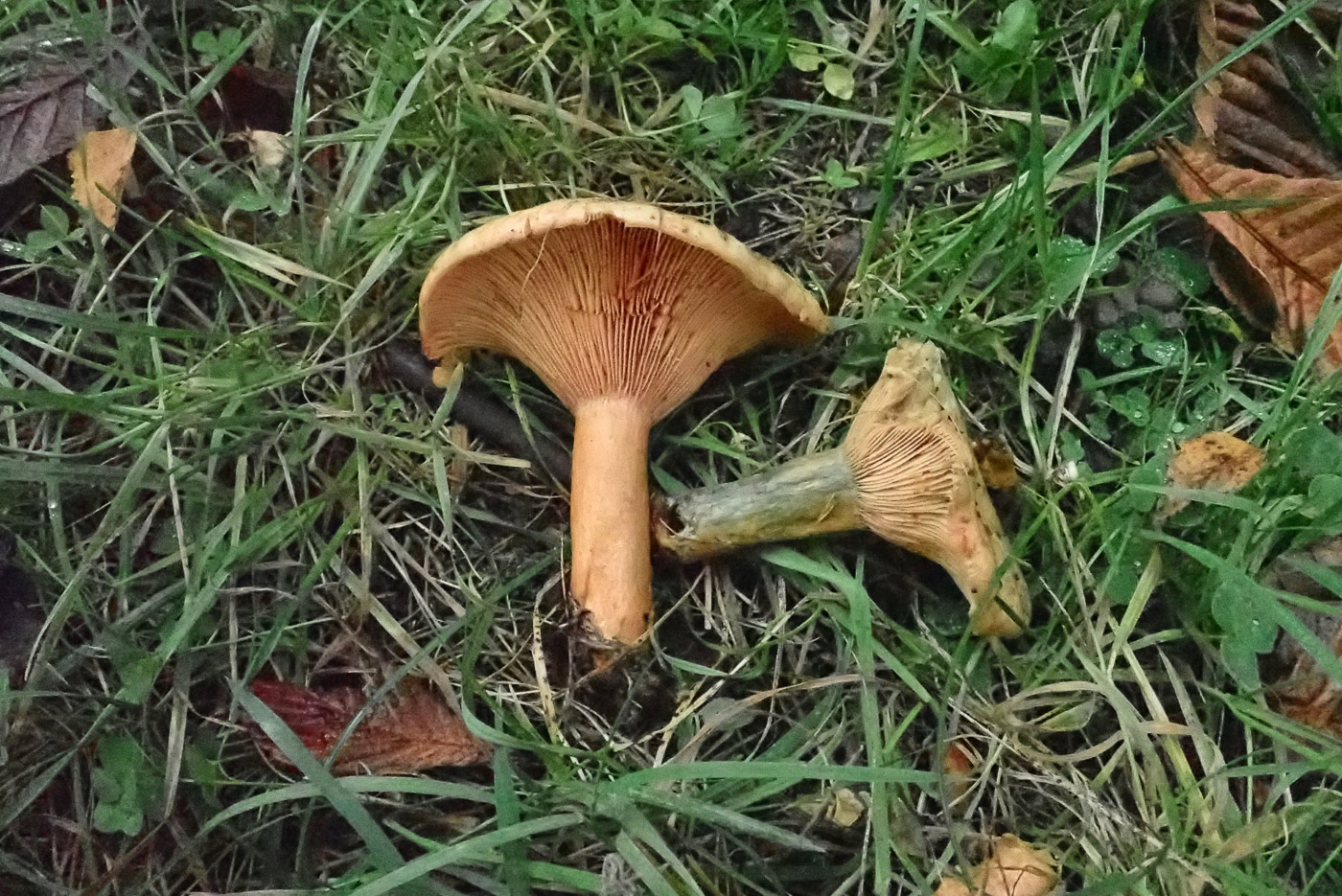
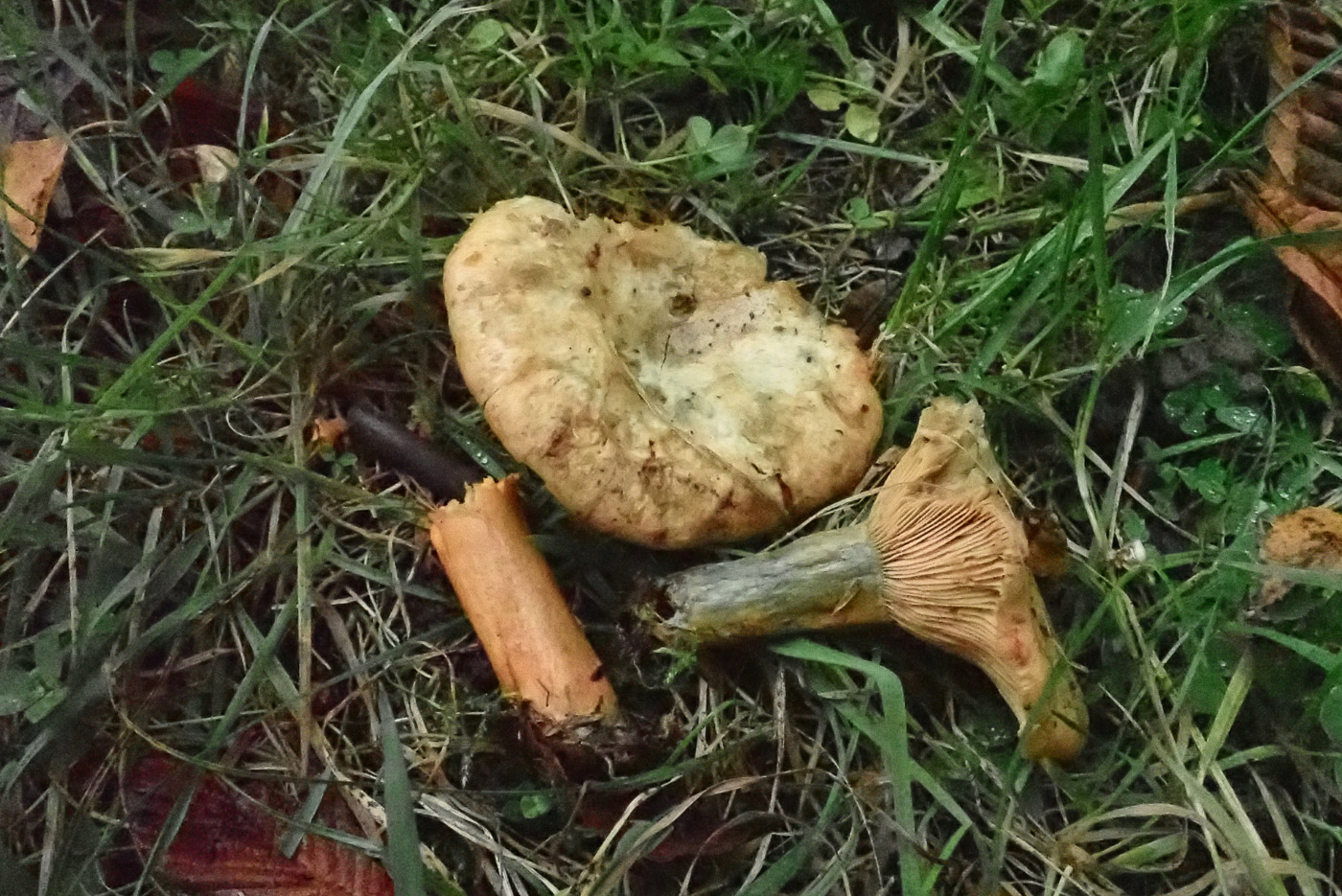 |
Lactarius deterrimus (False Saffron Milkcap)
Jul 25, 2023. In Bernwood Forest Penny and Paul found a patch of this striking species fruiting under Spruce. The lack of Pine present made the ID easy because this species, though very similar to L. deliciosus, is host specific to Spruce. Note also the lack of pitting on the stem, a feature with characterises the Pine associating L. deliciosus, though both can display green colours as here. It is quite common given its tree host.
Nov 13, 2021. At Turville Heath under Spruce Penny found two orange/green Milkcaps and noting the host tree realised that this was a species not yet on Finds though we have two others which are very similar: L. deliciosus and L. semisanguifluus - both Pine species. Today's species tends to turn green more readily and also has a smoother stem, lacking the pitting marks which characterise the other two species.
|


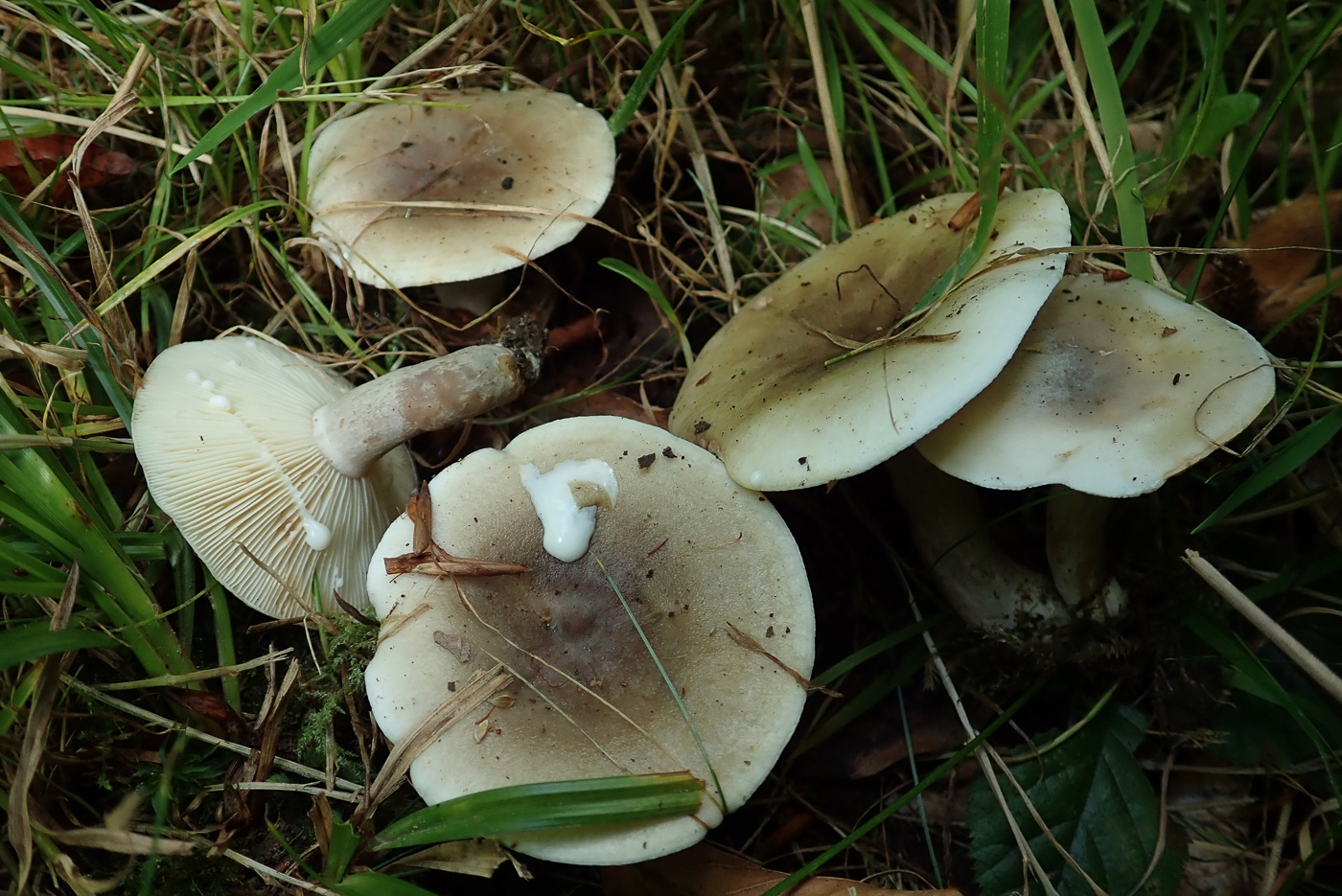
|
Lactarius fluens (a Milkcap with no common name)
Oct 24, 2023. At Stoke Poges Memorial Gardens Penny found a perfect example of this quite unusual Milkcap - one which is often confused with L. blennius (Beech Milkcap) especially as both species occur under Beech. Both are a similar colour and have radial zoning and copious milk which drips from the cap when damaged and eventually turns greenish grey on the gills. Points to look for: L. blennius also has darker purplish-tinged blotches around the outer cap – missing in L. fluens which also has a distinct white rim as seen here - missing in L. blennius! See the Masterlist for more images of both species to compare.
Aug 4, 2023. In a grassy glade near Beech in Hodgemoor Woods Penny found this quite unusual Milkcap, one very similar to the very common L. blennius (Beech Milkcap) and probably often misidentified for that species. Also occurring under Beech, it shares very similar colours, is also smooth and slimy in damp conditions, and its copious milk turns slowly greenish grey where the gills are damaged. However, it lacks the 'droplet' cap markings of L. blennius (though that species can sometimes occur without them!) but more significantly it has a distinct white rim around the cap margin - not present in L. blennius and clearly visible in this nice collection.
Sep 27, 2020. This nice collection was found under Beech in Mousells Wood by Penny Cullington. An occasional species, it is easily confused with others such as L. blennius (see photo dated Sept 13) when the cap can have very similar markings. The best features to note are the distinct paler margin (very clear in this collection) and the copious milk (hence the species name) which literally drips - in this case from the damaged cap surface, where I'd removed a strand of dead grass, as well as the gills!
|
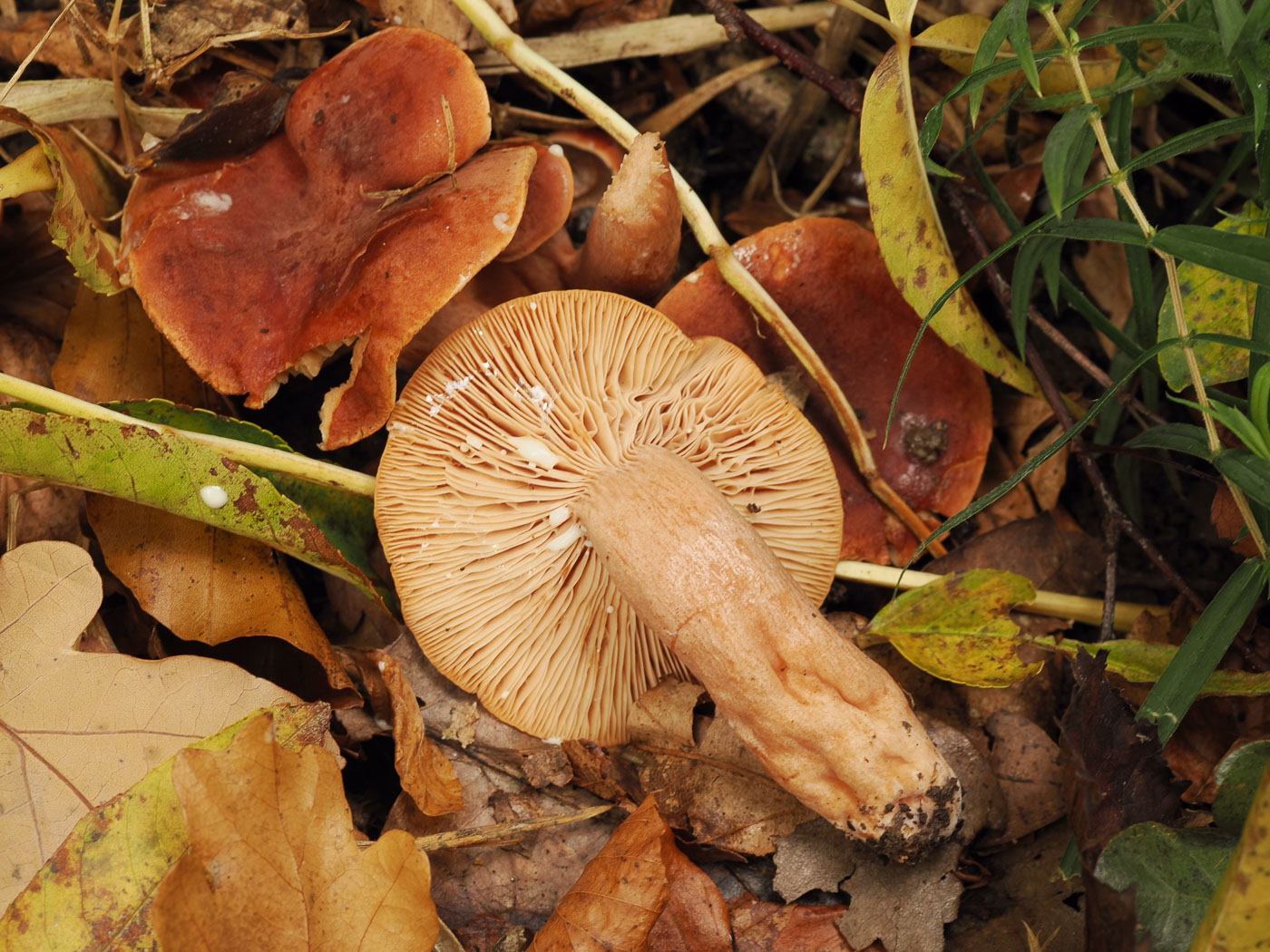 |
Lactarius fulvissimus (Tawny Milkcap)
Oct 19, 2022. At Bittam's Wood, Dancersend, a small group of us found several specimens of this species - a brightly coloured smooth-capped Milkcap with firm flesh and a smell similar to L. quietus. Like the following species it occurs under a mix of deciduous trees but is less common and a much more intense reddish brown in both cap and stem. The milk is unchanging both on the gills or on a hankie. The photo is Claire Williams's. This is our first entry for Finds.
|

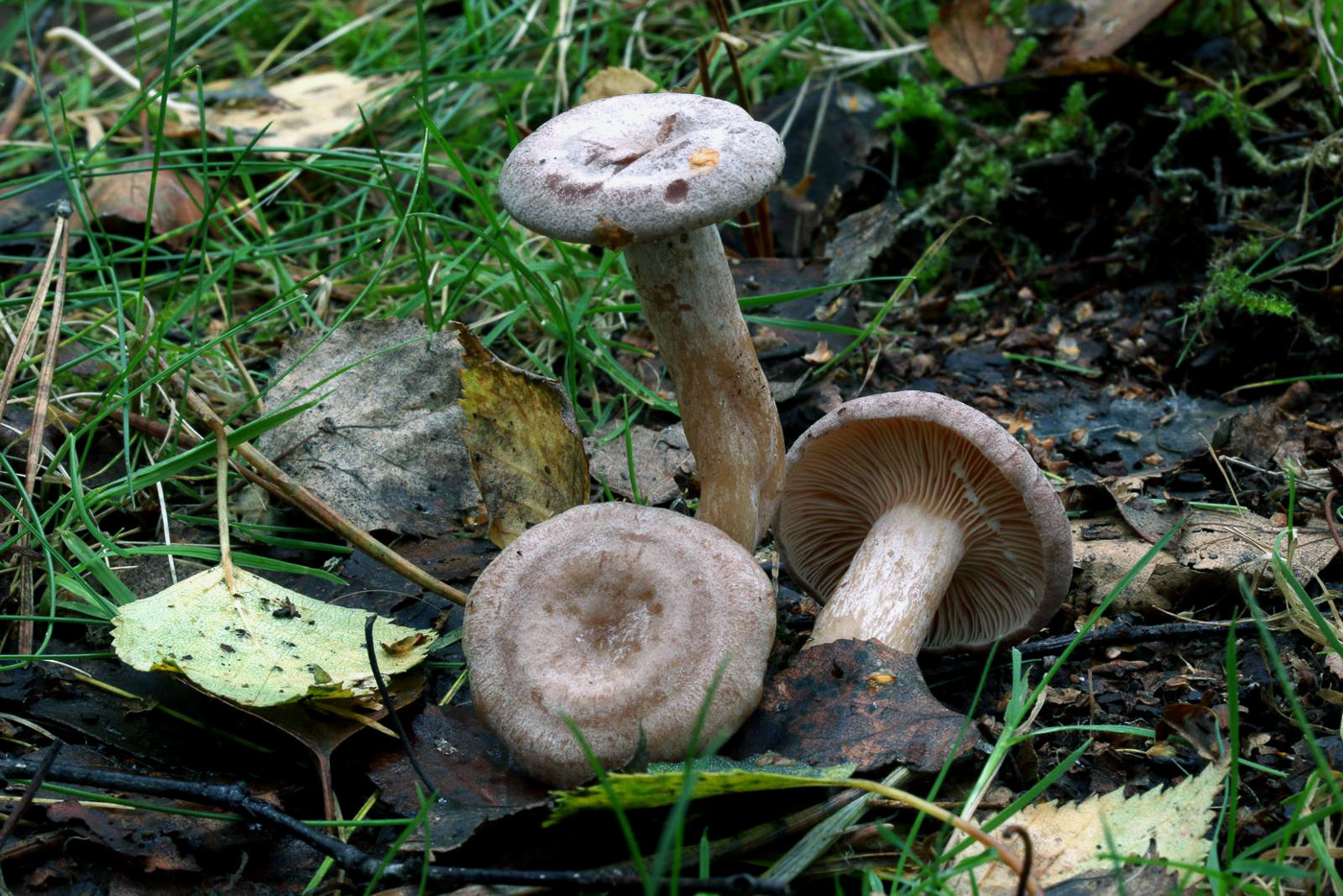
|
Lactarius glyciosmus (Coconut Milkcap)
Oct 27, 2021. Under the many Birches at Stoke Common Penny found a few specimens of this quite common Milkcap - one only found under Birch but common wherever that tree occurs. It has a pale buff cap with a pink tinge, sometimes with some zoning, and is quite fragile having white milk when the gills are damaged, but the give-away feature is its distinctive sweet smell of coconut.
Oct 16, 2020. Penny C. found this collection under Birch, its host tree, in Burnham Beeches, (photo Claudi Soler). In appearance it is much like many other small to medium sized Milkcaps but if you find one under Birch, it's worth smelling it because the clear sweet dessicated coconut smell is the best way to confirm its identity in the field.
|
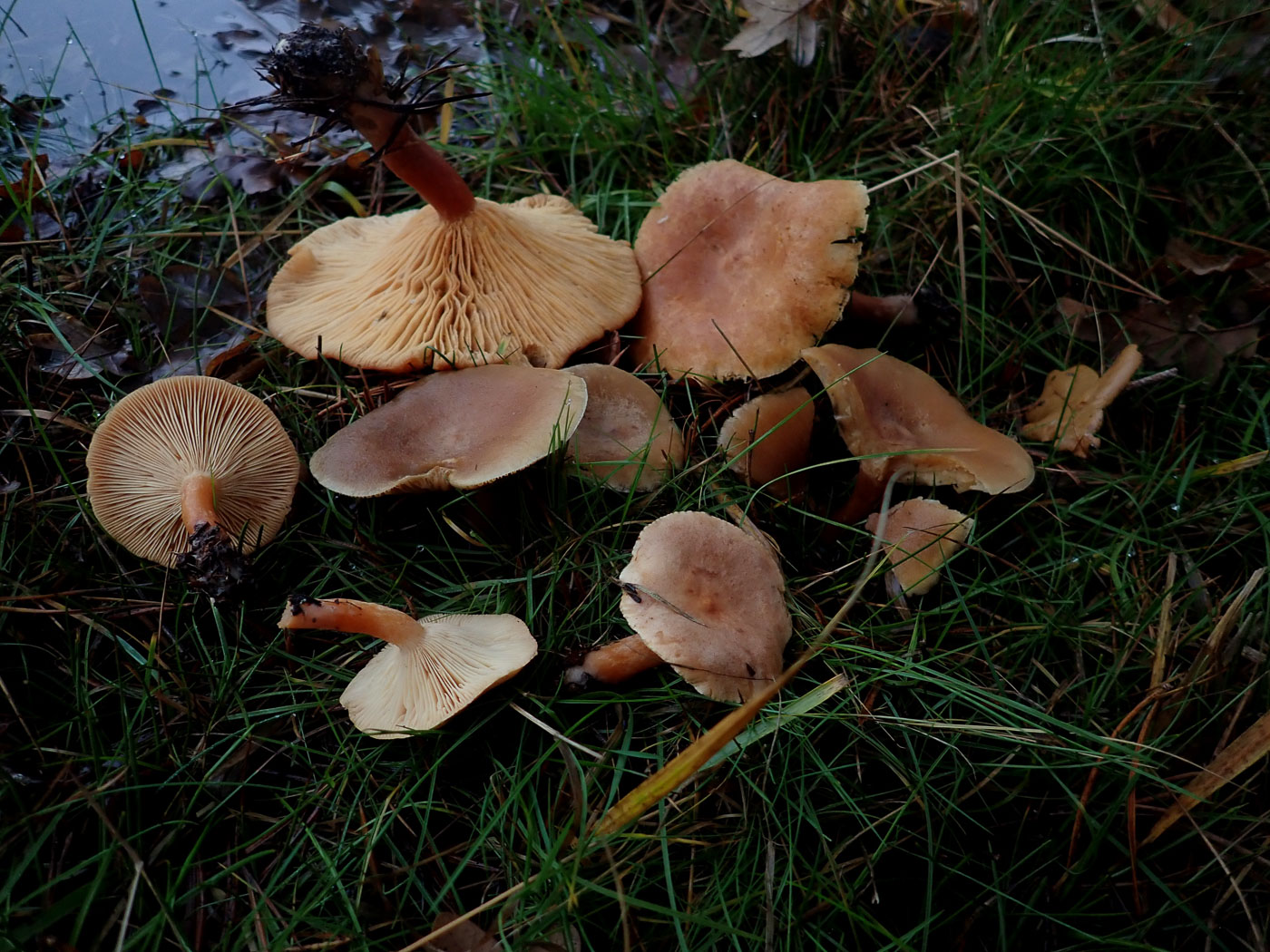
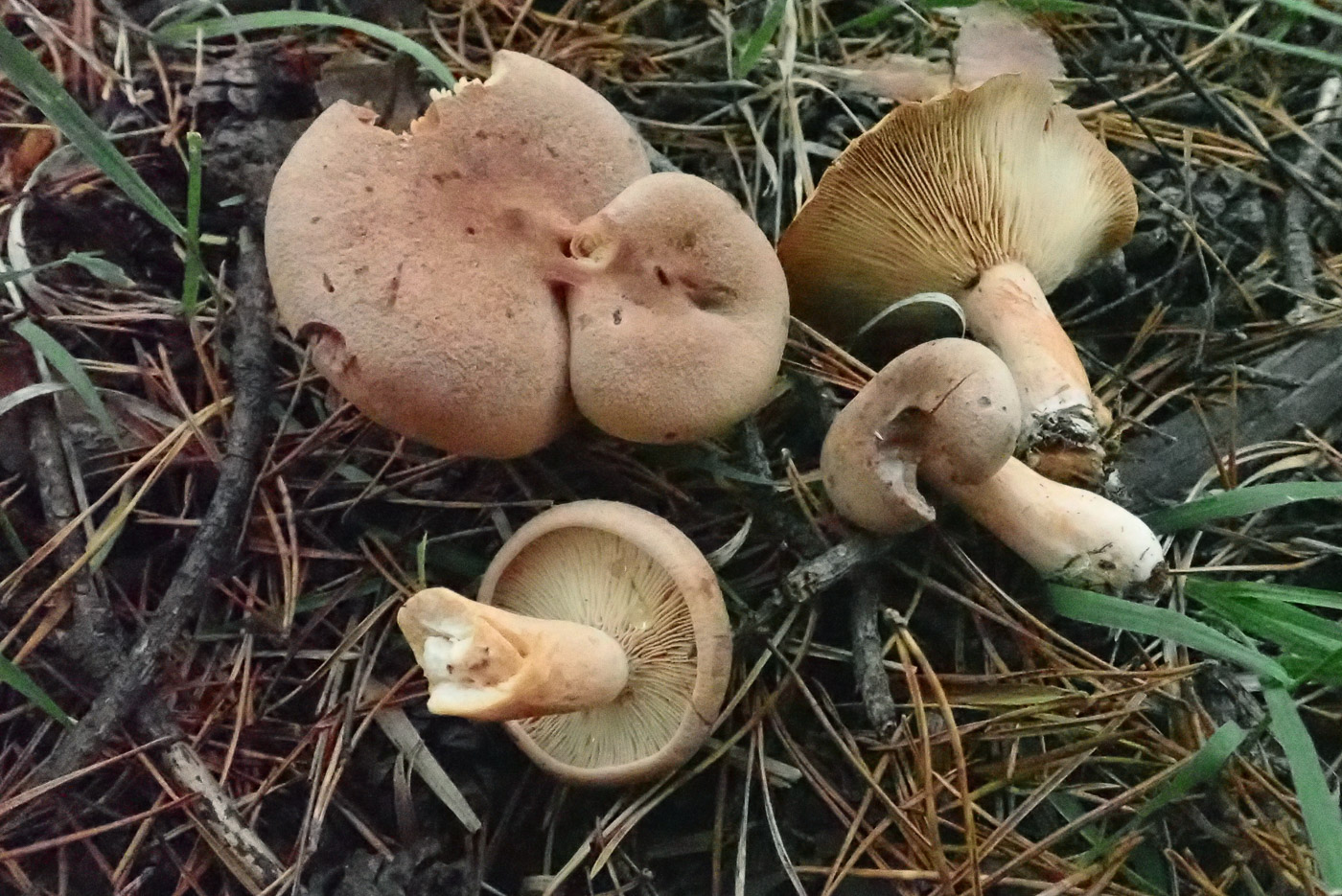
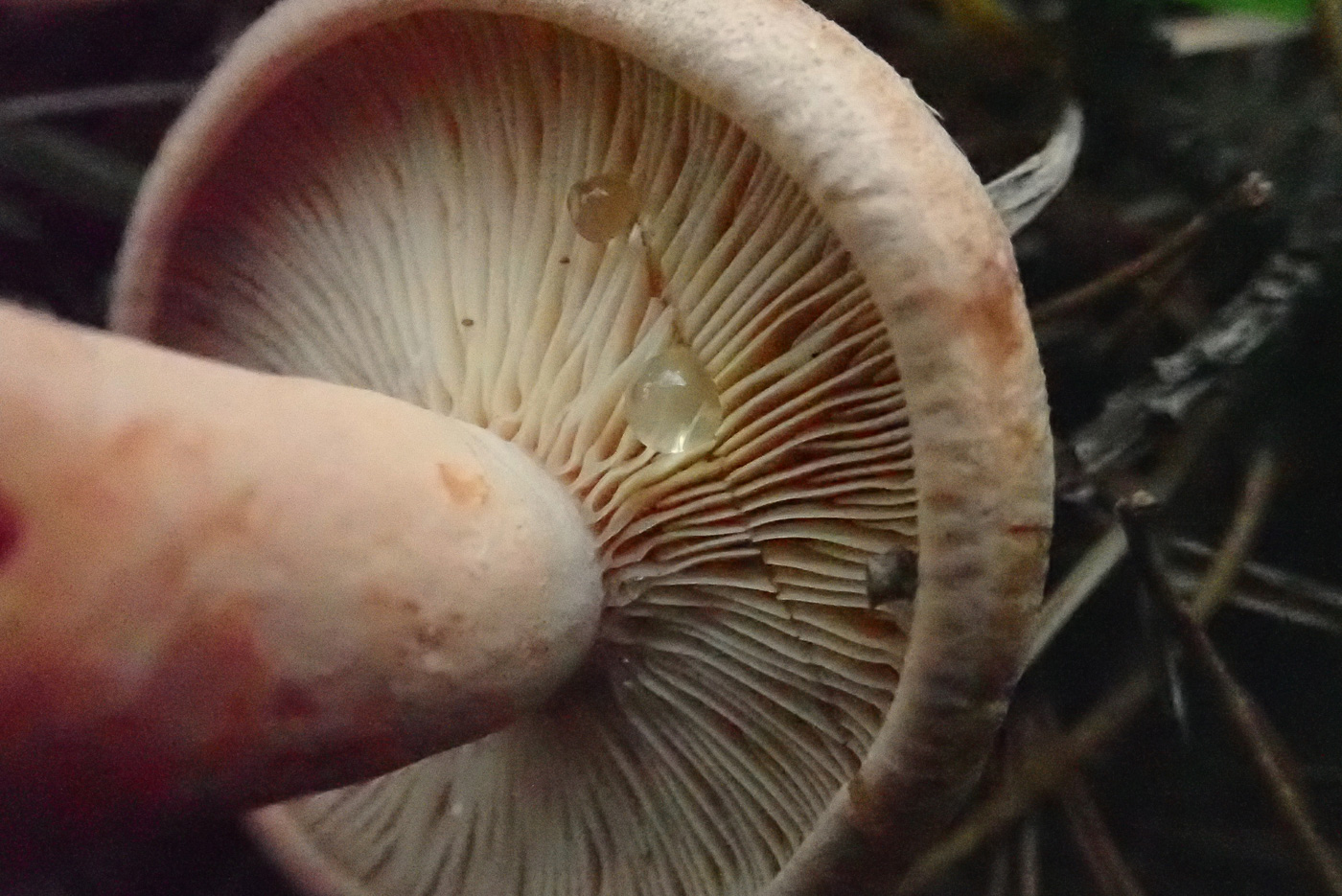
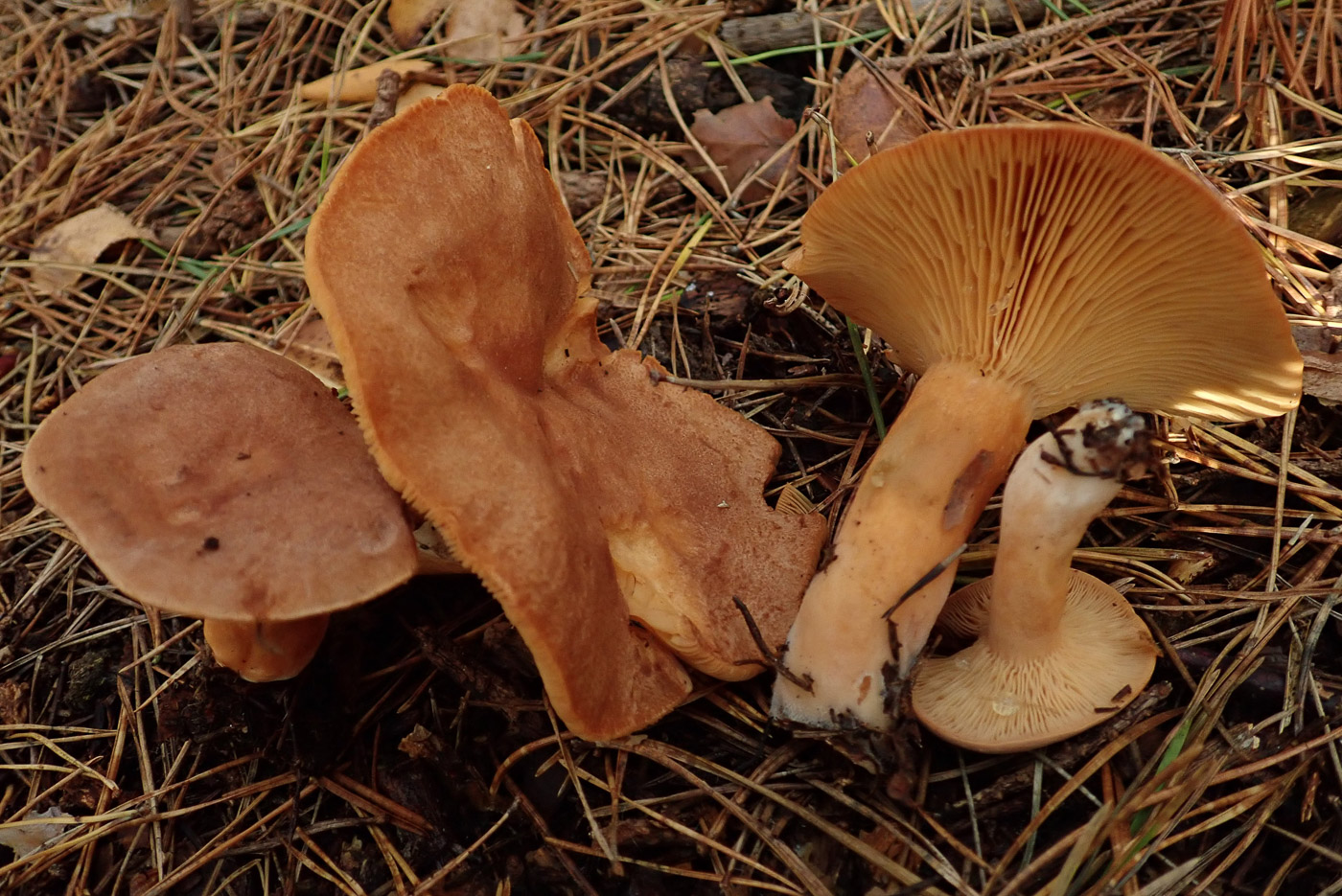
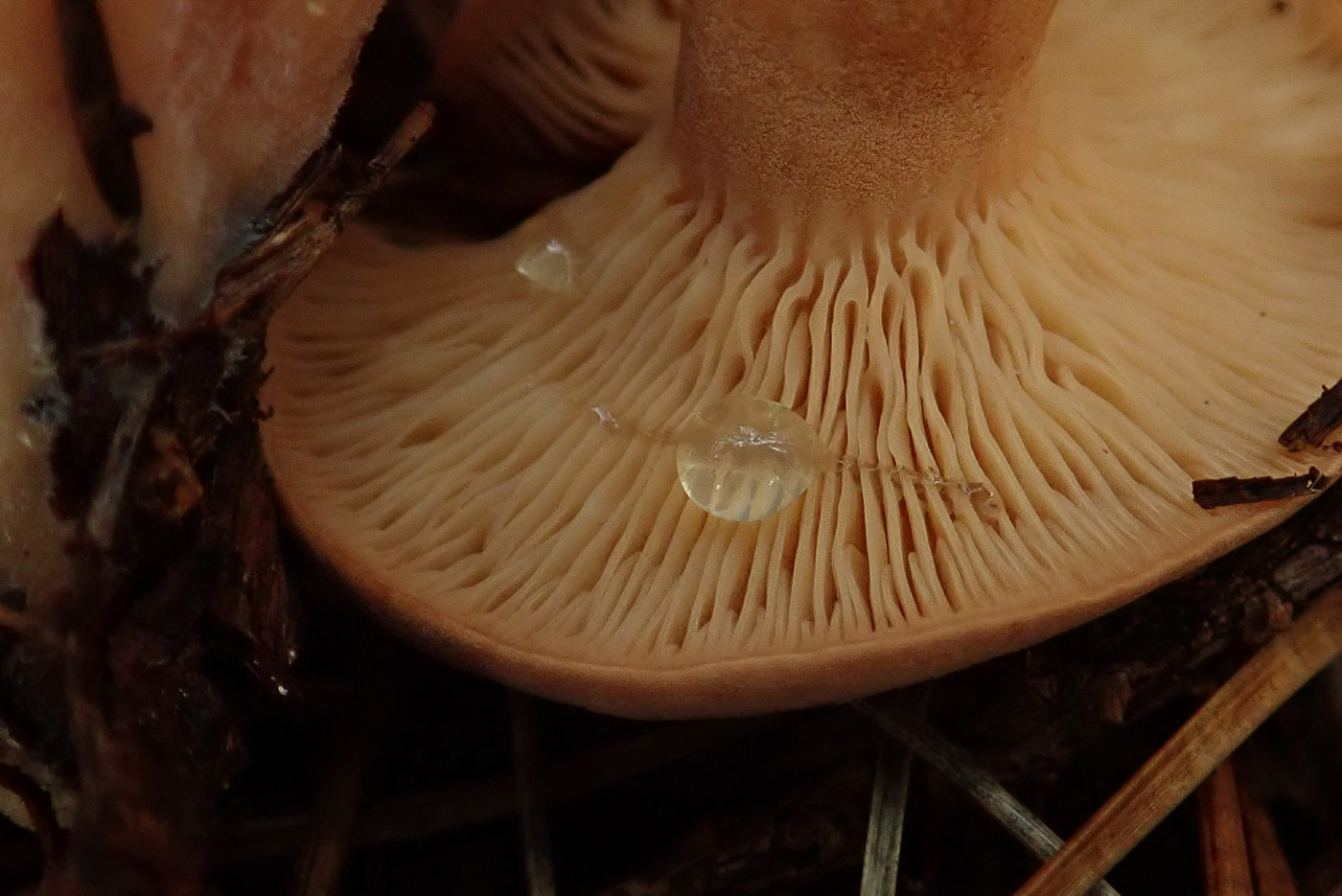
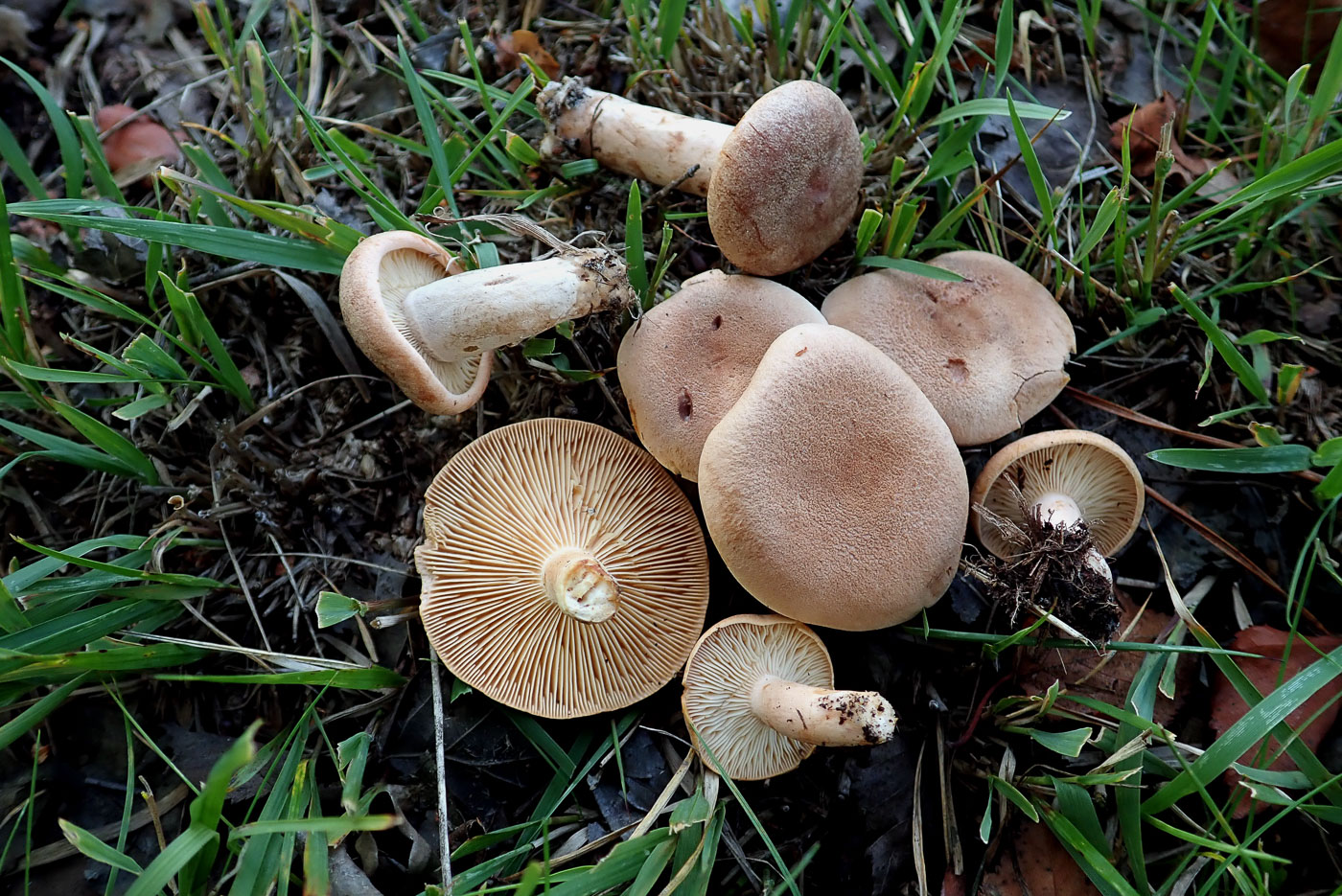
|
Lactarius helvus (Fenugreek Milkcap)
Nov 29, 2022. Under the Pines at Stoke Common this species was much in evidence though often huge (12 cm across or more). At first Penny was nonplussed by it owing the size, lack of typical curry smell, also no sign of latex (though in this species it is entirely colourless so often missed). Eventually a few younger more typical examples turned up which were less soggy and weathered - conditions at the site were extremely wet with much of it under water.
Oct 27, 2021. At Stoke Common and again under the Pines Penny found good numbers of this Milkcap, unusual in two ways: the only county sites where it has been found are here and nearby Burnham Beeches (both with acidic soil), furthermore the 'milk' it produces is colourless and therefore easily missed (see photo 2). The slightly pink brown cap is tightly inrolled when young, its surface being slightly velvety, and it has a smell of curry (hence its common name). It occurs under Pine and occasionally Birch.
Nov 7, 2020. We have photos of very young material of this unusual Milkcap dated Sept 25, so when it showed up again in large quantities under Pine at Stoke Common Penny C. took the opportunity to show how the species looks when mature. In fact she was very unsure what it was to start with because some caps were over 10 cms across, they completely lacked the diagnostic smell of curry spice and most specimens failed to produce any milk (though in this species the 'milk' is entirely colourless which adds to the confusion!). Knowing that the species is always very common here, however, she persevered and eventually found a specimen which gave the game away and confirmed her identification. No milk is visible in photo 1 but clearly visible in photo 2. Once mushrooms are hit by frost one of the first characters to be affected is their smell which can either change or disappear - something worth remembering now we're into that time of year.
Sep 25, 2020. Penny Cullington found this collection under Pine and Birch at Stoke Common. Not a rare Milkcap but only found where Pine is present on acid sandy soil - somewhat unusual conditions in the Chiltern area. Fruiting was only just under way so the largest cap was only 2 cms across; in a good year it can come up in hundreds here. Once you've realised you have a Milkcap this is an easy one to name to species: it has a distinct smell of curry powder, also the 'milk' is completely colourless - a unique feature in the genus. Today's however, were too dry to produce anything which showed in a photo!
|
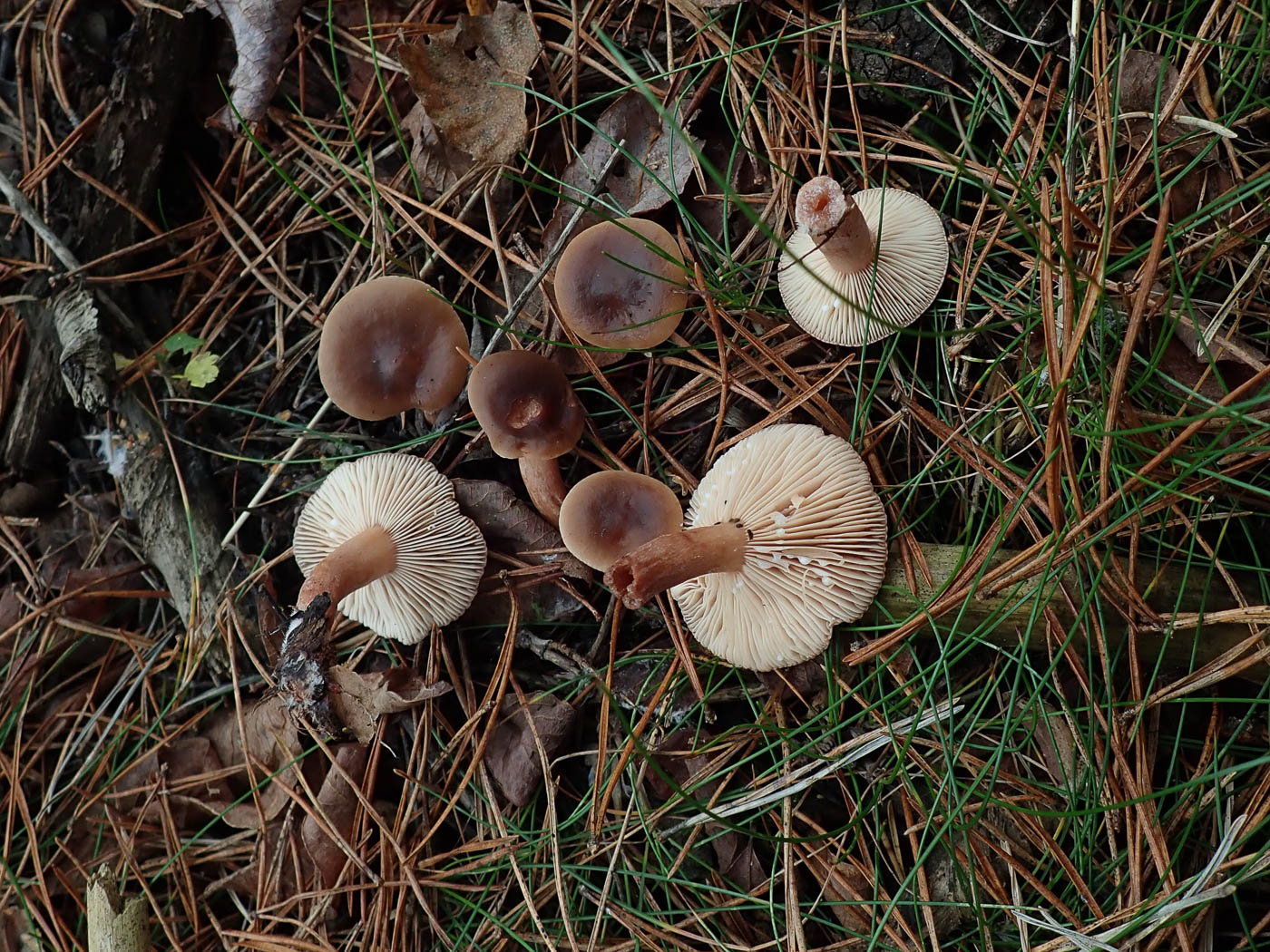
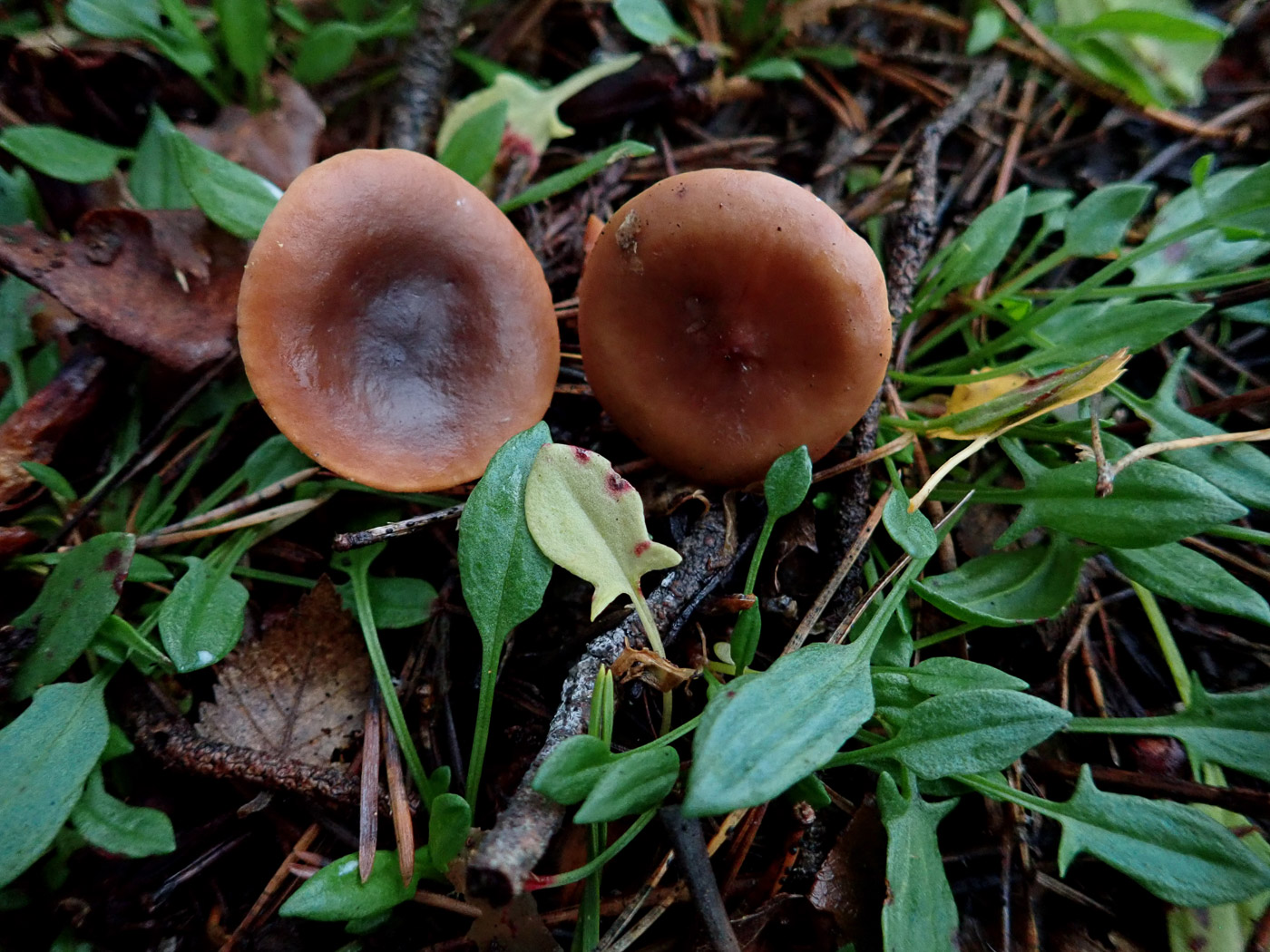
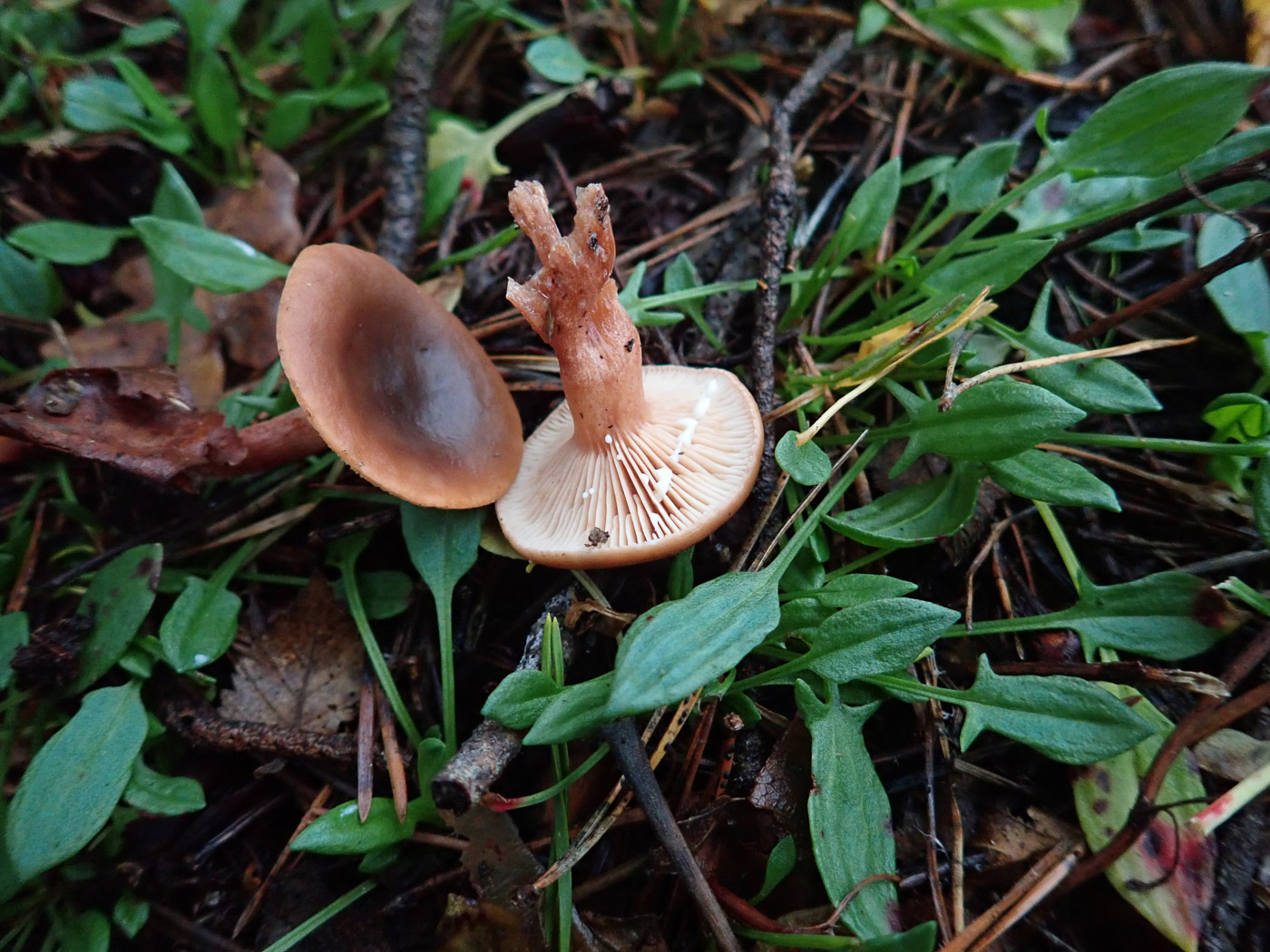
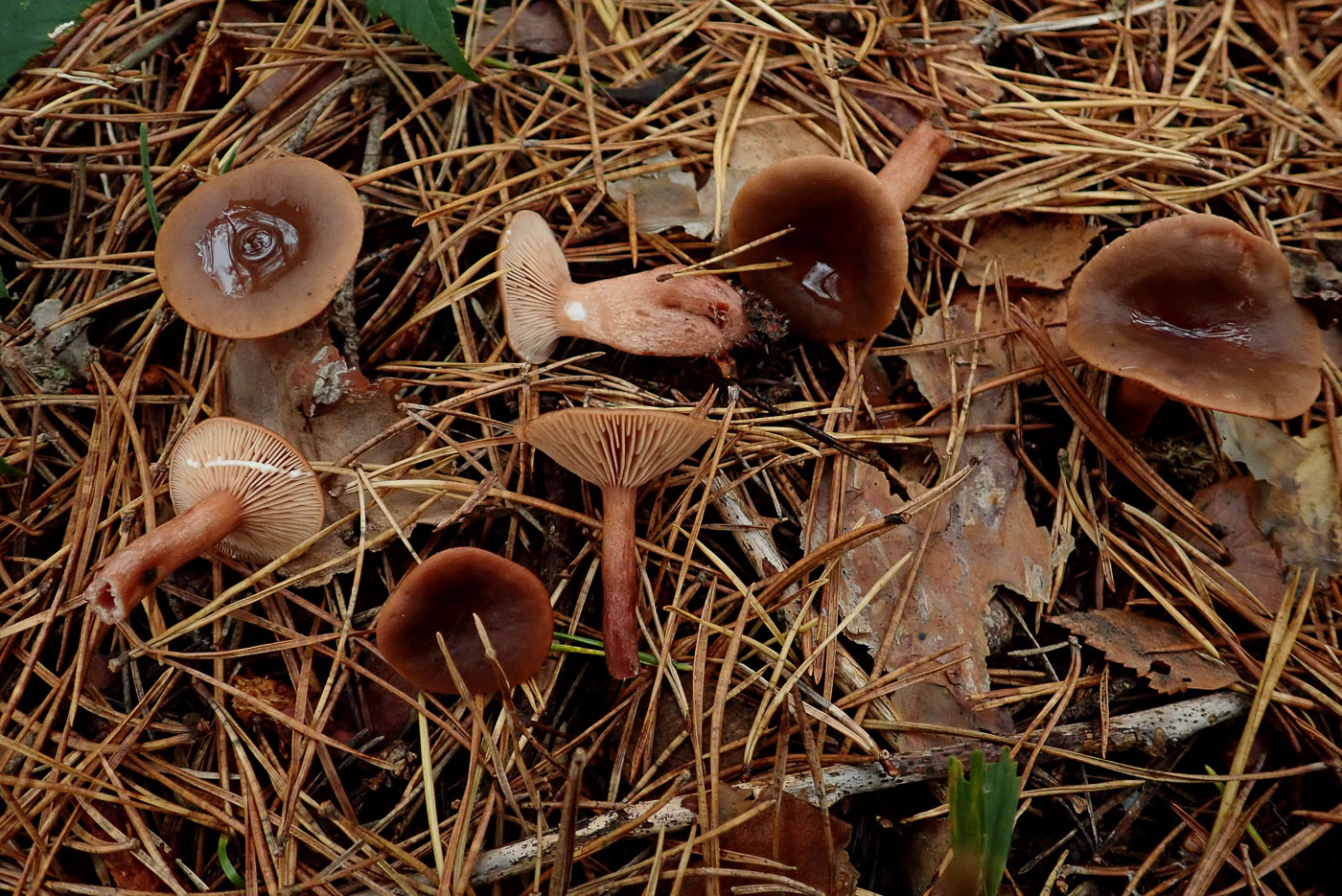
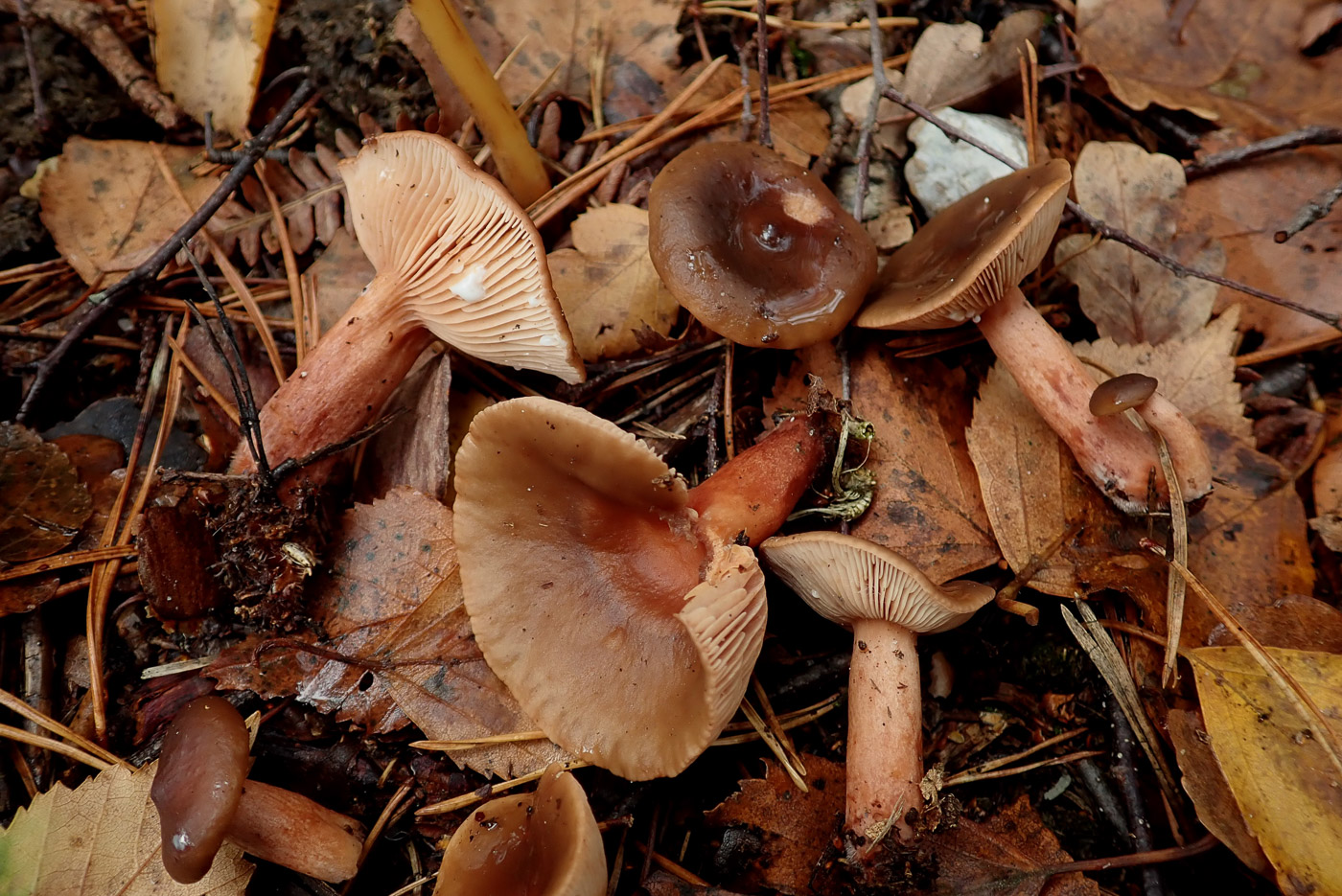
|
Lactarius hepaticus (Liver Milkcap)
Nov 4, 2024. Under Pine at Burnham Beeches Penny found quite a few of these Milkcaps which only occur under this tree species. The English name refers to the liver-coloured cap and stem, and it has a smell similar to that of L. quietus and copious white milk which turns yellowish on a hankie.
Nov 29, 2022. This was another Milkcap still fruiting at Stoke Common under Pine and found by Penny. It is host specific to Pine and has a rich dark brown smooth cap, the milk wil turn slightly yellow on a hankie (as in L. tabidus) and it has a similar smell to L. quietus. We have just one previous Finds entry: 2020 November 3rd.
Nov 3, 2020. This dark brown Milkcap was found in large numbers by Penny C. under Pine at Burnham Beeches. Not uncommon given its host tree but usually fruiting late in the season, it is a medium sized Milkcap with a smooth rich liver brown cap and reddish brown stem. The white milk turns yellowish on a hankie after a little while, as also occurs in L. tabidus and L. lacunarum, but neither of those have such dark brown colours or occur under Pine.
|

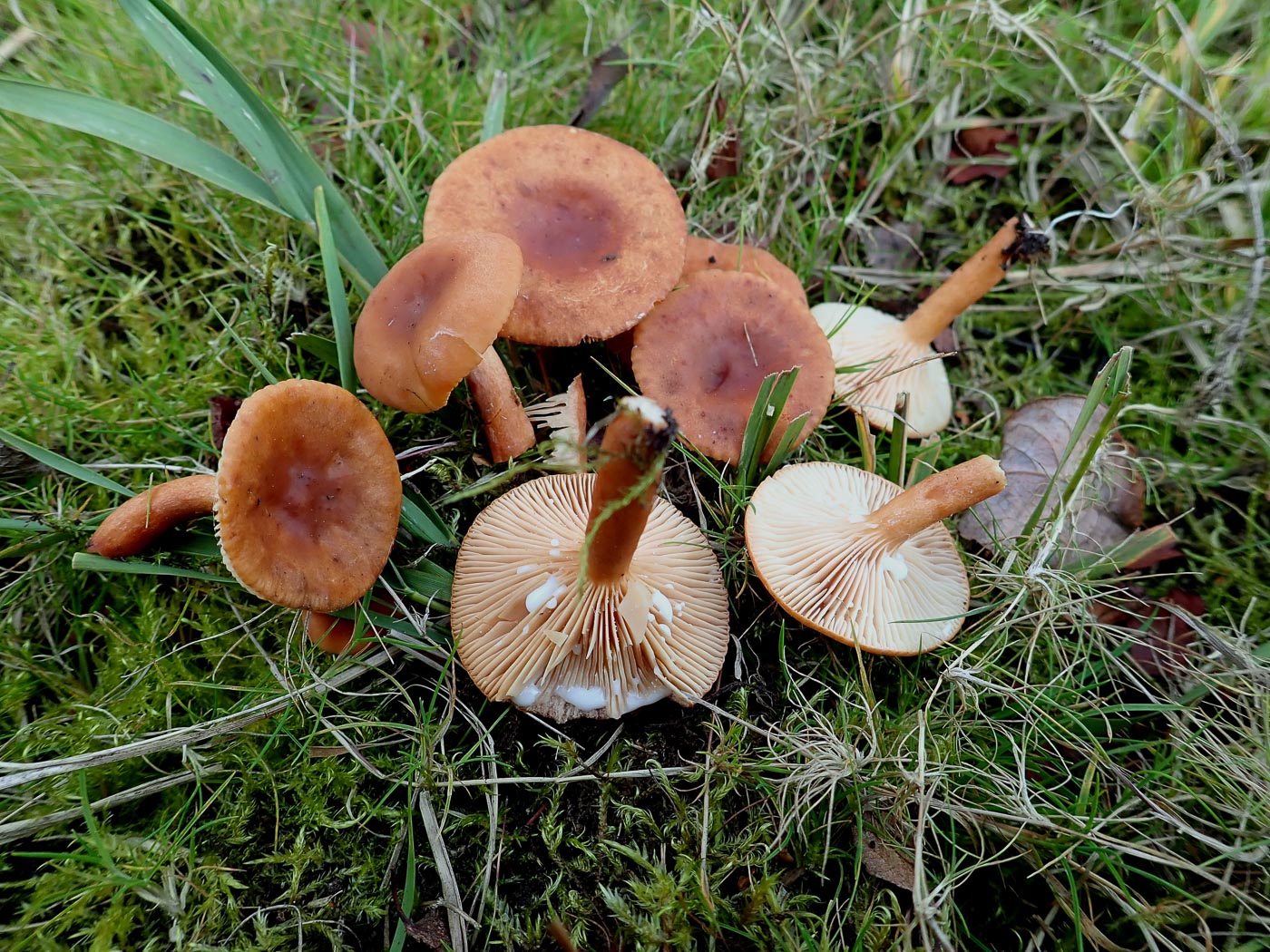 |
Lactarius lacunarum (a Milkcap with no common name) 
Jul 26, 2023. In Bernwood Forest Jesper Launder came across this group of Milkcaps under Oak, recognised the species but took it home to key out for confirmation. More often under Willow or Birch, this is quite a soft species - like a darker version of L. tabidus or L. subdulcis though much less common - and favours damp boggy areas. Also like L. tabidus, the milk turns yellow on a hankie but this is a paler, slower and less impressive reaction than in that species.
Oct 27, 2021. Also under Birch at Stoke Common Penny found this much less common Milkcap, often quite squat in stature, it has a bright reddish brown cap and stem and, like the much more common Birch species L. tabidus, its white milk turns yellow on a hankie (though not as strongly so as in that species). Unlikely to be mistaken for L. tabidus, however, it has a darker cap, its stem is fragile and often hollow, and it favours wet boggy areas sometimes under Alder, Oak and Willow also.
|


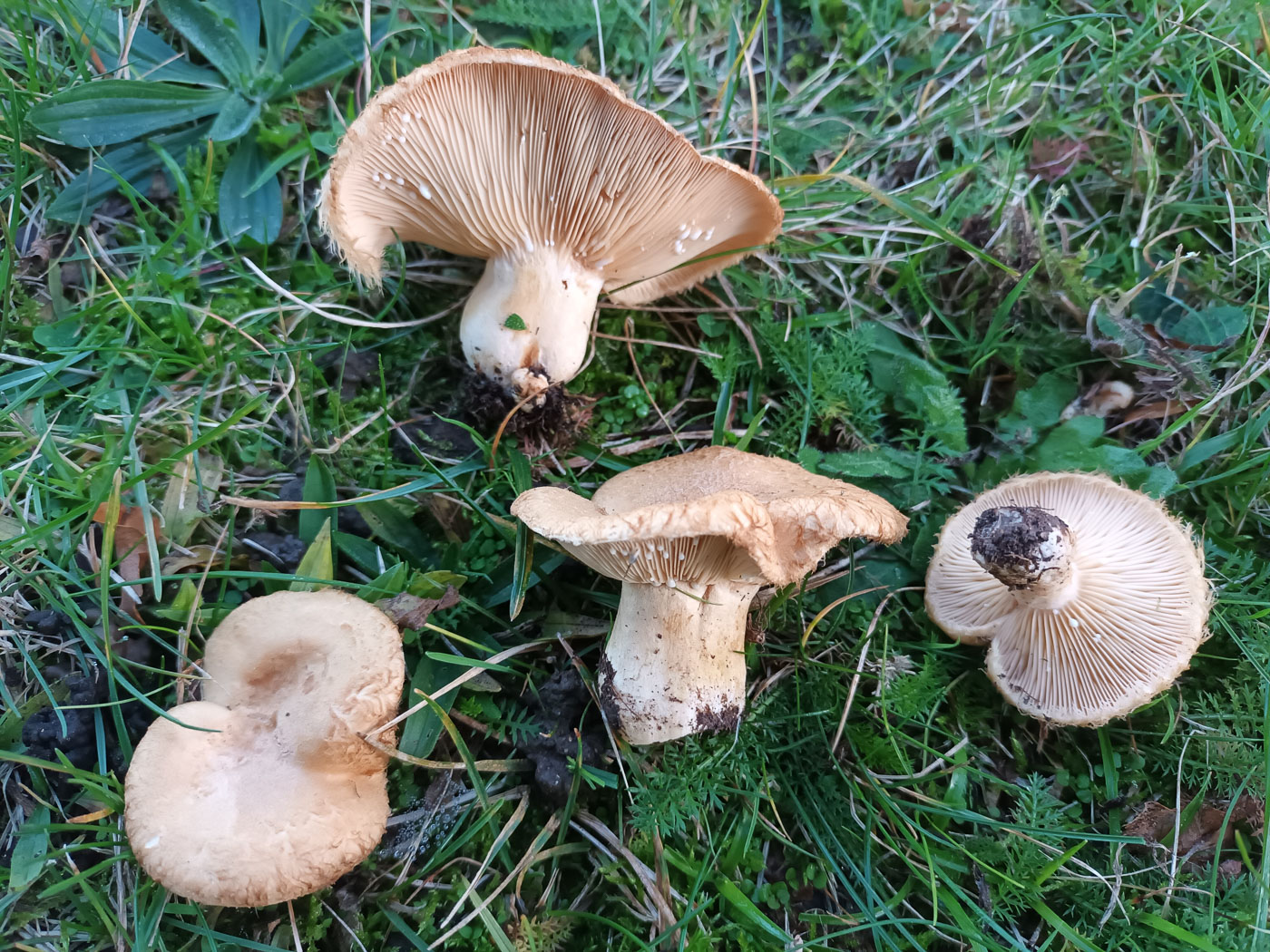 |
Lactarius mairei (Whiskery Milkcap)
Jul 18, 2023. In Gerrards Cross Common under Oak Jesper Launder was delighted to come across this rarity again - our first county record was his last year from Chalfont St. Peter (see in Finds 2022 November 2nd). L. torminosus and L. pubescens are two other quite similar Milkcaps having this combination of a tightly inrolled cap when immature which is somewhat hairy and zoned. However, both are host specific with Birch rather than Oak and have pink tints - paler in the quite common L. pubescens, darker in the less common L. torminosus; furthermore both reportedly have a slightly fruity smell whereas L mairei has an oily smell of Pelargonium leaves!
Nov 2, 2021. In Chalfont St. Peter under Oak Jesper Launder found this rare Milkcap which appears to be new to the county and has been on the Red Data list with under 80 UK records. There are only four 'hairy' capped Milkcaps: all are quite pale, three are found only under Birch, L. torminosus and L. pubescens being quite common and the third found only in Scotland, but today's species is only under Oak and has a distinctive fruity smell similar to that of Pelargonium leaves. The hairy cap margin is clearly visible in Jesper's photo. This was a special find.
|


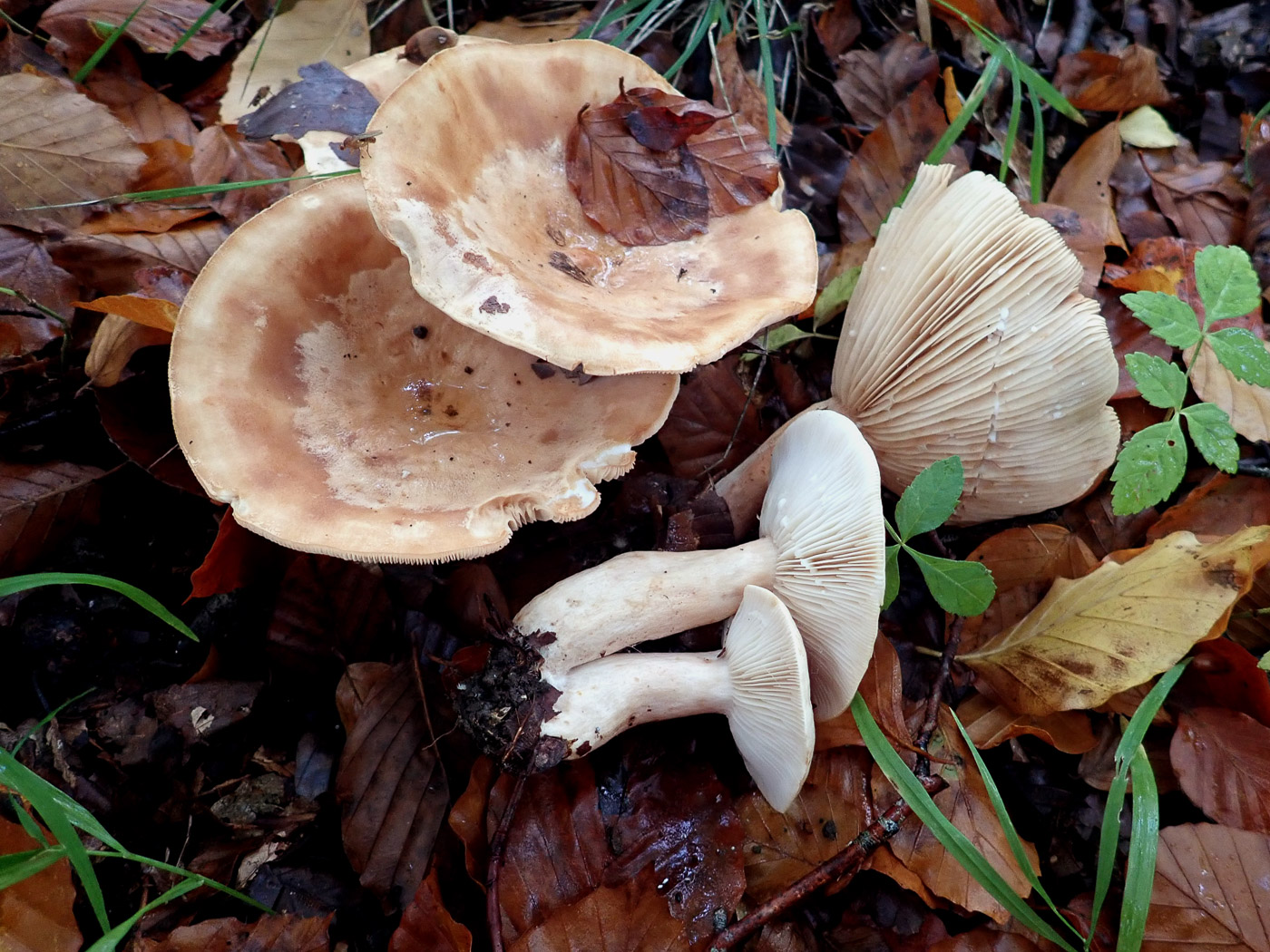
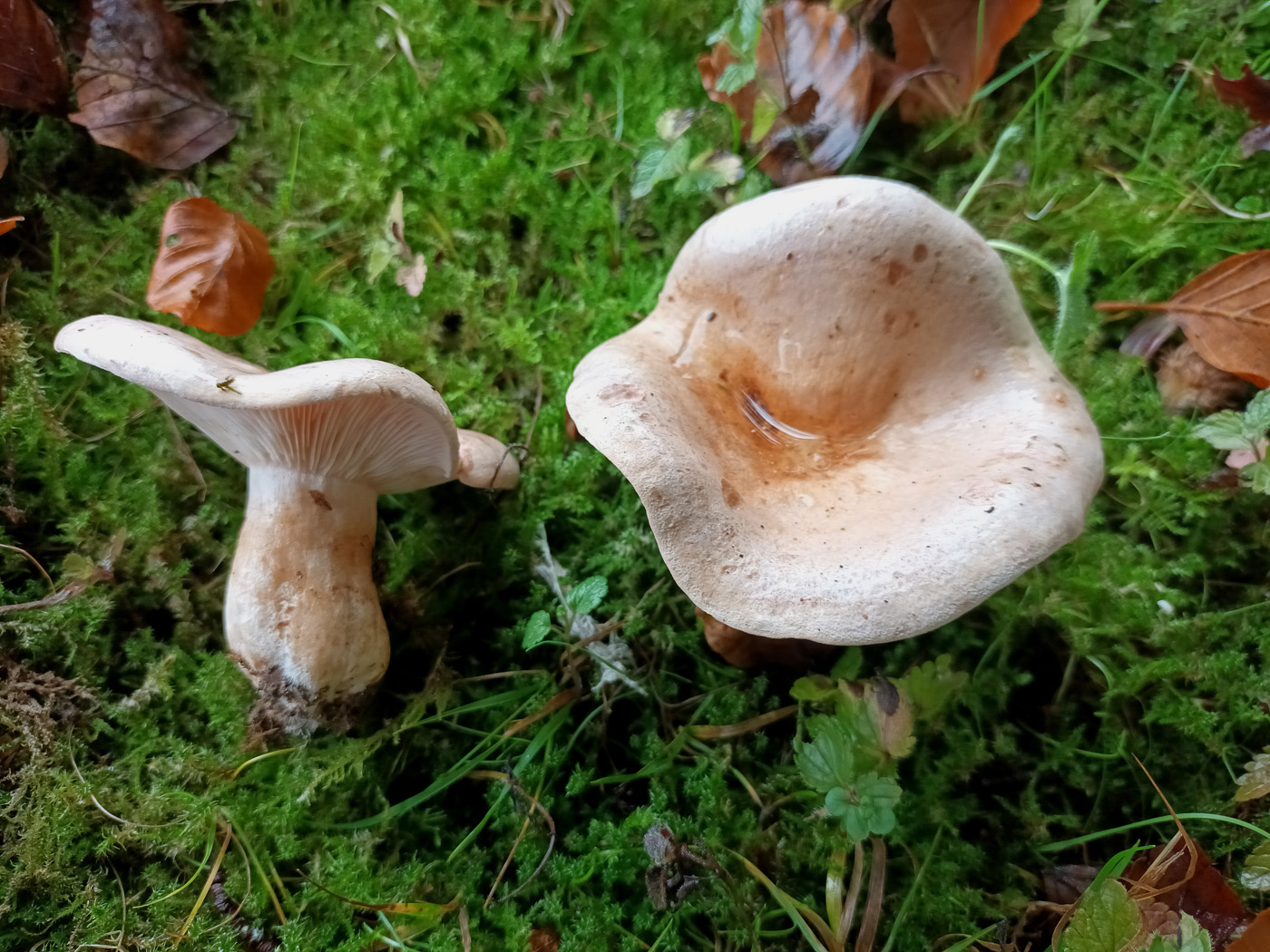 |
Lactarius pallidus (Pale Milkcap)
Aug 16, 2023. In Gussett's Wood Penny and Paul found just a few specimens of this occasional species coming up under Beech, the tree with which it associates. It has a pale pinkish cream smooth cap with no zoning and tends to be rounded in shape and can get quite big - up to 10 cm across. See also in Finds 2021 October 19th and 2022 October 21st.
Oct 21, 2022. In Gussett's Wood under Beech Penny found many fruitbodies of this Milkcap which is host specific to Beech therefore not that unusual in our Chiltern woodlands. The pale smooth caps were were the biggest she'd seen and up to 12 cm across or more (the leaf on one cap in the photo gives an idea of their size here.
Oct 19, 2021. In Chalfont St Peter Jesper Launder found this quite uncommon Milkcap under Beech with which it is host specific. As its common name suggests, it is pale pinkish buff, as are some other Milkcaps, but the cap is smooth and has no obvious zoning on the surface, also the milk remains unchanged on the gills and these features together with its occurrence under Beech should be sufficient to eliminate other possibilities.
|
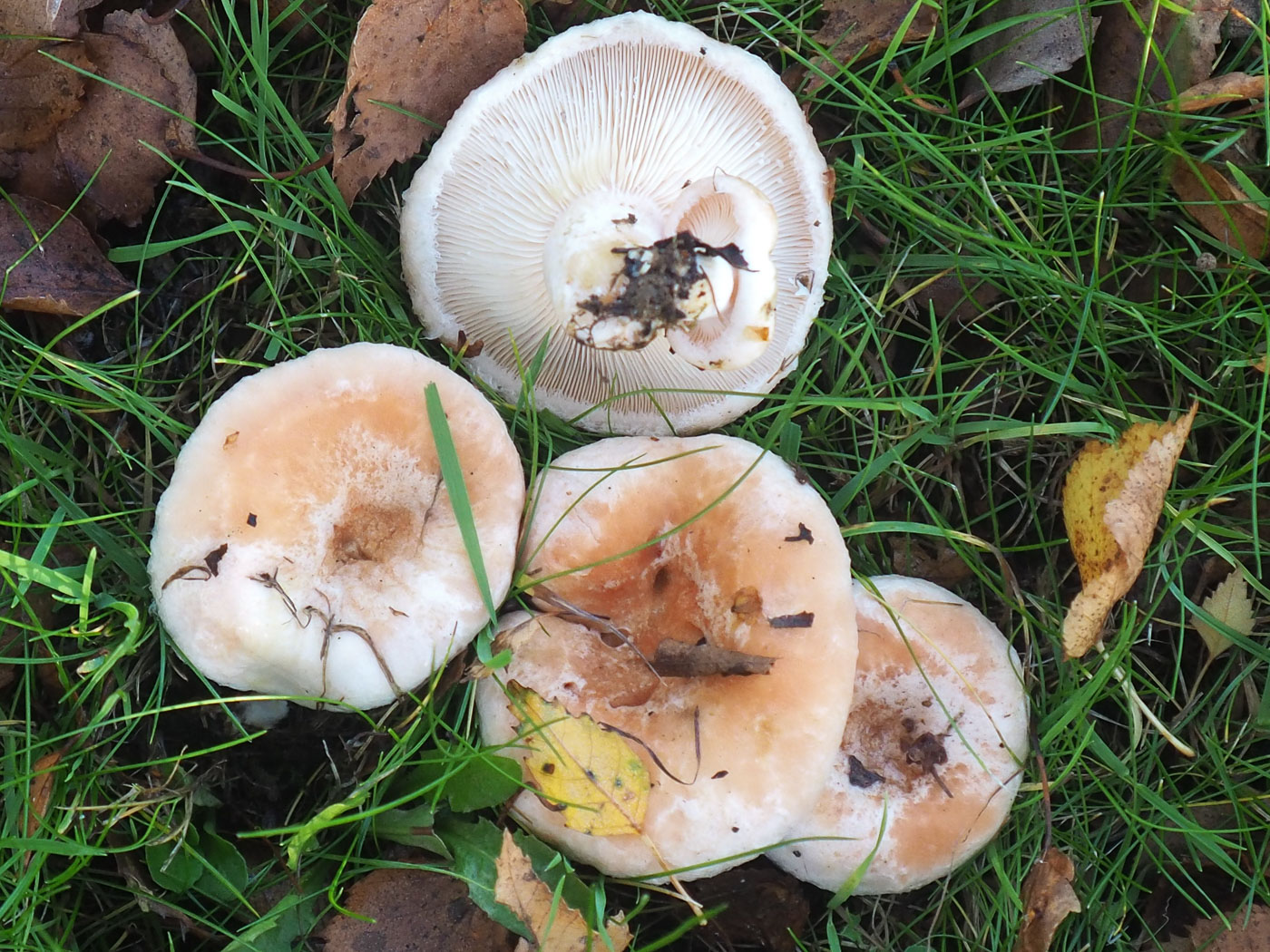 |
Lactarius pubescens (Bearded Milkcap)
Nov 1, 2020. John Catterson noticed this late fruiting group of Milkcaps under Birch in a churchyard in High Wycombe. This species is like a paler version of L. torminosus (see photo dated Sept 18) which also is host specific to Birch. Note the finely hairy surface particularly at the margin which it tightly inrolled when young. Caps can get to 6 cms across or so and have pale flesh pink tones. L. pallidus (which we've missed for some reason) is a similar colour and shape but entirely smooth and is host specific with Beech.
|
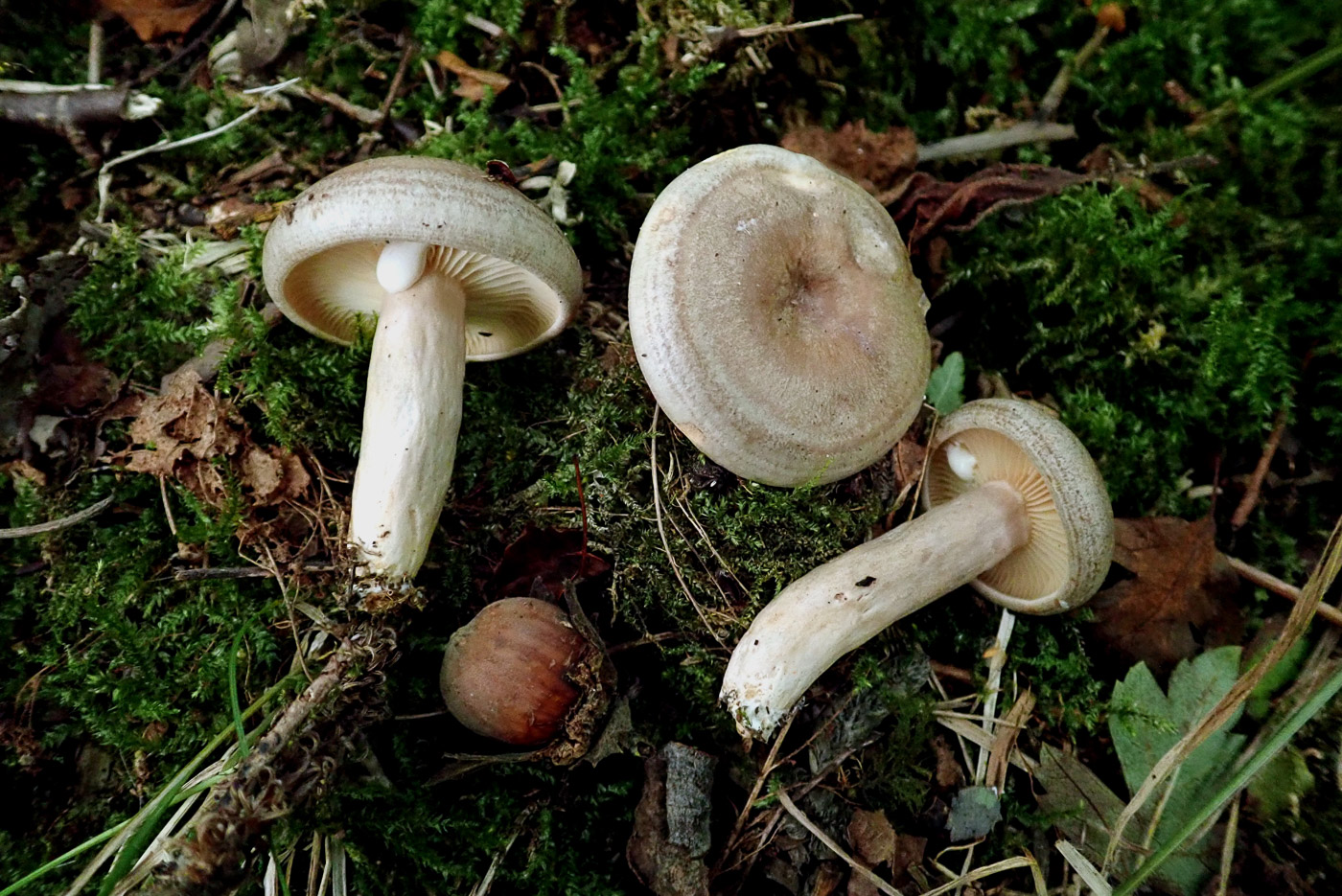
|
Lactarius pyrogalus (Fiery Milkcap)
Aug 19, 2023. Rushbeds Wood has abundant Hazel along the rides so Penny was not surprised to find this species (one which is host specific to Hazel) in good numbers in several place today. The species has a pale buff sticky cap (especially after rain) and quite widely spaced pinkish buff gills almost reminiscent of the group of Milkcaps in which the milk stains the gills pink as it slowly dries. However, the abundant milk in this species goes if anything greyish green and not pink, but is notable in being burning hot on the tongue - hence its common name.
Sep 10, 2020. Host specific with Hazel, this species of Milkcap is one of the hottest tasting in the genus, hence its common name. It was found by Penny Cullington in Rushbeds Wood. Tasting in this genus is a method often used in the field as an identification aid, but luckily this species is easily recognised without the need to burn one's mouth if one notices the host tree and also its pinkish peach coloured gills. It usually exudes copious milk when damaged, as here.
|
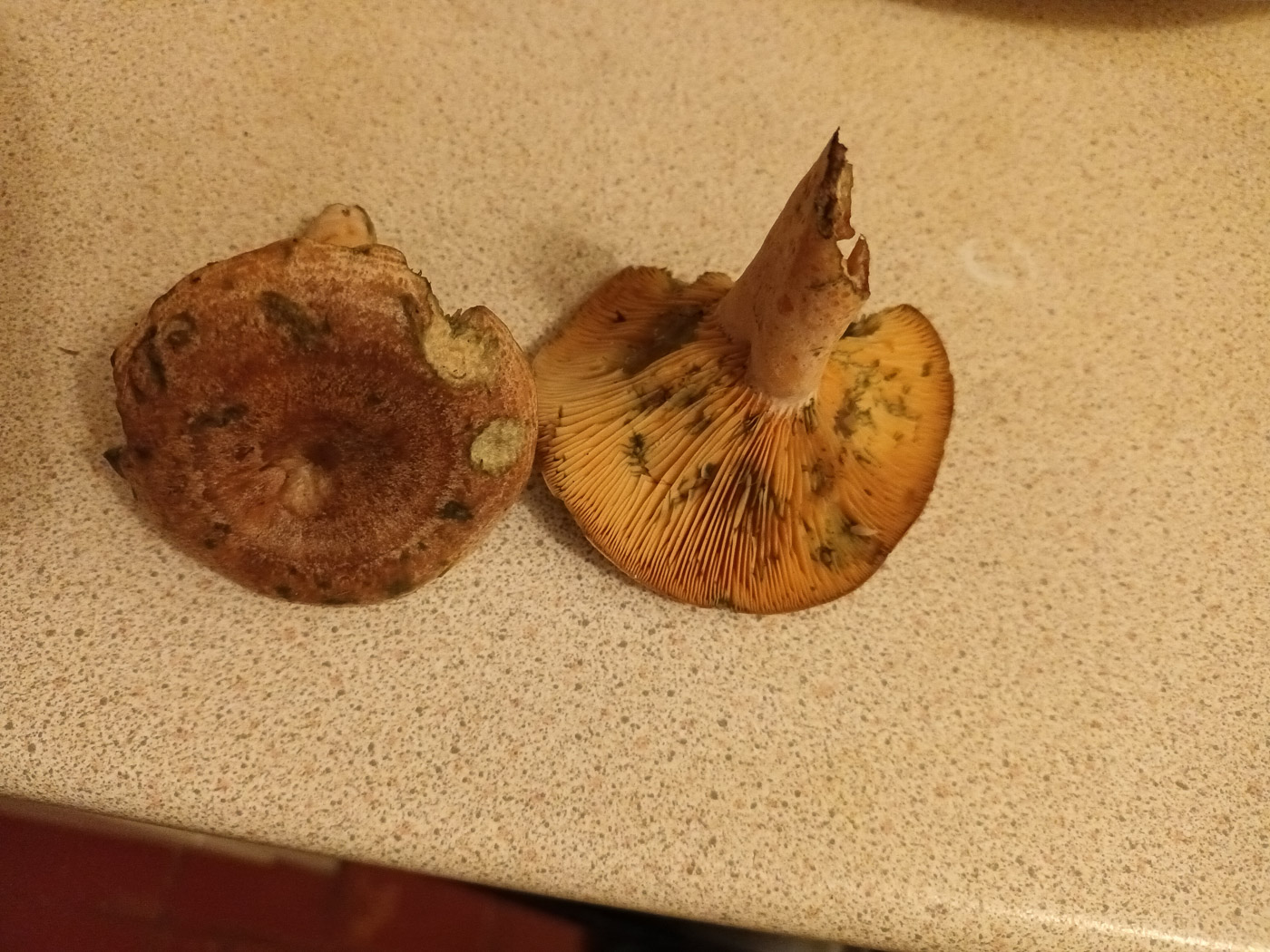
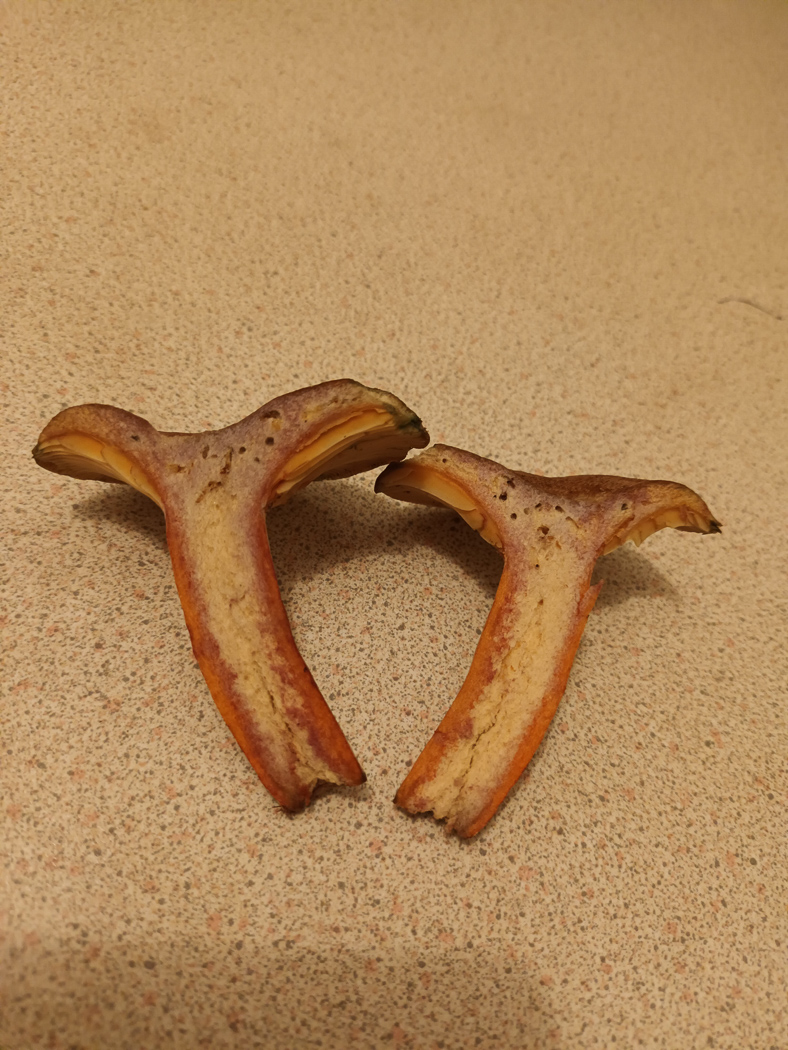 |
Lactarius quieticolor (a Milkcap with no common name)
Oct 29, 2021. Under Pine in woods in near darkness near Jordans Village Jesper Launder found this rare Milkcap which is new to the county. It is one of the Milkcaps which have orange milk like L. deliciosus and are found with specific conifers, some of which have flesh with unusual colour changes (see also L. semisanguifluus dated Oct 19th). Today's species has a rather greyer orange cap compared to others in this group and tends to have a bluish tint with flesh that turns pink then green. (Jesper's photos were taken under artificial light so possibly don't reflect the true colours.)
|


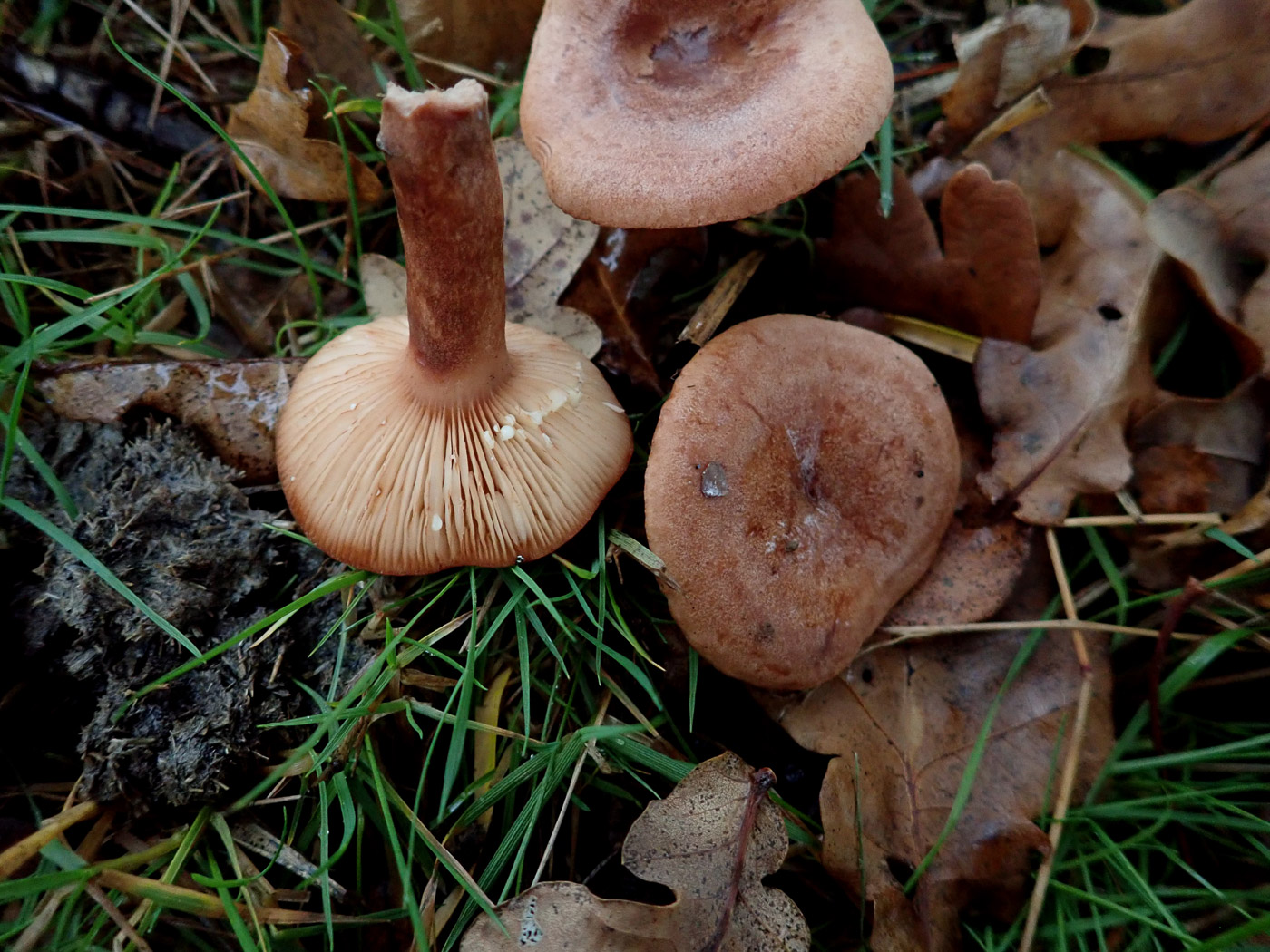
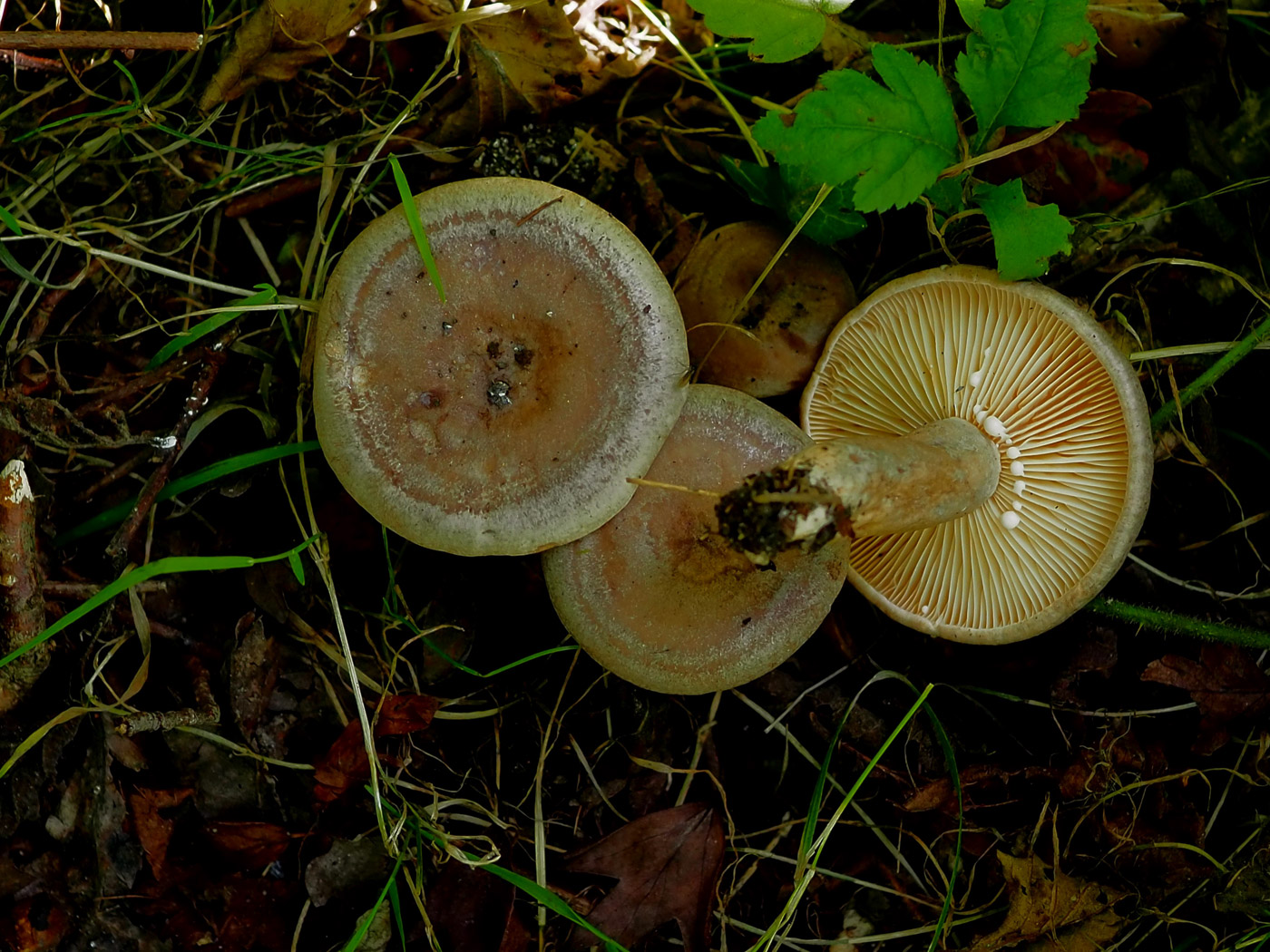
|
Lactarius quietus (Oak Bug Milkcap)
May 26, 2023. Whilst bird-watching at Stoke Common Penny was amazed to come across this pair fruiting alongside an old Oak stump. We have many county records of autumn fruiting, a few from August, just one or two from July but nothing earlier than that. Furthermore Milkcaps are not considered one of the early mycorrhizal genera and some years don't start appearing till October - hence Penny's surprise today. See also in Finds 2020 September 12th and 2022 November 29th.
Nov 29, 2022. Penny found this species still making an appearance under Oak at Stoke Common. This is one of our commonest Milkcaps yet we only have one other example on Finds (2020 September 12th), hence the inclusion of the photo today especially as the caps were showing the typical zoning which is one of its main features - the other being its distinctive smell which sadly we can't demonstrate here!
Sep 12, 2020. One of our commonest Milkcaps, this species was found by John Catterson fruiting under Oak, its host tree, at The Common, Cadmore End. Once you've noted that it's a Milkcap in the field by the presence of milk when damaged, the zoning markings on the cap, its distinctive oily rubbery smell and occurrence only under Oak are all good characters to separate the species from the many others in the genus, all of which are found under trees. The smell is one worth getting to know as it occurs not just in other Milkcaps but also in other fungi and is thus used in descriptions as the 'quietus smell'.
|
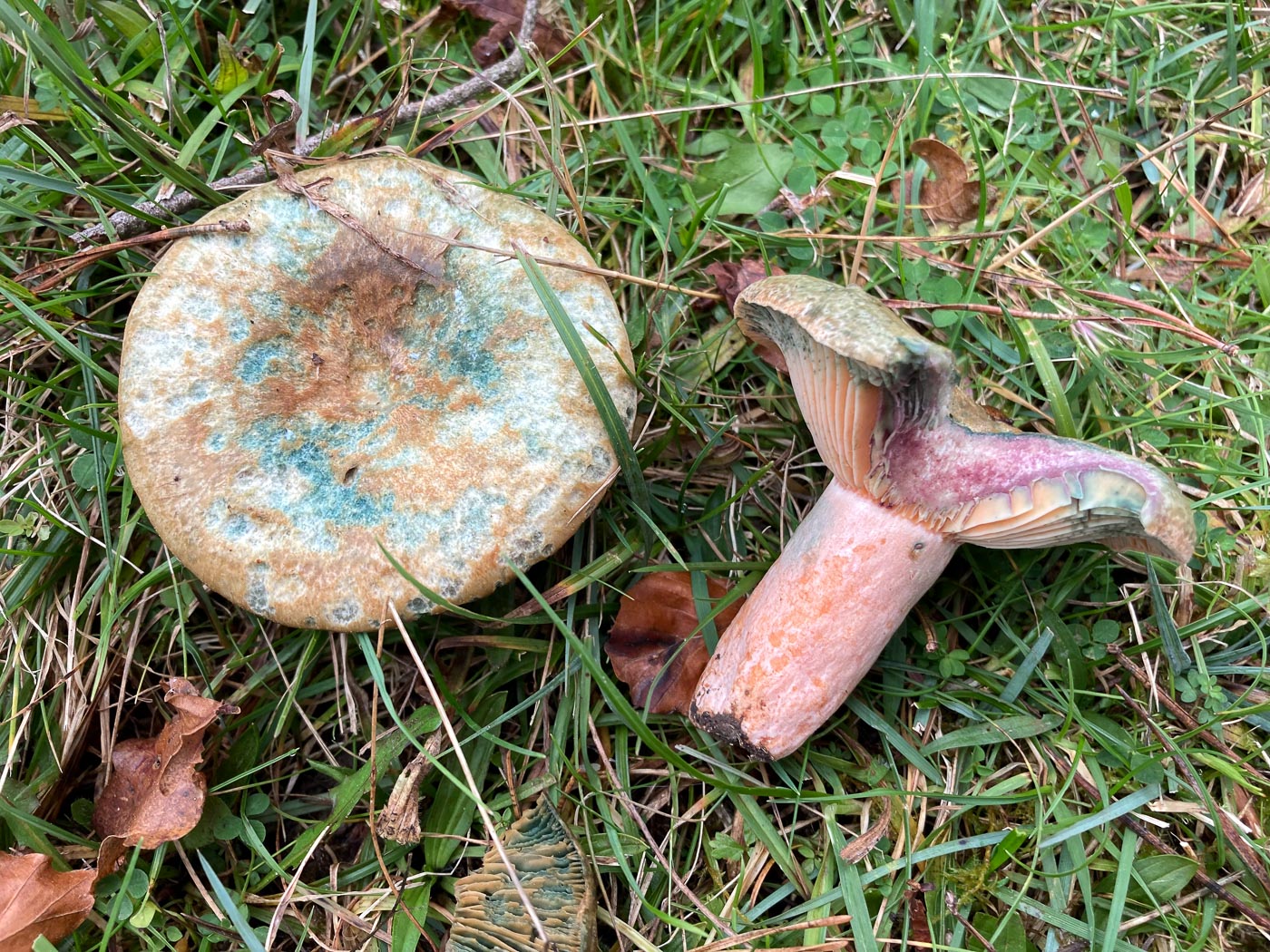
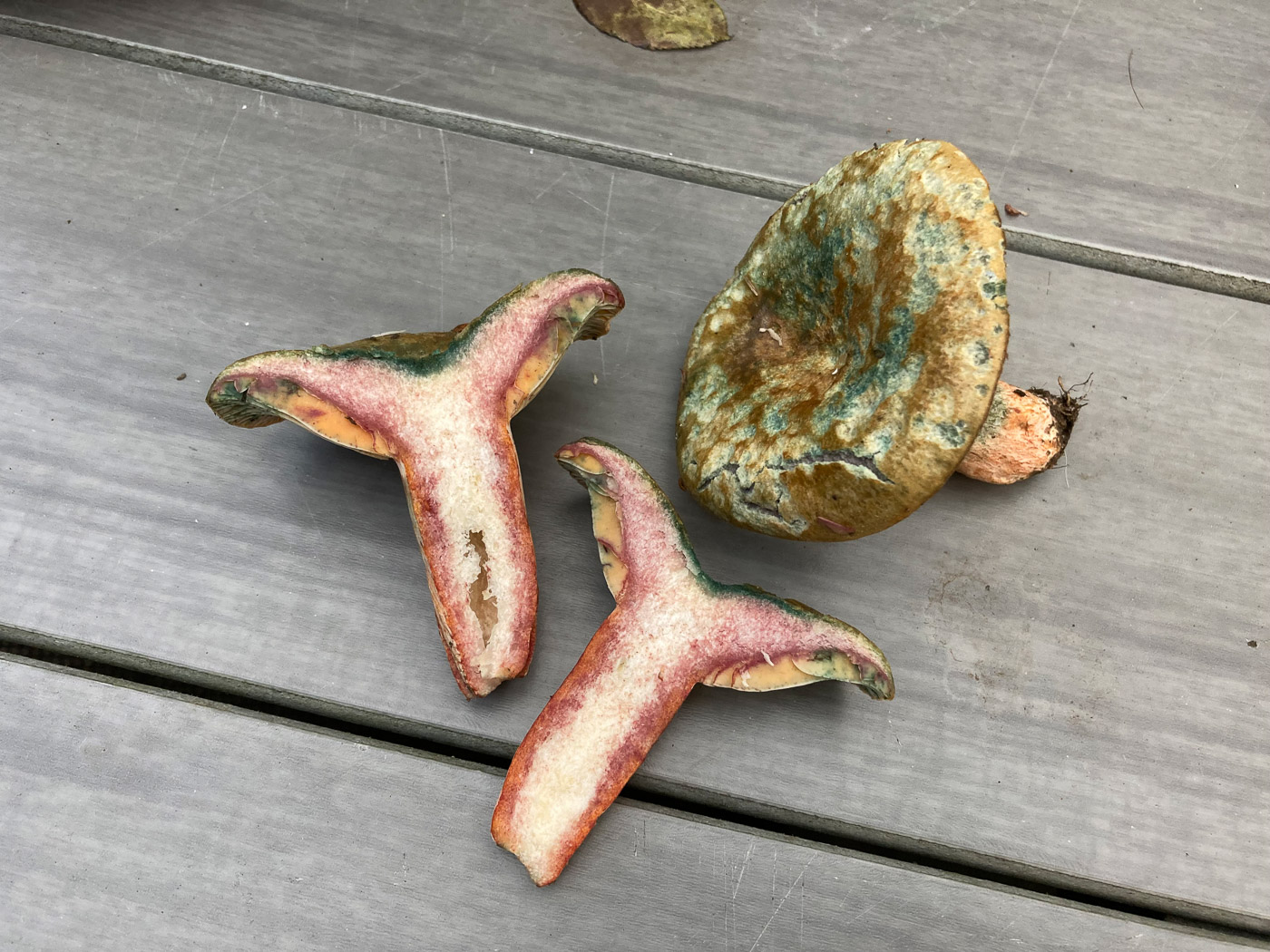
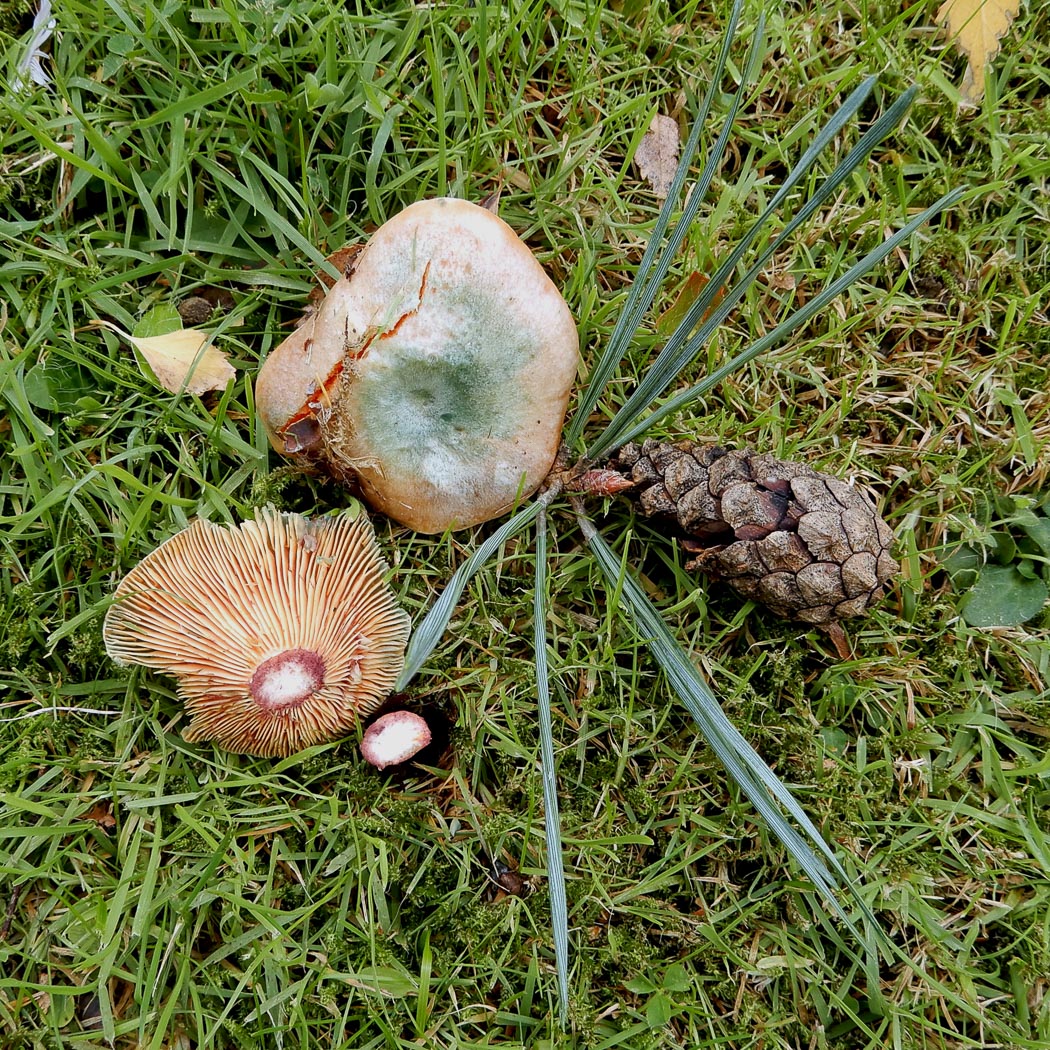
|
Lactarius semisanguifluus Lactarius semisanguifluus
Nov 6, 2021. Under Pine at Cliveden Estate Russell Ness found some nice examples of this interesting Milkcap, a species very similar to the familiar L. deliciosus (Saffron Milkcap) - another Pine associate with orange milk - but milk and flesh both staining wine red within a few minutes of exposure to air.
Oct 5, 2020. Margaret Bolton found this interesting Milkcap under Pine near Moorend Common. Initially impossible to tell from the better known Saffron Milkcap (see photo dated Sept 25), especially as both species are only found under Pine, one needs to damage the underside (as Margaret did) and wait for a few minutes watching for any colour change in the orange juice and flesh. Note how the upturned specimen is turning distinctly wine red where the stem was broken off, making this L. semisanguifluus. Probably not rare but not often recorded due to many finders assuming they have L. deliciosus!
|
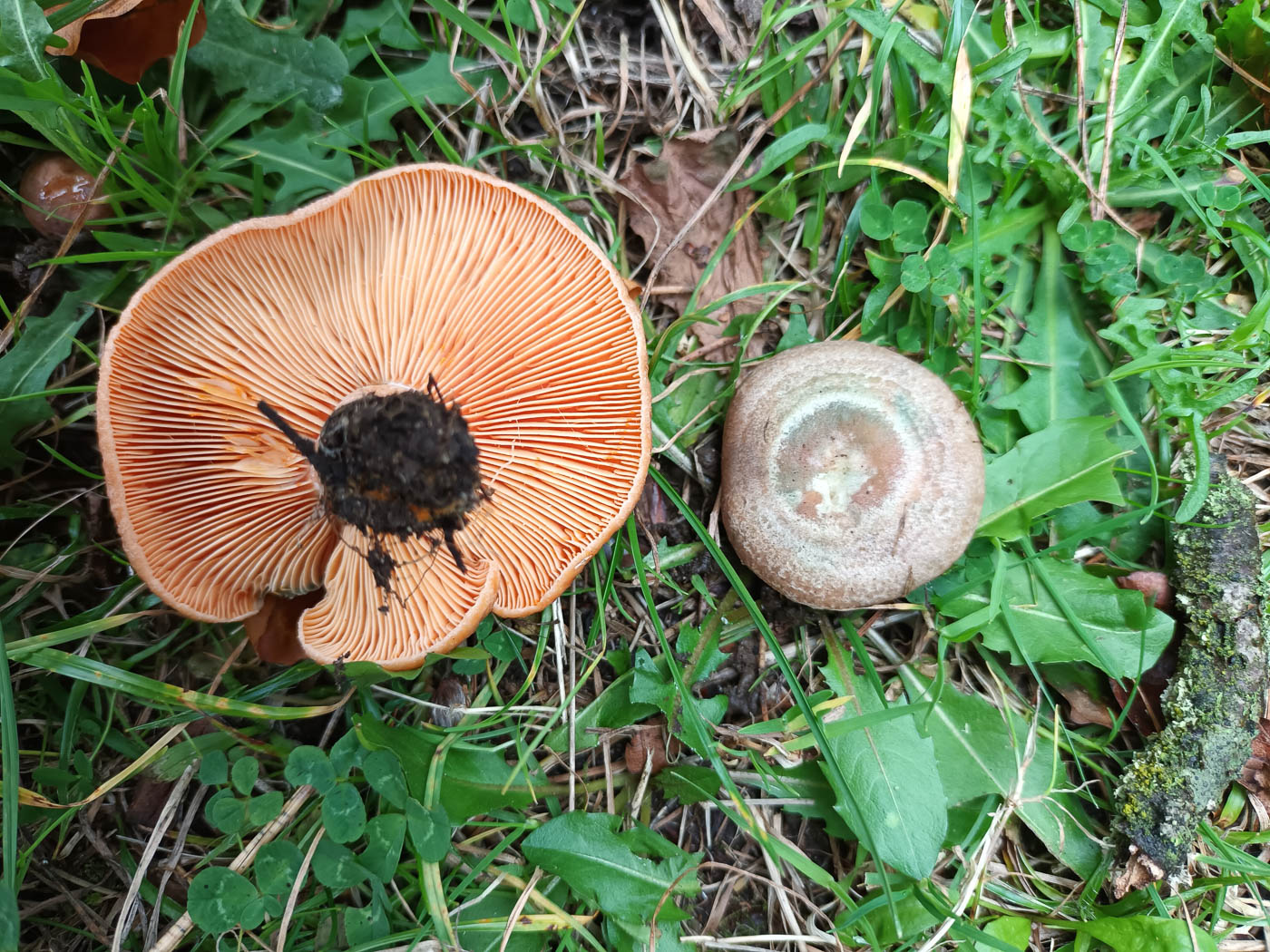
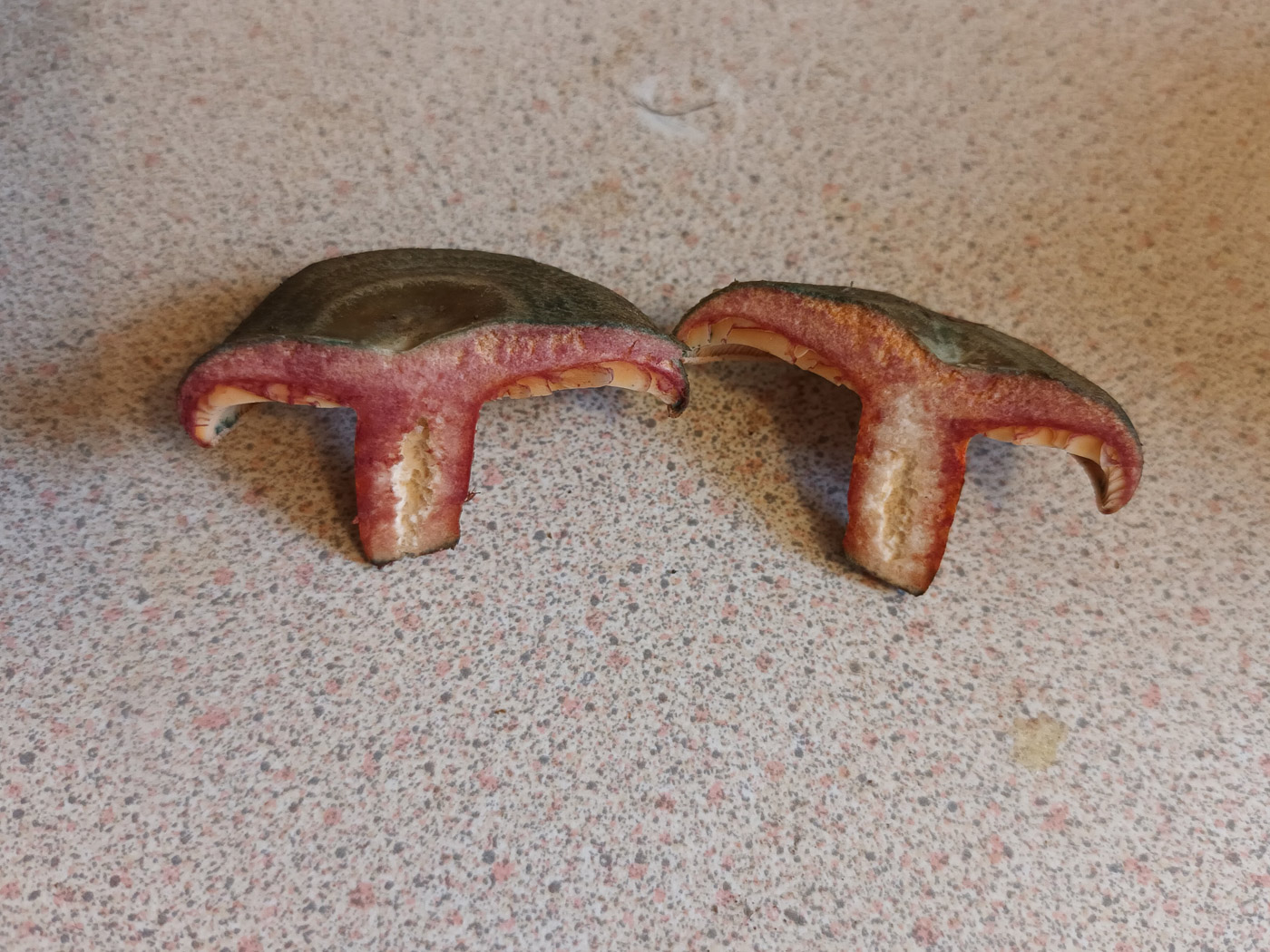 |
Lactarius semisanguineus (Bloody Milkcap)
Oct 19, 2021. Under Pine in Chalfont St. Peter Jesper Launder found this pair and recognised them as one of two possible species: either L. deliciosus or the less often recorded L. semisanguifluus. There are several similar Milkcaps which grow under conifers, have orange gills and milk and a tendency for the caps to turn green (very rarely blue!). Only under Pine (not Spruce) are the two mentioned above, the difference between them being that the flesh when exposed to air turns wine red in about five minutes in today's rarer species, but hardly changes at all or if so only after a much longer time in L. deliciosus (see photo 2 taken after 10 seconds). The species is not often recorded, quite possibly due to lack of knowledge of this colour change. Very similar and quite common is L. deterrimus, confined to Spruce, with no wine red flesh change and the cap often turning green.
|

 |
Lactarius serifluus (Watery Milkcap)
Jul 25, 2023. In soil attached to Oak roots in Bernwood Forest Penny spotted one very dark brown cap with a similar button coming up underneath it (visible in photo 2). The crimped cap margin together with rather watery milk - both visible in photo 2 - as well as the very dark cap colour with matt surface confirmed the species (previously know as L. subumbonatus, also L. cimicarius). The species is fairly common and often under Oak. This is a new entry for Finds.
|
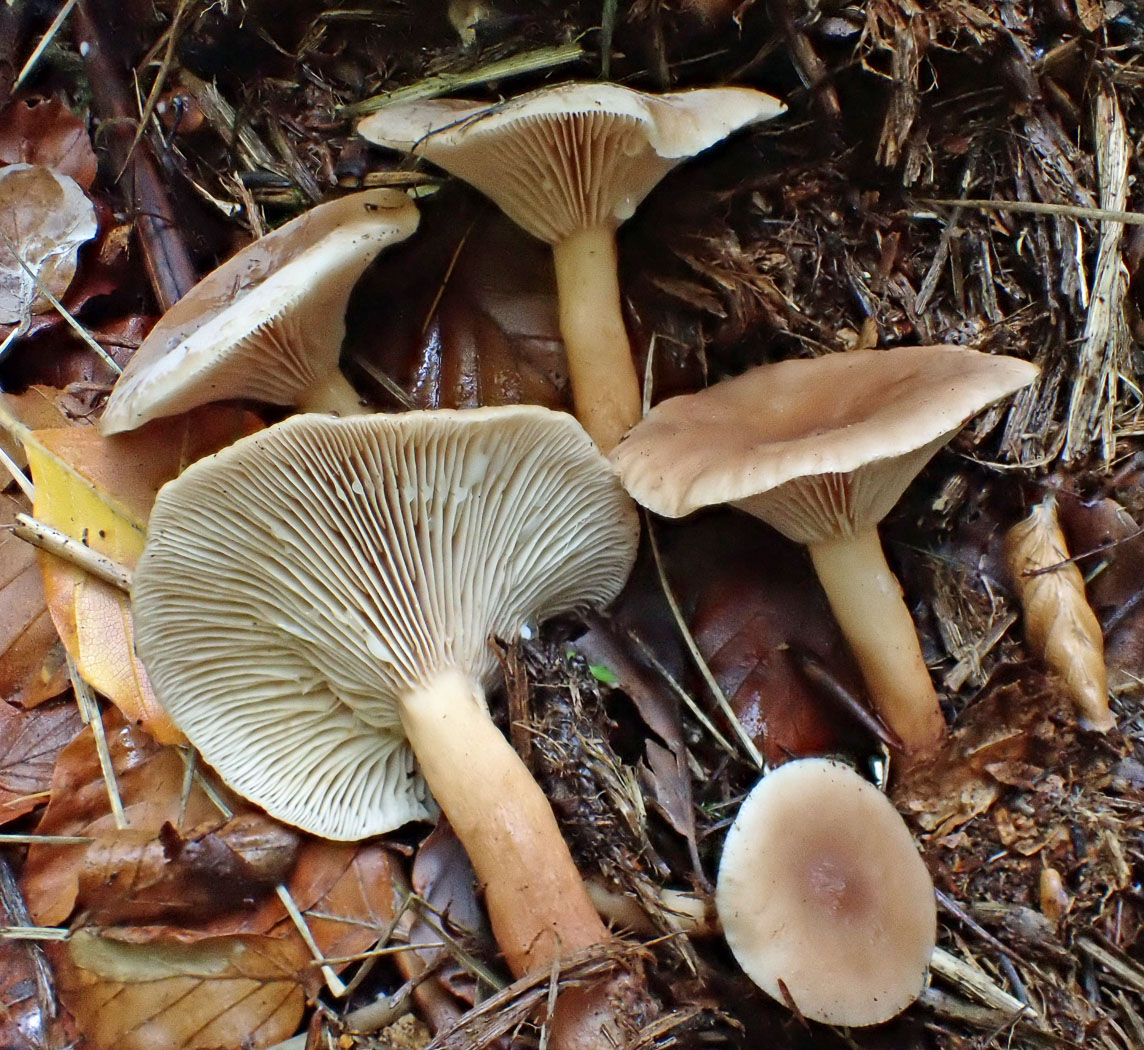
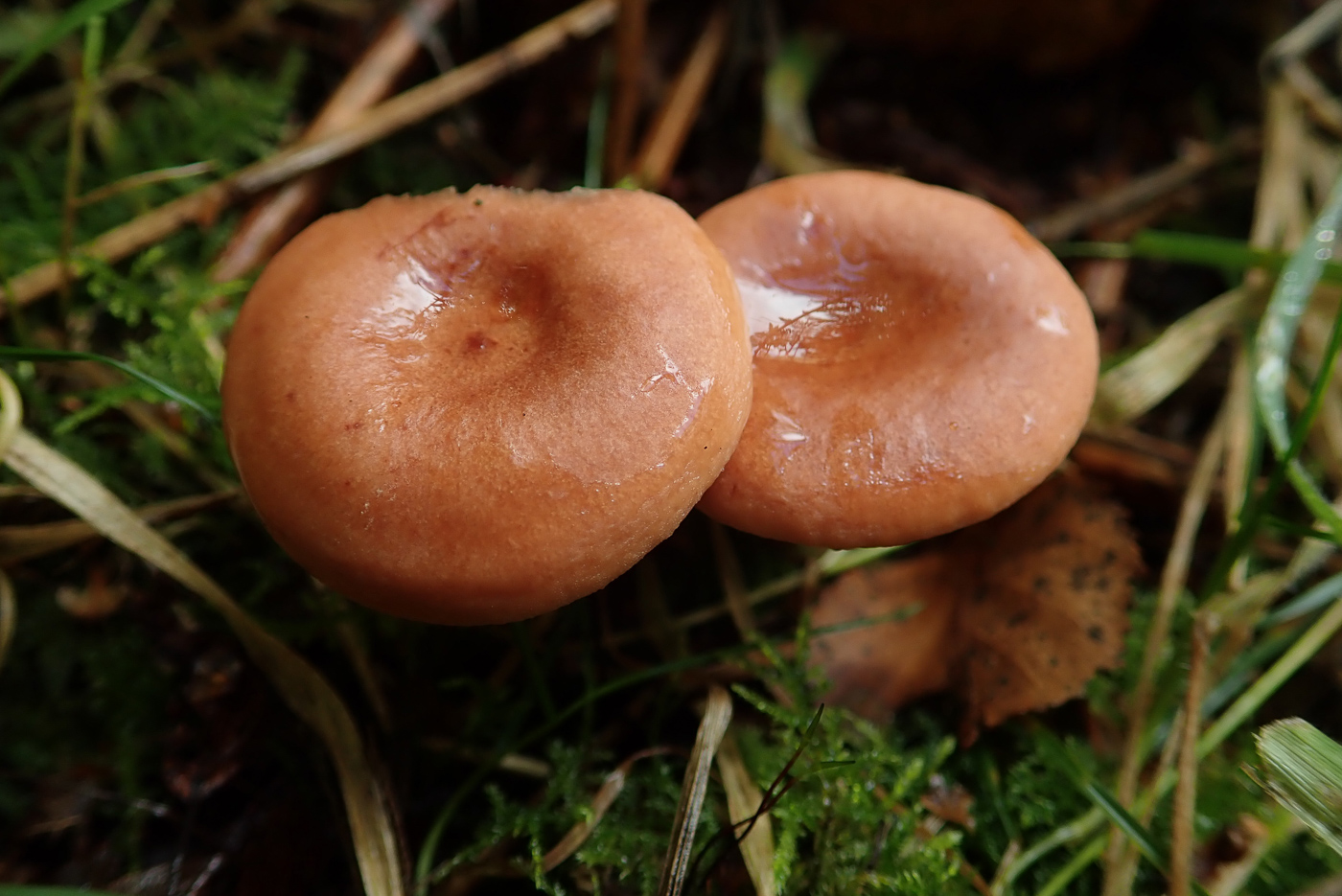
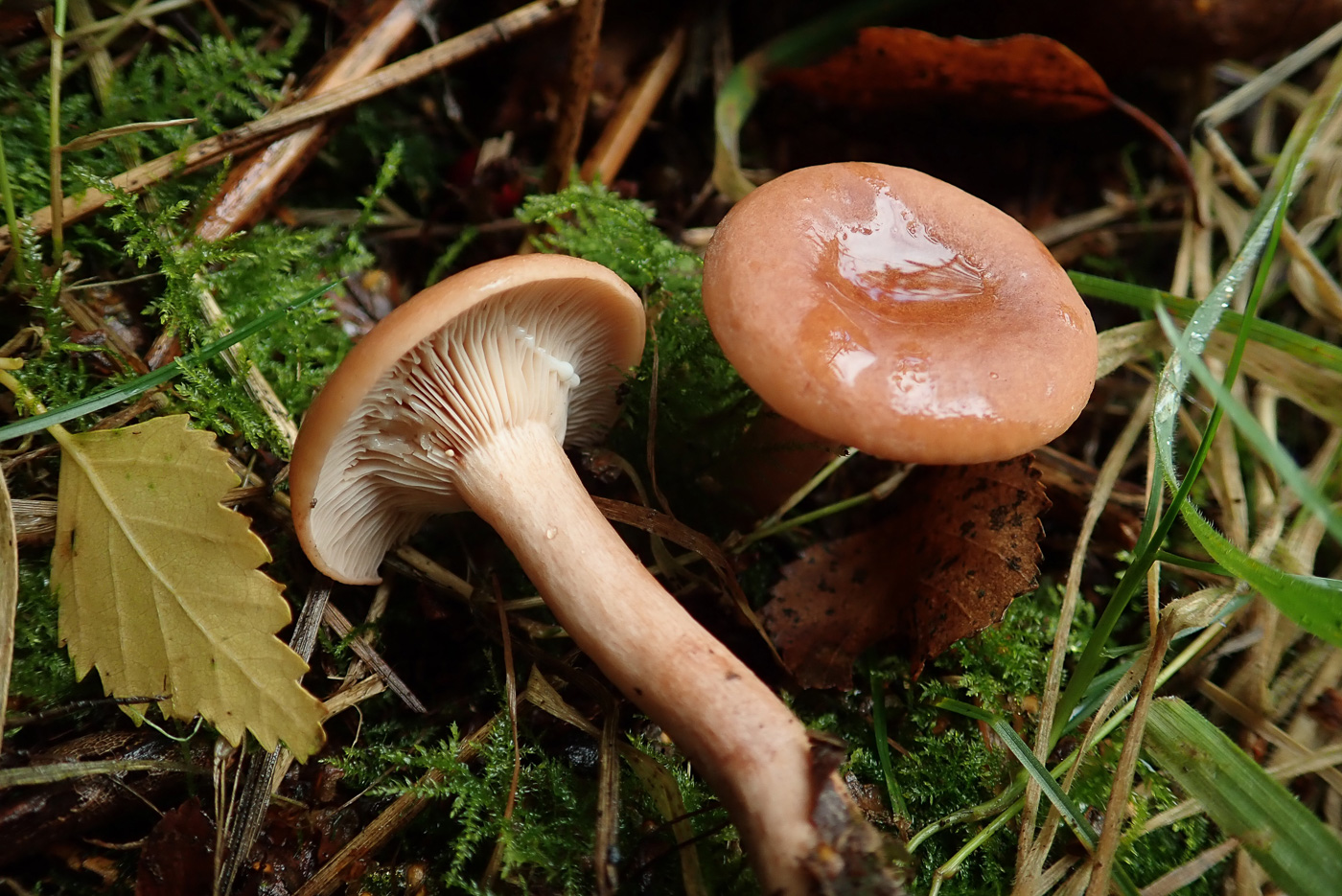
|
Lactarius subdulcis (Mild Milkcap)
Oct 19, 2022. At Bittam's Wood, Dancersend, a small group of us found several specimens of this species - one common under a mix of deciduous trees. It has quite thin flesh, a dry mid brown cap often with a tiny umbo (seen here in the lowest cap) and gills which are decurrent when young. It is very similar to L. tabidus (Birch Milkcap) but separable from it by the milk unchanging on a hankie (yellowing in L. tabidus), also a smell similar to L. quietus but sweeter, also its catholic preference for trees - not host specific unlike both the other two mentioned here. The photo is Neil Fletcher's.
Oct 1, 2020. Penny Cullington came across these two specimens growing under mixed deciduous trees at Turville Heath. The species is one of two, both very common, which look extremely similar, the second being L. tabidus (Birch Milkcap). Tree association is helpful but not entirely secure because despite its name the Birch Milkcap can occur under other trees in mixed woodland. Furthermore today's species occurs mainly under Beech but can also occur under other trees. Today there was no Beech present but plenty of Birch so testing the the milk by placing a drop on a white hankie (preferably cotton, not paper!) was essential. If you have L. tabidus the drop turns bright yellow in under 30 seconds. If you have L. subdulcis (as here) there is no change. (Incidentally, yellow but only slowly, in a minute or more = L. lacunarum!) A further difference - useful if it's dry and no milk is forthcoming - L. tabidus smells faint, slightly fruity but L. subdulcis smells oily, of rubber as in L. quietus.
|
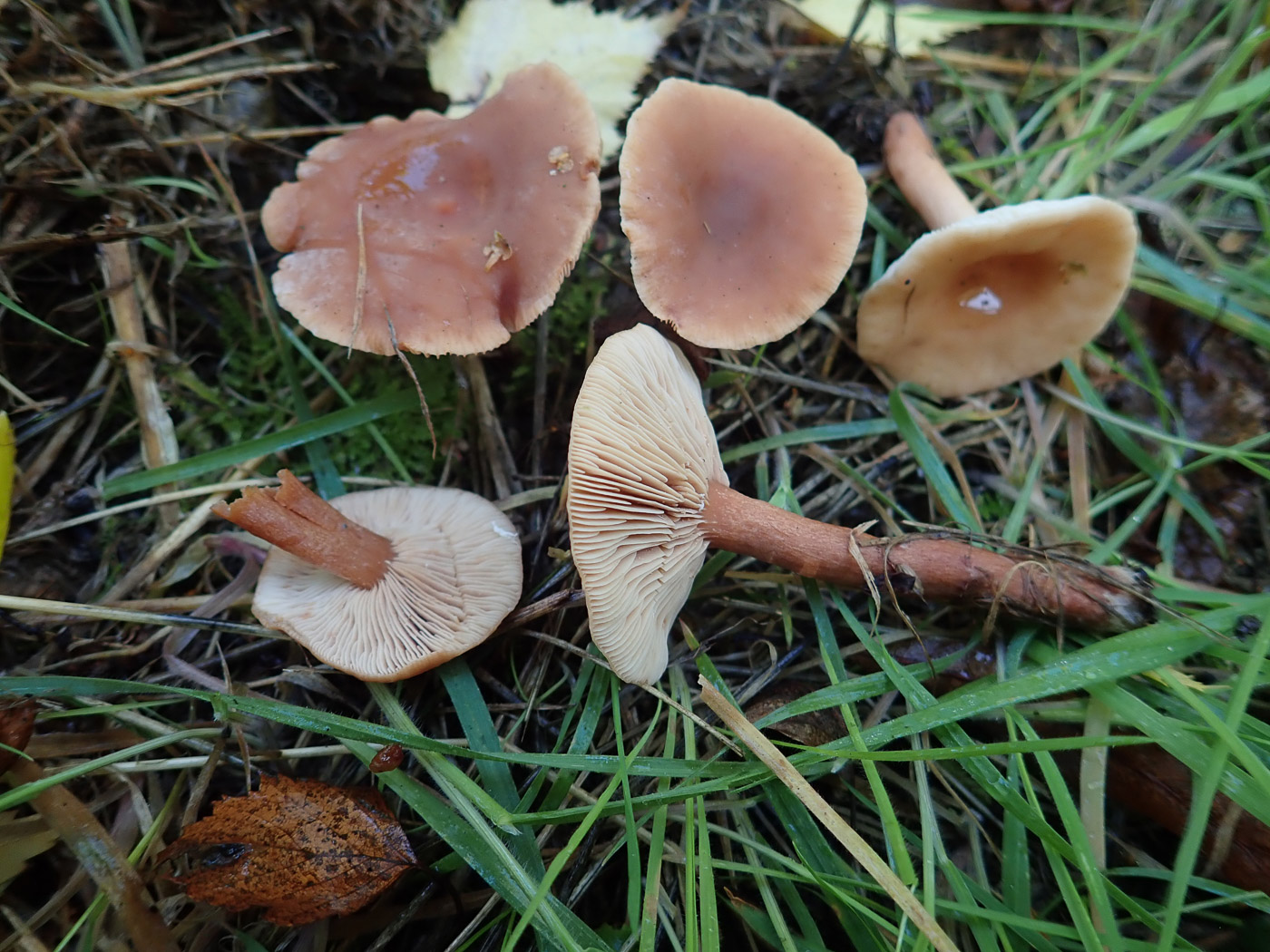
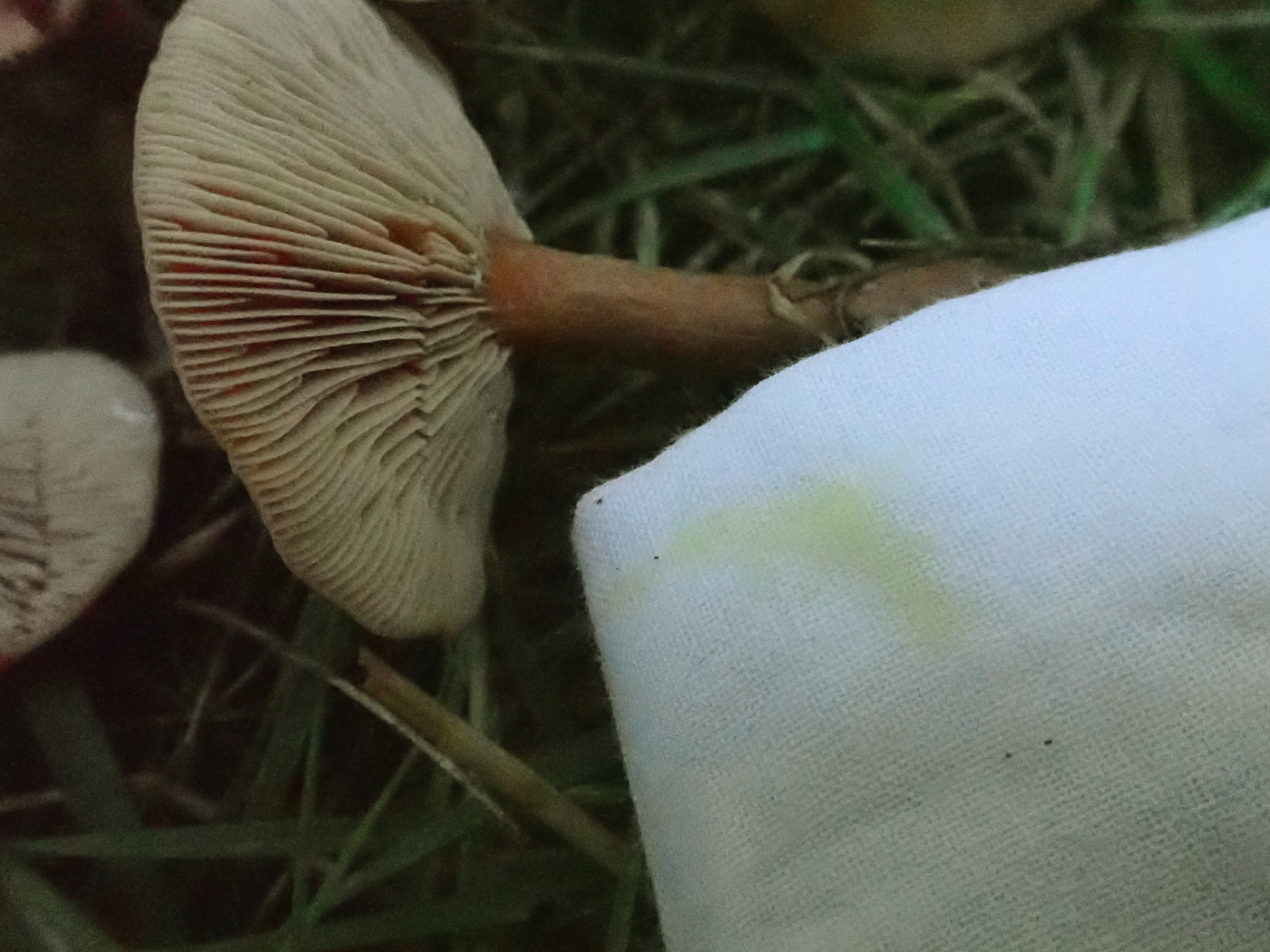
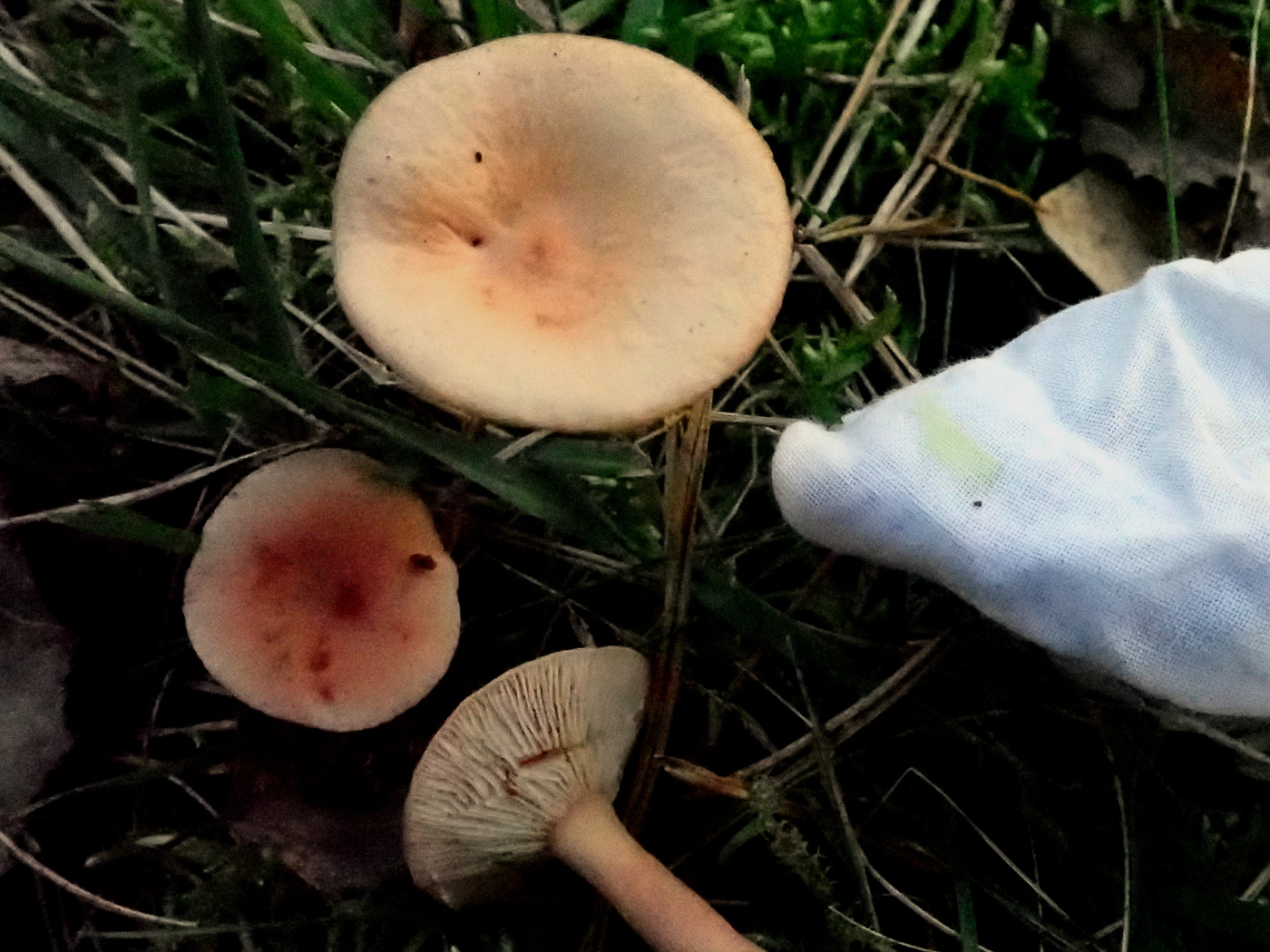
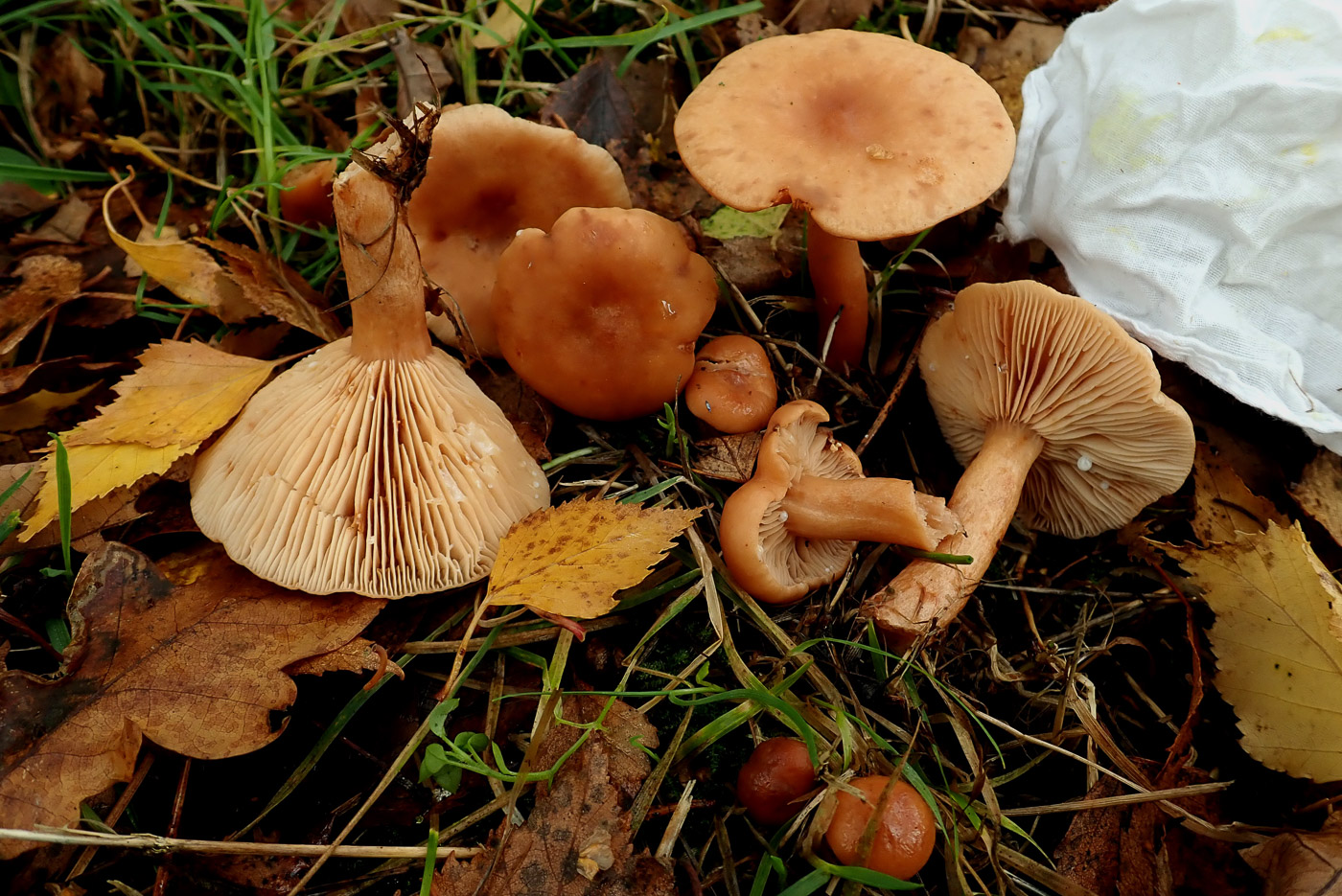
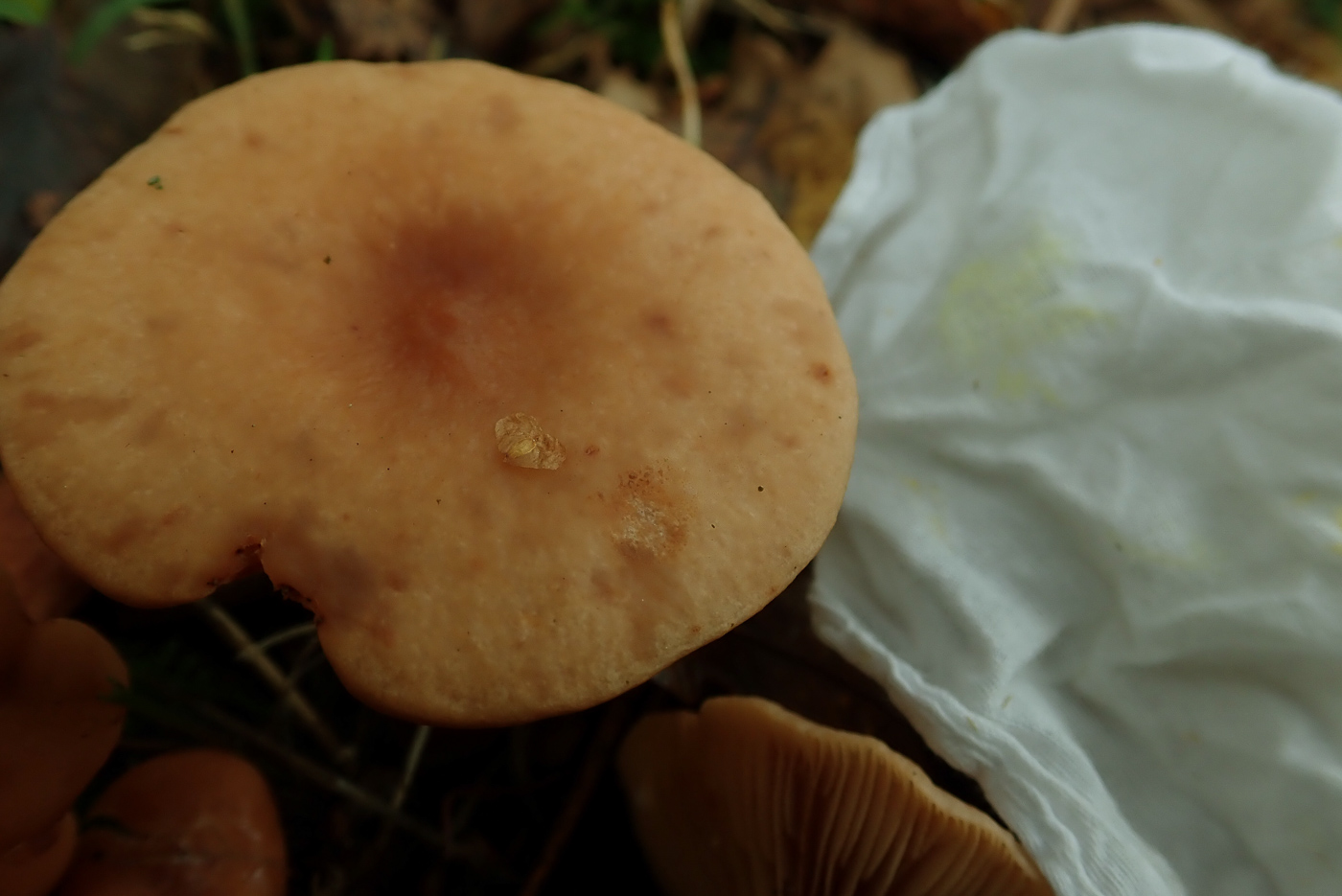
|
Lactarius tabidus (Birch Milkcap)
Oct 6, 2022. At Turville Heath under Birch Penny found quite a few of these very common Milkcaps, though the species is easy to confuse with L. subdulcis (Mild Milkcap) - another very common rather soft fleshed rusty brown Milkcap which, however, favours Beech rather than Birch. The two are not exclusively host specific, though, furthermore when a mix of trees are nearby one can't be sure what is associating with which! The hanky test is a useful way to split them: milk from the damaged gills turning yellow (as seen here) indicates L. tabidus; milk showing no change indicates L. subdulcis. If no milk is forthcoming (as can happen), find another specimen and try again!.
Nov 9, 2021. In a grassy glade under Birch at Burnham Beeches Penny found several of these Milkcaps and tested the milk on a hanky which dutifully stained yellow in 10-15 seconds (just visible in the photo!). Though named after its main host tree, it can also occur under other deciduous trees and is extremely similar to L. subdulcis (Mild Milkcap), hence the handy hanky test which separates them: there's no colour change in L. subdulcis which incidentally has a distinct smell of L. quietus. (The test works better on cotton rather than paper!)
Nov 5, 2020. Penny C. found several fruit bodies of this common Milkcap in longish grass under Birch at Turville Heath. It is a medium sized soft fleshed Milkcap with a reddish tan coloured cap which fades with age, often having a slightly sunken centre with a small umbo. Compare with the extremely similar L. subdulcis dated Oct 01 where Penny's notes cover the differences to look out for. She attempted to include in the photos here her hankie with the yellow stain from the milk which is a diagnostic feature, but only fairly successfully!
|
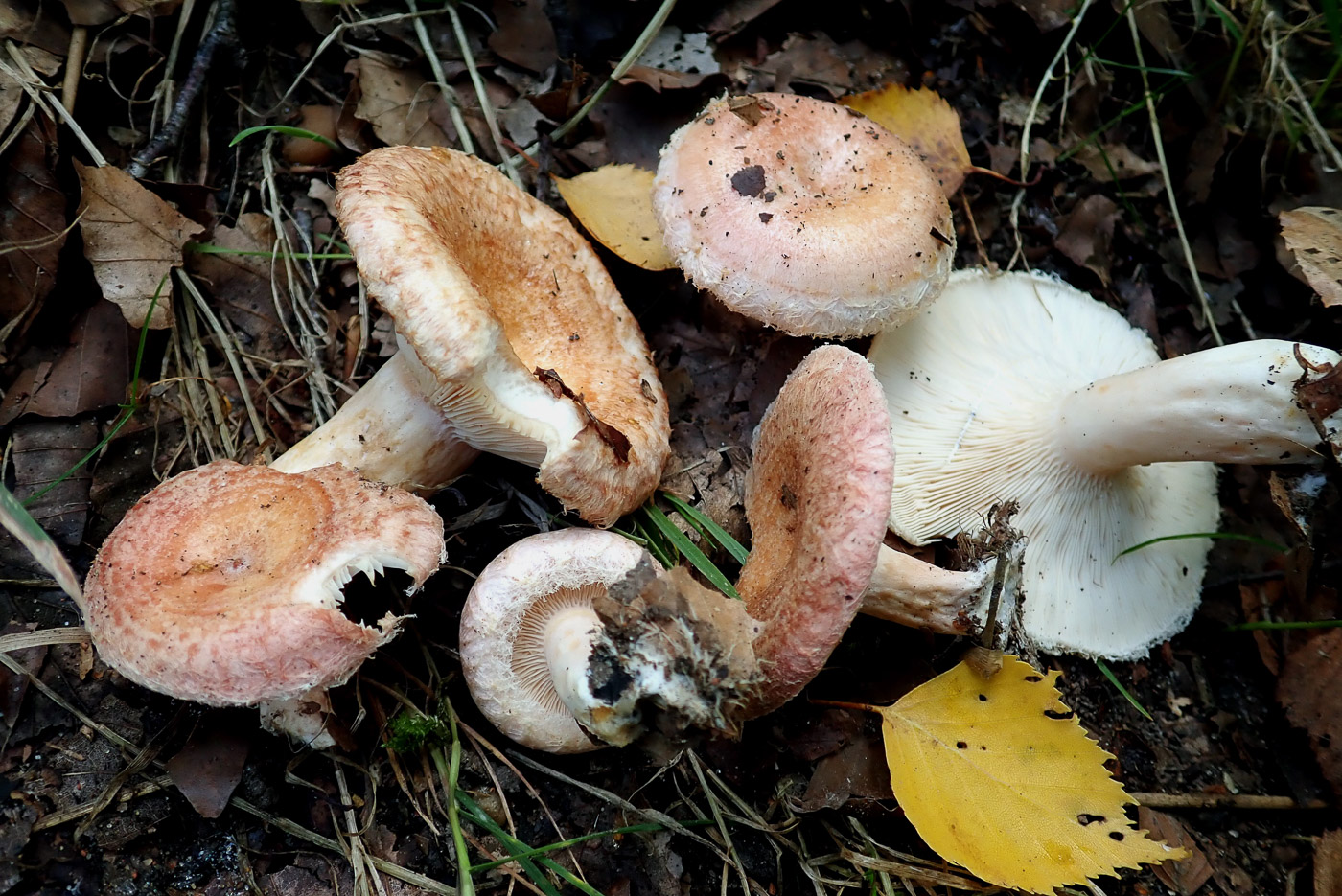
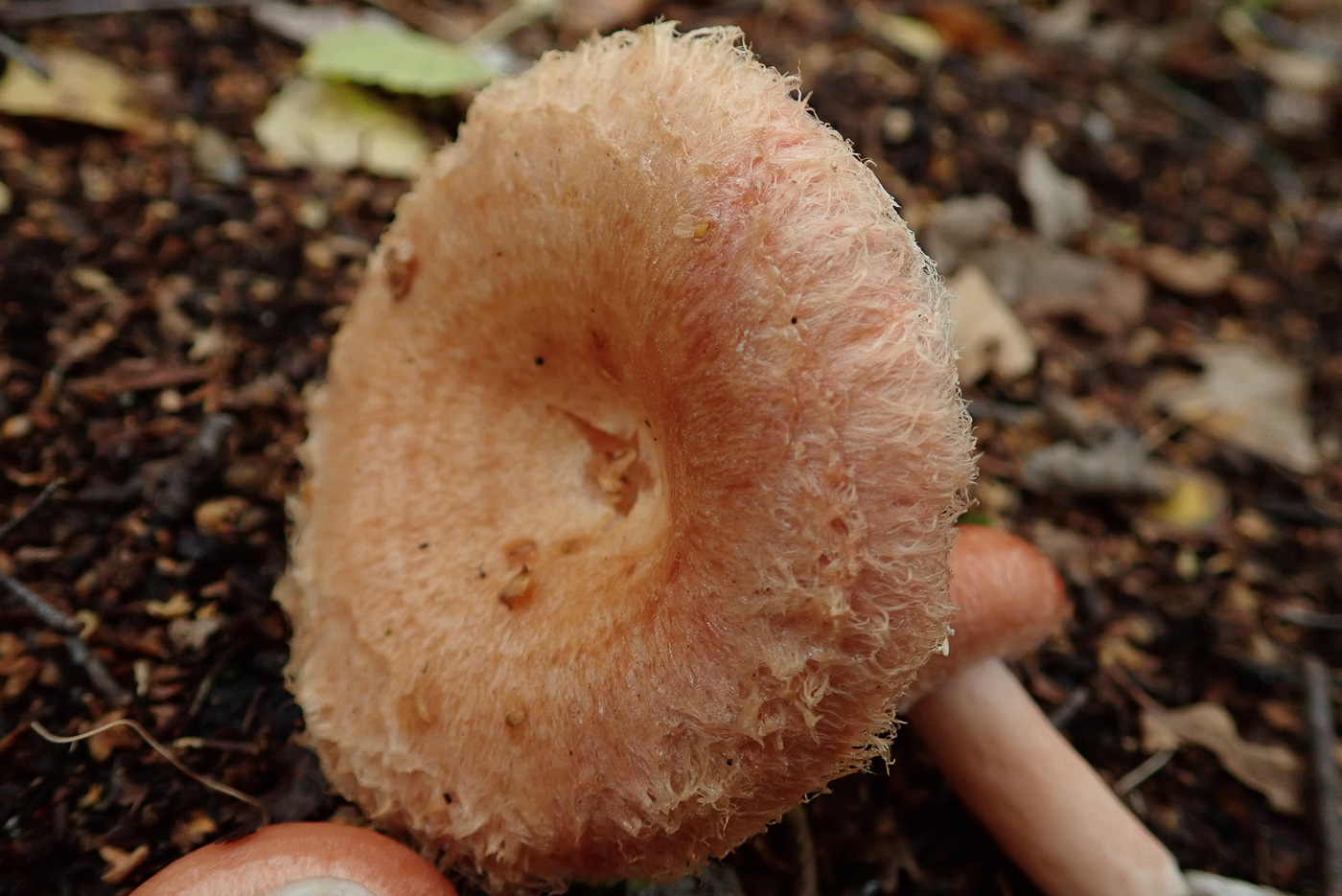 |
Lactarius torminosus (Woolly Milkcap)
Sep 18, 2020. Penny Cullington found this attractive species in Hodgemoor Wood under Birch with which it is host specific. Once you've realised this is a Milkcap (by damaging the gills and watching for the milk) this is an easy Milkcap to identify with several distinguishing features: Firstly the host tree, then the pink zoned cap with rather rough surface, then if a young specimen is available note the tightly inrolled and hairy cap margin when viewed from underneath. All these features are visible here except for the milk on the gills! This can happen when conditions are just too dry. There is a similar Milkcap with nearly all the same features (also host specific with Birch) to be aware of: L. pubescens. This, however, is very pale pink with less zoning apparent.
|
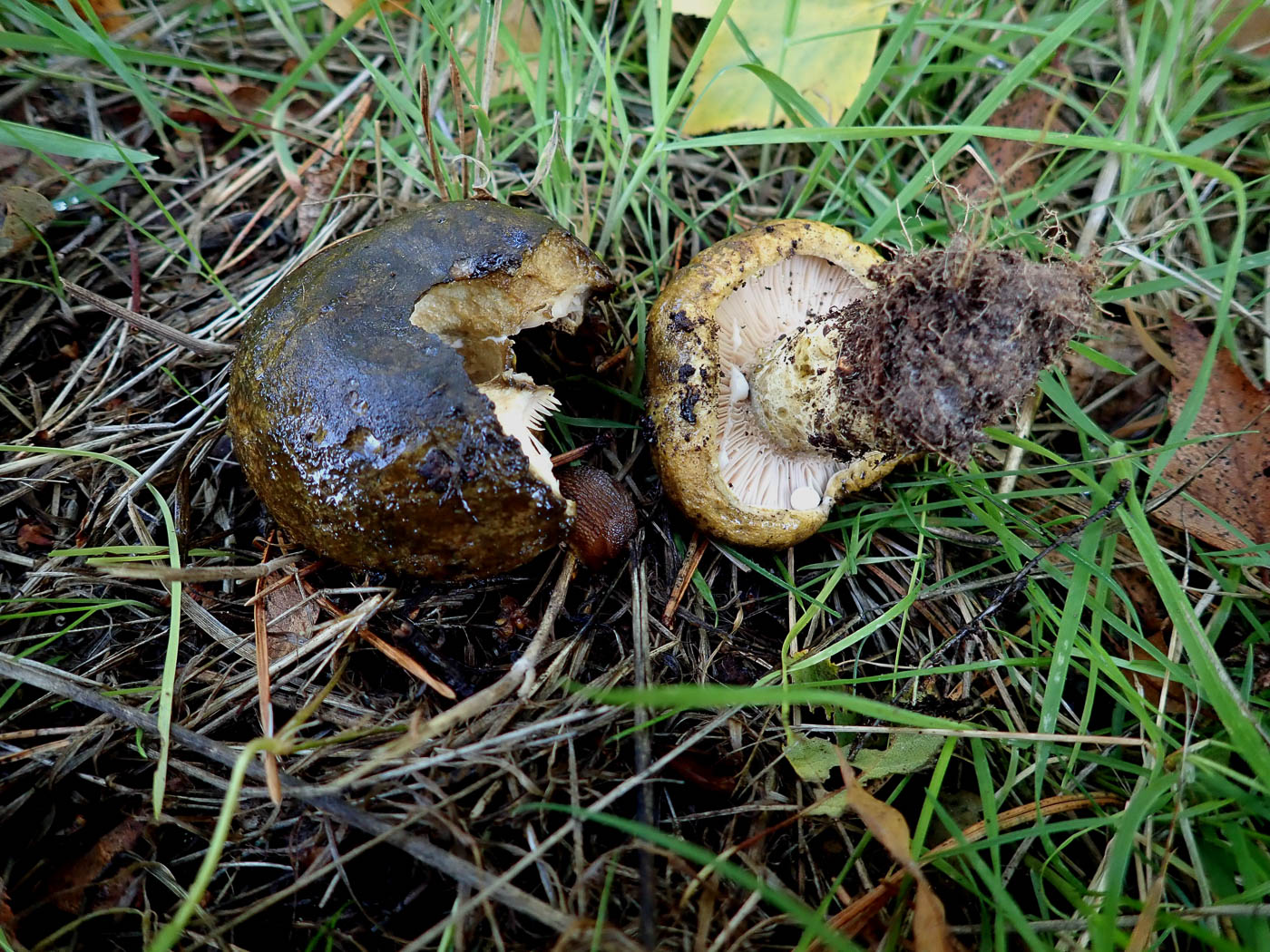
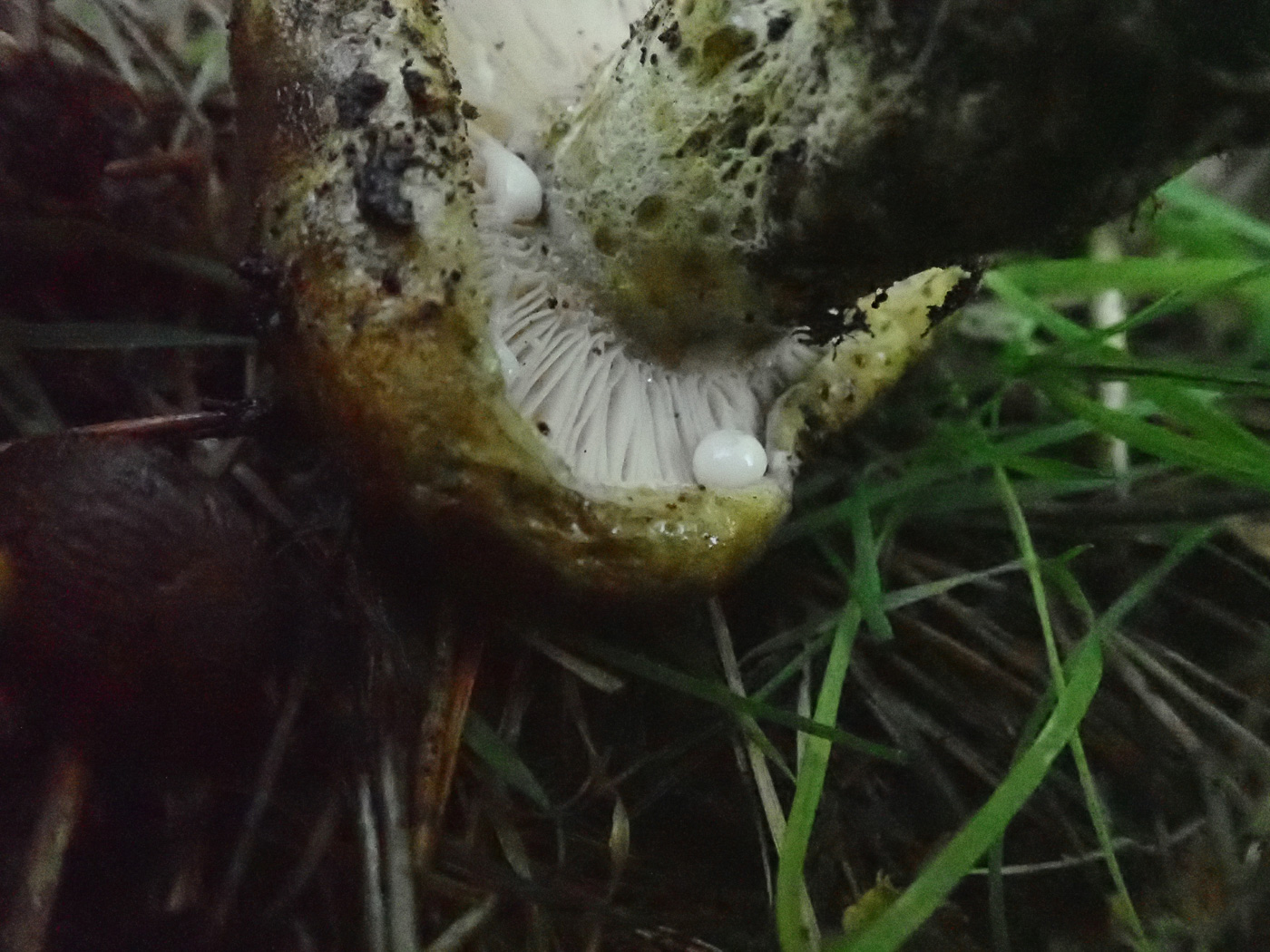
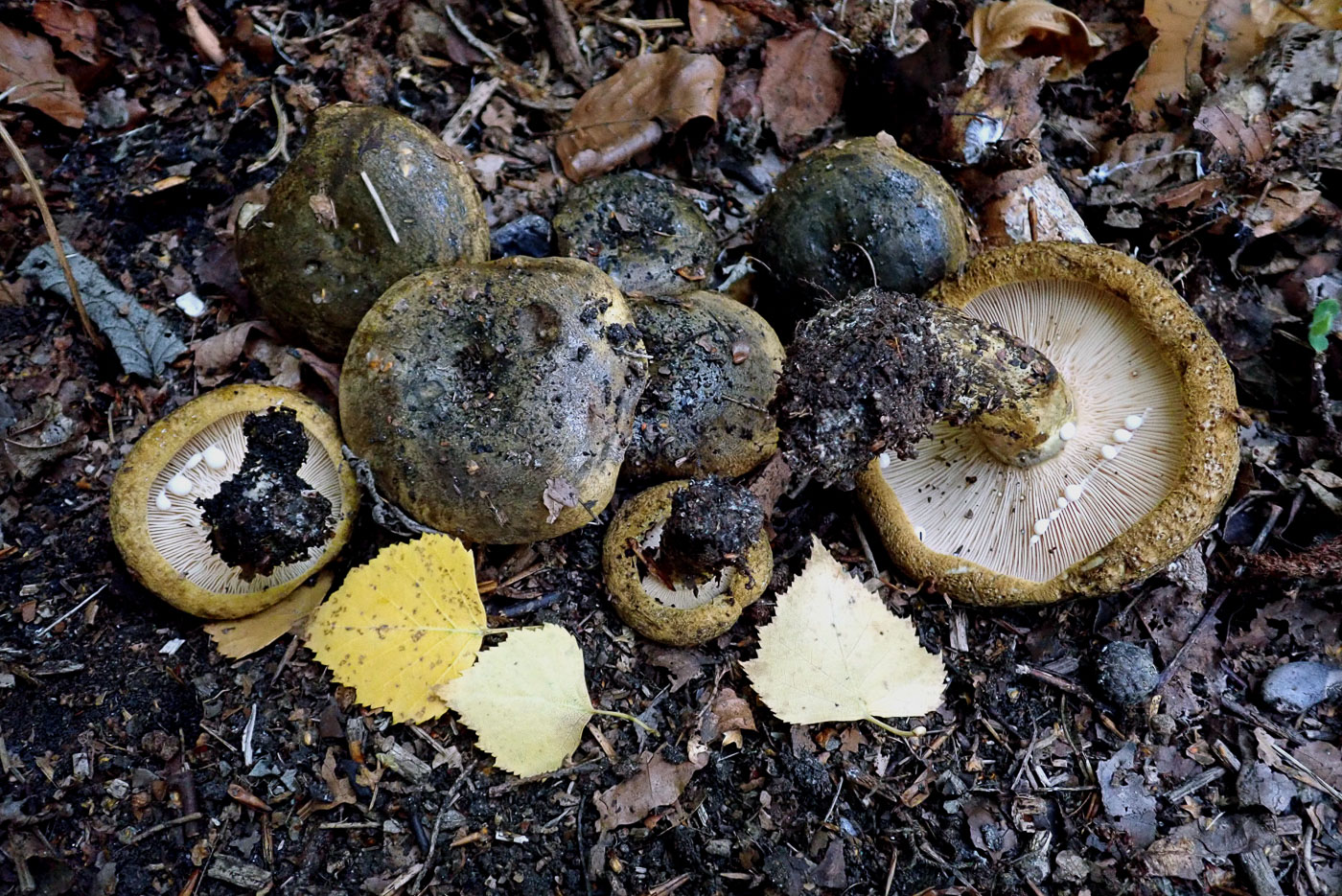
|
Lactarius turpis (Ugly Milkcap)
Oct 6, 2022. Under Birch at Turville Heath Penny found just two young examples of this species, in some years extremely common. The dark dirty greenish brown inrolled cap (when young as here) with very short stem are good characters, also the copious milk which drips from damaged gills. It is one of our largest milkcaps, getting to 10 cms across or more.
Sep 20, 2020. Penny Cullington found this collection growing under Birch (with which they are host specific) at Pullingshill Wood. The cap colouring and short stem of this common species tend to make it well camouflaged amongst the leaf litter and easily missed. Once a fruit body is turned over the strongly inrolled cap is reminiscent of young specimens of the Brown Rollrim (a completely unrelated species), but the gills are much paler and not decurrent as in that species. Damaging the gills quickly produces copious milk which literally drips from the cap - even today when conditions were extremely dry.
|



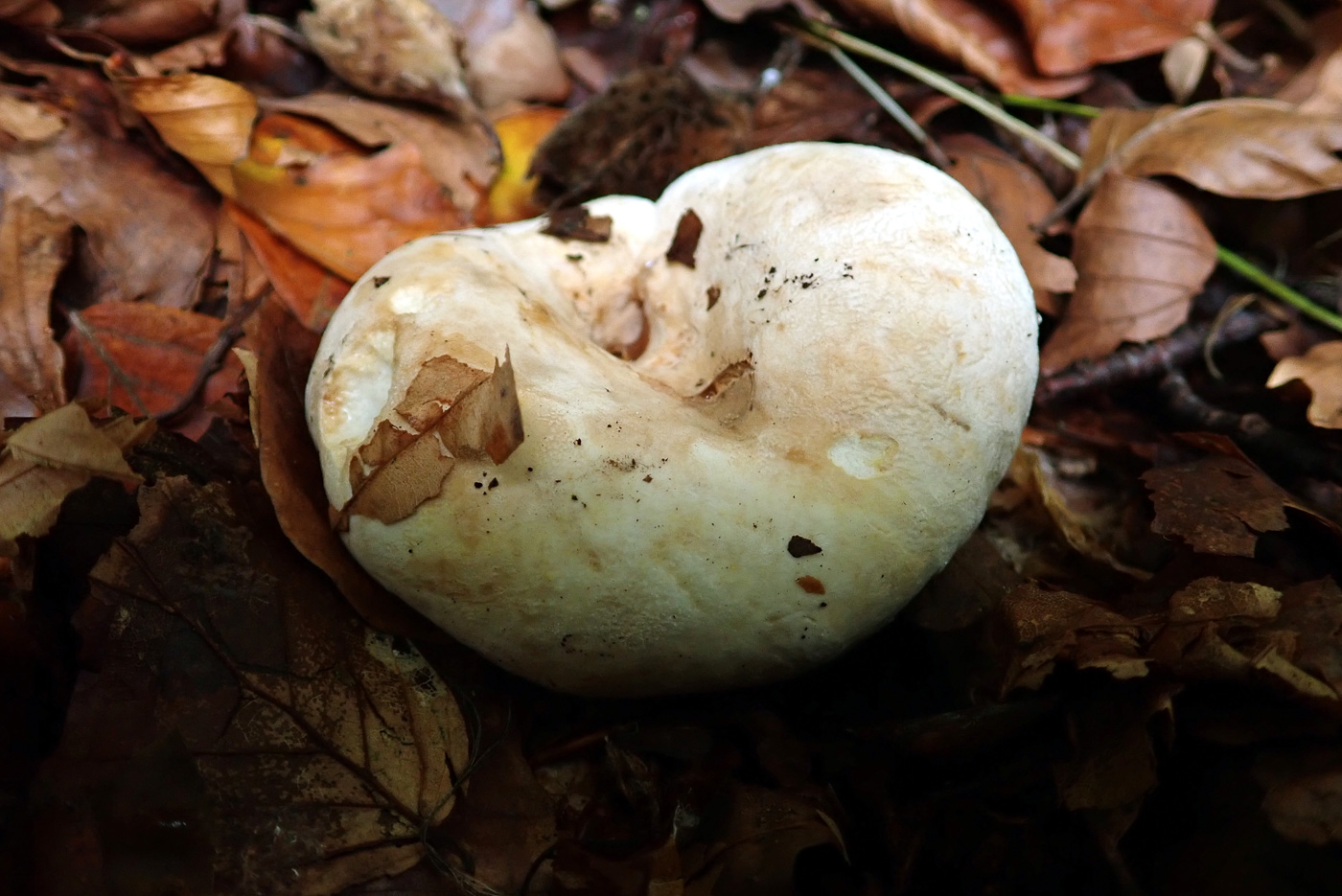
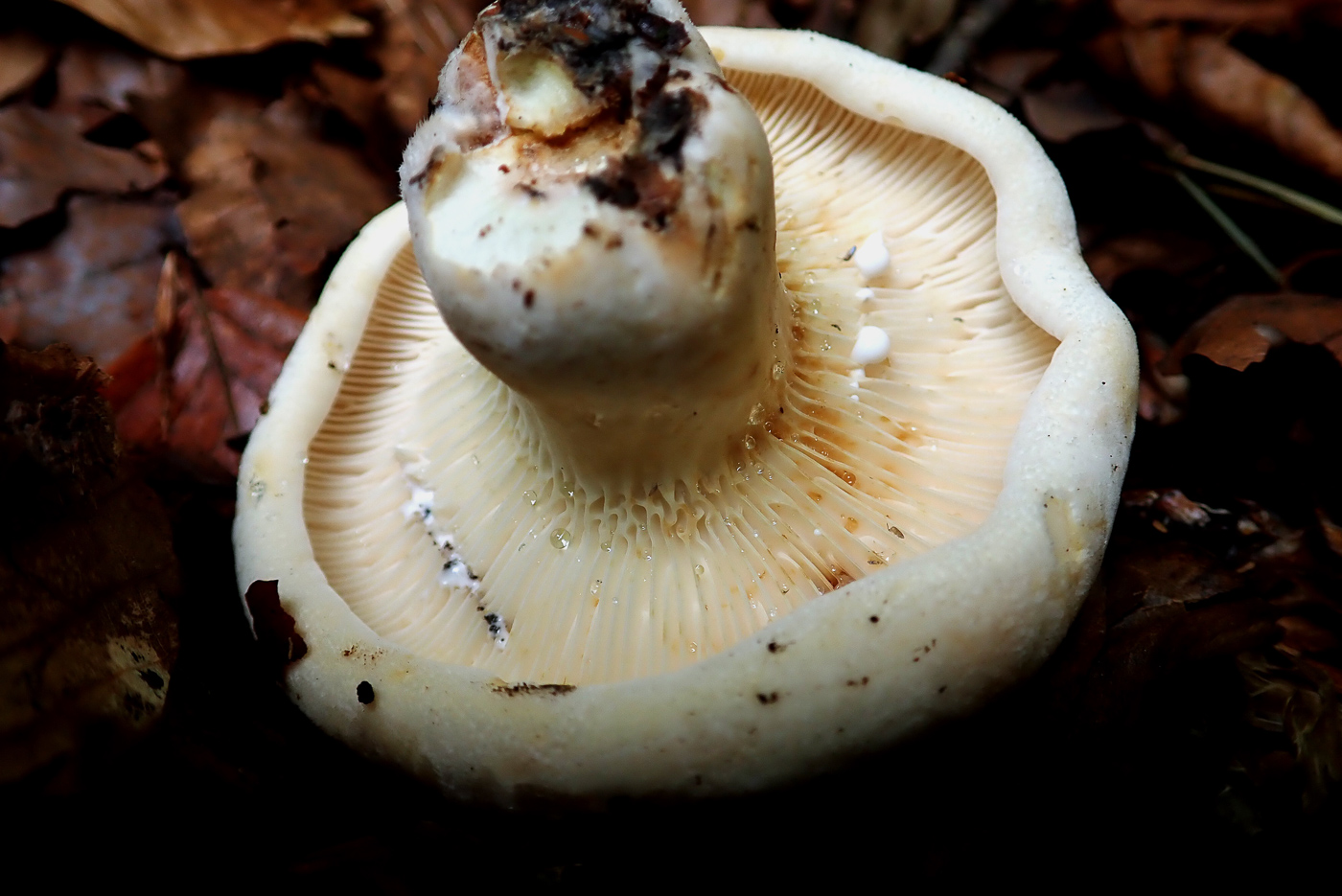
|
Lactifluus piperatus (Fishy Milkcap)
Aug 4, 2023. Under Beech in Hodgemoor Woods Penny first found these two immature but pure white and solid Milkcaps and tested for milk just to check that this was not one of the very similar Compactae Brittlegills (see the two entries below), then a few yards further on came across a much larger specimen about 10 cm across (photos 2 and 3). Previously in genus Lactarius, the species is by far the commonest of several very similar large Milkcaps with a clear link to the Compactae group of Brittlegills, but has the most crowded gills and also milk which is very hot to taste (hence its common name).
Oct 12, 2020. Only recently separated from the genus Lactarius, this species was found under Beech in Gussetts Wood by Penny Cullington. The five Lactifluus species are all very solid compared to most Milkcaps, in fact are very similar to the solid Brittlegills such as R. chloroides or R. delica. In fact you can't be sure in the field which genus you have till you damage the gills to test for milk. Today's species is the commonest of this group and has very crowded gills, a velvety cap surface and the milk is fiery hot to taste.
|

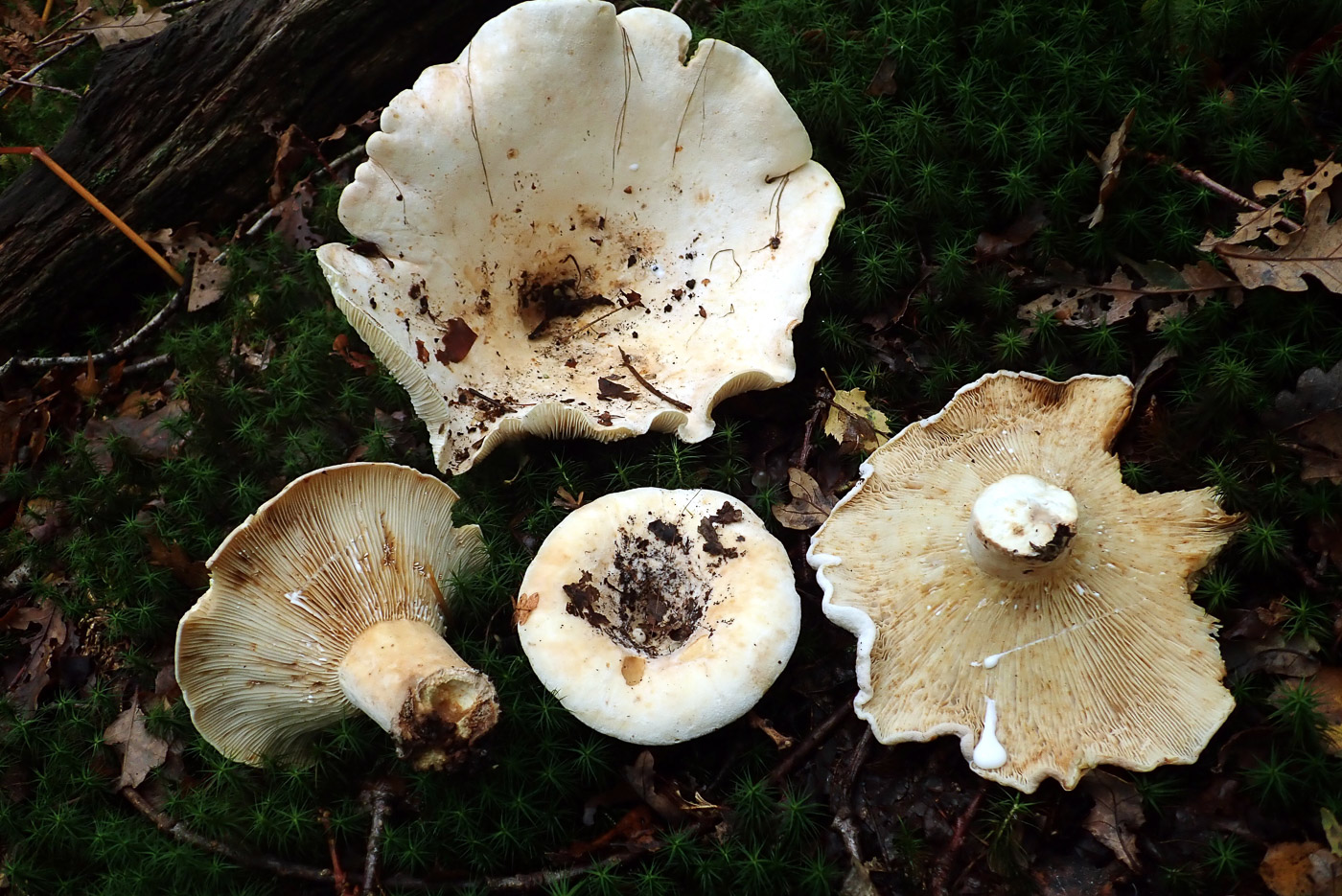
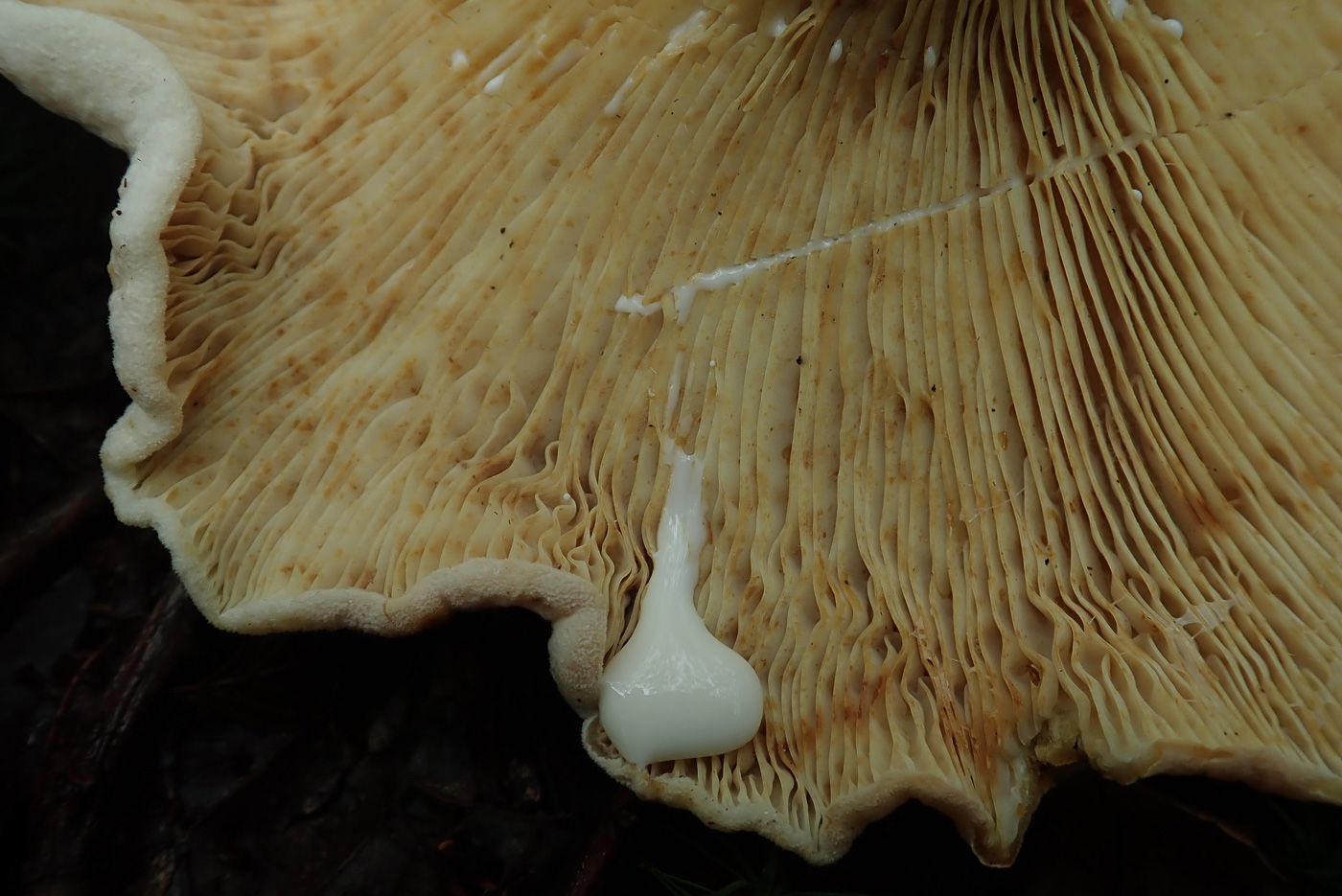
|
Lactifluus vellereus (Fleecy Milkcap)
Aug 21, 2023. Under Oak in Naphill Common Penny found a cluster of these chunky and solid funnel-shaped Milkcaps lurking under vegetation, the largest being a good handspan across. Until one was upturned she couldn't tell whether it was one of the two lookalike Brittlegills (R. delica or R. chloroides) or one of several possible Milkcaps now moved to this separate genus - all are very similar in stature, cap colour and shape. The instant abundant milk left no doubt which genus she had but work at home was needed for an ID. The commonest of this group is L. piperatus which has extremely crowded whitish gills but quite sparse milk which is burning hot to taste, hence its common name. The gills of L. vellereus are more cream, are less crowded, and its milk is abundant and mild to taste. To split this species from the very similar but rarer L. bertillonii, place a drop of the milk on a slide (away from the flesh) and add a drop of KOH: no colour change with today's species but quickly orange in the rarer species.
Oct 22, 2020. Paul C. found these enormous fruitbodies under Birch, Oak and Beech in Hodgemoor Woods. The smallest (central) cap - brought home to work on - was 10 cms across so the largest (top) cap must have been around 20 cms! This species is one of four, split now from the genus Lactarius, which are very similar and difficult to separate in the field with certainty. (See also Lf. piperatus dated Oct 12.) Today's species had copious milk (seen forming a puddle on the cap in photo 2) which was mild to taste, in contrast to the milk of Lf. piperatus which is extremely hot!
|


 |
Lactifluus volemus (Fishy Milkcap)
Aug 4, 2023. Under Oak in Hodgemoor Woods Penny's eye was caught by this bright tawny cap and noticing the sturdy stem she hoped she'd found this quite unusual Milkcap - one for which we have just three previous records, two of these from this site. Previously in genus Lactarius, the species has two unique features which clearly demonstrate the close link between Milkcaps and Brittlegills: like members of the 'xerampelina' Brittlegills (see Russula graveolens two entries below) the stem turns instantly deep green when rubbed by an FE crystal, furthermore it develops the same smell of cooked crab (hence its common name). This is a new entry for Finds.
|


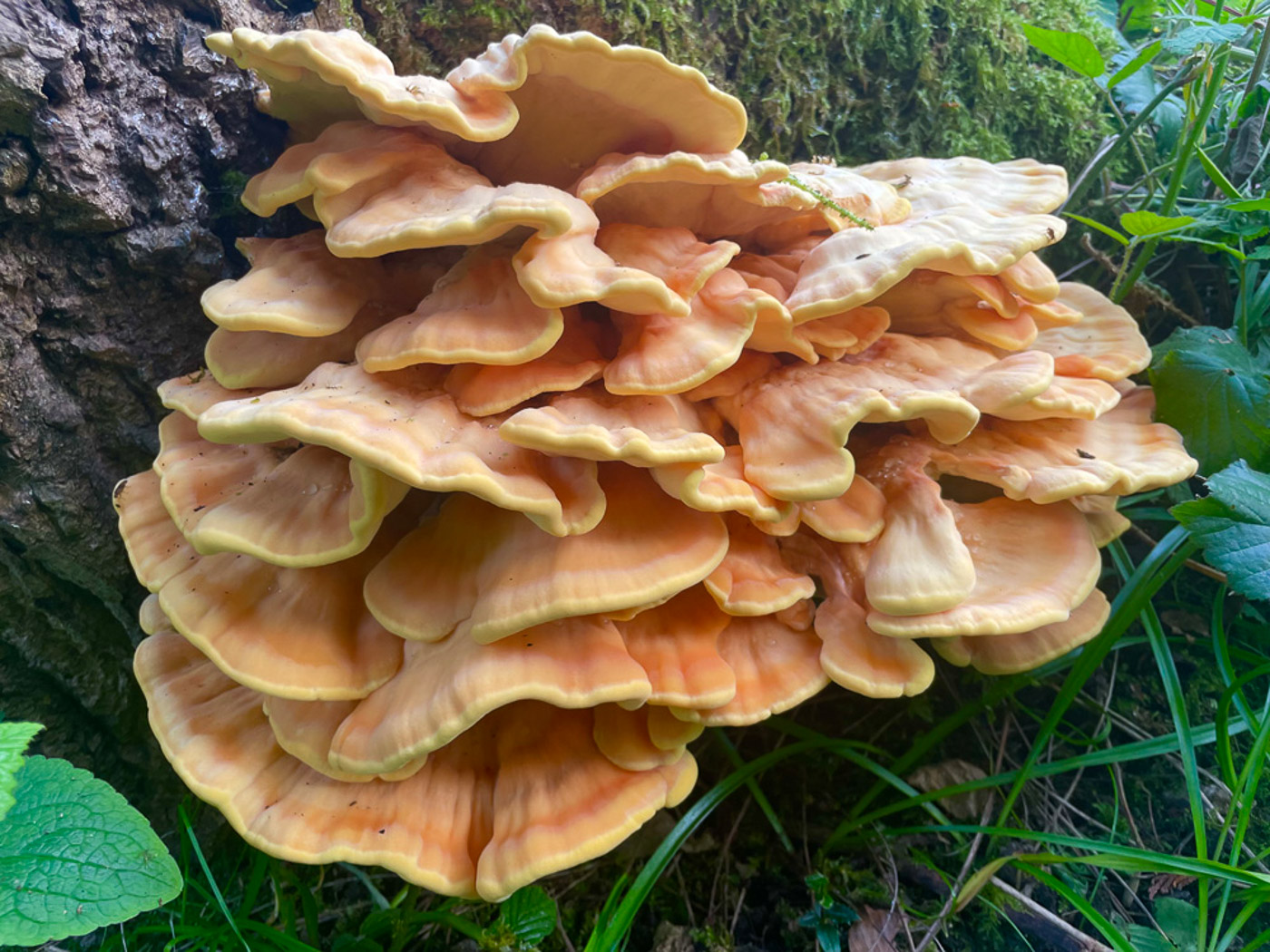
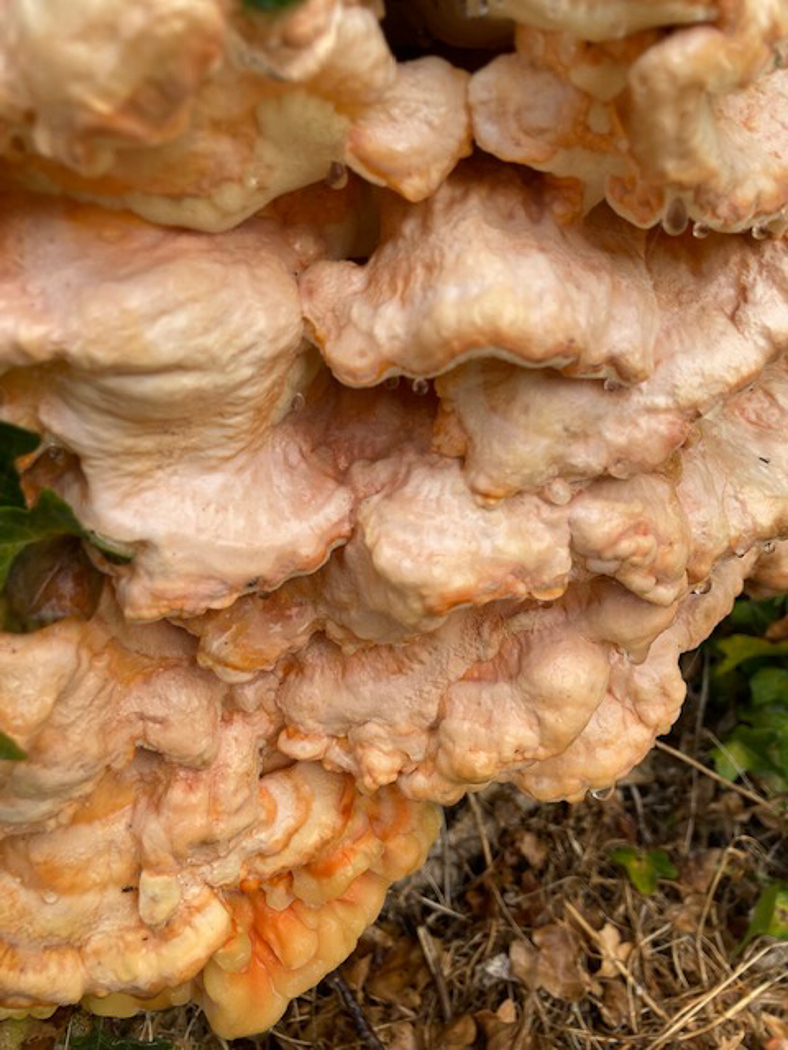
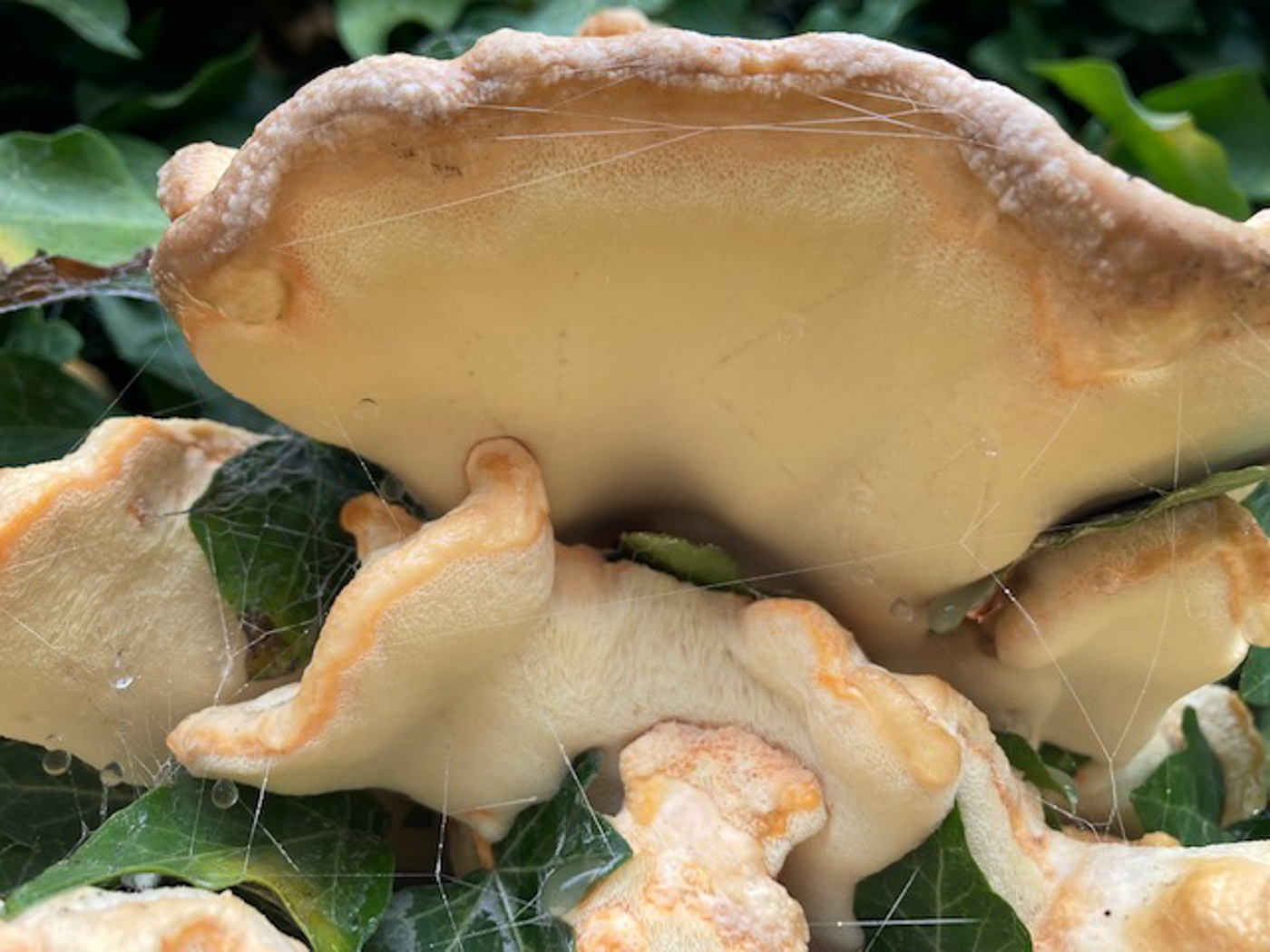
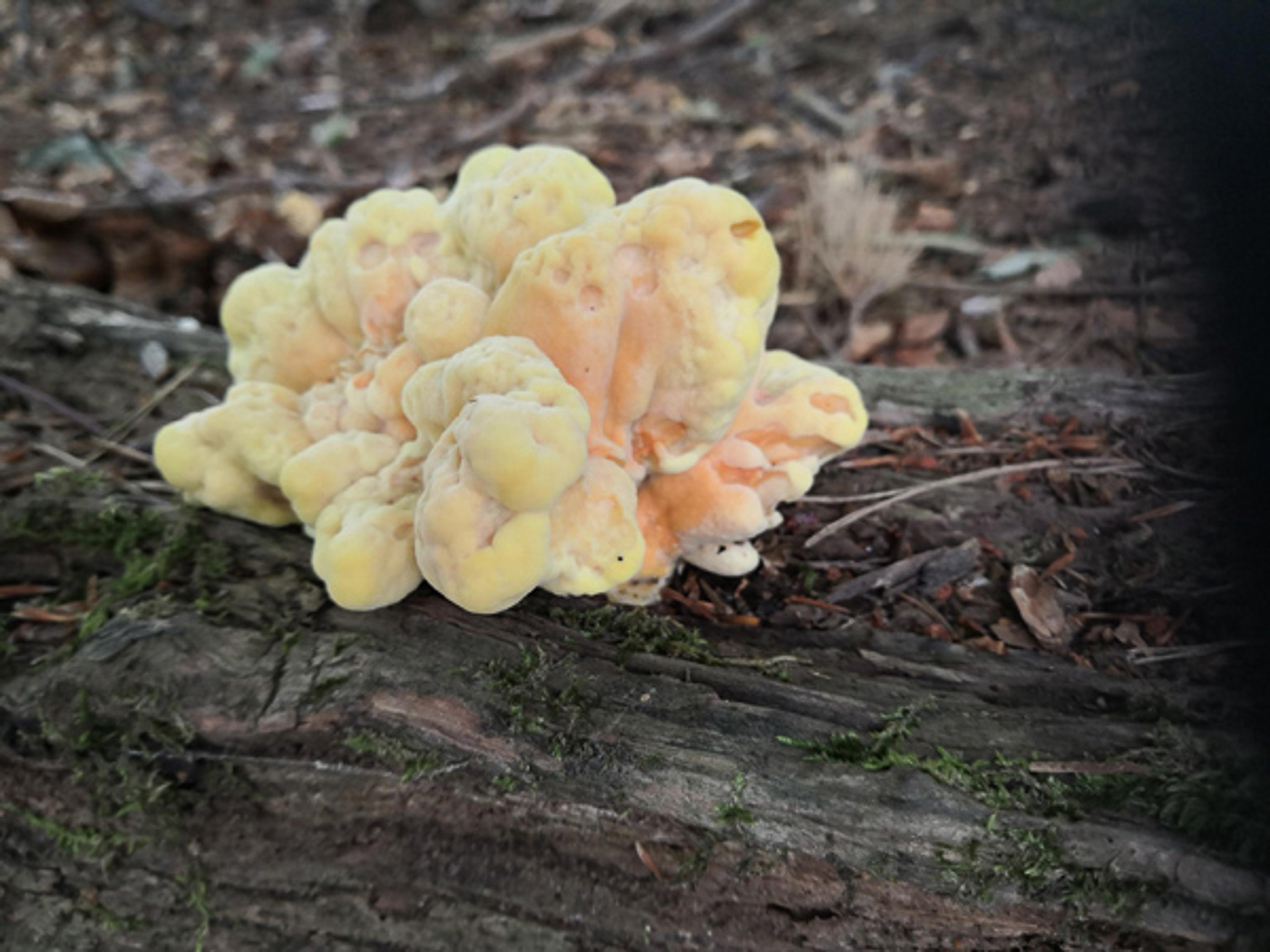
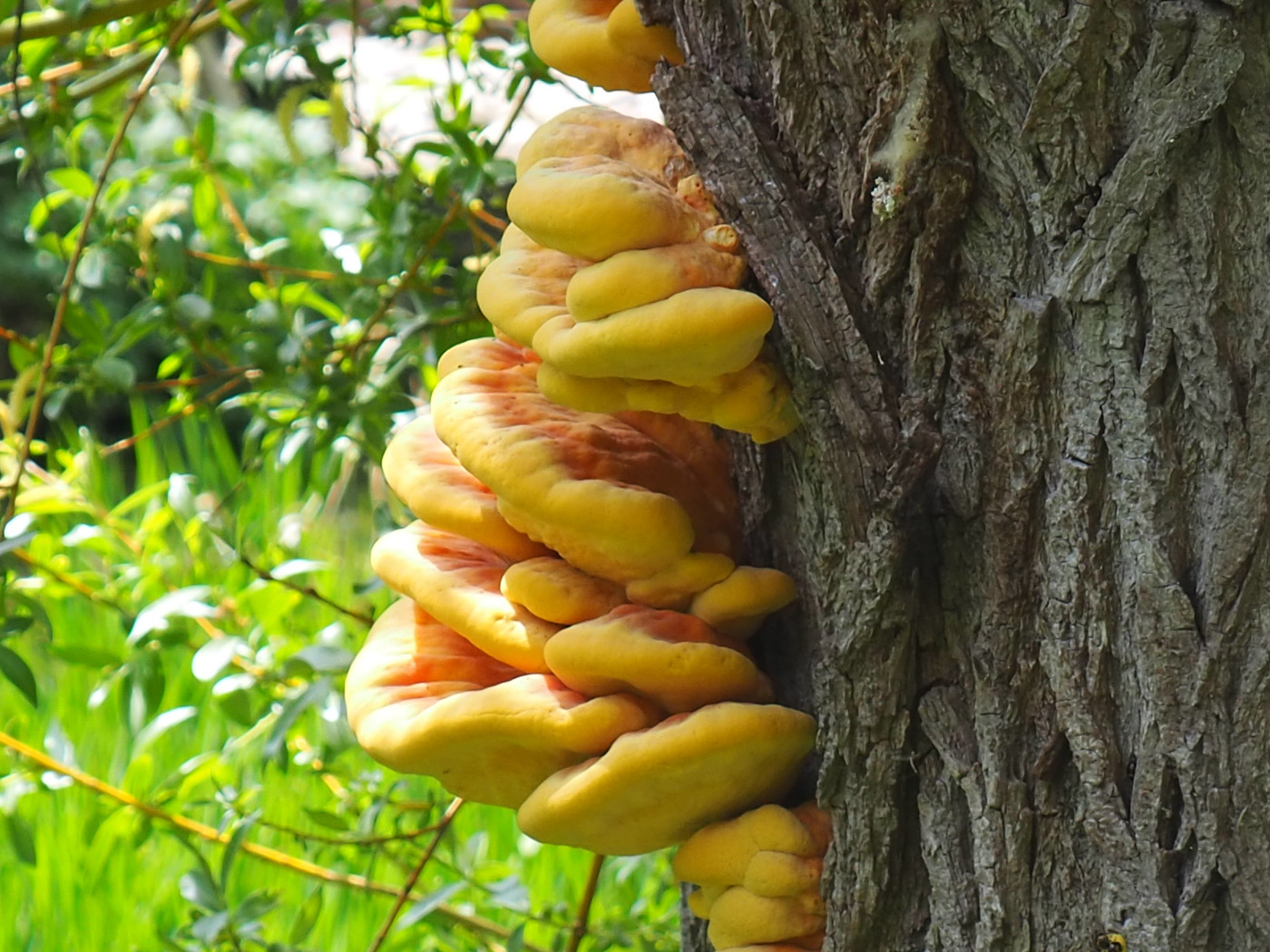
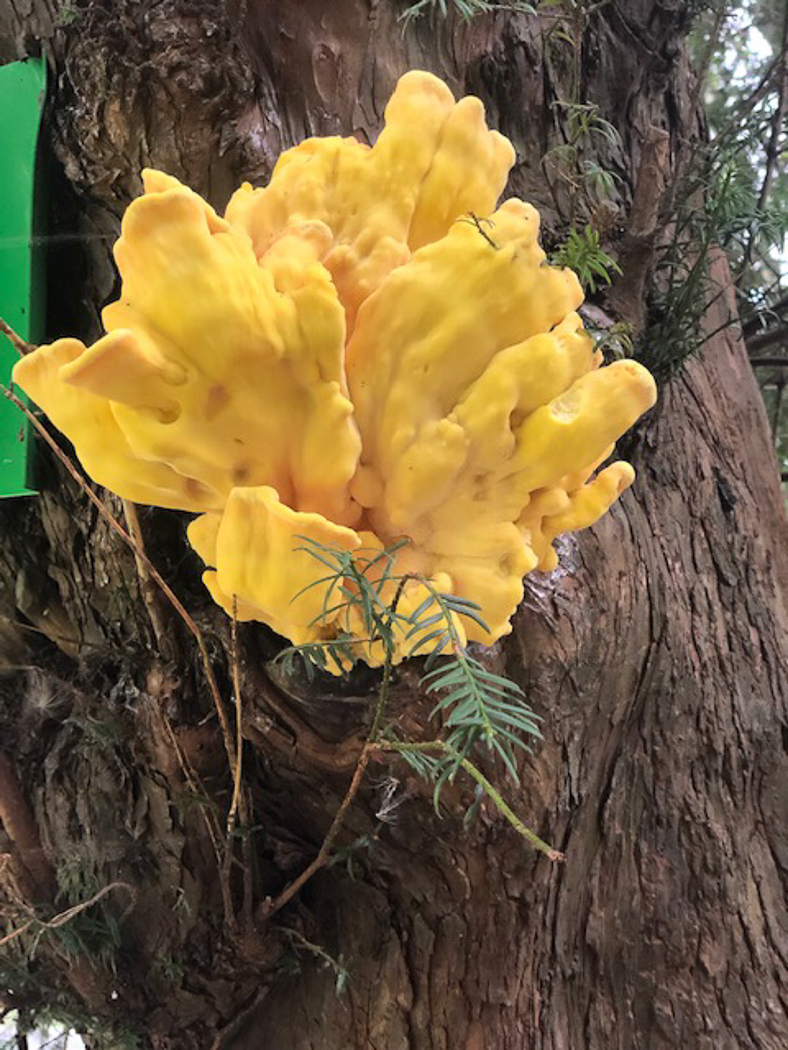
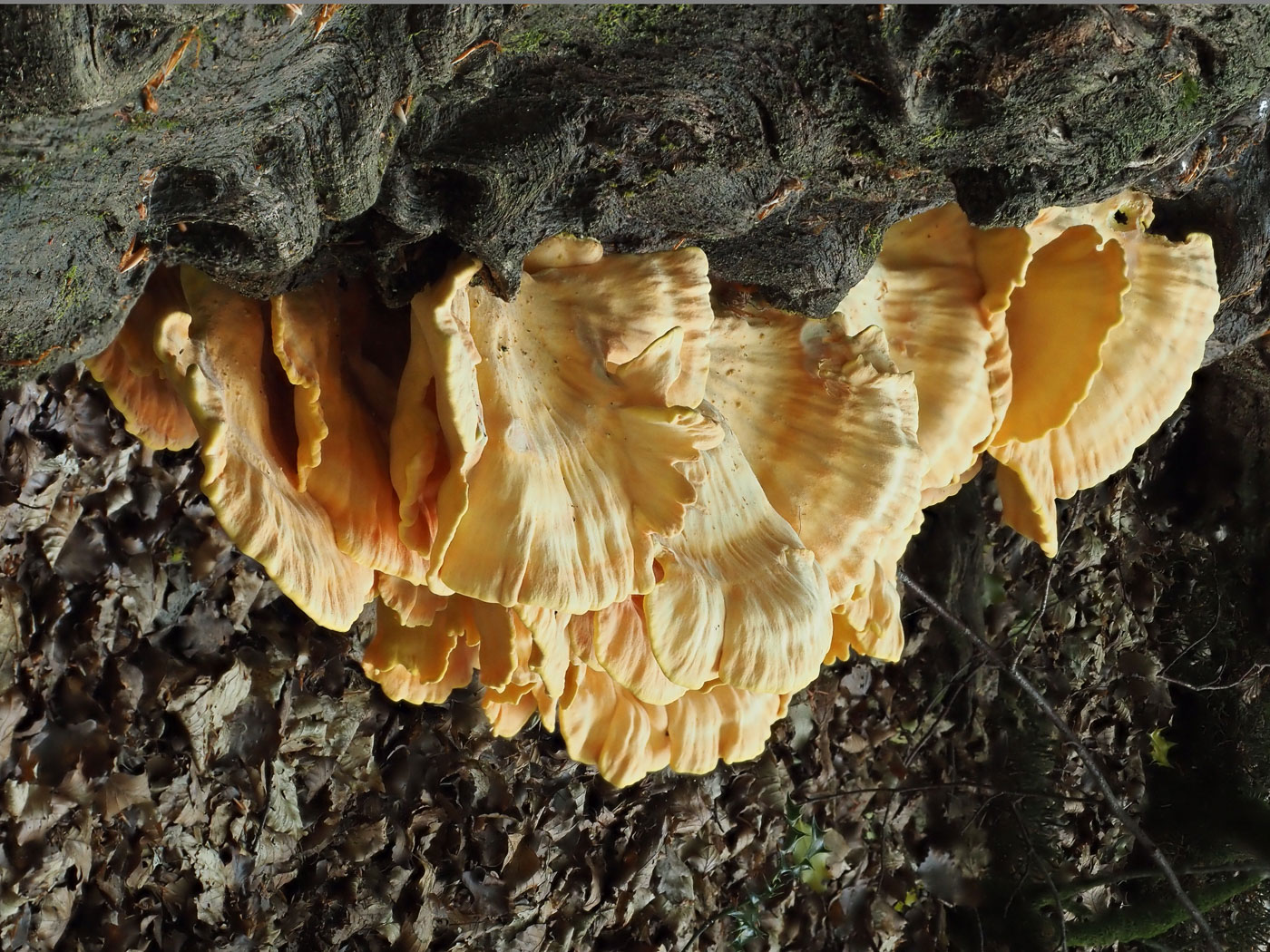
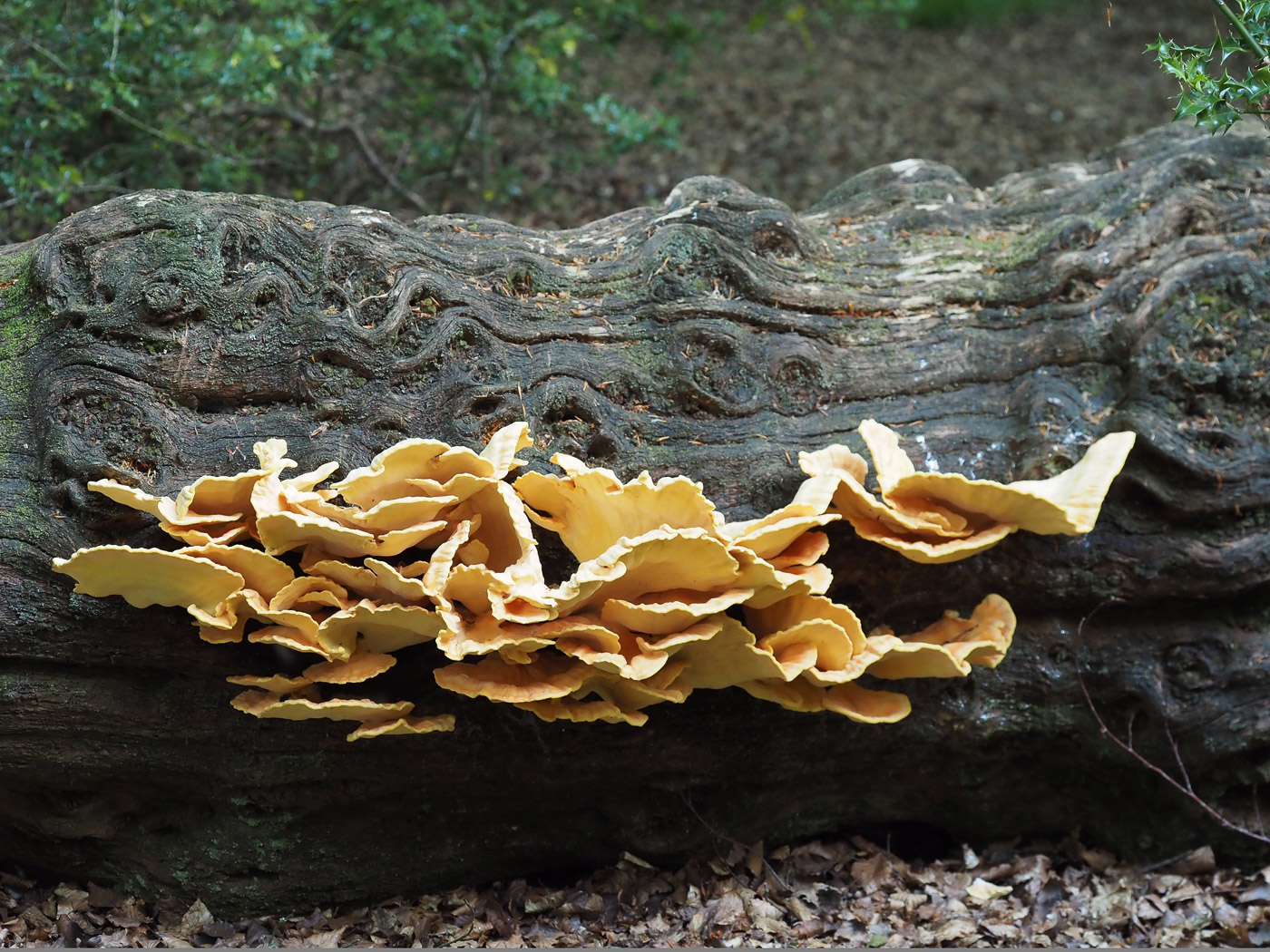
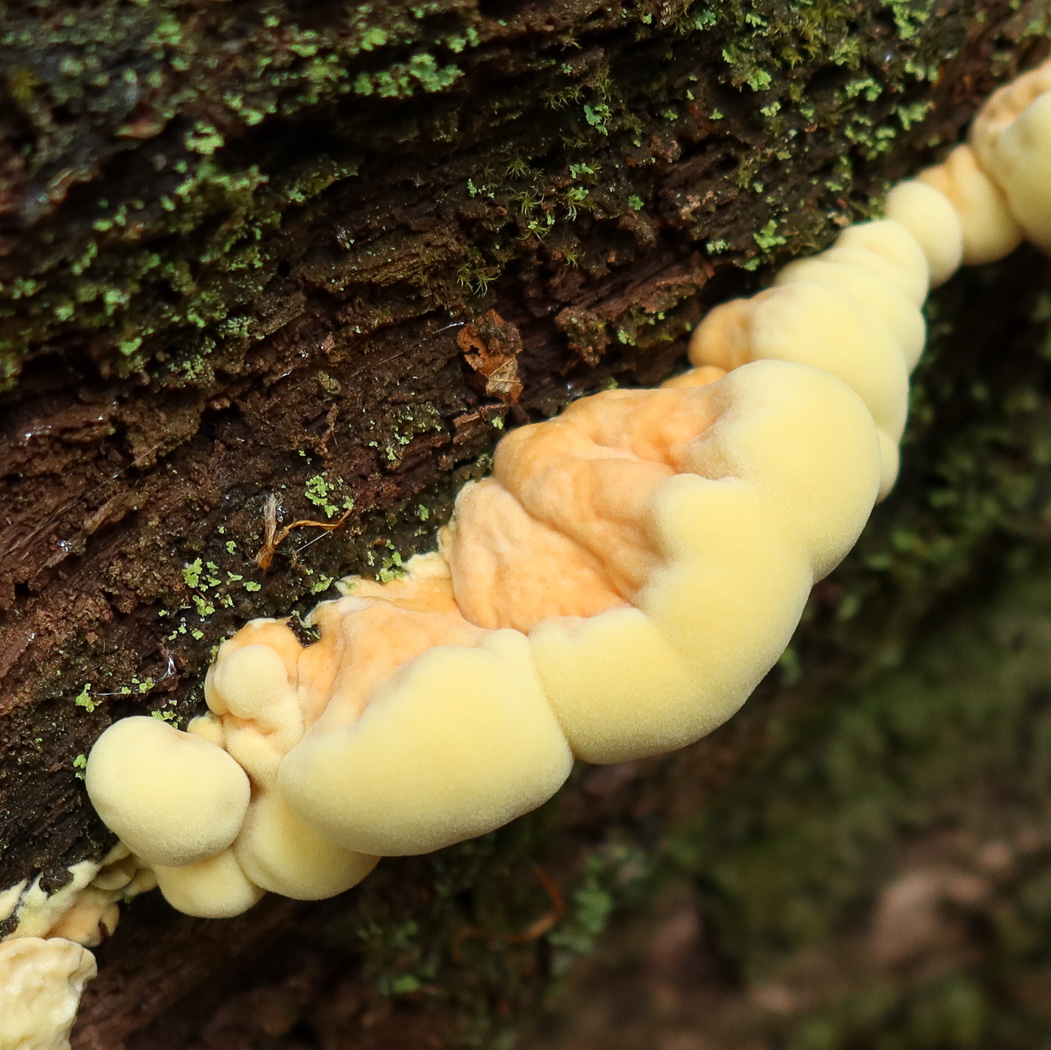
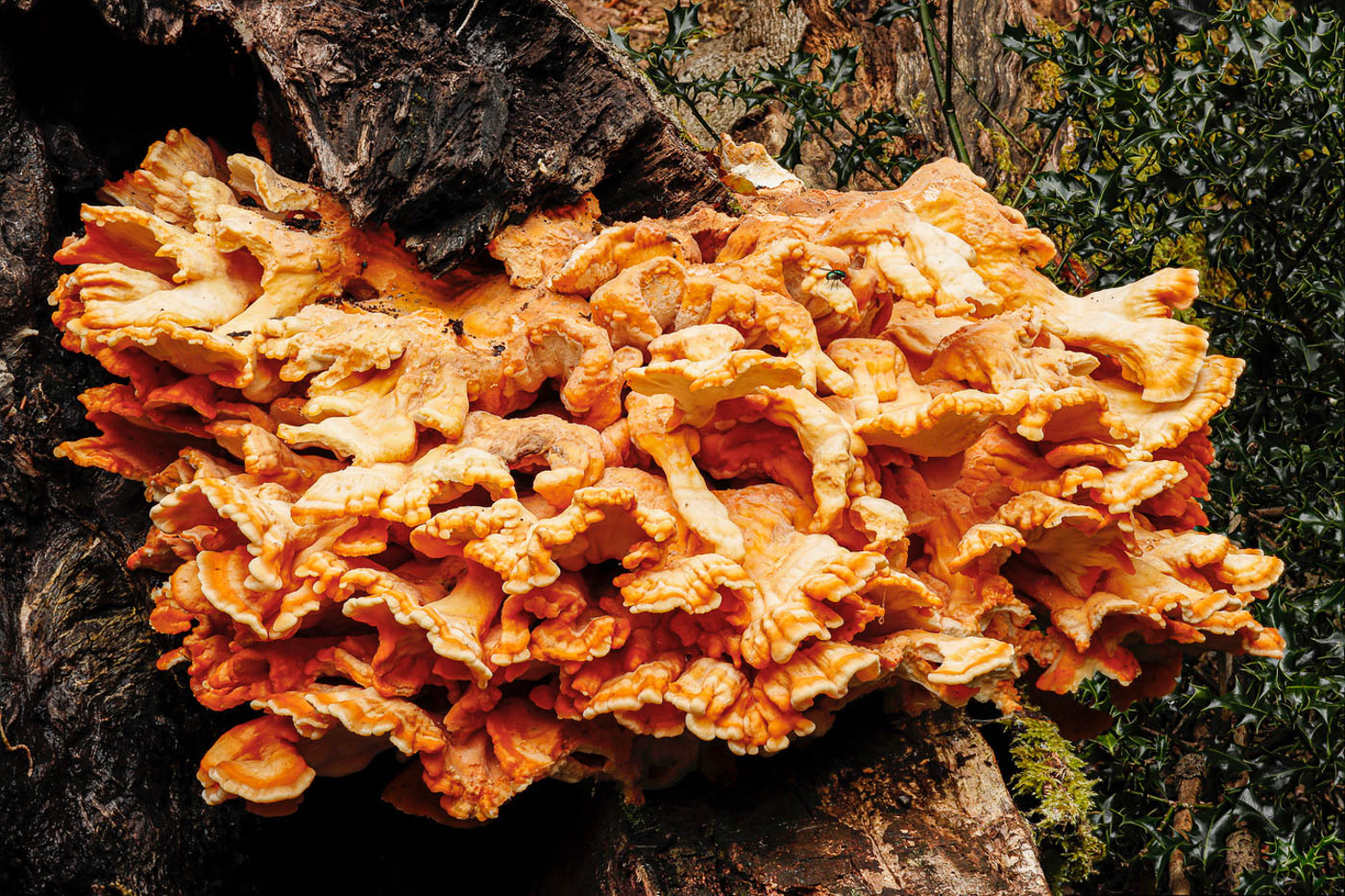
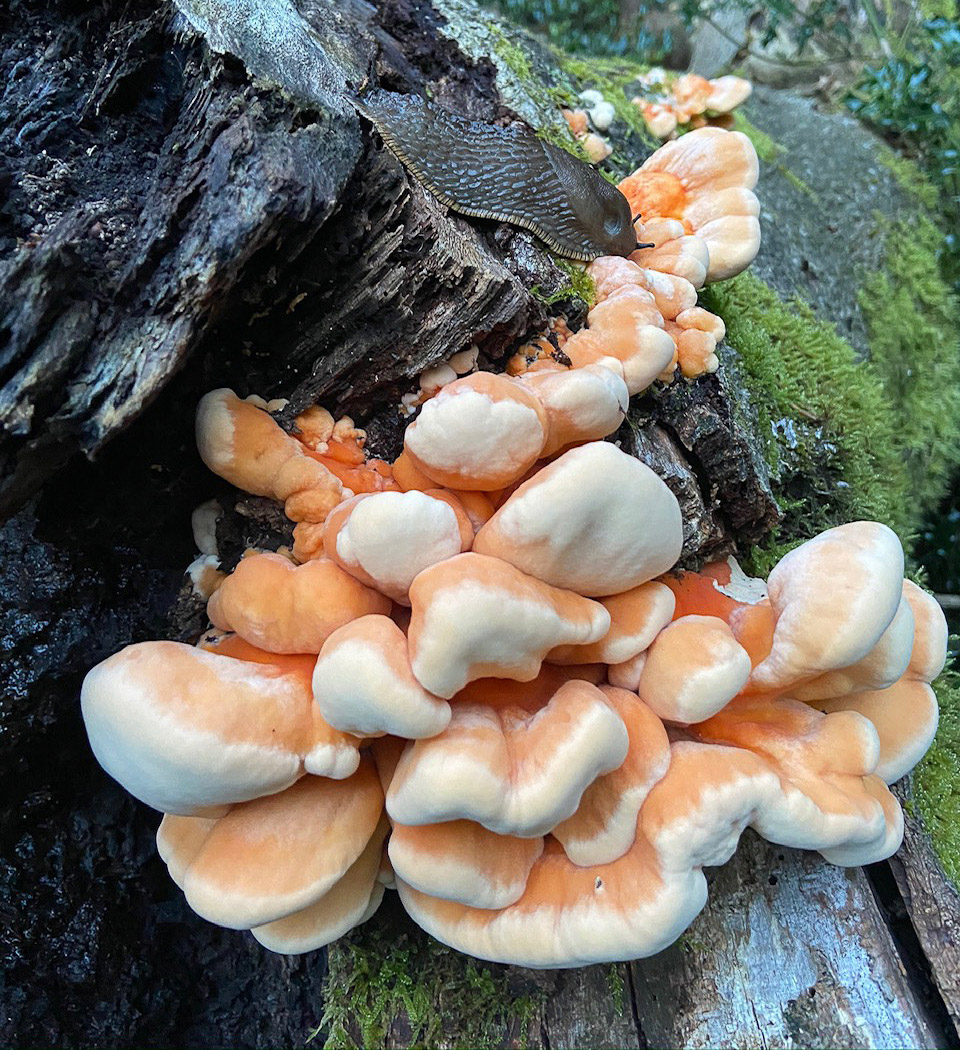 |
Laetiporus sulphureus (Chicken of the Woods)
May 2, 2024. On our Burnham Beeches walk several week earlier this bracket was spotted on a bare standing dead Beech but in its very early stages (see Penny's report for April 17th for Claire's photo). What an amazing change in appearance in just a few weeks! Sarah Ebdon's photo here shows the same specimen in all its glory with the typical tiers showing sulphur yellow pores underneath and orange tints above. Photo 2 shows another small bracket just forming elsewhere on the same trunk. This has to be one of our most stunning and distinctive bracket species, is often around in early summer and can be found on a variety of different trees including Cherry and Yew. Photo 3 is also Sarah's of a similarly impressive showing but found a week later in Priestfield Arboretum on White Walnut / Butternut which seems to be an extremely unusual host tree for the species.
Aug 16, 2022. On an Ivy covered deciduous log on Stanley Hill, Amersham, Paul Allen noticed this large bracket managing to fruit despite the drought - another example of fungi on wood doing better than those on soil etc in such conditions. The distinctive yellow of this tiered bracket makes it an easy one to recognise.
Jul 21, 2022. In Burnham Beeches Gill Ferguson noticed this pristine immature cluster on a fallen deciduous log. This bracket often fruits in early summer so it's no surprise to be finding it now, in fact previous entries in May and June.
May 6, 2022. On a living Willow adjacent to the river Wye in High Wycombe John and Leslie Catterson spotted this beautiful specimen pretty well in perfect condition - a sight for sore eyes when fungi is in short supply owing to the recent dry spell. However, dry conditions are much less likely to affect fungi growing on wood rather than in soil as is the case here. This common species often starts appearing in early summer, so is one to look out for now. It can be found on a range of different hosts, even Yew.
Sep 6, 2021. In St Laurence Churchyard, West Wycombe, Paul Goby noticed this fresh pristine bracket growing at eye level on Yew. A beautiful species when young as here, it tends to fruit in summer forming large tiers on many deciduous trees, most often Oak or Cherry, less often Yew as here. Considered by some good to eat when young, it should never be collected for the pot when found on Yew!
Jun 15, 2021. Nine days ago (see photo from June 6th) Claire Williams found this quite common bracket just emerging on a log in Naphill Common. Today's photos are of the same specimen now measuring a meter across! She noted the typical tiers now seem quite thin and wondered if this was caused by the dry warm conditions. I suspect, however, it could be more to do with the fact that the tissue is thinning out as a result of it expanding to such a size. What a magnificent sight!
Jun 6, 2021. In Naphill Common on the same log that she found this species last year, Claire Williams noticed this beautiful fresh growth just making an appearance. This is quite a common species worth looking out for now and often fruits in early summer on a range of different standing woods if conditions are suitable. The log here was not identified, but it favours Cherry, Oak, Pear, Poplar (though apparently not Beech) and can also be found on Yew and occasionally Larch.
Sep 8, 2020. Paul Goby found this striking specimen growing on a massive Beech log in Naphill Common. This is a common species of bracket often fruiting in summer or early autumn. It can be found on many different deciduous trees, especially Cherry and Oak, and also is quite often on Yew. The second photo is of the same specimen taken by Sarah Ebdon on August 24th when just developing and clearly very tasty!
|

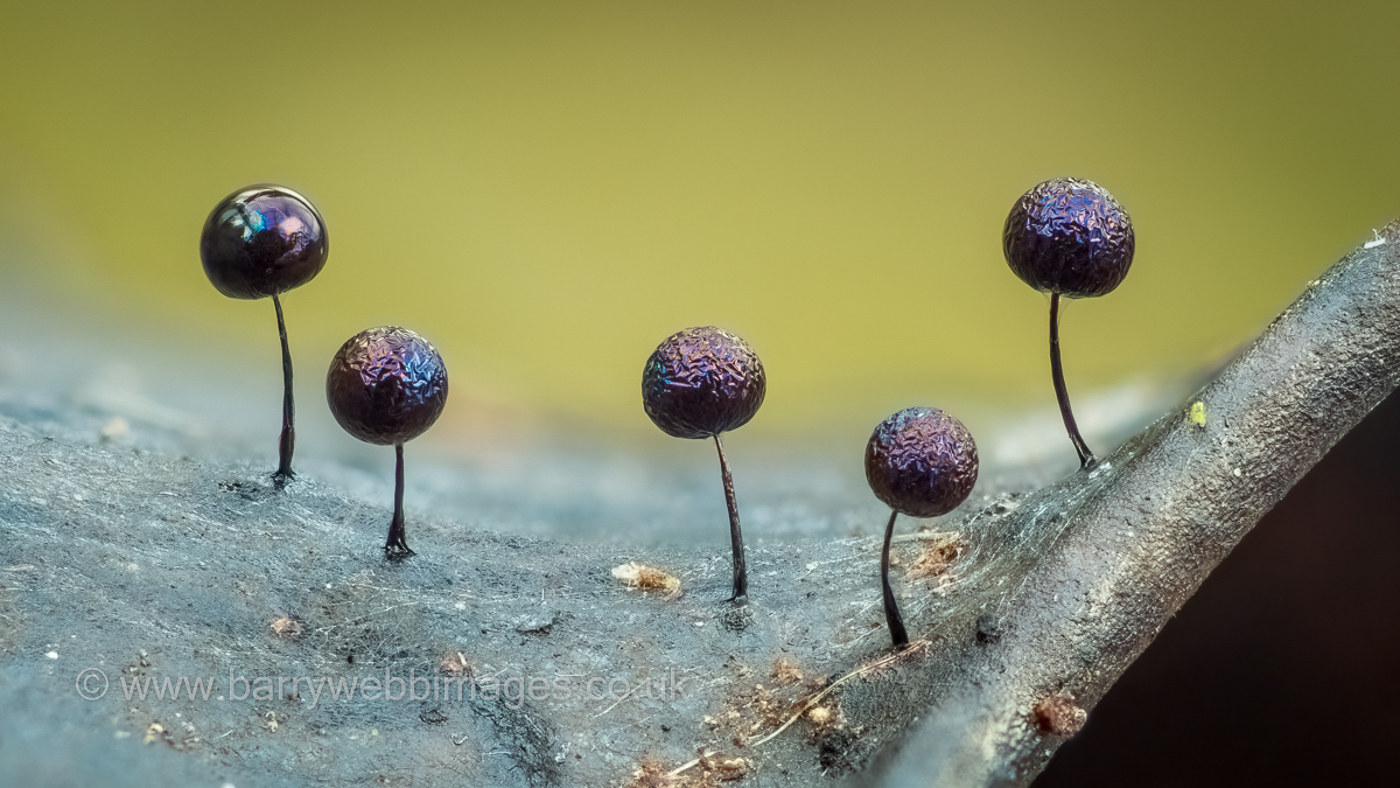
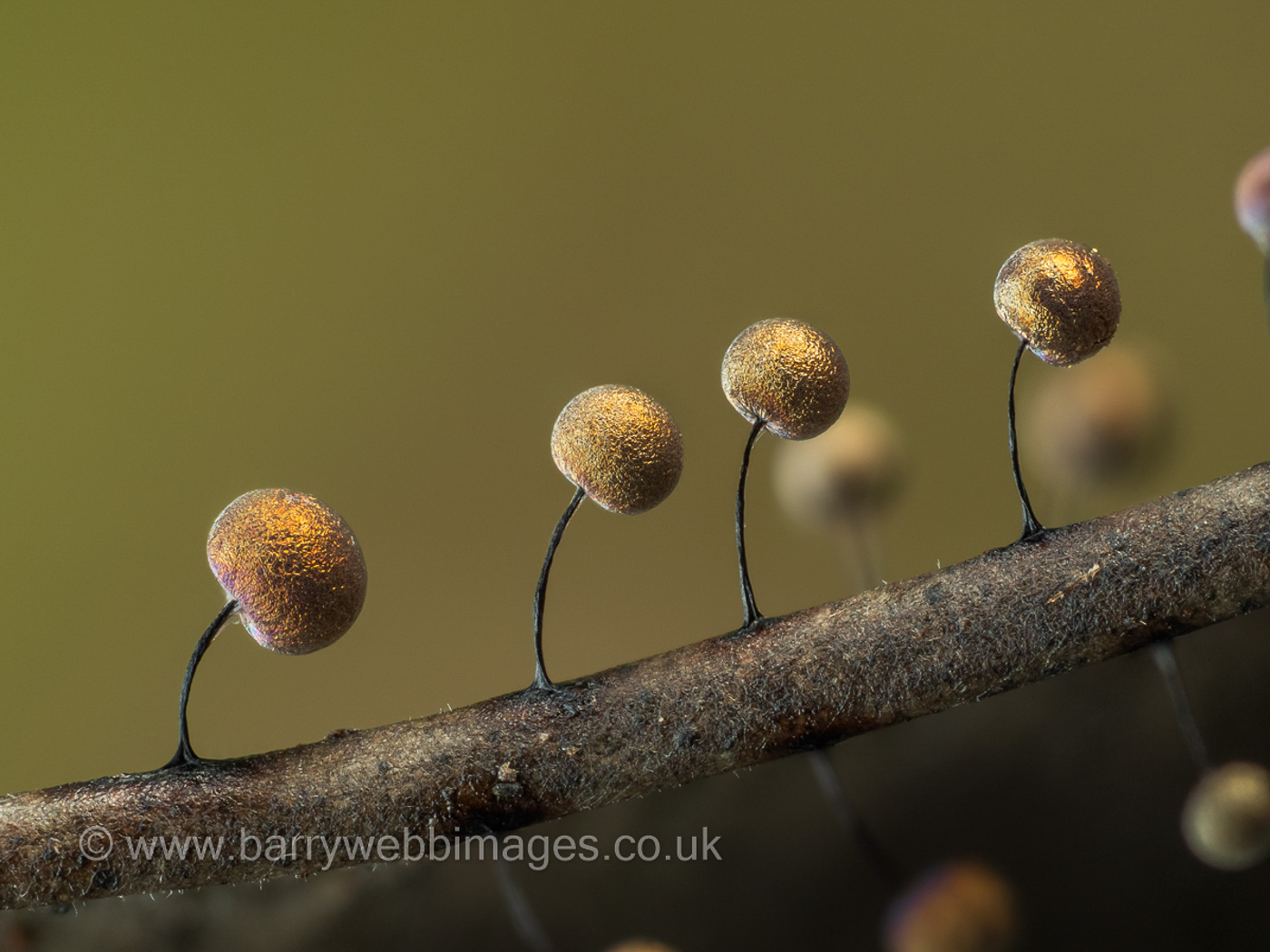
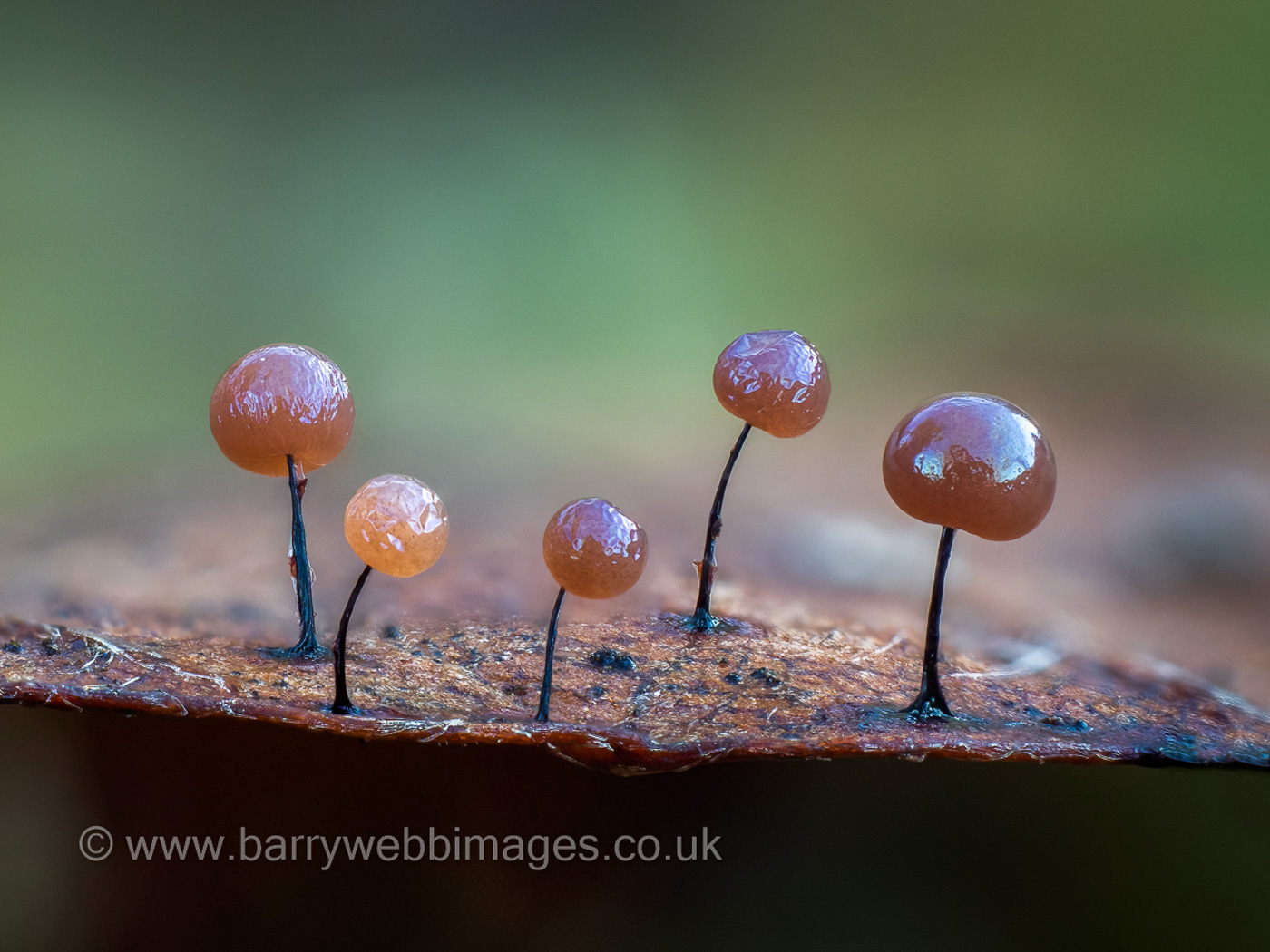
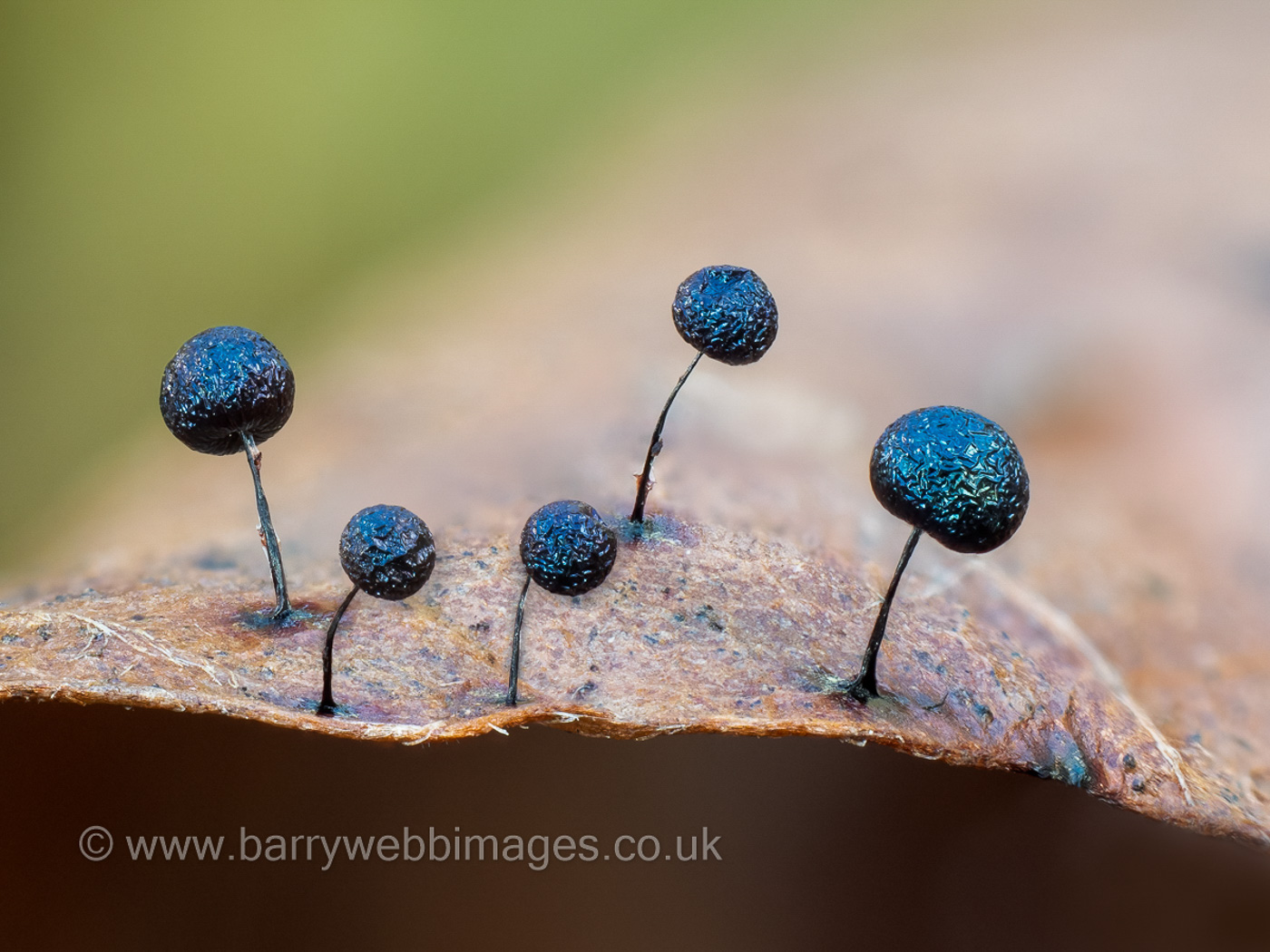
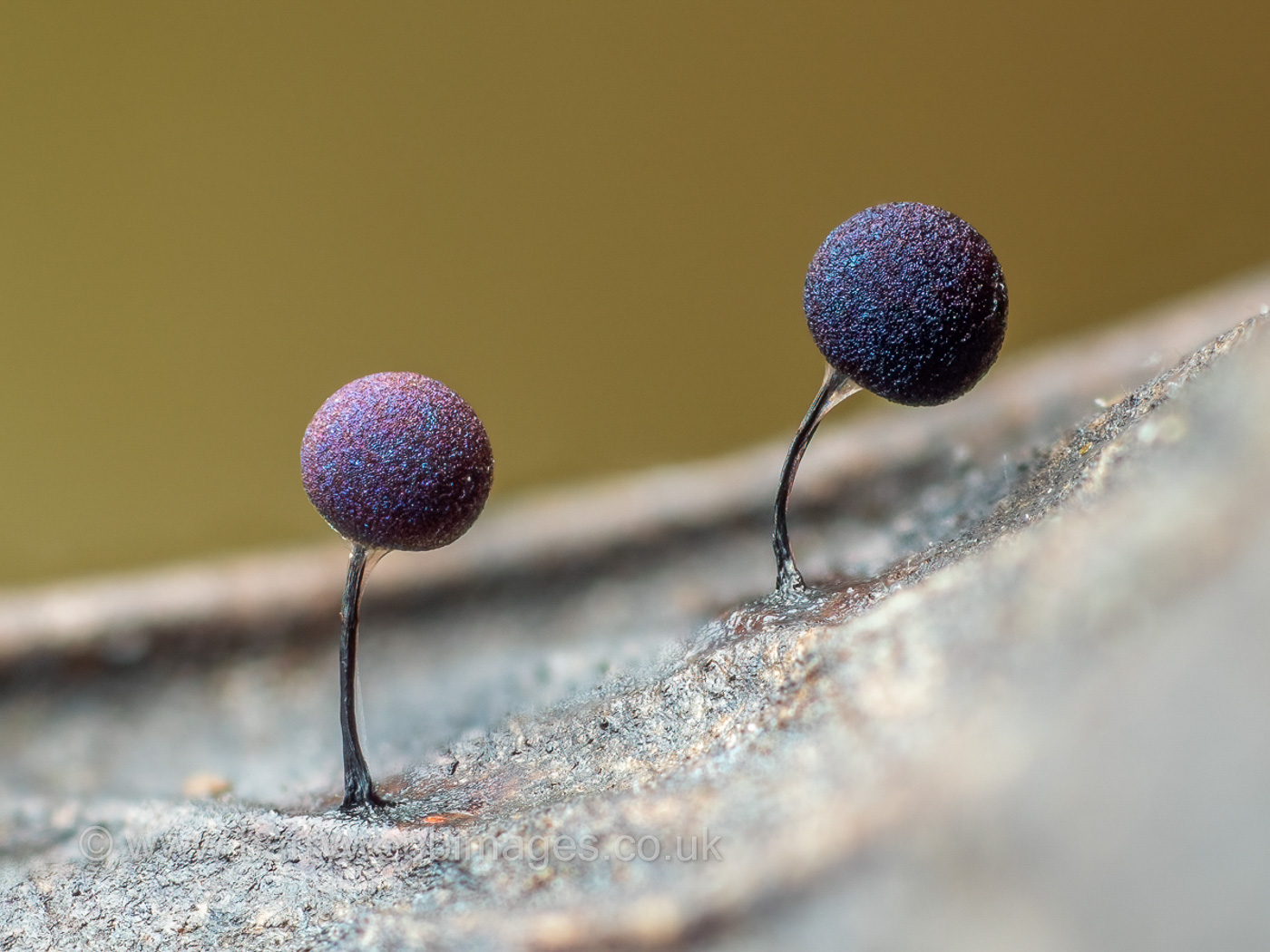
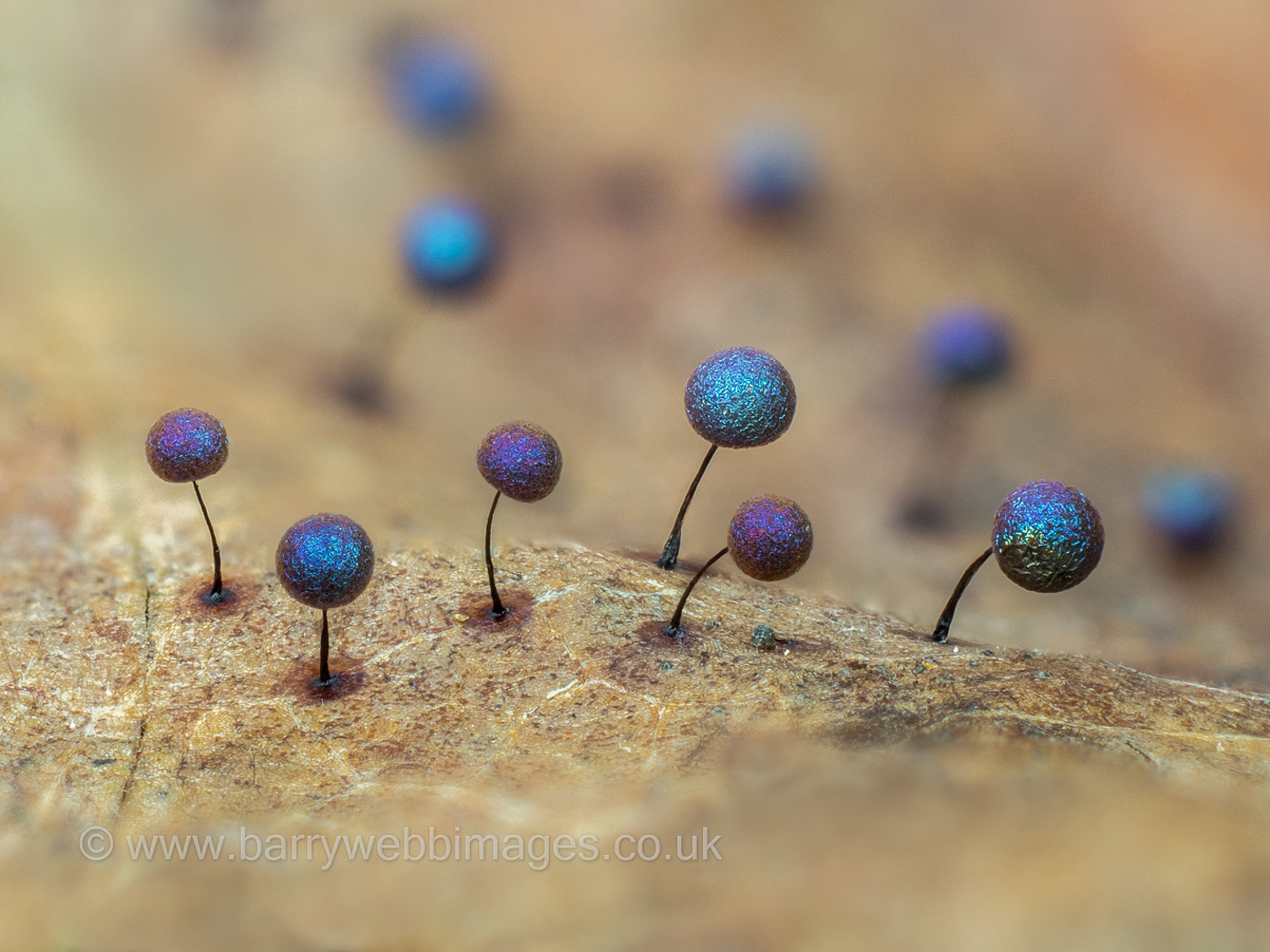
|
Lamproderma scintillans (a Slime Mould with no common name)
Jan 12, 2024. In Hodgemoor Wood Barry Webb found this attractive little cluster whilst searching for anything tiny under Holly. The Holly leaf here clearly gives a good sense of perspective - the whole fruiting body being smaller than the two prickles visible either end! The species name describes well its iridescent metallic glint. Not rare, its miniscule size makes the species so easy to overlook unless you specialise in such tiny objects, as does Barry! We now have five county records.
Jan 4, 2022. When in Hodgemoor Woods a week or so ago when Barry Webb and Gill found the delectable Marasmius hudsonii (see 2021 dated Dec 30th), Barry collected the Holly leaf on which that fungus was fruiting and - as is his habit - kept it in his greenhouse to see what else might appear. Lo and behold and to his delight, today's lovely species is what appeared! These little glistening iridescent gems are less than 1mm tall and occur on old rotting leaves, particularly of Holly and also ferns. Photos 2 and 3 were taken over the next couple of days from the same collection showing the variation in colour typical of the species as it matures. Photos 4 and 5 are from when he found it again at Naphill Common on January 12th. See more details and an image of our only other county record on Barry's separate page on Finds.
Dec 24, 2020. Barry Webb found these glistening little beauties (only 1-2 mm high) in Burnham Beeches in deciduous leaf litter. This species is not only new to the site but also to the county and the determination was confirmed by Andy Sands from Barry's excellent photo. The iridescent colours are typical of the genus, all species of which are very small thus often missed and presumably under-recorded also.
|
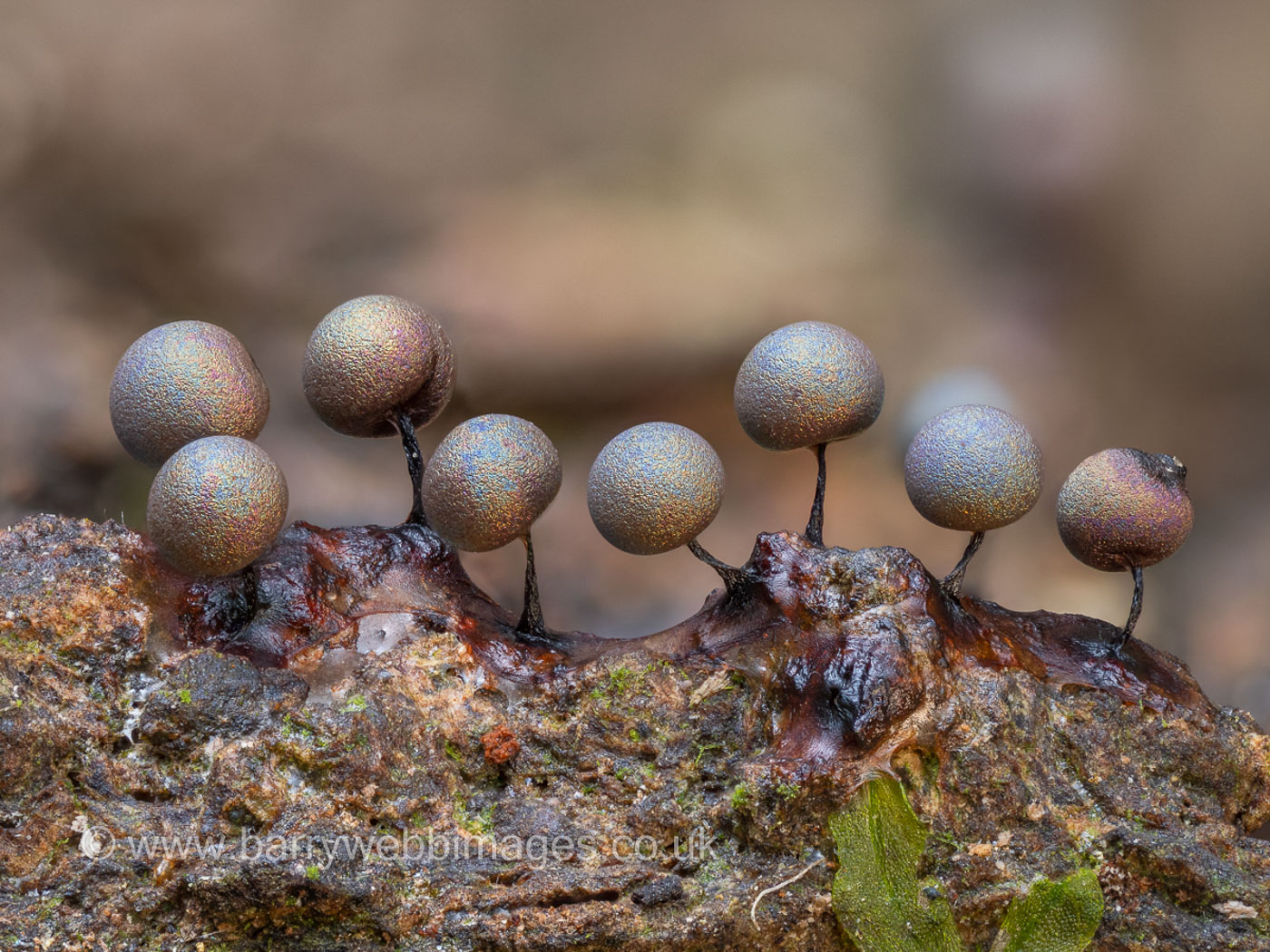
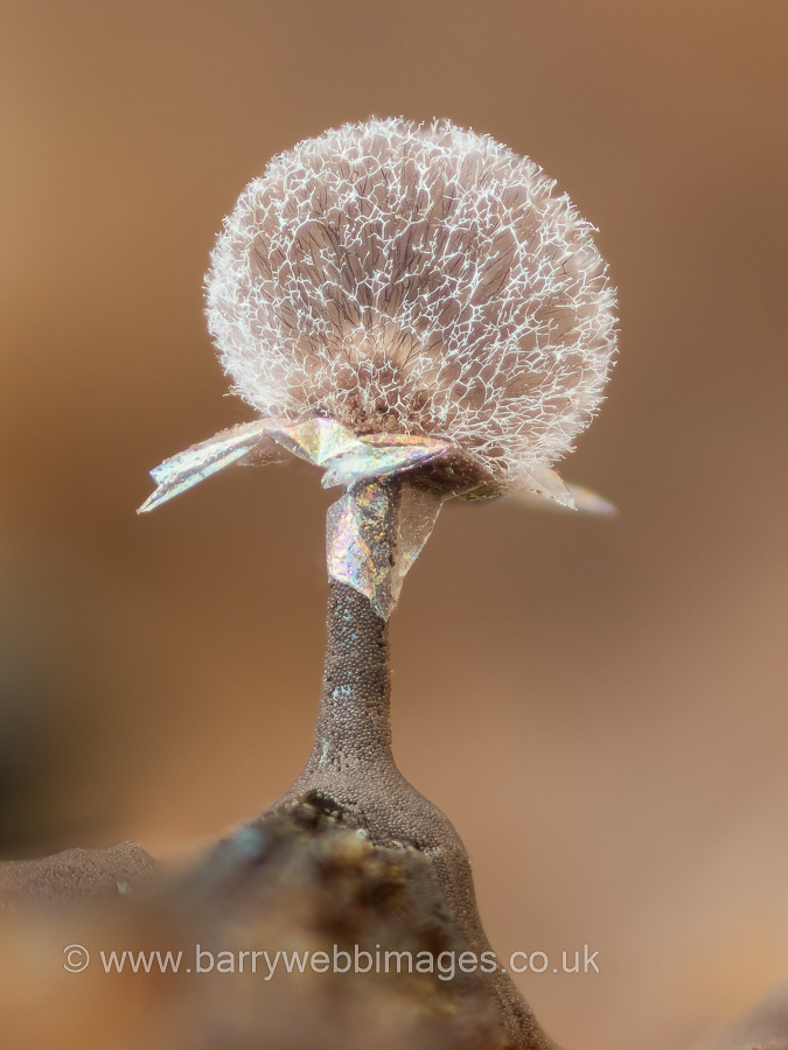 |
Lamproderma violaceum (a slime mould with no common name)
Nov 22, 2023. In Burnham Beeches on a large fallen rotten Beech Barry Webb was even more pleased to find this tiny little species which was identified for him from his photos by Myxomycete expert Edvin Johannesen. Previously L. arcyrioides it shows the typical glistening irridescence of the genus and photo 2 shows it once it splits open for spore distribution to occur (dehiscence). We have just one previous county record from Salcey Forest in 1990. This is a new entry for Finds.
|
 |
Lamprospora miniata var. ratisbonensis (a rare cup fungus with no English name) 
Mar 18, 2024. In moss in Gerrards Cross Jesper Launder found about 20 of these miniscule orange hairy-edged cups and knew he'd need help with identification. He sent his macro- and microphotos - the species has beautiful round spores ornamented with a distinct reticulation - to expert George Grieff who was able not only to name the moss genus as Didymodon but also to make a likely suggestion for the fungus too. Jesper then confirmed this using various keys etc. There appear to be no records in FRDBI and this is new to the county.
|
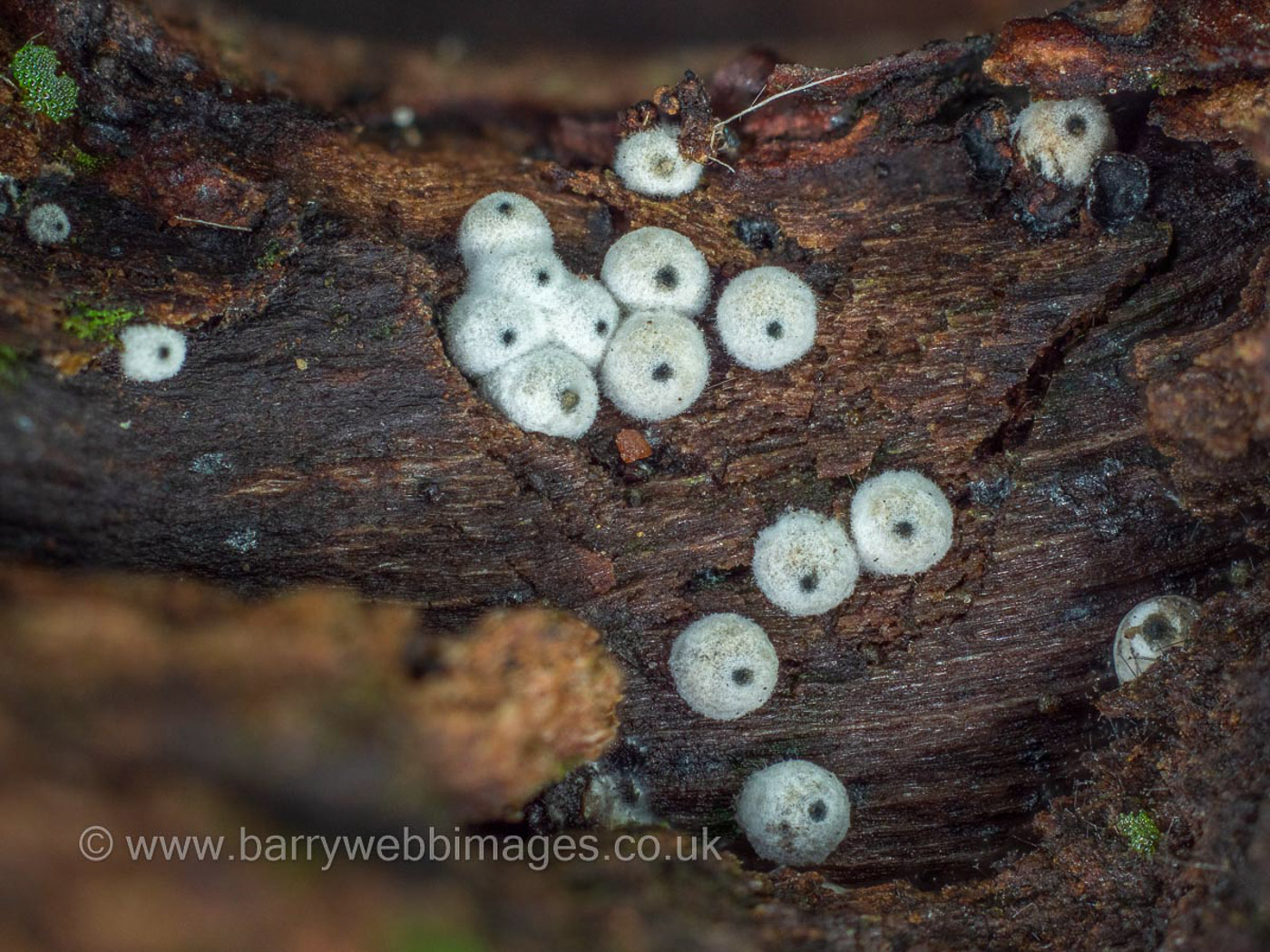 |
Lasiosphaeria ovina (Woolly Woodwart)
Sep 13, 2021. In Ivinghoe Common Barry Webb found these very small round slightly fluffy blobs on rotting fallen wood, recognising the species it having been identified the previous day when he also found a colony at Pullingshill Wood. This is a fairly common Ascomycete, one of the Pyrenomycetes being black and crusty, but distinguished from other quite similar species by its white covering of hyphae with a central black 'beak' which protrudes (like a min volcano!). Despite its common name it is not related to the Hypoxylon woodwarts.
|
 |
Lasiosphaeria spermoides (a Woodwart with no common name) 
Dec 17, 2023. On a very rotten deciduous log in North Dean Sarah Ebdon took her photo of Ascocoryne sarcoides (see the entry above), only to discover her shot included this swarm of tiny crusty black balls! Though at a loss as to what Pyrenomycete species they might be, she sent her photo to Penny who suggested she checked their spores to see if they matched those of L. spermoides, which luckily they did! Though not at all rare - despite having no common name - no doubt the species often goes unnoticed. We have a dozen or so county records though none since 2018. This is a new entry.
|


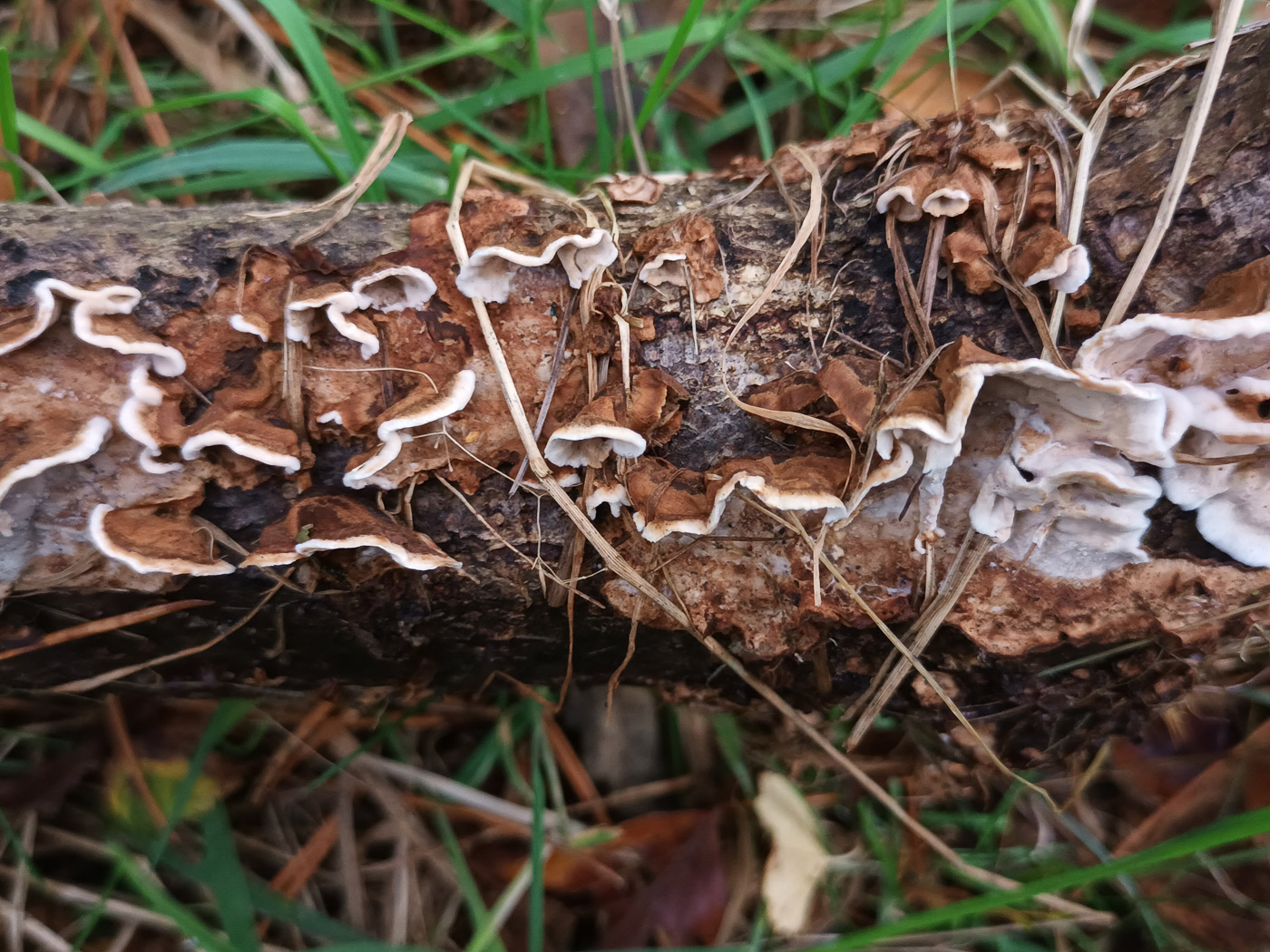 |
Laxitextum bicolor (an unusual part bracket / part corticioid with no common name) 
Jan 31, 2023. In Chalfont St. Peter Jim Wills noticed this fungus on a large felled Beech trunk, recognised it as quite similar to the very common Stereum hirsutum but significantly different enough to prompt him to take it home to work on. He then discovered it had amyloid ornamented spores which suggested Laxitextum bicolor - a species at one stage placed in the genus Stereum but with softer flesh and a whitish to grey undersurface. He then consulted Claudi Soler who was able to confirm his ID. This is not a common species and we have only a few county records though it may possibly be overlooked or thought to be a species of Stereum in the field. It favours fallen Beech but is not excusively found on Beech.
Oct 26, 2021. On some fallen unidentified wood in Beaconsfield Golf Club Jesper Launder thought he recognised this rare species for which we have just one previous county record, made by expert Martyn Ainsworth at Burnham Beeches back in 2005. At home the distinctive microscopy confirmed his determination. This is part corticioid / part bracket forming small brackets initially appearing quite similar to Stereum hirsutum (Hairy Curtain Crust) but with rather soft felt-like texture, also white and smooth underneath. It is most often found on fallen Beech but can occur on other woods. Another nice find for Jesper.
|
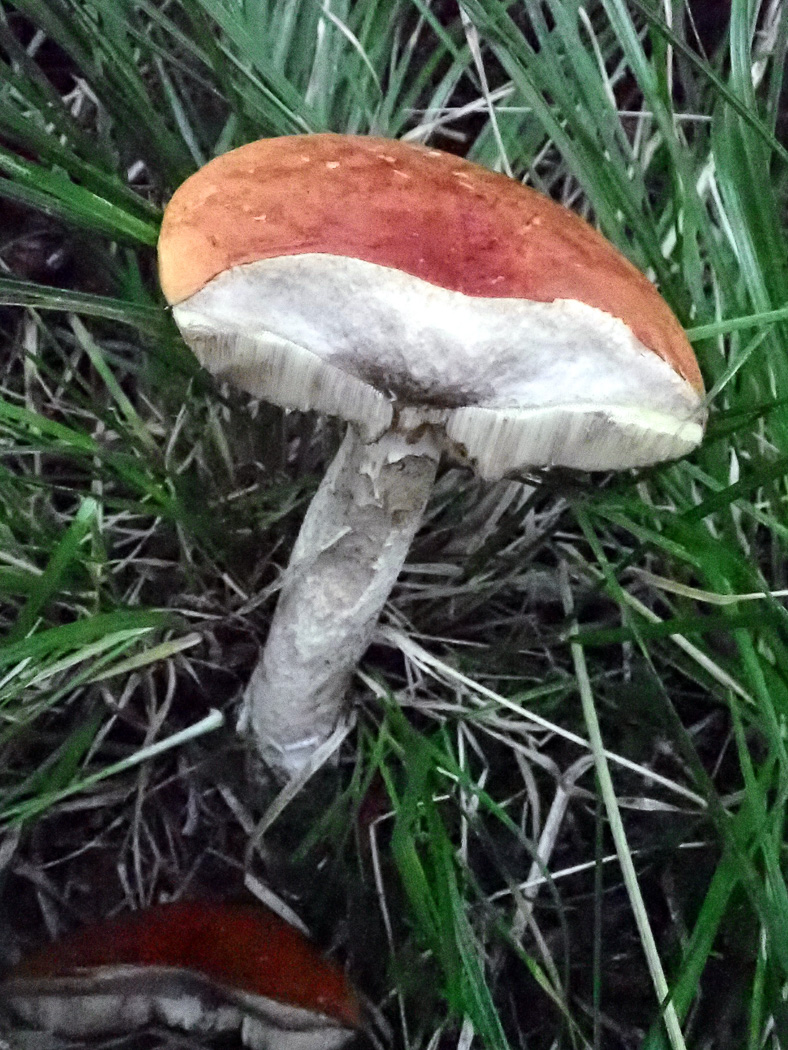
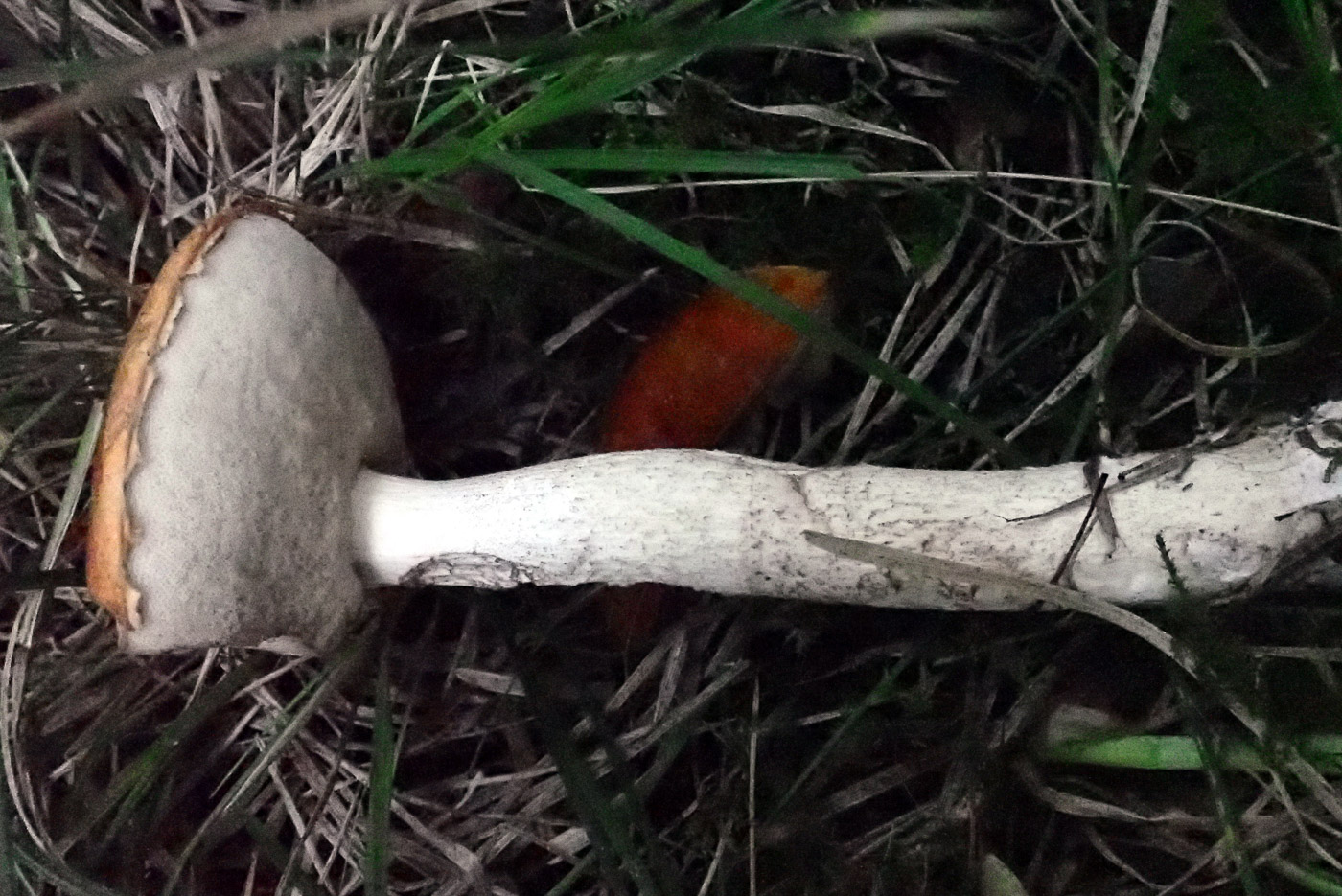 |
Leccinum albostipitatum (a Bolete with no common name) 
Sep 21, 2021. In Rushbeds Wood Penny found this singleton in a damp grassy path edge under various deciduous trees. After noting the conspicuous foxy orange cap colour she checked firstly for the presence of Oak nearby and then for the expected concolorous foxy markings known as scabers on the stem which would confirm it as the fairly common L. aurantiacum (previously L. quercinum). Yes, there was Oak about but, no, the scabers if any were white and not standing out in contrast to the background colour which made this much more interesting and unusual. Separated from L. aurantiacum by the lack of orange scabers on the stem, this rare species occurs under Poplar or Aspen (closely related) and both of which were indeed nearby. Compare with L. aurantiacum dated Sept 6th where the stem is clearly dotted with orange scabers unlike today's find.
|


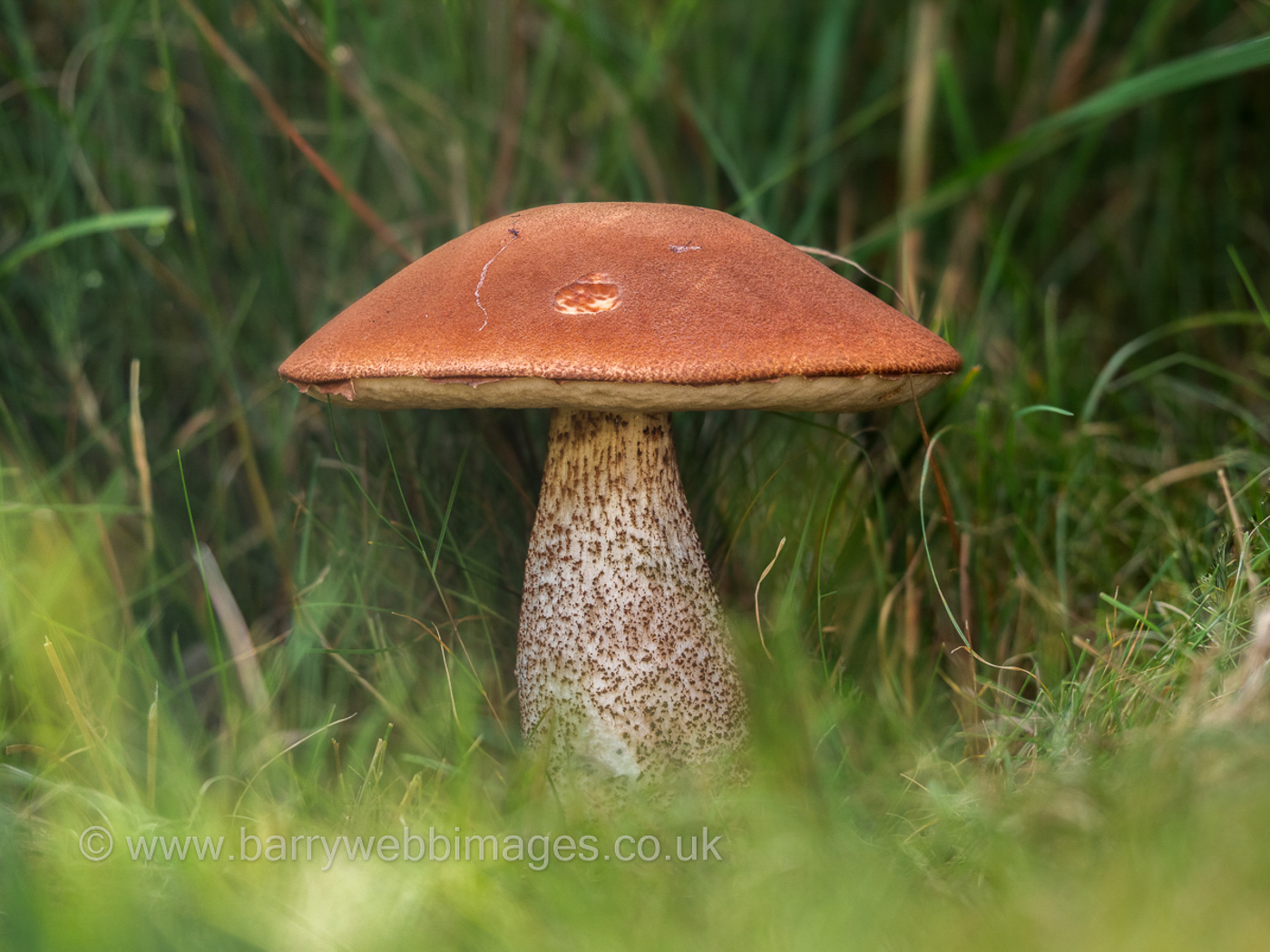
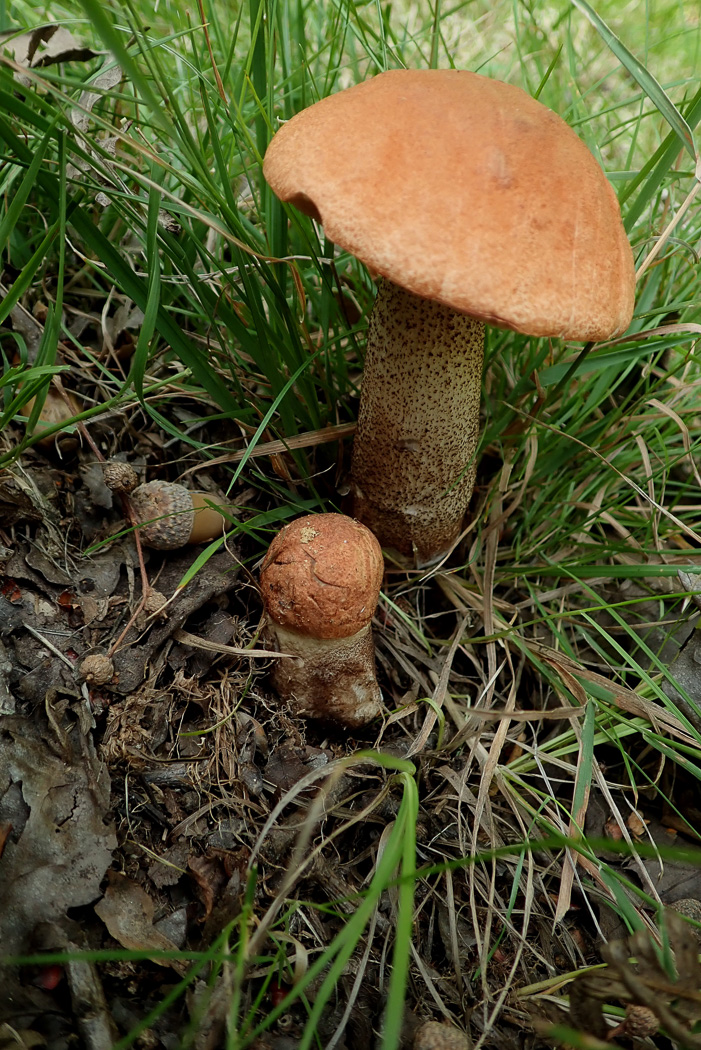
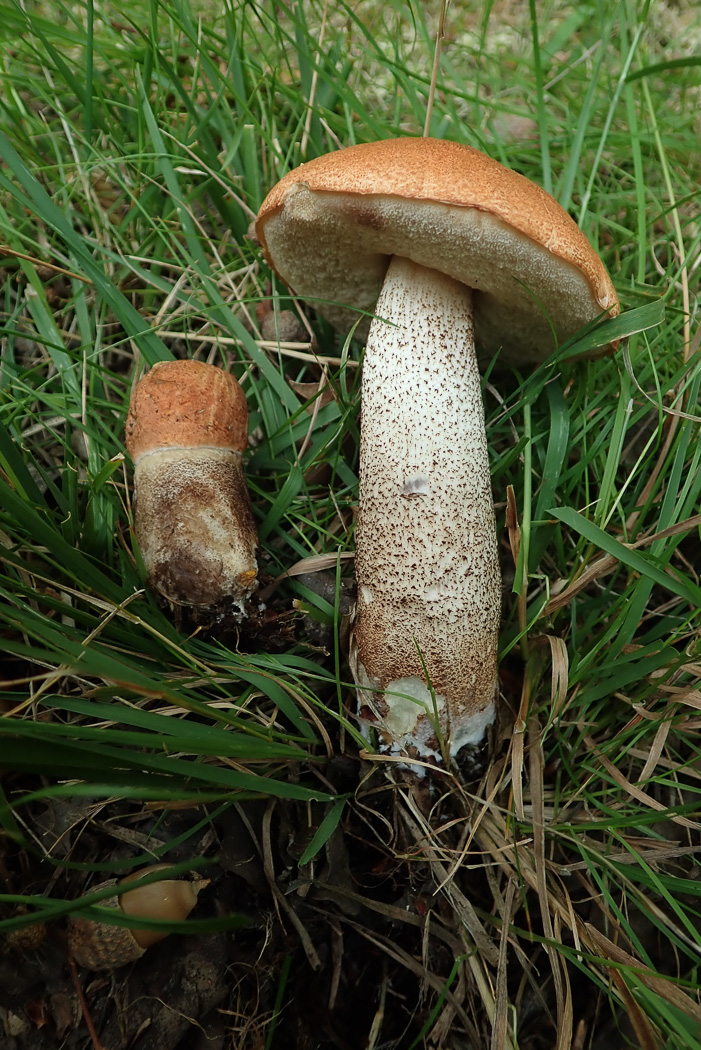
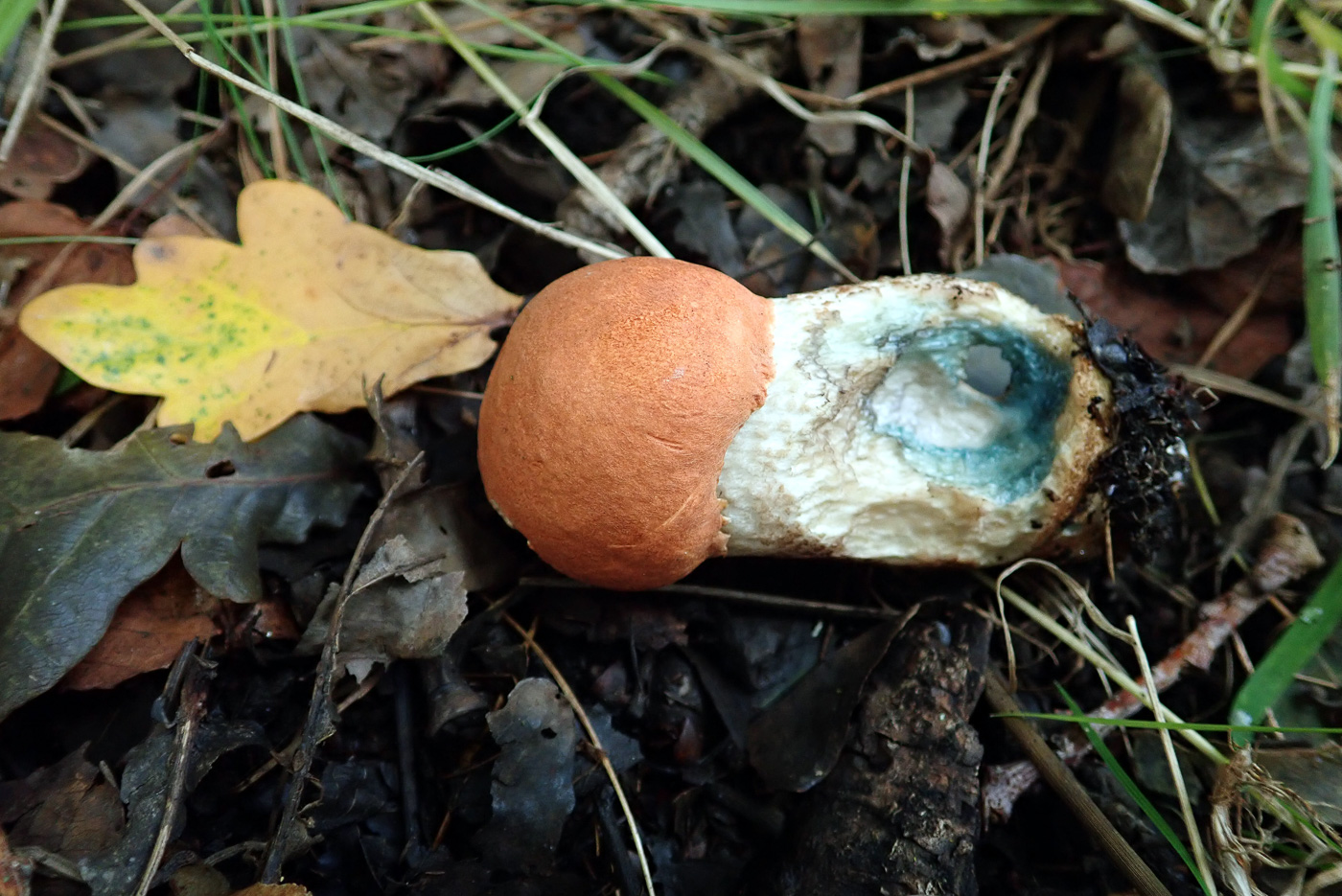
|
Leccinum aurantiacum (Orange Bolete)
Oct 1, 2023. In damp heathland at the edge of the Mire in Burnham Beeches Jim Wills found this smart Bolete. He was unsure of the species so Penny has plumped for L. aurantiacum on the strength of the distinctive cap colour and even more distinctive foxy concolorous 'scabers' which continue right down the stem. Jim commented on a mix of trees nearby so was unsure with which it was associating though its commonest host in Oak but it is also known with Poplar, Lime, Birch, Willow, even Beech.
Aug 9, 2023. Under Oak in Gerrards Cross Common Jesper Launder found this striking Bolete - not rare but always nice to see. The cap colour and tree association are sufficient to make an ID if your mushroom has the dark red to black 'scabers' on the stem as here, but if under Poplar - most commonly Aspen - and the stem scabers are not reddish but whitish (concolorous with the stem flesh) then you have the much rarer L. albostipitatum. L. aurantiacum is most commonly under Oak but can occasionally occur under other deciduous trees including Poplar and Aspen!
Sep 6, 2021. In Stoke Common Barry Knight found this splendid Bolete (probably under Oak). An impressive species (previously L. quercinum), it sports a foxy red brown cap, pale cream pores and a typical Leccinum stem pocked with scabers which match the cap colour (and sometimes with green stains at its base).
Sep 15, 2020. One of the few species of Leccinum to grow with trees other than Birch, this species was found under Oak at Burnham Beeches by Penny Cullington. The foxy orange cap with rather uneven but firm surface together with the occurrence under Oak or Poplar separate it from other Leccinum species. The species has the typical pale pores and stem with dark scabers which characterise the genus though in this case the scabers are tinged with the foxy orange cap colour. An occasional species but not rare. (Note in the third photo the typical blue green staining at the stem base where eaten by slugs, a feature which can occur in this and a few others in the genus - this specimen found at Stoke Common, Sept 25th.)
|



 |
Leccinum crocipodium (Saffron Bolete)
Aug 30, 2023. Under Oak in Bernwood Forest Penny and Paul spotted these Boletes which from above were tricky to identify, but once the small yellow pores and rather clavate stems were seen Penny realised what they were. Furthermore Jesper Launder had found the species here in July and Oak is very much the predominant tree in much of this site, with which this particular Leccinum associates. Penny gave the stem a good scratch then waited for half an hour for it to turn first pinkish red then black, thus confirming the ID (see photo 2). All parts will blacken when damaged. When mature this is a large chunky Bolete and the cap can be bright yellow (hence its common name) though it tends to have a rather 'hammered' surface.
Jul 16, 2023. In Bernwood Forest this was another nice Bolete Jesper Launder noticed in some Ukranian ladies' basket and borrowed for the photo (see above also)! This is a large Leccinum found under Oak rather than Birch - the host tree of many of this genus - and typically has a yellow ochre cap which becomes tessilated (indented). A useful pointer to its identity is that all parts turn slowly black when bruised / damaged. The stem 'scabers' are less apparent than in others of the genus, blending with the stem colour though do eventually blacken. An occasional species in the county, this is a new entry for Finds.
|


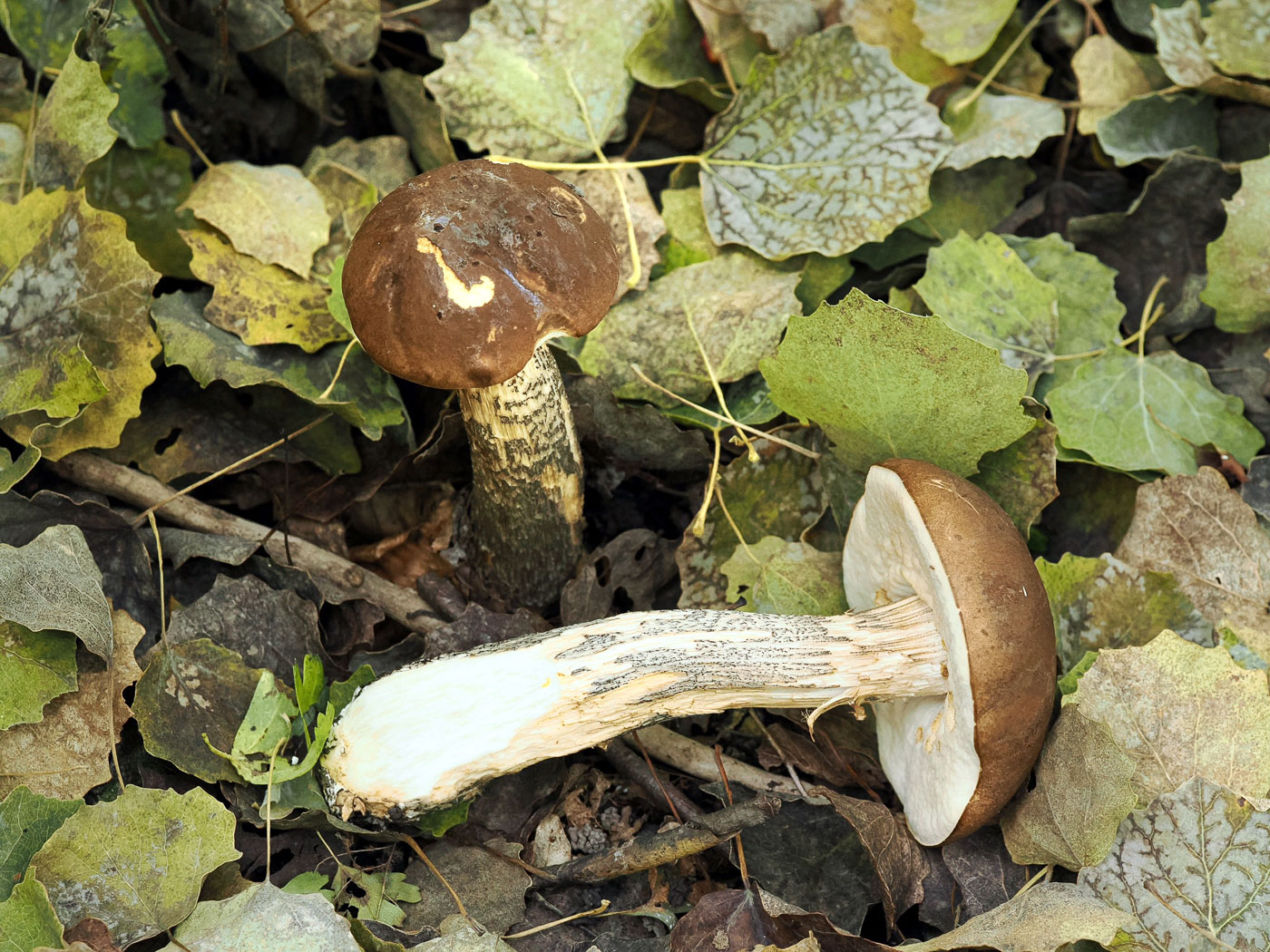
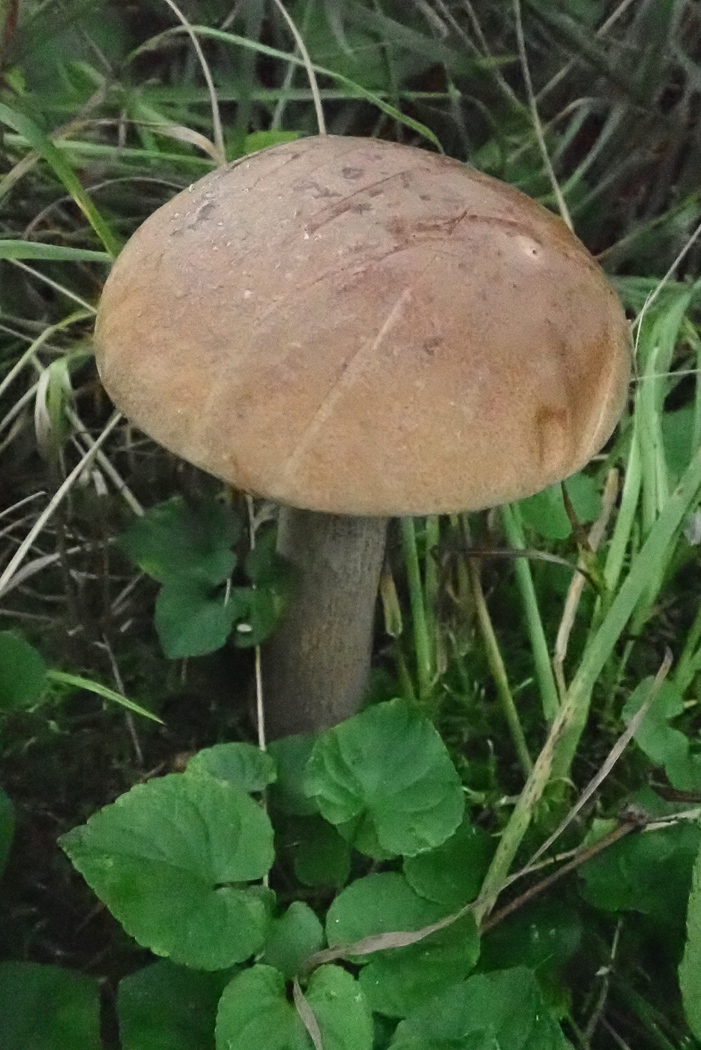
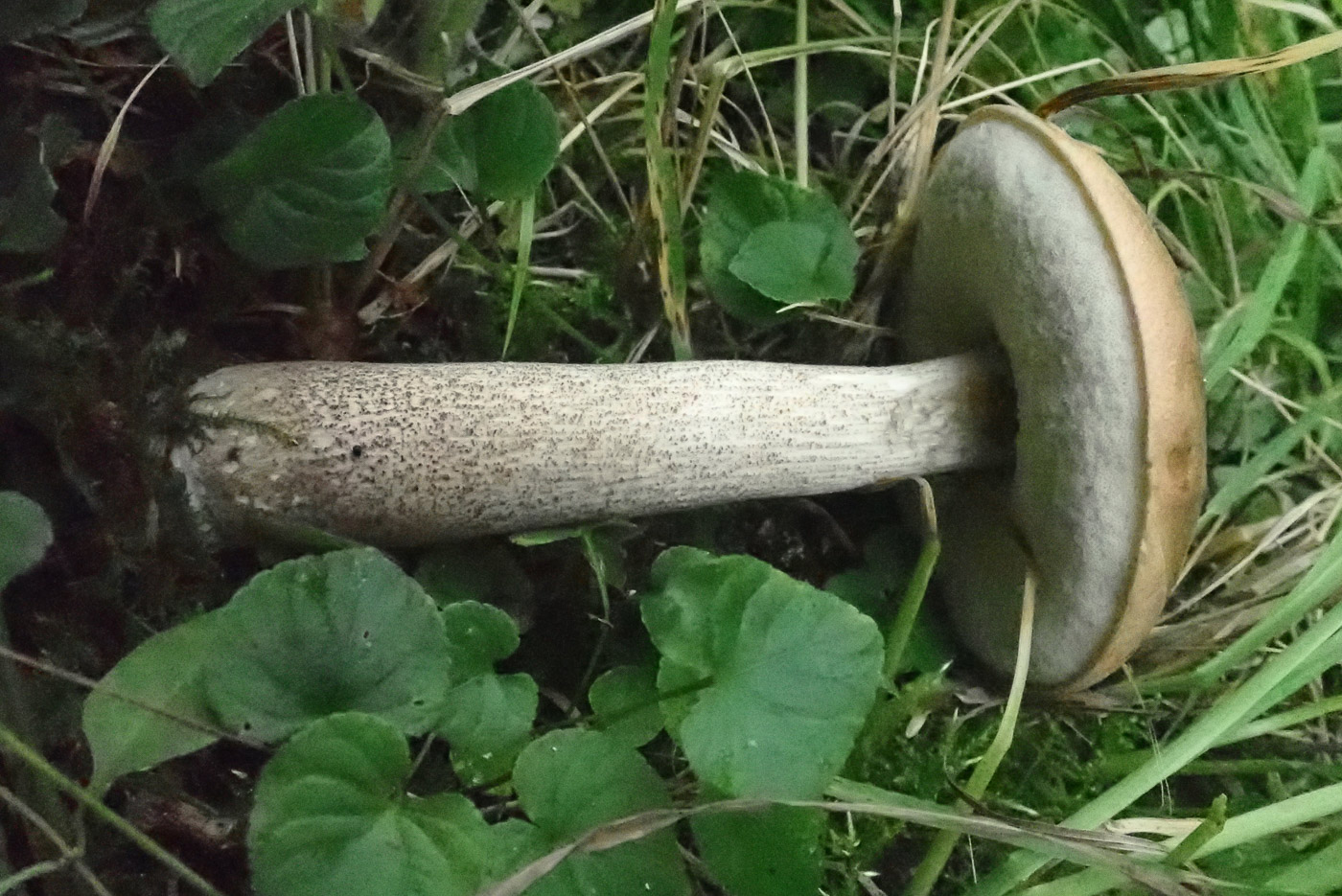
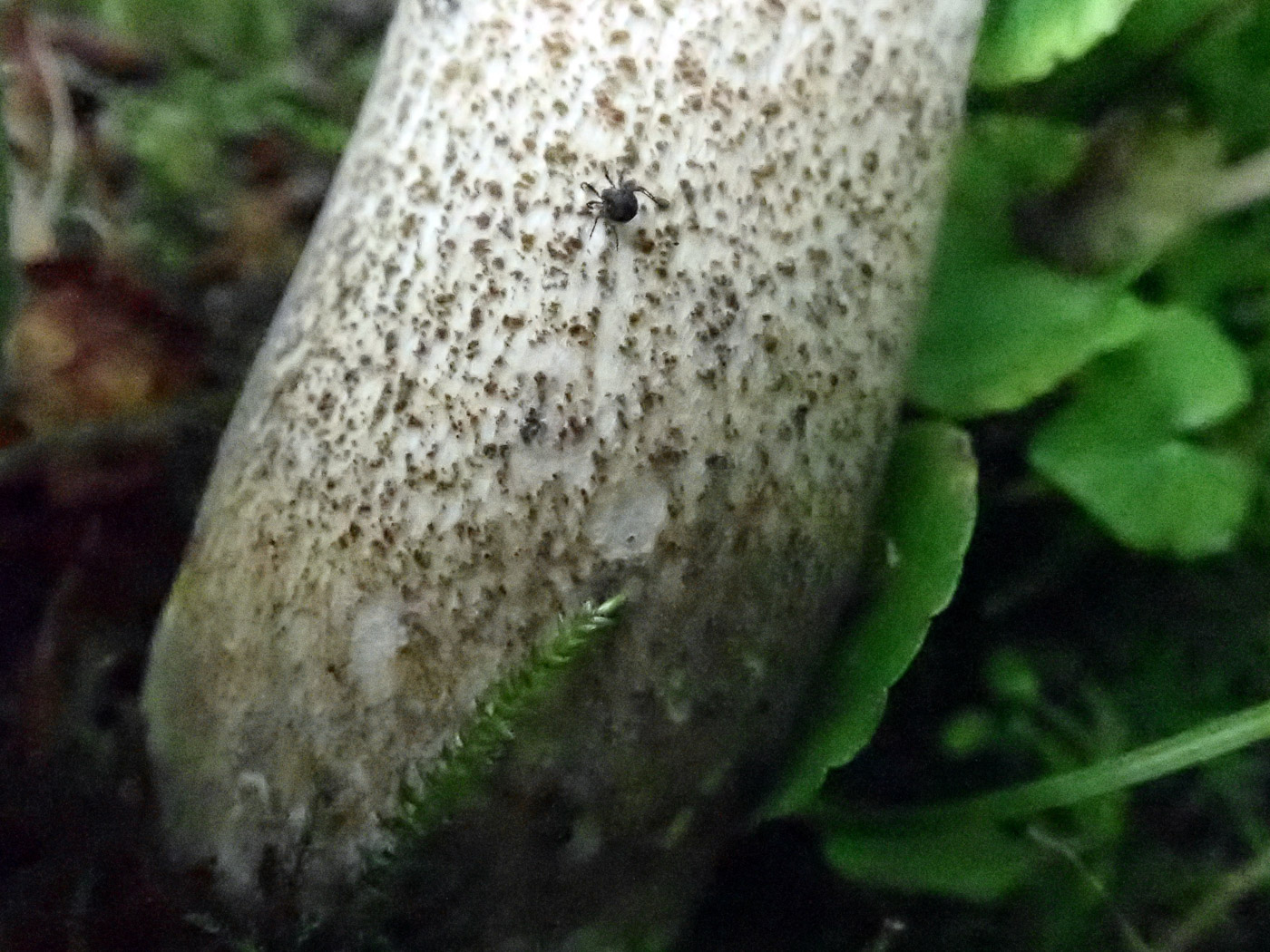
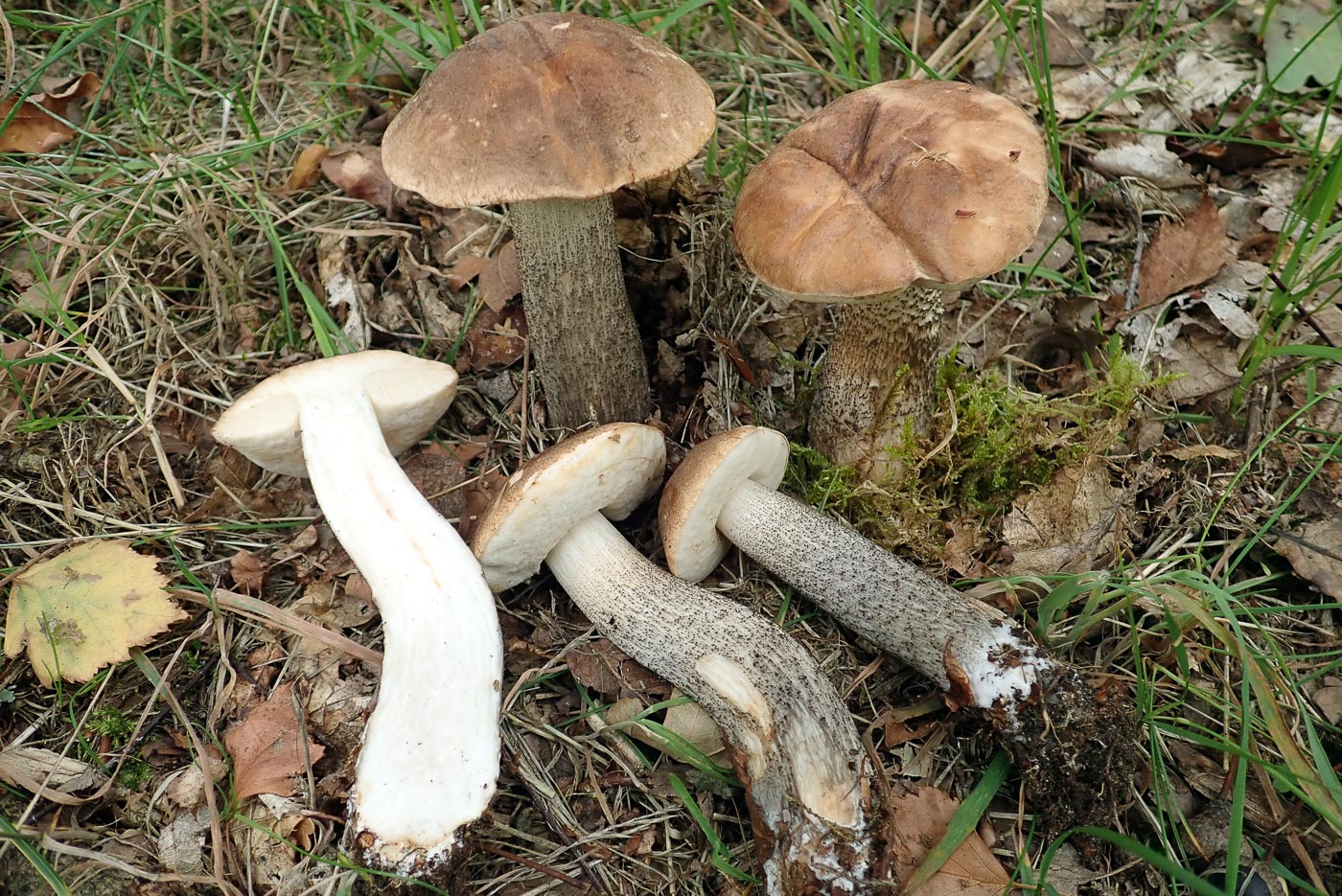
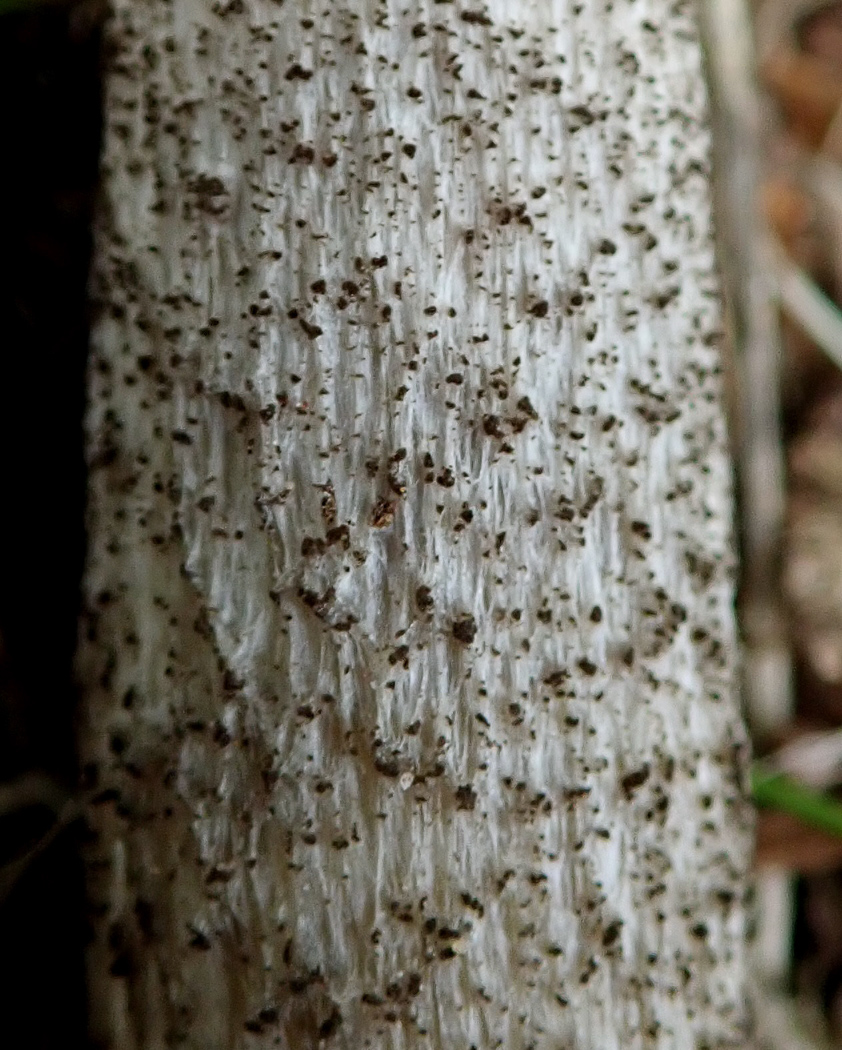 |
Leccinum scabrum (Brown Birch Bolete)
Oct 1, 2023. In the Mire at Burnham Beeches Jim Wills found these Boletes with Birch nearby the tree with which many of this genus associate. This is perhaps the commonest Leccinum, having a dull brown quite soft cap, pale cream small pores which stain slightly brown if bruised, and a stem with more or less concolorous to brown or even black 'scabers' (small scaly bits). See the Masterlist for our three previous images.
Sep 18, 2022. On our BFG Walk at Hodgemoor Woods we found this smart pair under Birch and Aspen, the photo taken by Claire Williams. Due to space issues in Penny's report this photo didn't make it, hence its inclusion here as it is a nice example. If under Aspen you find a Leccinum having an almost white stem and a foxy orange cap, you may have the rare L. albostiptatum, but today's find - though near Aspen - was clearly not that species with the dull brown cap, black 'scabers' on the stem and no blue/green stains in the flesh at the stem base: all indicators of this Bolete, common where ever Birch is present.
Aug 13, 2021. In longish grass at the path edge in Rushbeds Wood Penny found this large bolete in soil near a mix of deciduous trees including Oak, Aspen and Birch - all of which could have been the host for the species though Birch was the likeliest. Turning it over revealed the dark 'scabers' on the stem (photo 3) and pale offwhite pores under the cap, making it a member of the Leccinum genus of boletes. Determining to species was going to need work at home, but the first step was to look for any signs of green staining at the stem base or where damaged by slugs and to slice the whole in half lengthways to observe any colour change in the flesh in 30 minutes or so. The lack of green staining or flesh change plus cap colour and softness together with microscopic features led to this the commonest Leccinum, host specific with Birch.
Sep 9, 2020. Perhaps the commonest species of Leccinum, this was found by Penny Cullington in grass under Birch at The Common, Cadmore End. Many of this genus are host specific to Birch as is this one. The blackish 'scabers' in the lower stem though paler at the top, also the unchanging stem flesh colour when cut, are good field characters. 
|
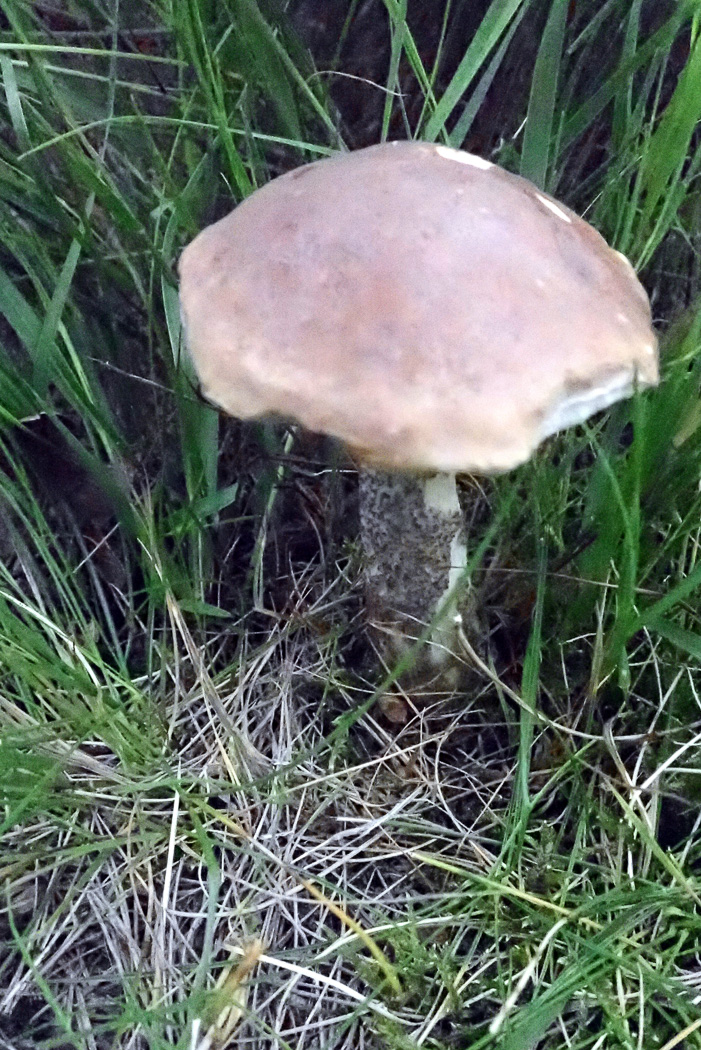
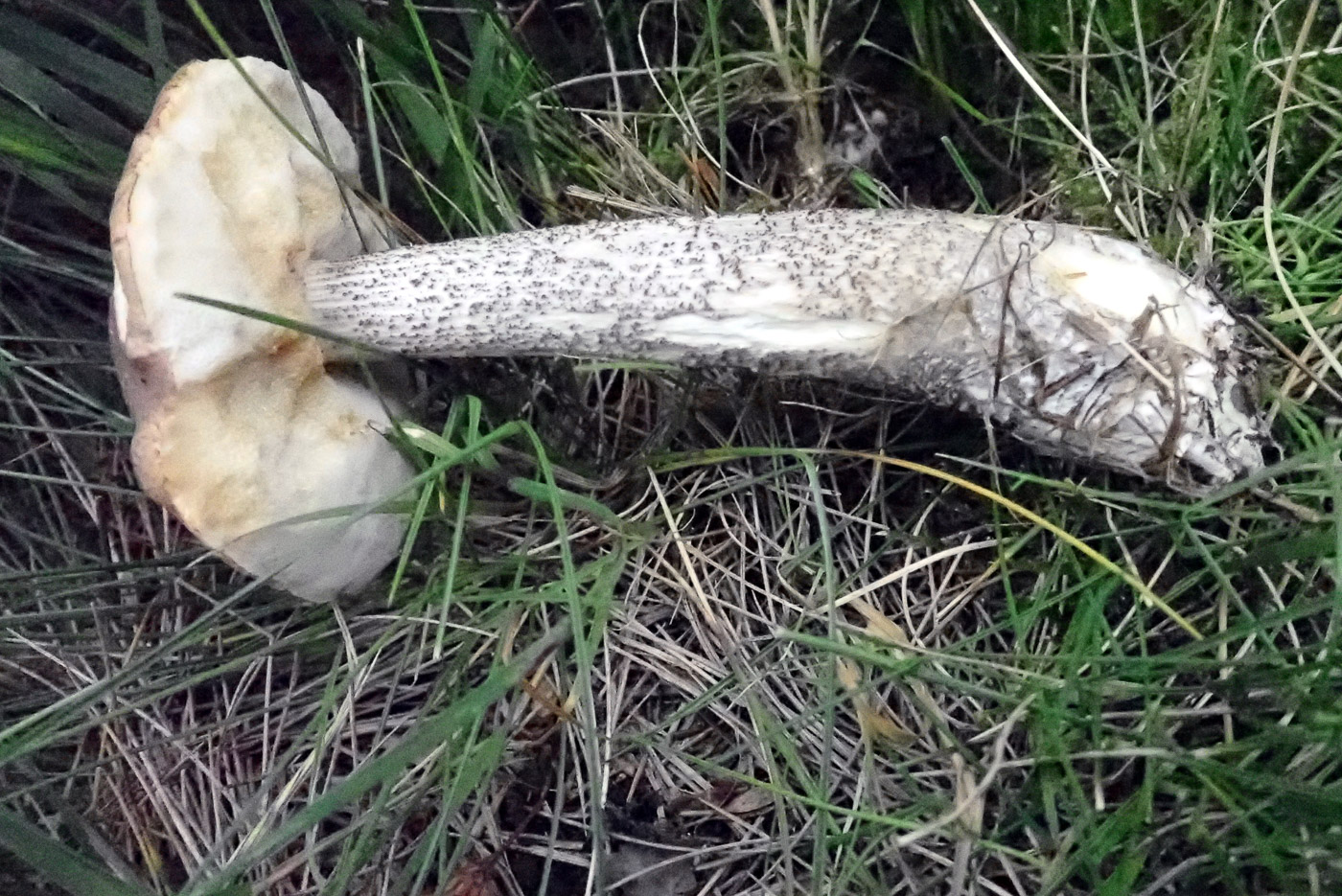
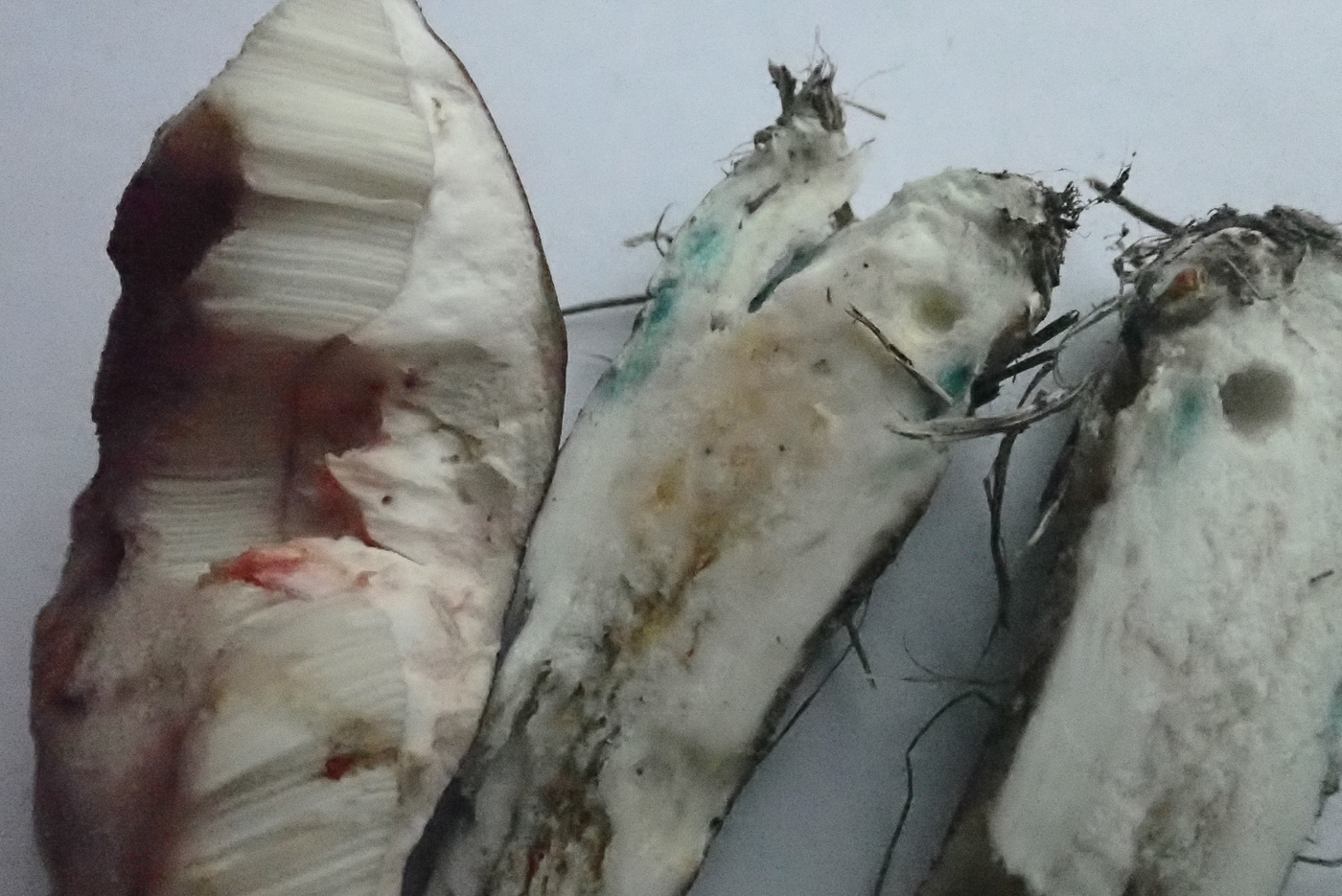
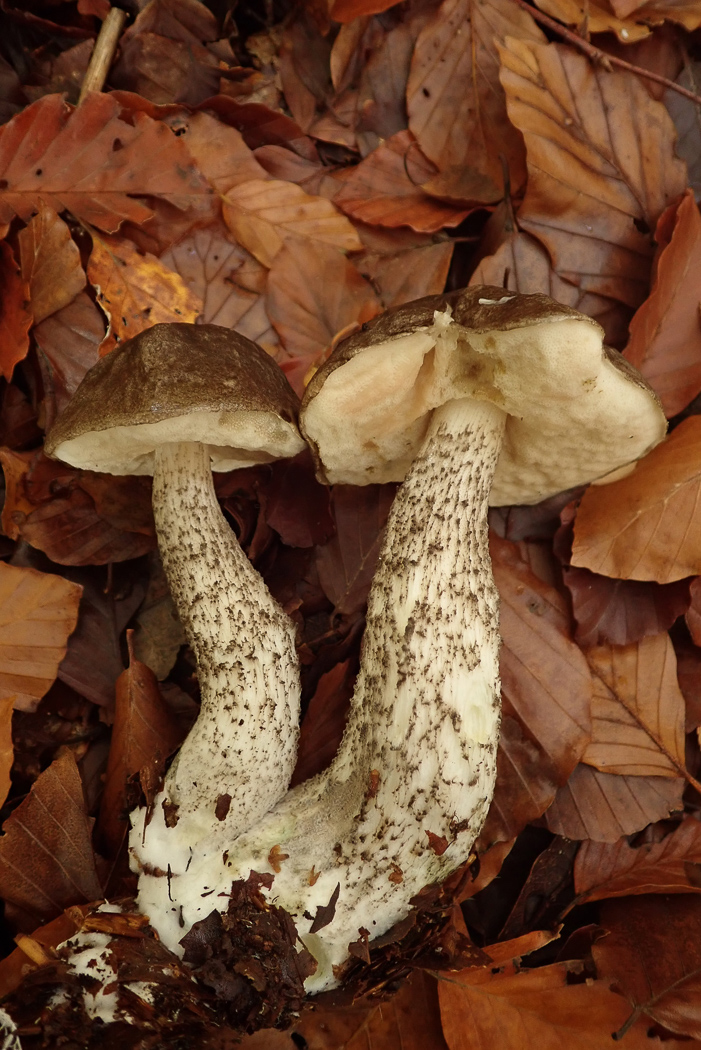
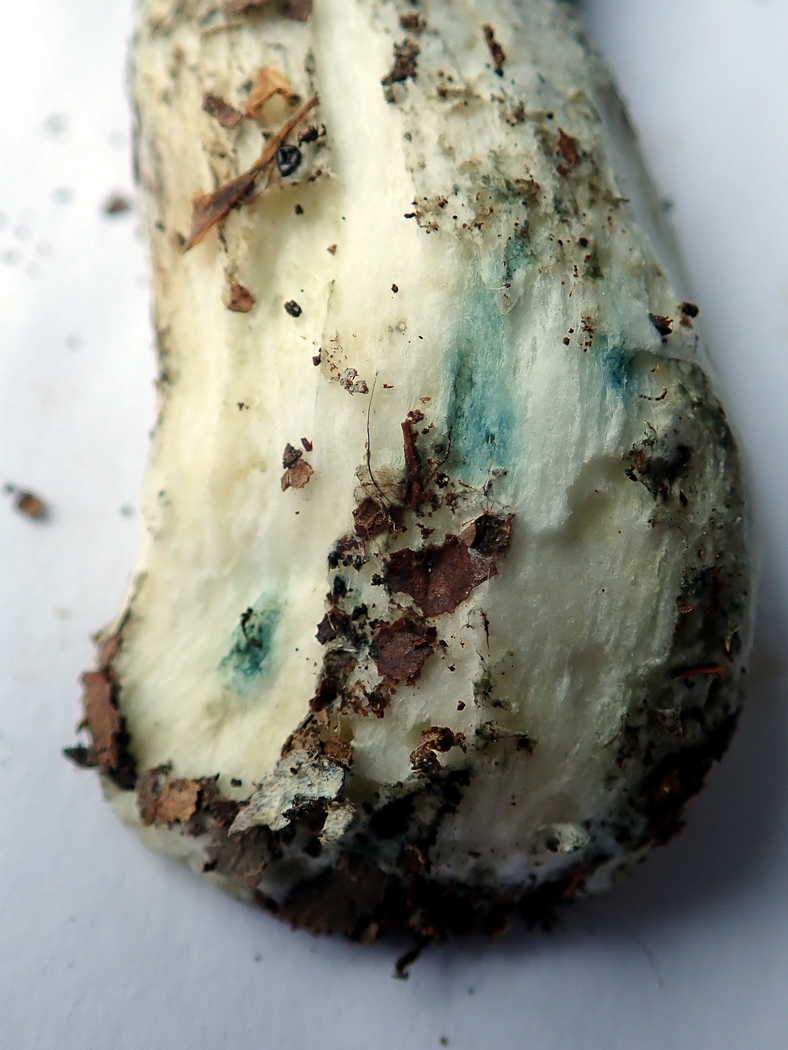
|
Leccinum variicolor (Mottled Bolete) 
Jul 15, 2021. In grassy soil under Birch at Stoke Common Penny found just one Leccinum specimen and knew she'd need to take it home to work on to identify to species. She scratched the stem base on collection and saw no signs of blue-green staining at the time, but later on close inspection there were clear signs of this colour at the base. This together with the cap flesh turning slightly pink, the dark brown-black 'scabers' on the stem and examination of the cap cuticle with a scope confirmed it as the fairly common L. variicolor rather than the even more common L. scabrum. (These colour changes often take an hour or so to develop.) Both species together with most members of this genus of Boletes are mycorrhizal with Birch but one should always note the tree host because a few species associate with other trees: Oak, Hornbeam, Aspen or Poplar, giving a vital clue to determination.
Oct 22, 2020. Paul C. found this pair under Birch in Hodgemoor Woods. Rather a dark capped species of Leccinum with a slightly irregular bumpy surface, it has dark almost black scabers on the stem and tends to develop green patches where damaged at the base. (Photo 2 was taken an hour or so after collection.) As there are other species which also can have these green markings it is necessary to check the cells forming the cap surface to make a positive identification. This is one of the commonest of many species of Leccinum which are host specific to Birch.
|
 |
Lentinellus cochleatus (Aniseed Cockleshell)
Aug 23, 2023. On a couple of mossy exposed old roots of Beech at Mousells Wood Geoffrey Kibby noticed this quite unusual species showing nicely. Its shape told him instantly what it was - tightly curled when young then funnel shaped, this then confirmed by the sharp edged and markedly serrate gill edge (seen on the left). Sometimes the species has a strong aniseed smell but more often than not no smell at all as here. This is new to the site and to Finds though we have just nine other county sites where it's been found. (The photo is Penny's.)
|






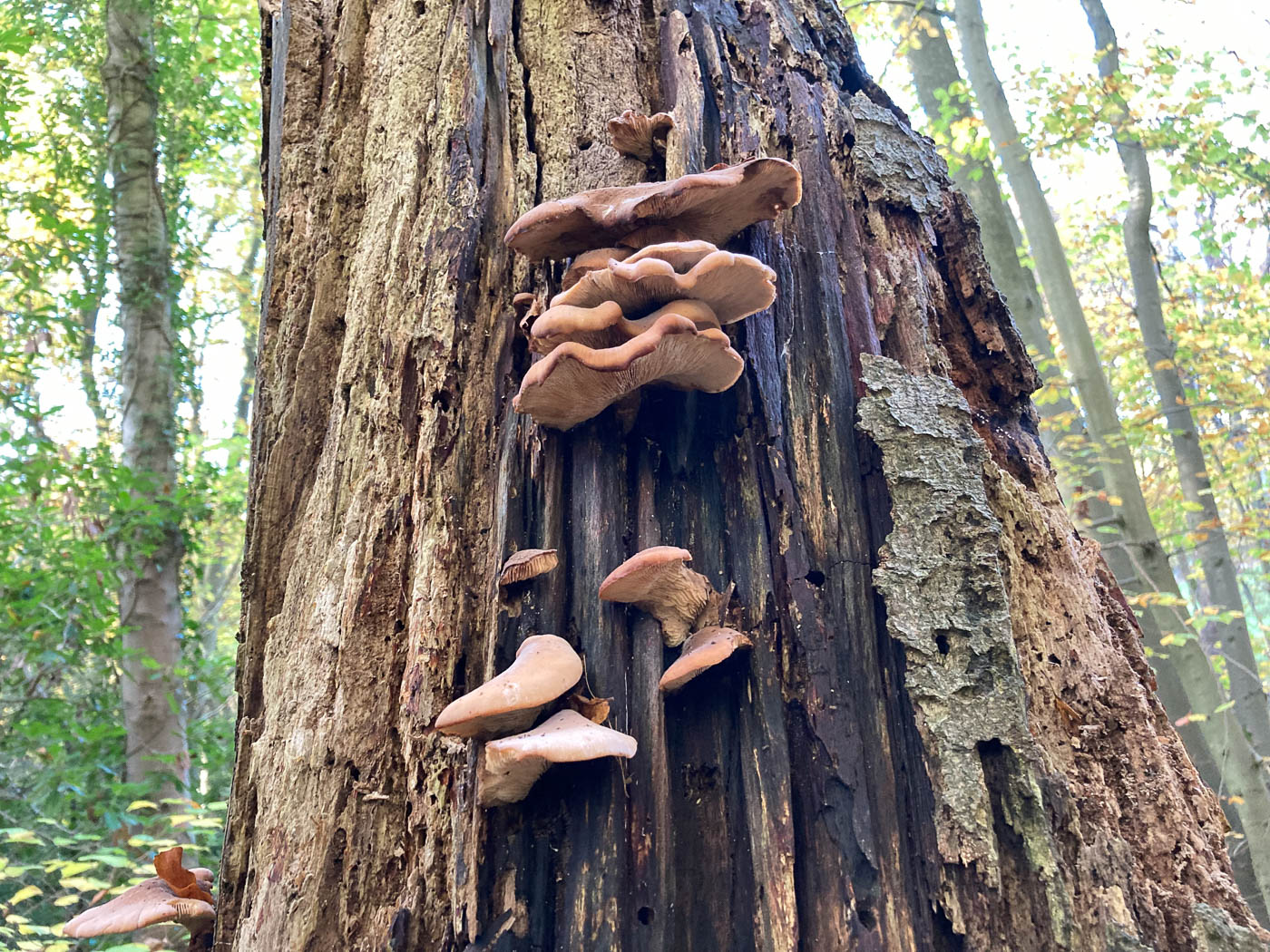
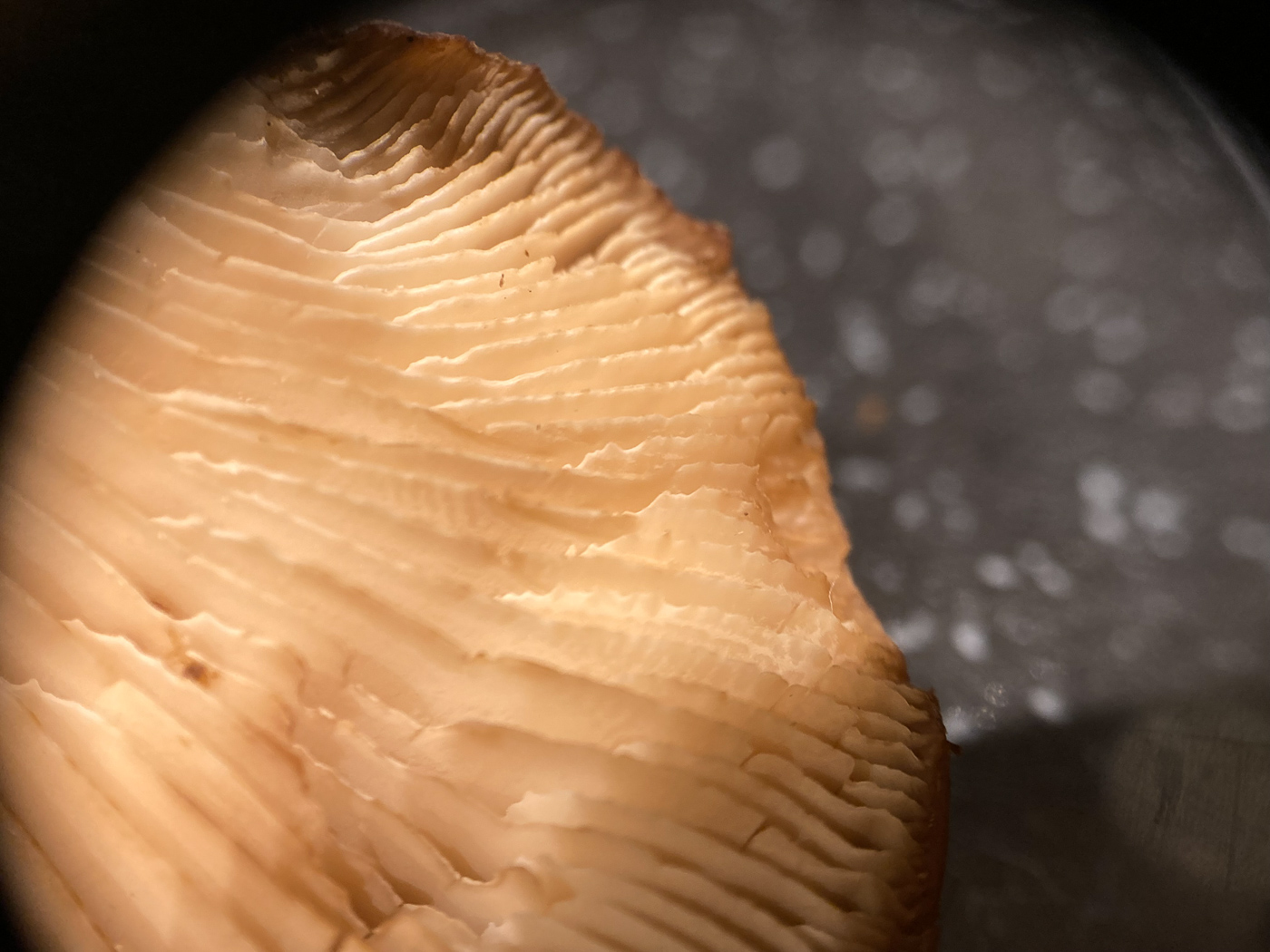 |
Lentinellus ursinus (Bear Cockleshell)  
Jan 14, 2024. In North Burnham Russell Ness found this attractive cluster on a felled dead Elm trunk and identified it using various sources which entailed checking both spores and flesh which blacken strongly with Melzers reagent (photo 3) and help to separate it from other species. This is a rare mushroom though similar at first glance to Pleurotus but the sharp saw-edged gills (photo 2) immediately single it out as belonging to genus Lentinellus. We have just 4 previous county records.
Feb 1, 2023. In Chalfont St. Peter Jim Wills found this fungus fruiting on the sawn end of a large felled Beech trunk and took some home to work on. The Pleurotoid habit (photo 2) and markedly saw-edge gills (photo 3) led him straight to the genus Lentinellus, the commonest species of which - L. cochleatus - has a strong aniseed smell and weakly amyloid spores. Finding the spores strongly amyloid - also other parts of the fruitbody - and noting the lack of aniseed smell, he clearly had something different, then discovered that splitting the two likely species fitting these features - L. ursinus and L. vulpinus, both rare - was no easy task. However, further research pointed strongly to L. ursinus in this case and DNA sequencing has now proved Jim correct. The collection will be sent to Kew Fungarium. See also in Finds 2022 November 13th. We have extremely few county records of this species. (Please note the common name given here is unofficial but logical, also used online, so will presumably be officially adopted at some stage.)
Nov 13, 2022. In Littleworth Common on an old Beech trunk Russell Ness managed to reach up far enough to collect and photo this unusual species, one for which we have only two previous records, both from Brill Common in Horse Chestnut. There are several closely related species which are difficult to separate (see also in Finds L. vulpinus dated 2022 October 24th) and all have the typical uneven finely serrated gill edge of this genus seen in photo 2, hence its common name. However, Russell read that the flesh of today's species is strongly amyloid and a drop of Melzers reagent duly turned instantly black which helped to confirm his ID. This is a new entry for Finds.
|
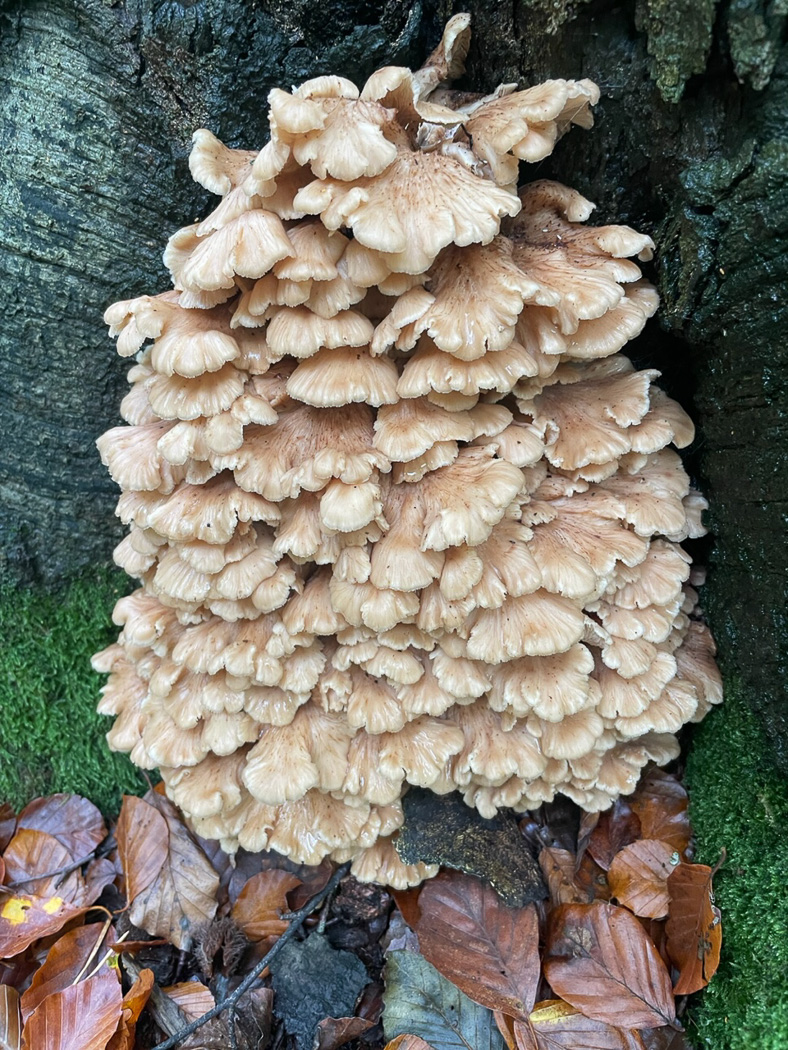
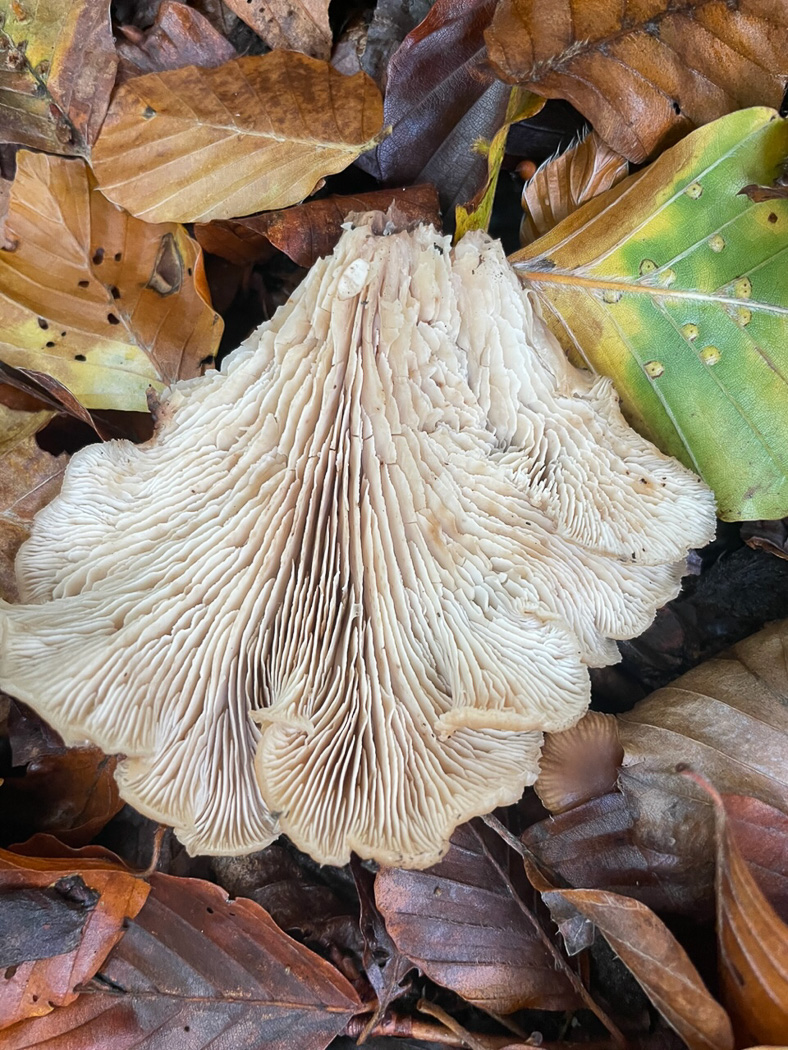 |
Lentinellus vulpinus (Fox Lentinellus) 
Oct 24, 2022. In Great Wood, Culden Faw Estate near Henley, Richard Fortey was excited to find this large spread of a rare species fruiting so prolifically on an old Beech trunk. Similar in growth habit to the Oyster species, it differs in entirely lacking a stem and having rather thin crowded fan-like gills which have a distinctly serrate edge (like a saw). This is a rare species with few national records with just one from the county in 1999 from the Cliveden Estate made by Kew mycologist Martyn Ainsworth. The photos were taken by Caroline Lawrence and this is a first for Finds.
|




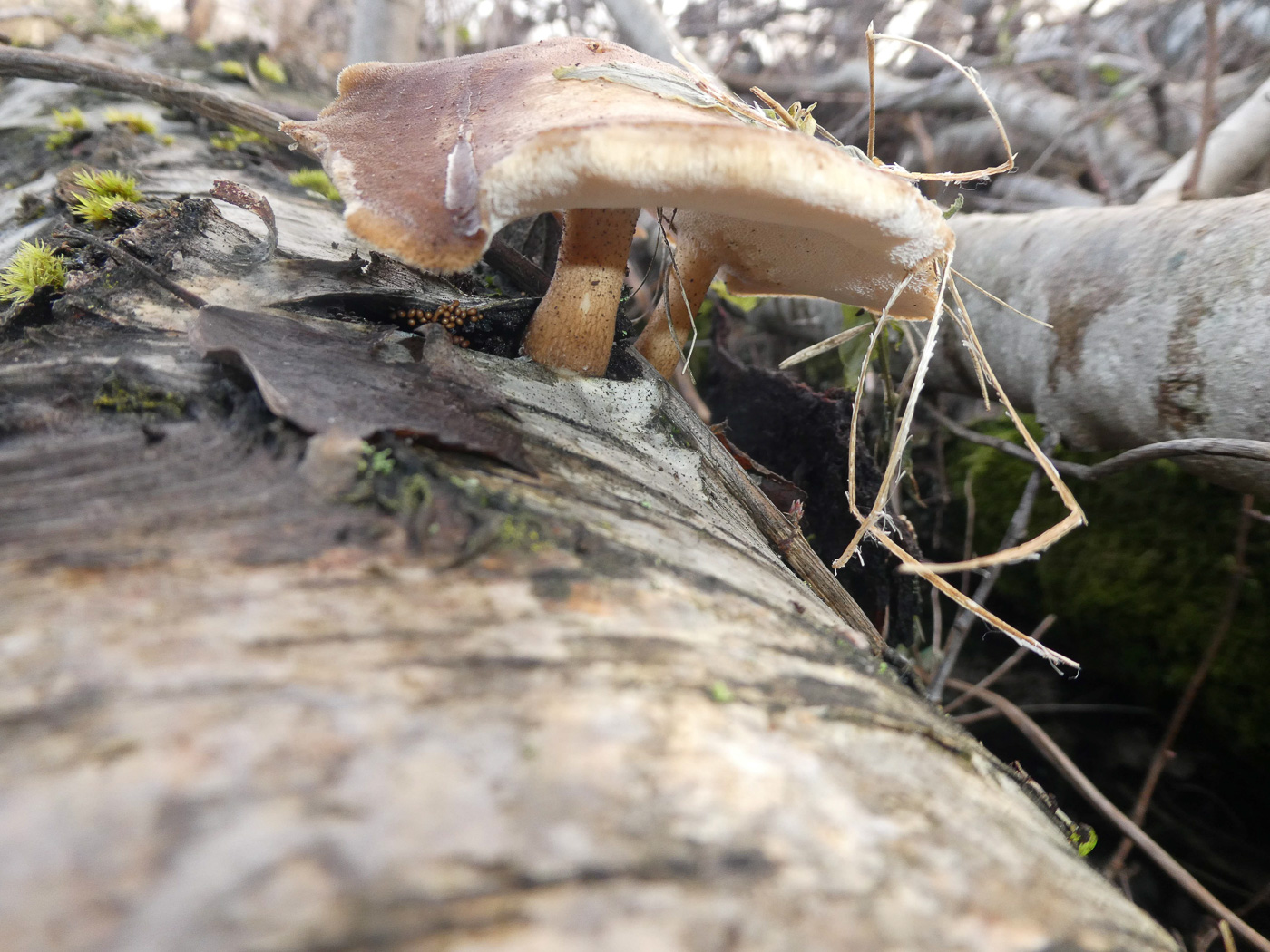

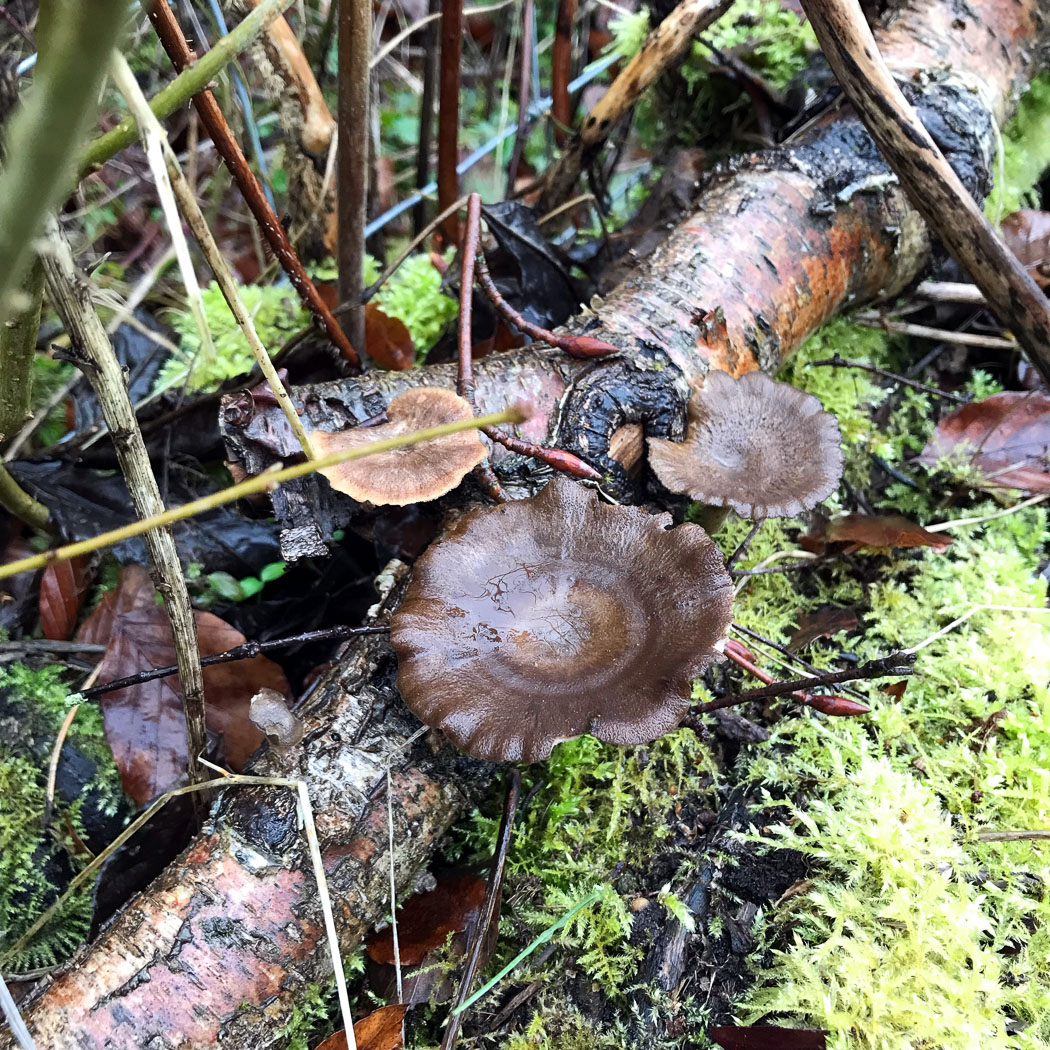
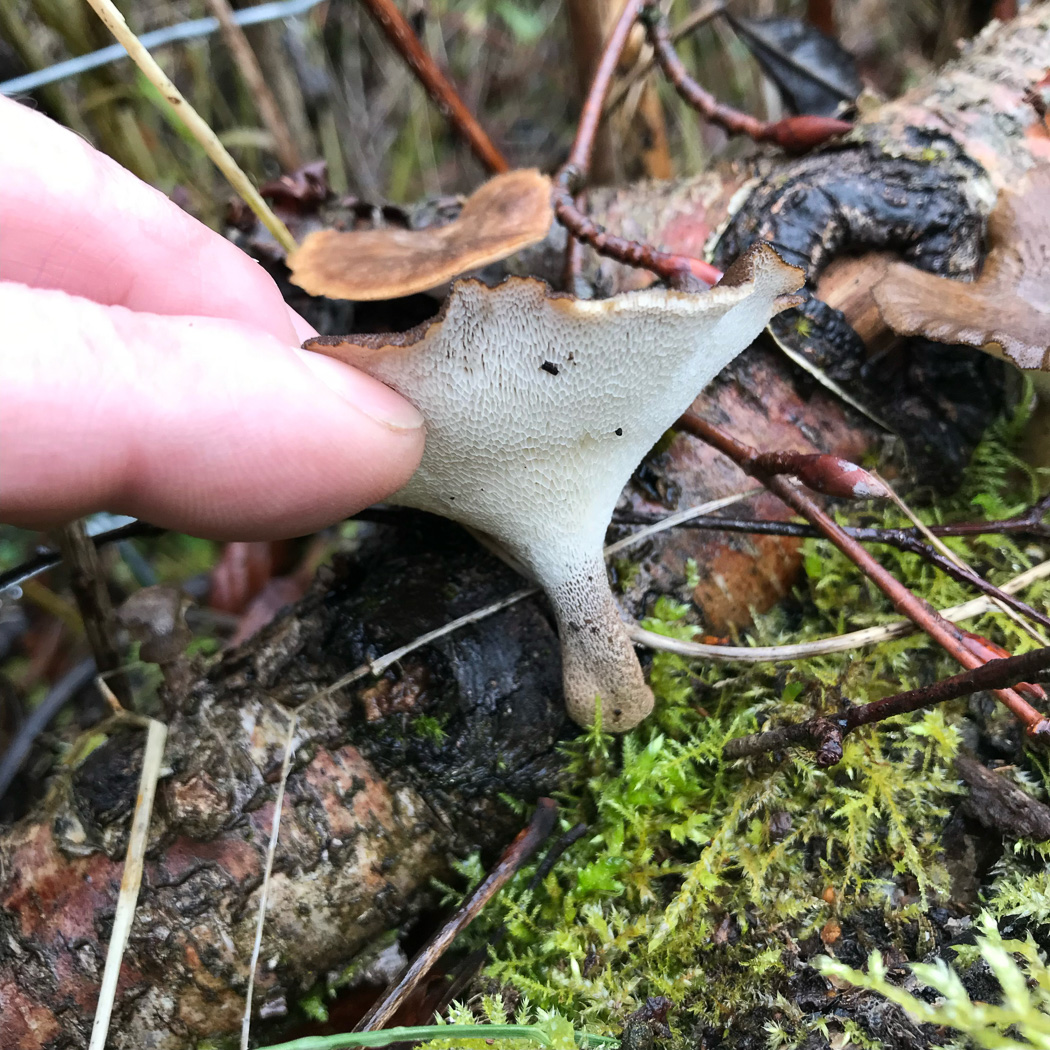
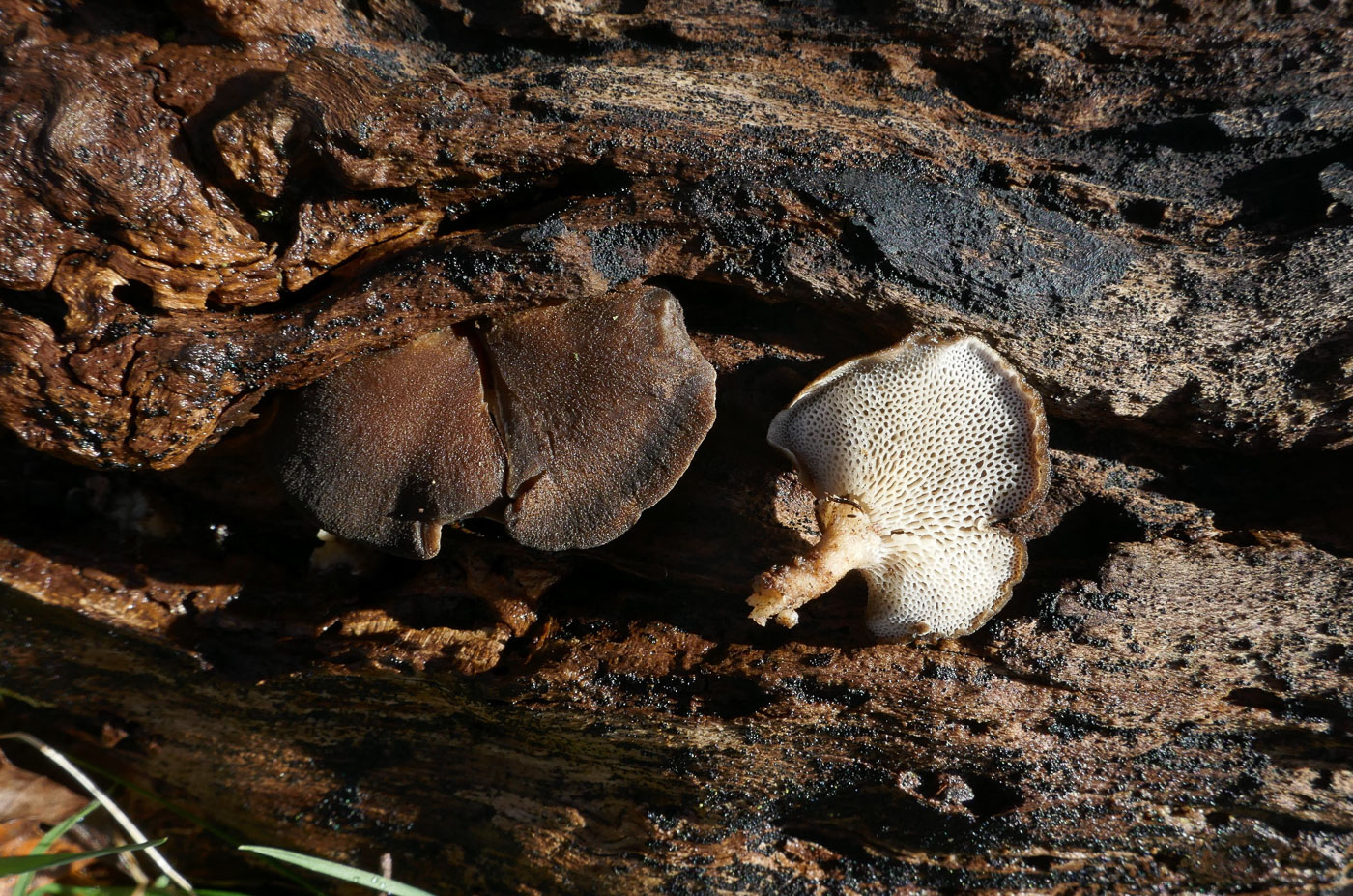
|
Lentinus brumalis (Winter Polypore)
Apr 18, 2023. On a fallen mossy Birch trunk at Burnham Beeches Penny spotted a small cluster of caps, the largest 3 cm's across. Recognising the species she turned the largest one over to reveal the quite large angular pores and relatively smooth margin, these clues together with the darkish brown cap were enough to confirm its separation from the similar L. ciliatus (Fringed Polypore -now confusingly named L. substrictus!). Both these two species, previously in genus Polyporus, are not as common as P. leptocephalus (Blackfoot Polypore - now confusingly moved to genus Cerioporus together with the much larger P. squamosus - Dryad's Saddle.) We have several Finds entries for L. brumalis, all from November - February reflecting its common name.
Dec 29, 2022. On fallen Birch at Stoke Common Jim Wills noticed these Polypores – better known as Polyporus brumalis - which lack the black stem base of the much commoner P. leptocephalus. Though by no means confined to fruiting in the winter months, the species certainly occurs more frequently at this time which helps to separate it from the very similar Lentinus striatulus (previously Polyporus ciliatus) which occurs more frequently in the summer months.
Feb 20, 2022. At Ragpits Reserve, Aston Clinton, Phil Townsend found and identified these polypores on fallen Birch. More familiar as Polyporus brumalis, the species is best described as occasional and fruits most often in the winter months. These are nicely typical examples showing the fulvous brown zoned and frilly edged cap, slightly angular decurrent pores and scaly stem. Note the lack of black at the stem base, a useful indicator for the much more common Cerioporus leptocephalus (also previously in genus Polyporus). True to form like London buses, Jackie Ewan also found L. brumalis at Stampwell Farm four days later on fallen rotting Oak (photo 3).
|

 |
Lentinus substrictus (Fringed Polypore)
Jul 7, 2023. In Rushbeds Wood on a rotten deciduous stick Penny noticed this cap and (turning it over) the pores beneath. Previously known as Polyporus ciliatus - a name which described it well(!) - the species tends to fruit in Summer, lacks the black stem base found in the more common P. leptocephalus though its cap is similarly quite pale, and it does indeed have a fringed margin.
|
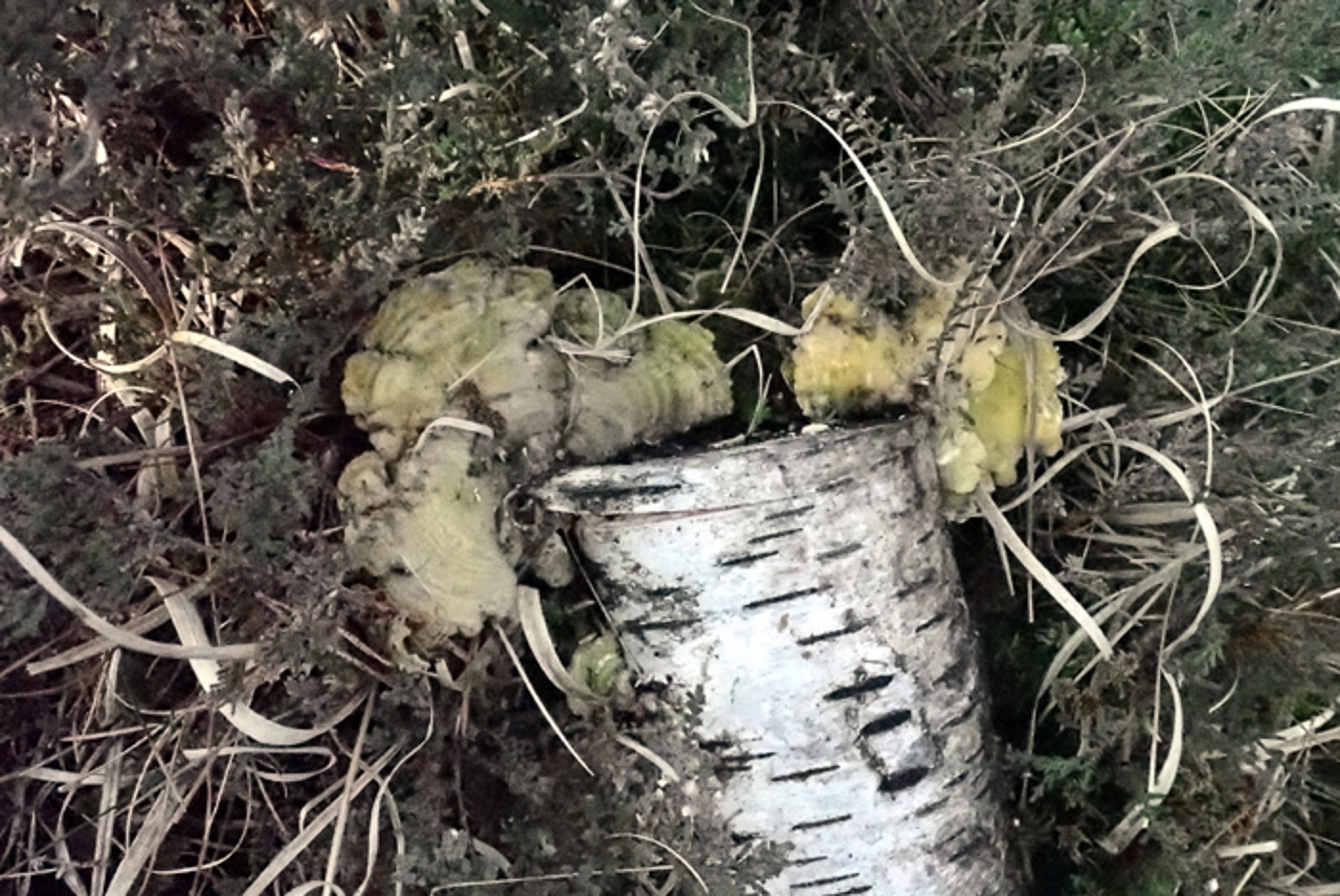
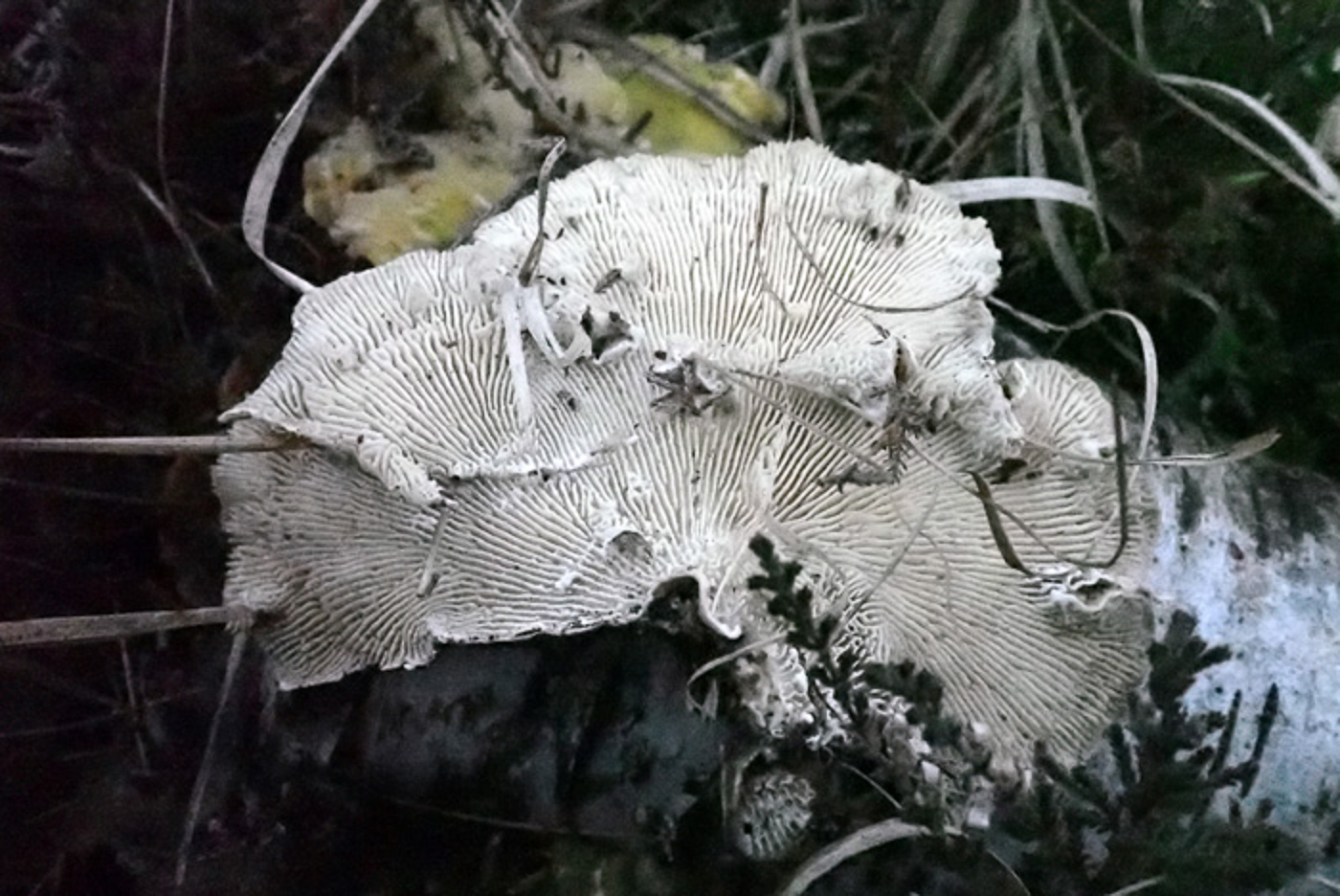
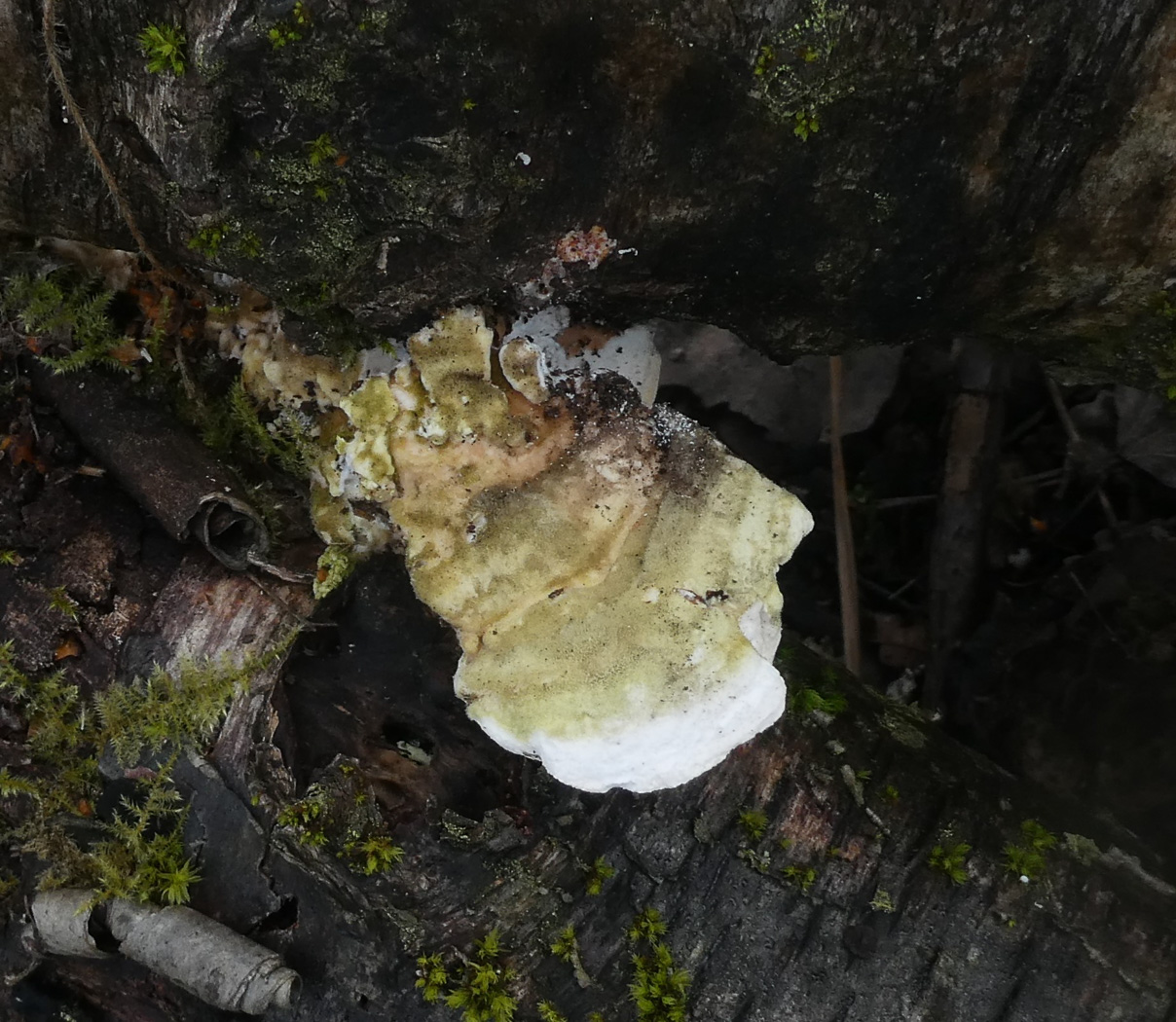
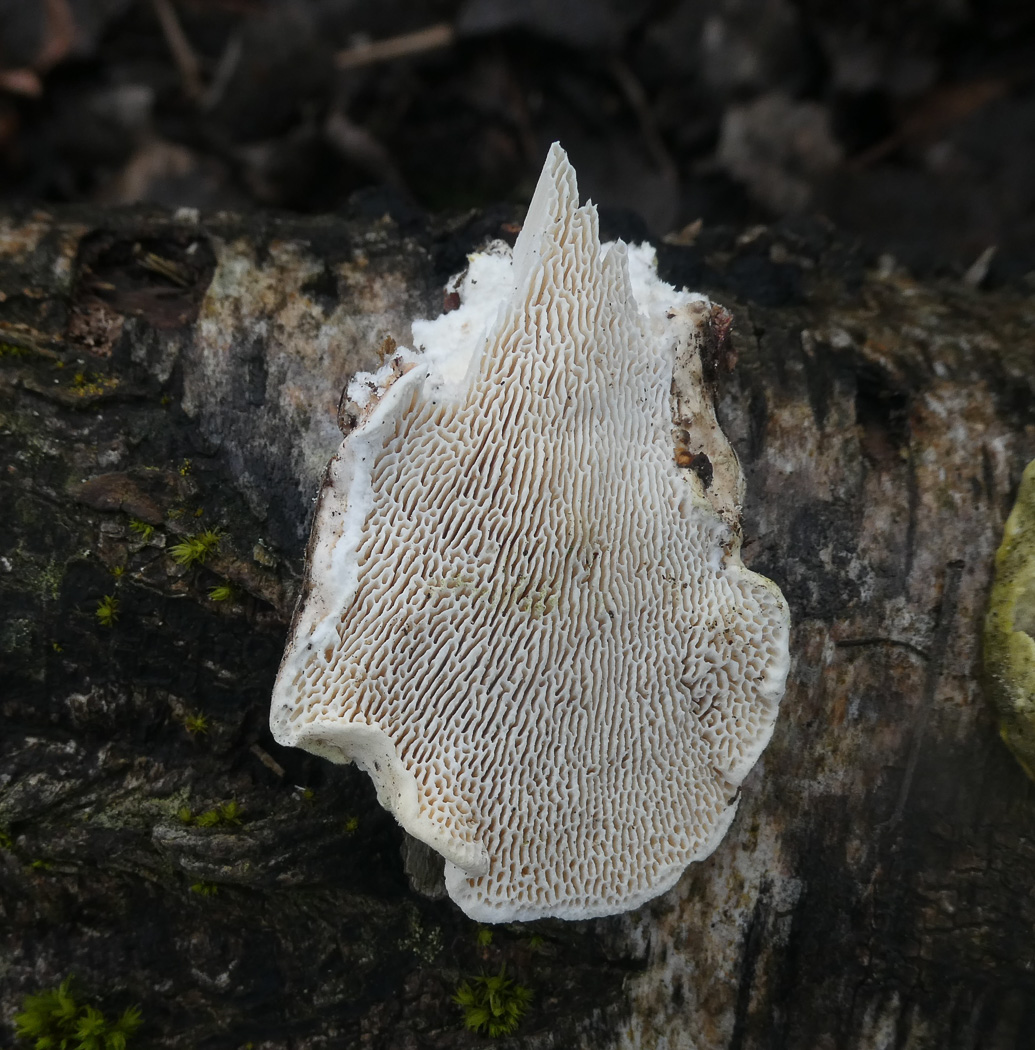
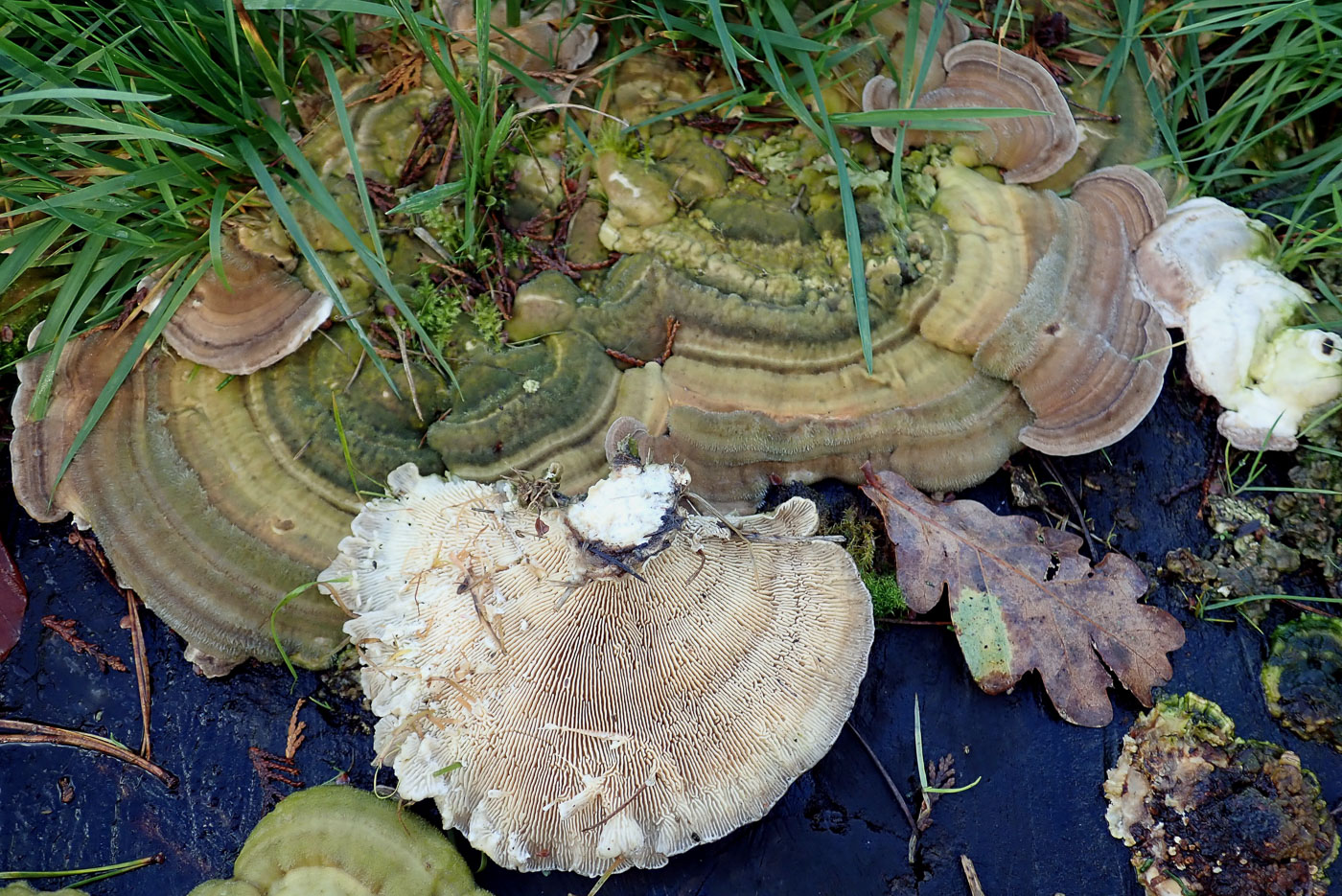
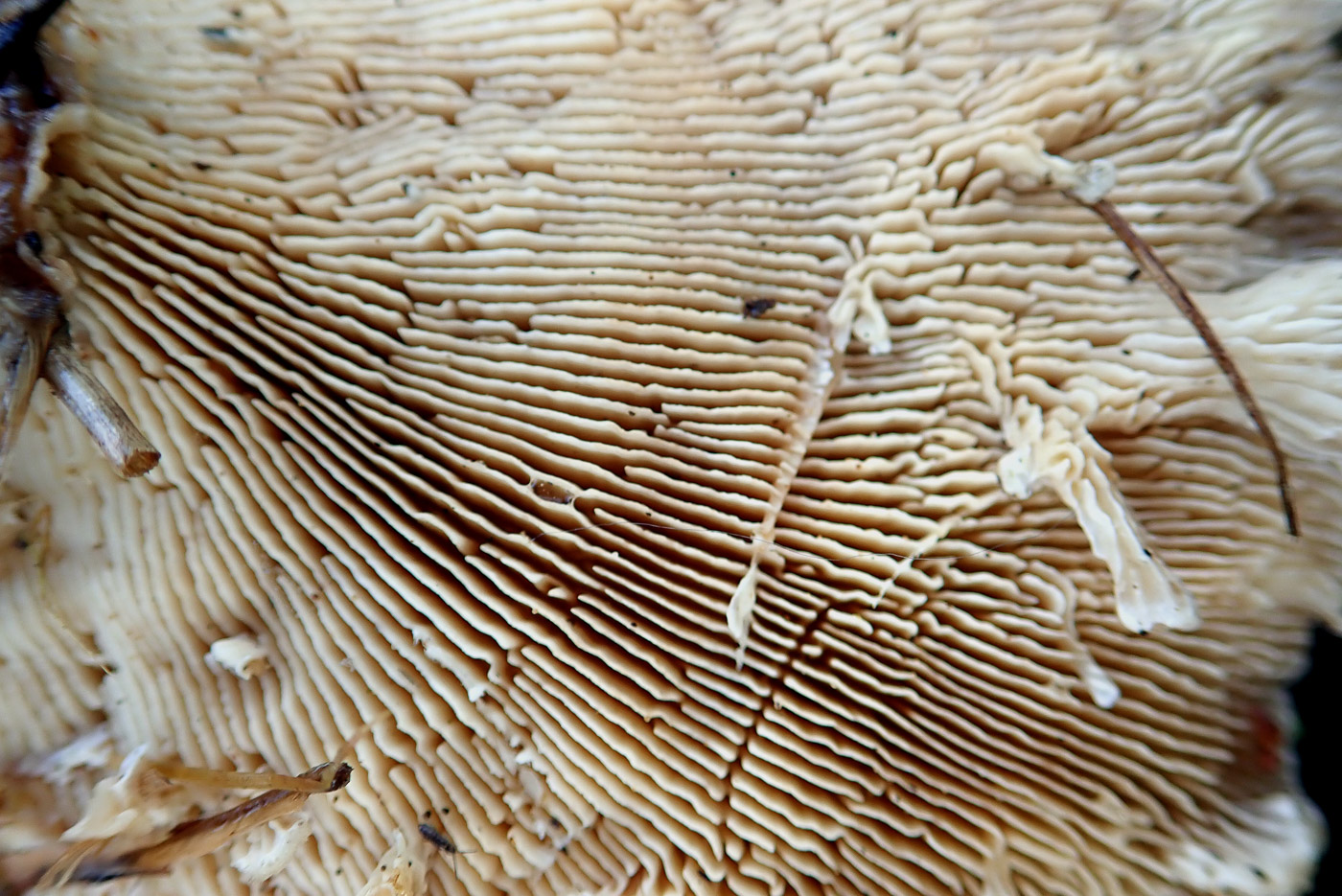
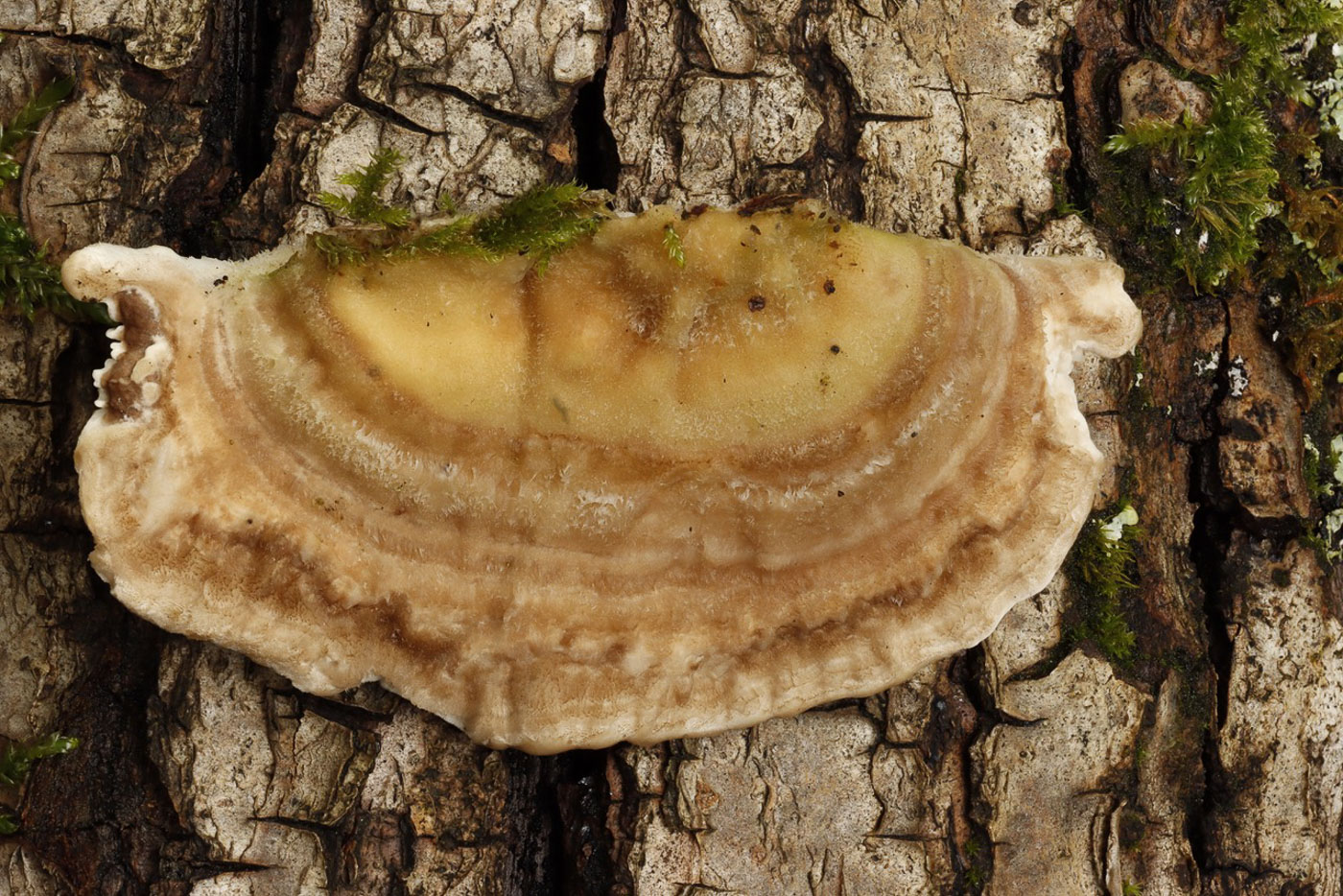
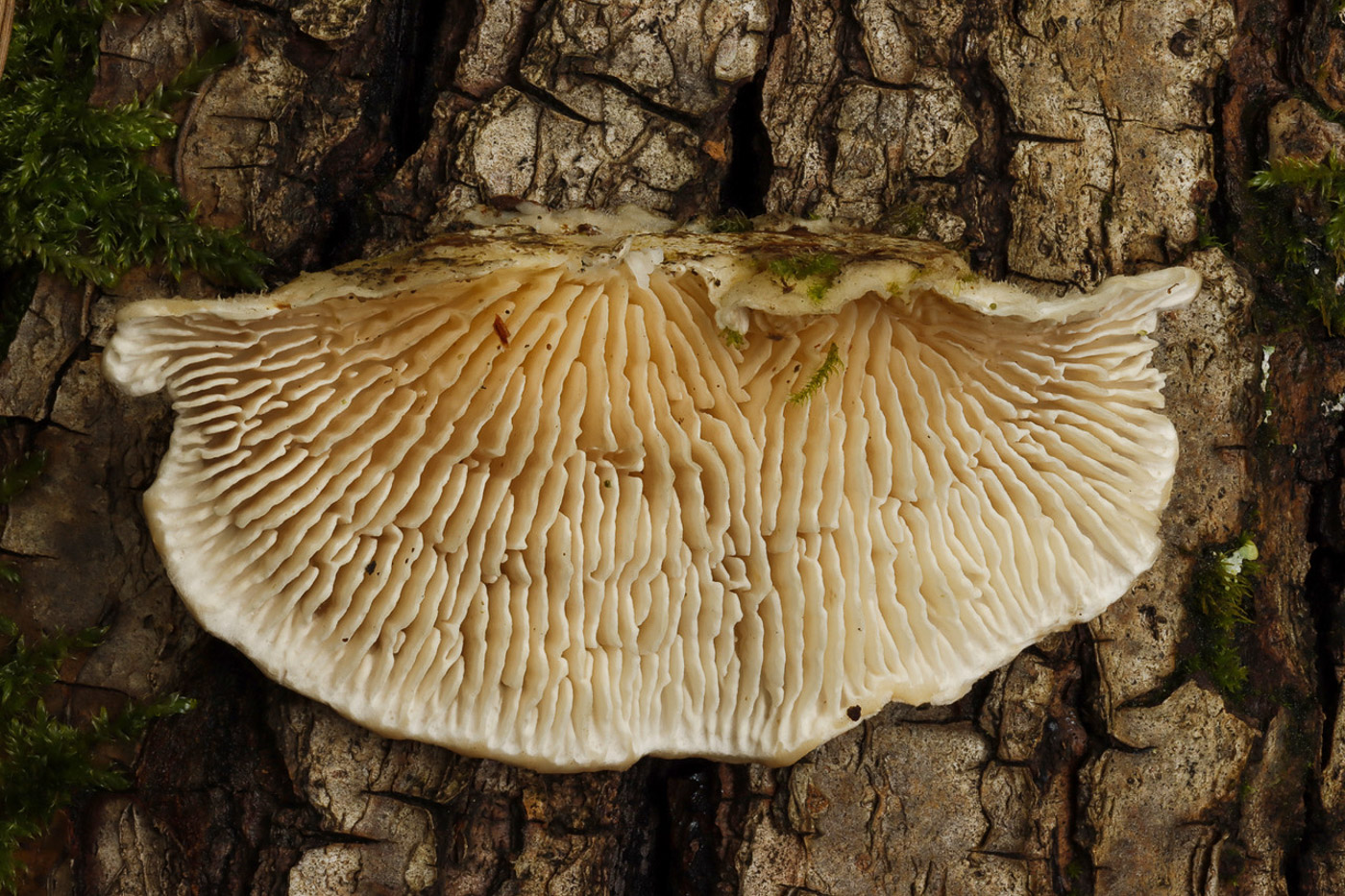
|
Lenzites betulinus (Birch Mazegill)
Mar 23, 2022. On the end of a fallen Birch branch in the Mire at Burnham Beeches Penny noticed this cluster of rather soggy brackets, and turning one over revealed the distinct gill-like ridged structure of this species which helps to separate it in the field from similar brackets such as Trametes. It is considerably less common than that genus but seems to have been becoming more frequent in recent years.
Feb 12, 2022. At Stoke Common on a Birch stump Jim Wills noticed this bracket having almost gill-like labyrinthine pores similar to those found in the very common Trametes gibbosa (Lumpy Bracket). That species is commonest on Beech whereas today's species occurs mainly (but not exclusively) on Birch and is also far less common.
Nov 15, 2020. We have this species already (dated Oct 22nd) but when Penny saw this particularly fine collection of brackets on a sawn off stump in Holmer Green churchyard she though it was well worth including again. Not that common, its upper surface resembles the much more common Trametes gibbosa (Lumpy bracket) particularly when covered in green algi as here and a common occurrence on the Trametes as well. The underside, however, is very different: tough but clearly almost gill-like rather than porous. It can occur on other dead deciduous woods as well as Birch.
Oct 22, 2020. Paul Goby found this bracket on fallen deciduous branch in Naphill Common. This is one of our less common brackets and despite its common name it can be found on deciduous wood other than Birch. It is of medium size, the semicirclular shape and zoning on the top being typical, but it's the underside which is distinctive, having a unique almost gill-like structure. Do not confuse with the Oak Mazegill (which we haven't yet included here) where the underside is clearly maze-like and could not be described as gill-like.
|
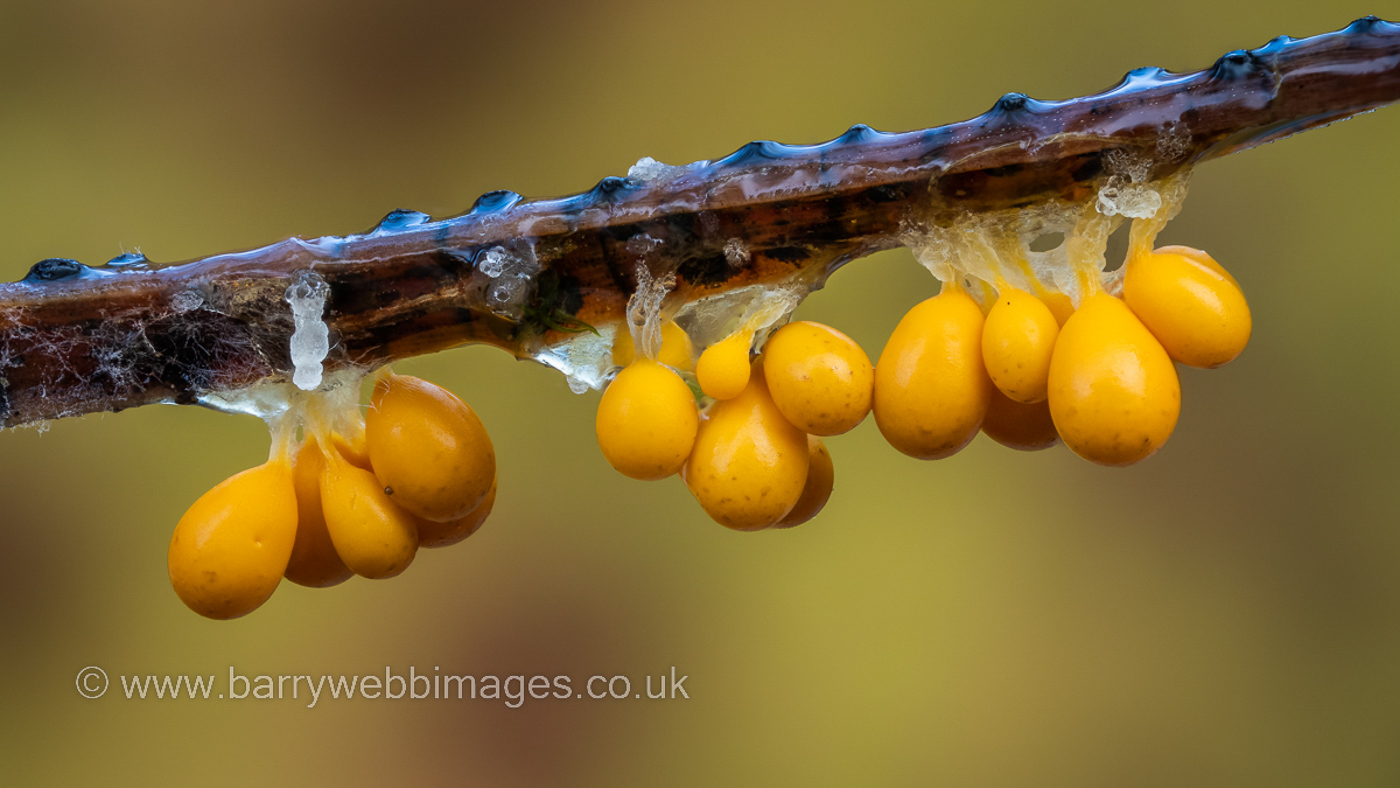

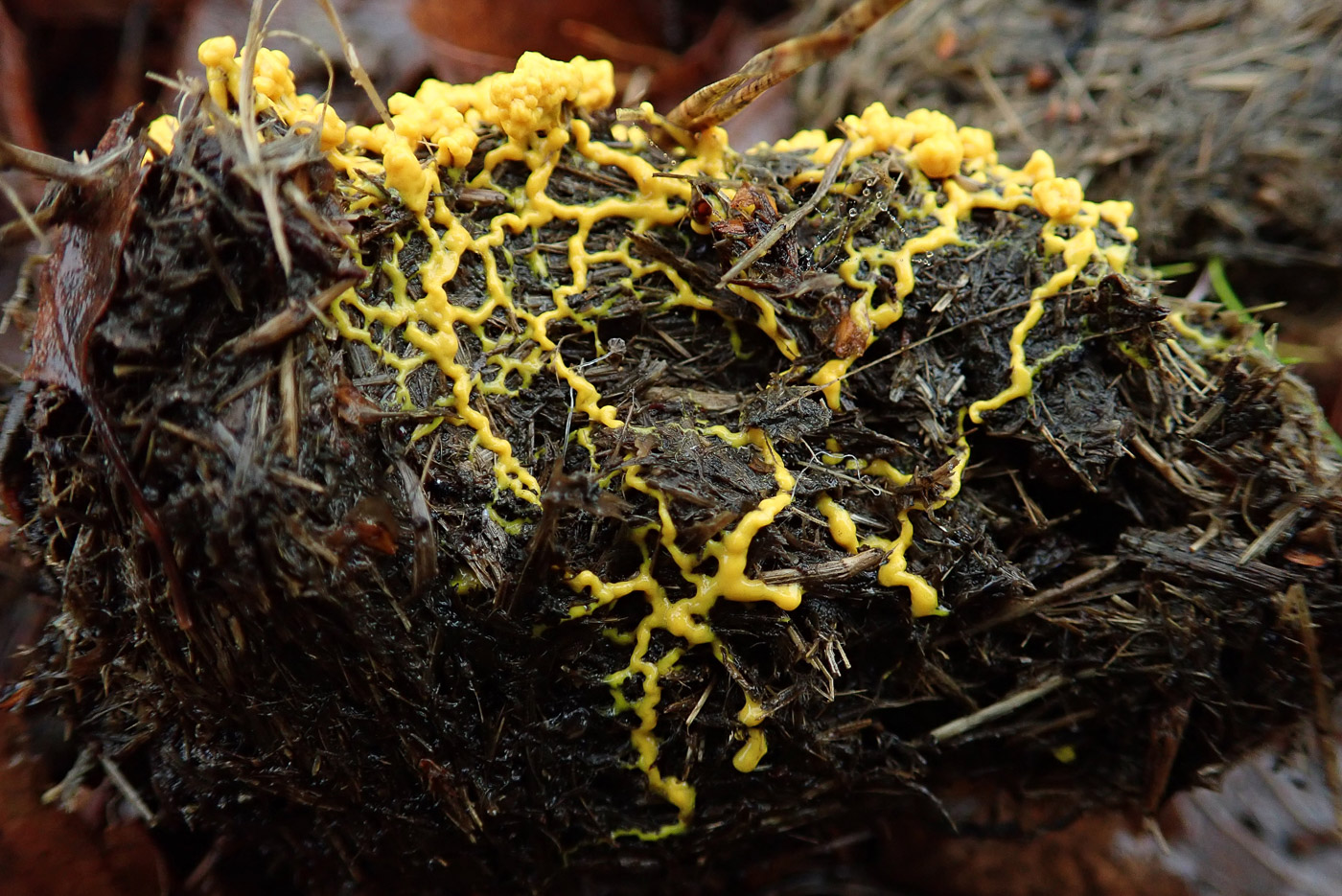
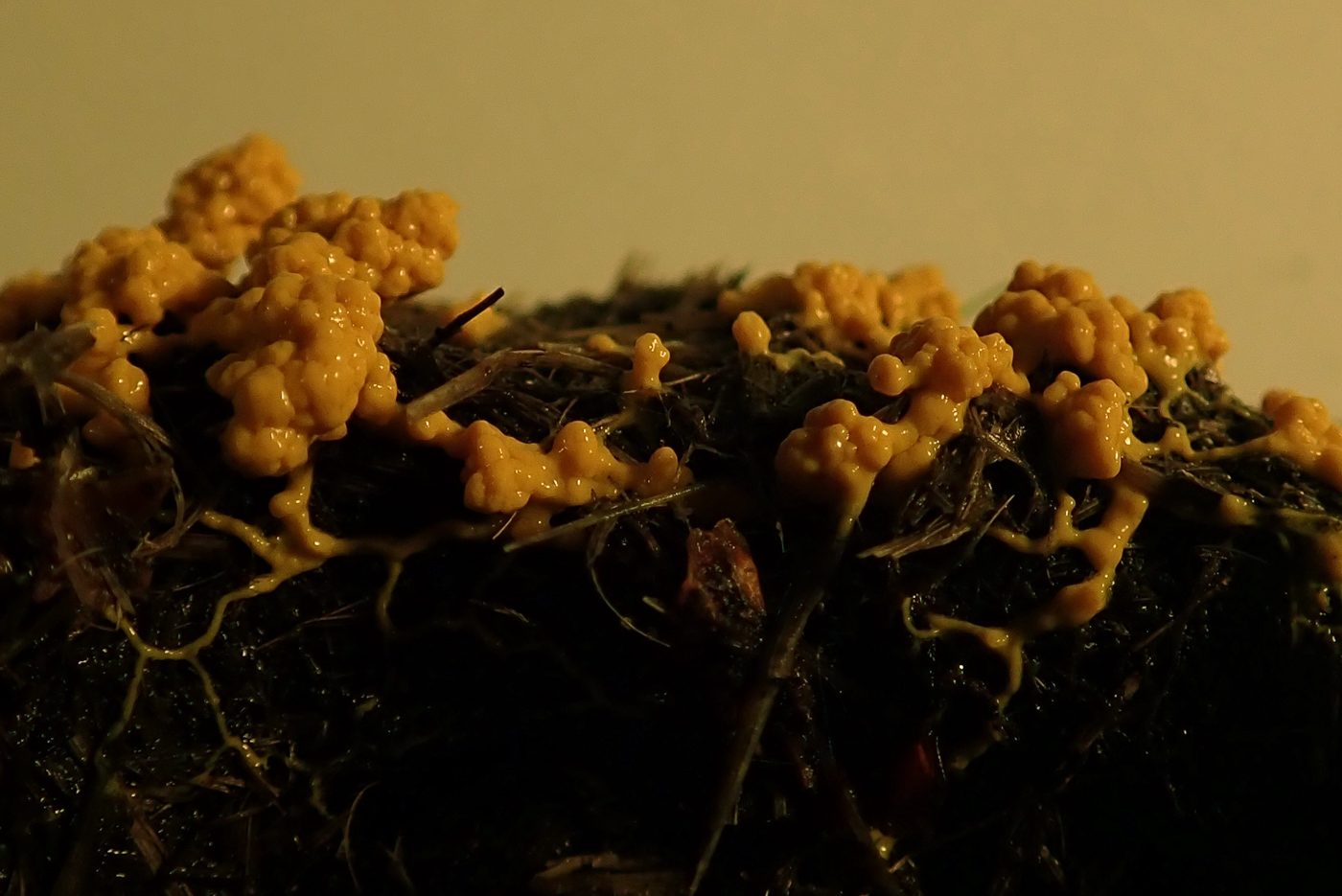
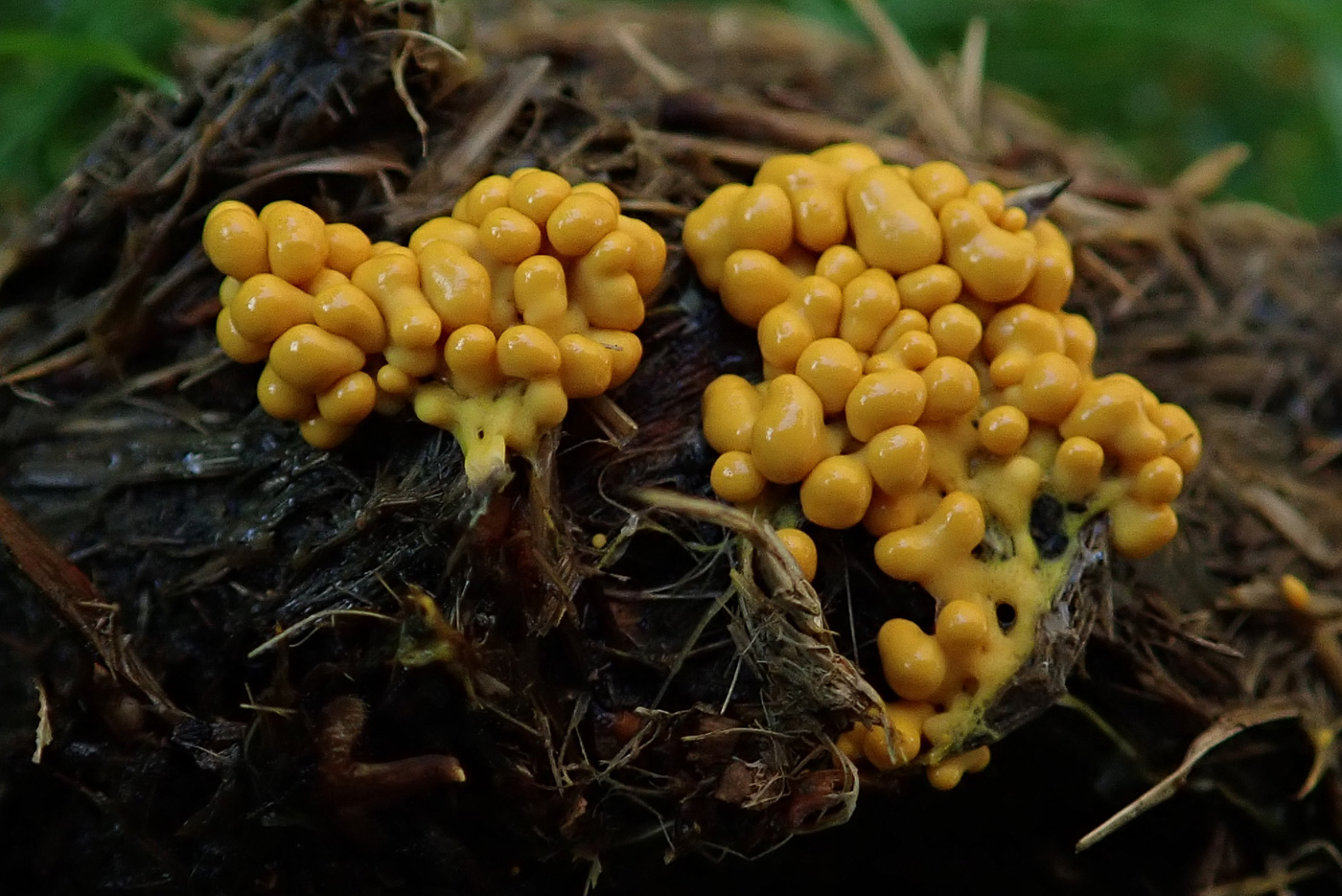
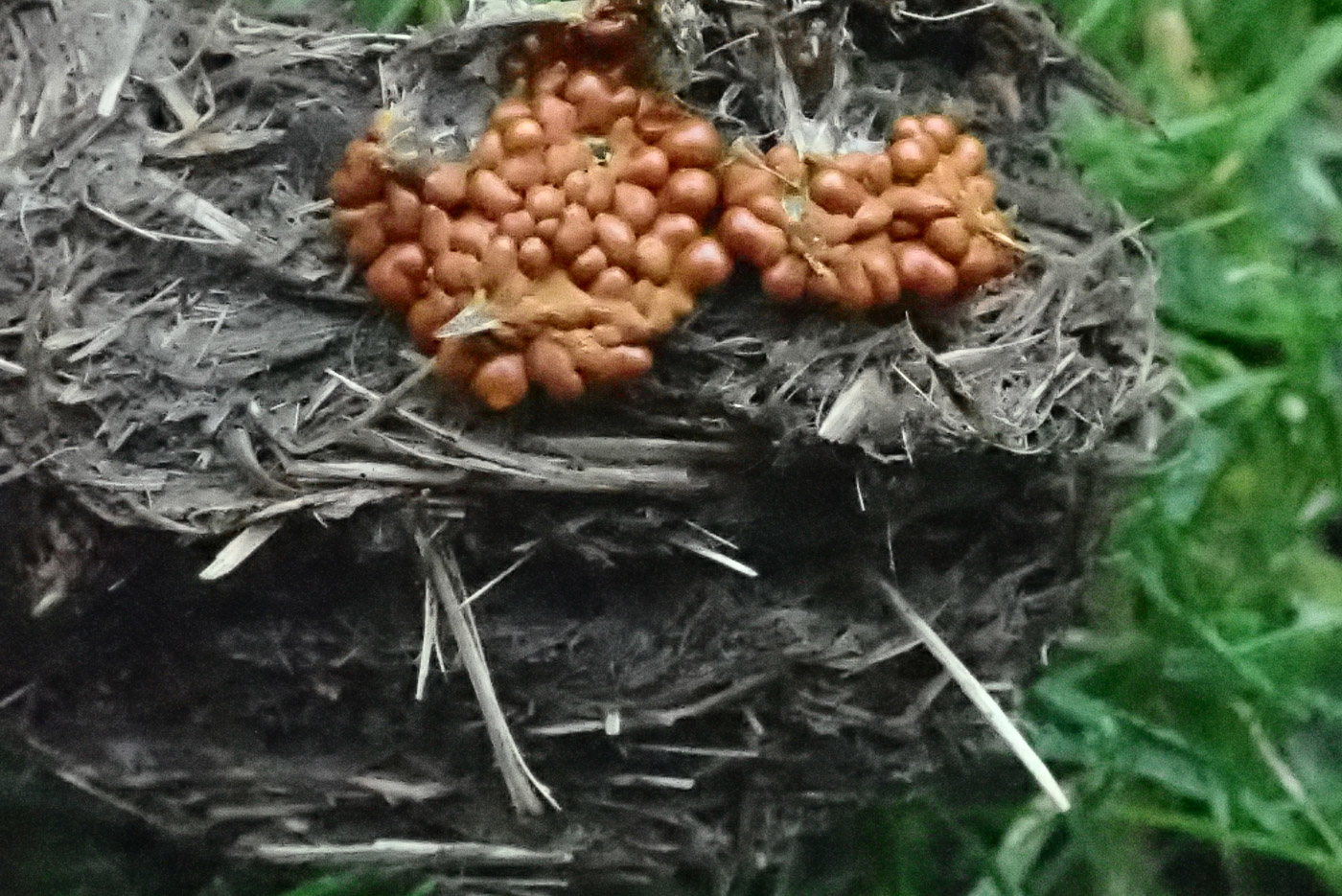
|
Leocarpus fragilis (a Slime Mould with no common name)
Nov 28, 2022. At Burnham Beeches Barry Webb found this quite common Slime Mould growing in plant litter under Pine on the edge of the Mire. Bright yellow in early stages, it swarms over vegetation, liberally coating it, then gradually darkens to chestnut brown when fully mature and photo 2 still has a way to go before that stage.
Dec 2, 2020. Penny C. collected this bright mustard yellow mobile plasmodium spreading over a piece of pony dung in the Mire at Burnham Beeches a couple of days earlier, took photo 1 then collected it in the hope of watching its development. That evening it had settled down and was taking some shape (photo 2) and the following day a definite shape to each fruitbody was visible. It took another day to become the typical shiny chestnut brown of this quite common species and reach the stage at which one can check microscopic features to confirm. An amazing transformation! (Apologies for the lack of focus especially on the final photo!)
|

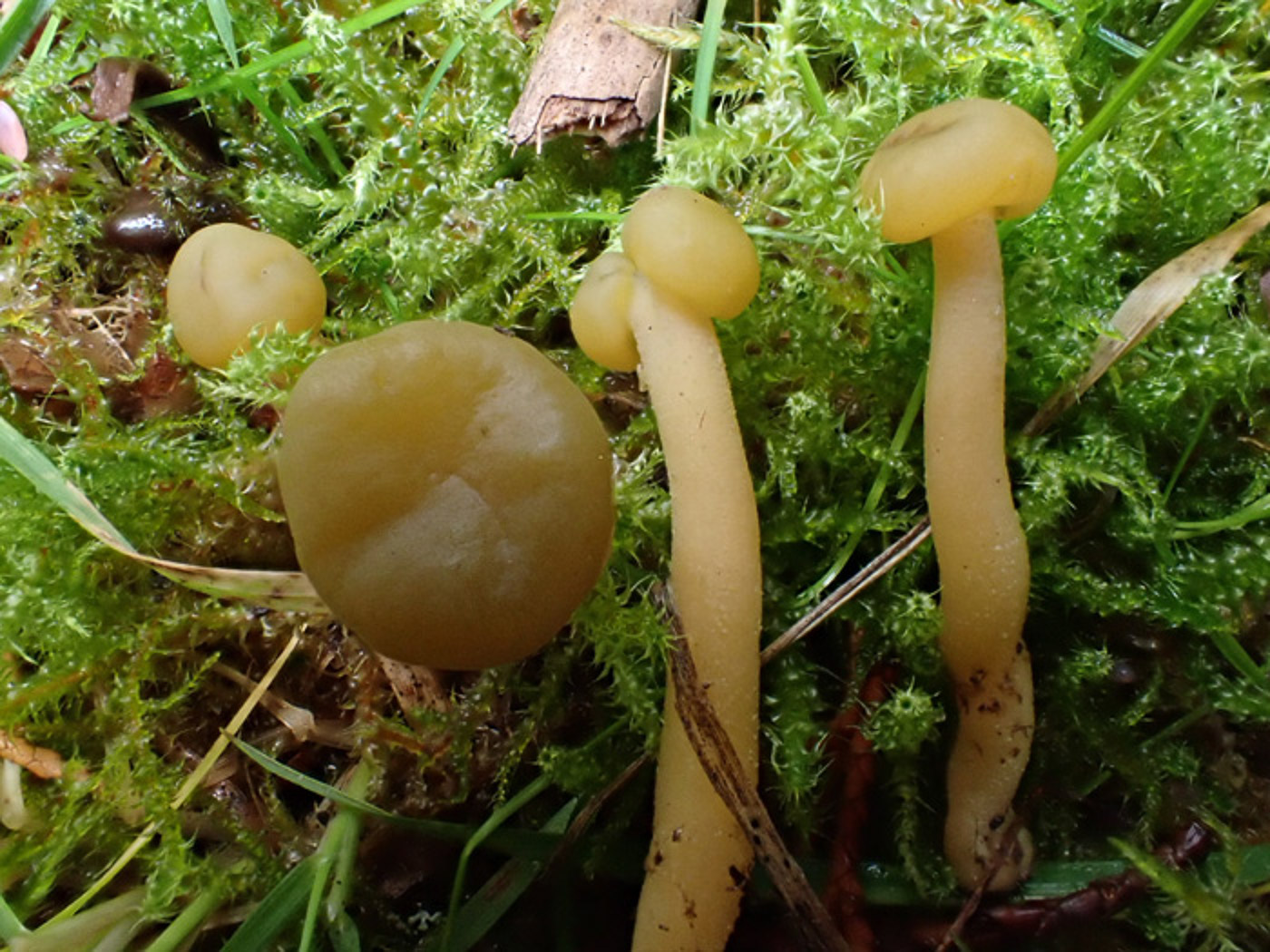
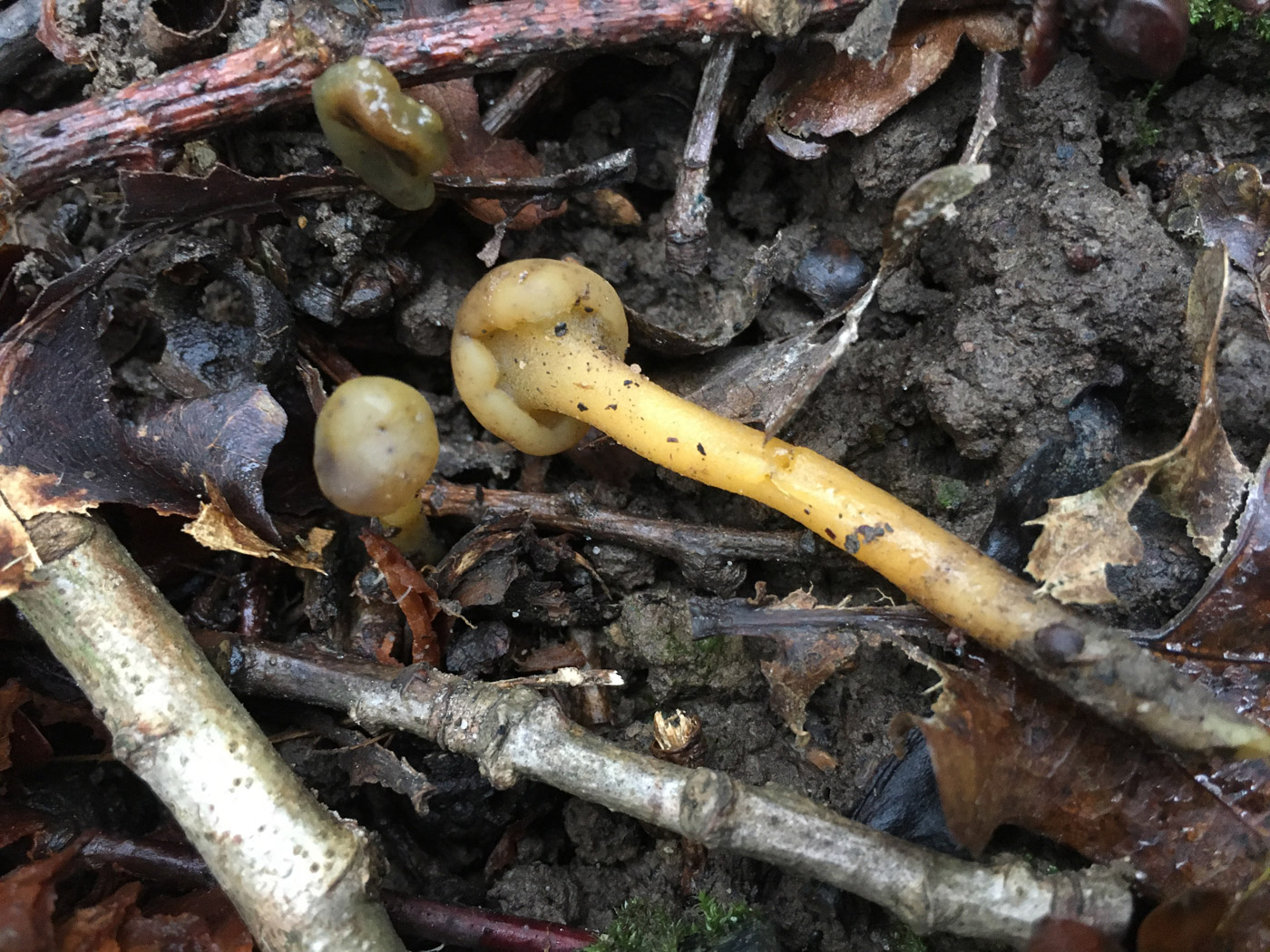
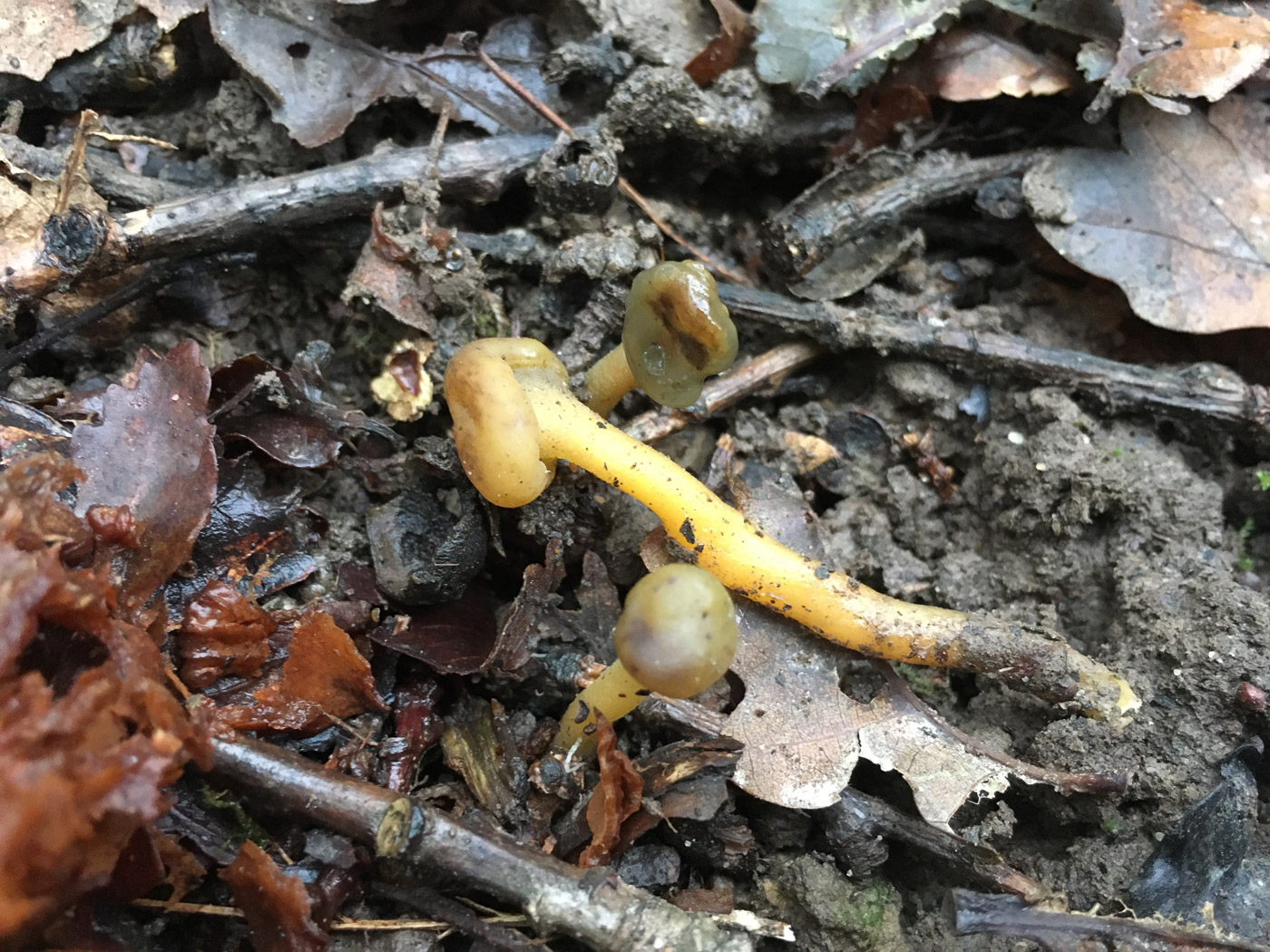
|
Leotia lubrica (Jellybaby)
Aug 21, 2023. At Burnham Beeches Barry Webb noticed this species which, though looking like a gilled mushroom as yet unopened, is in fact an Ascomycete. It never uncurls much more than is seen here, and the rubbery olive green top with yellow greasy stem is typical - a bit like a giant Bog Beacon (though that tiny species is confined to wet marshy areas in Spring). Jellybabies can sometimes occur in large numbers woodland glades and path edges.
Oct 27, 2022. At Stoke Poges Memorial Gardens Stephen Plummer found a few of these long stemmed Ascomycetes which appear initially to be mushrooms but there are no gills underneath the caps which are soft and gelatinous as their common name suggests. They are not at all rare but occasional fruiters in mossy places, banks in wooded areas and grassland.
Nov 1, 2020. Russell Ness found just a couple rather bedraggled of specimens of this interesting but quite common Ascomycete species in litter in Egypt Woods (Burnham Beeches). At first glance this looks like a young mushroom yet to open up and reveal its gills, Cantharellus tubaeformis (Trumpet Chanterelle) can look extremely similar in early stages! However, this species does not have gills and as the name suggests is somewhat rubbery and flexible, having a yellowish stem and a small yellowish to greenish head. Sometimes found in large troops in woodland or grassy litter.
|
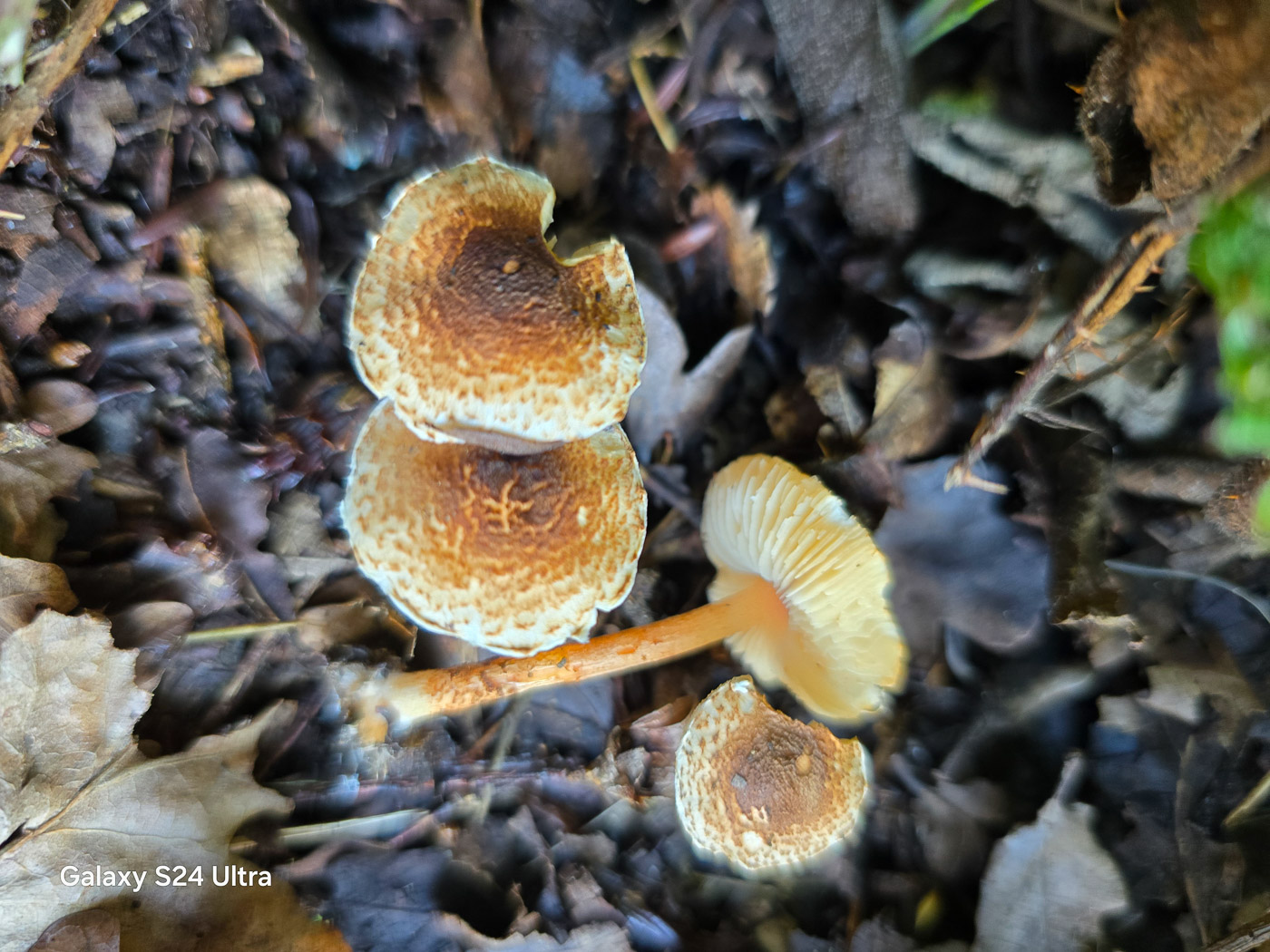
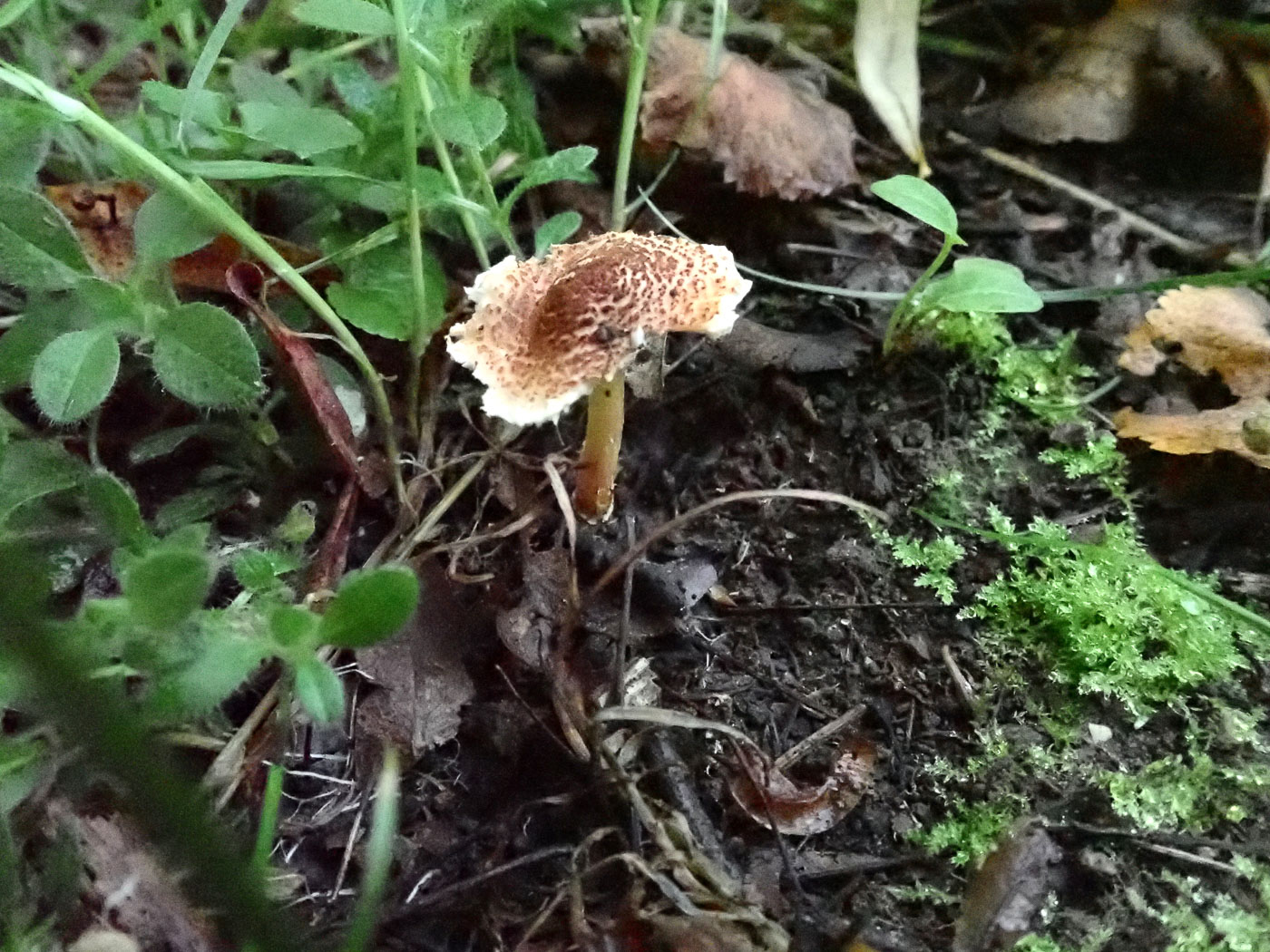
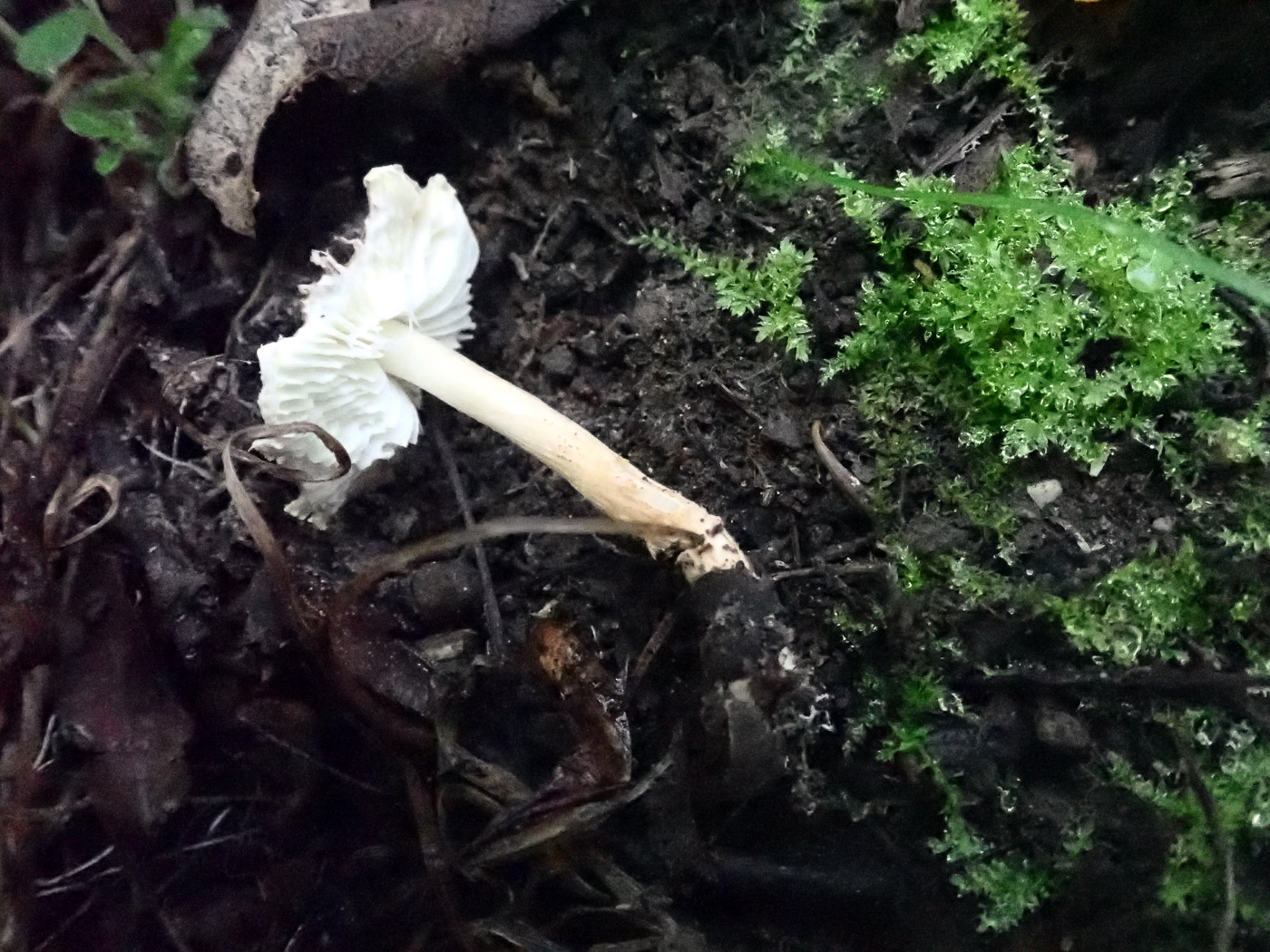 |
Lepiota castanea (Chestnut Dapperling) 
Oct 18, 2024. In Gerrards Cross Jesper Launder found this attractive species in litter. Similar to the much more common L. cristata (Stinking Dapperling) in size and shape, it not only lacks the smell of that species but has a thicker covering of small richer brown scales.
Oct 6, 2022. Under the Limes at Turville Heath Penny spotted just one slightly damaged cap belonging to this species amongst the thick leaf litter, but it was instantly recognisable from its small size and rich chestnut scaly cap. The white 'free' gills of the genus help to confirm the ID, as does the lack of unpleasant smell associated with the much more common and paler capped L. cristata (Stinking Dapperling). Surprisingly the species seems to be new for Finds.
|


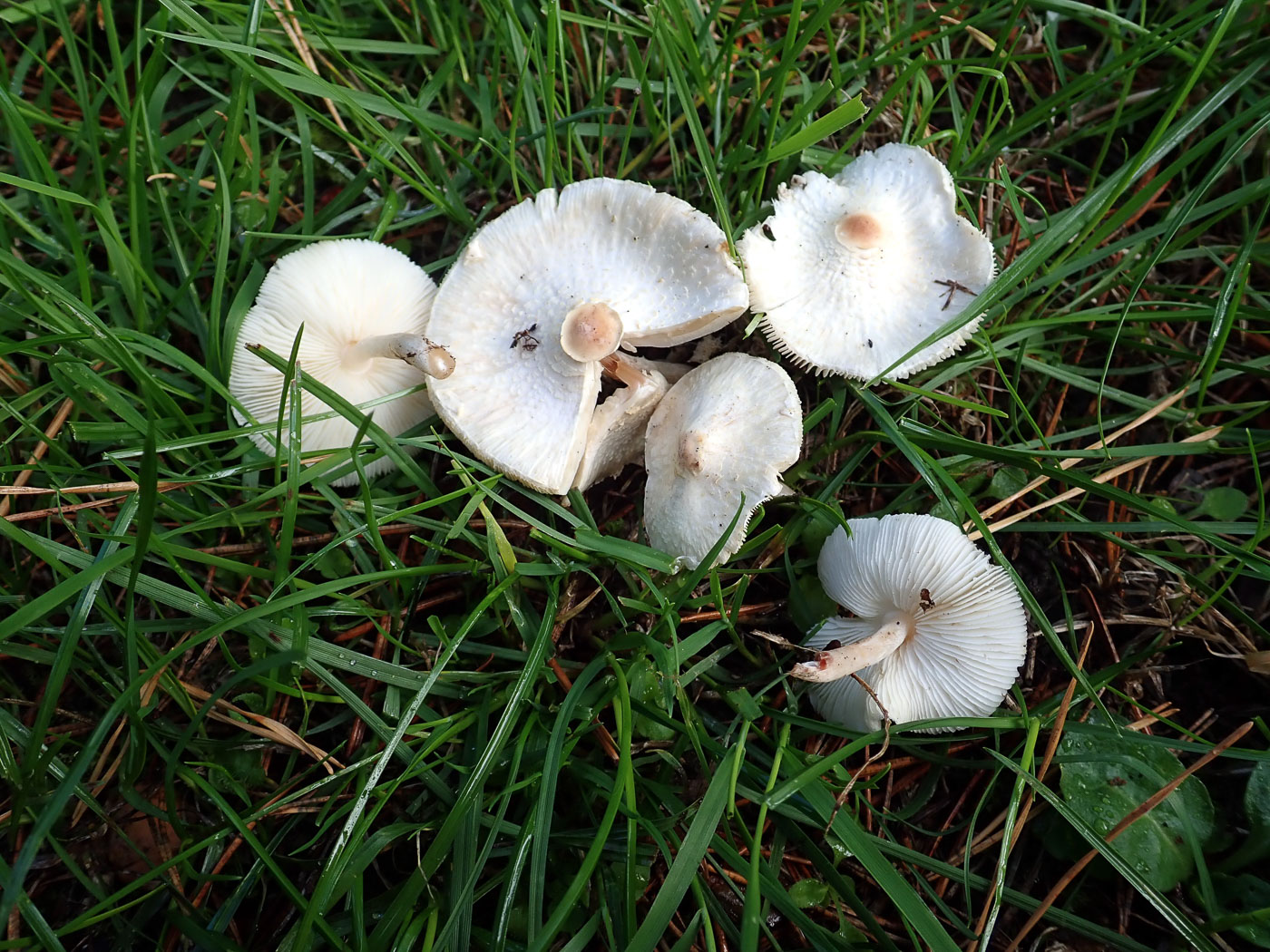
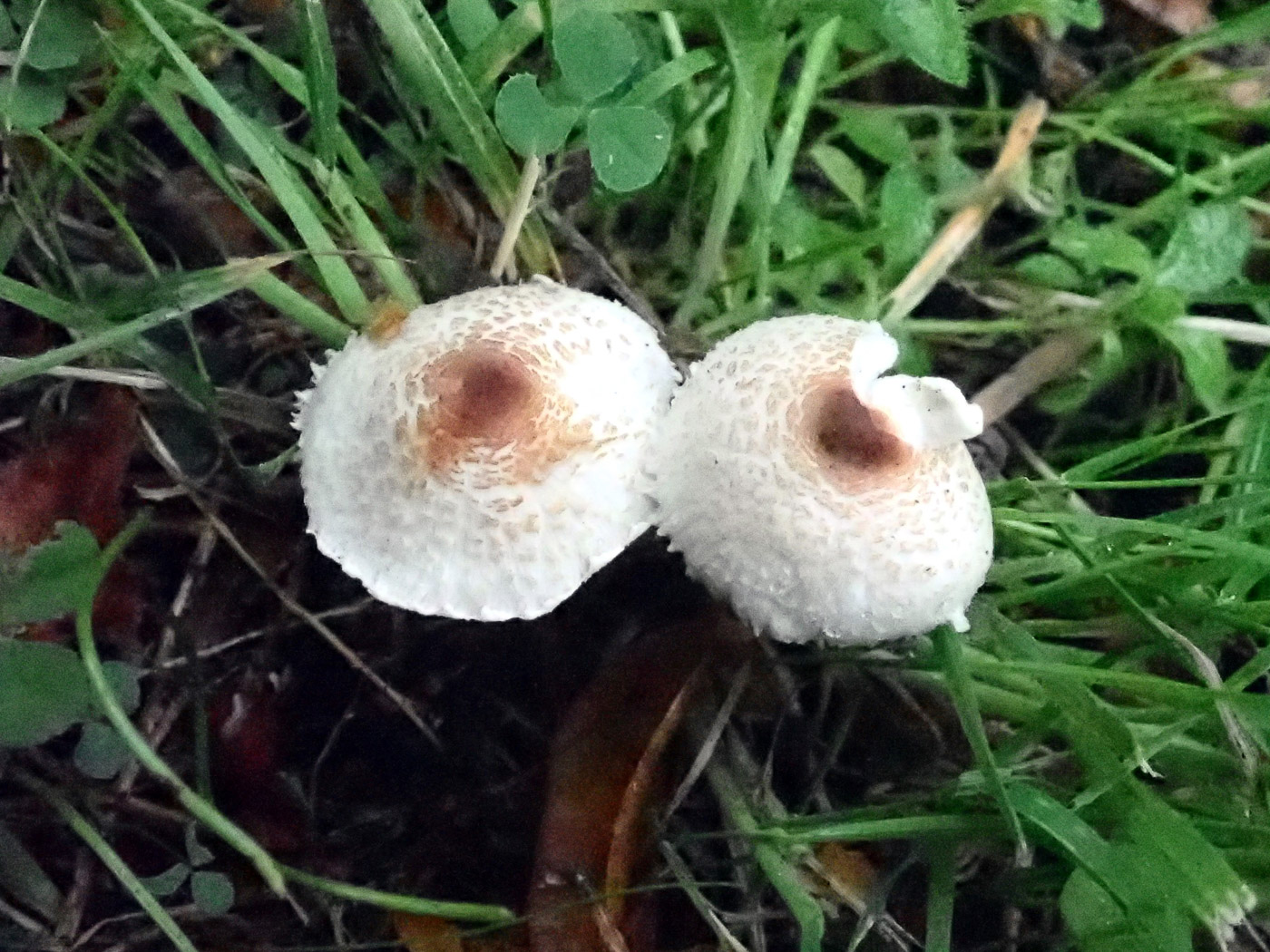
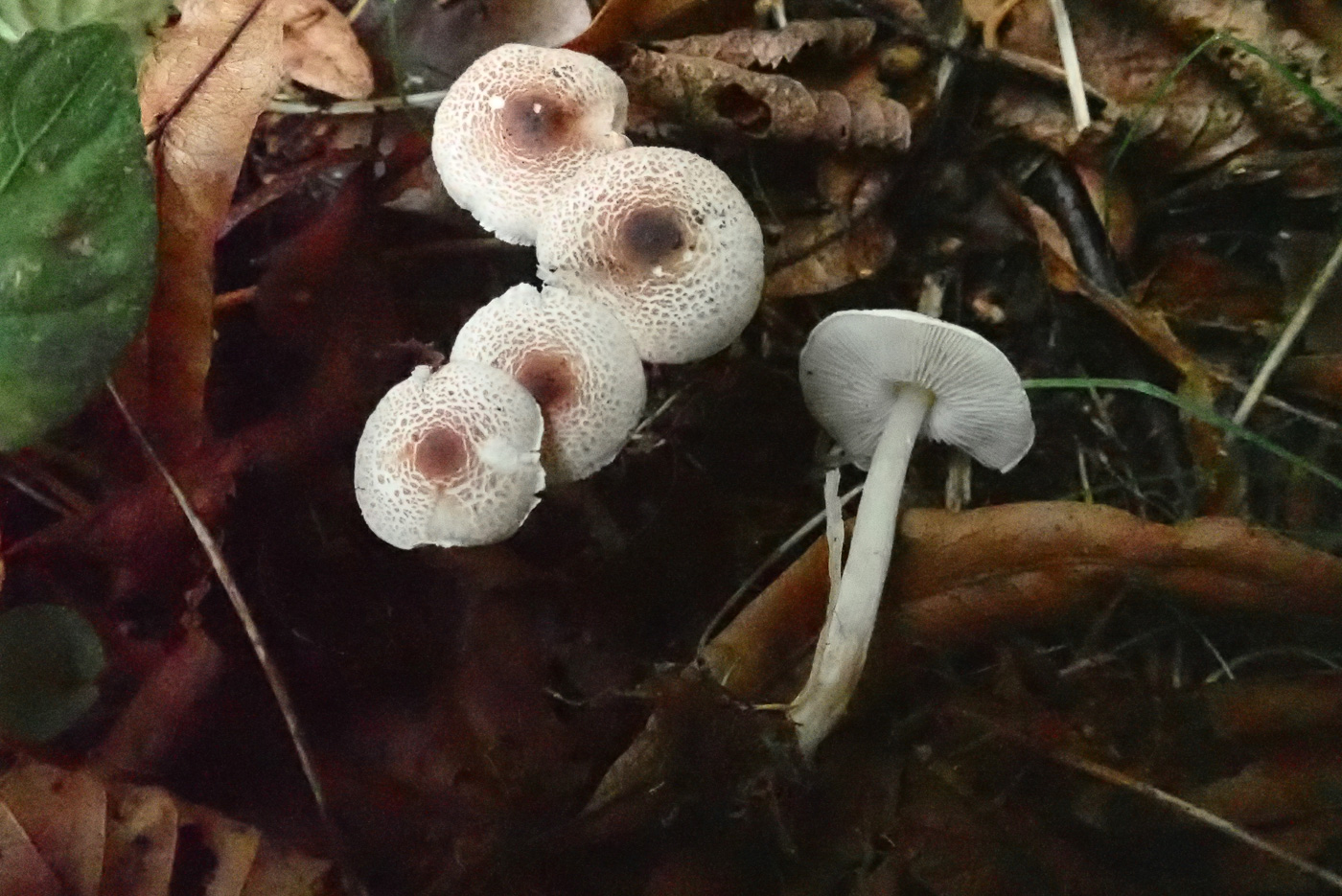
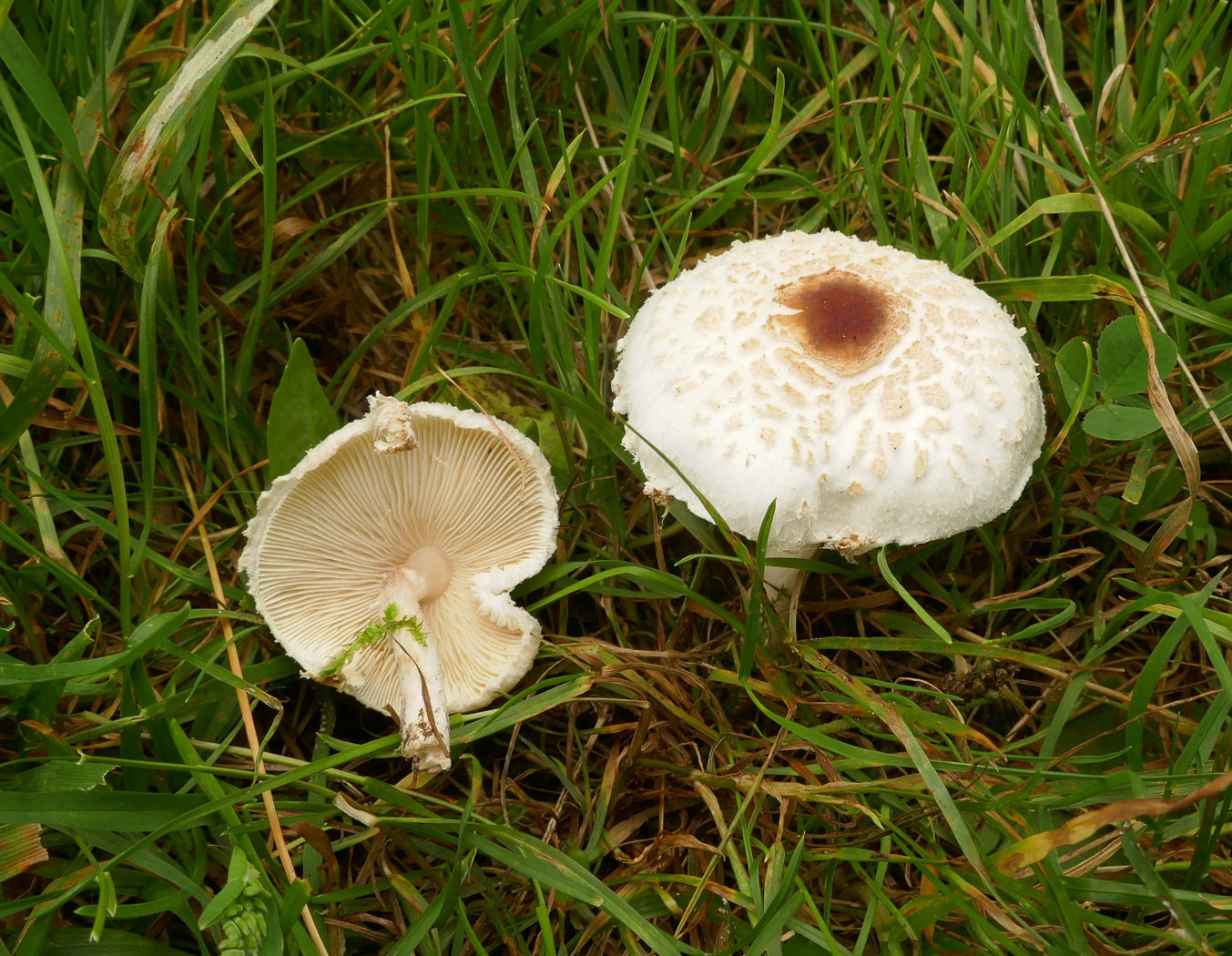
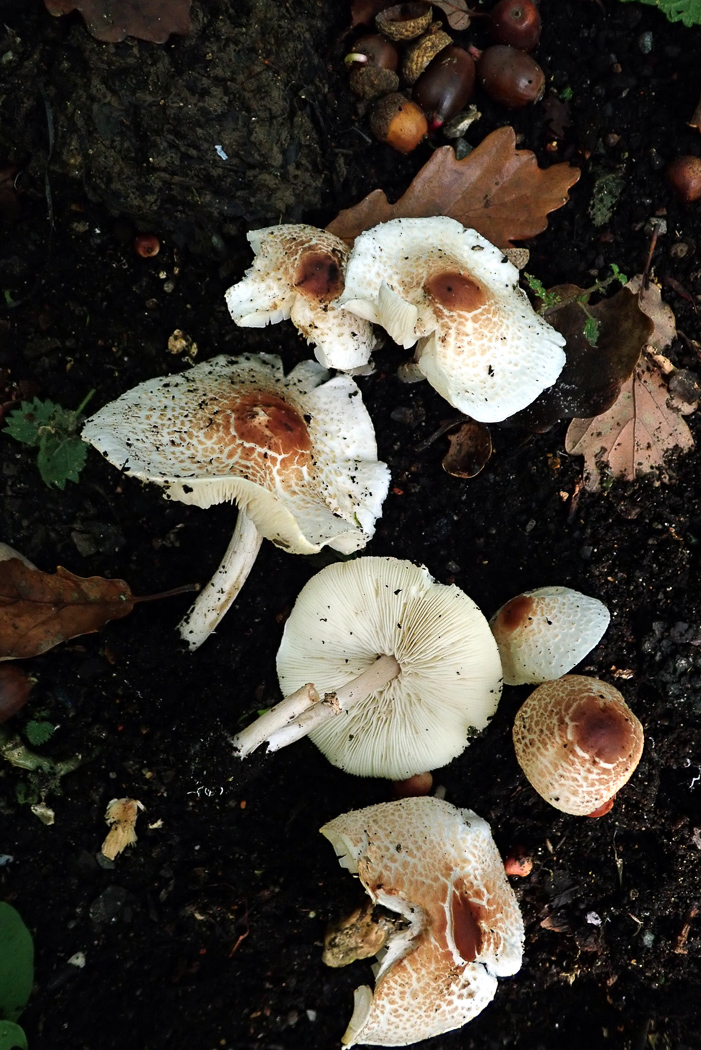
|
Lepiota cristata (Stinking Dapperling)
Jul 28, 2023. At Stampwell Farm in grassy litter Jackie Ewan found this trio both looking and smelling typical of this perhaps our commonest Dapperling. See the Masterlist for further examples.
Jul 17, 2023. In a grassy roadside verge at Turville Heath Penny found this common autumn species was just beginning to make an appearance. If the white free gills, white finely scaly cap though increasingly brown towards the centre and small size (usually under 2.5 cms across) are not sufficient to suggest its name, the unpleasant soapy smell should clinch it.
Sep 27, 2022. In the middle of a grassy track at Turville Heath Penny spotted this cluster of small very pale Dapperlings which to her appeared extemely pale for L. cristata (photo1). On collection, however, the unmistakeable smell of that species was present though she knew that a few others in this genus also share that smell. Later on in a less exposed spot she found two more (photo 2) which looked exactly right for the species, having the brown centre gradually splitting up in decreasing patches over the cap surface, also a ring on the stem. At home both collections revealed the same spores and gill cells, proving yet again how one species can vary from collection to collection.
Oct 12, 2021. At Turville Heath in soil in the Lime avenue Penny found this cluster of nice fresh Dapperlings, a member of a genus which has been hard to find so far this autumn. Normally a very common woodland species, this is quite a small Dapperling with caps here only about 2.5cm across though it can get up to 5 cm or so. It has a flattish cap with rich brown centre and white surrounding area having contrasting brown scales, though there are other quite similar species which also have the white free gills of this genus, some retaining a ring on the stem, some as this one often losing it. The smell of this species, however, is distinctive (though not really stinking!): pungent, unpleasant, of burnt rubber.
Sep 2, 2021. At Stampwell Farm in one of the paddocks Jackie Ewan found these two small Dapperlings and instantly put one to her nose to check for the unpleasant pervasive rubbery smell of the species. She also checked the spores because there are other quite similar Dapperling species which have this smell to a lesser extent. This is a common species found in woodland (often along paths) as well as other grassy areas, the cap getting to about 3cm across typically with a brown centre but elsewhere whitish with brown scales, the gills are white and free as in all of this genus, and the stem has a ring.
Oct 16, 2020. Alison Peace found a nice collection of this common - yet scarce so far this season - Lepiota on a large rotting woodchip heap in Burnham Beeches (photo Penny C.) This particular heap has produced many interesting species over the years but today this was the sole representative. The caps were a good size, up to 4 cms across, and displayed the typical bright chestnut central area fading rapidly to white at the margin with some dotted scales in between. Gills are very crowded and free of the top of the stem, which has a ring when young but tends to lose it as it matures. Once familiar with its strong unpleasant rubbery smell it makes separation from other similar Lepiota species easier.
|
 |
Lepiota echinella (a Dappperling with no common name) 
Nov 2, 2023. In St. Giles churchyard Stoke Poges Jesper Launder found and later identified this unusual Dapperling, one for which we have just two previous county records, one of those from the adjacent Memorial Gardens back in 2018. This is anew entry for Finds.
|
 |
Lepiota felina (Cat Dapperling) 
Oct 26, 2023. Under Spruce and Oak in Bernwood Forest Penny spotted this small to medium sized Lepiota, the surprisingly dark cap center of which caught her attention. Though quite similar in appearance and smell to the much more common L. cristata (Stinking Dapperling) this occasional species not only has differently shaped spores but dark brown to black scales which also mark the edge of the ring on the stem. This is a new entry for Finds.
|
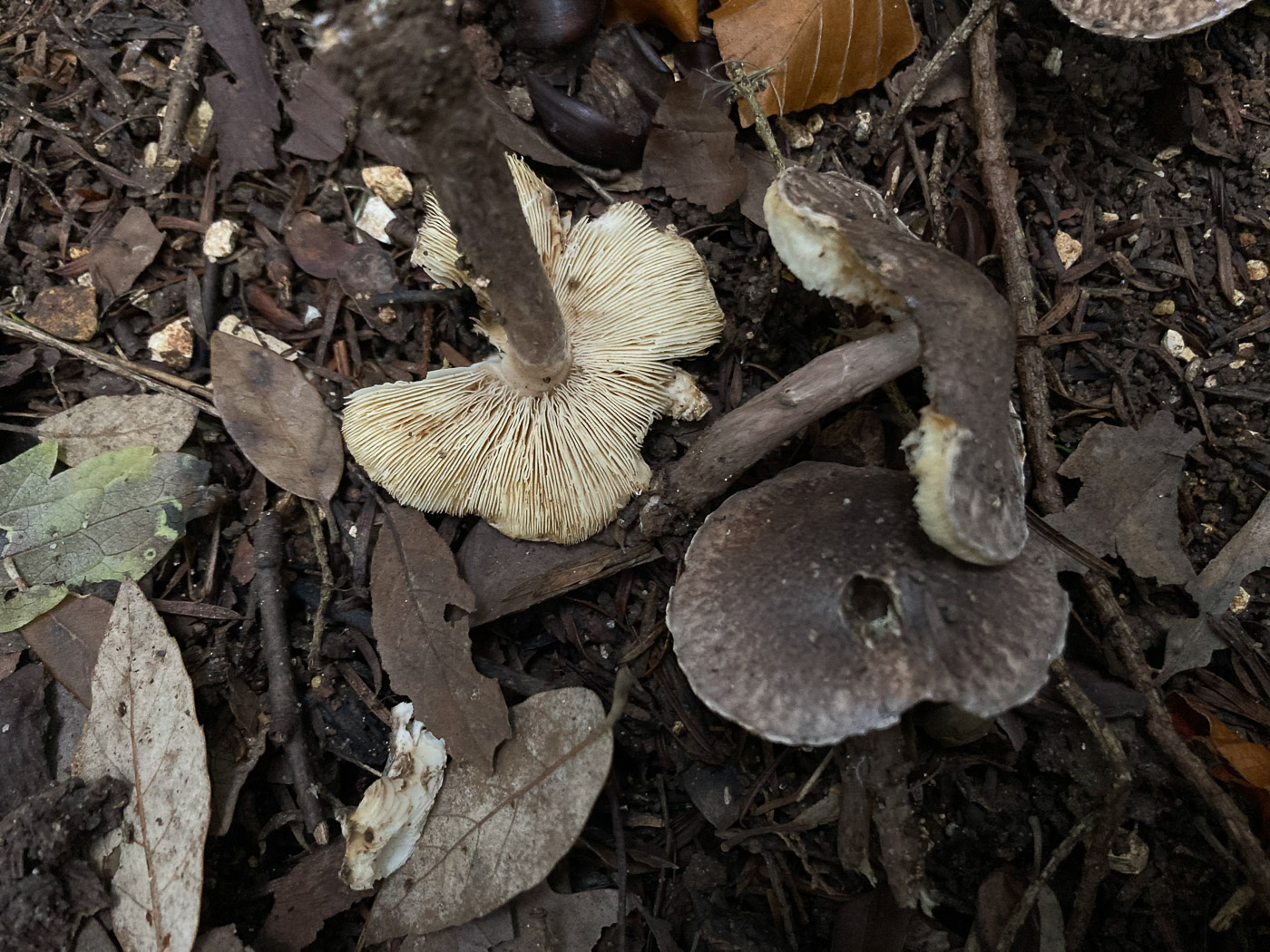
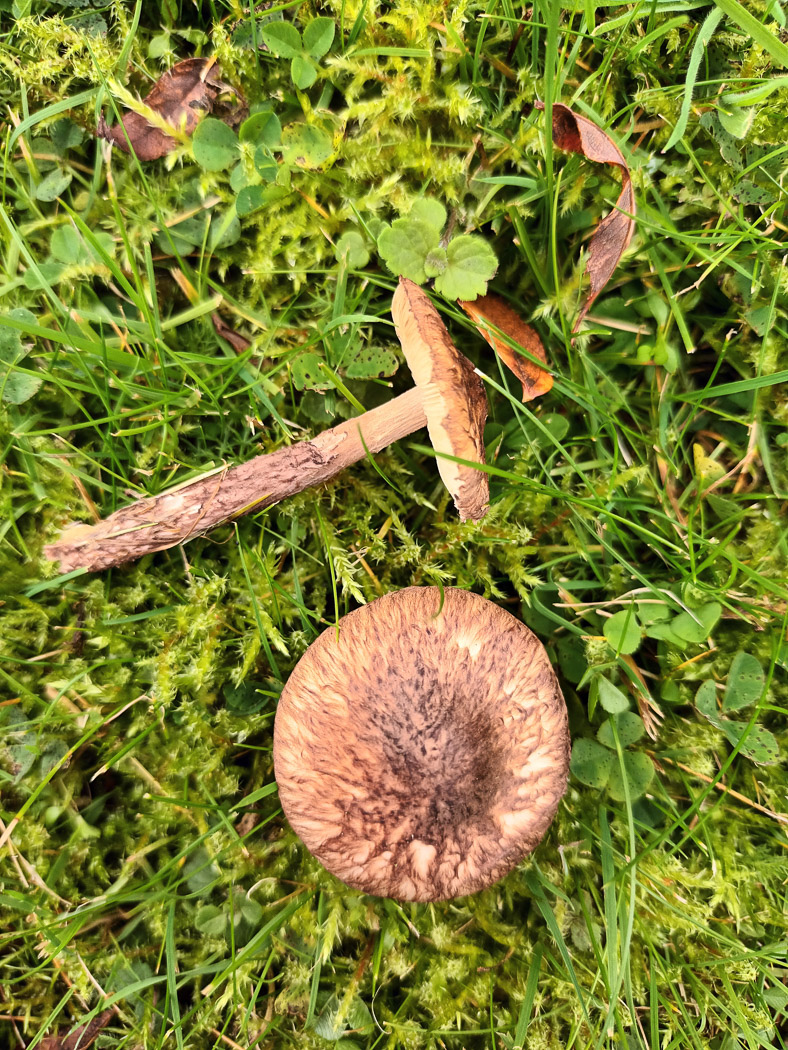 |
Lepiota fuscovinacea (a Dapperling with no common name) 
Nov 3, 2024. At Cliveden Russell Ness spotted these dark caps in litter under mixed trees. They keyed out at home to this unusual Dapperling for which we have just handful of records. This genus has been scarce this autumn with even L. cristata (Stinking Dapperling) hardly making an appearance, so if you come across one have a good look around for other Dapperlings nearby as they often seem to come up quite near together.
Oct 22, 2021. In mossy grass in Chalfont Dean Jesper Launder found this rare species, one for which we have only a couple of previous county records, the last in 2007. It has a somewhat dark coloured cap for a Dapperling, the Latin species name describing it well as dark brownish wine coloured. The surface quickly becomes floccose scaly, as does the stem below the ring zone, thus contrasting strongly with the free white gills and upper stem. The flesh tends to be pink both on the cap surface between the darker flocks as well as within. A nice find.
|
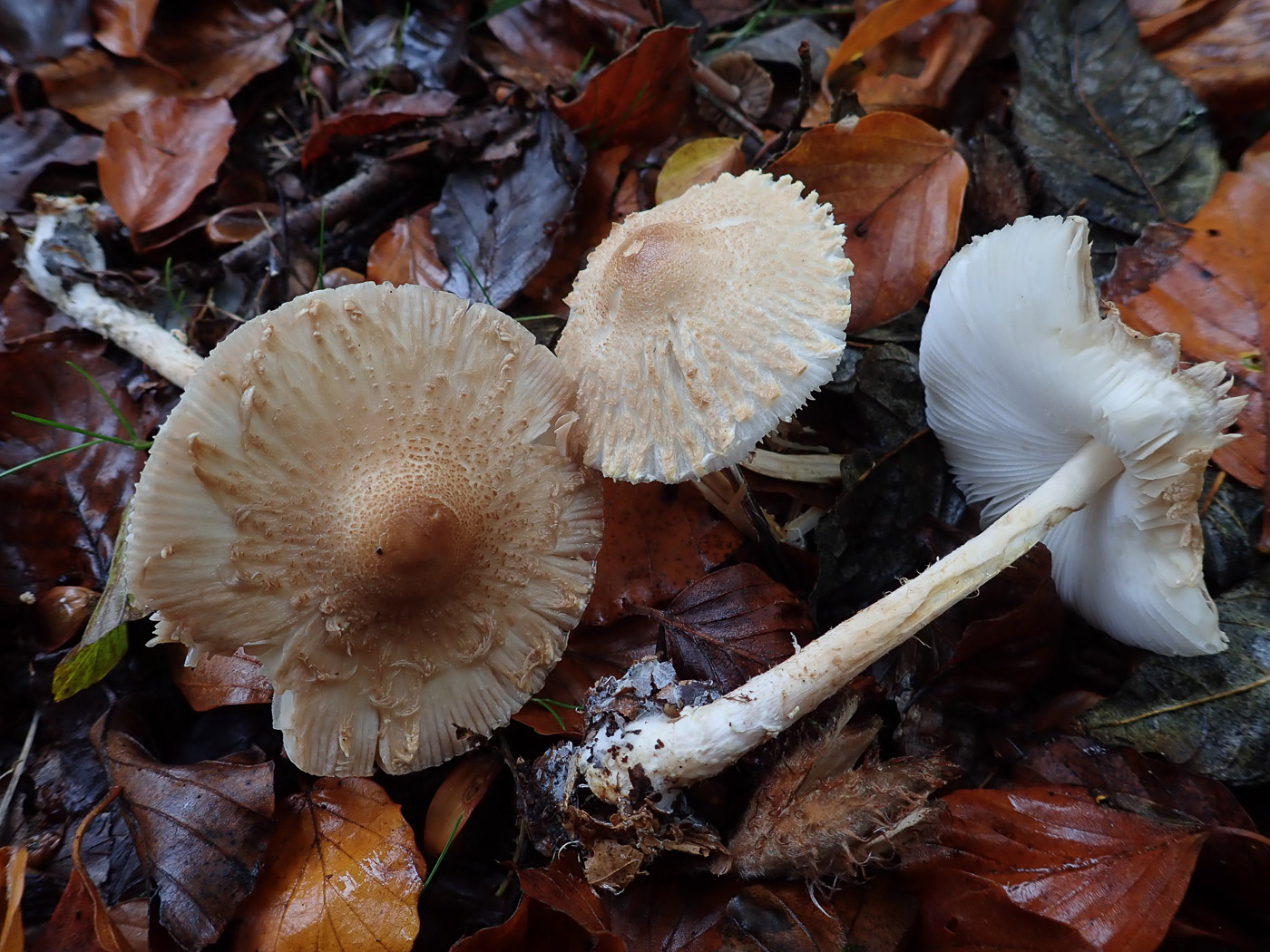
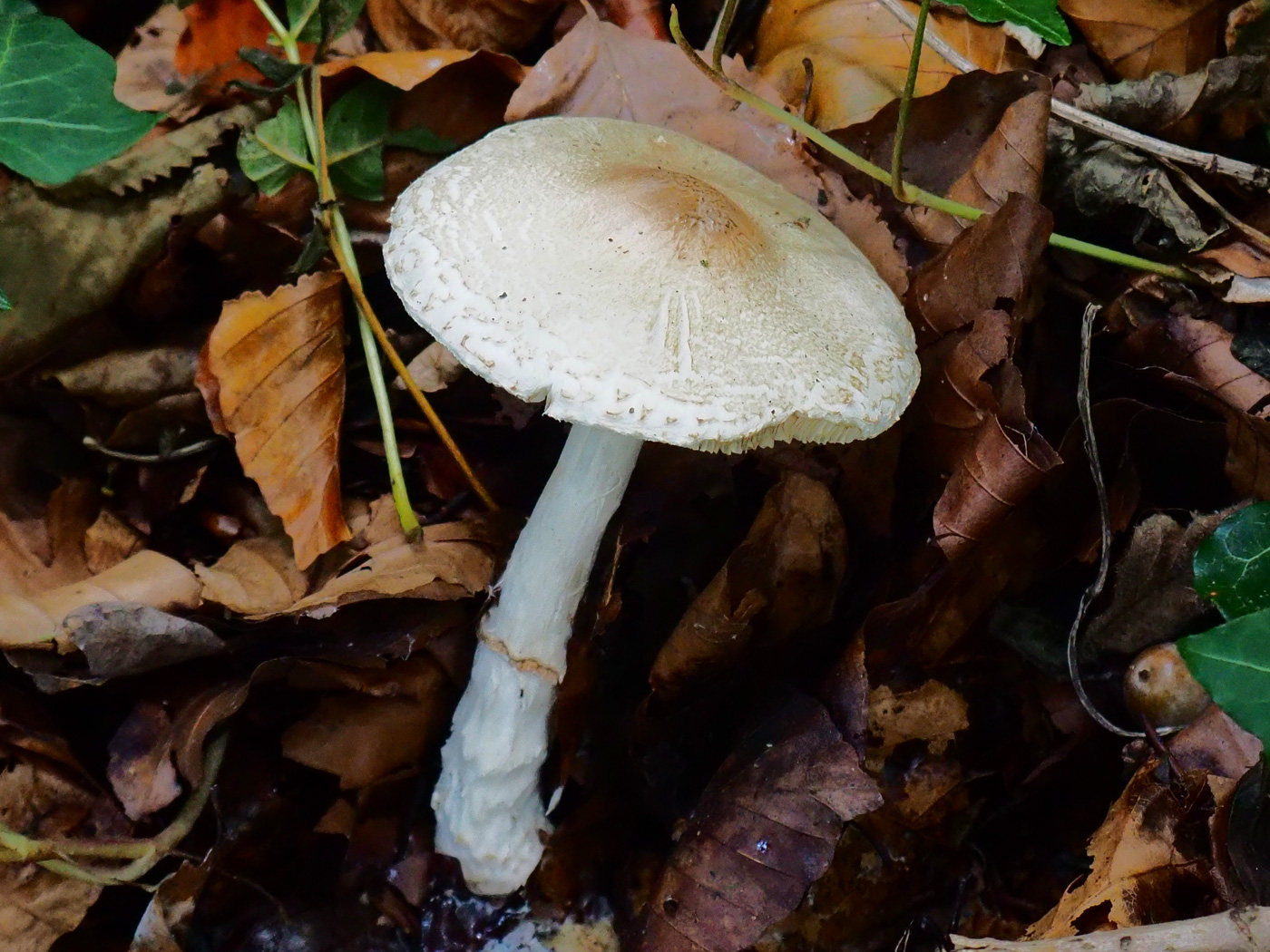
|
Lepiota ignivolvata (a Dapperling with no common name) 
Oct 21, 2022. In Gussett's Wood under Beech Penny came across just a few fruitbodies of this uncommon species dotted about, placed them together for the shot then identified them later at home.
Sep 26, 2020. John Catterson found this beautiful and rare mushroom in Tinkers Wood in the identical spot where he remembered it fruiting in 2014 when identified by Derek Schafer. Found in calcareous woodland with Beech, the diagnostic features are the cream cap with rusty orange centre together with the rather low slung stem ring having a distinctive rusty rim. It is a medium sized Dapperling having the typical white free gills of the genus and an unpleasant smell similar to that of the common Lepiota cristata (Stinking Dapperling).
|

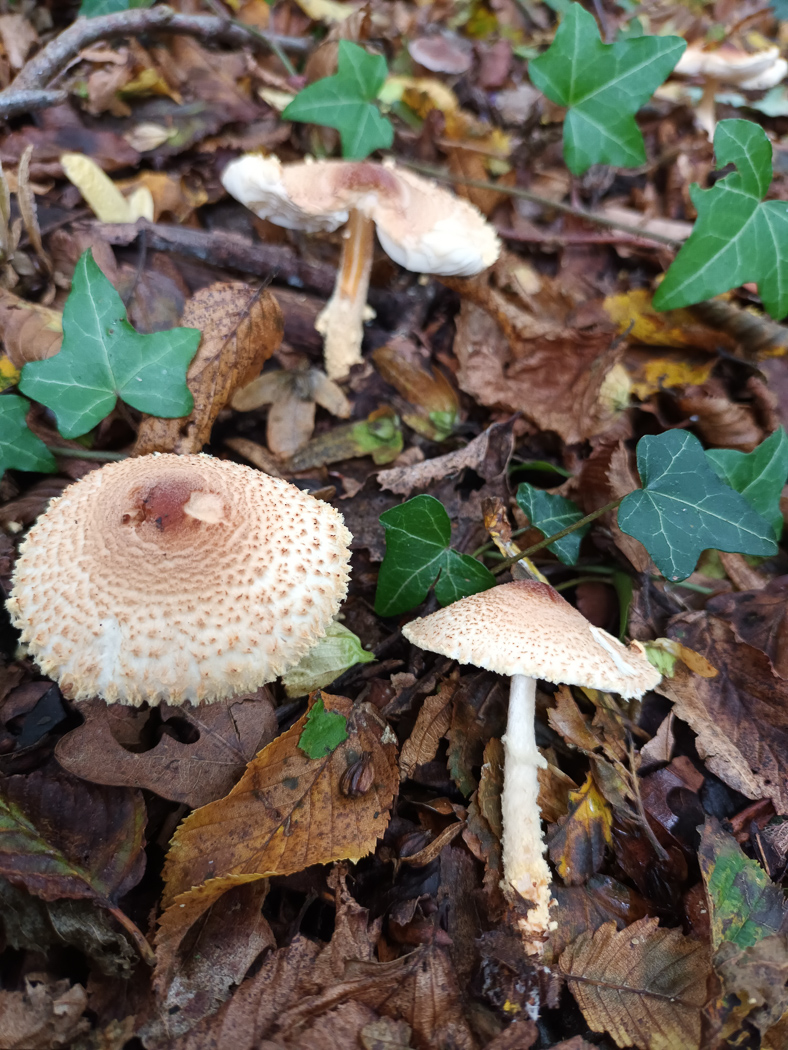
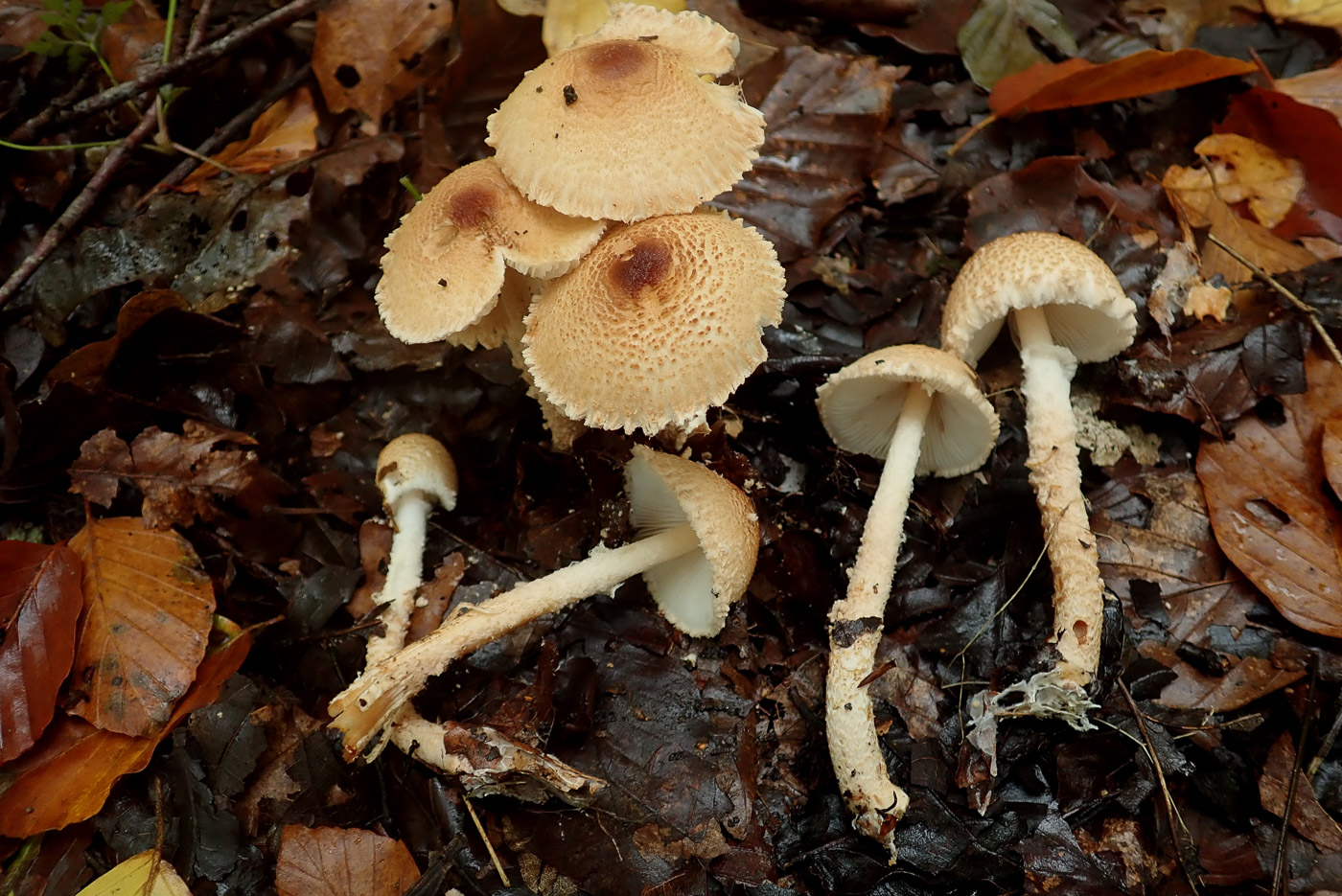
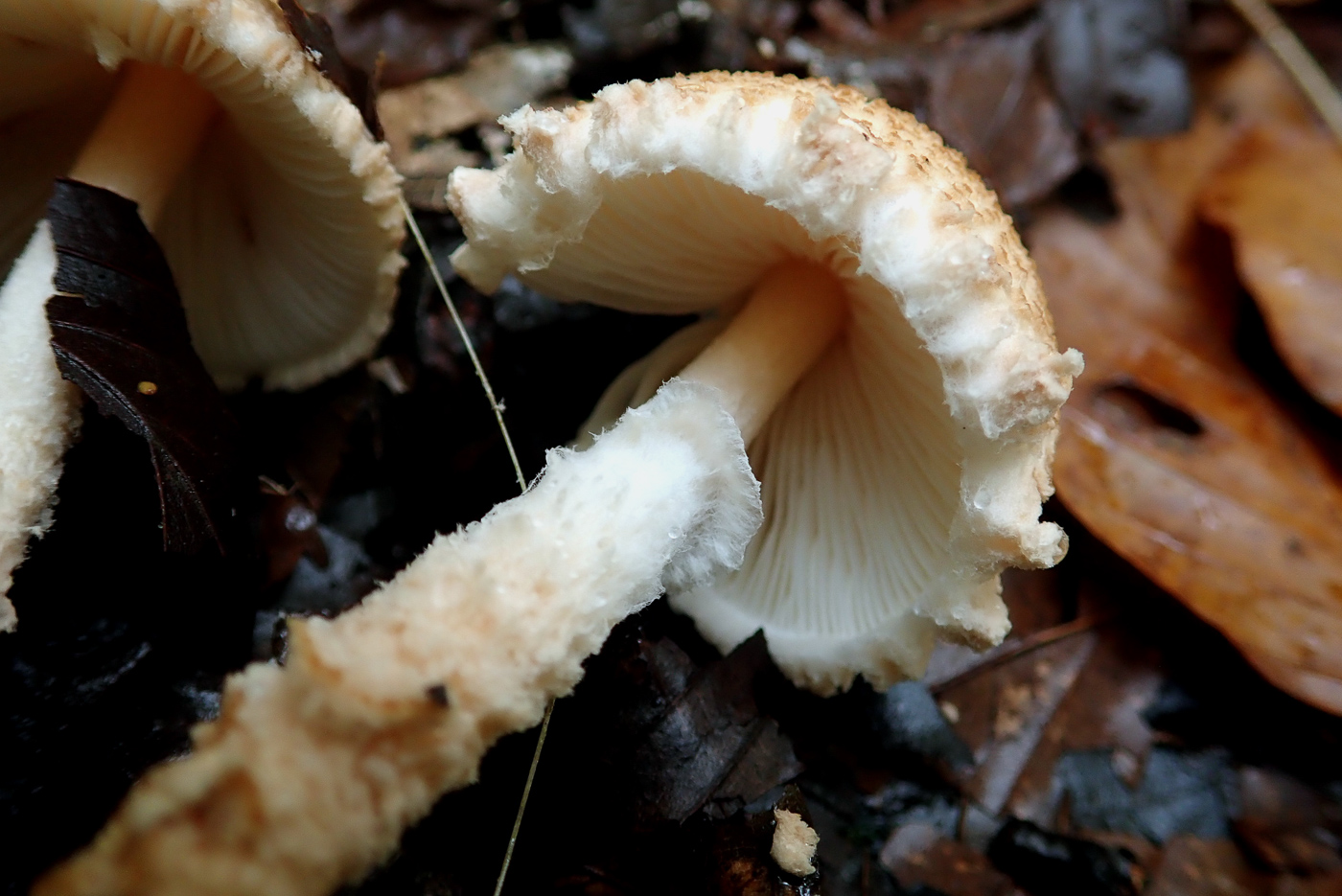
|
Lepiota magnispora (Yellowfoot Dapperling)
Oct 21, 2023. In Burnham Beeches Russell Ness came across this attractive singleton in Beech litter. This is a medium sized Dapperling, ie larger than the very common L. cristata (Stinking Dapperling) and also much less common. It typically has a cap with chestnut brown scales, cream gills and a rather fluffy stem with yellow tinges, though there are others which can look quite similar but none that have the unique and remarkably long spores of this particular species. Russell likened the spores to a shoal of whales!
Oct 19, 2021. In woodland litter near Chalfont St. Peter Jesper Launder found this attractive species of Lepiota. Larger than the common L. cristata (Stinking Dapperling) but having the same rubbery smell, it has a cap edge often hung with cream veil remnants and the stem has a floccose ring often with further brownish remnants below this. As its name suggests, it has very long spores which are shaped like bullets.
Oct 22, 2020. Paul Cullington found this patch of beautiful specimens amongst nettles with mixed trees in Hodgemoor Woods (photo Penny C.) This fairly common species is a medium sized Dapperling with caps up to 5 cm across and has the free white gills and cap with a chestnut centre and gradually paler towards the margin typical of the genus, but is notably finely floccose scaly especially at the margin. The stem has a floccose white ring below which are fluffy orangy belts. It has an unpleasant smell similar to L. cristata (see photo dated Oct 16) but is both larger and much more floccose.
|
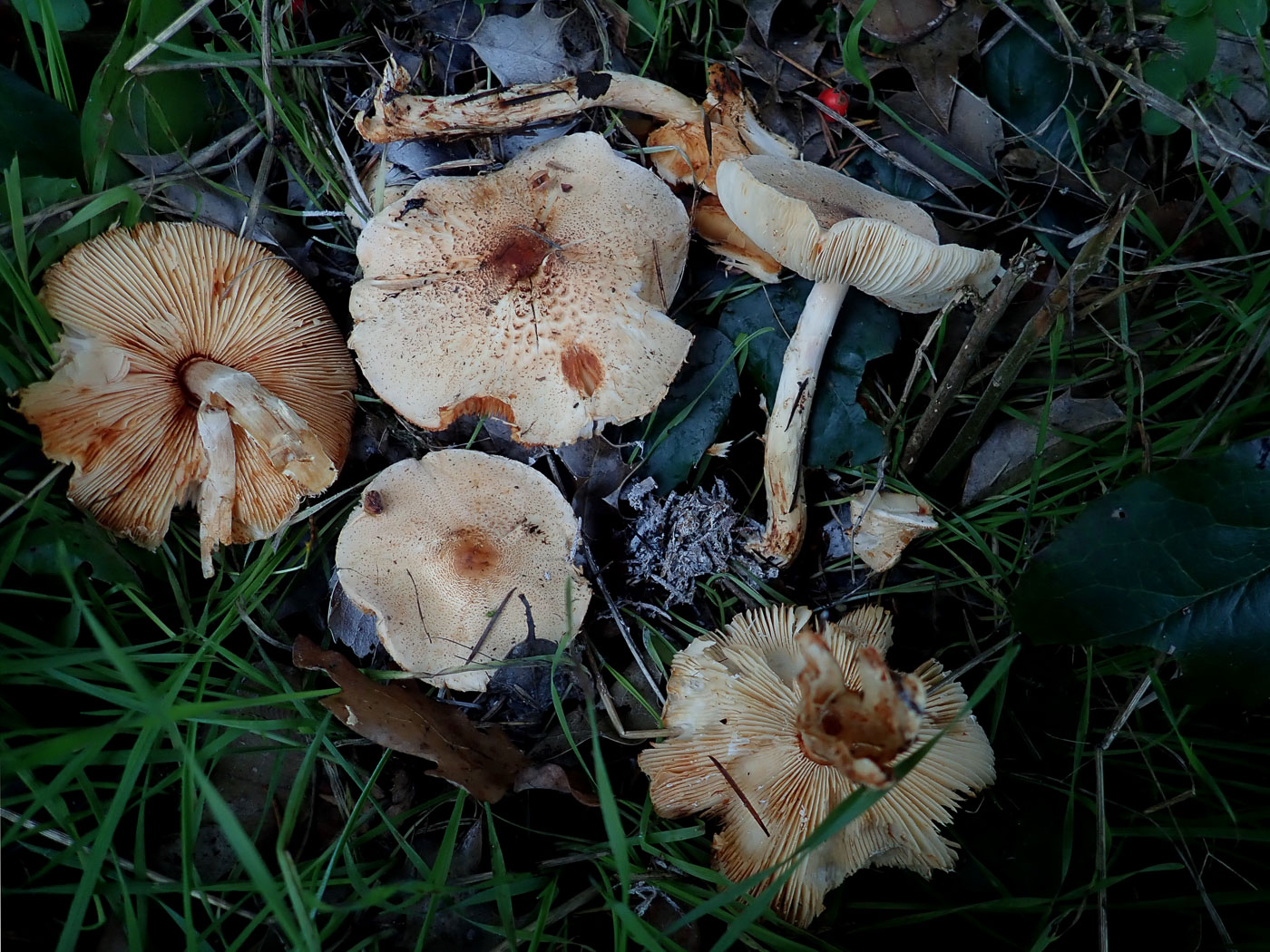
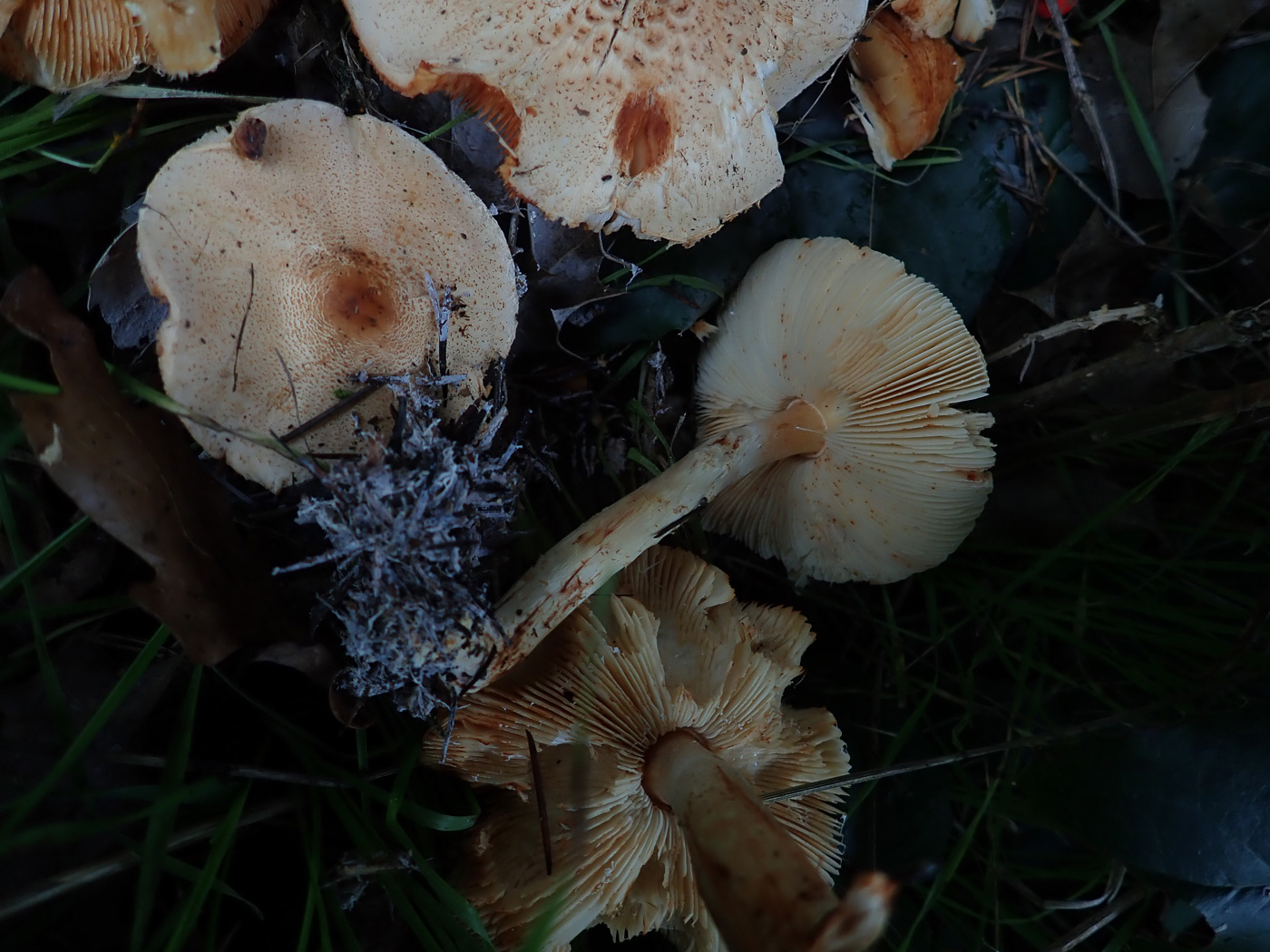
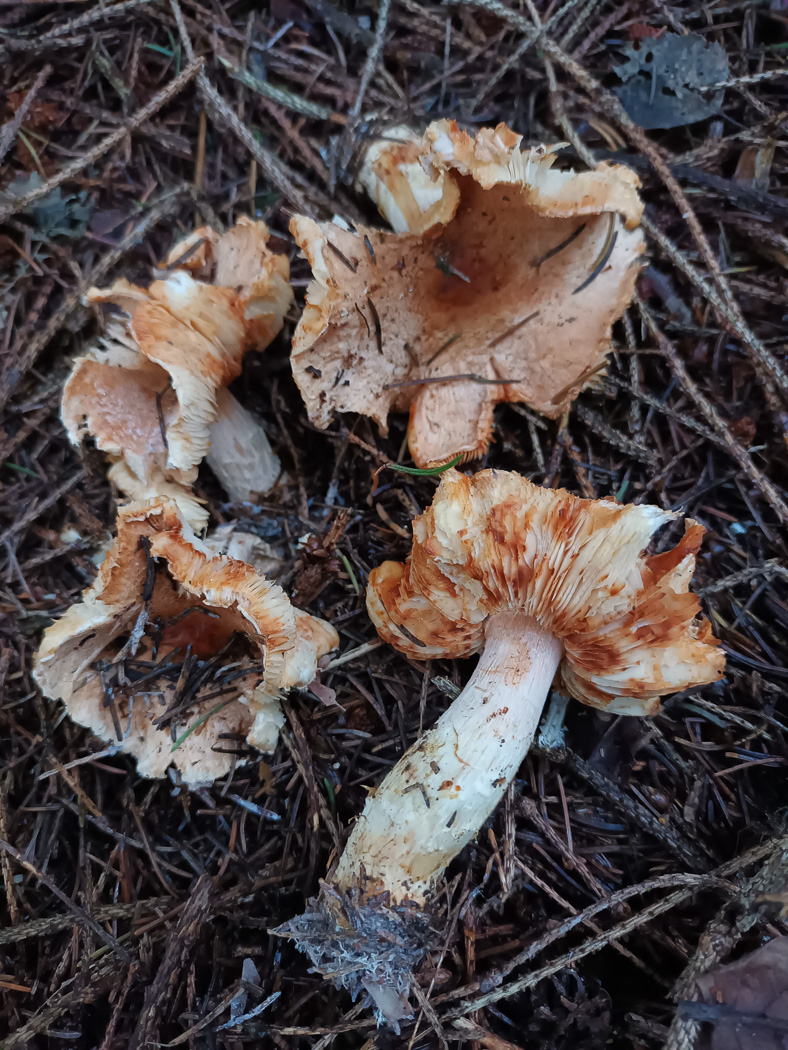 |
Lepiota ochraceofulva (a Dapperling with no common name) 
Nov 5, 2024. Just outside Prestwood Churchyard Penny and Sarah spotted first one cap amongst the grassy litter under a large Cedar, then several more. The caps were about 6-7 cm across with a dark rusty centre but pale pinkish beige and finely tomentose towards the margin. Turning one over revealed cream to orange free gills, this colour also on the stem which was clearly orange-reddening where damaged. At first Penny was convinced this was a species of Leucoagaricus but it failed to key out satisfactorily in this genus, and Sarah, who'd also taken a specimen to work on, then suggested Lepiota ochraceofulva which fitted much better. This was a species which had also been found recently at Penn Churchyard and was new to the county in 2021 when found by Jesper Launder also under conifer. It appears to have an affinity with Cedar which also helped to confirm today's collection which will be dried for sequencing. The photos are Penny's.
Nov 1, 2021. In a small conifer plantation near Chalfont St. Peter Jesper Launder found this collection of rare Dapperlings, this being a species we appear to have no county records for. It occurs mainly in the south, most records from under conifers, but is not at all common. It can be seen from his photo that the specimens were past their best but are still displaying the brown cap centre with ochre to orange cap colours and free gill which tend to darken to ochre also. This is a species which lack a distinct ring on the stem but usually retains some signs of irregular bands below the ring zone.
|
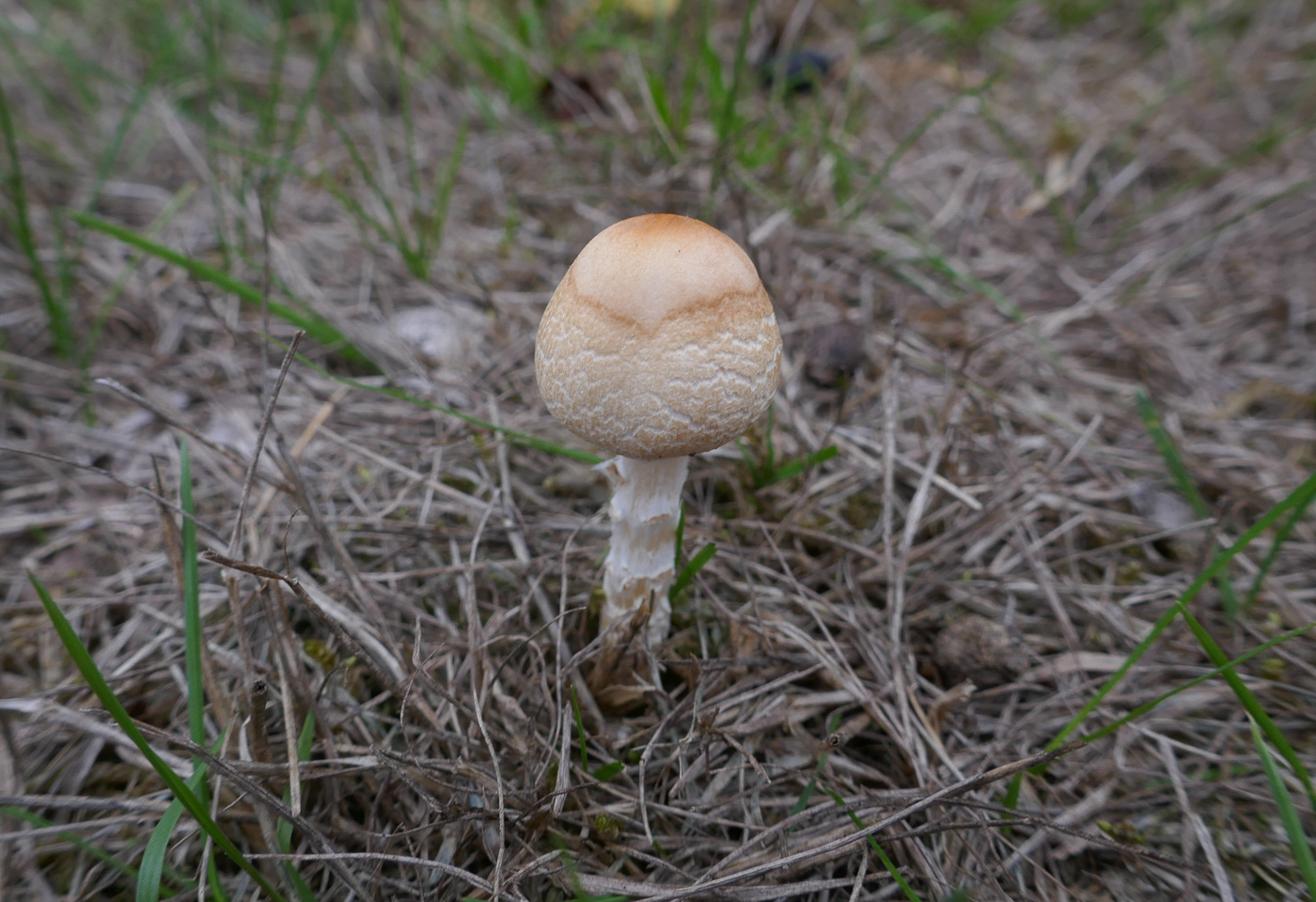
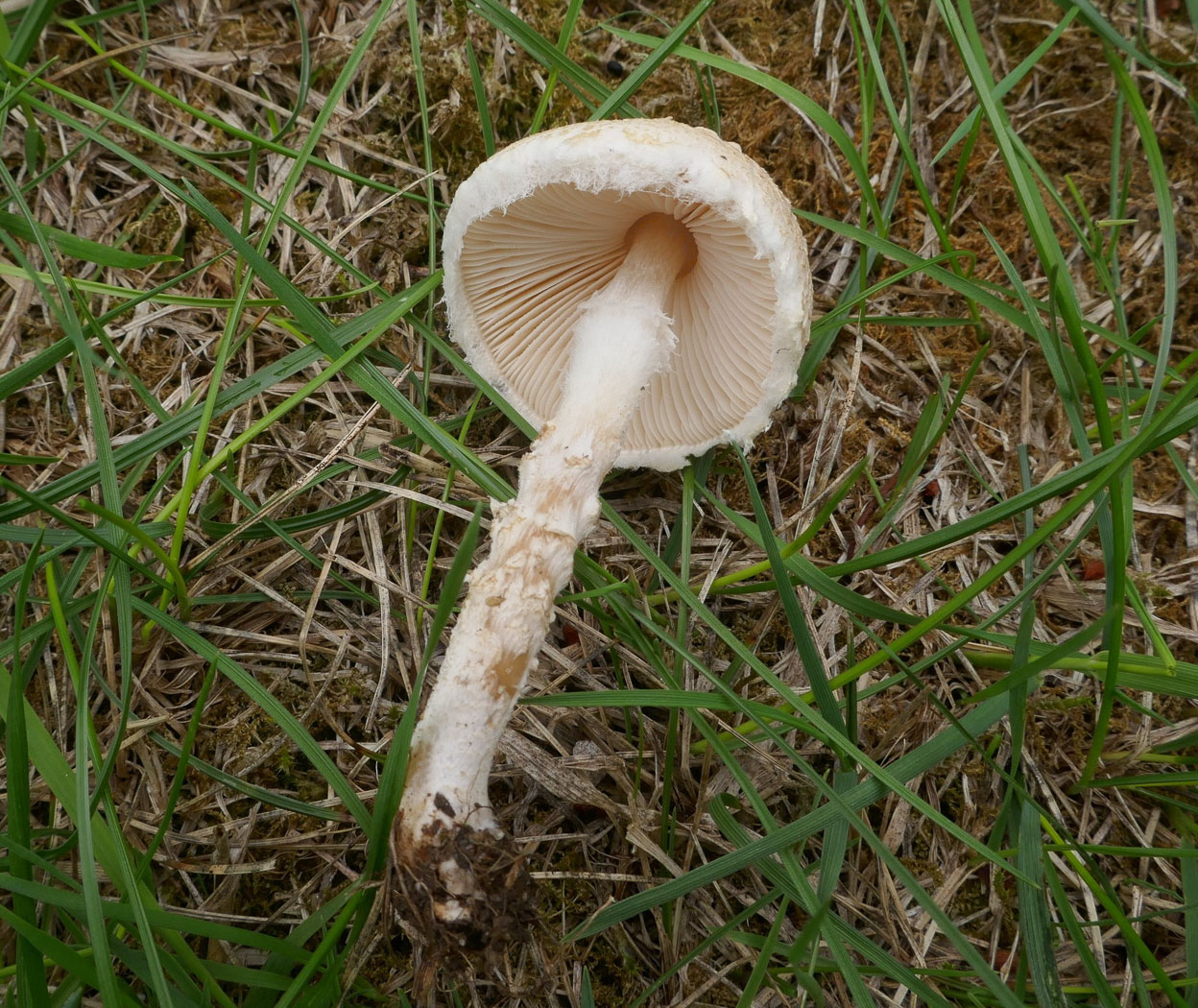
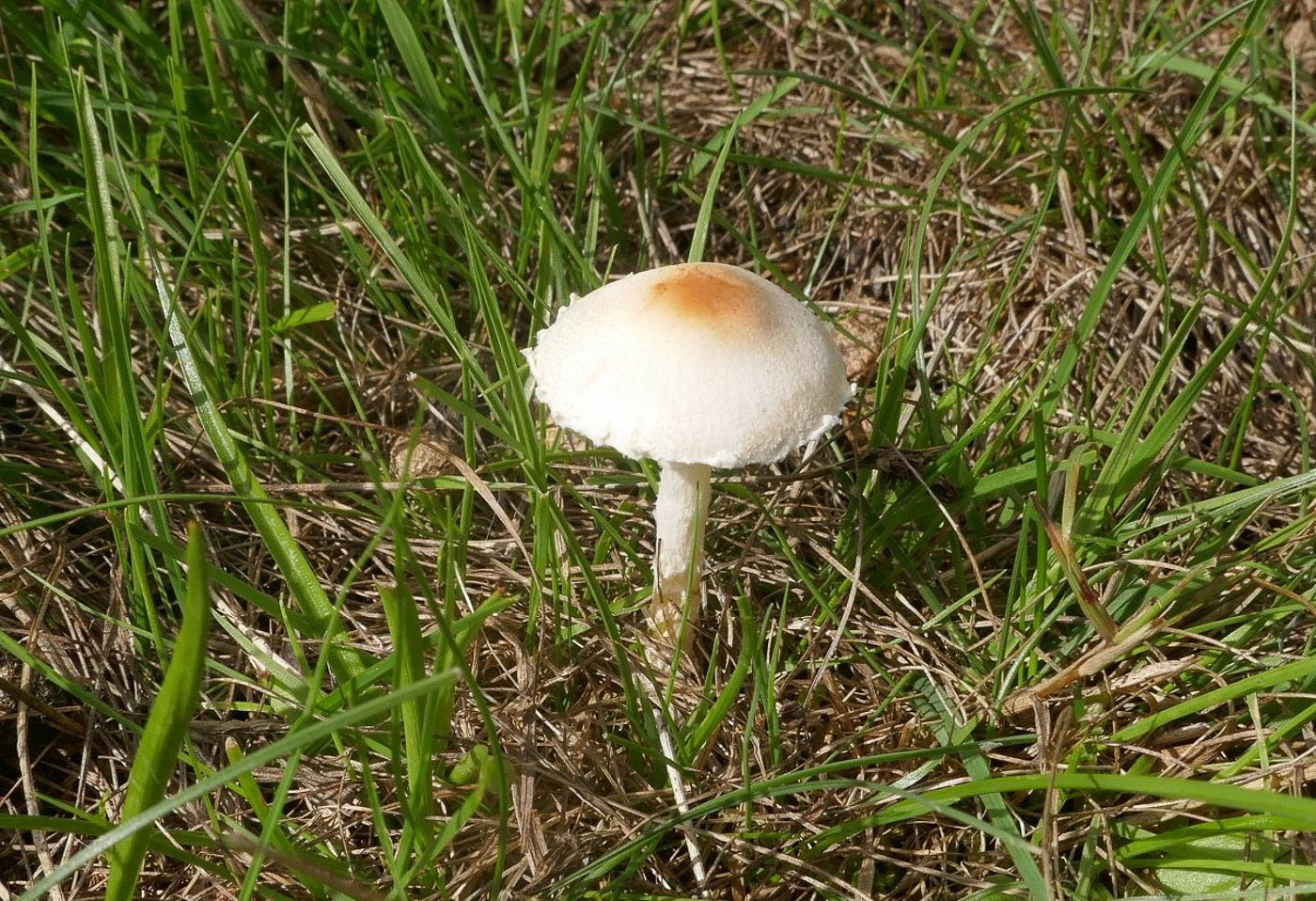
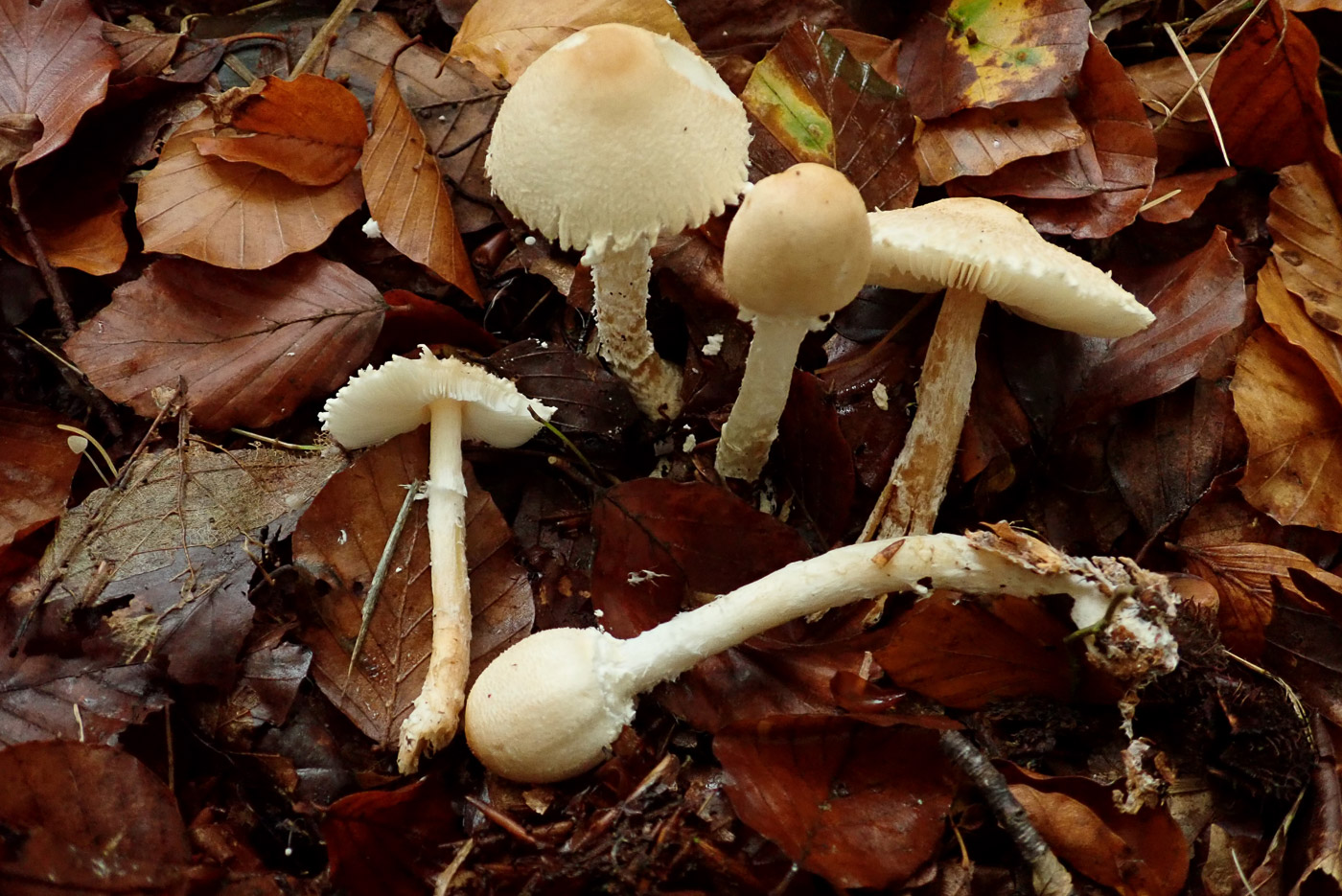
|
Lepiota oreadiformis (a Dapplering with no common name)
Sep 12, 2022. At Stampwell Farm in an orchard Jackie Ewan found this attractive medium sized Dapperling, said to have a resemblance to Marasmius oreades (Fairy Ring champignon), hence its species name. This is not a woodland species, favouring more open grassy areas or hedgerows, but is typical of the genus with its creamy white crowded free gills, a flocculose stem with a ring zone and a cap with pale flesh colours.
Oct 24, 2020. Paul and Penny C. found good numbers of this pretty medium-sized Lepiota in litter in Gussetts Wood. The species name suggests that it looks similar to Marasmius oreades (Fairy Ring Champignon), maybe because it occurs in grassland - like that species - as well as in woodland. It is a similar size to L. magnispora (see photo dated Oct 22) but is much paler and much less scaly but has a similar floccose cap margin. The stem markings are also paler. Both species have the unpleasant rubbery smell like L. cristata.
|
 |
Lepiota pseudolilacea (a Dappperling with no common name) 
Nov 2, 2023. In St. Giles churchyard Stoke Poges Jesper Launder found and later identified this rare Dapperling, one for which we have just three previous county records, all from the last century. Today we recorded several rare Dapperlings - two here in the churchyard and others in the adjacent Memorial Gardens - and it's been noted before that this does seem to happen with this genus: if you find one interesting species it's worth having a close look for others nearby. This is another new species for Finds.
|
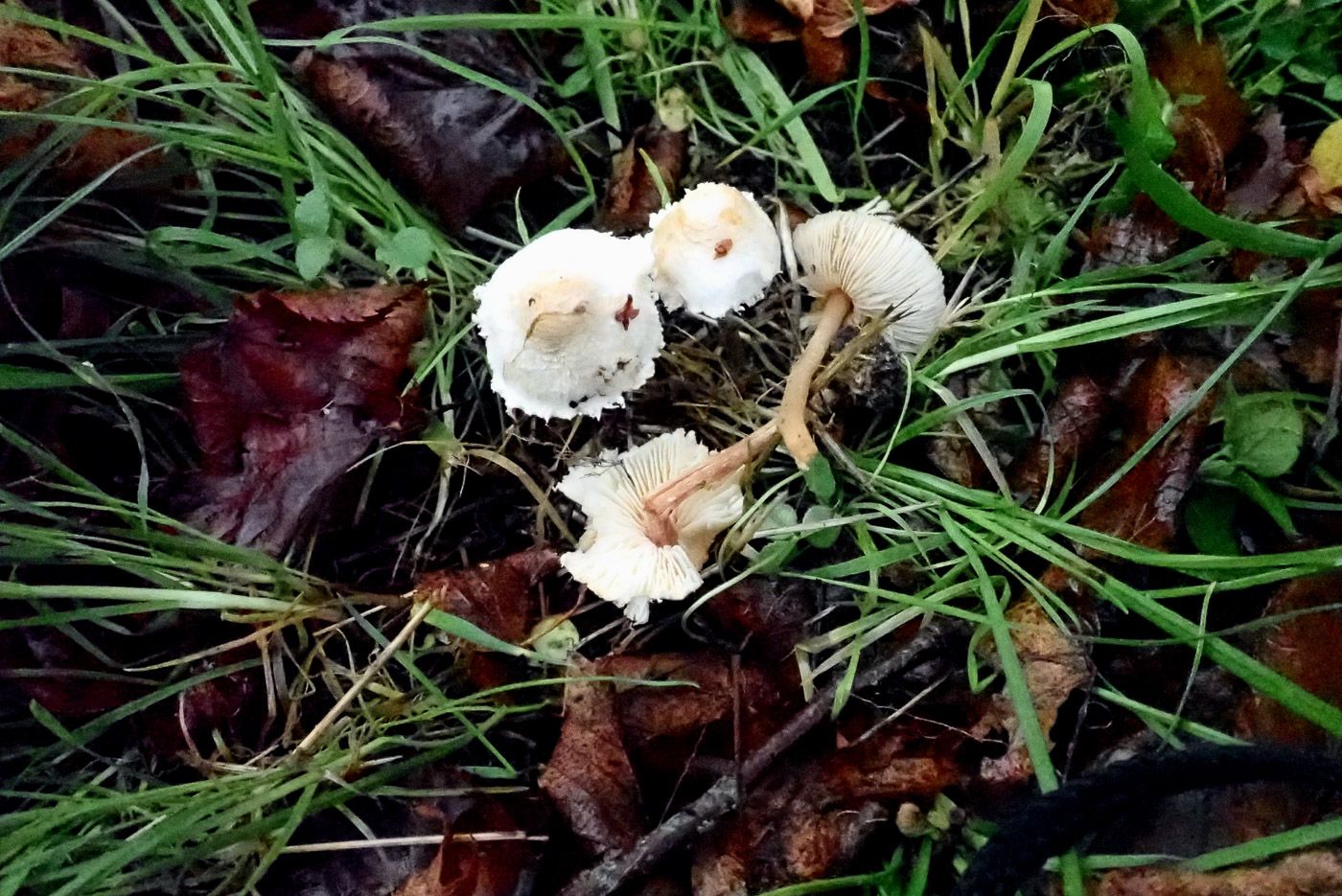 |
Lepiota subalba (a Dapperling with no common name) 
Nov 13, 2021. In the avenue of Limes at Turville Heath Penny noticed a white cap just visible amongst the thick fallen leaves and on investigating discovered not Inocybe geophylla as she expected but a small group of very pale Dapperlings. The caps were white apart from a slightly yellowish centre and the surface was flocculose, especially around the margin. The gills were free and white and the stem also was floccose though with no apparent ring. On collecting she noted the lack of the unpleasant 'cristata' smell present in Stinking Dapperling and also several other species, and at home this keyed out to L. subalba, described as occasional in calcareous woodland. We appear to have no previous county records though Penny has found it at nearby Watlington Hill.
|
 |
Lepiota subincarnata (Fatal Dapperling) 
Nov 2, 2023. In Stoke Common Memorial Gardens this was one of several Dapperlings found and identified by Jesper Launder today, the conditions clearly suiting the genus at the moment. This is an occasional species with pink colours on both cap and stem, its common name reflecting the fact that it is extremely toxic. We have just a handful of previous records dating from 1953 to 2002, then a gap until last week at Round Spring Wood and here today! This is a new entry for Finds though there is also a photo in Penny's report on Round Spring Wood.
|
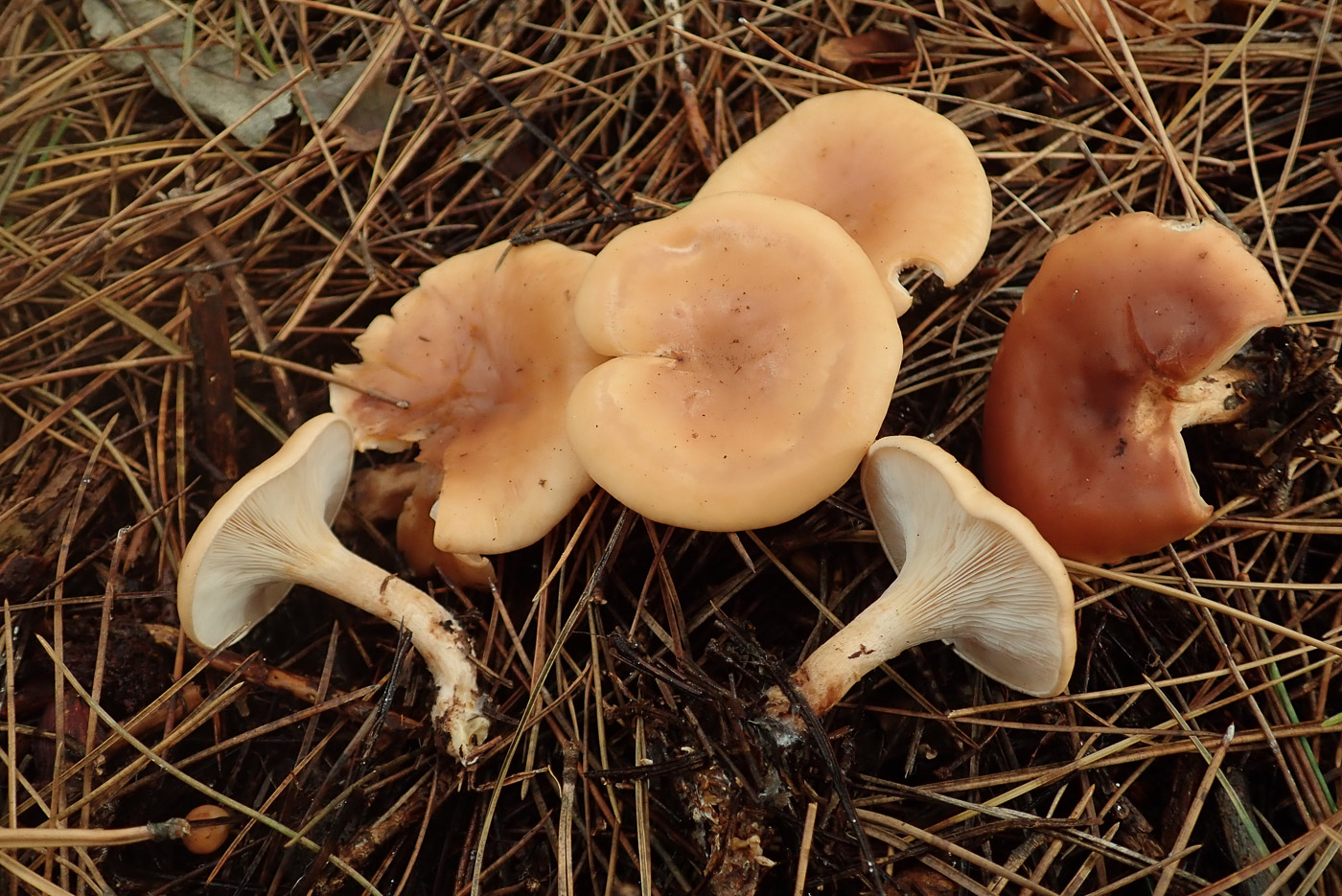 |
Lepista (Paralepista) flaccida (Tawny Funnel)
Oct 22, 2020. Penny C. found a ring of these mushrooms under Pine in Hodgemoor Woods. The shape of the cap and strongly decurrent gills suggest this is related to the genus Clitocybe, but the ornamented spores tell otherwise. The strong rusty to tawny smooth cap is distinctive and this together with the very crowded sloping gills make this species fairly easy to recognise - a very common woodland species often in large numbers under both deciduous and coniferous trees, though perhaps more often under conifers.
|
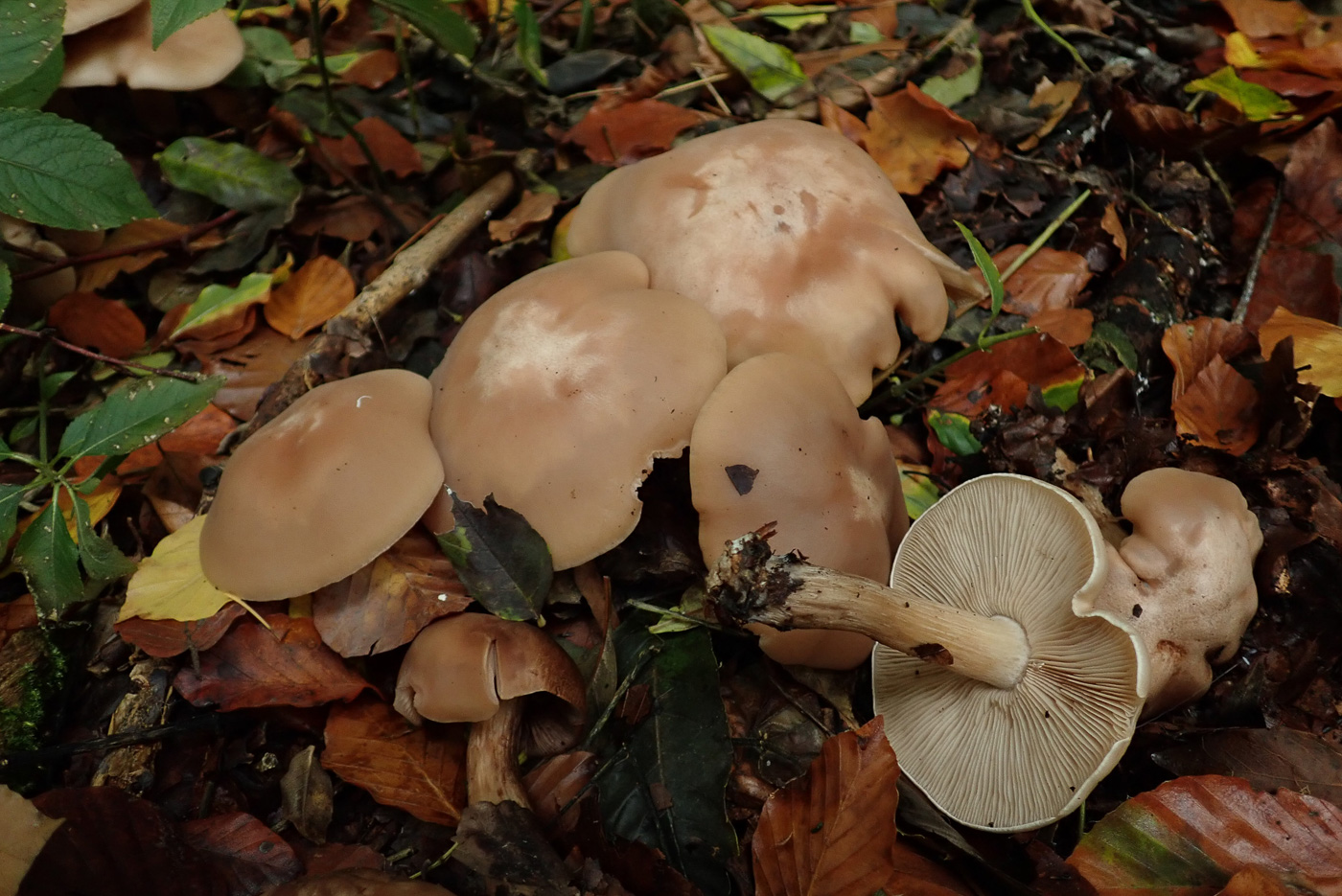
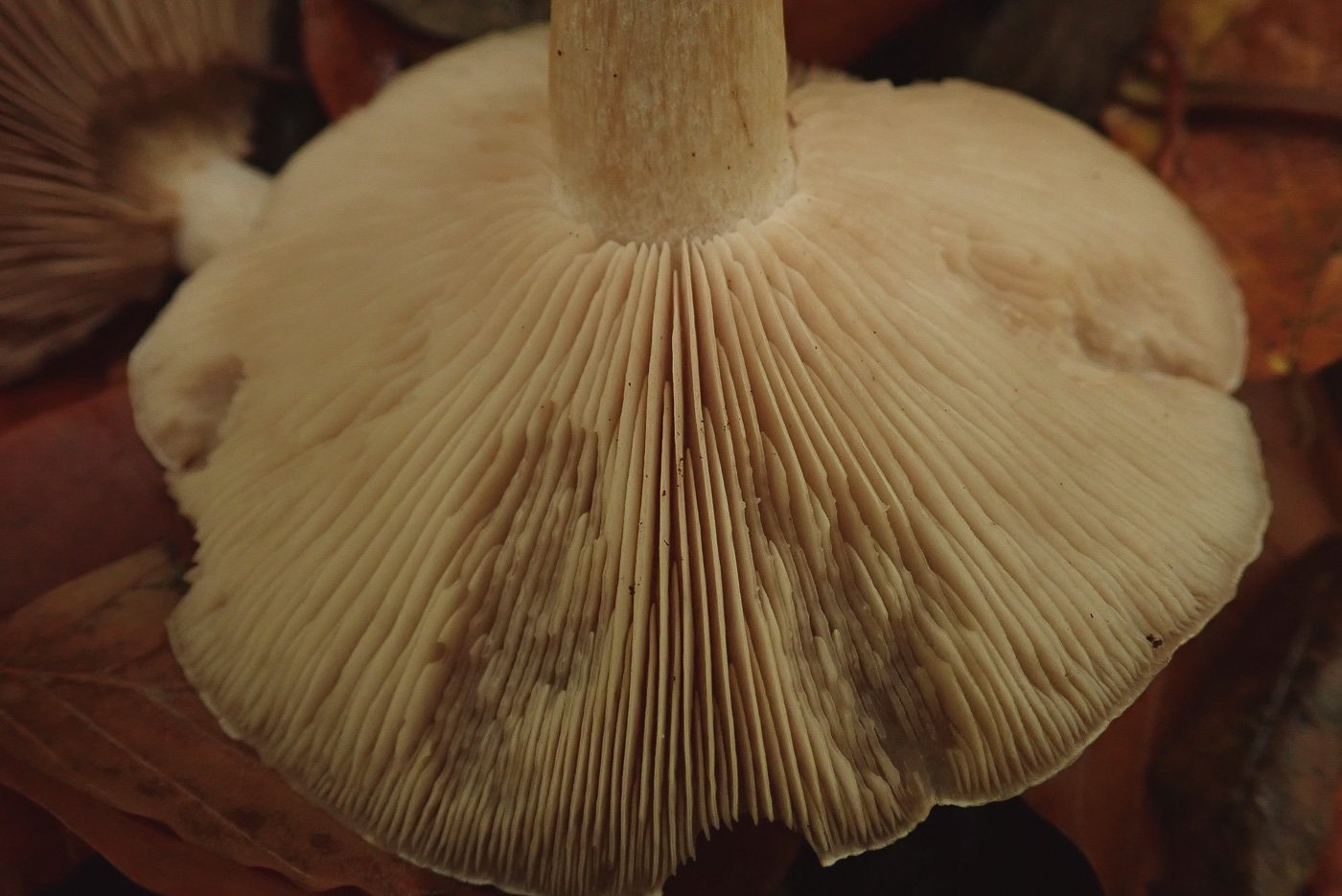 |
Lepista irina (Flowery Blewit)
Oct 26, 2020. Paul C. found several collections of this chunky rather nondescript pale brown mushroom fruiting in Beech litter in Mousells Wood (photo Penny C.). Not that common a species, its main redeeming feature is its pleasant sweet flowery smell. Penny at first thought it was a species of Melanoleuca because of the crowded gills and broad central umbo, probably M. cognata which has cap and gills this colour. Once collected, however, its smell eliminated that genus and she remembered Geoffrey Kibby finding and naming the species on a visit here a few years back.
|
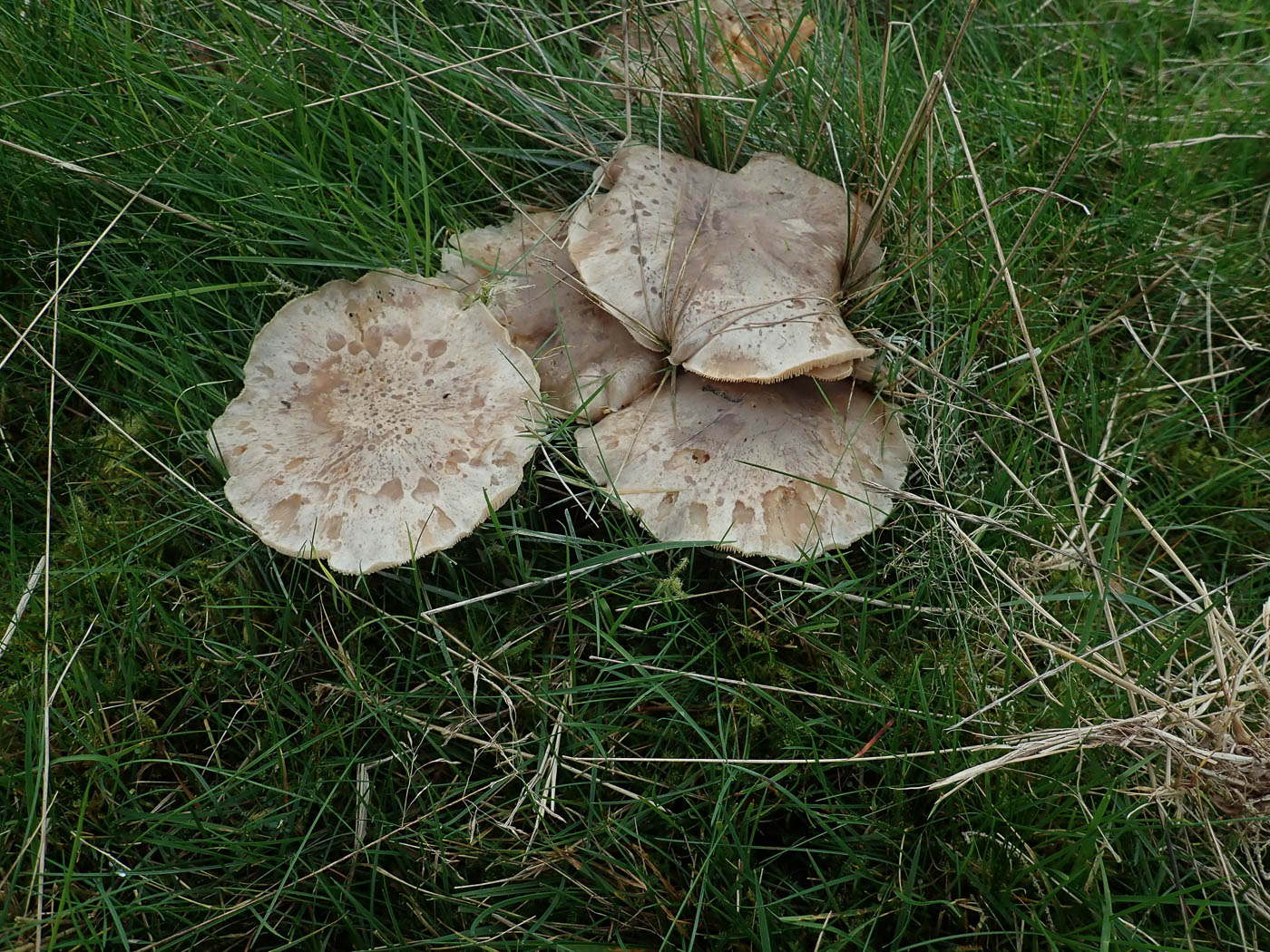
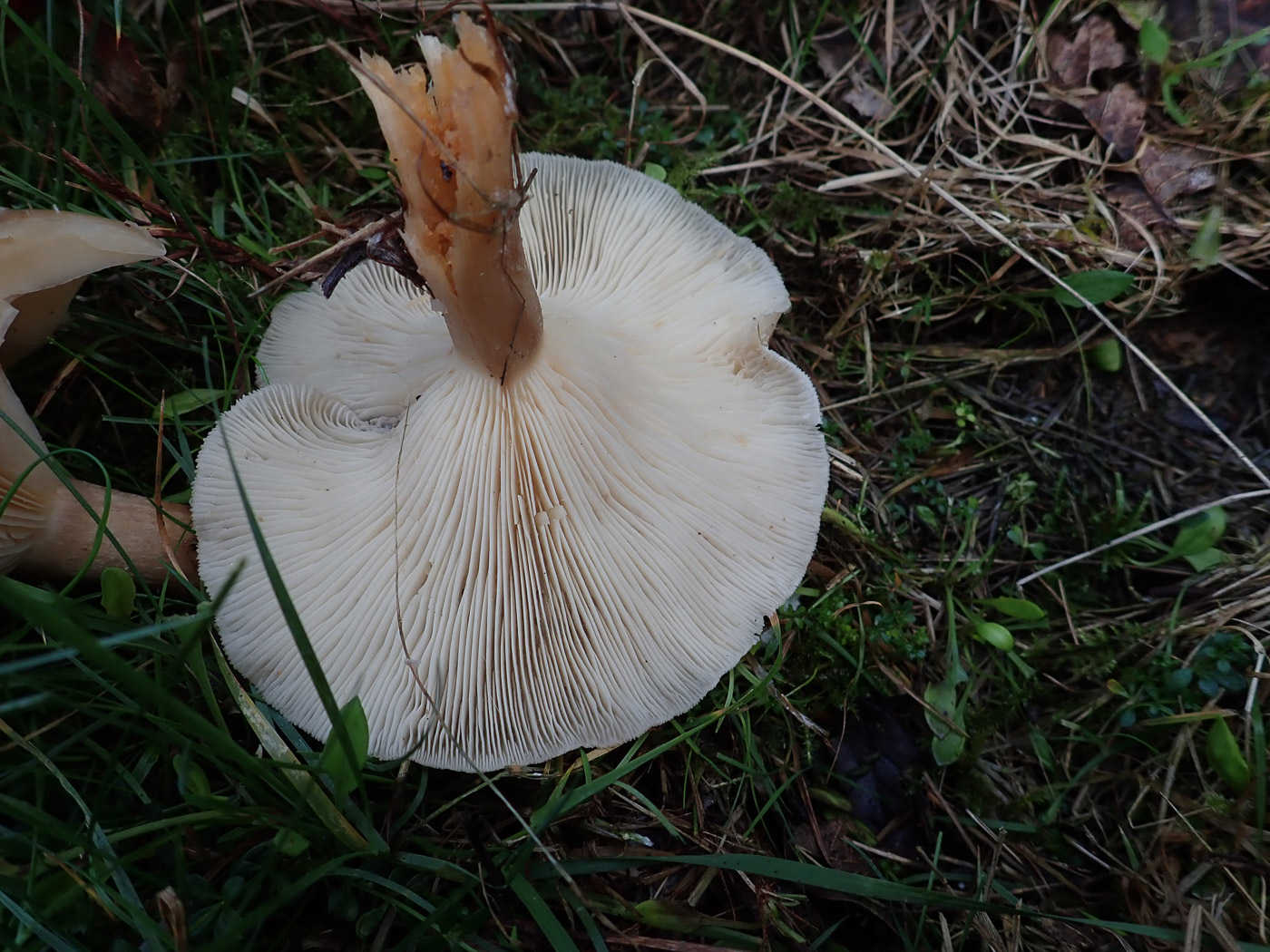

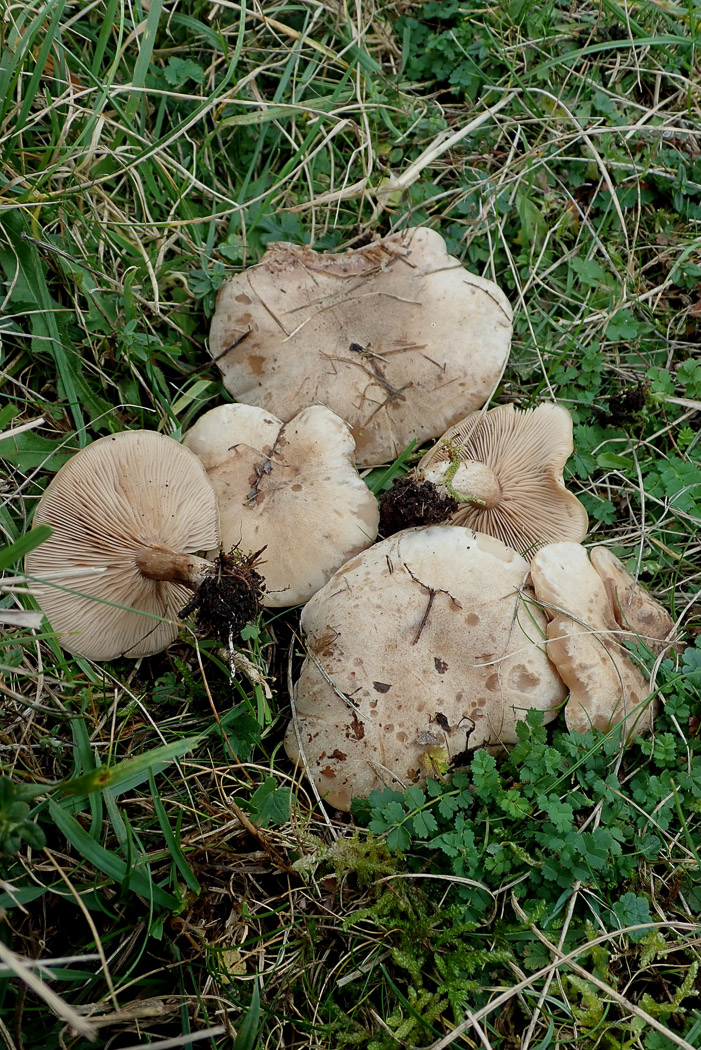
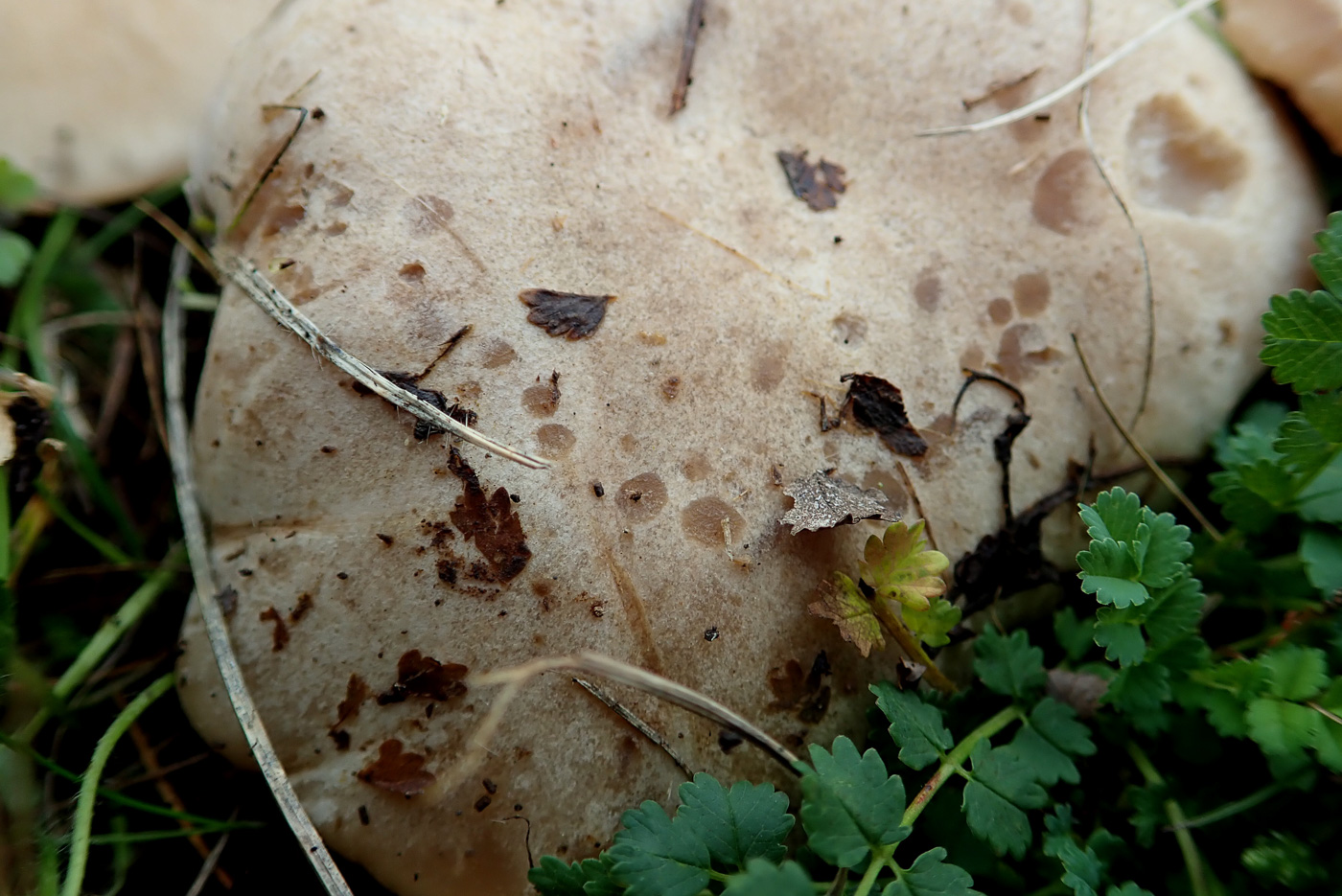
|
Lepista luscina (Spotted Blewit)
Nov 14, 2024. In various different grassy areas at Coombe Hill Penny came across clumps of large specimens of this quite unusual species which seems to be a regular at this site. Unfortunately they were all well past their sell-by date except for one which she managed to turn over without it collapsing to show the crowded decurrent gills of the species. They were too far gone to have their typical sweet smell but the caps - up to 10-11 cm across - showed the distinctive droplet markings which characterise this grassland species.
Nov 2, 2023. In short grass in St Giles churchyard Stoke Poges Penny noticed these grey mushrooms which were unfamiliar though both she and Jesper Launder guessed correctly at the genus. Both took a sample home and came to the same conclusion - very gratifying! The species has a slightly sweet smell, a pale pinkish sporeprint, crowded gills and its grey cap has some diagnostic darker spots around the rim (rather similar to those seen in Lactarius blennius (Beech Milkcap). We have only a few previous records, virtually all from the grassland at Coombe Hill.
Oct 30, 2020. Penny C. came across several large clumps, even rings of this quite unusual Blewit on the escarpment at Coombe Hill. Superficially similar to Clitocybe nebularis (which was also fruiting nearby) and maybe other dull beige mushrooms as well, the feature which distinguishes it is the typical droplet-like markings which develop on the mature cap (seen in Photo 2). The crowded gills are concolorous with the cap and it has the typical sweet smell of the genus which becomes more apparent once collected and starting to dry off a bit.
|


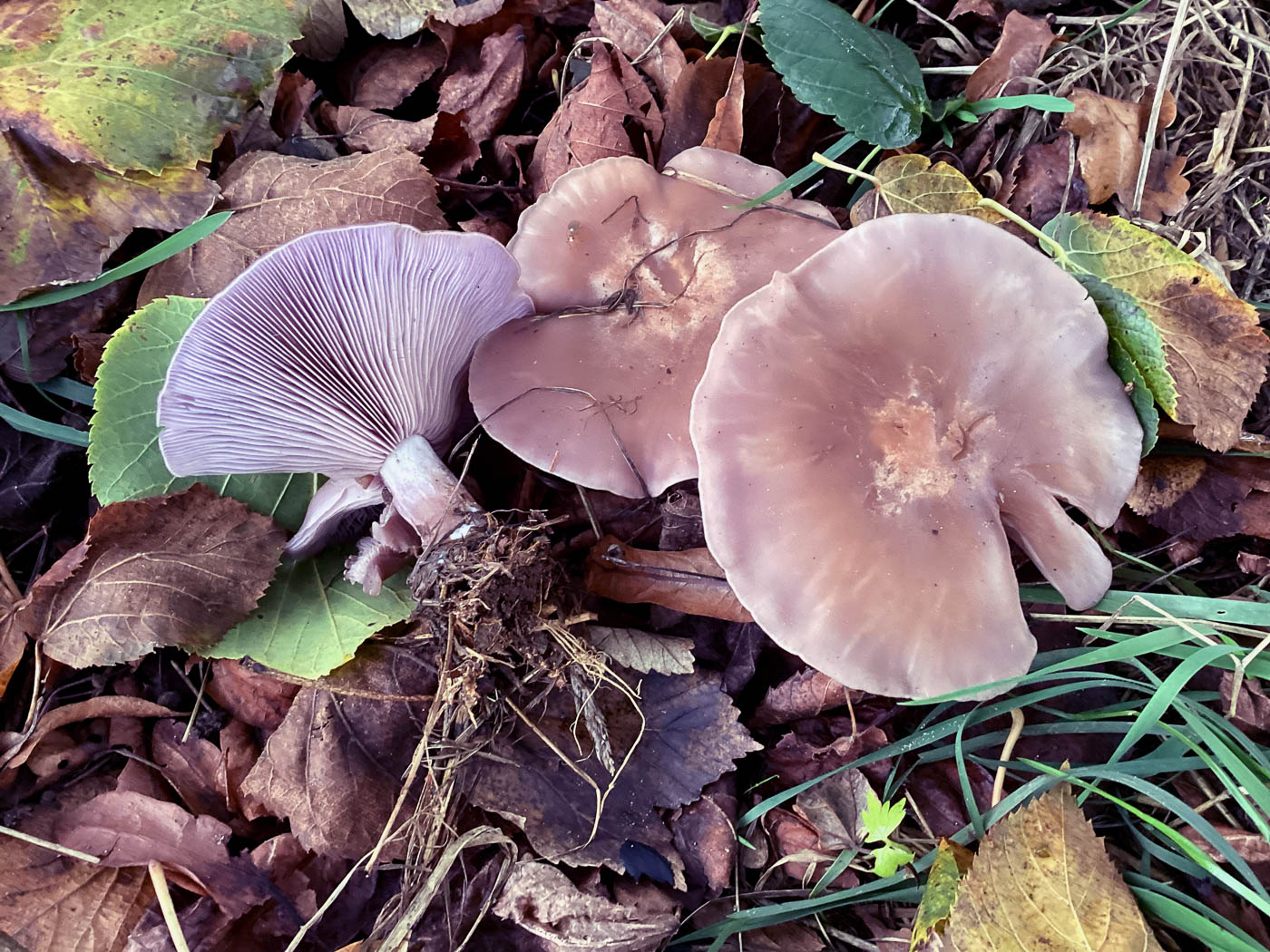
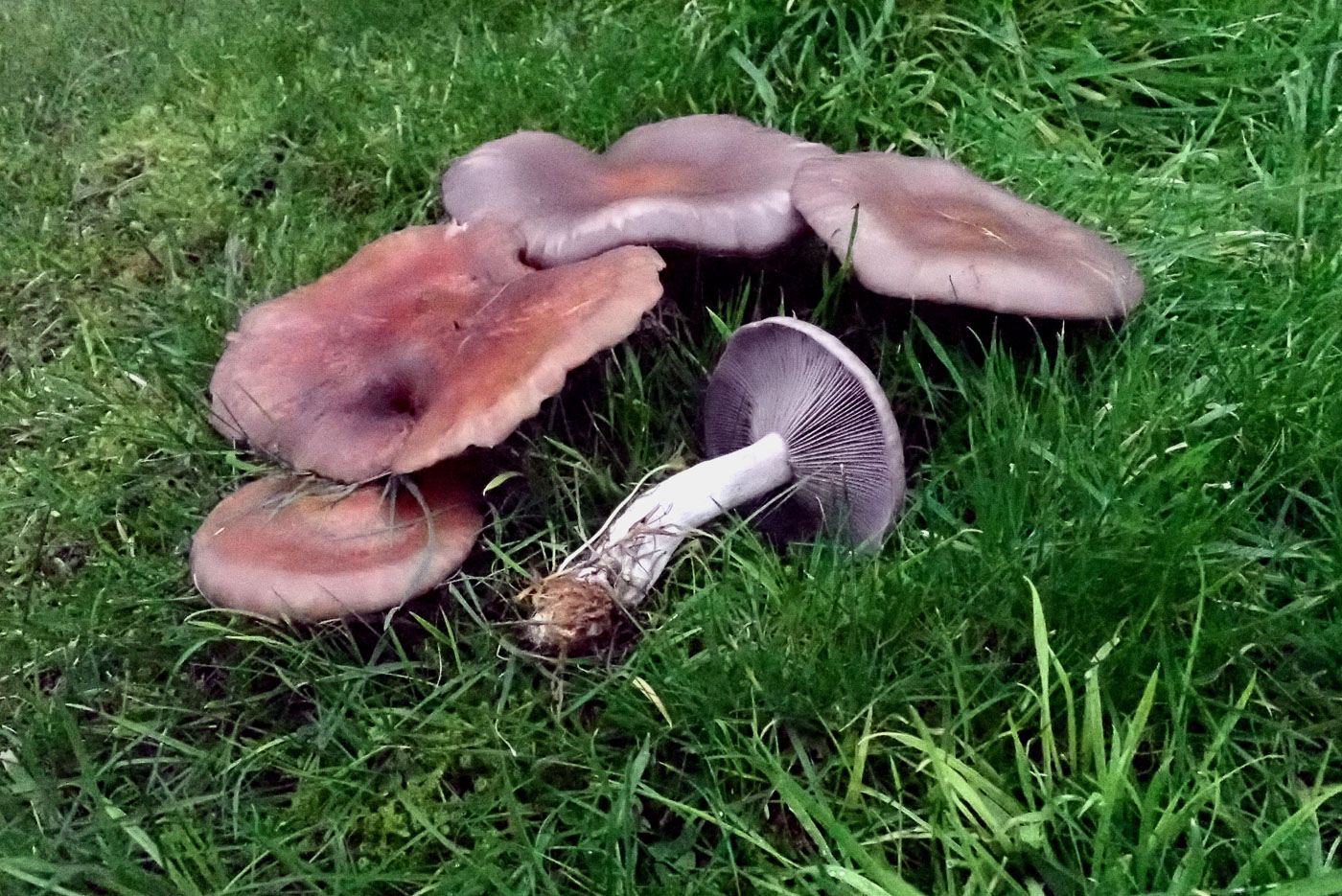
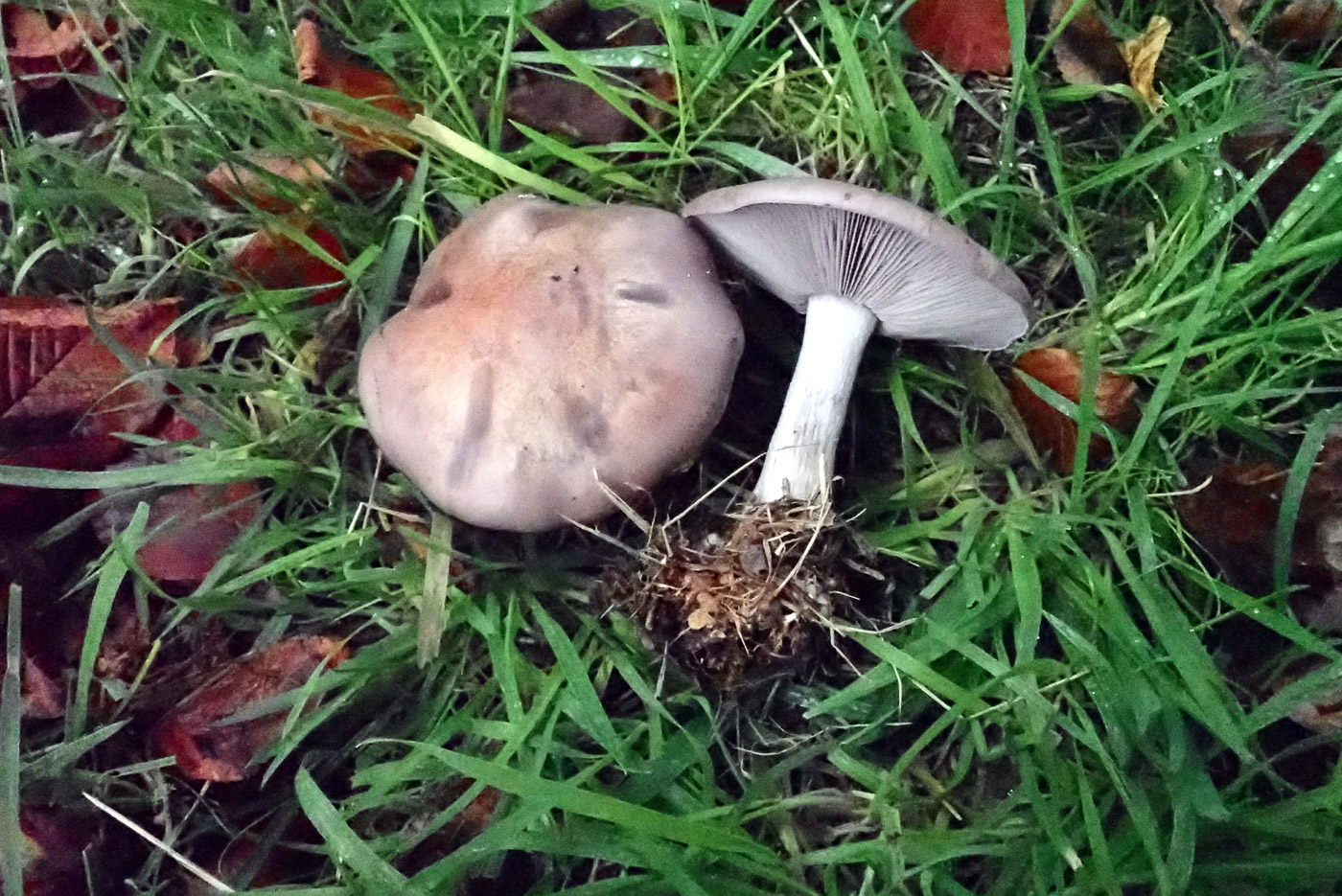
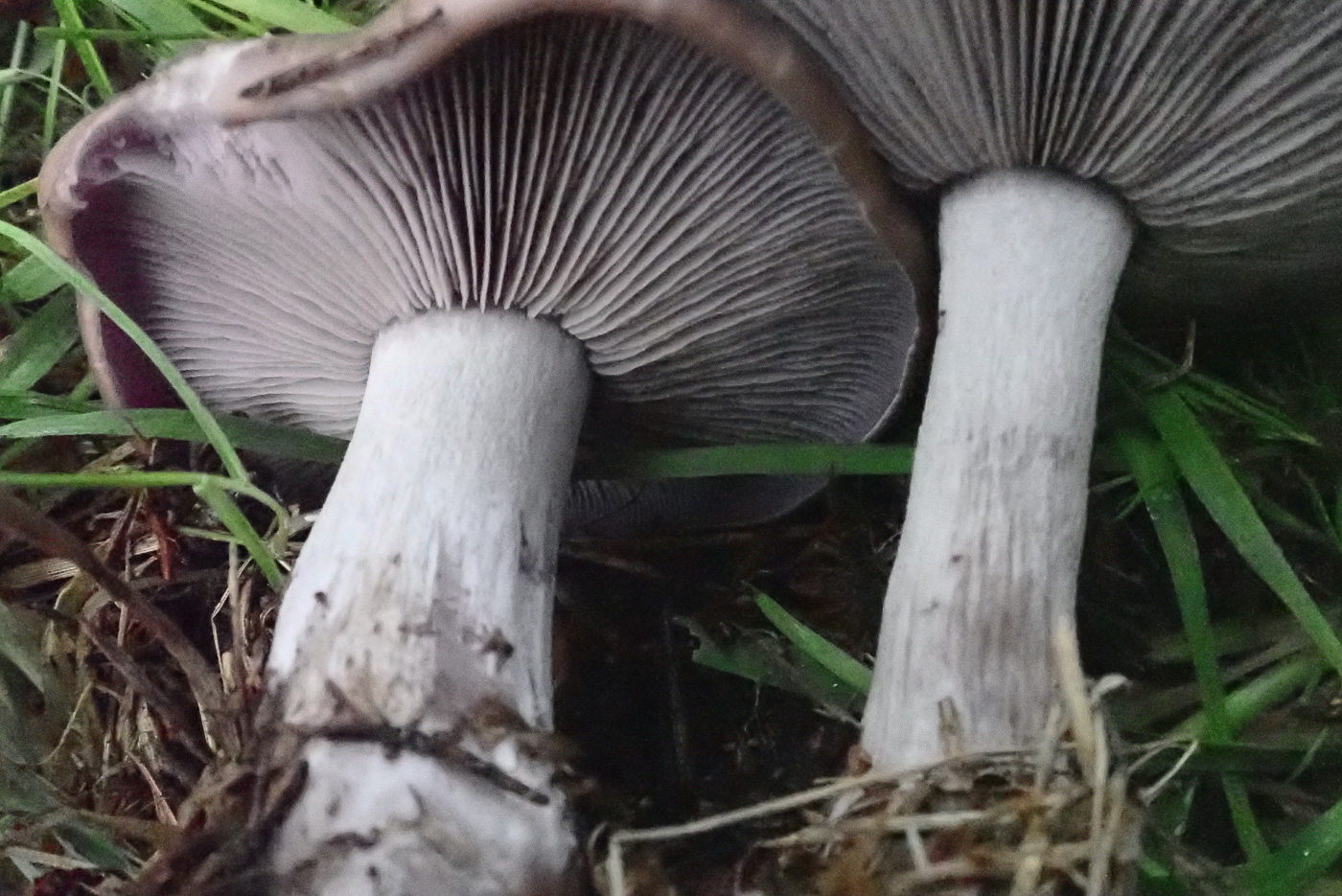
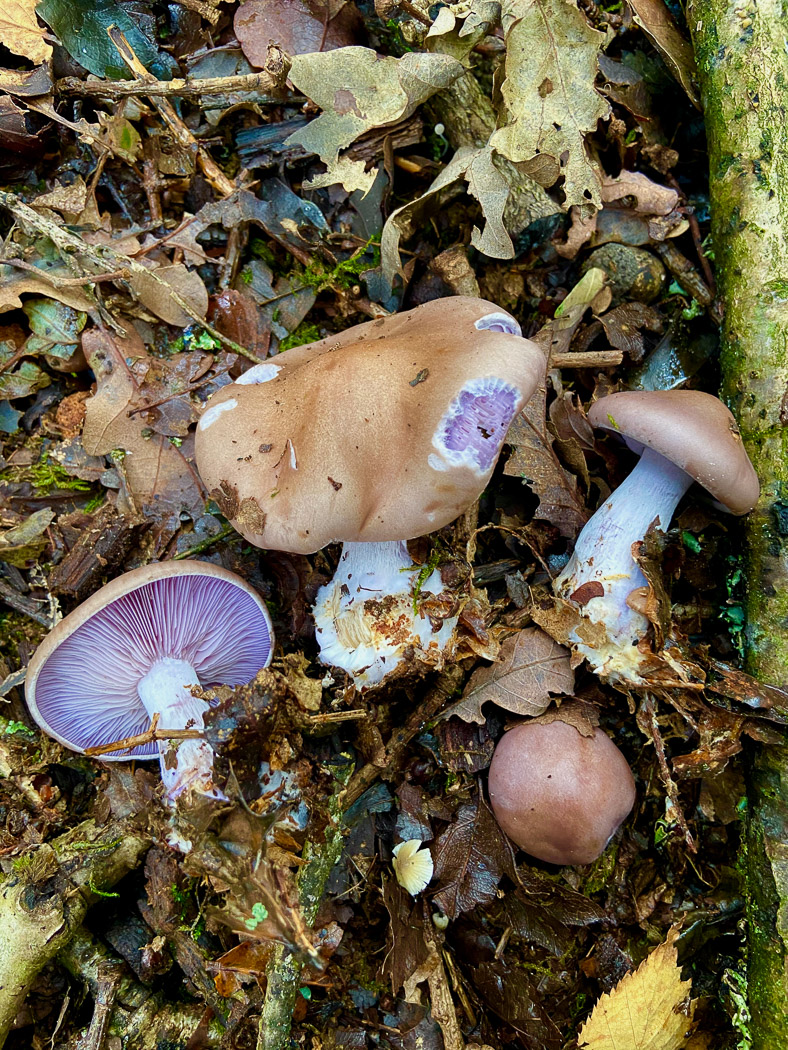
|
Lepista nuda (Wood Blewit)
Apr 1, 2023. Bob Simpson found these unseasonal mushrooms in his strawberrry bed at Salden Wood - we also found them at Rushbeds Wood the next day in rotting vegetation and which I commented in my report was unusual to find at this time. Of our 200 odd records for the species we now have just 3 for April, the rest found in Autumn except for the odd few in January.
Nov 11, 2022. In leaf litter in Brill Common Joanna Dodsworth found these nice specimens. This is a common late autumn species of the woodland floor with beautiful lilac colours both above and below to start with, though the caps turn pale brown at they mature. Beware of confusing this with the many Cortinarius species (Webcaps) which can have similar colours though Webcap gills will turn rusty brown with age and their sporeprint is also that colour in contrast to genus Lepista which has a white sporeprint. See the Masterlist for further examples.
Dec 30, 2021. In Bradenham Churchyard Penny found quite a few patches with this common species still fruiting here. This is a regular site for it and it often forms forming a huge ring amongst the grave stones The prolonged recent mild spell has no doubt caused the species to continue fruiting.
Nov 13, 2021. At Turville Heath Penny found a couple of examples of this typically late season fruiter, the first under Birch and the second under Spruce. The cap starts out a beautiful lilac but gradually turns a soft brown as it matures, though the gills retain the lilac for longer as does the stem. Do not confuse with the many species of Cortinarius (Webcap) which also can have lilac gills and stem when young but should be separable by their rusty spores which drop and adhere to the cortina zone on the upper stem. Blewits have white spores hence the stem remains pale with no rusty patch.
Oct 16, 2020 Sarah Ebdon found this collection in litter in Naphill Common. An attractive species which is often considered a late season fruiter, caps are smooth and when young often show the violet colour seen here only in the gills but gradually change to soft brown. The gills also tend to lose this beautiful colour with age and stems have no ring and tend to be clavate with pale violet flesh within. Some species of Cortinarius which also have violet gills might be confused with this species but if in doubt, take a spore print. Cortinarius spores are bright rusty brown but Lepista spores are pale pinkish cream.
|
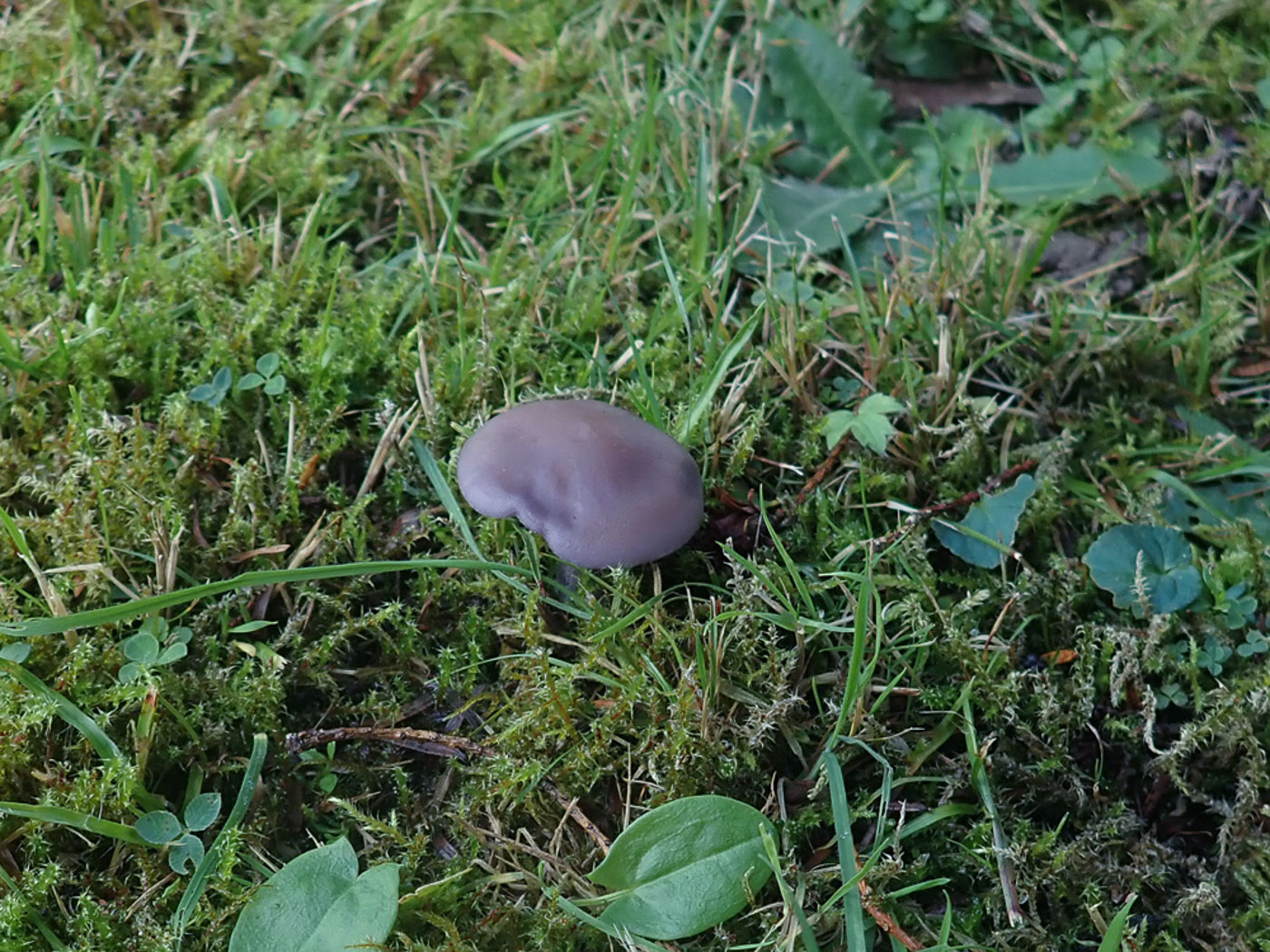
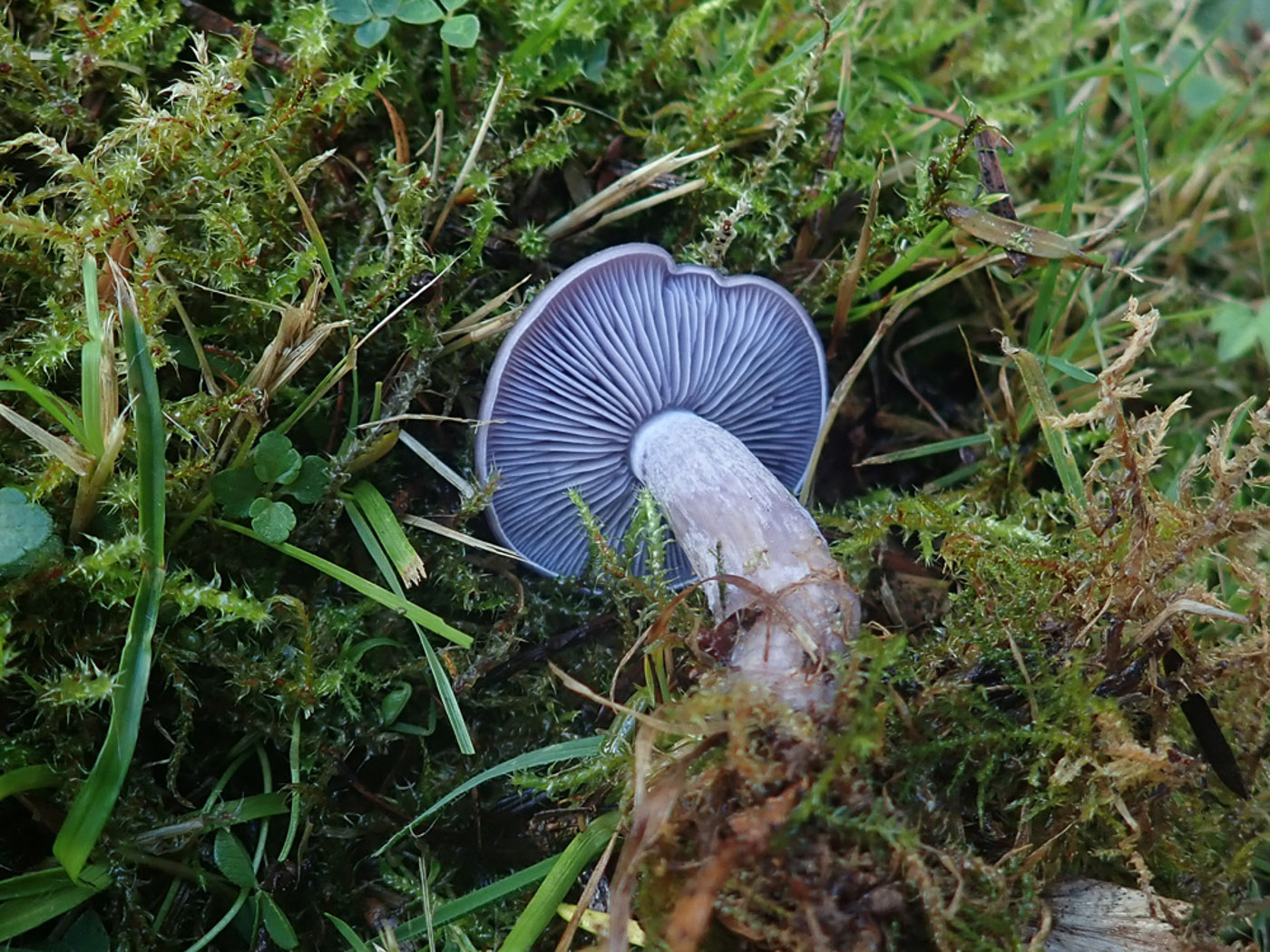

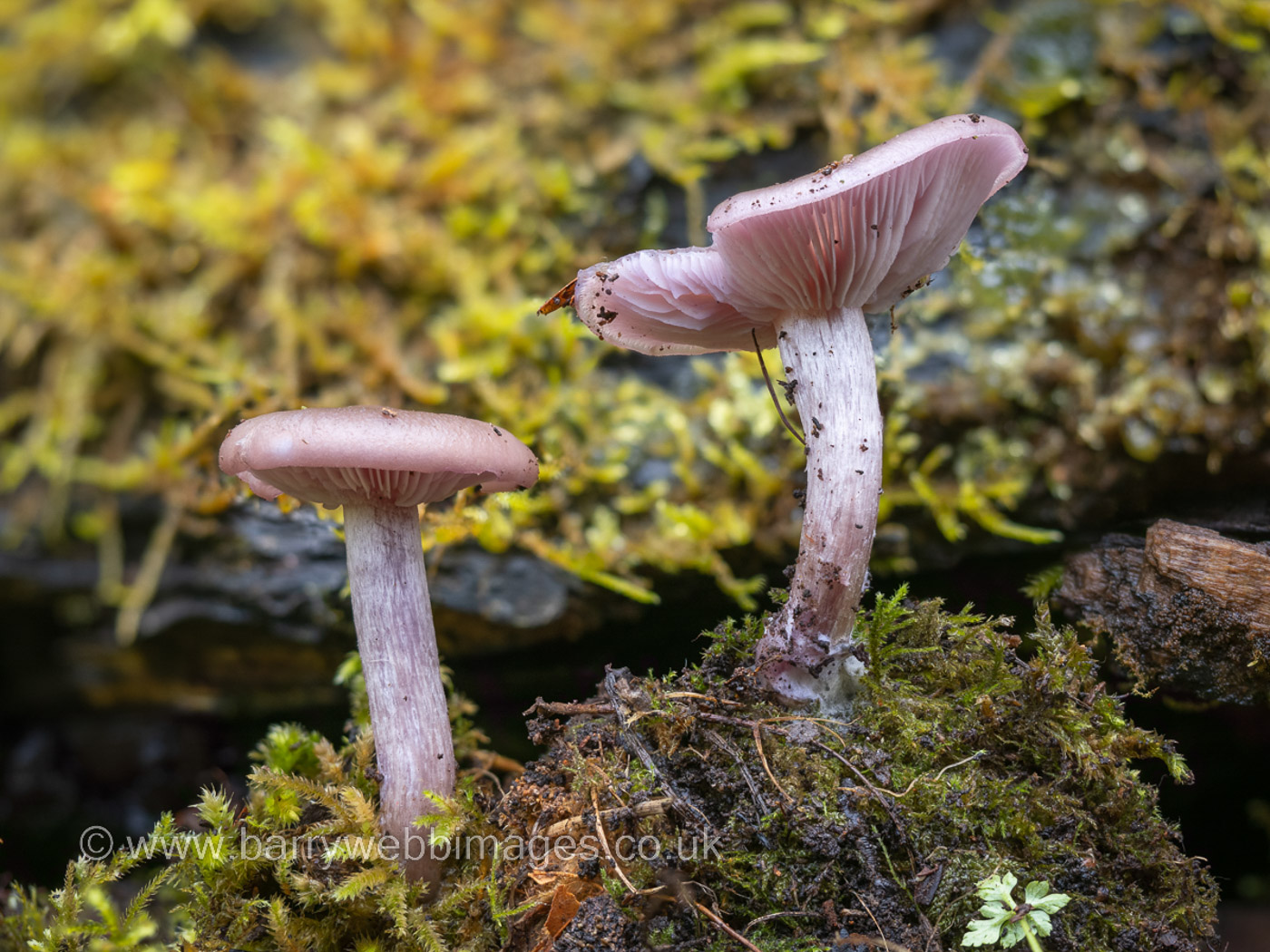
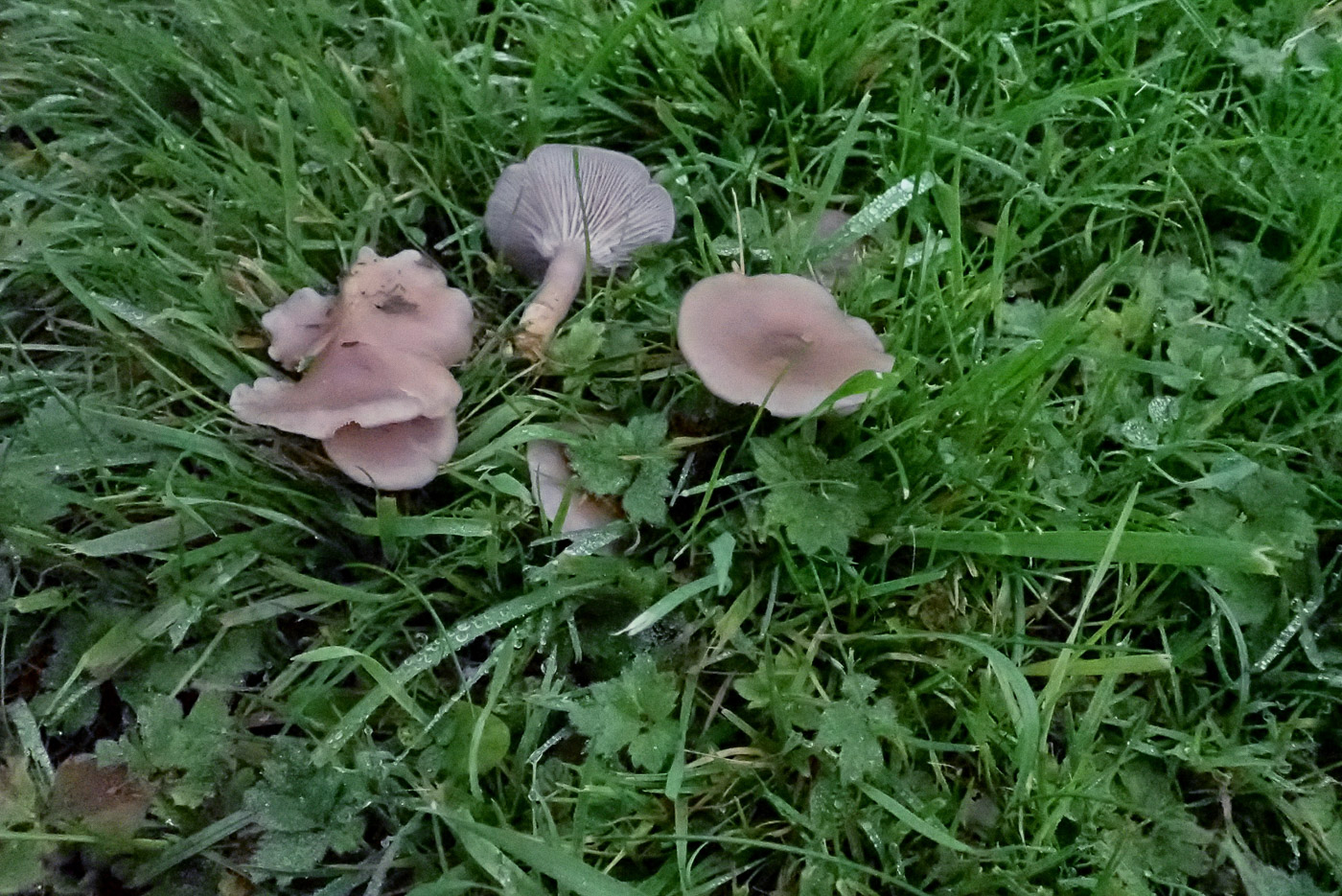
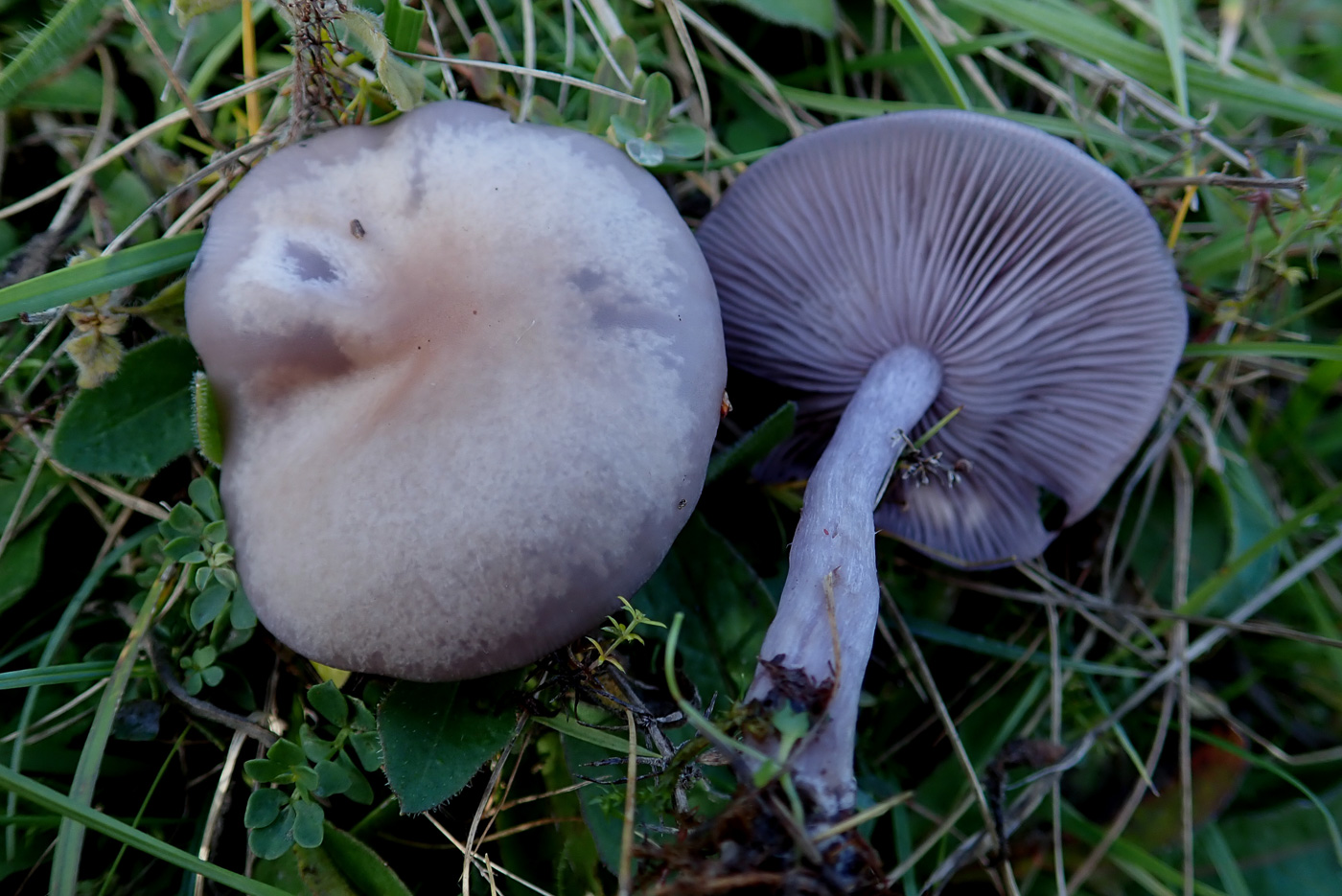
|
Lepista sordida (Sordid Blewit)
Oct 7, 2024. In mossy grass under a large Yew at Prestwood Churchyard Penny spotted this singleton with brownish but distinctly violaceous cap, and turning it over the obvious violet gills confirmed her suspcions that it was this species - considerably smaller and thinner-fleshed than the similar L. nuda (Wood Blewit). It favours grassland habitats but can also occur in woodland grassy glades but is not a s common as the larger species.
Nov 1, 2023. In Bradenham Churchyard Penny found quite a few of these coming up in thickish grass. Smaller than the closely related L. nuda (Wood Blewit) which also frequents this site but was not up yet, it has a duller darker general appearance and can lose the violet colours almost completely as can be seen in the LH example here.
Oct 12, 2022. On a mossy bank at Dancersend Claudi Soler found these two Blewits and recognised them as too small and thin-fleshed for L. nuda (Wood Blewit) which is quite a chunky species, also much more common. Both species are similarly violaceous both above and below when young though todays tends to have more pink in its colour. (The photo is Barry Webb's.)
Nov 18, 2021. In Bradenham Churchyard Penny found several clusters of this small and rather thin fleshed Blewit which often seems to cause confusion in the field. It is like a smaller version of the familiar L. nuda (Wood Blewit), rather drab and dull in comparison but usually with lilaceous tints either in cap or gills, though it lacks the bright brown which caps of its larger relative tend to develop at maturity.
Oct 25, 2020. Penny C. found this pair together in unimproved grassland at Ragpits Nature Reserve. This occasional species - far from being 'sordid' in our modern sense of the word - can be described as a slimmed down and more delicate version of the much more common and familiar L. nuda (Wood Blewit). The beautiful violaceous colour tends to fade to brown though is retained in the gills, and the cap is flatter with thinner flesh than in L. nuda which can get quite bulky in comparison with a considerably thicker stem. Compare with photo of that species dated Oct 16.
|
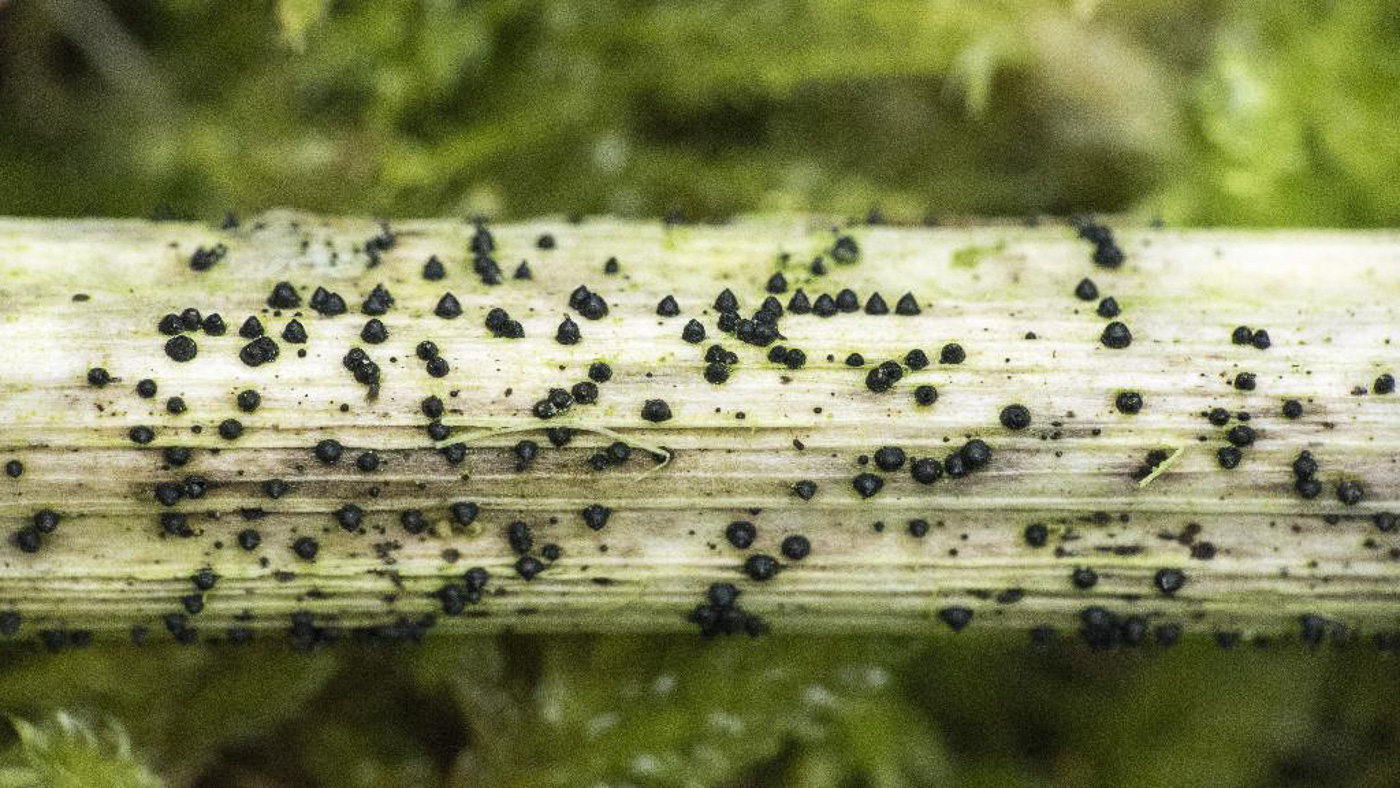
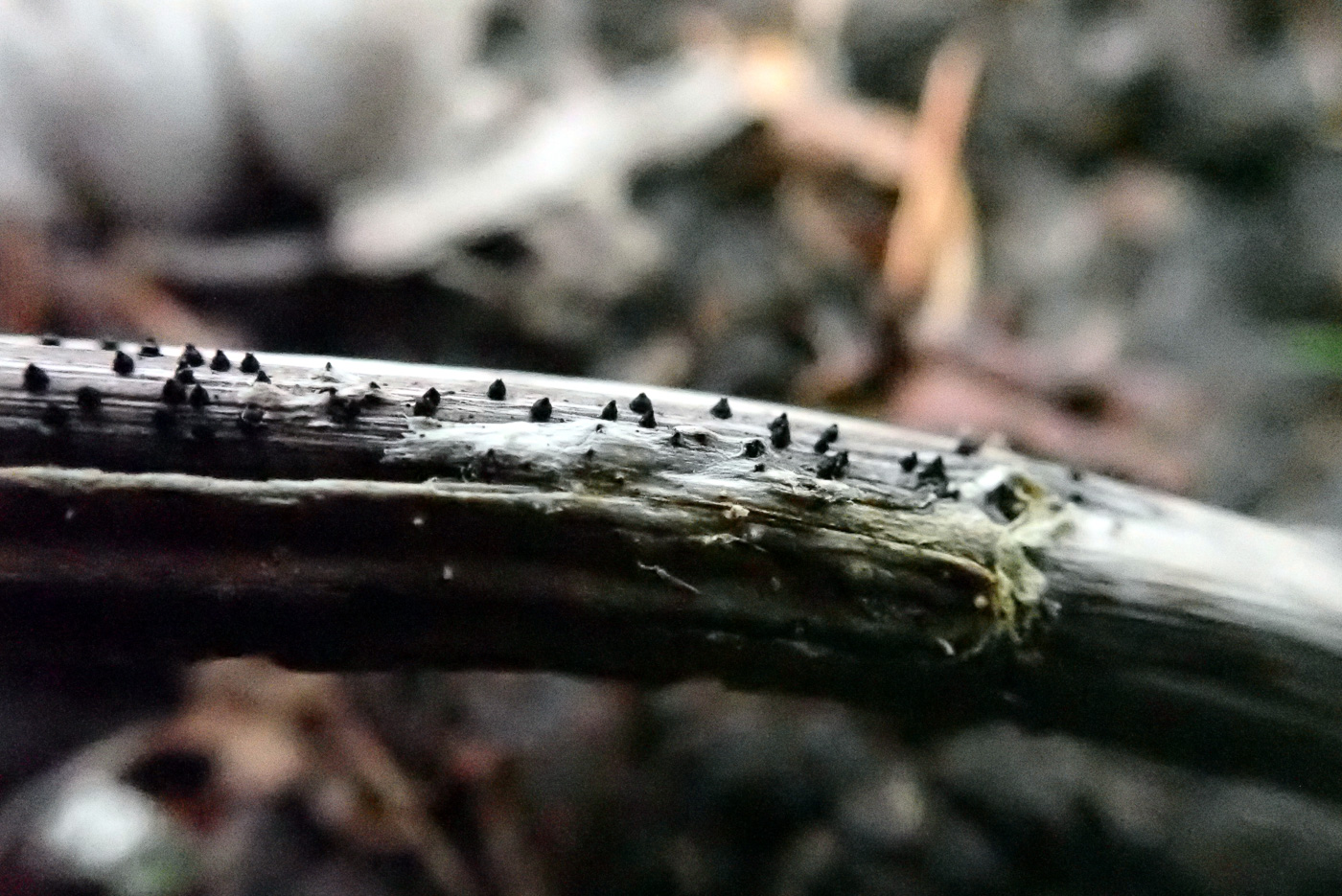 |
Leptosphaeria acuta (Nettle Rash)
Feb 1, 2022. In Rushbeds Wood Penny found extremely little to report despite the present milder spell, so resorted to looking for two small and very common springtime Ascos found on the lower part of last year's Nettle stems. She then discovered she'd left her camera behind! So the photo here is Neil Fletcher's, taken at this site in April 2017 and showing a typical cluster of shiny black 'bee hives', each less than 0.5mm high. This is one of two species to look out for on nettle stems over the next couple of months.
Mar 27, 2021. At Turville Heath Penny pulled up a dead nettle stem to find this very common springtime Ascomycete - a species one can almost add to any foray list where nettles occur before actually locating it (ie affectionately known as a 'bums on seats' species!). The tiny shiny black 'wigwams' - less than 5mm across - are easy to spot with a hand lens on the pale stem bases of nettles at this time of year.
|


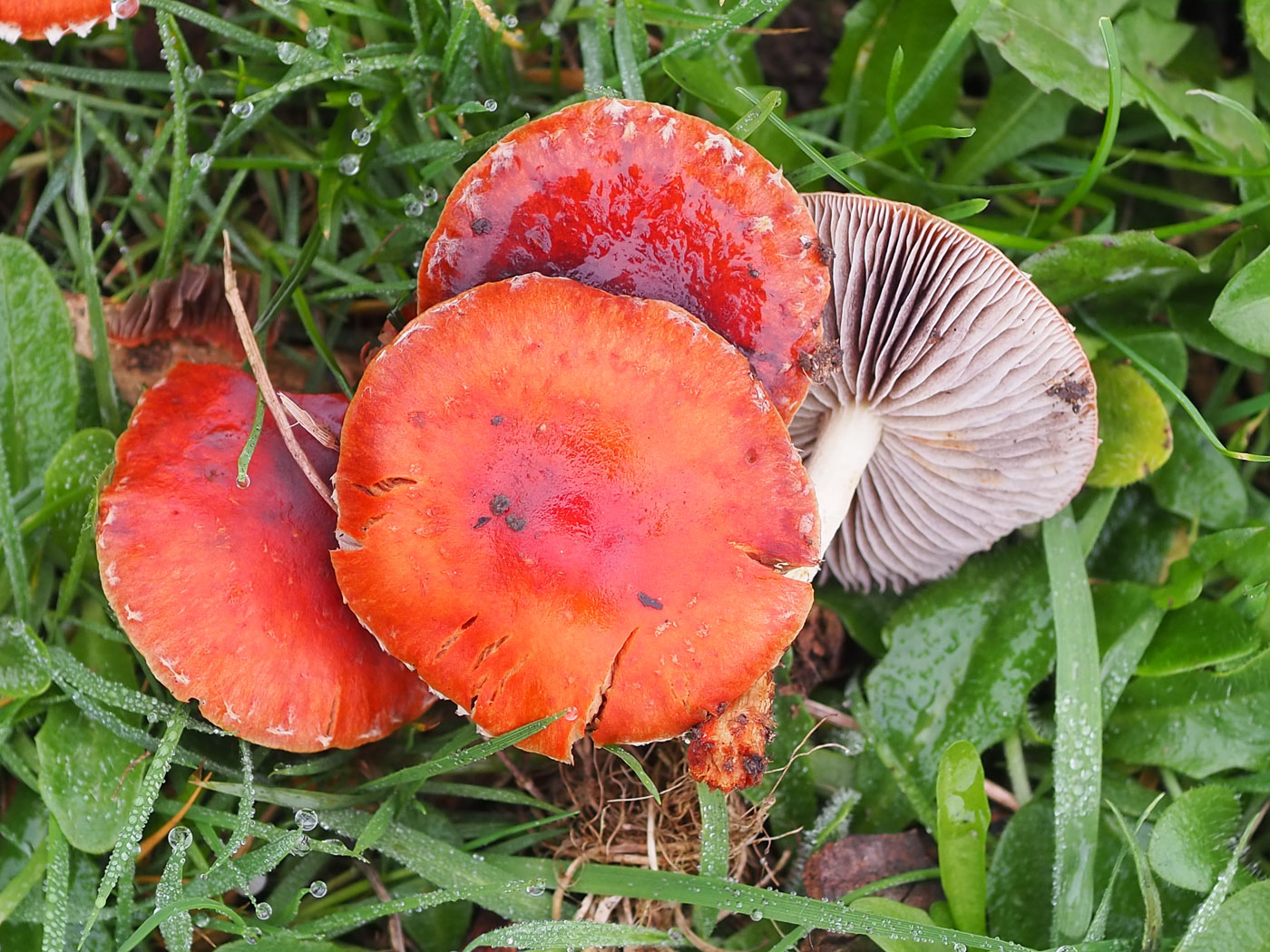
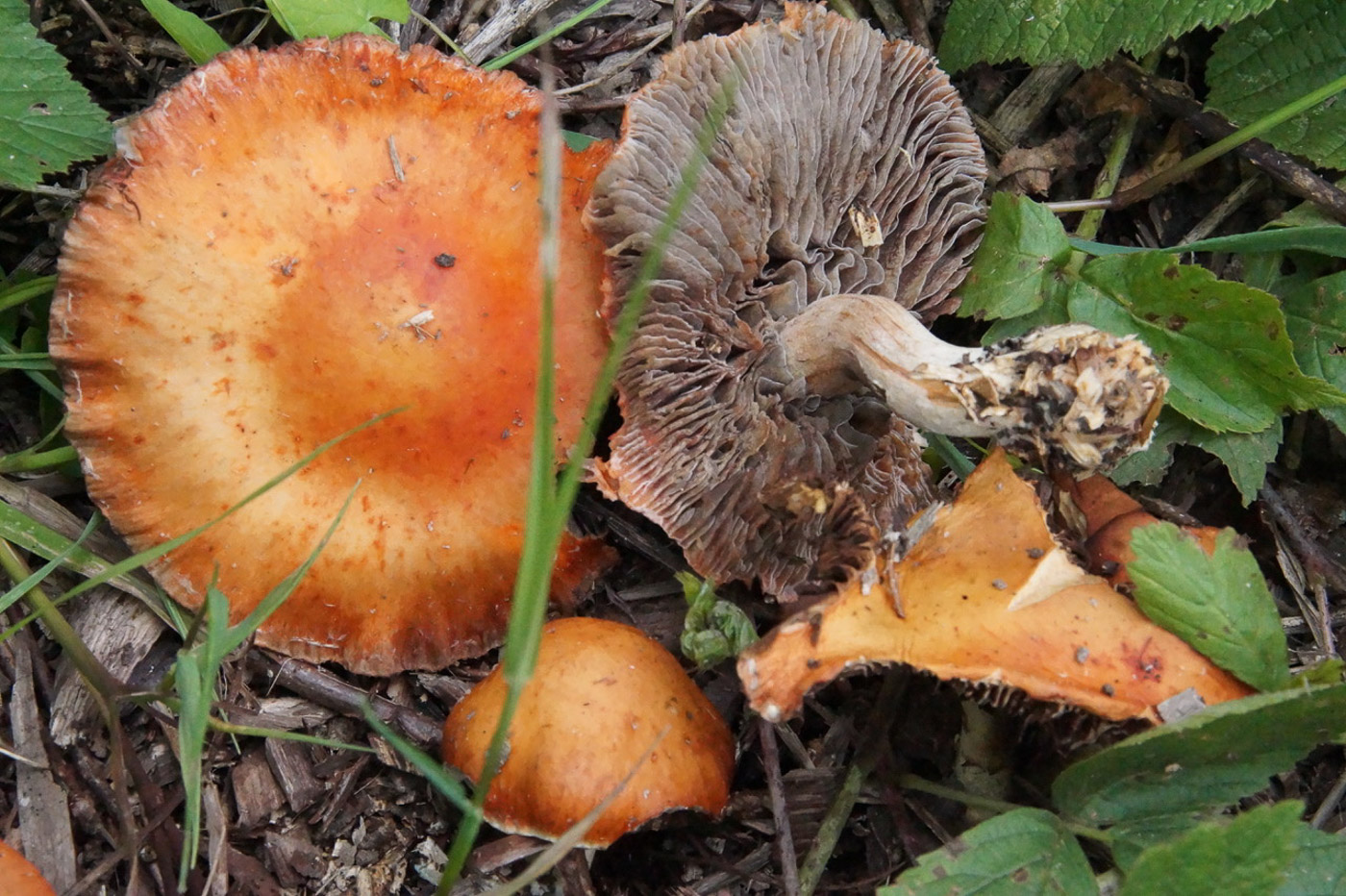
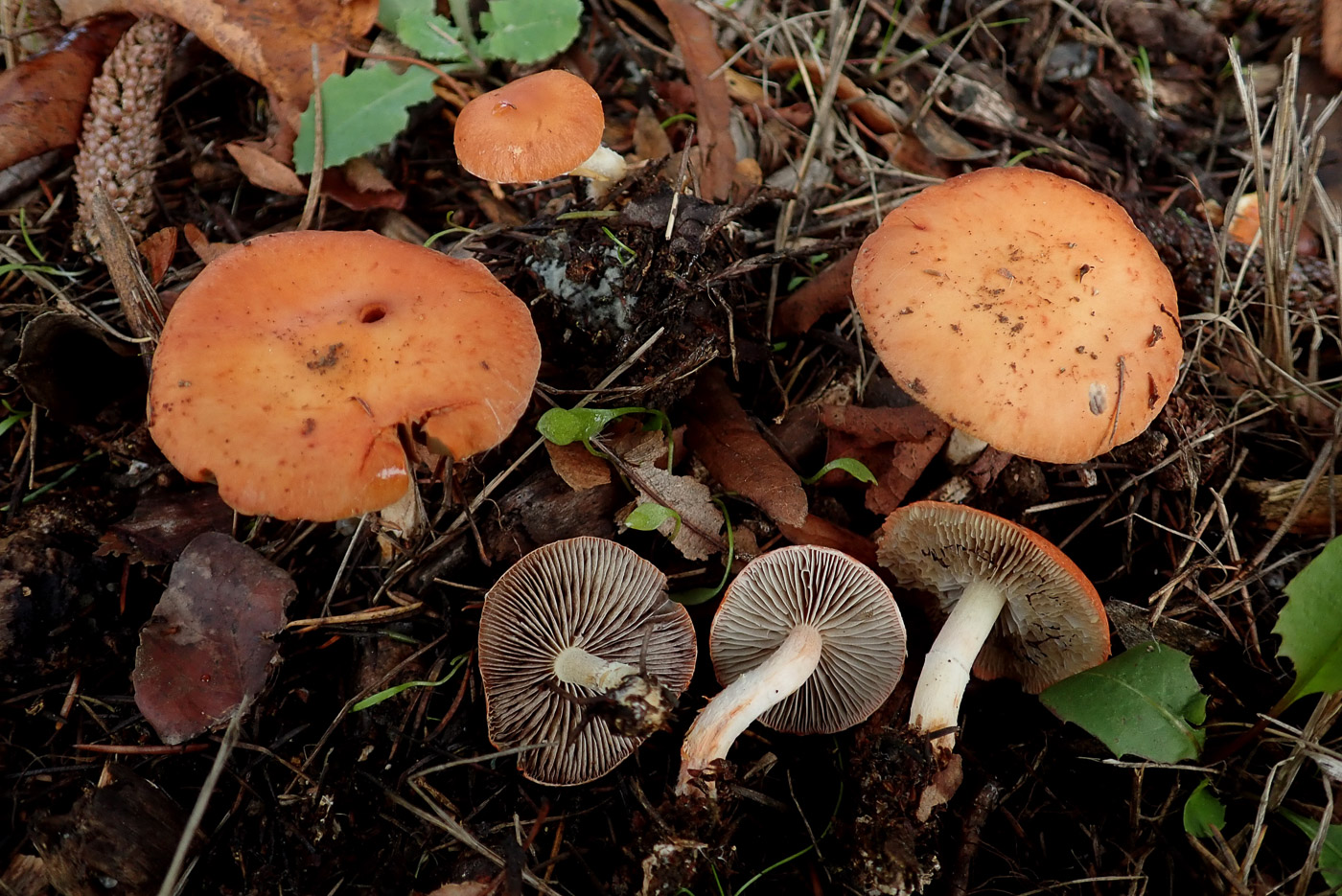
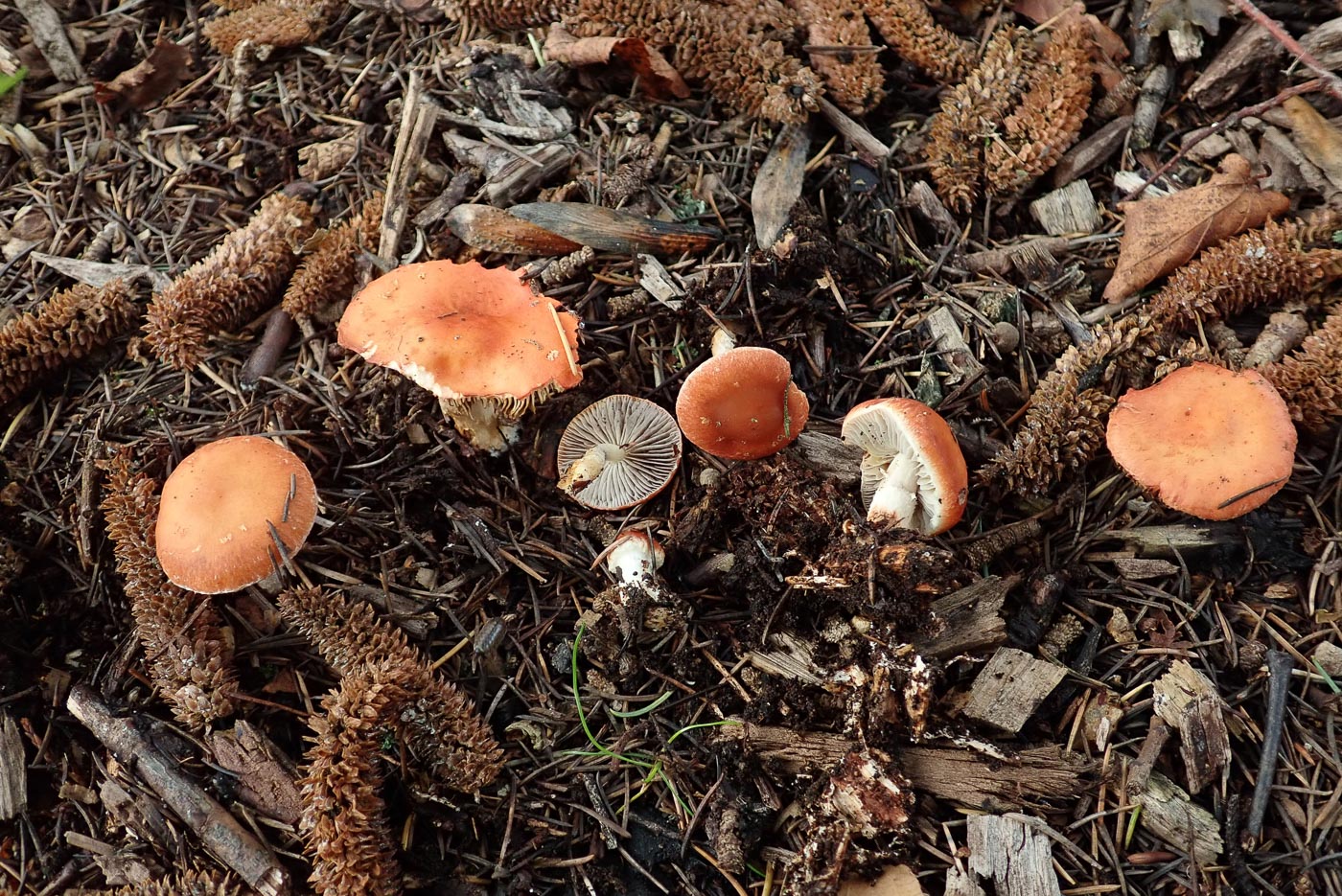
|
Leratiomyces ceres (Redlead Roundhead)
Aug 4, 2023. In Hodgmoor Woods Penny spotted two bright red caps amongst the thick decidous litter and assumed it was a species of Brittlegill until on closer inspection the thin long stem became apparent. What was it? Surely not L. ceres? That species occurs in woodchip piles, though the colour and shape was correct. Turning one over to reveal the dark gills - the species has almost black spores - she confirmed to her surprise that it was indeed that species. Though now very common wherever woodchip has been spread, the species is new to the site (and this is one of our best recorded woodland areas) and Penny has never seen it in natural woodland environment before.
Nov 15, 2022. In Hughenden Park John Catterson came across about 30 of these fruiting abundantly on old wood chippings. Given its woodchip substrate this species, previously known as Stropharia aurantiaca, is now often found in good numbers and is one of several species which have spread rapidly with the popular use of woodchip for mulch.
Sep 2, 2021. In Salden Wood on a woodchip pile Bob Simpson noticed these medium sized brightly coloured mushrooms which were unfamiliar to him. The orange cap and grey gills together with the substrate left Penny in no doubt over its identity - a species previously and better known as Stropharia aurantiaca. Over the last 20 years or so it has come from being a rarity to very common on woodchip everywhere and was originally an Australasian species which has been imported no doubt with its substrate.
Oct 28, 2020. Paul and Penny C. found a patch of these brightly coloured mushrooms on woodchip in Stoke Poges Memorial Gardens. Previously known as Stropharia aurantiaca, this is a species which rare in the UK in the '80s - probably imported from Europe with woodchip - and has rapidly spread becoming very common wherever woodchip is used. Caps can get to about 4 cms across, gills are eventually dark greyish, stem is white with remnants of a ring zone. The orange cap colour and woodchip substrate make this an easy species to identify.
|




|
Leratiomyces squamosus (Slender Roundhead)
Nov 3, 2023. In deep Beech litter in Pullingshill Wood Penny found one pristine specimen of this quite unusual species, previously in genus Stropharia. The pale yellowish beige cap, slimy in wet weather, has white flecks of veil within the slime, dark spores which colour the crowded gills as it matures, and a stem which is floccose below the distinctive ring. Photo 4 is of another singleton found two days later in Downley Common by Laura Paterson, also in deep Beech litter. We have just one previous Finds entry as Stropharia squamosa dated 2020 October 11th
|

 |
Leucoagaricus badhamii (Blushing Dapperling) 
Nov 1, 2023. In Chalfont St. Peter Jesper Launder found this distinctive pair - obviously Dapperlings with the typical free white gills but clearly strongly reddening then turning almost black when handled. A quick check at home confirmed his suspicions as to its identity. The species is not that common and seems to favour urban sites with woodchip; here it was under Leylandii. This is a new entry for Finds.
|
 |
Leucoagaricus cf. carneifolius (a rare Dapperling with no English name) 
Oct 7, 2024. In mossy grass under a large Yew at Prestwood Churchyard Penny noticed what she at first thought might be a small Agaricus - two immature frutibodies, one with ring still covering the gills, the other with ring just disrupting to reveal white crowded gills which had a faint pink glow. The caps were velvety smooth and pale grey but to her surprise a scratch to both cap and stem turned neither yellow nor pink as one would possibly expect in Agaricus. At home there was no sign of the gills becoming darker, nor was there much smell, but there was no point in attempting a spore print with such an immature specimen. So Leucoagaricus seemed the likeliest genus and the only near match seems to be carneifolius though there are a few discrepancies, hence the cf in the identification. There are under 30 UK records so this is clearly one for sequencing.
|
 |
Leucoagaricus croceovelutinus (a rare Dapperling with no English name 
Nov 2, 2023. In Stoke Common Memorial Gardens in woody litter Jesper Launder was (rightly) excited when he spotted this small mushroom which was clearly strongly reddening throughout. He recognised it was close to but different from L. badhamii (Blushing Dapperling), so keyed it out with care at home. The species is new to the county with only 16 national records in FRDBI, none since 2004. This collection has now been confirmed with sequencing.
|
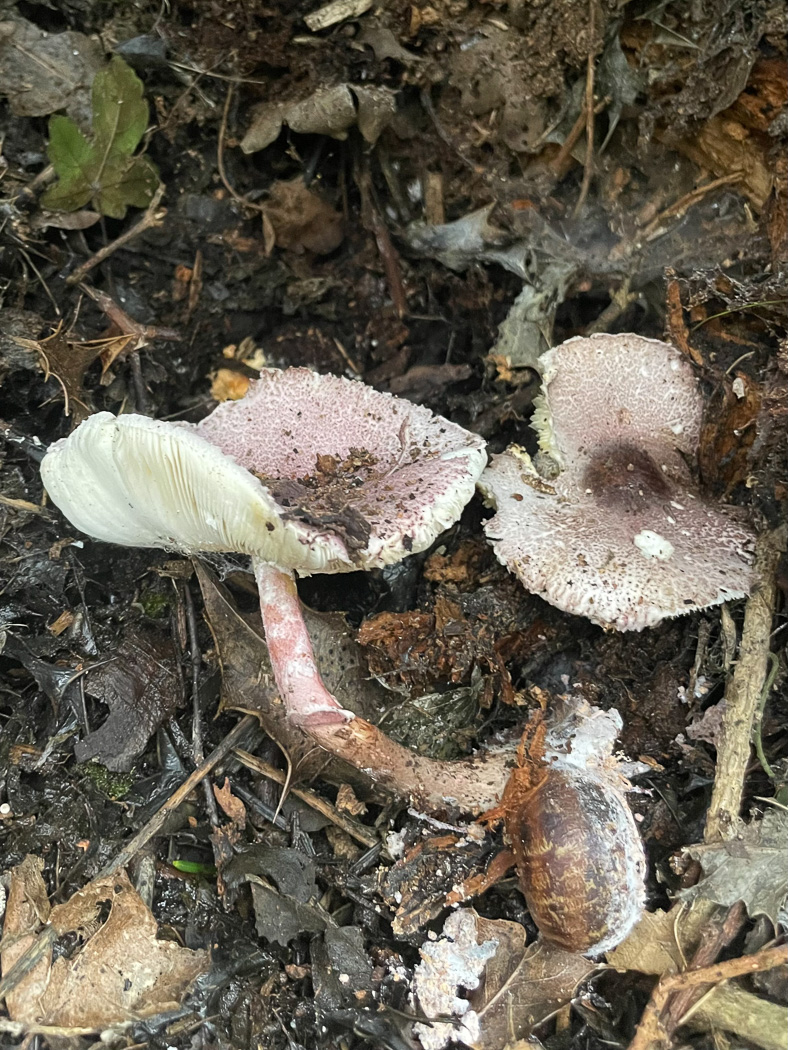
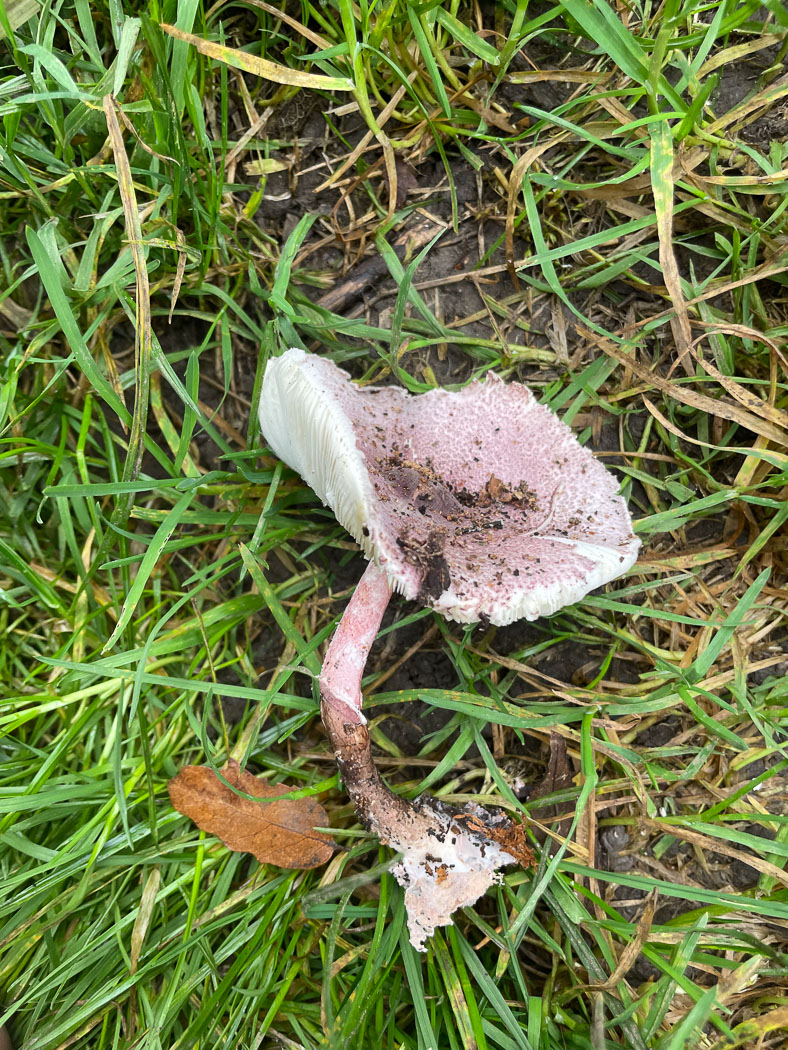

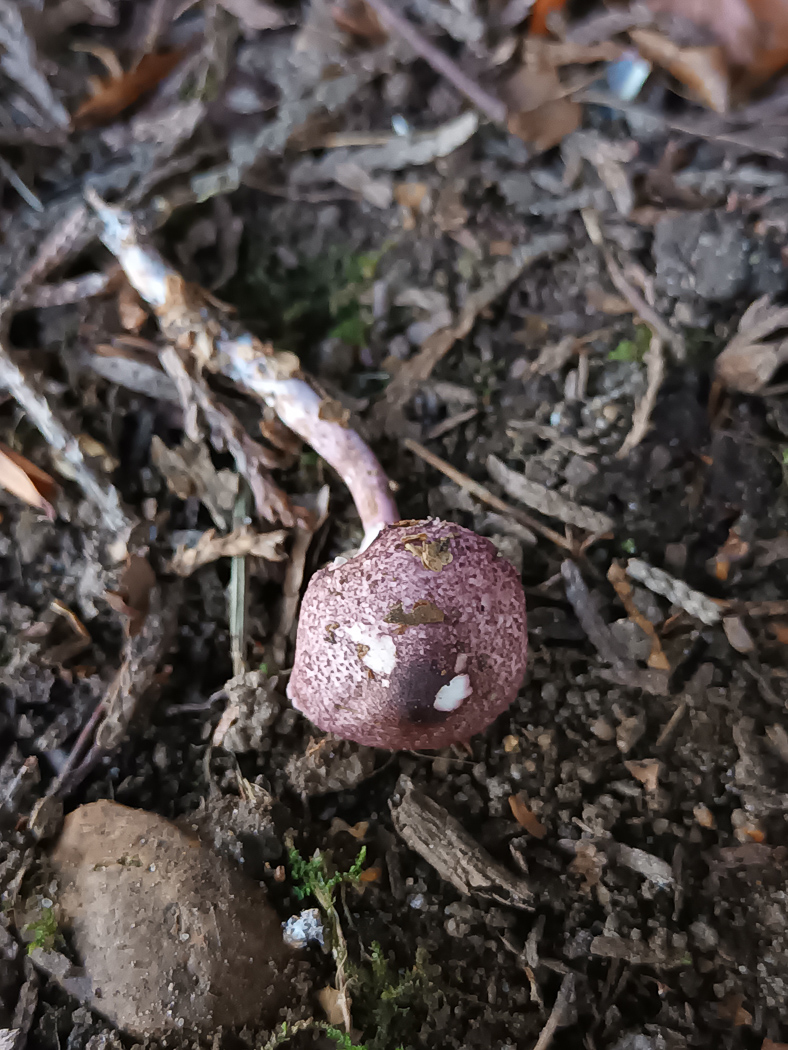
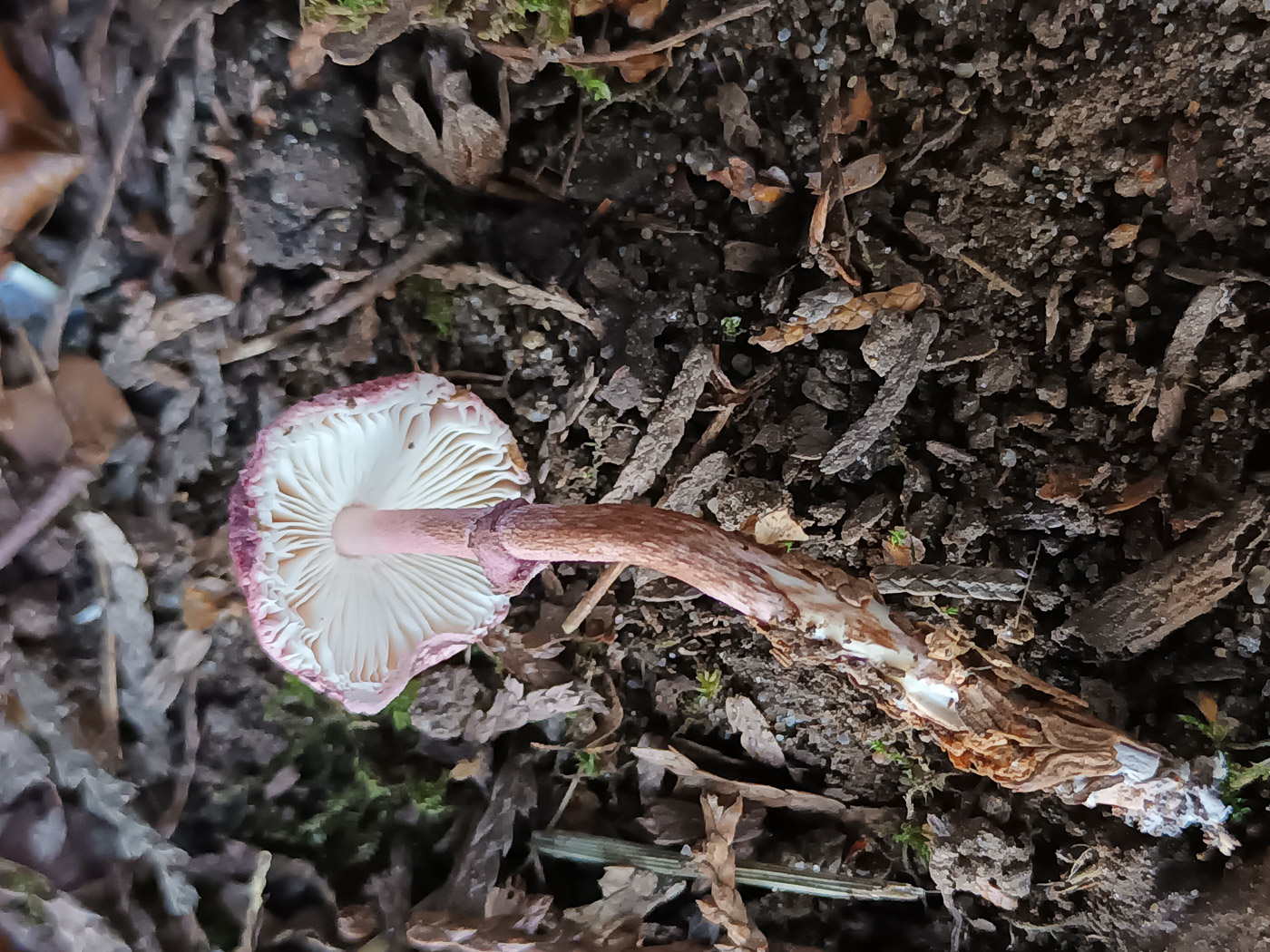 |
Leucoagaricus ionidicolor (a Dapperling with no common name) 
Nov 1, 2024. In Naphill Common Sarah Ebdon was amazed to come across this rare and beautiful species which she'd also found on our Walk at Mousells Wood only a week earlier. Today's was not quite such a photogenic collection (see her stunning photo in the Mousells Wood October 23rd report) but nevertheless recognisable by its remarkable and unique violet tinted cap and stem contrasting with the white crowded gills.
Oct 11, 2023. This rare and beautiful mushroom was found by Jesper Launder in Penn Street Churchyard in conifer litter which it favours. The link to the genus Lepiota is clear in its white free gills, stem with a fleeting ring and dry squamulose cap surface. The species is rare all over Europe and we have just two previous county records, one found by Jesper again (see in Finds 2021 November 21) and the other interestingly found by Derek at this same site in 2014. (The photo is Sarah Ebdon's.)
Nov 21, 2021. In Jordan Village whilst dog-walking Jesper Launder noticed this very rare beauty by torchlight (!), returning the next morning for the photos. An unmistakeable species, it has this unique vinaceous pink colour on both the finely scaly cap and the stem which has a ruff-like upturned ring also this colour, contrasting with the white gills. Closely related to the genus Lepiota, the species is considered rare all over Europe with few British records and just one previously for Bucks, it apparently favours calcareous woodland litter - both deciduous and conifer. What a find!
|




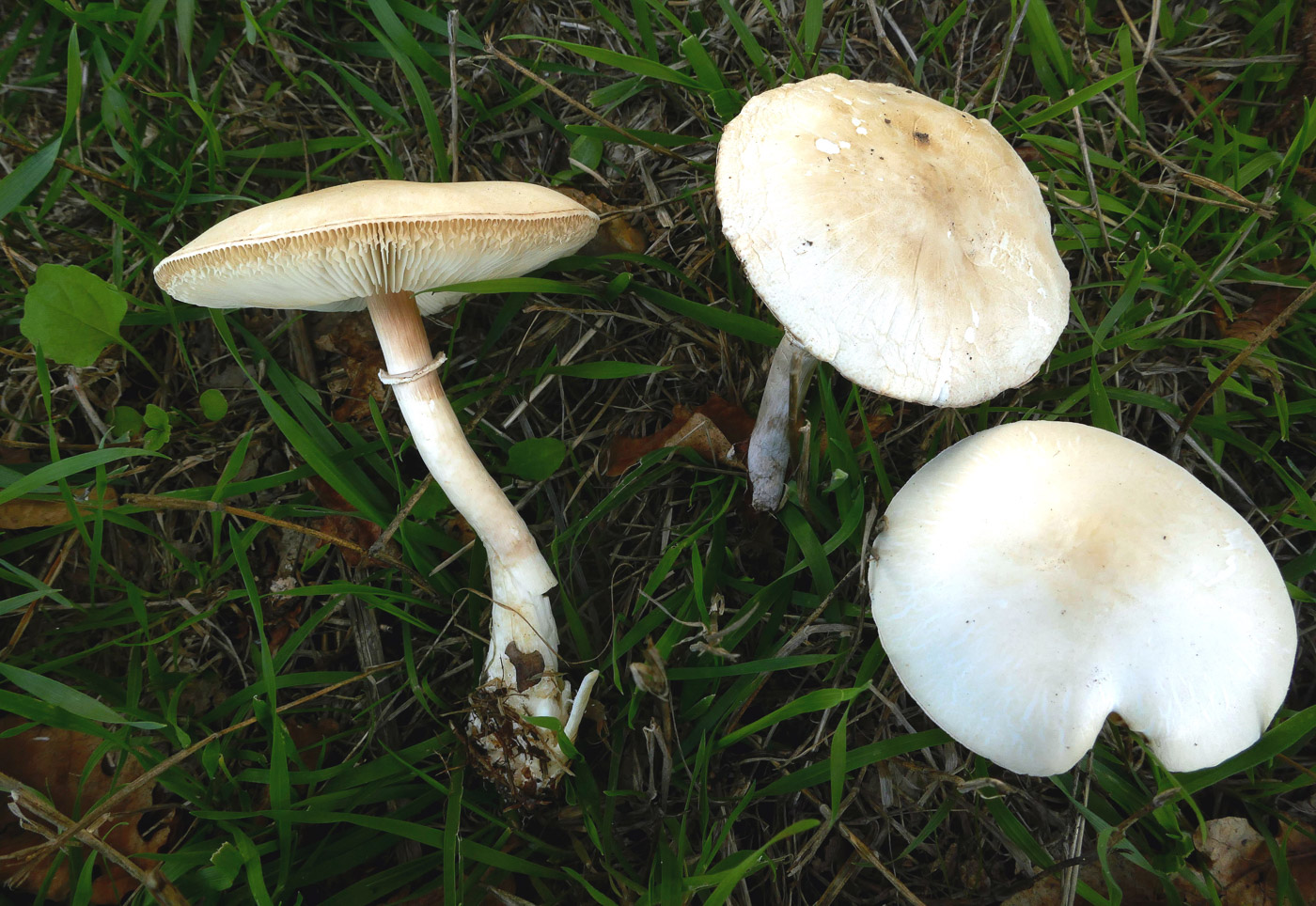
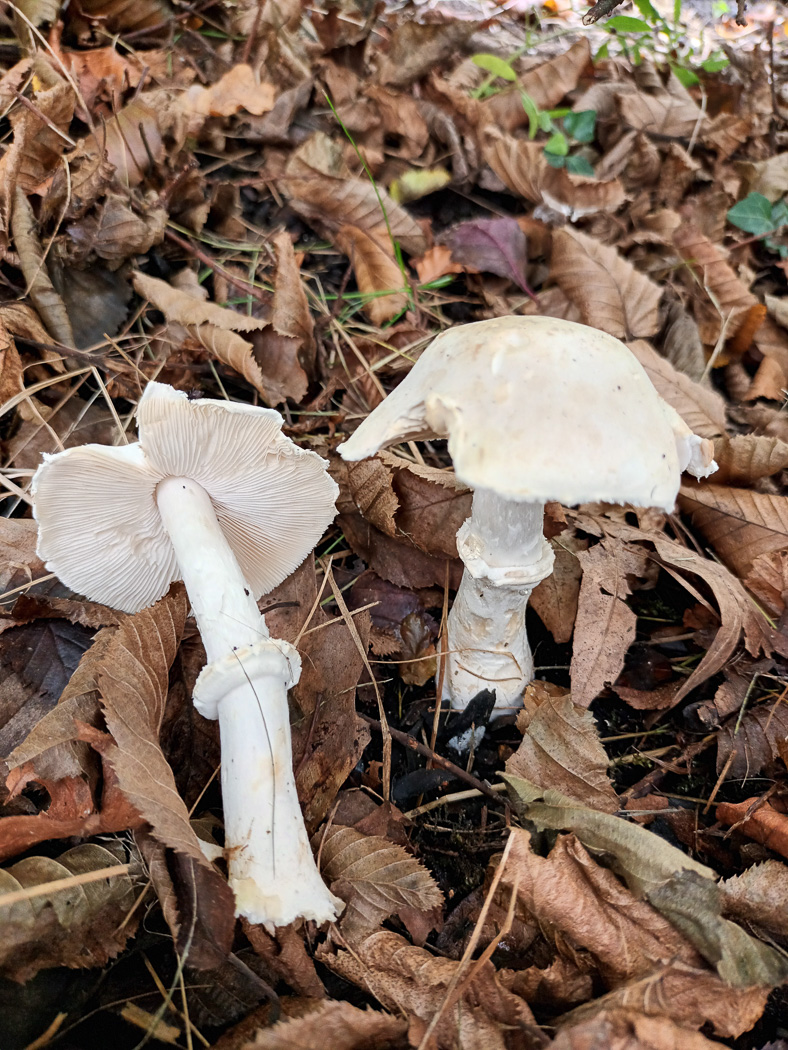
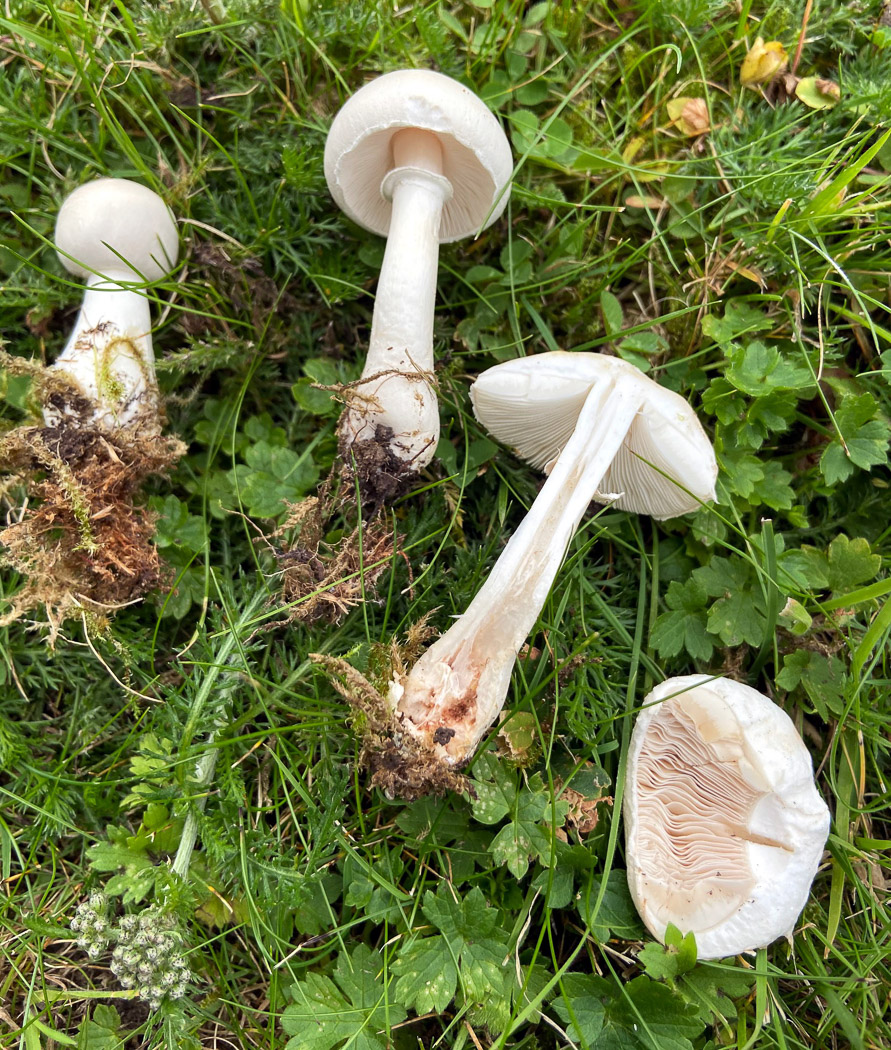
|
Leucoagaricus leucothites (White Dapperling)
Apr 12, 2024. Jim Wills noticed this impressively large pair of white mushrooms fruiting in a trough in a pub garden near Stoke Poges containing winter / spring flowers. The largest cap was 12cm across, so these were sizeable specimens! He took a spore print to make quite sure the spores were indeed white as its white gills suggested (hence pointing to genus Leucoagaricus), then checked the microscopic details which indicated it was L. leucothites or some closely related species. However, its impressively he large size pointed to the rare L. subcretaceus which would have been new to the county, so a sample was dried for sequencing. Disappointingly the result showed a perfect match for the much more common L. leucothites though this is our earliest county record by several months.
Sep 16, 2022. At Stampwell Farm in a grassy path edge, Jackie Ewan spotted this trio. On first seeing this species it's difficult to believe, judging from the cap, that it's not an Agaricus and that the white gills will eventually not darken through pink to the black of that genus when mature. They won't! They remain white, as are the spores.
Oct 19, 2021. In grass near Chalfont Dean Jesper Launder found this pair looking like two tall members of Agaricus with white caps and a ring on the stem, but although the gills are free (ie not attached directly to the stem) as in Agaricus, in Leucoagaricus they remain entirely white. Sometimes this can be hard to assess because young examples of Agaricus can have pale gills but they will always eventually turn through pink to brown and then black as the spores mature. The spores in today's species are white, however.
Sep 11, 2020. This collection was found on the lawn of a private garden in Tylers Green by Sarah Ebdon. It is a species easily mistaken for an Agaricus until one notes that the gills remain white or palest pink in age whereas the gills in Agaricus turn gradually darker as it matures and end up purple-black. One could also mistake it for an Amanita with its white free gills and ringed stem having a slightly swollen base. However, the white capped species of Amanita all have a distinct volva with a rim, not present here, also the ring on the Leucoagaricus is mobile (i.e. can be moved up or down), not so in Amanita. This is a grassland species (also unlike Amanita), in some years quite common, in others much less so.
|
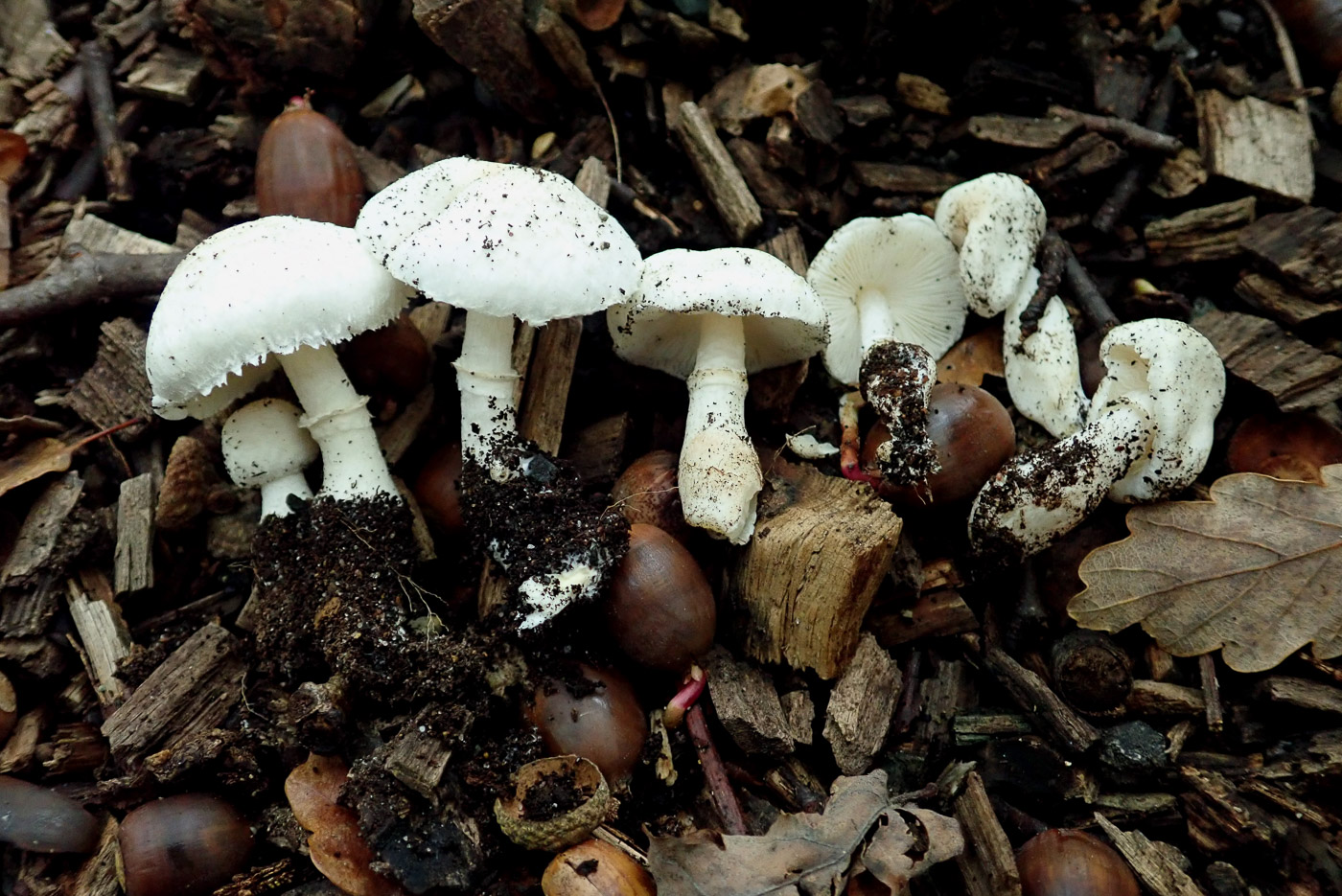 |
Leucoagaricus sericifer (a Dapperling with no common name) 
Oct 19, 2020. Claudi Soler found this rare species on the same woodchip pile as the Melanophyllum in Burnham Beeches - identified by Geoffrey Kibby, photo Penny C. An all white species with a silky cap and delicate ascending ring on the stem which is soon lost, this was a nice find as we have only one previous county record. Caps can get to 4.5 cms across but these were smaller, and it occurs in deciduous woodland usually on soil.
|
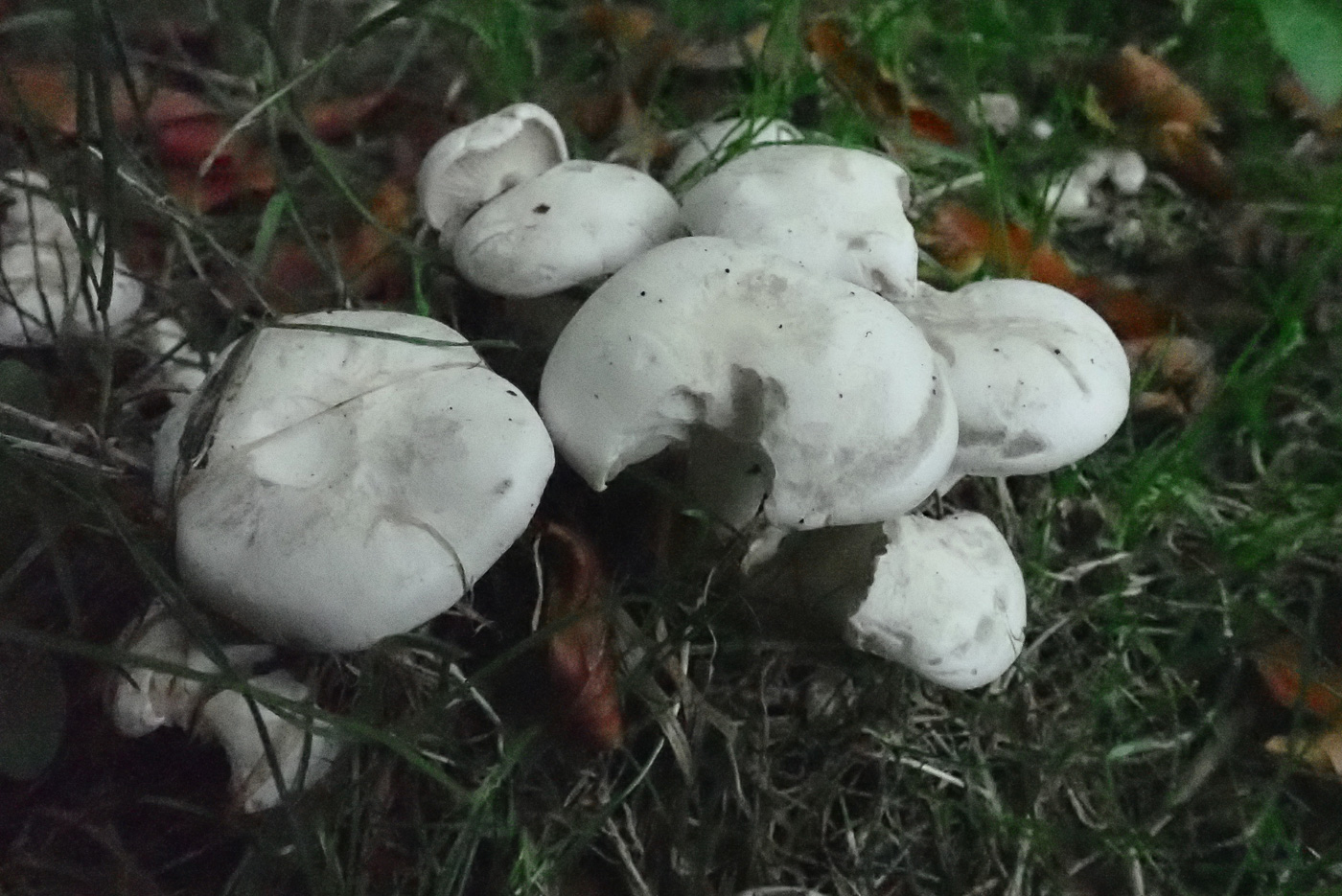
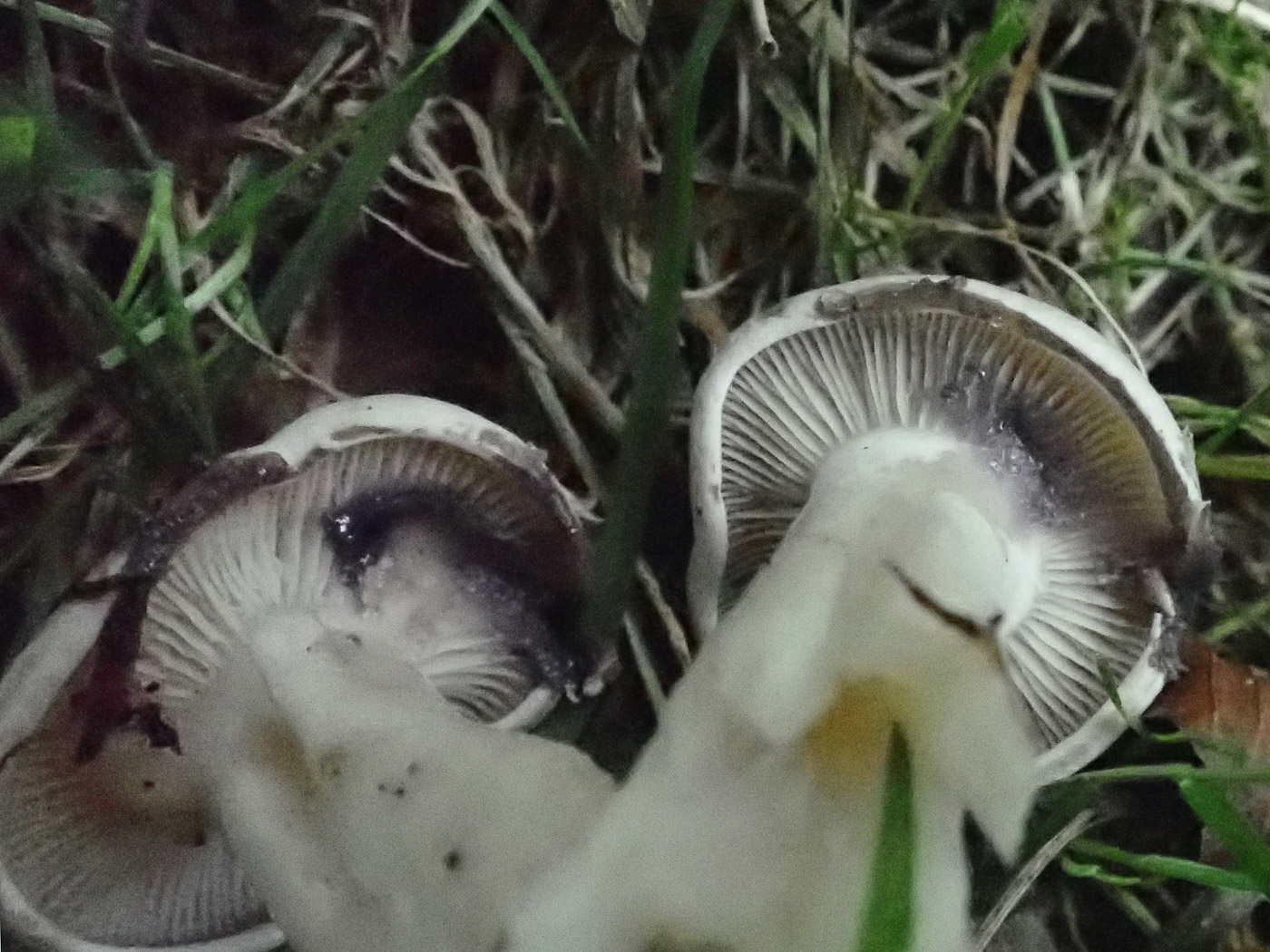
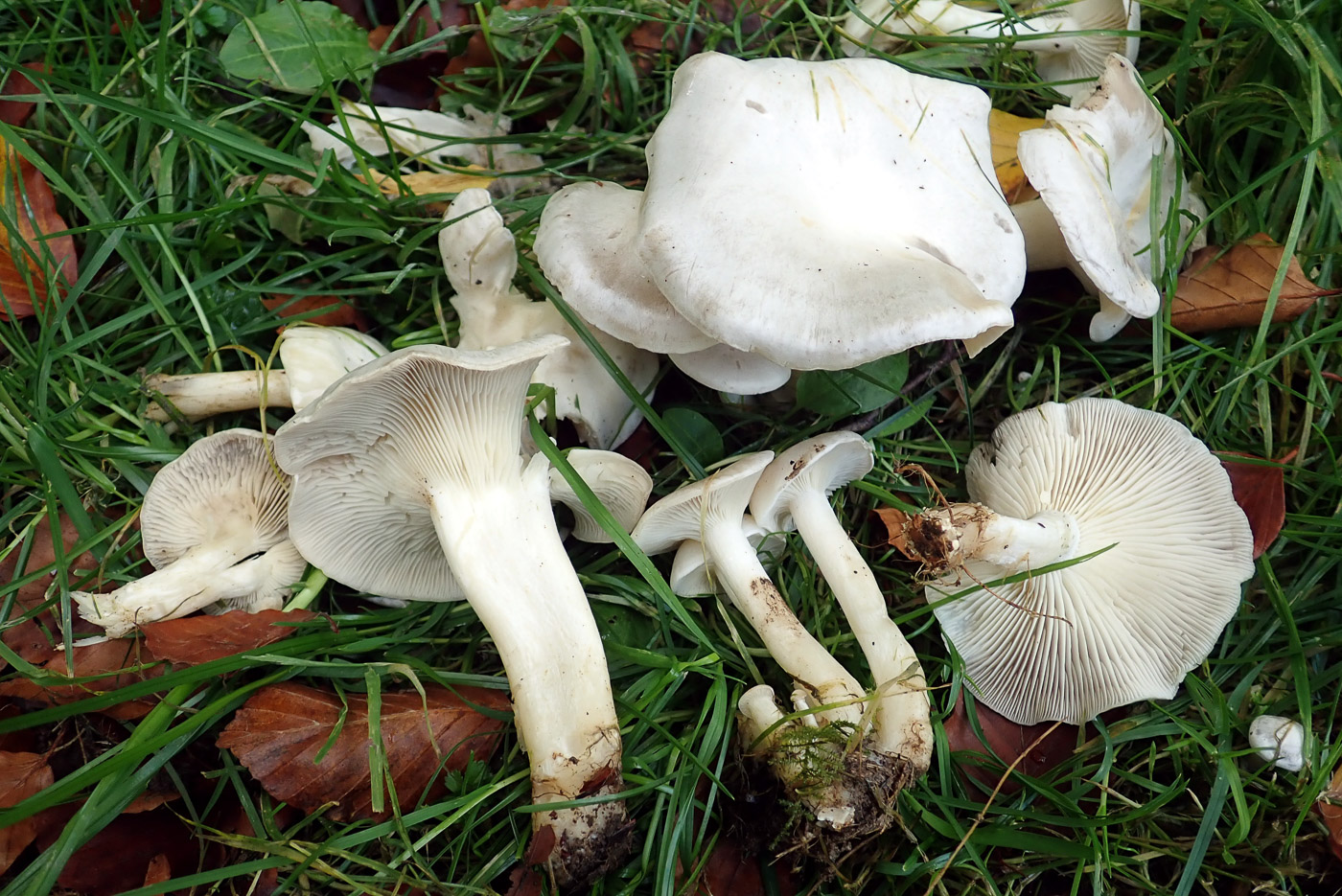
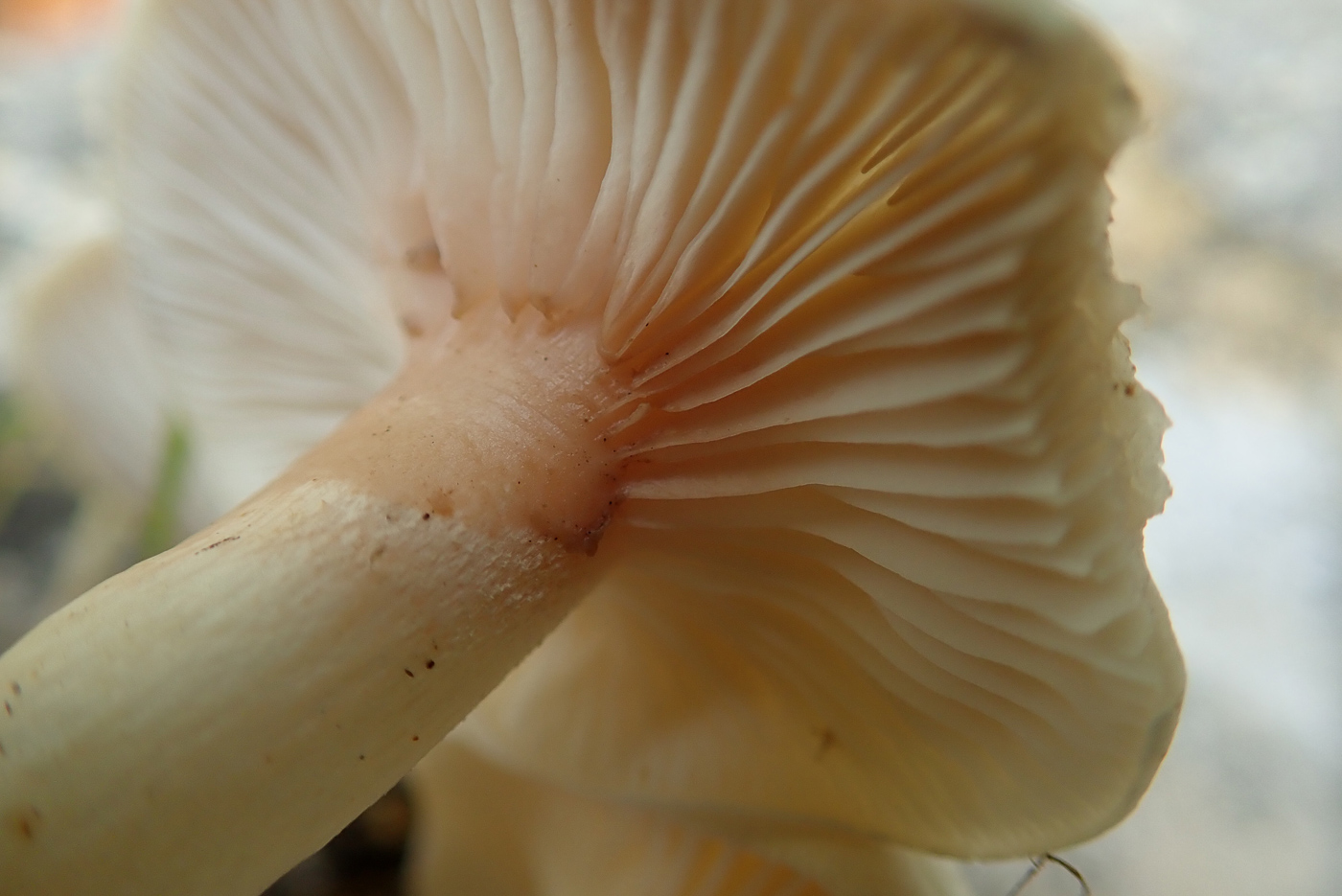 |
Leucocybe connata (White Domecap)
Oct 6, 2021. In Kings Wood Tylers Green there is a grassy bank adjacent to the car park where Penny regularly finds this species, better known by its earlier name Lyophyllum connatum. Not at all rare but not frequent in our area area, it is possibly misidentified as a white Tricholoma but grows fasciculate (in tight clumps) and has an unusual smell for a fungus: of fresh peas! Nice young clusters were just coming up, so Penny tested out another identification trick though if the material is dry it can be very slow to react. If you rub any part with a crystal of iron salts (as used for the genus Russula) it turns dark purple. Photo 2 shows a couple of fruitbodies which reacted within 3 seconds!
Oct 14, 2020. Penny Cullington recalled finding this species in exactly the same spot last year, on a grassy bank near the car park in Kings Wood. Similar to a Tricholoma but lacking the unpleasant smell typical of the white species therein, this species can get to about 10 cms across and often causes difficulty because it doesn't turn up that often, though is not rare. One trick to confirm the identity in the field: if you rub a crystal of Ferrous Sulphate on the any part of the fruit body it will turn violet (though this may take 30 minutes or so). It has a smell difficult to put one's finger on: for some of fresh peas, for other of bitter almonds!
|



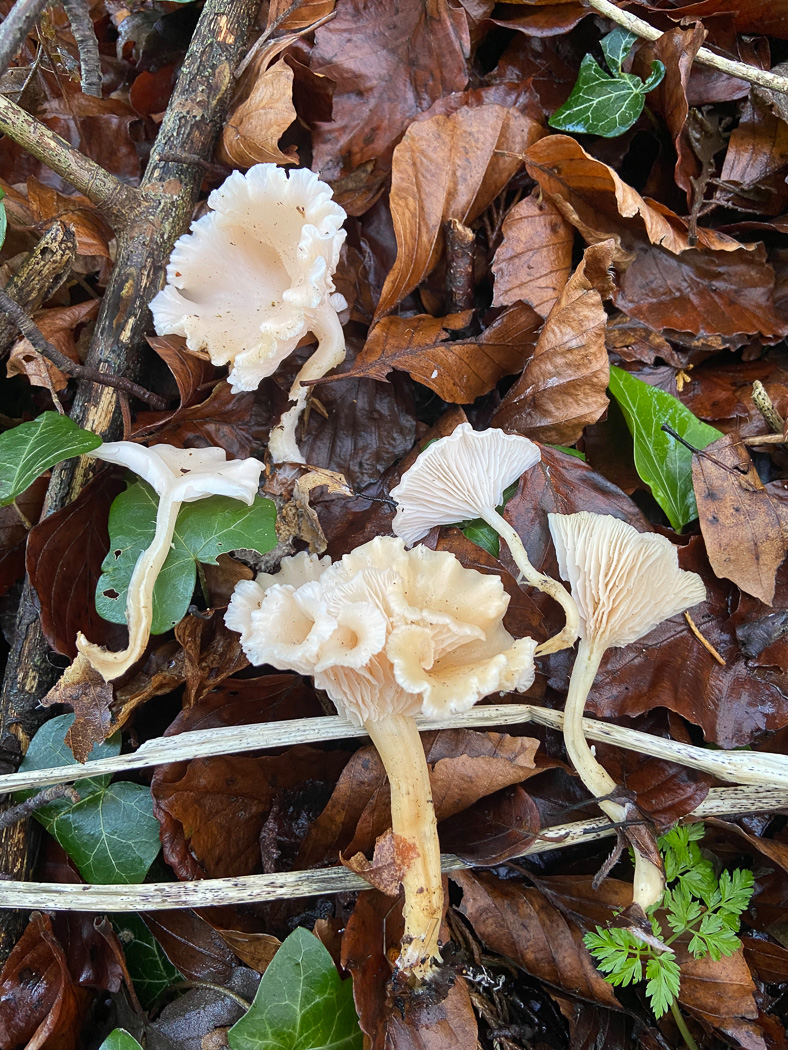
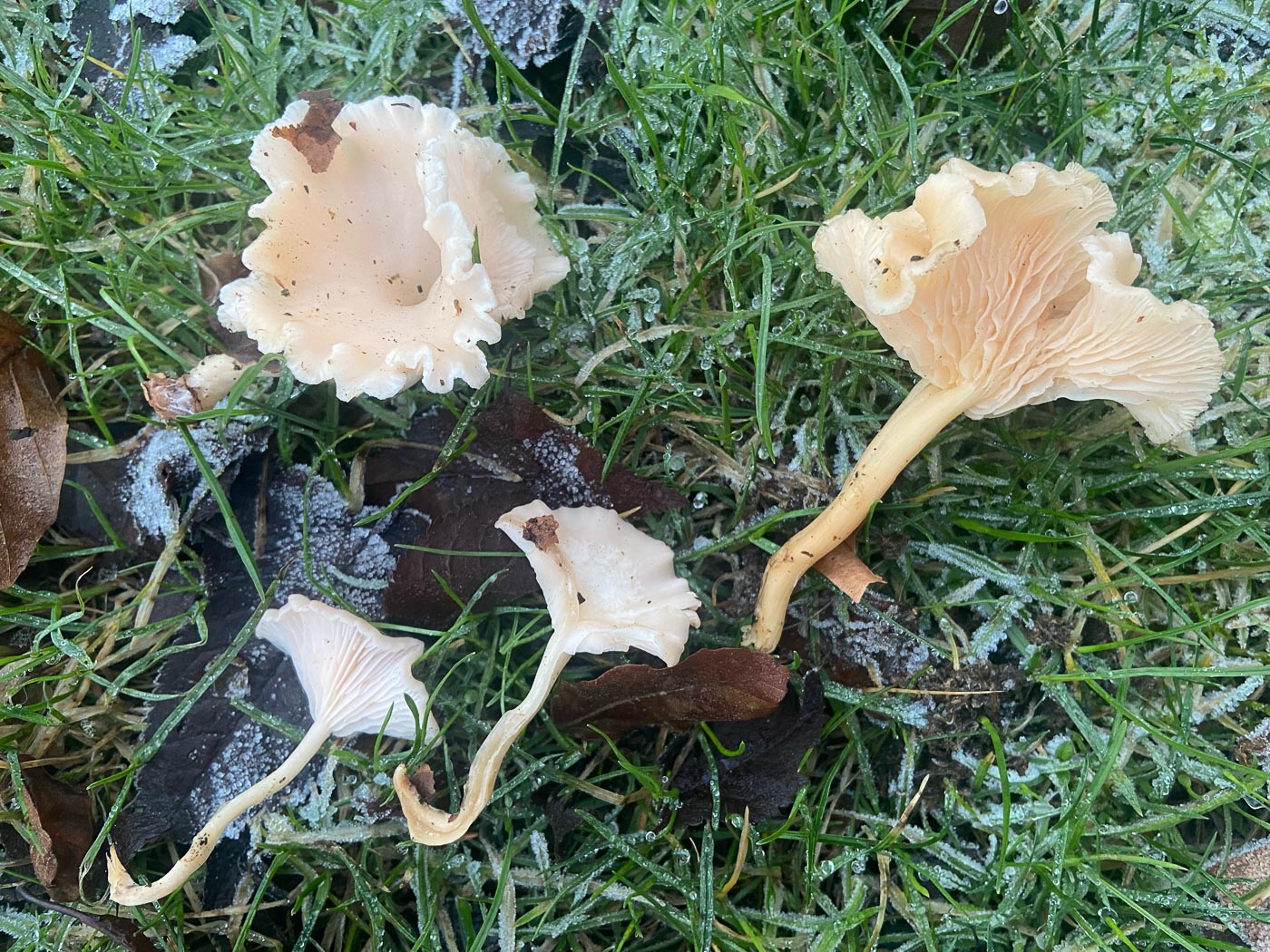
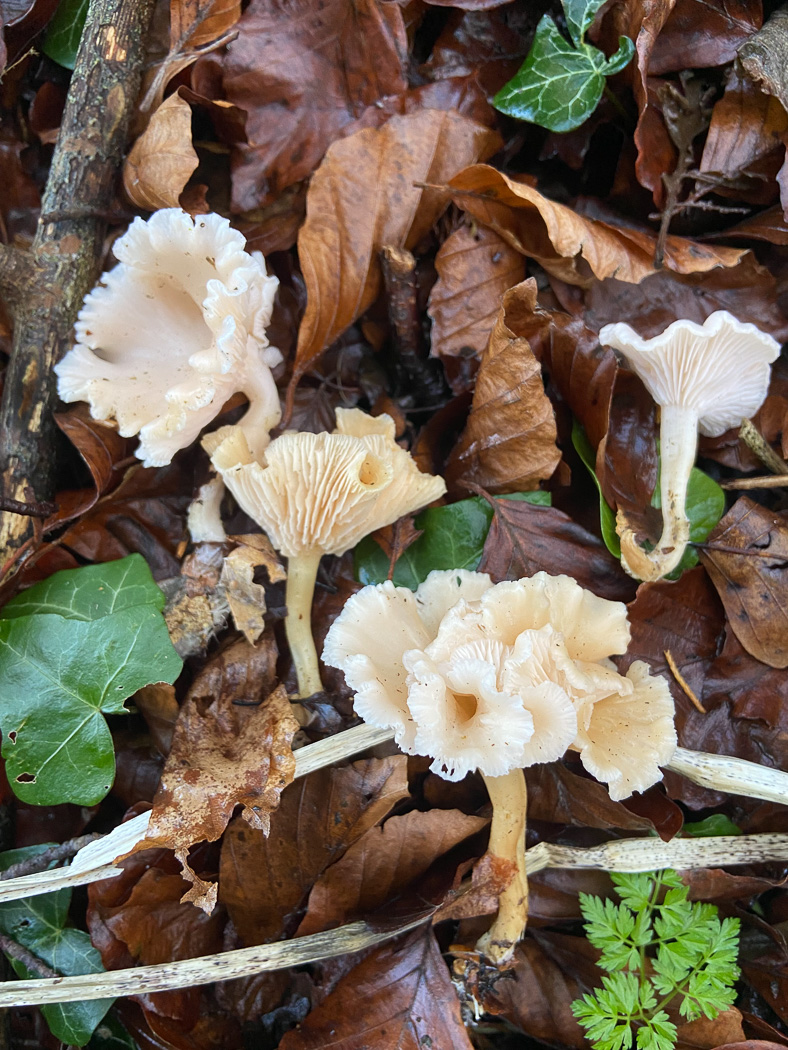 |
Leucocybe houghtonii (Pinkgilled Funnel) 
Feb 10, 2024. In Naphill whilst searching under Cedar in the hopes of finding Cedar Cups, recently entered in Finds, Sarah Ebdon saw to her surprise not that species but two pale funnel-shaped mushrooms. These reminded her of a collection made in January 2023 which turned out to be L. houghtonii, previously in genus Clitocybe and this was later confirmed. A typical pale Funnel in many ways, the decurrent gills tend to become distinctly pinkish especially after collection as it dries (though this colour is hard to catch on camera), furthermore it also develops a smell of tomato leaves though this can be fleeting or even almost absent. Not rare, it often seems to fruit in late autumn or winter but is no doubt often overlooked as just one of the many similar pale Funnels.
Dec 12, 2023. In woody litter mixed with rotting vegetation at St Giles Churchyard, Stoke Poges, Penny found this species - yet another Funnel which has recently been moved from Clitocybe to different but closely related genus. It was identifiable in the field from various characters: the tendency for the cap to develop a slightly frilly rim, for the gills to turn distinctly pink rather than white to cream (they became strongly pink by the following day), and last but not least the smell of bruised tomato leaves when the gills are rubbed.
Jan 12, 2022. In deciduous litter adjacent to a footpath near Loosley Row Sarah Ebdon chanced upon this collection of mushrooms and was baffled by them. On seeing her photo Penny suggested that she should see if - when she squashed the gills a bit - it developed a smell of tomato leaves as it dried out! Sure enough it did (though apparently it didn't last long) and the spores and white spore print helped to confirm it. This unusual species, previously in Clitocybe, is a smallish Funnel which has rather a fluted cap edge and strongly decurrent gills, but the best characters to note are the pink shade to both cap and gills and, of course, its remarkable smell. Anyone who's grown or handled tomato plants will recognise it straight away, but it often needs bruising and then a little time for it to be detectable. Smells can be fickle especially late season with frosts around, so it-s no surprise that this should have faded here. |
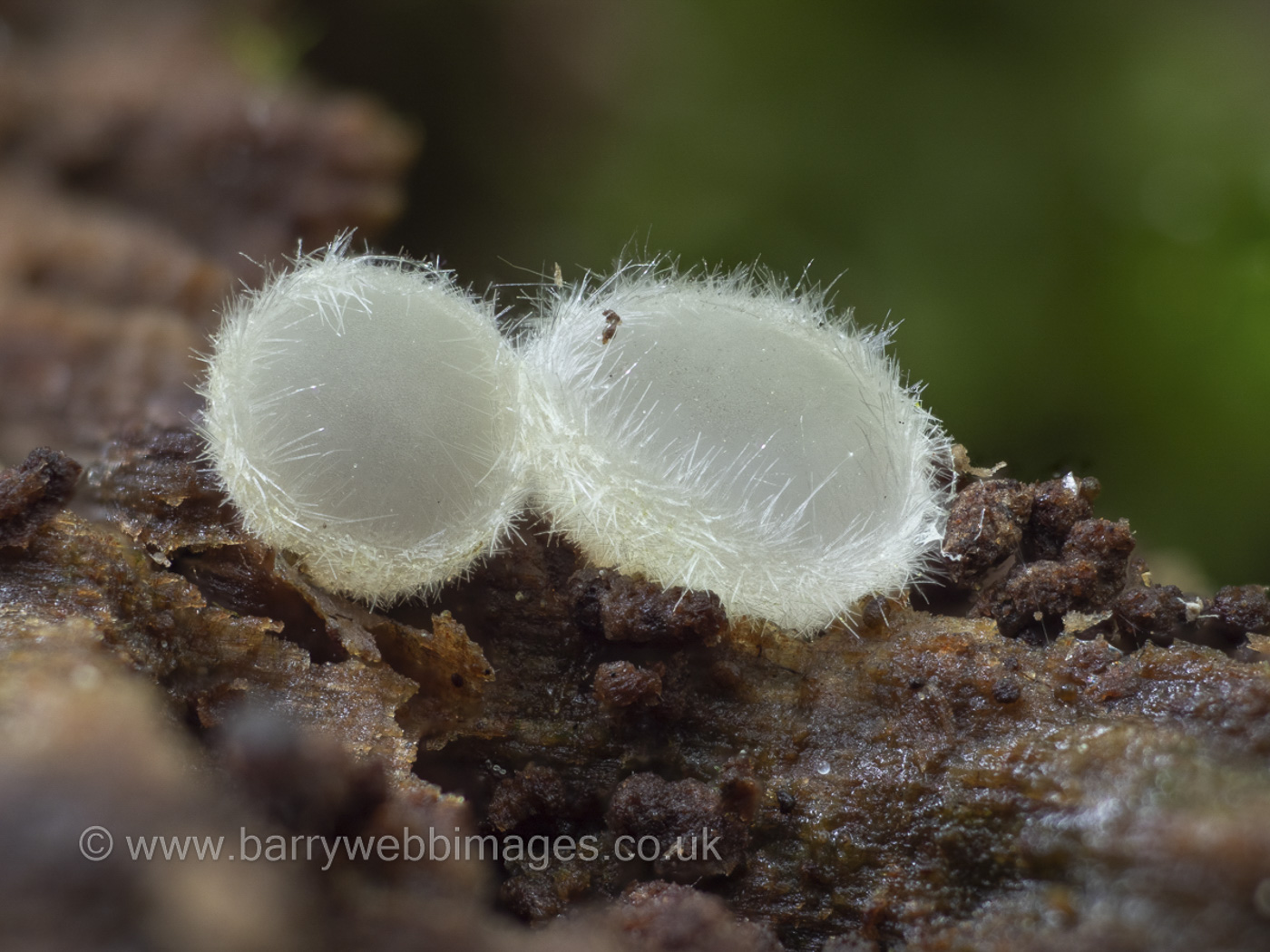
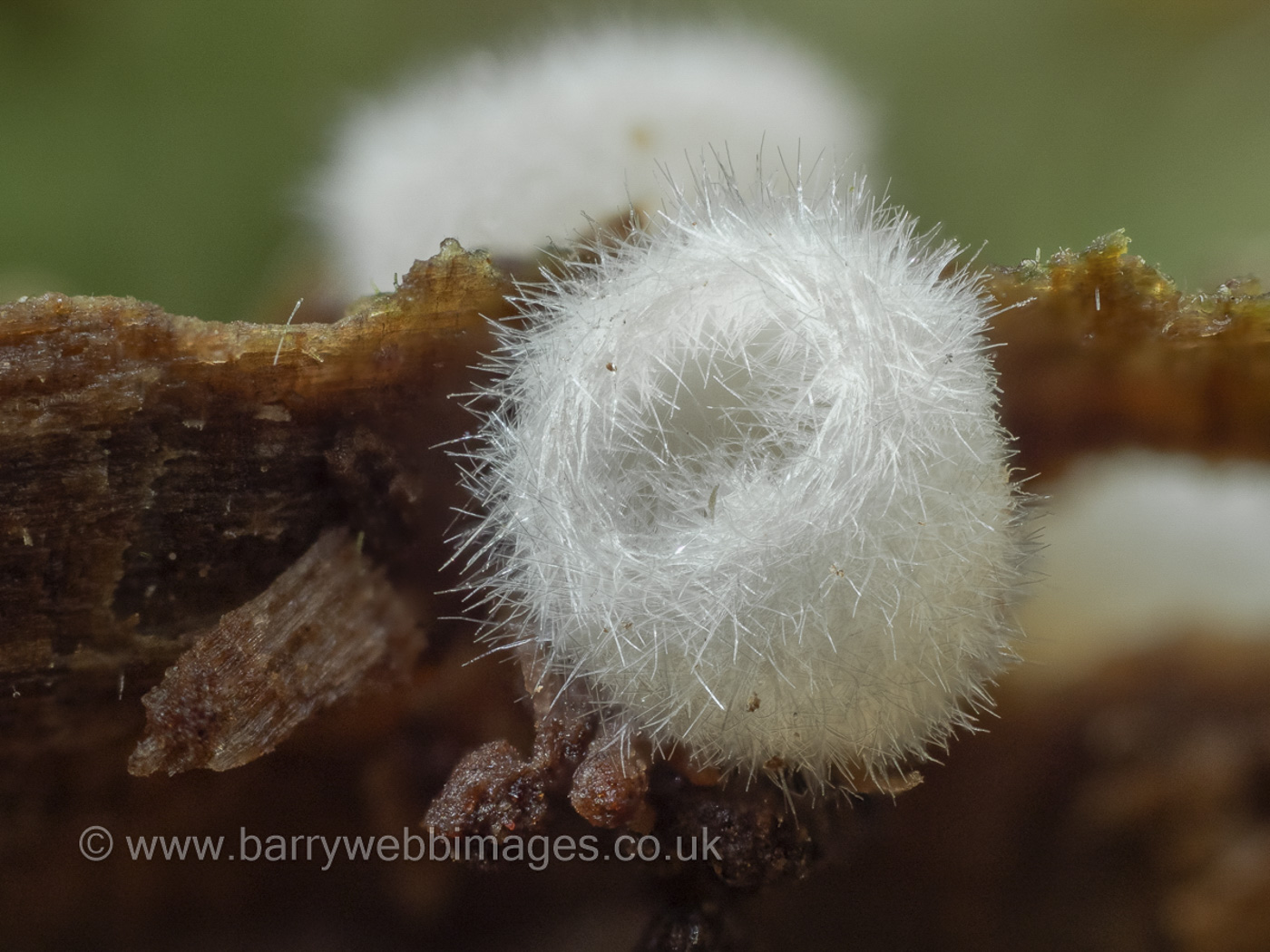
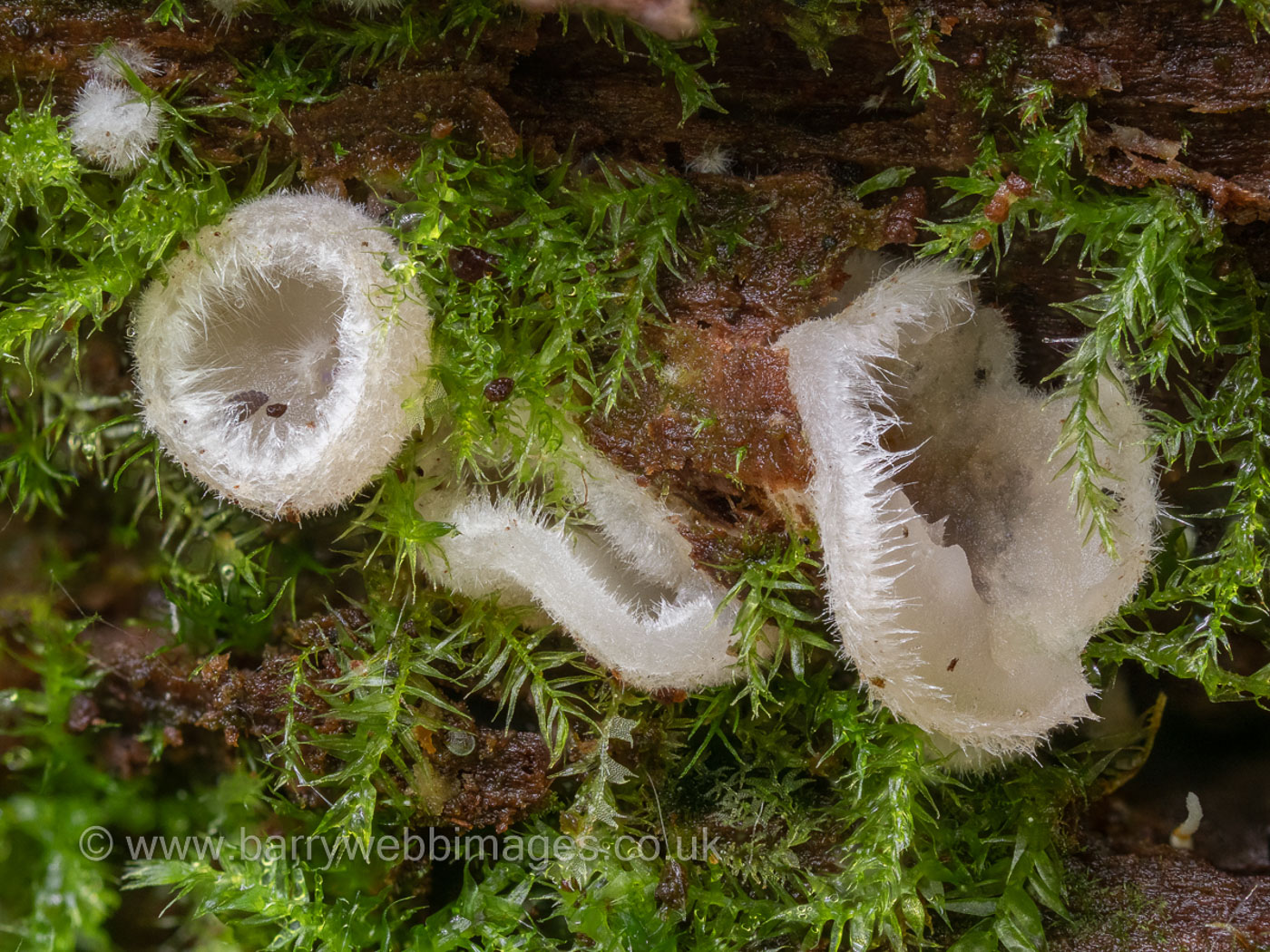 |
Leucoscypha leucotricha (an Ascomycete cup fungus with no common name) 
Jun 9, 2021. On a very rotten fallen Birch trunk at Burnham Beeches Barry Webb noticed these tiny little beauties which Asco expert Kerry Robinson was able to identify later at home. The cups were less than 5 mm across and typical of the species is its mass of delicate white 'hairs' perhaps suggesting some of the commoner white species of the genus Lachnum. However, the lack of stem is diagnostic as also are its microscopic features. This is a rare species with only around 50 national records and is yet another first for Bucks. Photo 3 is of a further collection found nearby by Barry 10 days later.
|
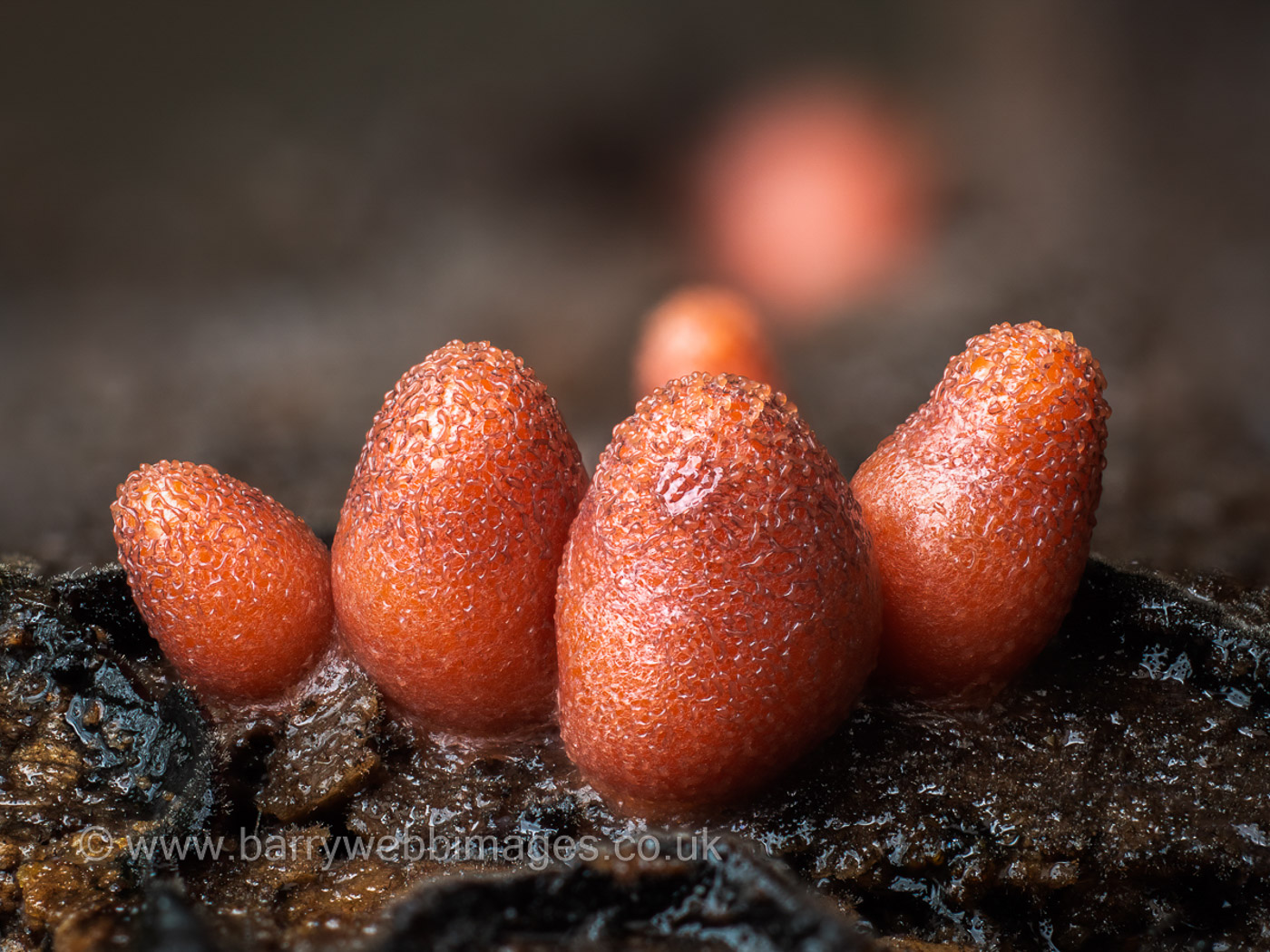
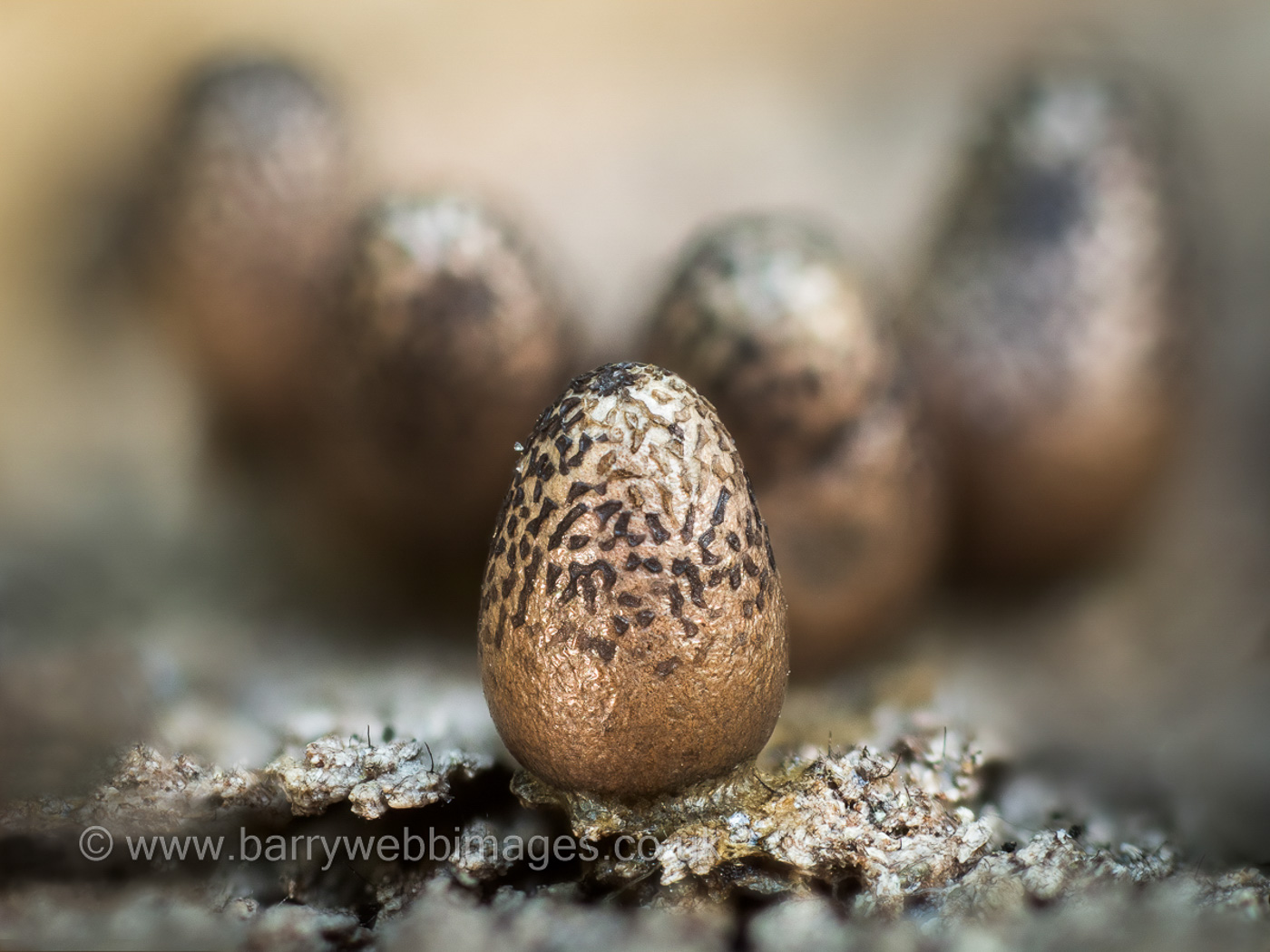 |
Lycogala conicum (a Slime Mould with no common name)
Jul 6, 2021. On fallen rotting Birch at Burnham Beeches Barry Webb found this rare species, similar to the very common and familiar L. terrestre (Wolf's Milk) but instantly separable from it by its very distinctive conical egg shape. As with the (much) commoner species the plasmodium stage is pink, as are the developing sporocarps (fruiting bodies) which as they mature and dry off become gradually grey buff. Photo 2 (taken of a collection on a different Birch nearby found 10 days later) shows mature sporocarps. New to the site and the county, there appear to be under 20 national records of this species, so it was an exciting find. (two)
|
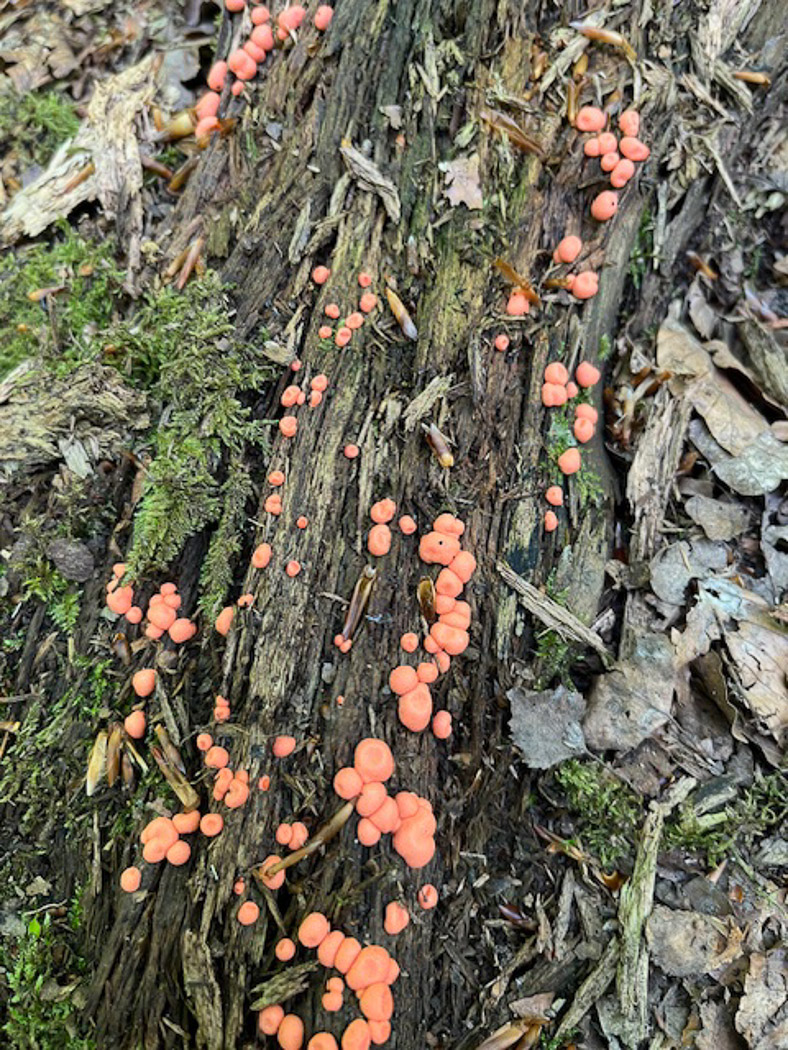
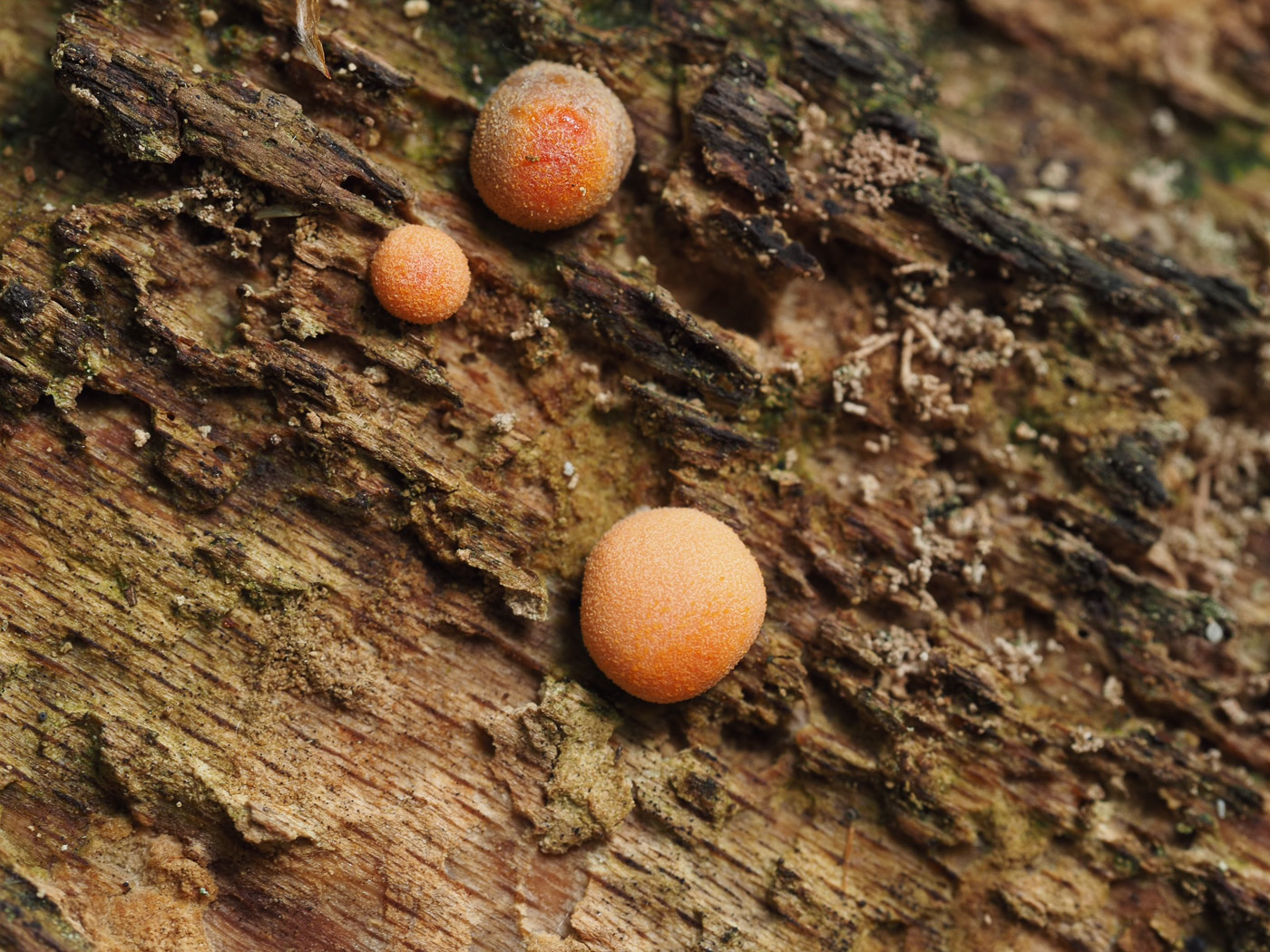
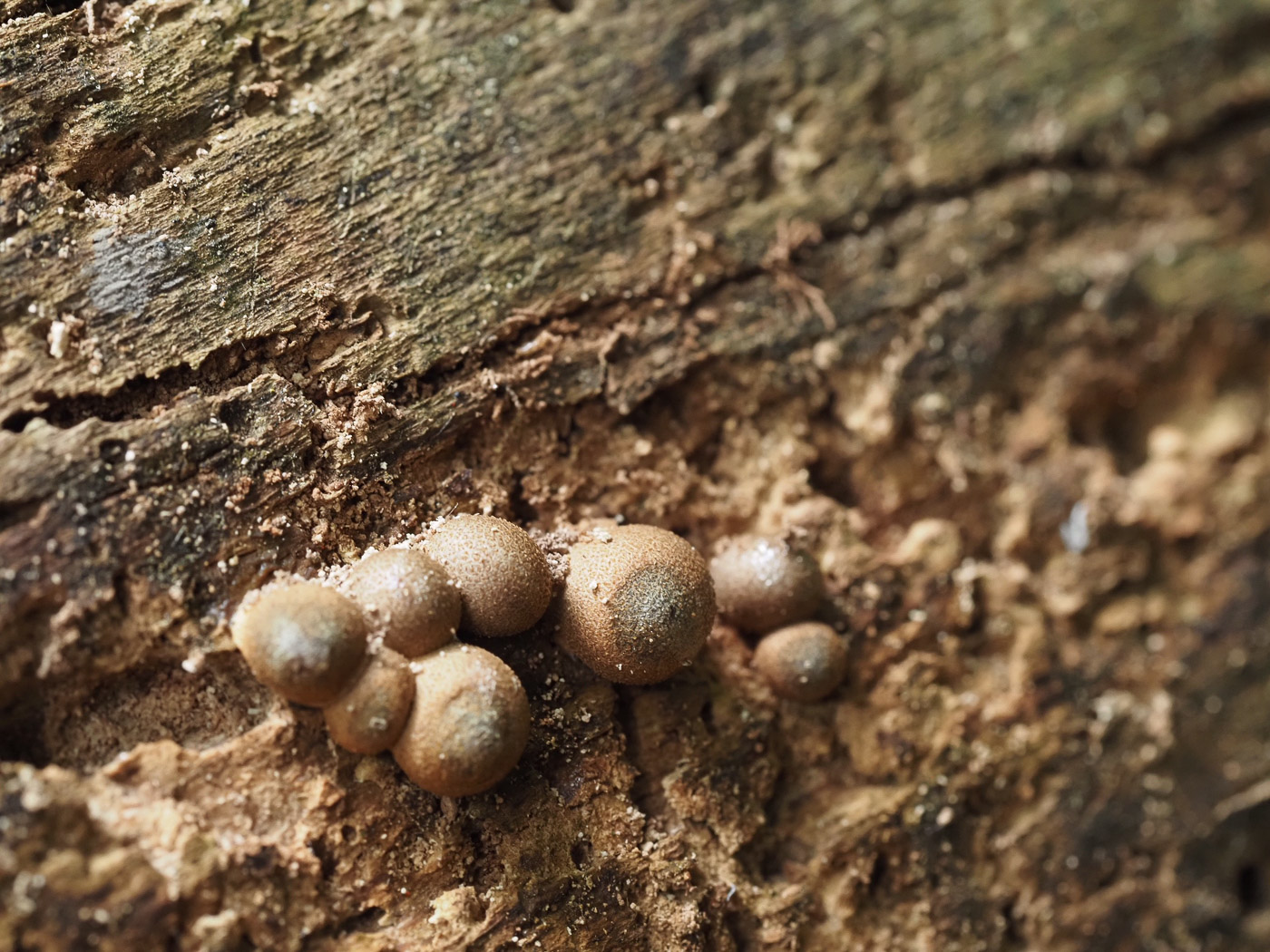
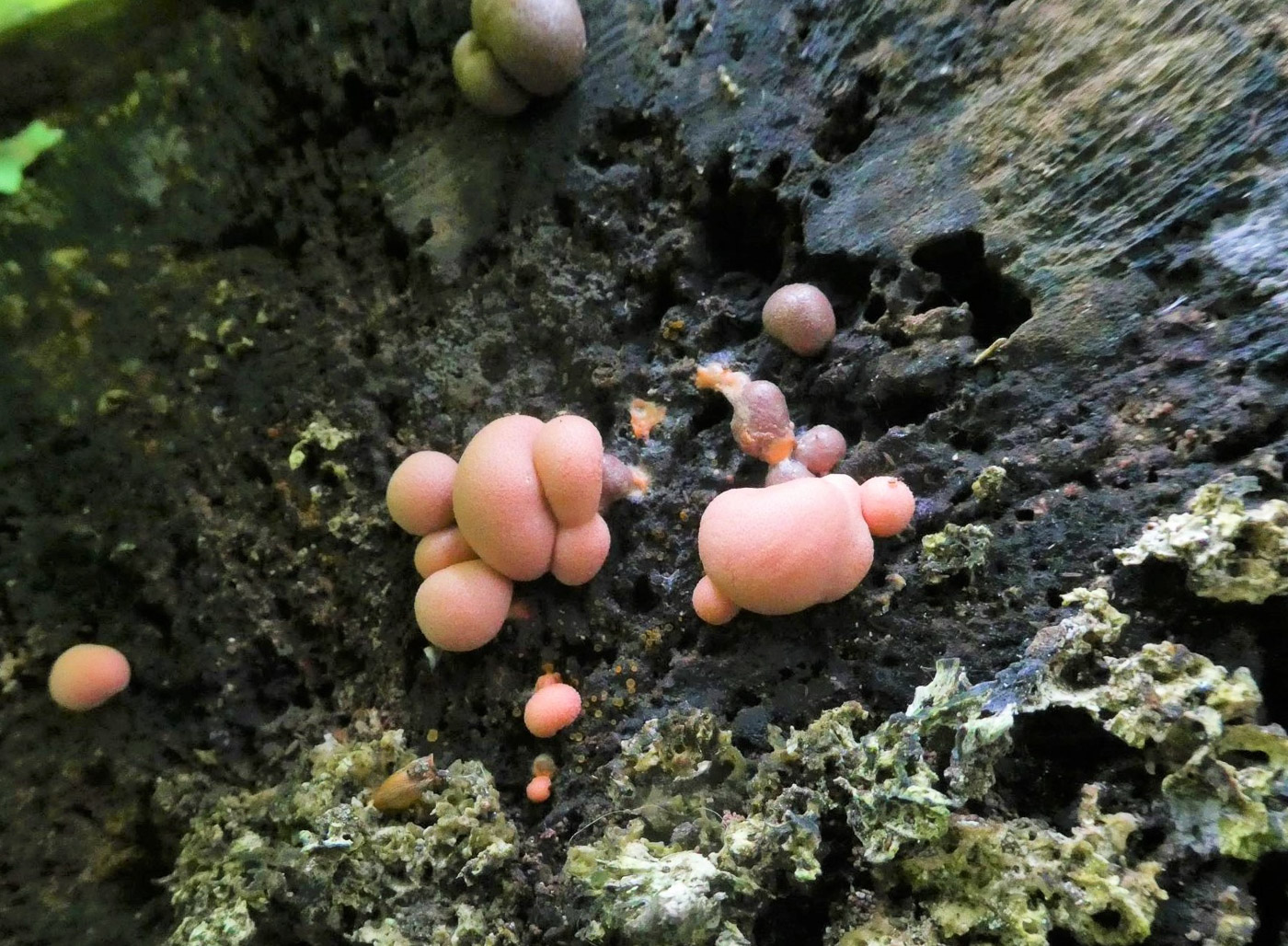
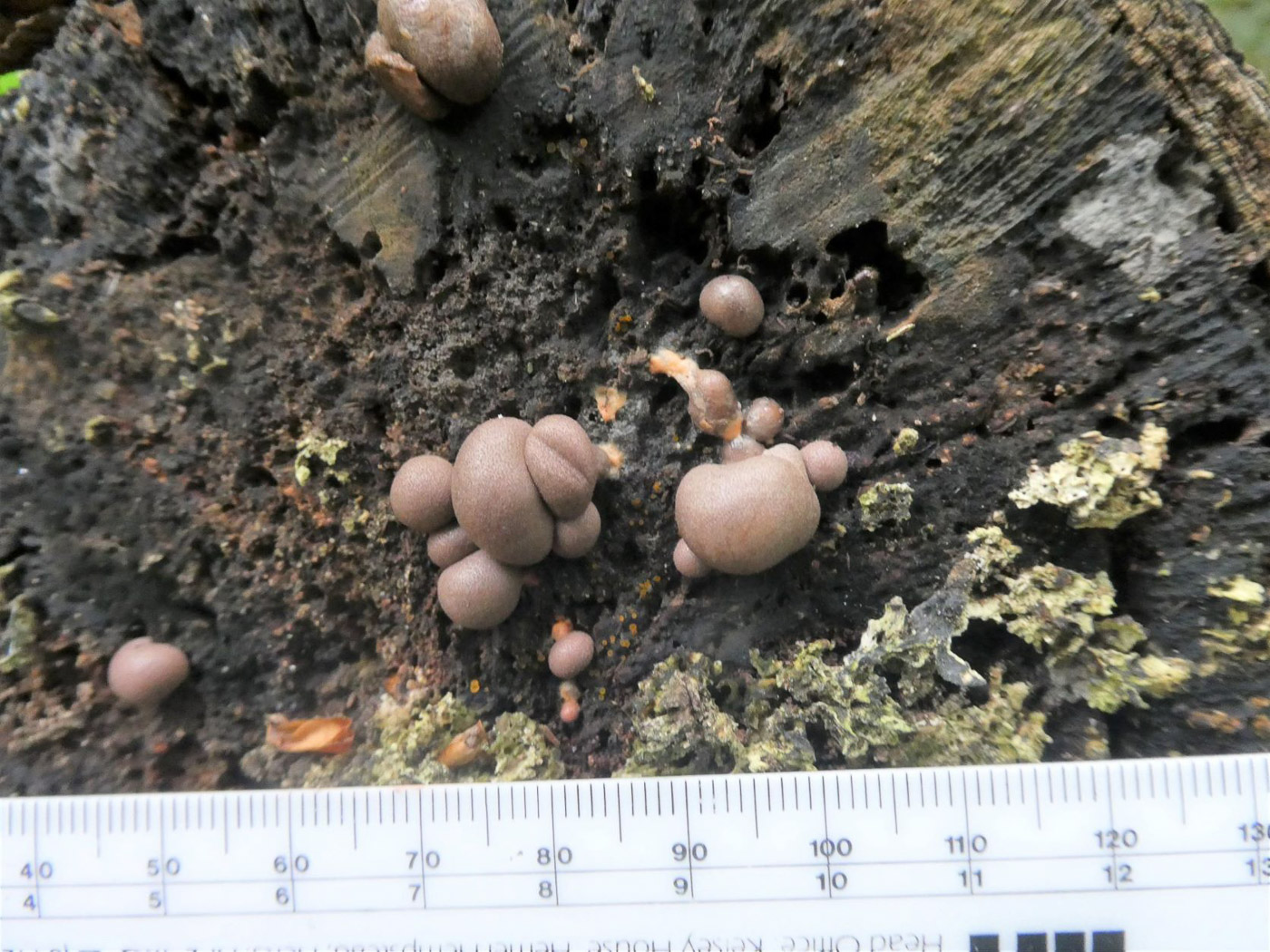
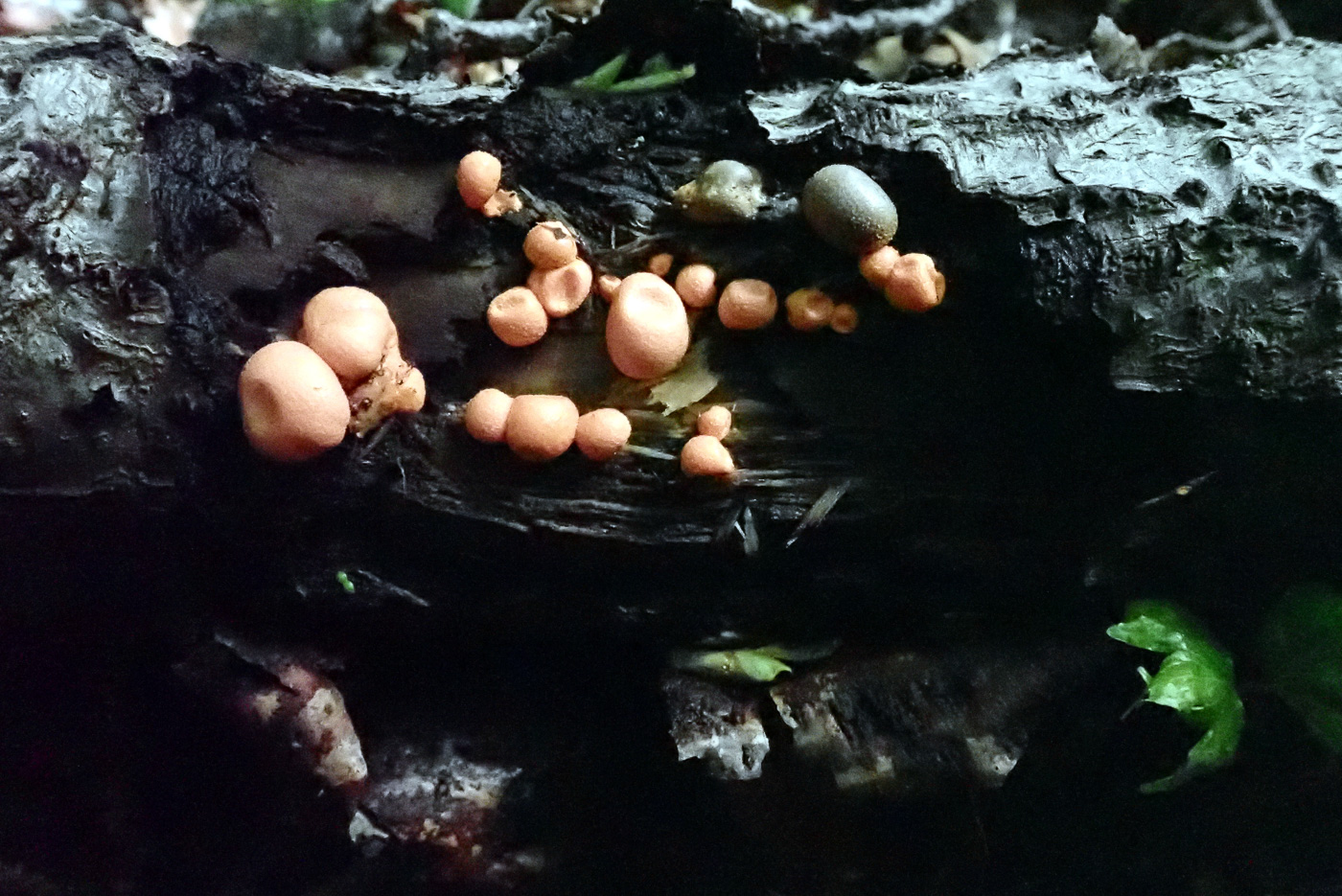
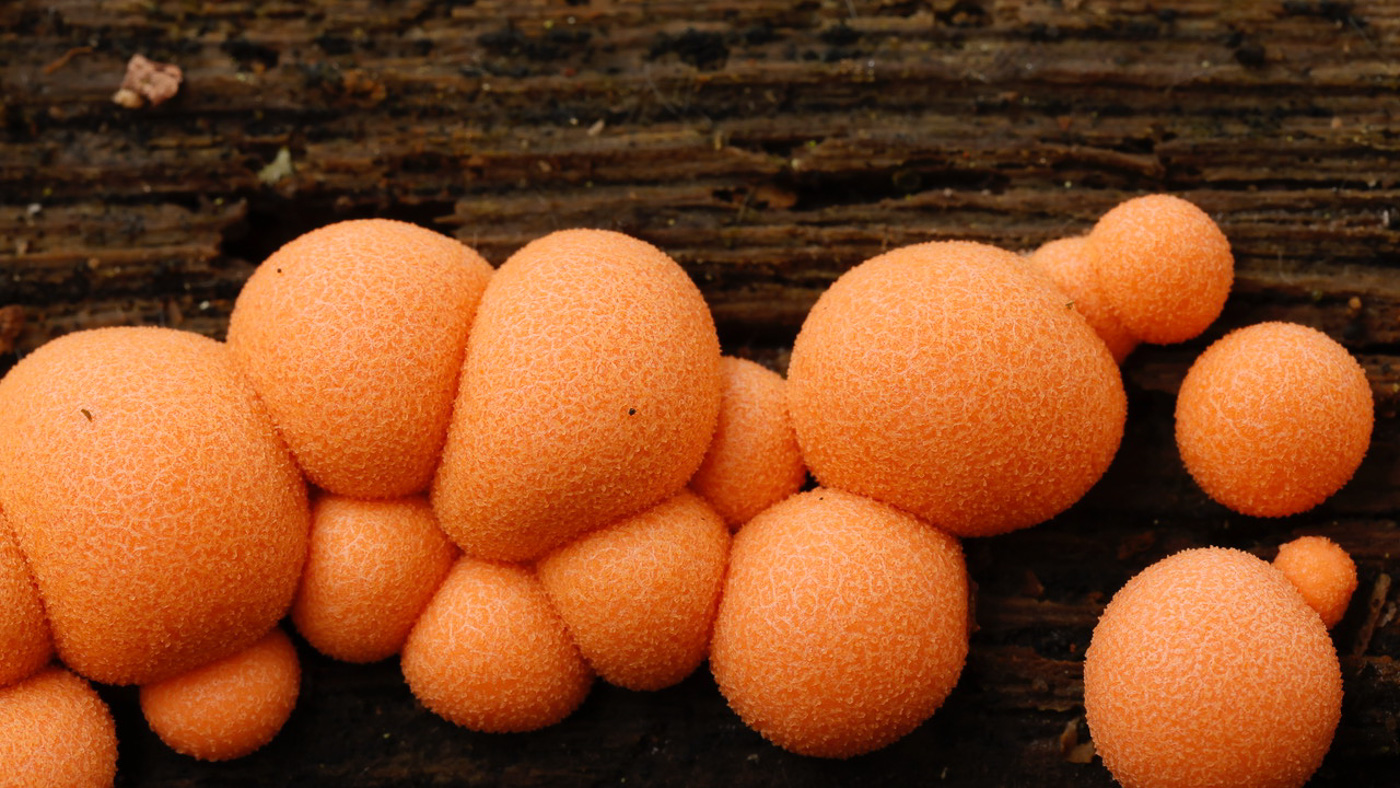
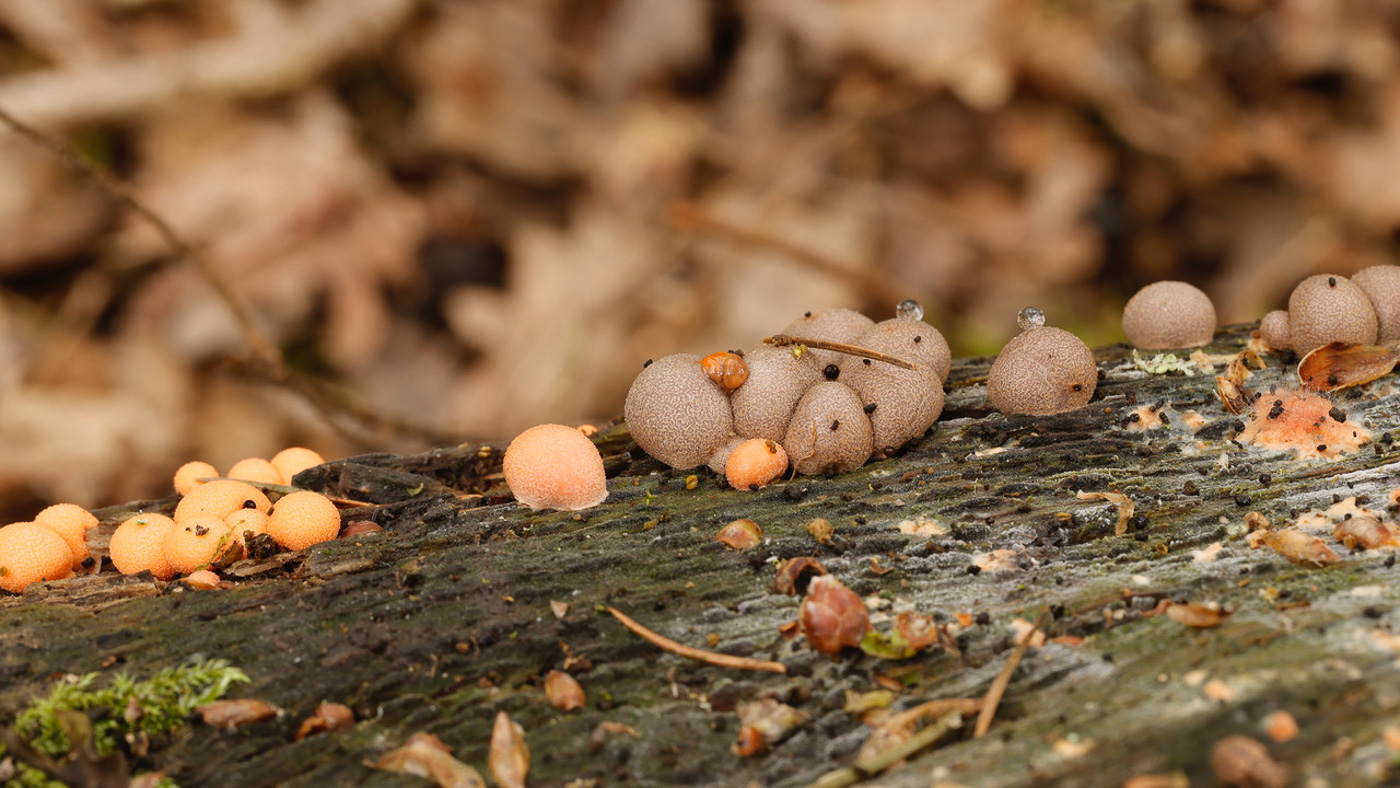
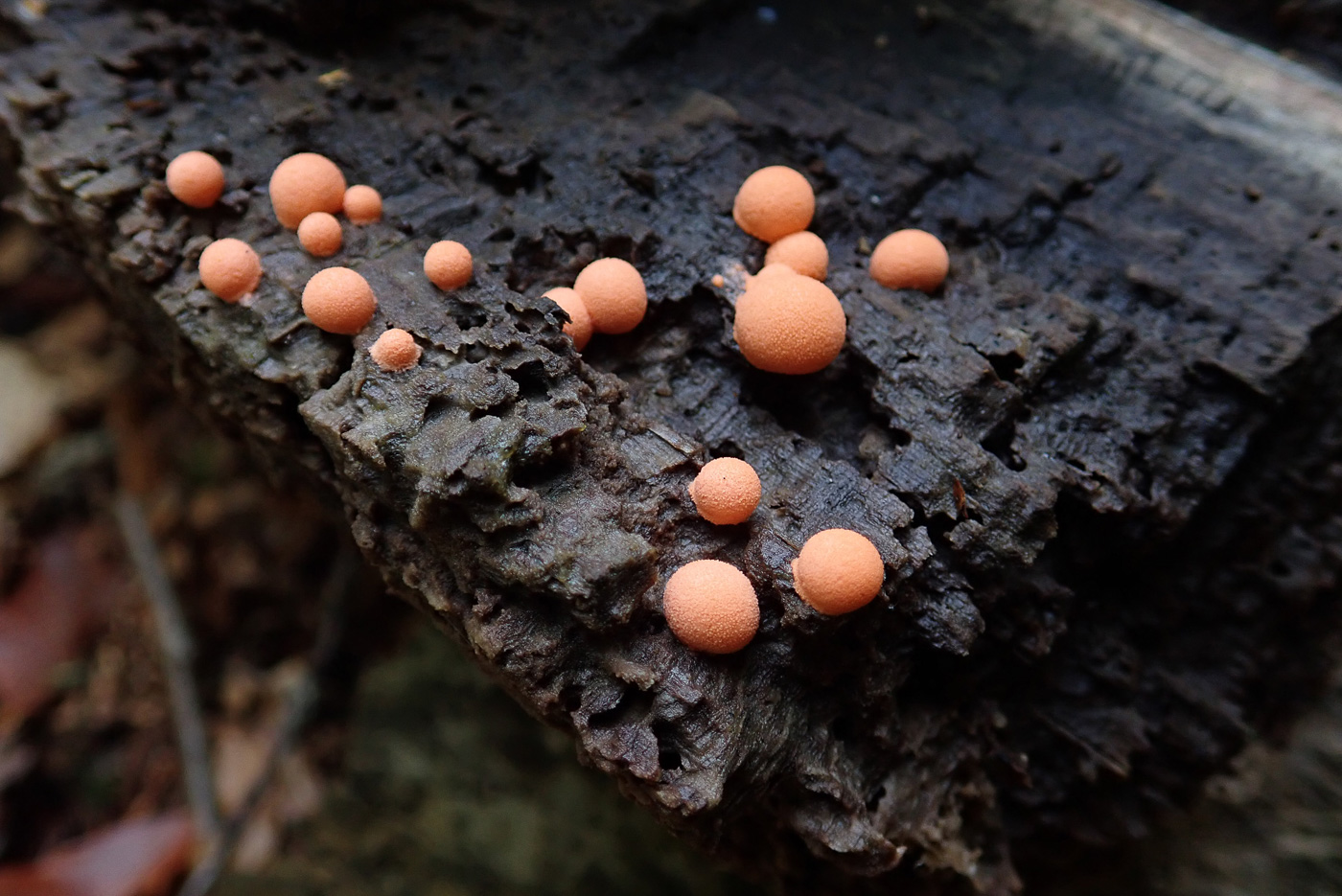
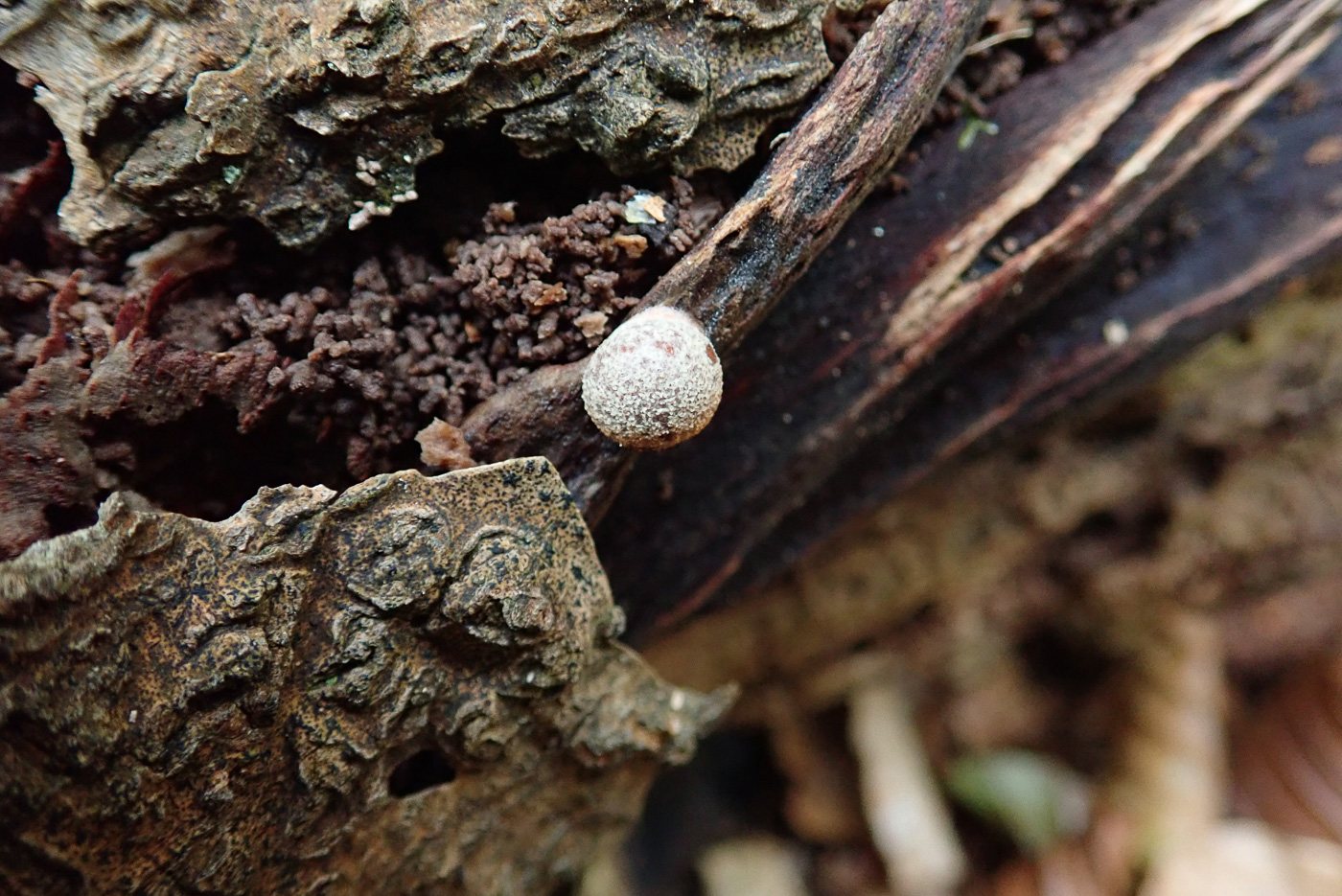
|
Lycogala terrestre (Wolf's Milk Slime Mould)
May 11, 2024. In Penn Wood on an old rotting log Audrey McDade found these brightly coloured blobs and sent her photo to Penny for ID. This is one of our commonest slime moulds and favours damp fallen bare wood which is in plentiful supply at this site.
Jun 12, 2022. In Downley Wood Claire Williams spotted these bright peach blobs on fallen rotten wood (photos 1 and 2). Two days earlier Jim Wills also found this species near Chalfont St. Giles (photos 3 and 4). Note how the peach colour fades to beige as the blobs dry off and mature. There are various photos available on earlier Finds pages - this is one of our commonest species of Slime Mould.
May 18, 2021. Penny noticed these brightly coloured blobs on fallen Beech at Turville Heath. In fact this is not a fungus but a Slime Mould and when the peachy blobs are touched this becomes obvious! This is the slimy 'Plasmodium' stage. Note in the photo the two mature greyish pale brown blobs at the top: these have developed a firm dry covering and are full of the mature spores which are dispersed as the covering disintegrates. The Genus name refers to its similarity to a small Lycoperdon (Puffball) when mature. Photos 2 and 3, taken by Paul Goby 10 days later in Naphill Common, show a nice close-up view followed by some specimens just beginning to dry off.
Oct 19, 2020. Penny C. noticed this collection on a rotting deciduous log in Burnham Beeches. Not a fungus but a slime mould, it is common and easy to spot for obvious reasons though each blob is less than 1 cm across. When still this colour it is not yet mature and if touched just collapses, but it turns pale beige as it dries off (see photo 2 where there was one mature fruit body on the opposite side of the log) and gradually breaks down to release the spore mass within.
|




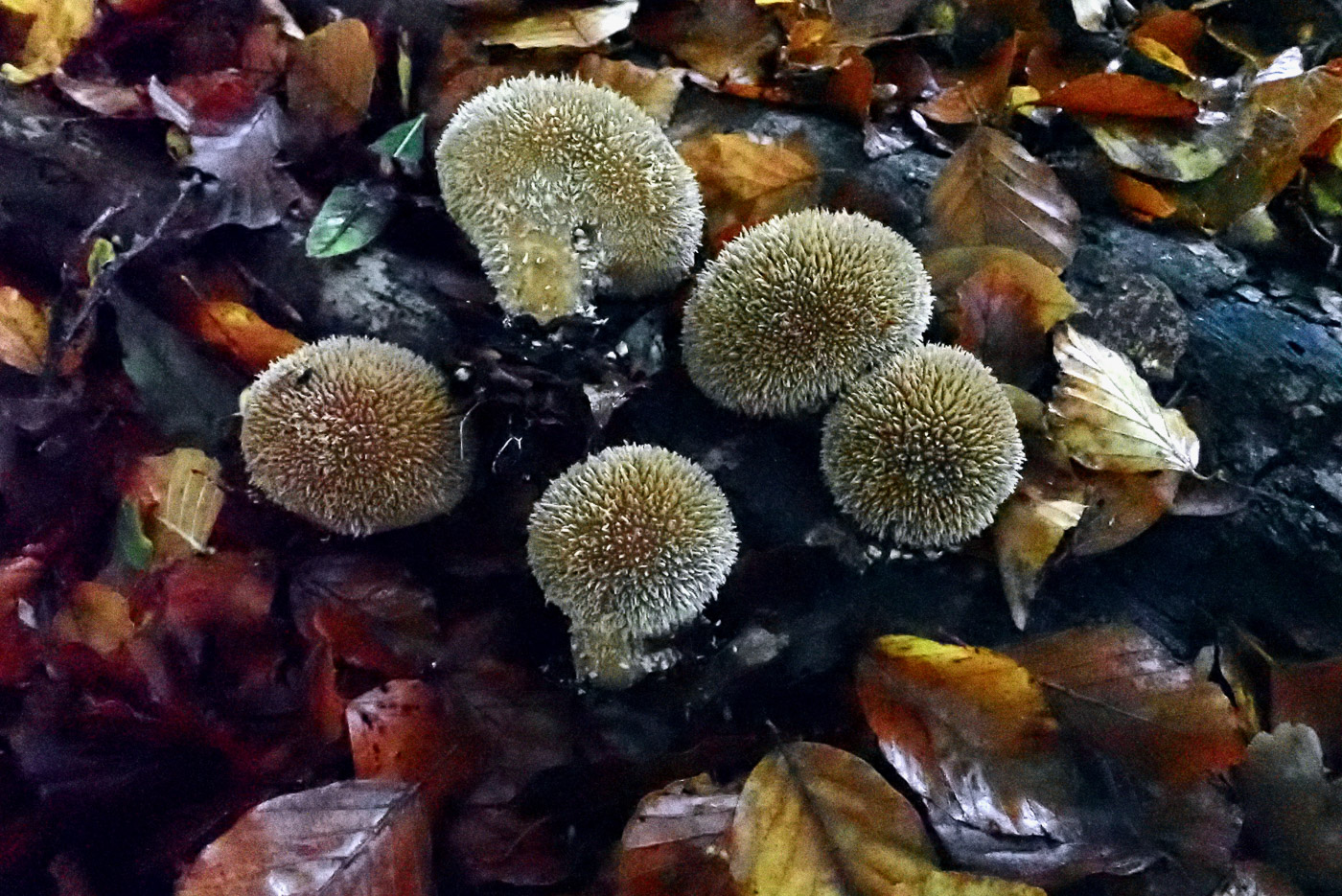
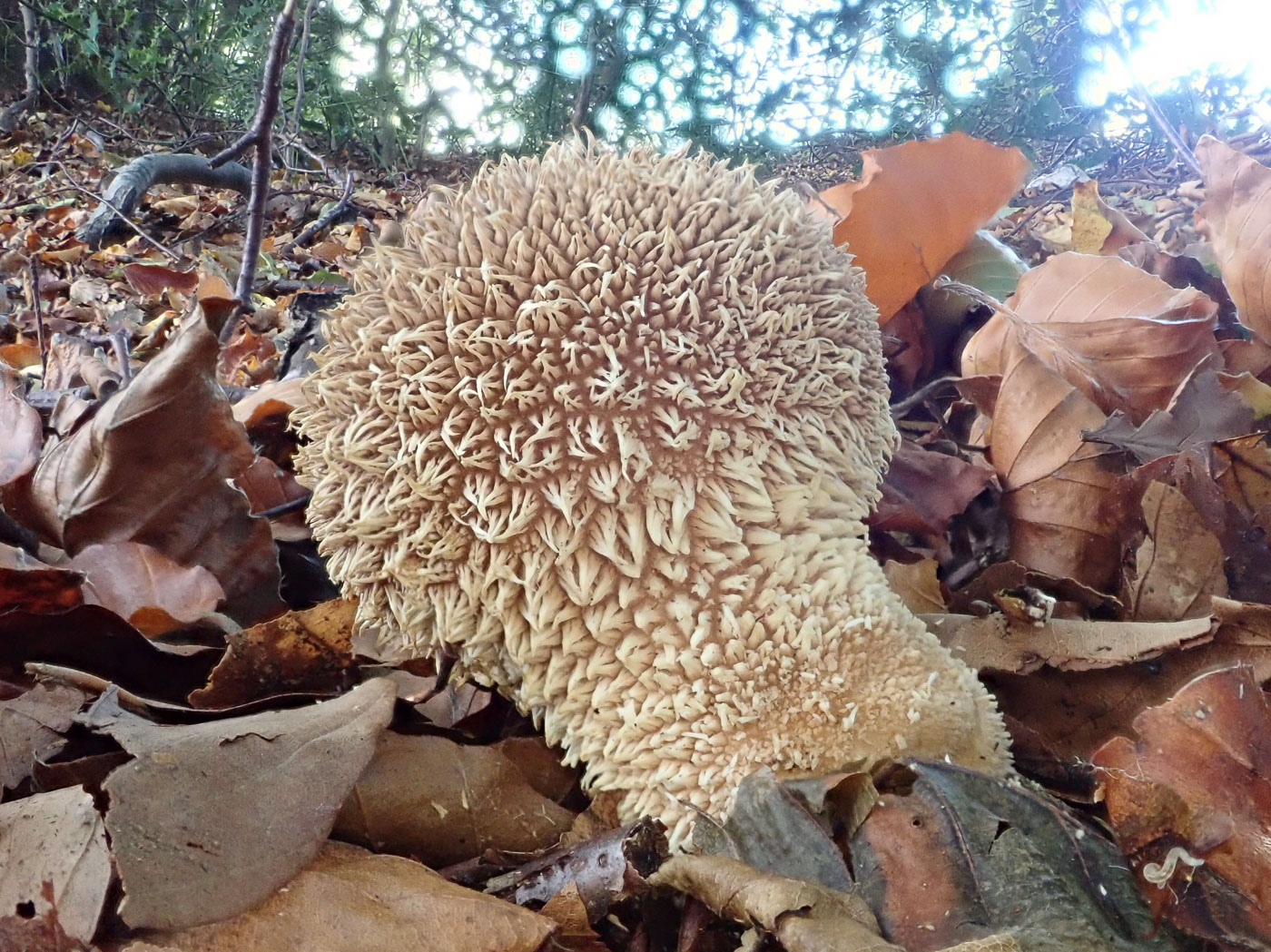
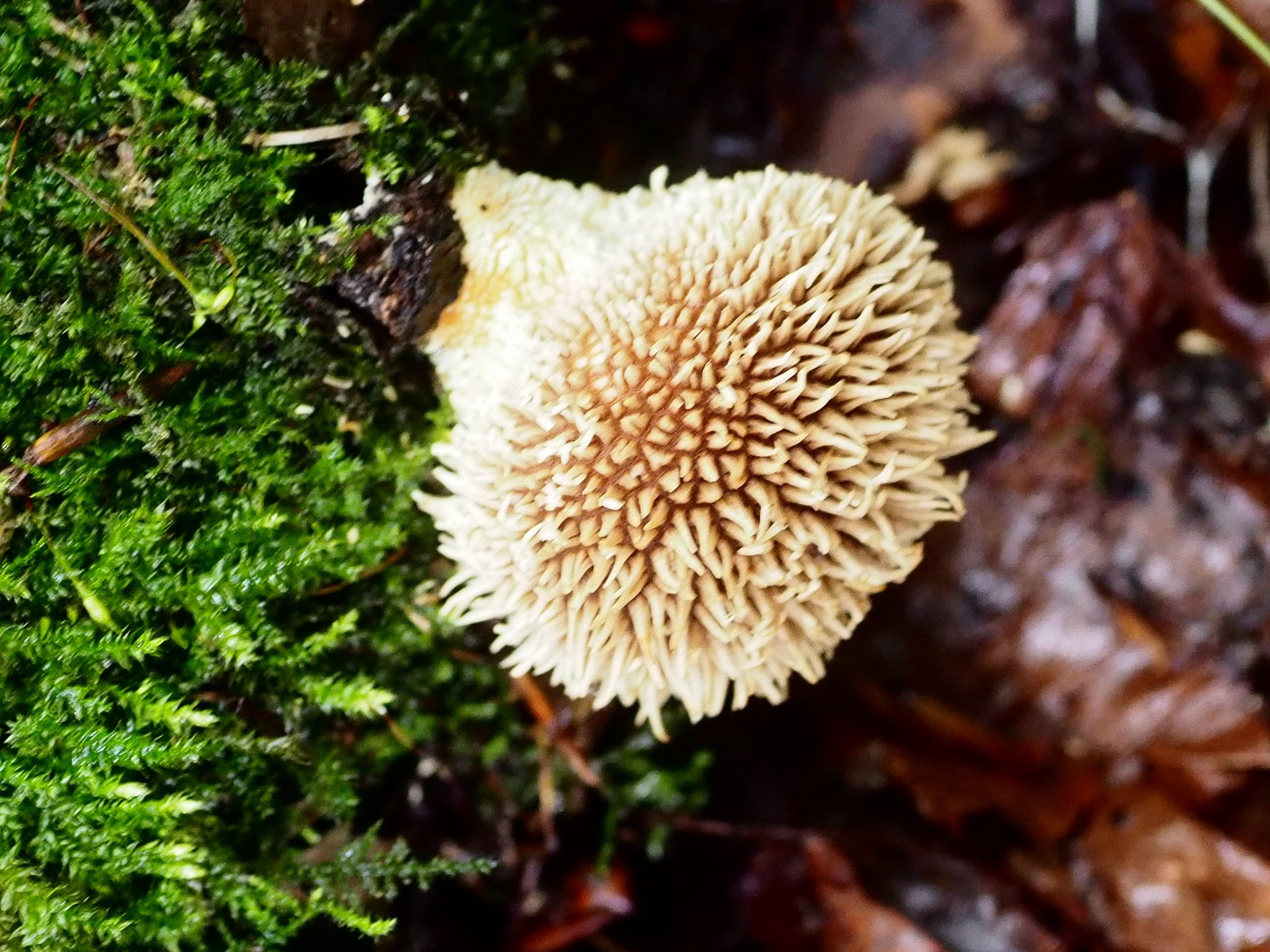
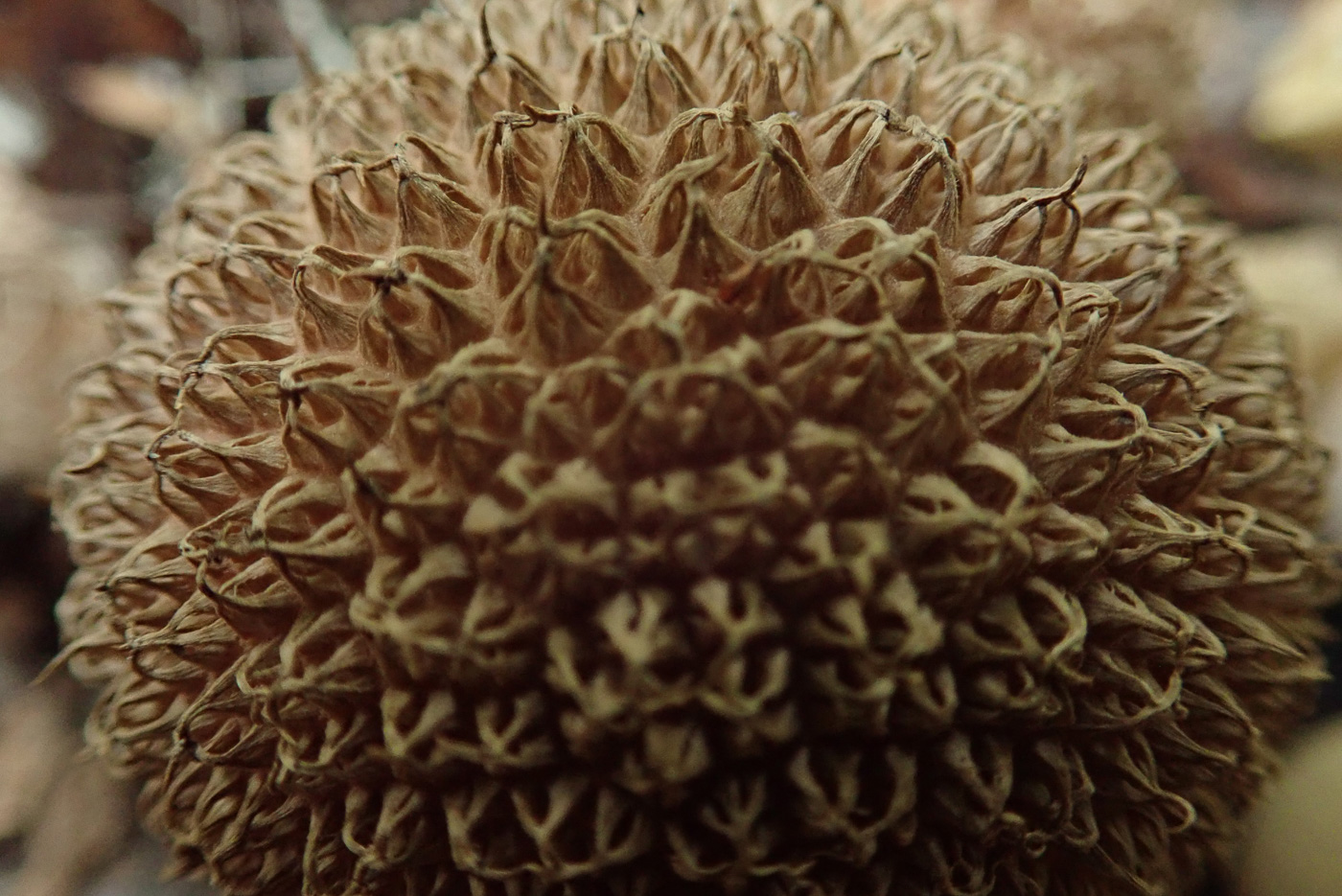
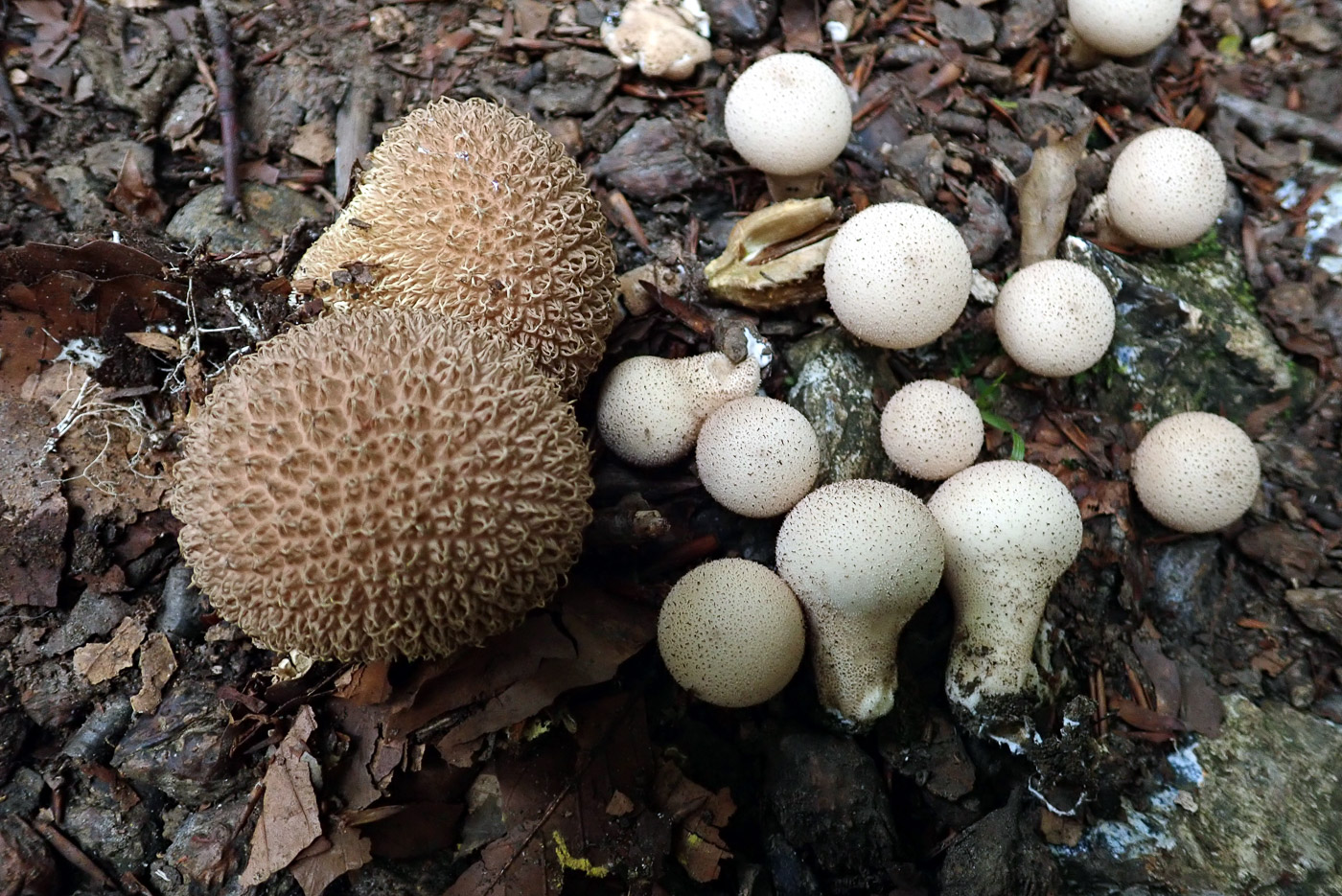
|
Lycoperdon echinatum (Spiny Puffball)
Aug 7, 2023. In Tinkers Wood John Catterson saw this perfect young specimen - always a delight to find! The species is not that common, favouring calcareous ancient woodland usually under Beech, and has far longer spines than any other puffball, formed in clusters which meet in the middle as seen here. Photos 2 and 3 were found a week later at Gussetts Wood by Penny who'd never seen so many fruitbodies together! Then on Aug 28th Mick Jones sent in photo 4 from Dancersend where he's found this species fruiting in this same spot over the last 40 years!
Oct 20, 2021. In Gussets Wood Penny found quite a few of these very spiny puffballs which occur in mature calcareous Beech woodlands such as this. The species is not that common and often claimed in place of the rather darker, smaller, more common L. nigrescens (Dusky Puffball) which has quite similar conical clusters of spines but in that species they are shorter and do not overlap at the centre of each cluster as here. Photo 2 shows a specimen found at Dancersend by Mick Jones 10 days later.
Oct 3, 2021. In Tinkers Wood John and Lesley Catterson found this singleton, our least common woodland Puffball species and thought to be an indicator of ancient woodland. The amazing convergent long spines (3mm or more) form little clusters, this also a feature of the much more common but darker brown L. nigrescens (Dusky Puffball), the spines of which are shorter though the two species are sometimes confused. Unlike today's find, L. nigrescens also occurs in grassland and dunes.
Sep 11, 2020. Two for the price of one here, found by Penny Cullington. They were growing near together in Kingswood, Tylers Green and then placed adjacent to allow comparison. The extremely common Stump Puffball has a smooth pale surface and is usually visibly on wood (though in a path on submerged roots here). The rare Spiny Puffball is larger, darker and has strikingly long spines forming pyramids and grows in deciduous litter (as do two much much more common Puffball species, L. perlatum and L. foetidum, which hopefully will appear and be described in due course).
|
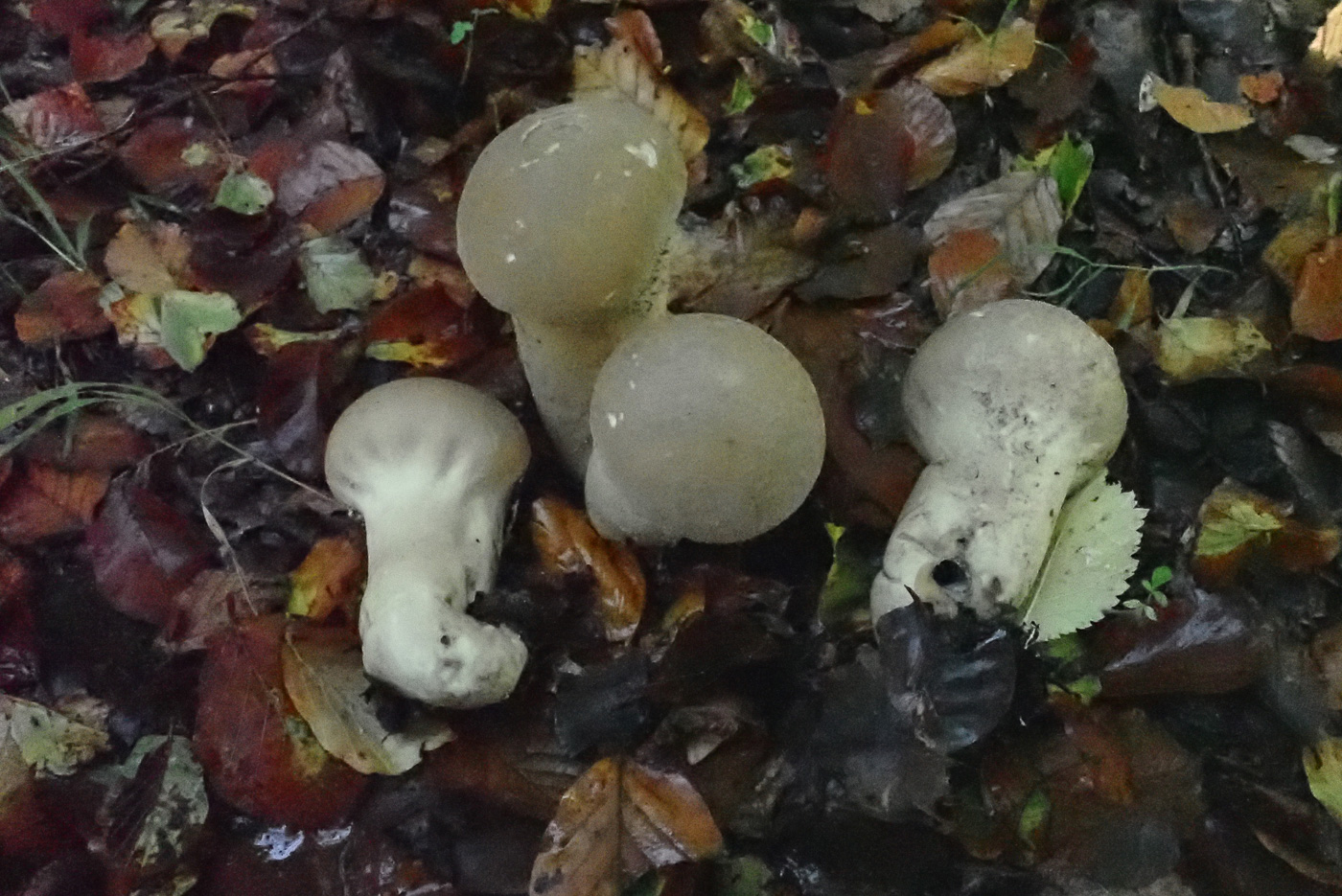 |
Lycoperdon excipuliforme (Pestle Puffball)
Oct 20, 2021. Another much larger Puffball was found by Penny in Gussets Wood, a species which is much less common than the smaller trio of woodland puffballs (L. perlatum, pyriforme and nigrescens). The surface of L. excipuliforme is quite smooth as in L. pyriforme but they can get to around 15 cm tall by 10 cm, are typically pestle-shaped and occur in woodland litter, occasionally in grassy areas.
|
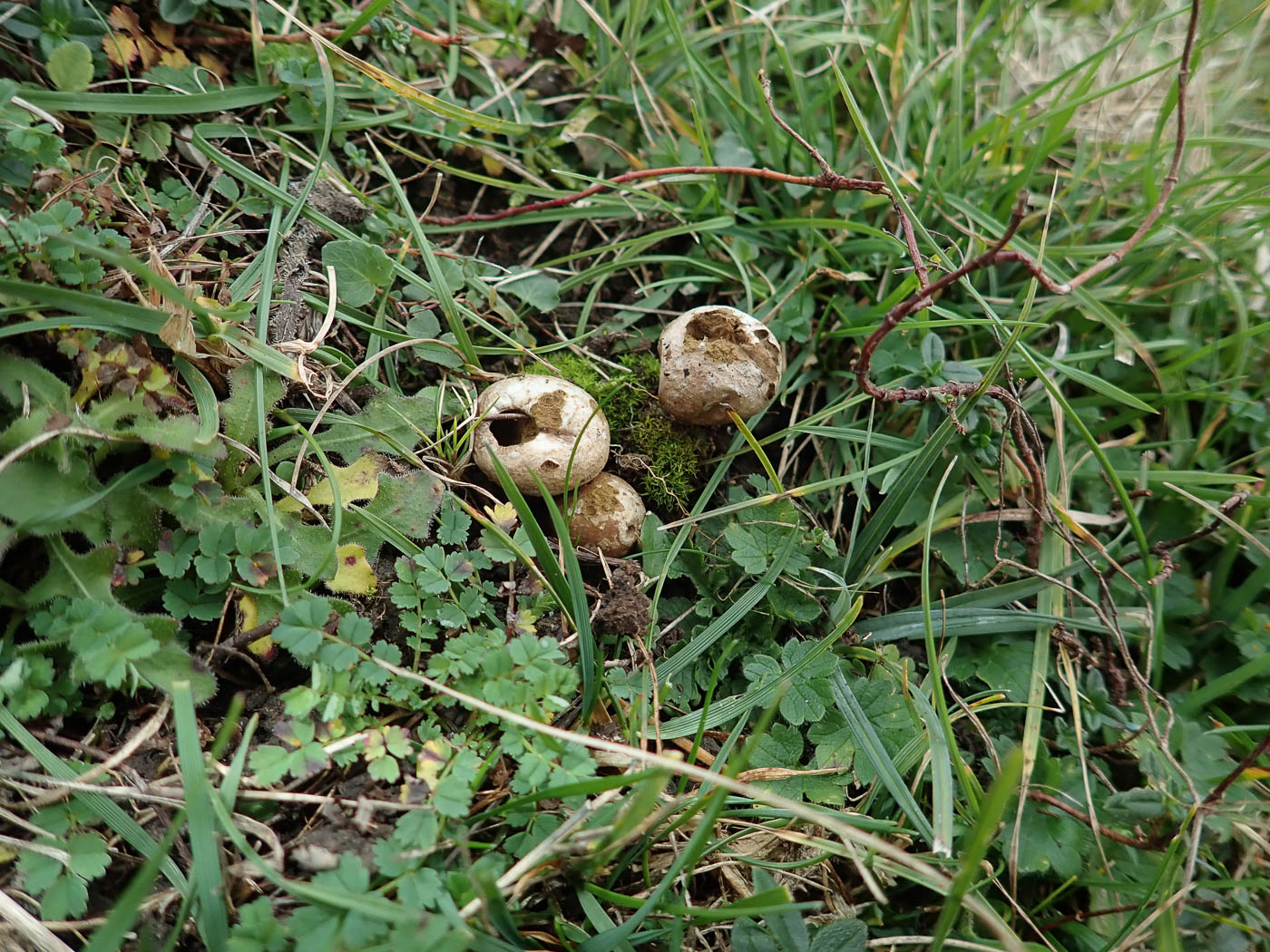
|
Lycoperdon lividum (Grassland Puffball) 
Nov 15, 2024. On the Helianthemum-covered escarpment at Coombe Hill Penny came across just a very few of these unusual and tiny puffballs which caught her attention having seen them in good number recently in the Forest of Dean. Checking the spores is important with this genus for species other than those which are common and familiar, and she was able to confirm her ID, then discovering that of our three previous county records- no wonder she'd forgotten all about it! This is a new entry for Finds.
|
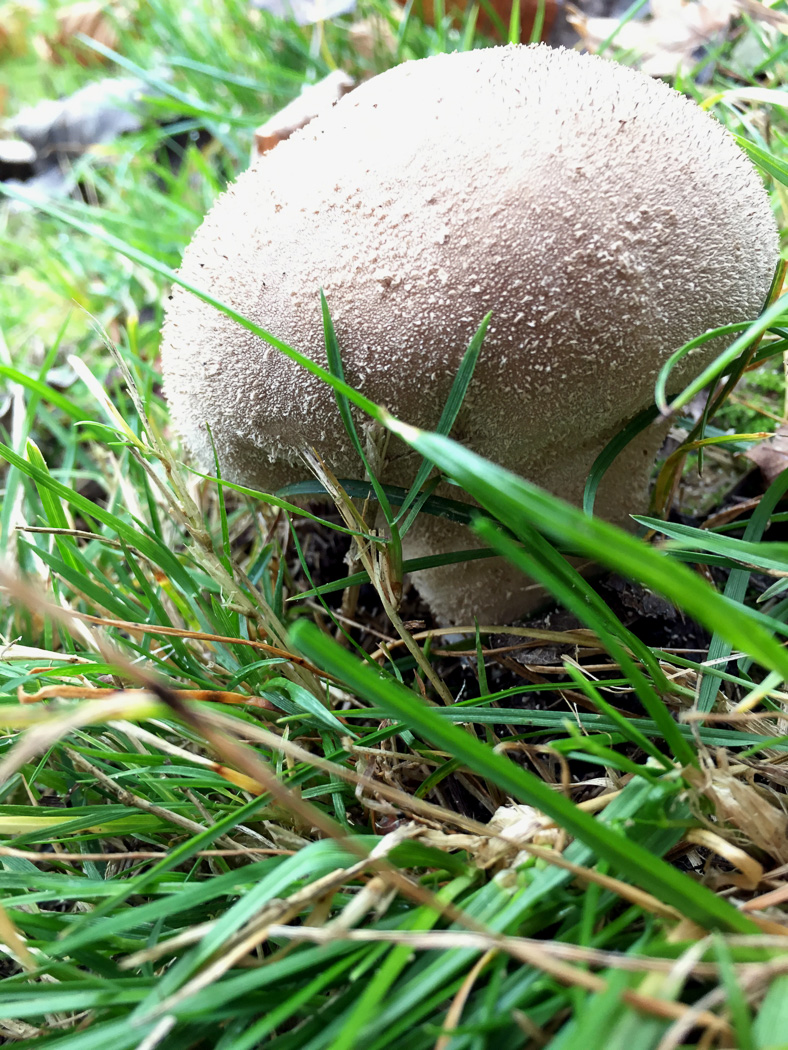
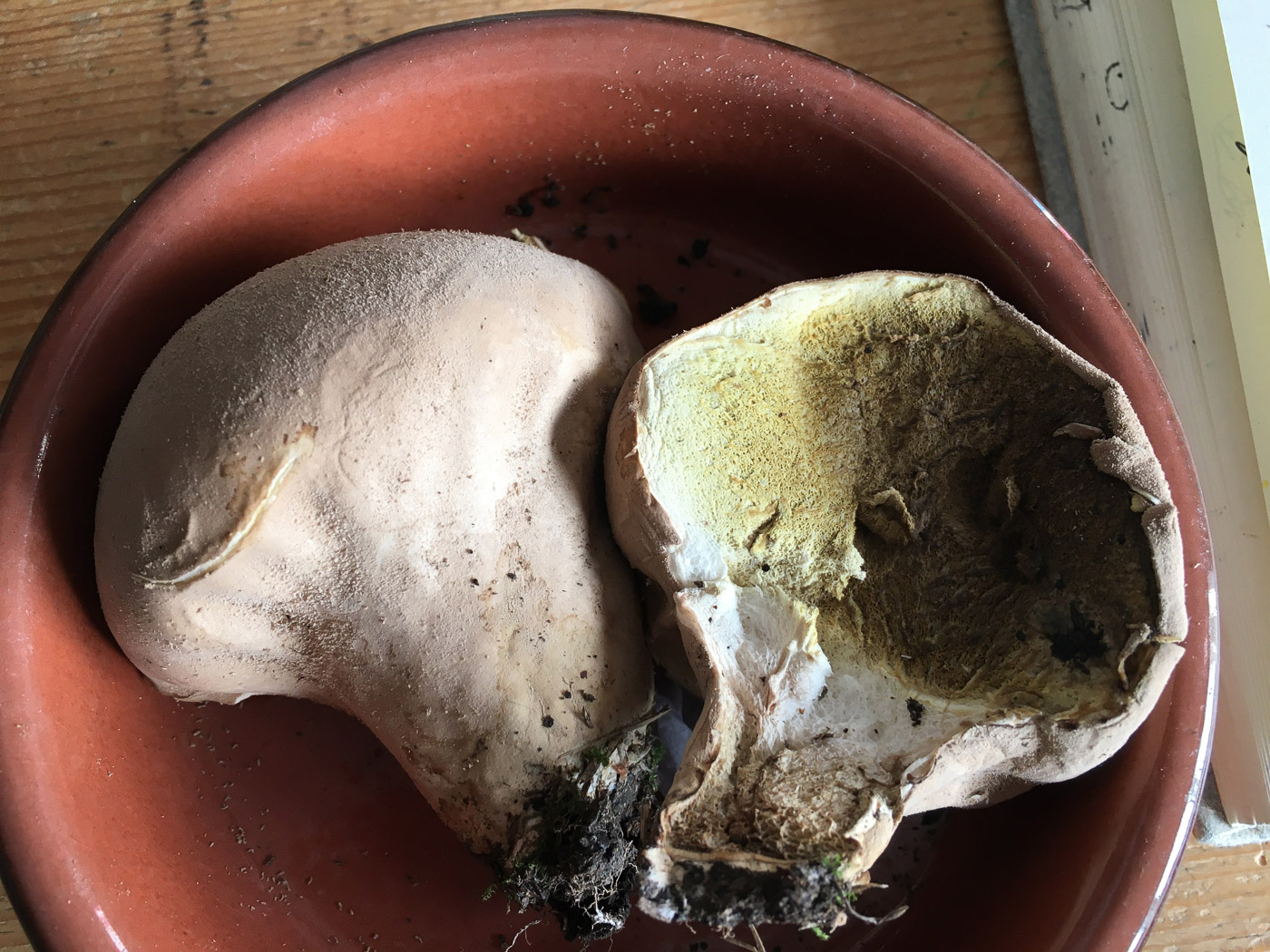 |
Lycoperdon molle (Soft Puffball) 
Nov 24, 2021. In a grassy glade in Wotton Park Estate Joanna Dodsworth found this quite unusual puffball and, thinking that it looked different from the commoner species we regularly record, took it home to examine. The outer surface together with shape and size are important features in the genus, but it is always safer to confirm any identification of a species one is not that familiar with by checking the spores. When, as in this case, the specimen is still white and firm inside indicating no developed spores as yet, then the only option is to keep it a couple of days in the hope that it will mature enough. This Joanna did (photo 2) and was then able to find the small round ornamented spores with loose strands of debris amongst them, these being remnants of the tops of the basidia and their presence being a good indicator for the species.
|
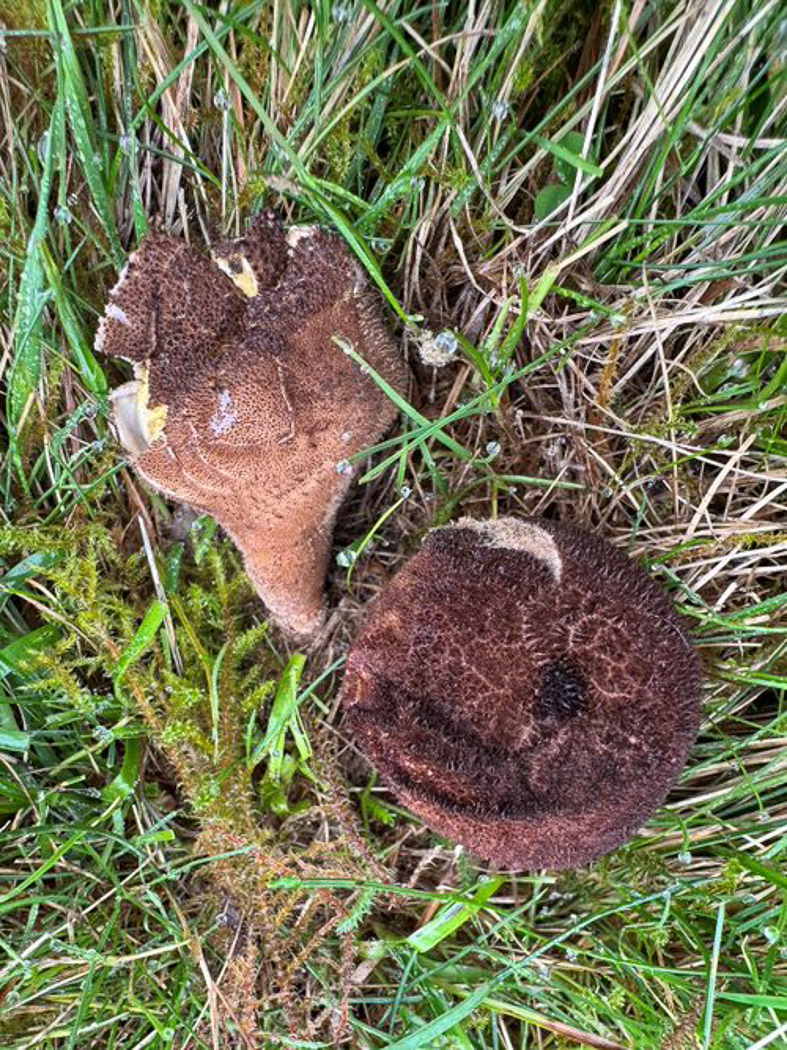
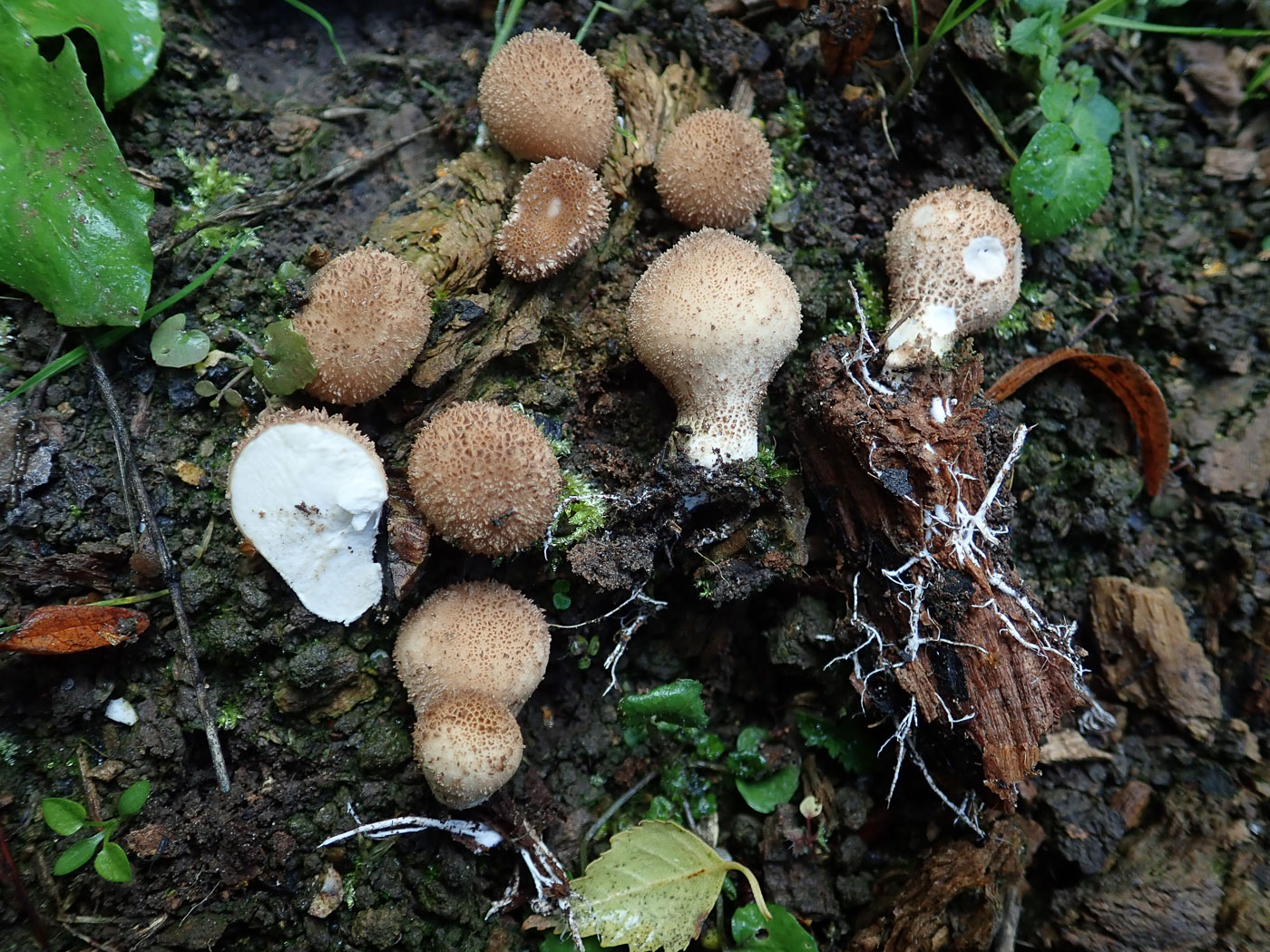
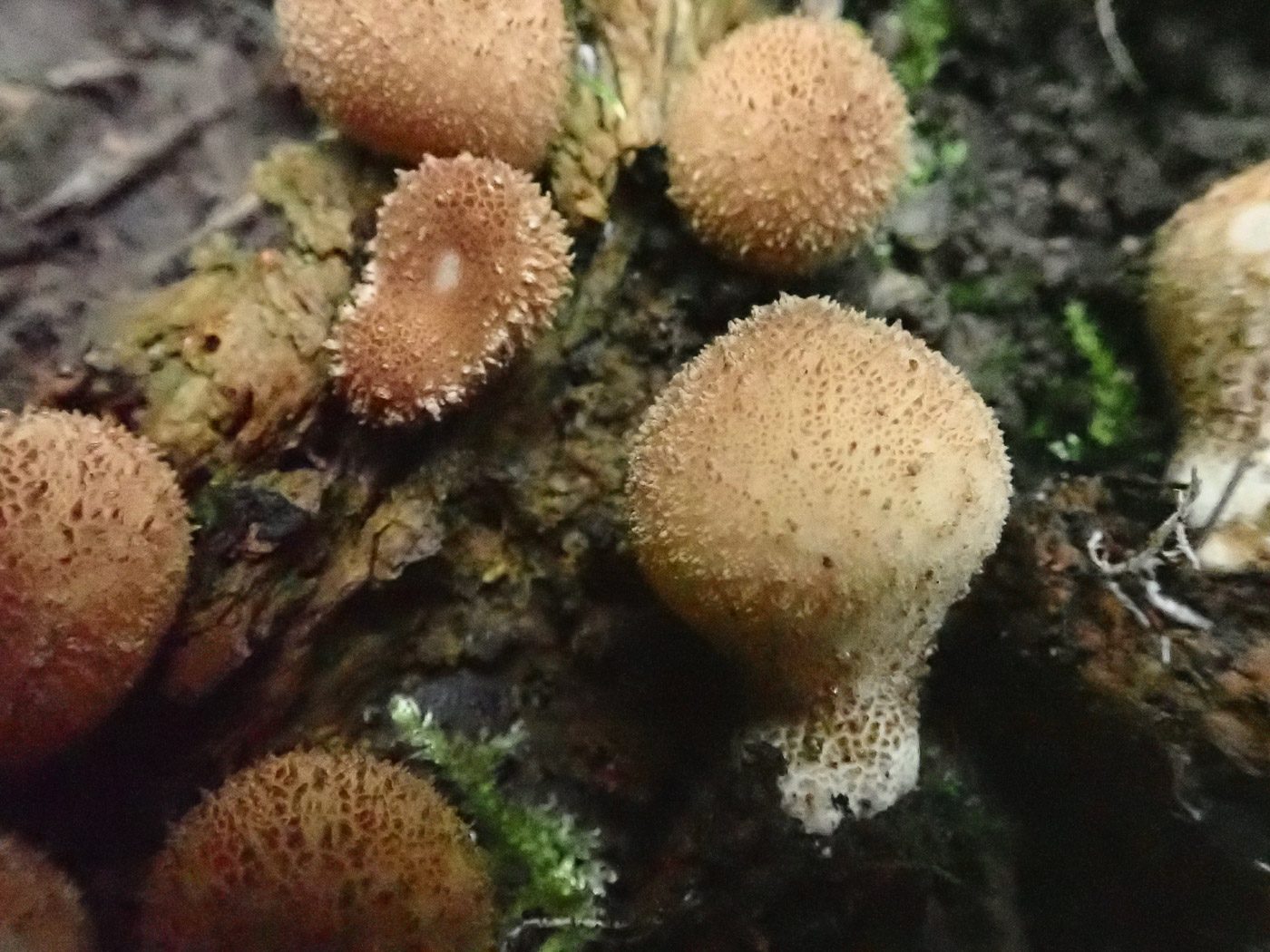
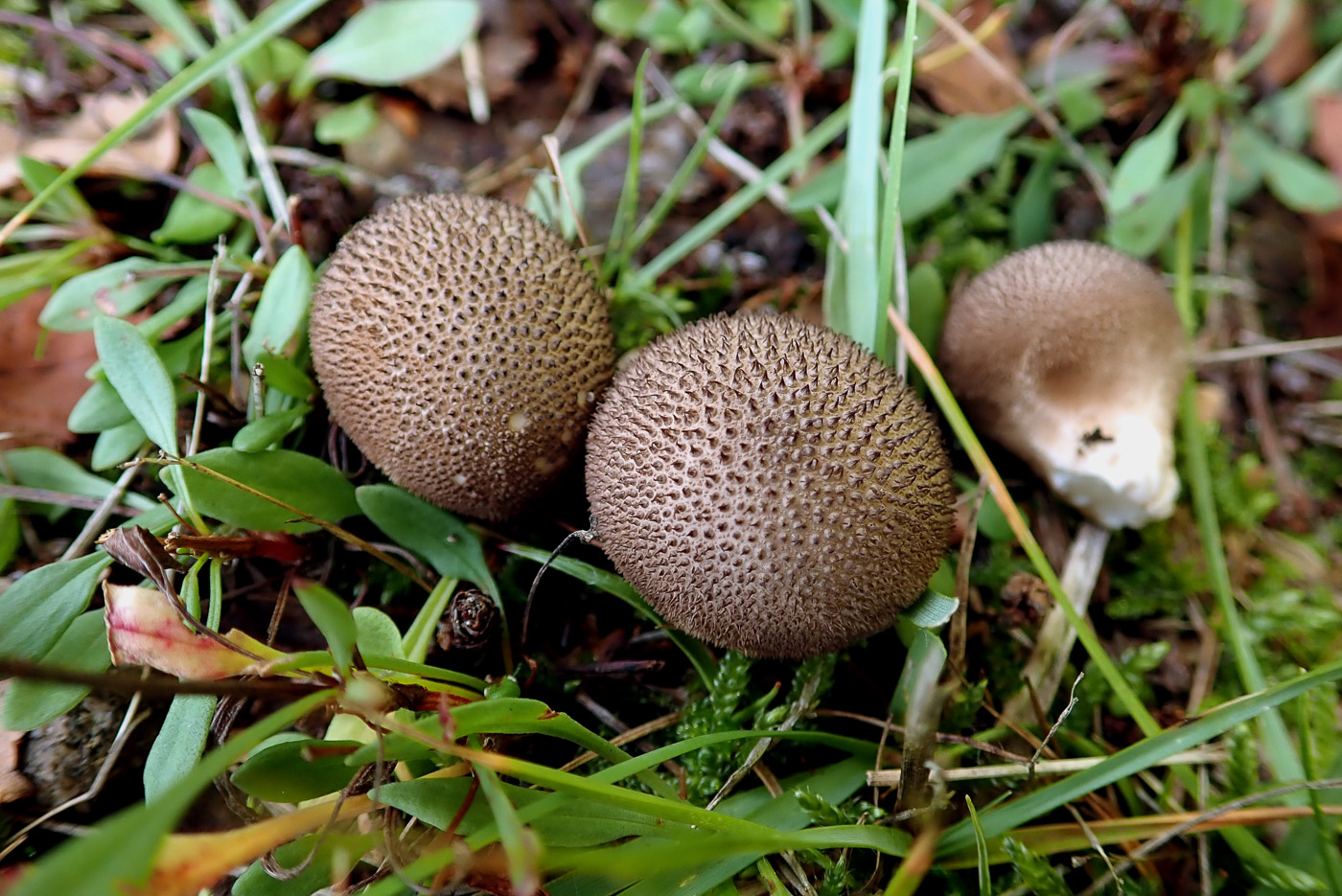
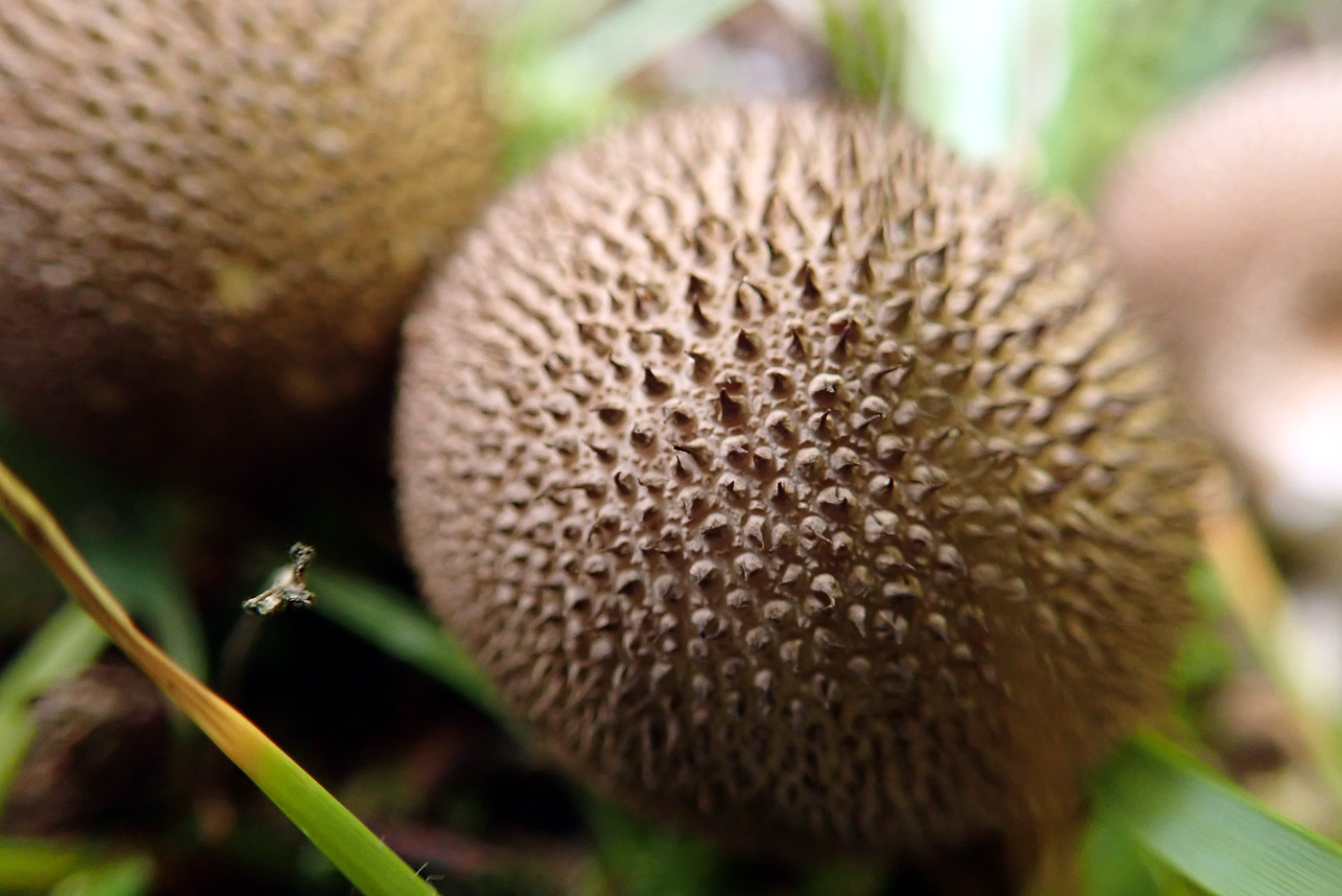
|
Lycoperdon nigrescens (Dusky Puffball)
Nov 7, 2024. At Stoke Poges Memorial Gardens our large group found this very dark brown puffball in grass and questioned what species it might be. Later Penny checked the spores and also examined the spines on the surface which overlapped forming a pyramid, both features fitting with L. nigrescens which can sometimes be confused with other puffballs. The photo is Leigh McMahon's.
Oct 6, 2022. Amongst nettles in a patch of disturbed soil and woody remains at Turville Heath Penny spotted these immature Puffballs. The genus has been notable by its absence so far this autumn and the two more common woodland species (L. pyriforme and L. perlatum) still seem reluctant to make an appearance. This species was clearly too covered in warts to be the first, also the warts did not rub off as they would in the second, hence its determination. No spore check was possible as they were pure white inside when cut open - too immature to have any. Note the white strands of mycelium visible on several fruitbodies here.
Oct 11, 2020. This common species, found today by Penny Cullington at Cadmore End, completes our full house of the woodland Puffballs (see the species list for details). Generally darker than the other three species, it is brown from the start, ending up almost black and is covered in dark brown pyramidal 'warts' which when they are rubbed off leave a distinct meshlike pattern on the skin beneath. Compare with the almost white 'warts' found on L. perlatum which leave a much less distinct pattern when removed. The much longer spines of L. echinatum are much more densely packed together.
|






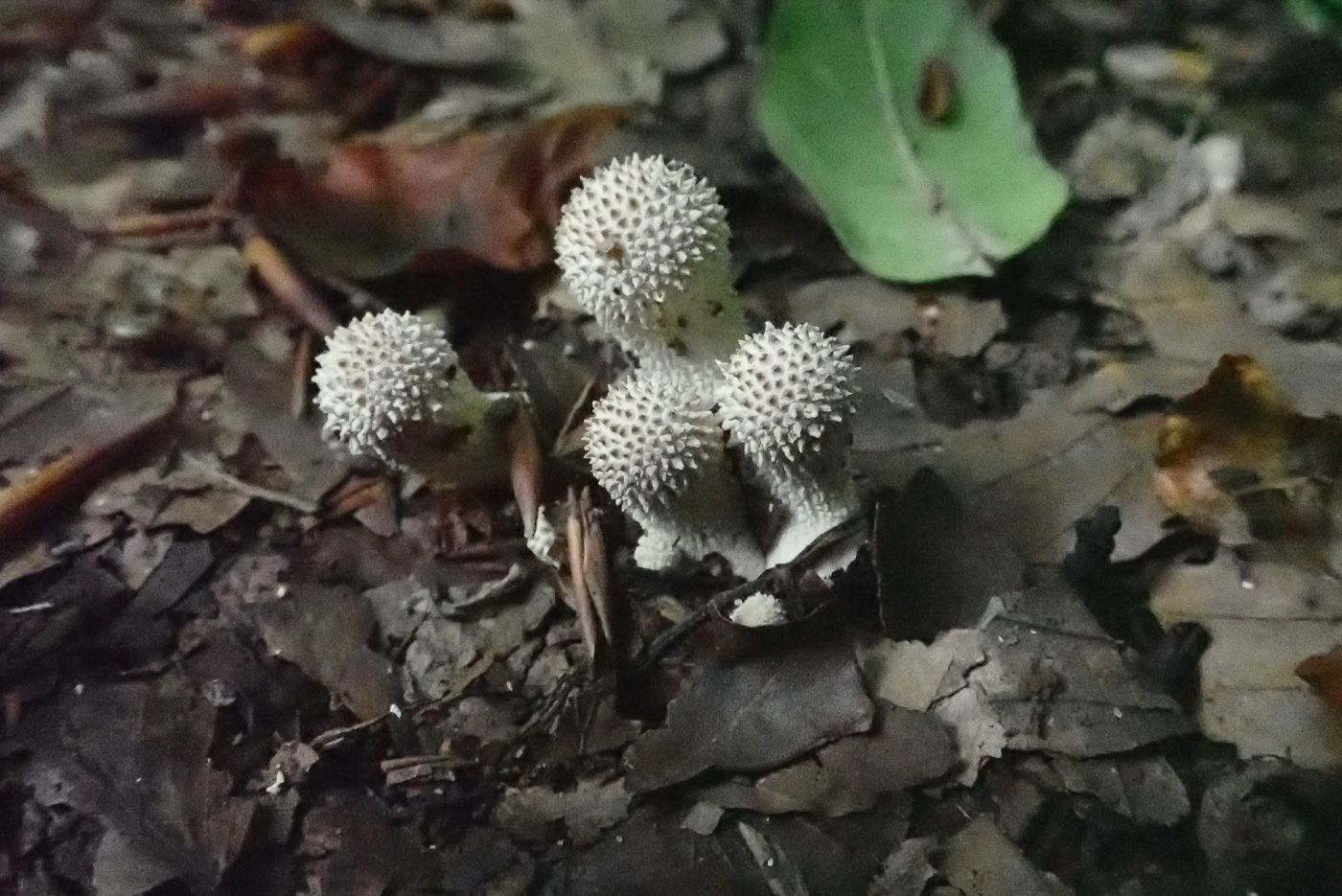
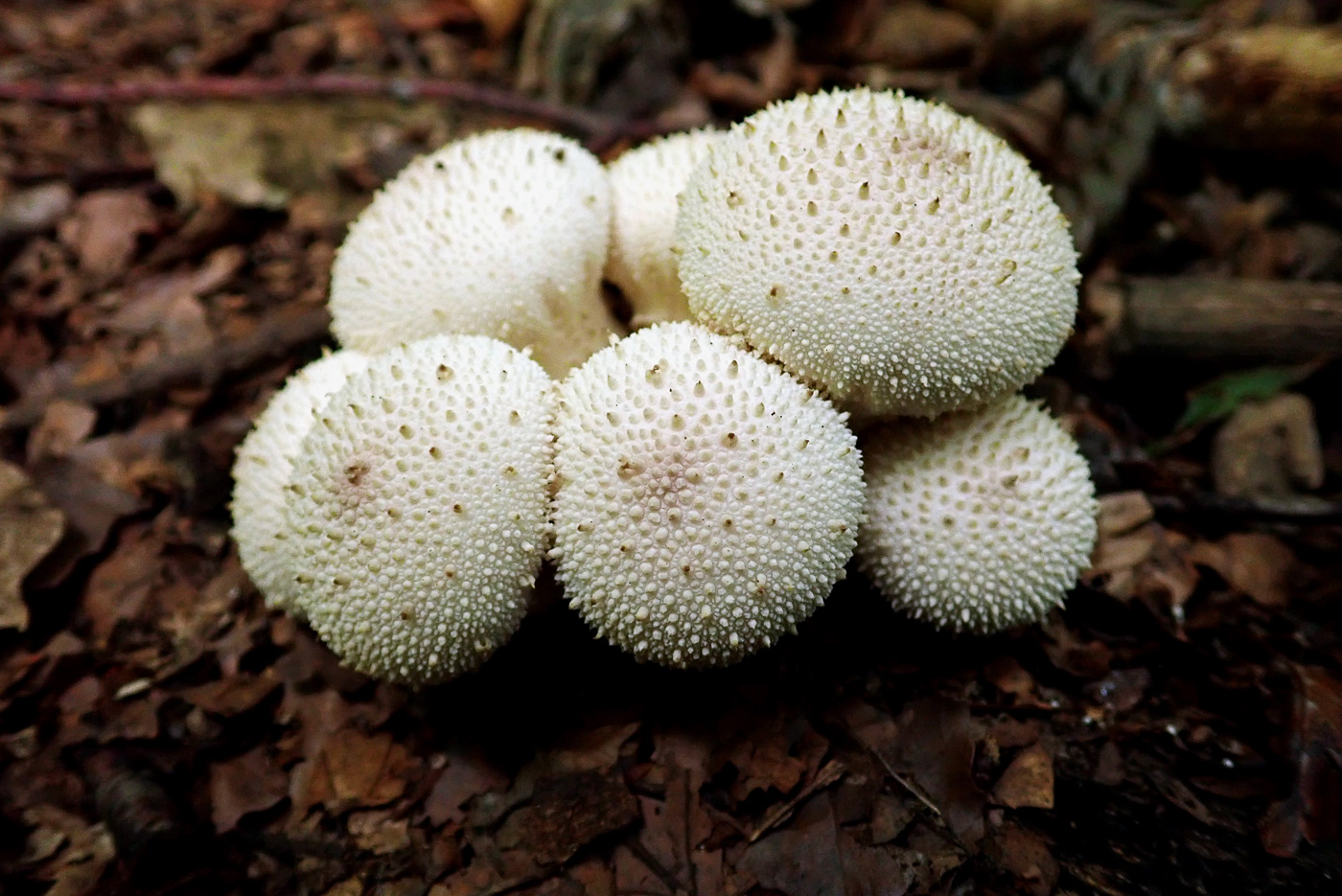
|
Lycoperdon perlatum (Common Puffball)
Mar 21, 2024. Yet another very unseasonal find: Jesper Launder spotted these fresh Puffballs in Gerrards Cross, showing their diagnostic warts which rub off on your finger and separate the species from the equally common but much smoother-surfaced L. perlatum (Stump Puffball). It is exceptionally early in the year to find any Puffball fruiting though it's not unusual to find last year's old dried-up fruitbodies still surviving at this time.
Oct 11, 2023. In Pullingshill Wood in Beech litter Penny came across this nice fresh showing of a common autumn species, though one that's not been in evidence much until now. Compare with the quite similar L. pyriforme entered above, found nearby on a stump.
Aug 13, 2023. In Burnham Beeches Barry Webb came across these tiny white spikes and sent his photo to Penny in the hopes of an ID. She was very unsure but thought it might possibly be very early L. perlatum though the shape looked too cylindrical. On her suggestion Barry returned to the spot a few days later to see how it had developed and took photo 2 which surely confirms the ID! This is a very common species but unfamiliar to us in this immature state before the fertile head has started to form.
Aug 4, 2023. Penny found her first showing of this common and familiar species today in Hodgemoor Woods in the thick deciduous litter. The 'pearls' on the surface which rub off easily make the species easy to separate from the other really common woodland puffball, L. pyriforme.
Oct 6, 2021. In Kings Wood Tylers Green Penny noticed this little cluster of young Puffballs emerging through the Beech litter - the first time she's seen this very common species this autumn though we are officially in the peak weeks for fungi right now! The key feature to separate the species from the equally common L. pyriforme (Stump Puffball) is clearly visible here despite its immaturity: the little white 'warts' covering the surface which rub off very easily are absent on the other species. Furthermore today's species grows in woody litter and not directly on wood (stumps, roots) as L. pyriforme does.
Sep 16, 2020. One of our commonest woodland fungi, this collection of fresh material was found by Penny Cullington in litter under Beech in Penn Wood. Note the pyramidal warts covering the surface, a feature missing from the Stump Puffball - our other really common woodland species (see photo dated Sept 13th for comparison). These warts rub off easily, leaving a meshlike pattern beneath. Though white when young, the fruit bodies turn gradually pale then darker brown when reaching the spore-puffing stage.
|



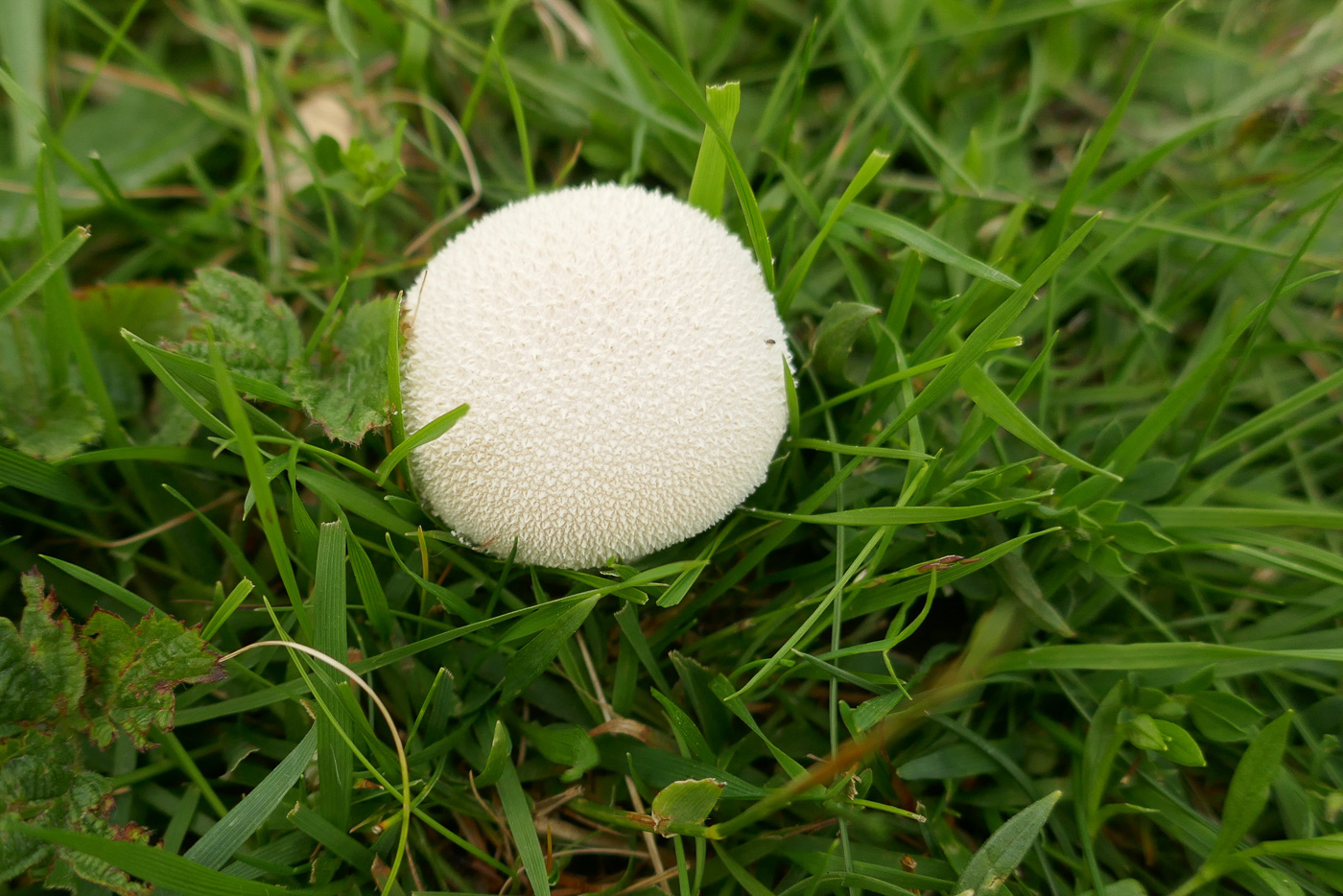
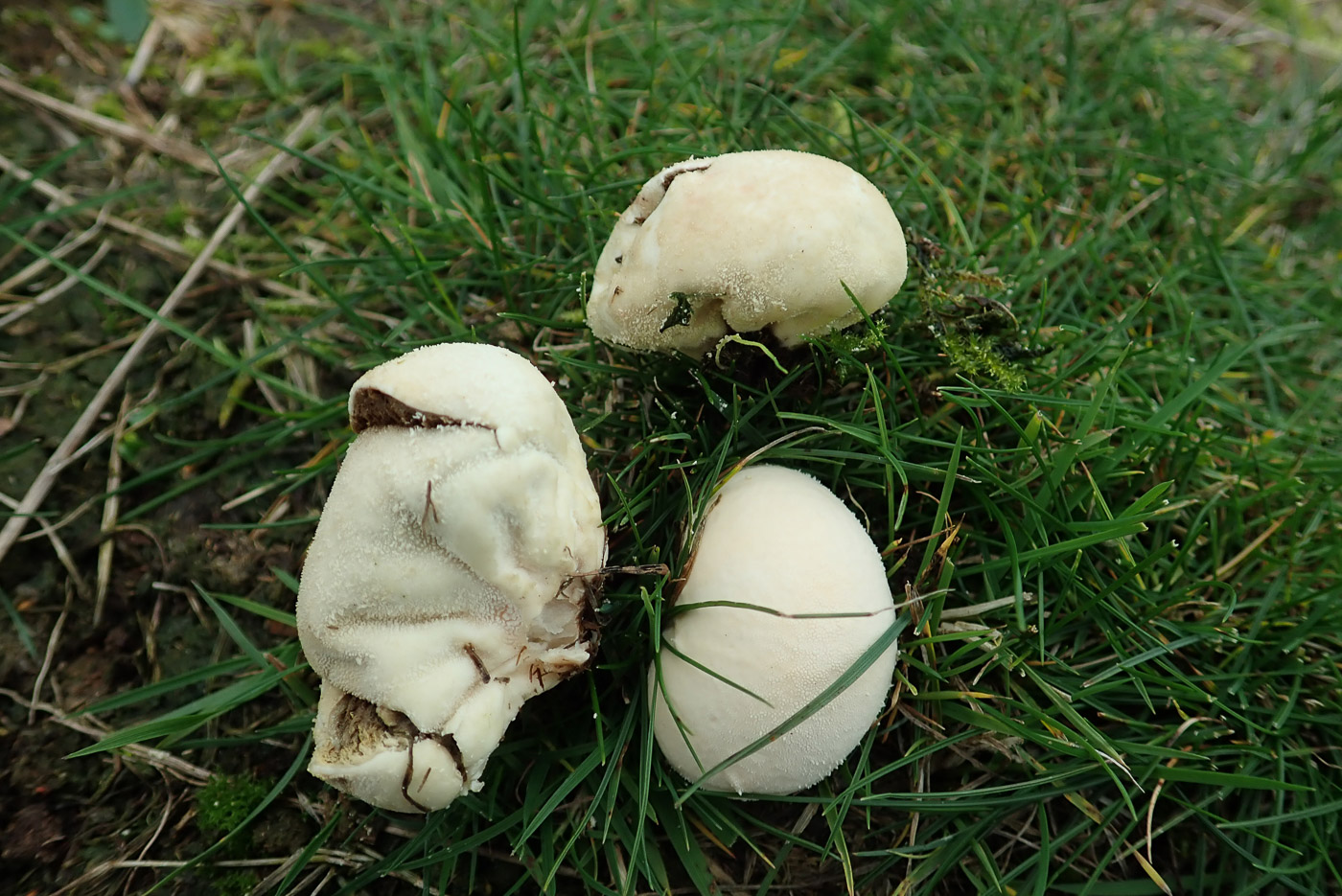
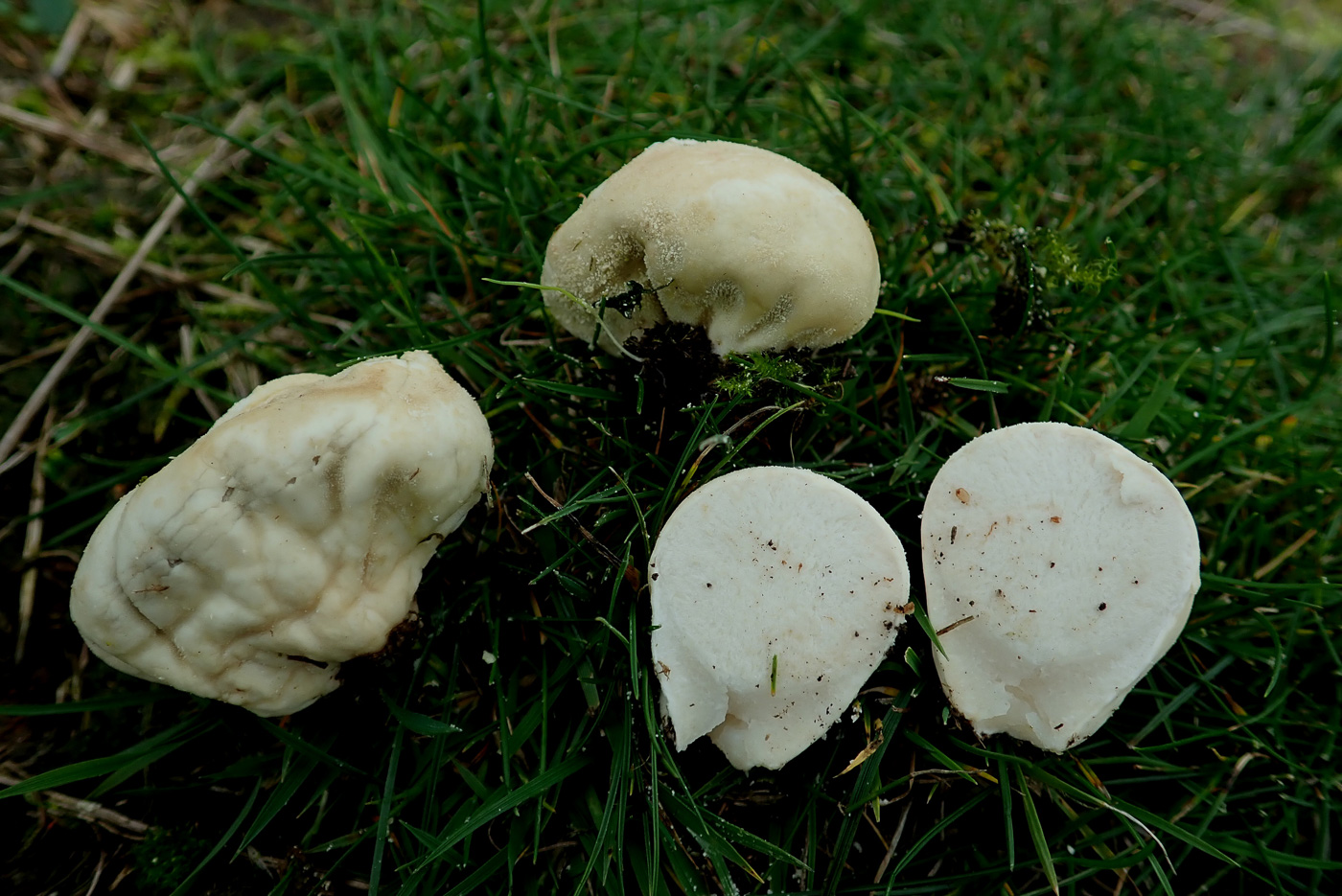
|
Lycoperdon pratense (Meadow Puffball)
Jul 17, 2023. At Turville Heath Penny noticed this species in several spots both in grassy glades and in soil amongst woody litter under the Limes as seen here. Previously in genus Vascellum, when in woody habitats it is separated from the two common woodland puffballs by its (a) smooth surface, soil substrate, also its slightly pleated base adjacent to where the mycelial cords are attached. It tends to appear earlier in the season also.
Sep 7, 2022. In soil in the Lime avenue at Turville Heath Penny noticed just a few of these Puffballs which looked initially like the very common L. pyriforme (Stump Puffball). However, though smooth they were clearly on soil and not wood, also lacked the typical pear shape of that species and when cut in half showed no signs of stem, just some wrinkles where they attach to the substrate. The species - previously in genus Vascellum - appears in summer to early autumn in open grassy areas, fields, less often in woodland clearings.
Jul 2, 2021. In the cherry orchard at Stampwell Farm Jackie Ewan found this common summer puffball, previously in the genus Vascellum and better known by that name. As its common name suggests, this is a species of short grassland and has rather a flat top rather than domed and also remains quite small compared to many others in the genus.
Oct 30, 2020. Penny C. found a few of these in grass at Coombe Hill. In most handbooks as Vascellum pratense but fairly recently moved to the genus Lycoperdon with our more common woodland Puffballs, this is not found in woodland but in grassland but is fairly obviously a puffball from its shape and size but lacks a proper stem, instead tending to become pleated towards the base (seen in photo 1 in the LH specimen). The upper surface is slightly scurfy, somewhere between the smoothness of L. pyriforme and the distinct wartiness of L. perlatum.
|
 |
Lycoperdon pyriforme (Stump Puffball)
Oct 11, 2023. On a deciduous stump in Pullingshill Wood Penny found a good collection of this very common Puffball, and as the equally common L. perlatum was also fruiting nearby she took the opportunity to show both species here for easy comparison. (See also below.) This is by far the smoother species of the two and is also rounder despite its common name. It tends to turn brown fairly quickly as here (but not always) and lacks the easily loosened white 'pearls' which cover the Common Puffball. This species is always on wood - sometimes submerged - whereas the other is in litter. Amazingly this is a new entry for Finds!
|

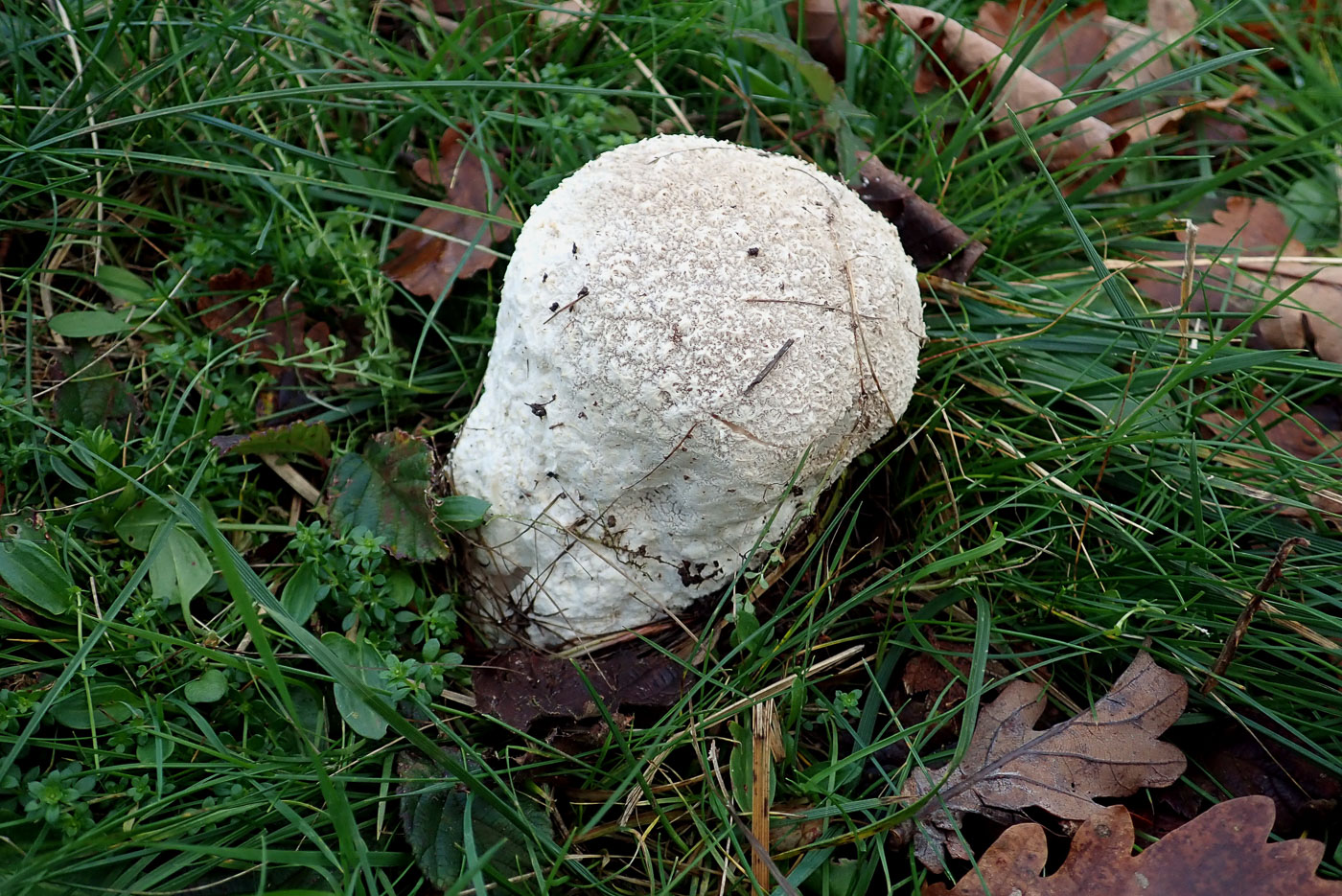
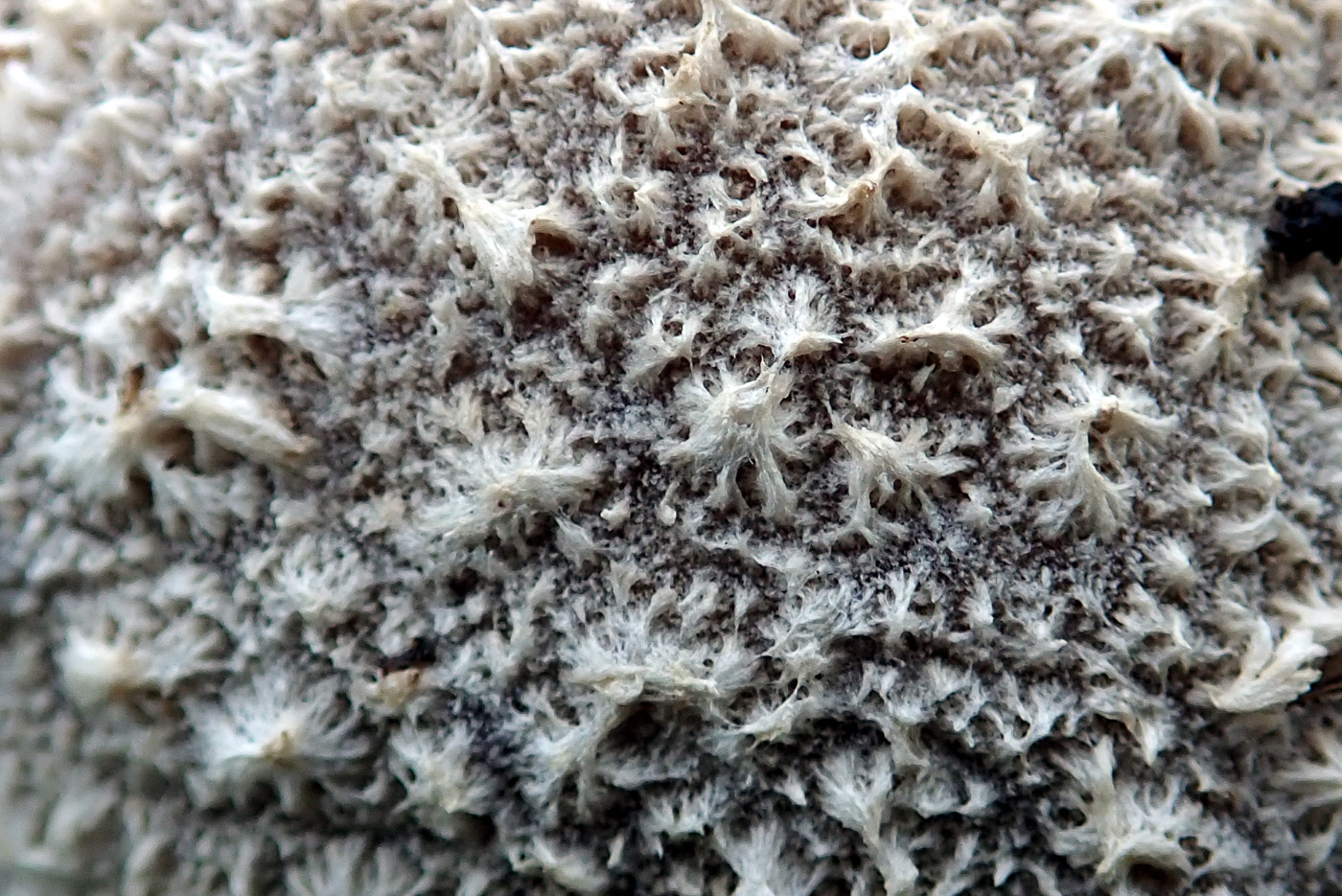
|
Lycoperdon utriforme (Mosaic Puffball)
Sep 7, 2023. At Stampwell Farm Jackie Ewan noticed this Puffball growing in short grass where she's found it in previous years. This is one of two quite similar big species - considerably larger that L. perlatum (Common Puffball) though that species is sometimes mistaken for it. The white scurfy almost powdery surface seen when immature as seen here is a good clue, also it frequents grassy areas rather than woodland glades. Surprisingly this appears to be a new species for Finds.
Nov 24, 2020. At Coombe Hill in a grassy area Penny C. was surprised to find a reasonably fresh specimen of this occasional grassland species. Not unlike an overgrown L. perlatum, it was a good 12 cms tall by nearly as many across but still white inside hence not yet with mature spores which could be checked, unfortunately. Photo 2 shows the detail of the surface described as having scurfy warts in hexagonal patches! The species has previously resided in both Handkea and Calvatia - like the Giant Puffball, but has recently be re-assigned to Bovistella together with the similar Pestle Puffball.
|
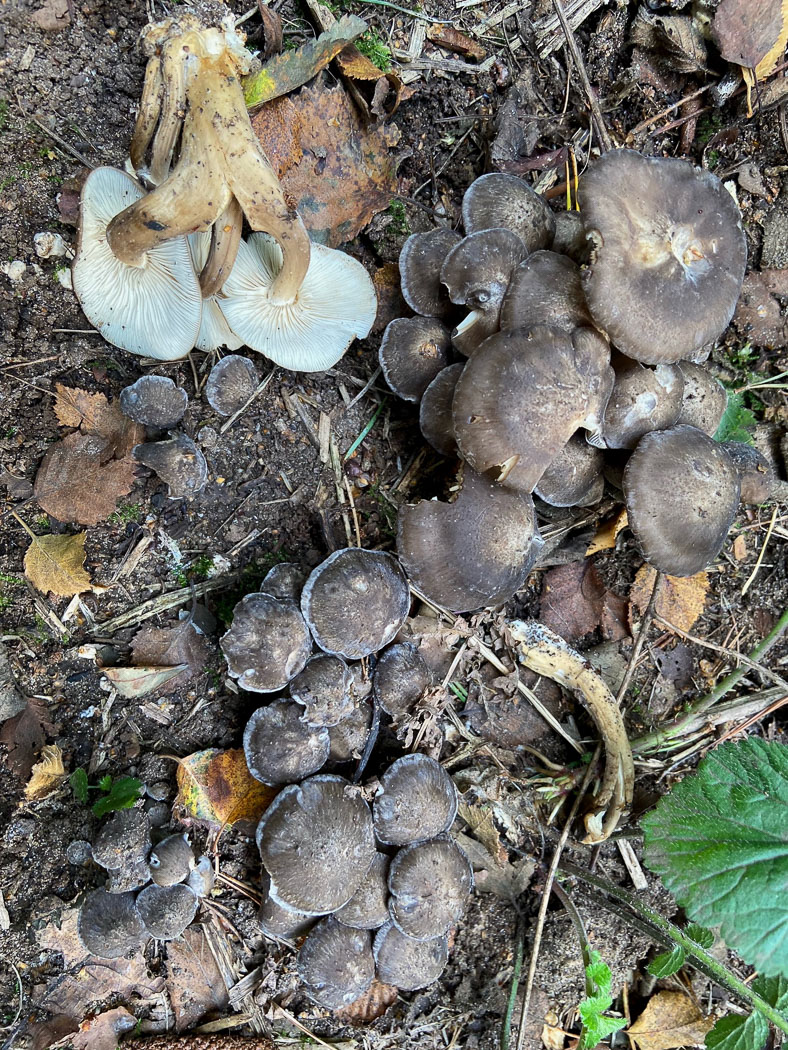

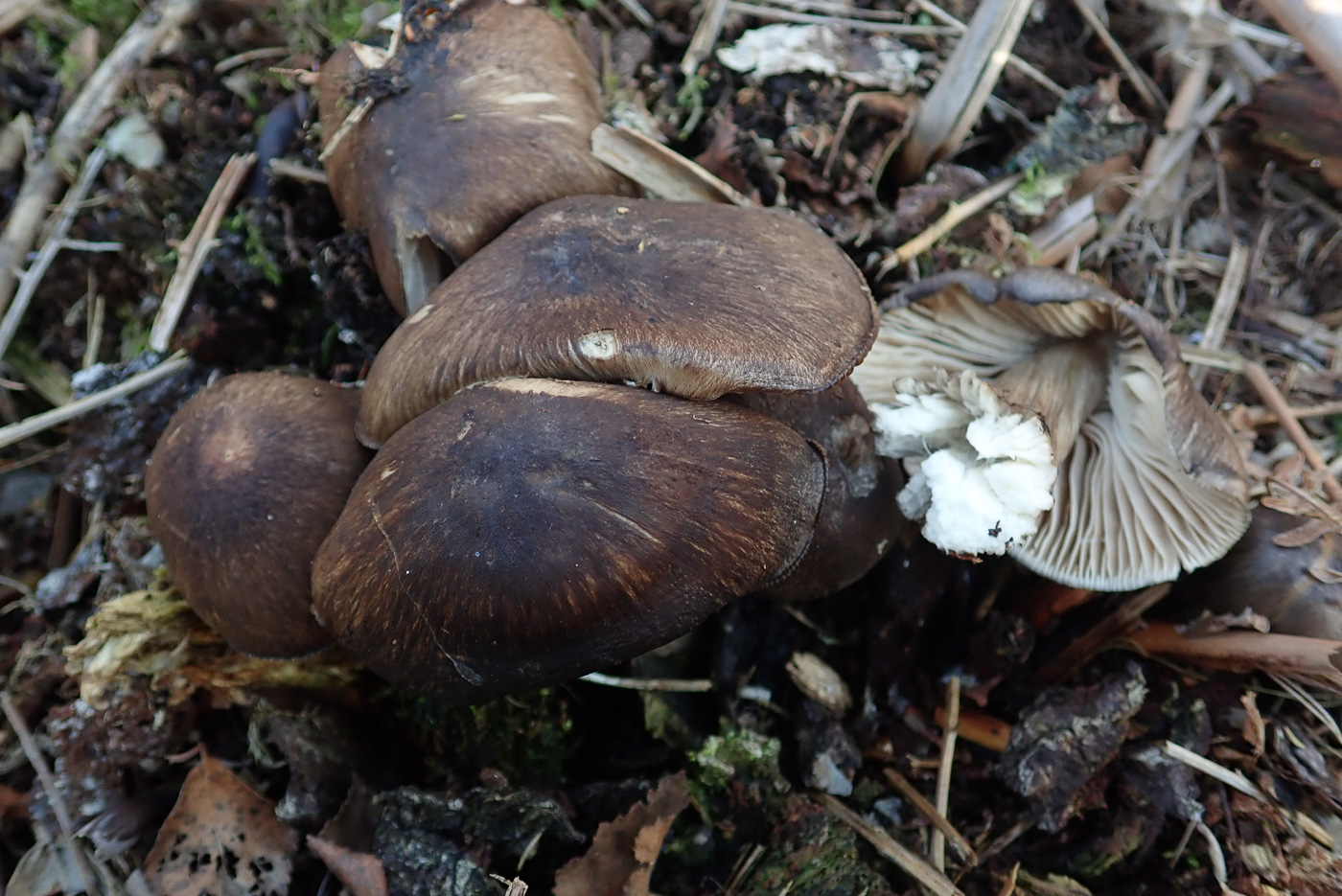
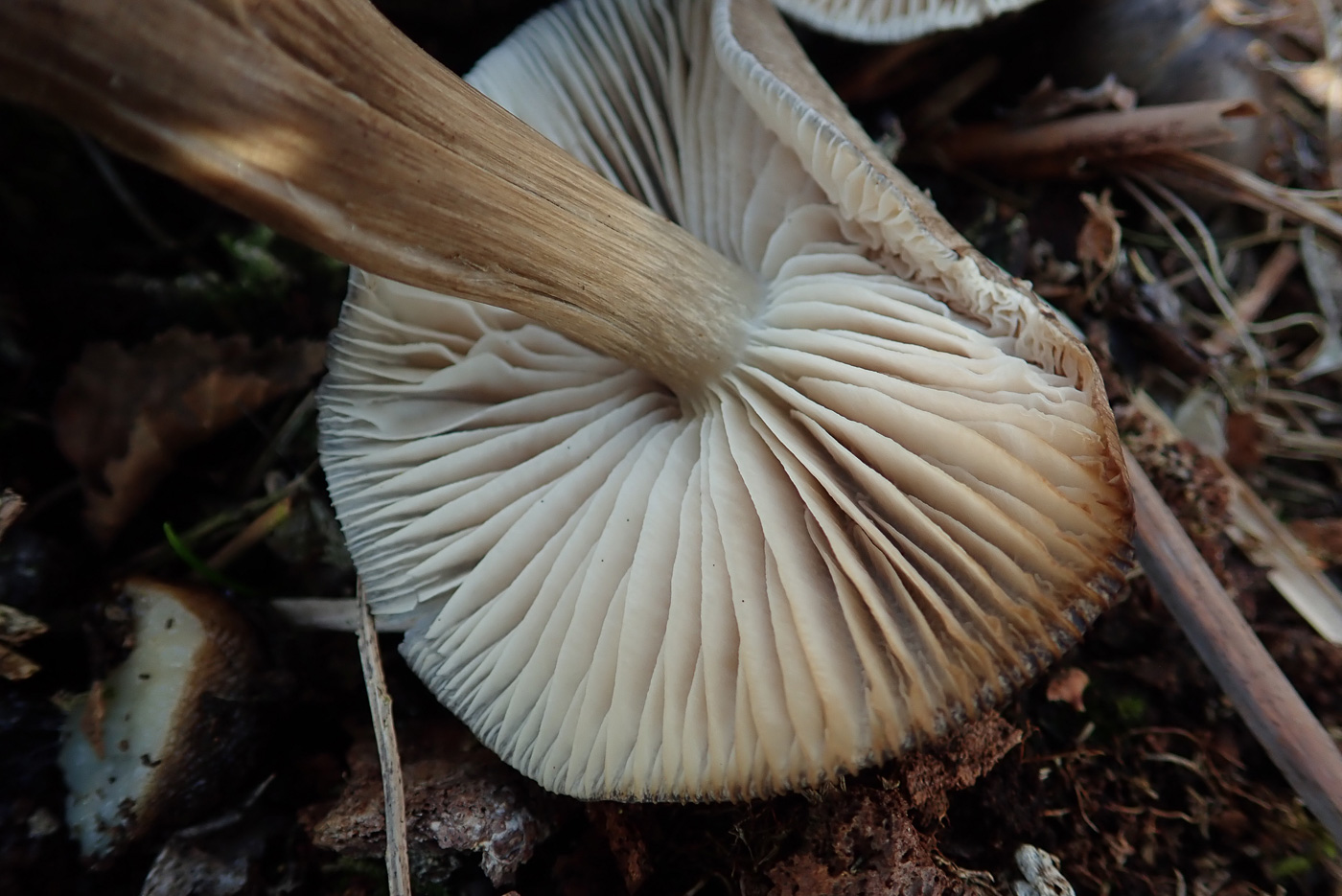
|
Lyophyllum decastes (Clustered Domecap) 
Sep 20, 2024. In Rushmere Estate Stephen Plummer found this nice clump in mixed litter, checked its identity at home then showed the collection to Penny and Derek for confirmation. This is a fairly common but nondescript species of woodland paths, quite flexible in texture, its most distinctive characters being its fasciculate habit (ie with stems often conjoining as in Hypholoma fasciculare) and contrasting dark cap with pale gills.
Aug 4, 2023. In soil on the edge of a path in Hodgemoor Woods Penny nearly trod on the two tight clumps just emerging. The tight clustered habit, white stem and dark brown domed cap was all she needed to put a name to this fairly common species, this quickly confirmed later by its globose spores.
Nov 7, 2020. Penny C. came across this tight cluster in a damp mossy area against a Birch stump in Stoke Common. Appearing initially rather like the caps of perhaps a dark Pluteus species, caps are smooth and almost black in the centre and have a rubbery flexible texture. Gills are quite widely spaced and cream, similar to those of Megacollybia platyphylla, and stems are fibrous, whitish and conjoined with the rest of the cluster. A rather characterless and nondescript species, it is quite common in mixed woodland.
|
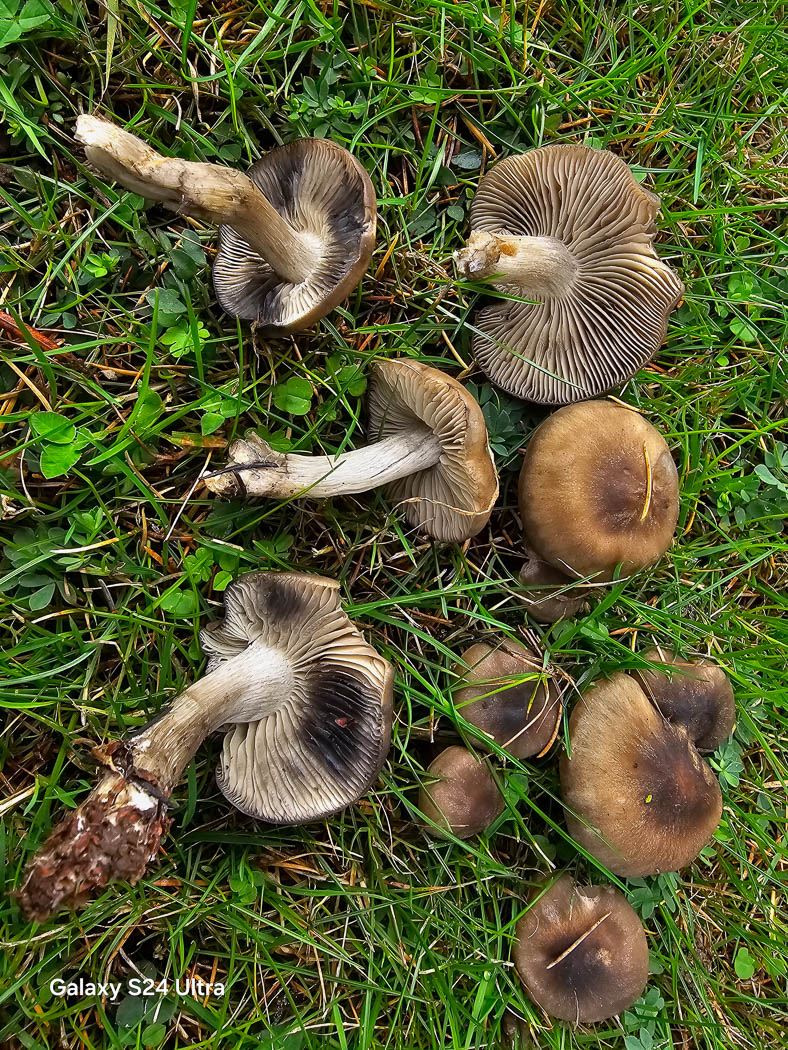
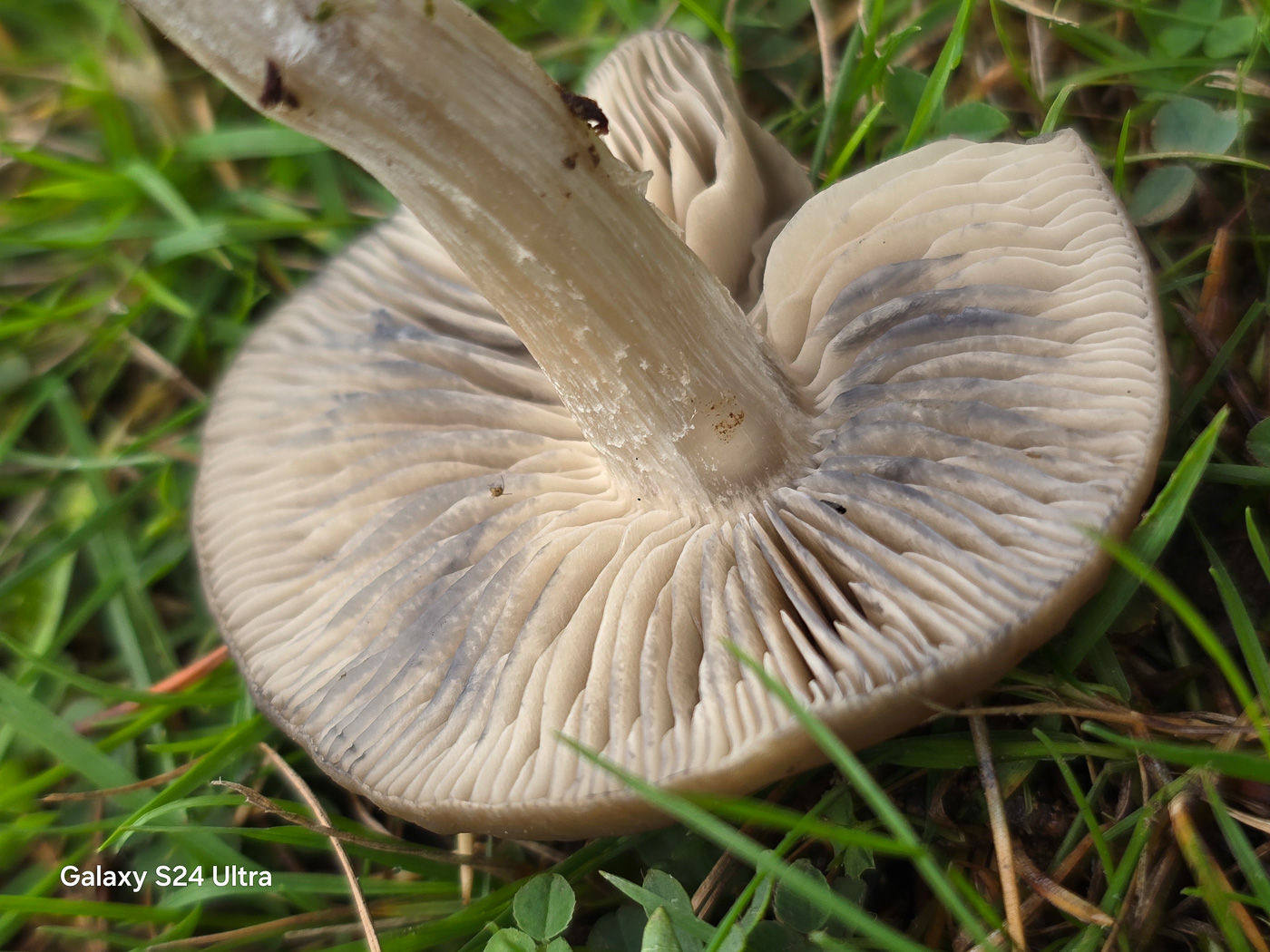 |
Lyophyllum paelochroum (a rare Domecap with no English name) 
Oct 12, 2024. In Jordans village under Cedar Jesper Launder was intrigued by this collection which on handling started turning faintly then strongly blue before becoming almost black. This pointed to some species of genus Lyophyllum and it keyed straight out in Funga Nordica to this rare species, also included in Kibby vol 2. However, though the name is accepted in Species Fungorum it is not listed in the FRDBI dictionary, nor can Penny trace an earlier name for it. It is obviously a significant find and will be sequenced but unless someone can enlighten her Penny is at a loss as to how to record this species ...............
|

